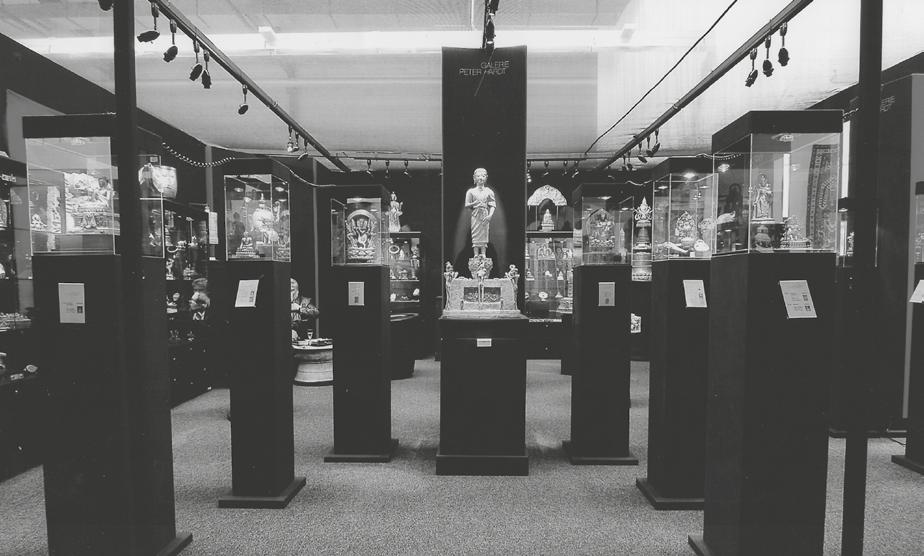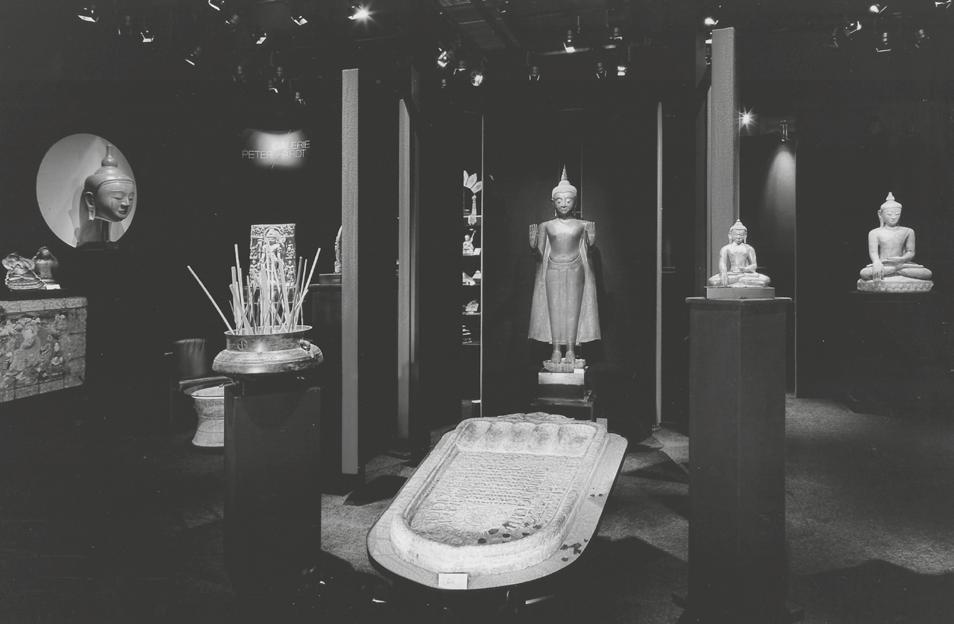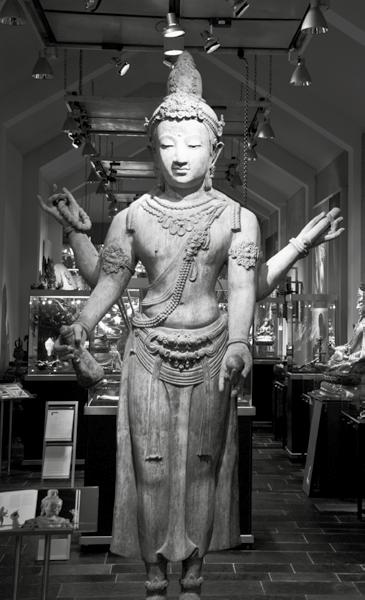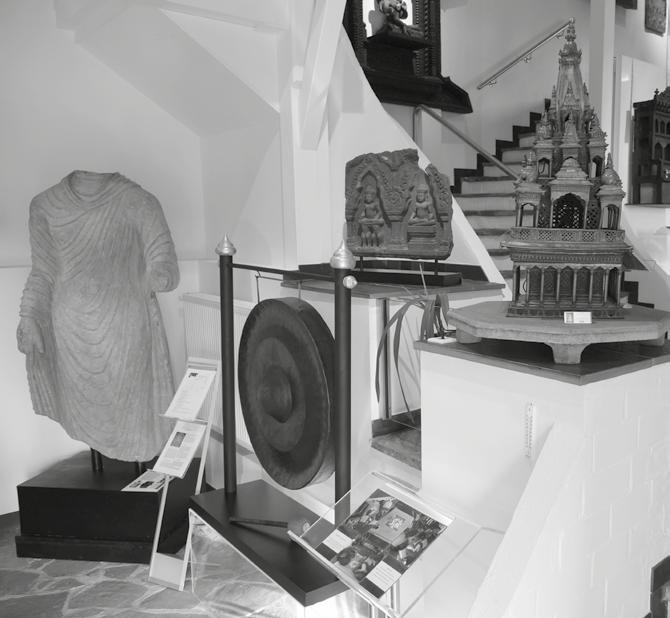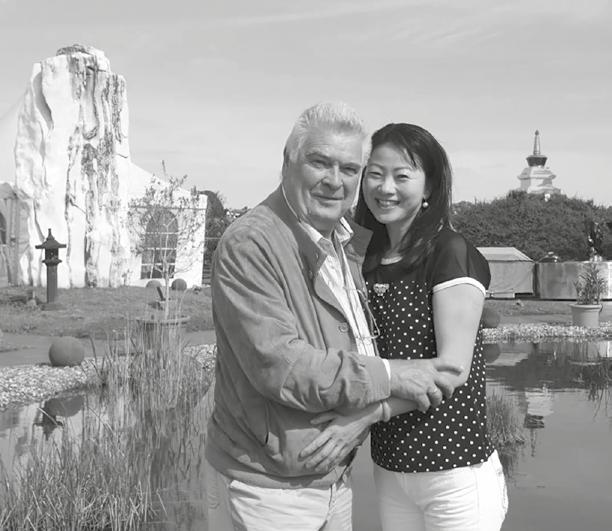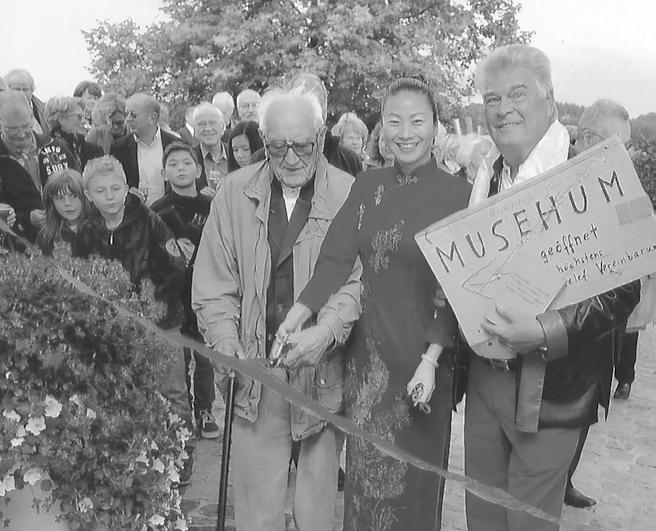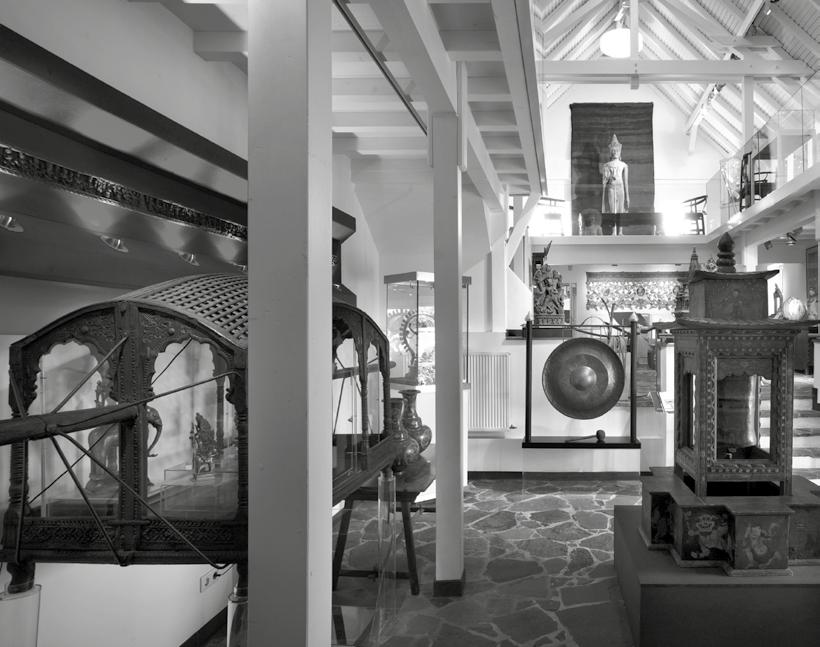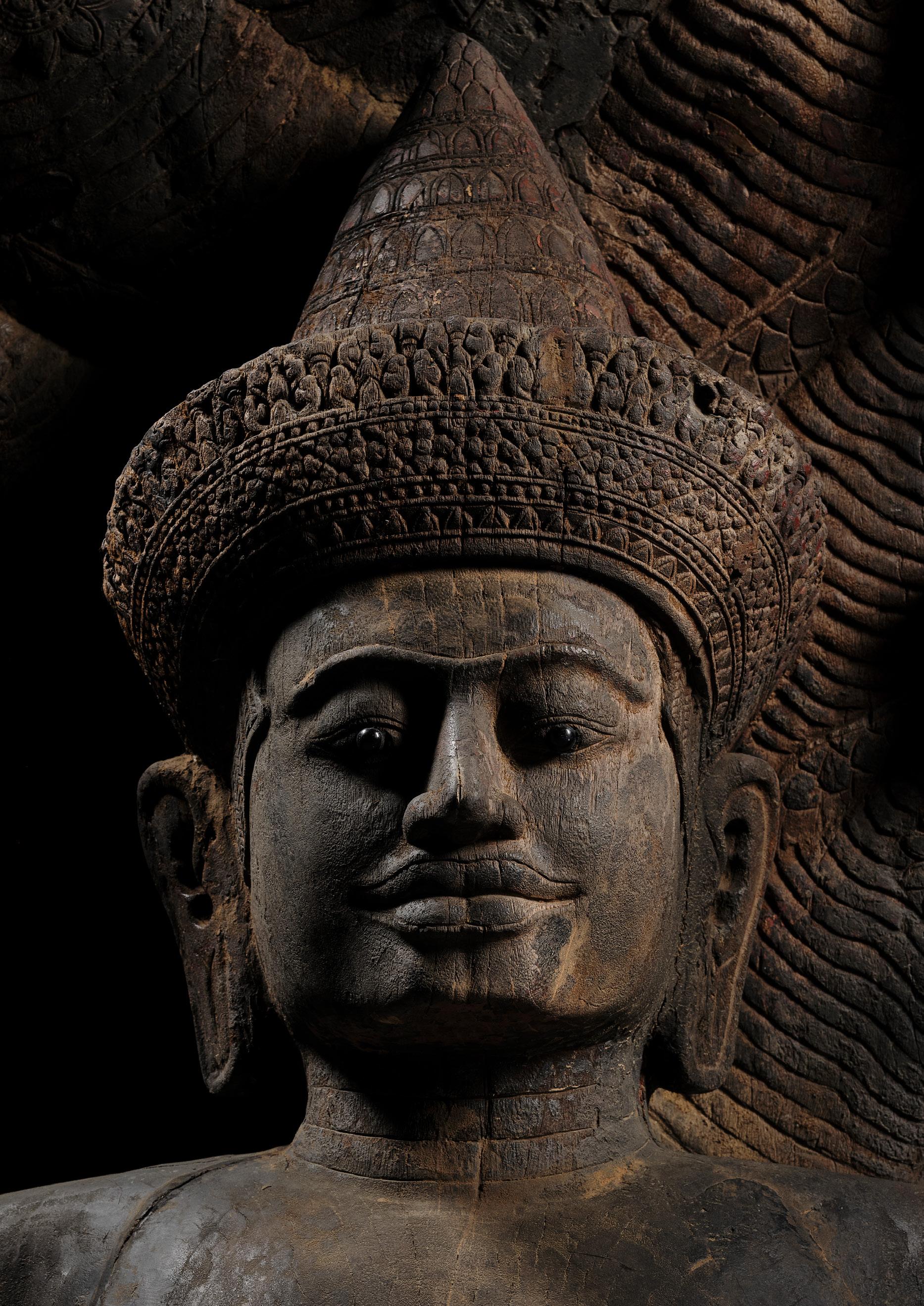Arts of India, Southeast Asia, China and Beyond
THE KIENZLE-HARDT MUSEUM TREASURY
PART 2
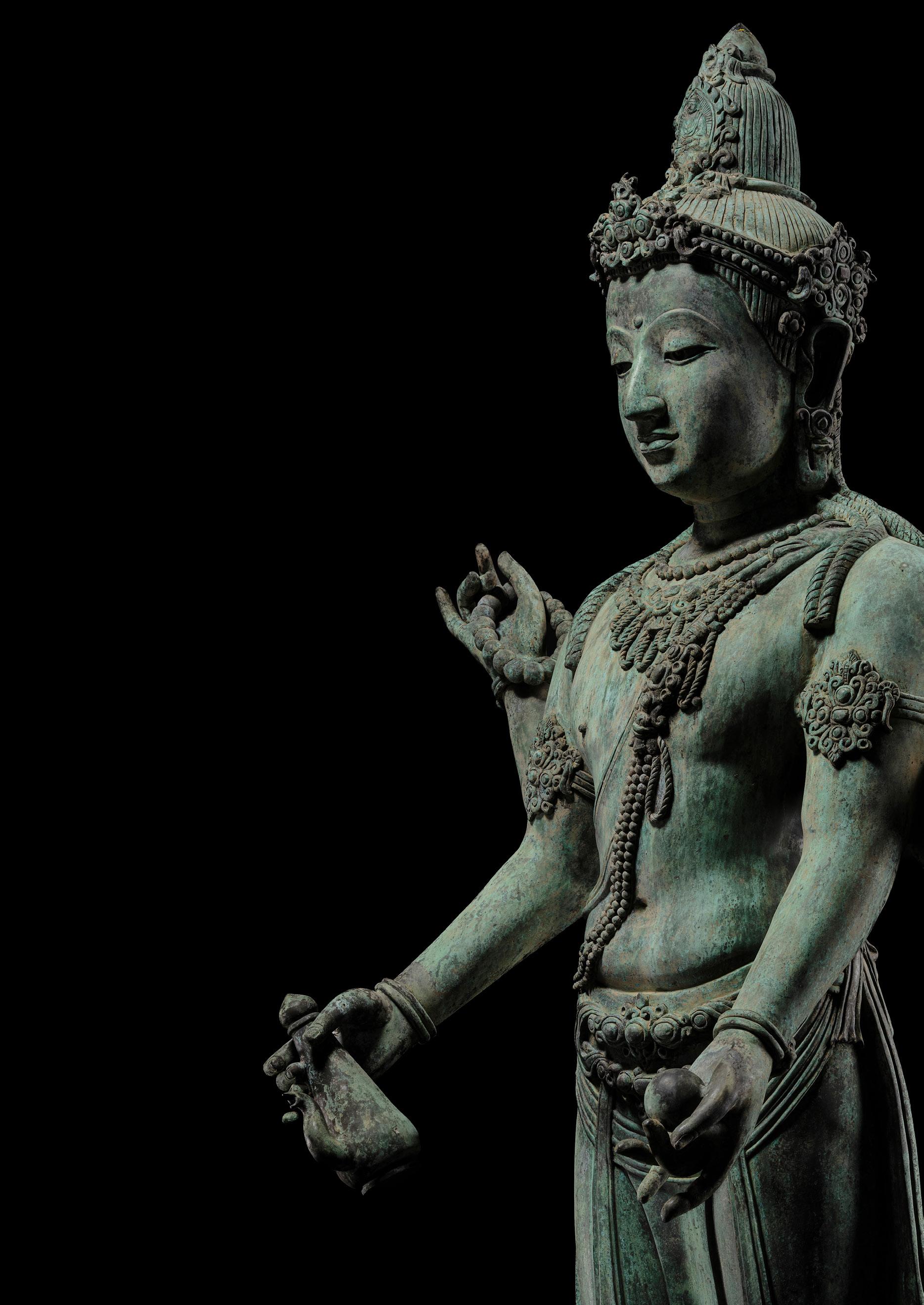
AUCTION 10 September 2025
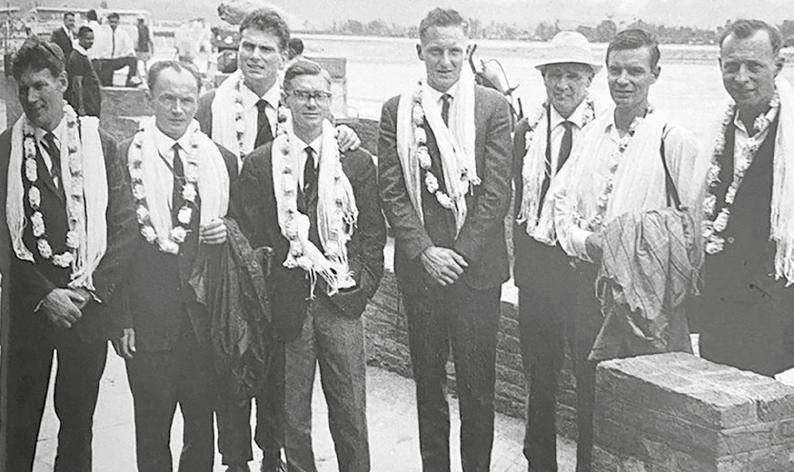
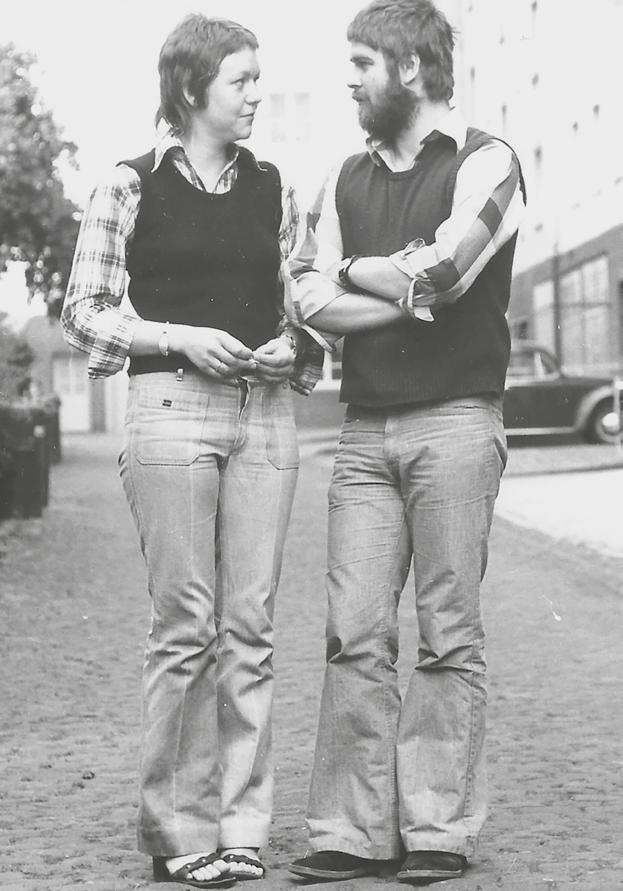
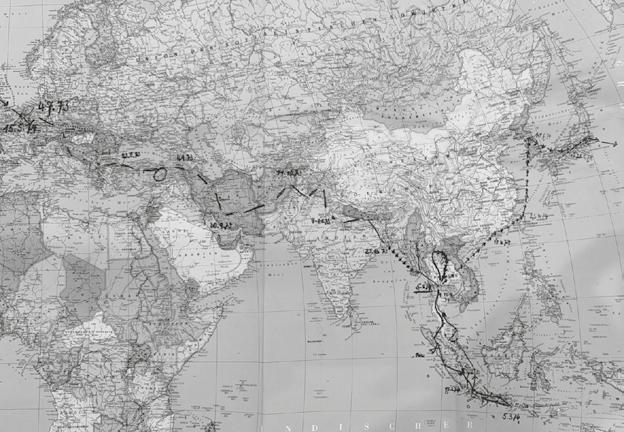
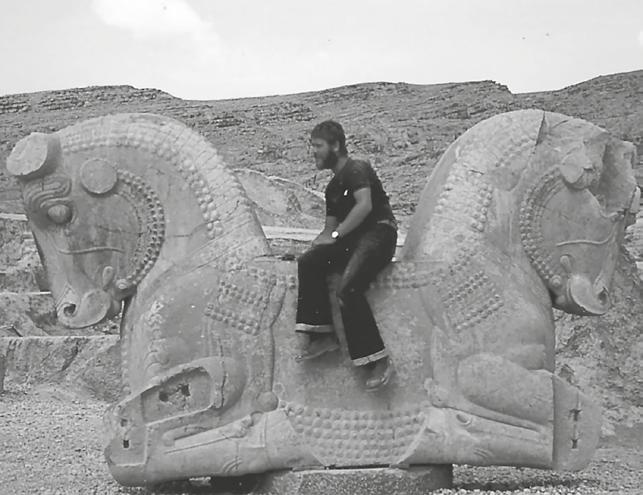
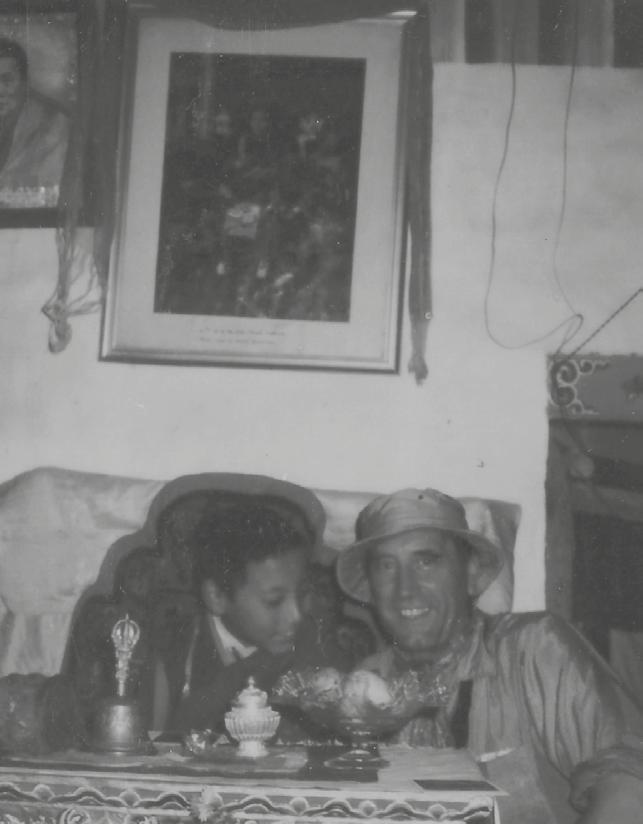



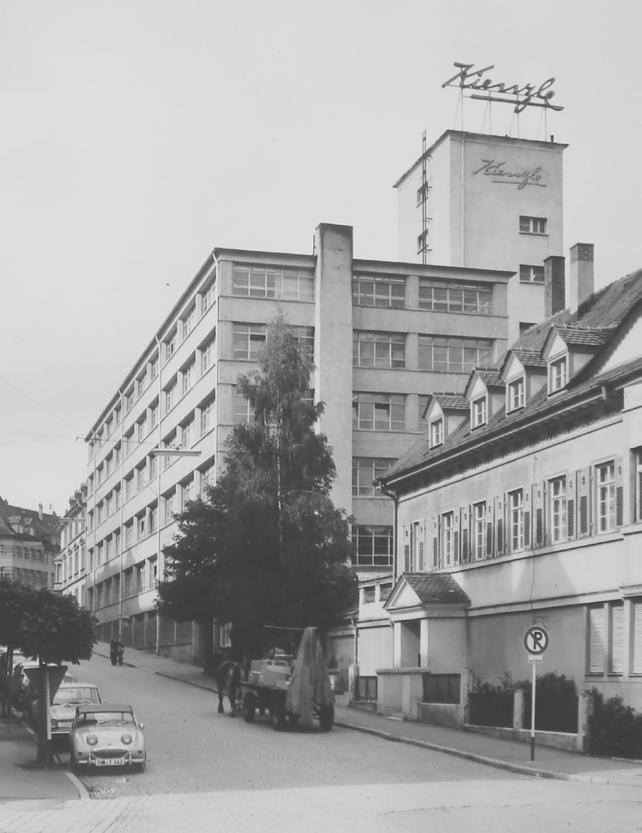
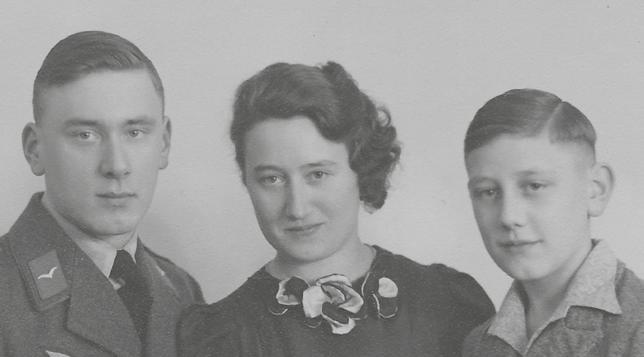
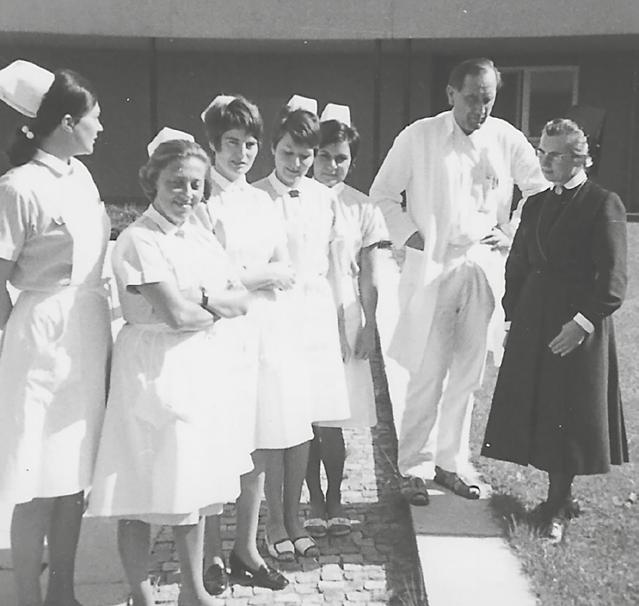
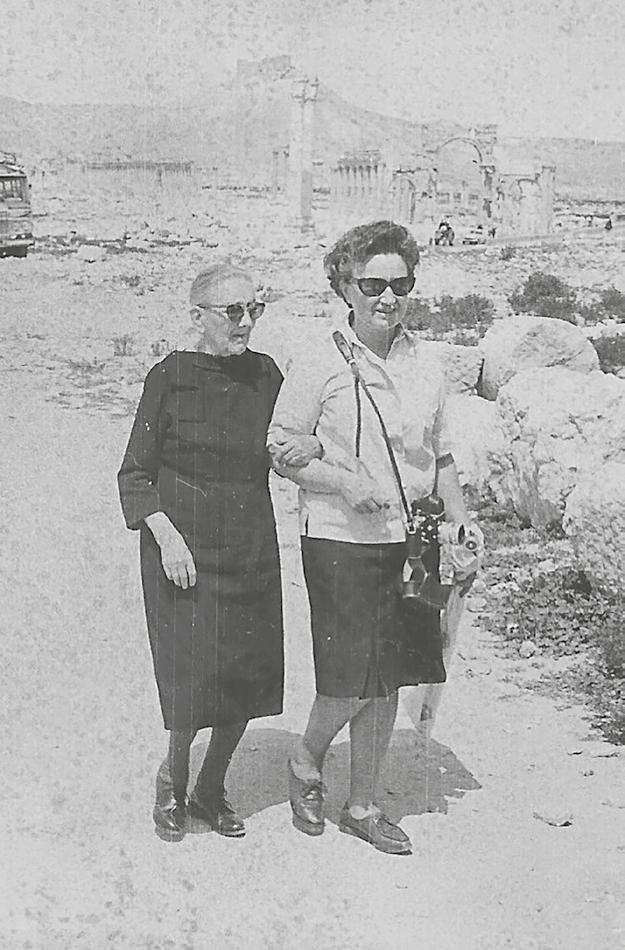
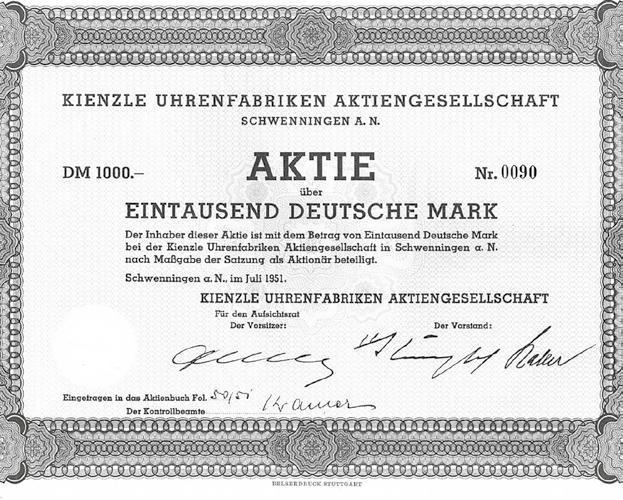

THE KIENZLE-HARDT MUSEUM TREASURY
PART 2

AUCTION 10 September 2025













CATALOG MUA0925
No Reserve Live Auction 10 September 2025, 11 am CET
Session 1 Lots 1-140 Print Catalog
Session 2 Lots 141-259 Online Catalog
EXHIBITION
1-9 September 2025, Monday – Friday 10 am – 6 pm as well as by appointment
GALERIE ZACKE Zelinkagasse 6 . 1010 Vienna Austria
Tel +43 1 532 04 52 E-mail office@zacke.at
www.zacke.at
According to the general terms and conditions of business of Galerie Zacke Vienna, Founded 1968, SZA Versteigerungen & Vertriebs GmbH, 1010 Wien, online at www.zacke.at
ABSENTEE B IDDING
Absentee bids are carried ou t under the regulations of the terms of business of Galerie Zacke, SZA Versteigerungen & Vertriebs GmbH, which requires written submission of your purchase limit. Orders without purchase limits cannot be processed.
Onl y the submitted lot number of the auction lot is binding for the processing of the absentee bid The place of jurisdiction is Vienna, Austrian Law and Austrian jurisdiction are exclusively applicable for all legal questions arising from the business relationship. Absentee bids for this auction will be accepted until the day of auction by 10:0 0 a.m We regret that absentee bids received after the time stated above will not be processed until after the auction.
PLEASE SEND ABSENTEE BIDS FOR THIS AUCTION TO:
Fax: +43 1 532 04 52 20 or Email: office@zacke.at or Mail: Galerie Zacke, Zelinkagasse 6, 1010 Wien, Austria, Europe
WE ACCEPT THE FO LLOWING METHODS OF PAYMENTS:
• Cash
• Certified or personal check
• Bank transfer (please inquire to receive our bank account information)
• Credit card (Visa, MasterCard, Amex) up to EUR 5.000 - higher amounts require prior approval and are subject to service fees
TELEPHONE BIDDING
It is generally possible to bid by telephone during the auction. Please fill out the absentee bidding form enclosed in this catalog and include your telephone number at which you can be reached during the auction. In the “bid in euro” column please write “TEL” and then send us the completed absentee bidding form. Galerie Zacke will call you on the day of the auction, on the telephone number provided, 5 lots before the lot you are bidding on and the bidding will commence at the starting price, as stated in the catalog. If Galerie Zacke cannot reach you during the auction, Galerie Zacke will bid the starting price on your behalf.
ESTIMATES AND STARTING PRICES
The auction will begin with the starting price and written bids will be accepted only with a minimum amount equivalent to the starting price.
SHIPPING AND TRANSPORT INSURANCE
For domestic shipping Galerie Zacke (hereinafter called “the company”) charges in average Eur 15,- to Eur 50,- per item, depending on size and weight. These fees cover the costs of packing and shipping. Fees for bulky or fragile items, or international shipping will be quoted upon request.
The purchased goods are transported at the risk of the customer following handover of the packaged item to the post office or another carrier which the customer agrees to through his/her submission of the purchase order. According to the specific wish of the customer, the auctioned goods may be insured for the value of the purchase price (highest bid and all surcharges). This insurance fee is 3% of the purchase price. For any lots with a purchase prices exceeding EUR 350,- the transport insurance will be automatically arranged by the company if it does not expressively receive the purchaser’s written denial of this service and signed waiver of claims. Payments due to the company under the insurance contract will be charged to the customer. The company is also entitled to assign claims under the insurance contract to the customer providing the terms of the insurance contract do not prevent this.
In any case, the company is only required to make payment to the customer specifically if payment has effectively been received from the insurance company.
Auction lots will be exhibited for viewing prior to the auction, thus offering all interested customers the opportunity to examine the quality and condition of the works exhibited. The catalog illustrations are intended to assist customers during such preview. In illustrations, printed colors do not correspond exactly to the originals. The printed catalog images are not representative for the condition of the illustrated pieces. Hidden flaws and damages are indicated in the condition report. The illustrations in our online catalogs can be strongly magnified, so that most damages and restorations are well recognizable.
ENDANGERED SPECIES / CITES INFORMATION
Some items in this catalog may for example consist of ivory, rhinoceroshorn, tortoise shell, or some types of tropical wood, and are subject to the Convention on International Trade in Endangered Species of Wild Fauna and Flora [CITES]. Such items are marked with the symbol Ɏ on www.zacke.at and may only be exported outside the European Union after an export permit in accordance with CITES has been granted by the Austrian authorities. We would like to inform you that such licenses are typically not granted.
At its auctions, Galerie Zacke sells consigned lots on behalf of third-party consignors. For this reason, any complaints related to purchased lots must be in accordance with §32-48 of the general terms and conditions of business of Galerie Zacke, which can be found on www.zacke.at
IMPORTANT INFORMATION
Whenever making a bid, whether personally or via an agent, in writing, online, telephone, or in any other way, the bidder fully and unconditionally accepts the Terms of Auction, the ‘Important Information’ section in the auction catalog, the Terms and Conditions (AGB) of Galerie Zacke, §1-50, the Fee Tariff, and the Bidding Increments table, all as published on www.zacke.at on the day of the auction
All items starting above EUR 2,000 have been checked by the Art Loss register.

Publisher
Galerie Zacke founded 1968 © SZA Versteigerungen & Vertriebs GmbH 1010 Wien
Zelinkagasse 6, Austria, Europe
Tel (0043-1) 532 04 52 Email: office@zacke.at
Editors
Susanne Zacke
Marion Schor
Experts
Alexander Zacke
Max Zacke
Catalogers
Ananya Casius Anne-Aymone Gabriel Daniel Gonzalez-Gracia Tatjana Borodin
Assistance
Anna-Maria Pollmann Florentine Oswald
Photography
David Lindengrün
Georg Bodenstein
Jonas Matyassy Loreen Sasse
Cesilio Cesar Garcia
Design
Christina Zhang
Printing
Print Alliance HAV Produktions GmbH
Website www.zacke.at
© GALERIE ZACKE
Reproduction forbidden
ABSENTEE BIDDING FORM FOR THE AUCTION THE KIENZLE-HARDT MUSEUM TREASURY (PART 2): ARTS OF INDIA, SOUTHEAST ASIA, CHINA AND BEYOND ON DATE 10 September 2025
PLEASE RAISE MY BID BY ONE BIDDING INCREMENT (ca. 10%) IF NECESSARY
IMPORTANT NOTICE:
Bids do not include buyer’s premium and VAT. Margin taxation applies. Items with added VAT are marked in the online catalog.
TELEPHONE BIDS:
PLEASE CALL ME WHEN A HIGHER BID THAN MINE HAS BEEN RECEIVED MY PHONE NUMBER
If you like to bid by telephone, please state ‘TEL’ in the ‘BID IN EURO’ column instead of a Euro amount. Galerie Zacke will call you on the day of the auction, on the telephone number provided, 5 lots before the lot you are bidding on and the bidding will commence at the starting price, as stated in the catalog. If Galerie Zacke cannot reach you during the auction, Galerie Zacke will bid the starting price on your behalf.
TERMS OF PAYMENT, SHIPPING AND COLLECTION:
NAME
ADDRESS
CITY, COUNTRY
POSTCODE
PHONE NUMBER
CREDIT CARD PAYMENT
PLEASE CHECK THE DESIRED CARD
COLLECTION BY CLIENT WITH PAYMENT ON THE PREMISES IN CASH, BY CERTIFIED CHEQUE OR CREDIT CARD
INVOICE PAYMENT
VIA BANK WIRE AFTER RECEIPT OF INVOICE SHIPPING AFTER RECEIPT OF PAYMENT
EXPRESS PARCEL SERVICE REQUIRED (ACCORDING TO TERMS AND CONDITIONS OF GALERIE ZACKE)
SHIPPING INSURANCE REQUIRED (ACCORDING TO TERMS AND CONDITIONS OF GALERIE ZACKE)
GALERIE ZACKE
Zelinkagasse 6, 1010 Vienna, Austria
Email: office@zacke.at
Tel: +43-1-532 04 52
Fax: +43-1-532 04 52 20
With the signature on this form, the client instructs the auctioneer to bid on his behalf. The Euro amount up to which the auctioneer shall bid on behalf of the client is either stated in this form or will be communicated to the auctioneer via telephone during the auction. All absentee bidding shall be governed by the terms and conditions [AGB] of Galerie Zacke. The client agrees with his signature that he has read, understood and fully accepted the AGB of Galerie Zacke. Galerie Zacke, founded 1968, is a registered brand of SZA Versteigerungen & Vertriebs GmbH, Vienna, Austria.
DATE & SIGNATURE
NAME
ADDRESS
CARD NUMBER
EXPIRY DATE SECURITY CODE
IMPORTANT NOTICE: Whenever making a bid, whether personally or via an agent, in writing, online, telephone, or in any other way, the bidder fully and unconditionally accepts the Terms of Auction, the ‘Important Information’ section in the auction catalog, the Terms and Conditions (AGB) of Galerie Zacke, §1-48, the Fee Tariff, and the Bidding Increments table, all as published on www.zacke.at on the day of the auction.
Place of Origin
Else (1912-2006)
Reinhold (1917-2008)
Horst (1924-2019)
Thence by descent to Peter Hardt (b. 1946)
Peter Hardt
Galerie Hardt (established 1976)
On loan to the Museum für Asiatische Kunst, Sieplenbusch, Radevormwald, 2014-2019
Bequeathed to the Museum in 2019
Released through museum deaccession in 2024
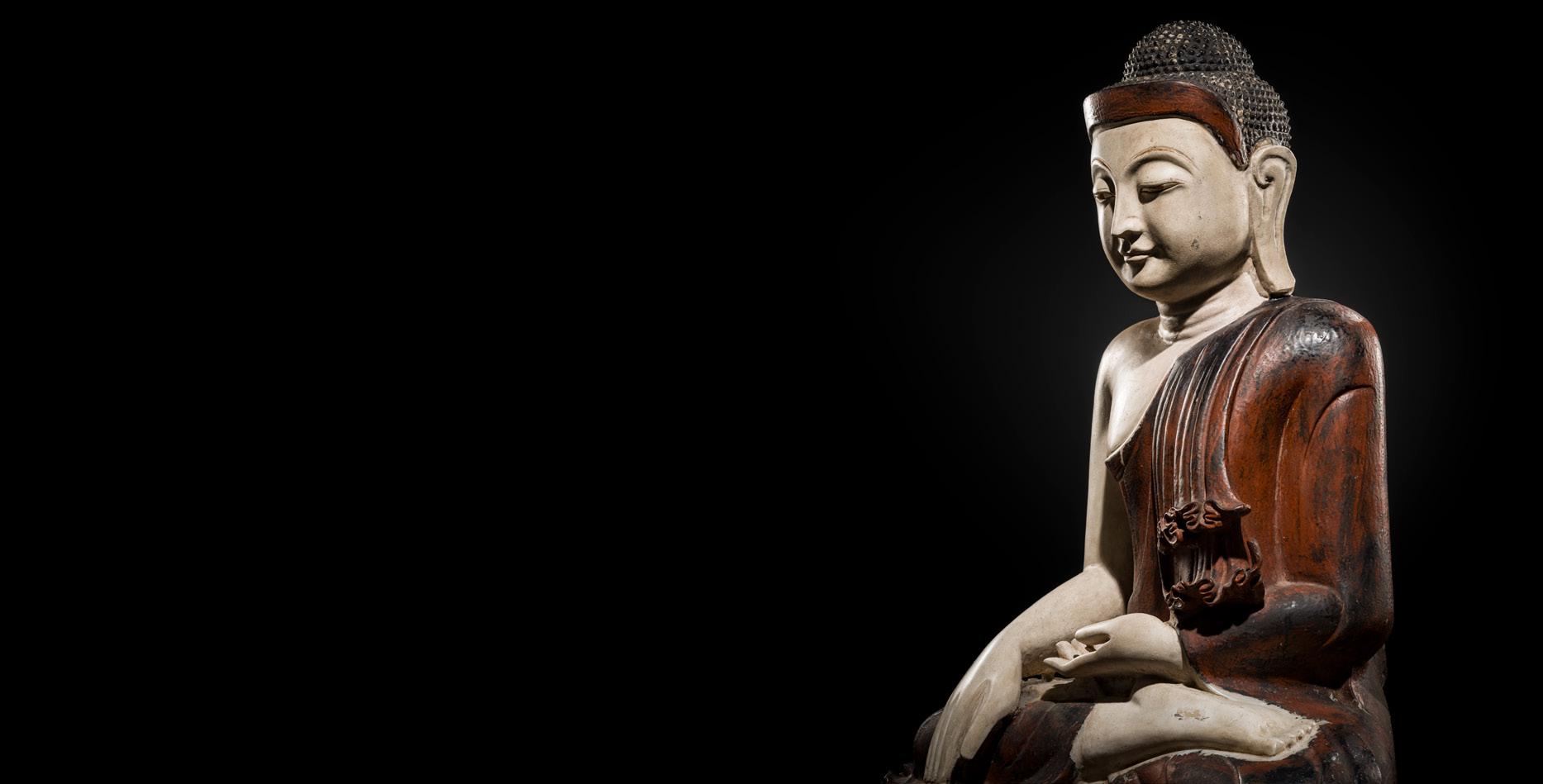
As this is a Museum Deaccession auction, all lots are offered with No Reserve, allowing bids below the starting prices to be considered.
Please note that the starting prices have been set at exceptionally low levels to encourage participation.
We encourage you to take advantage of this unique opportunity to acquire remarkable pieces at highly competitive prices.
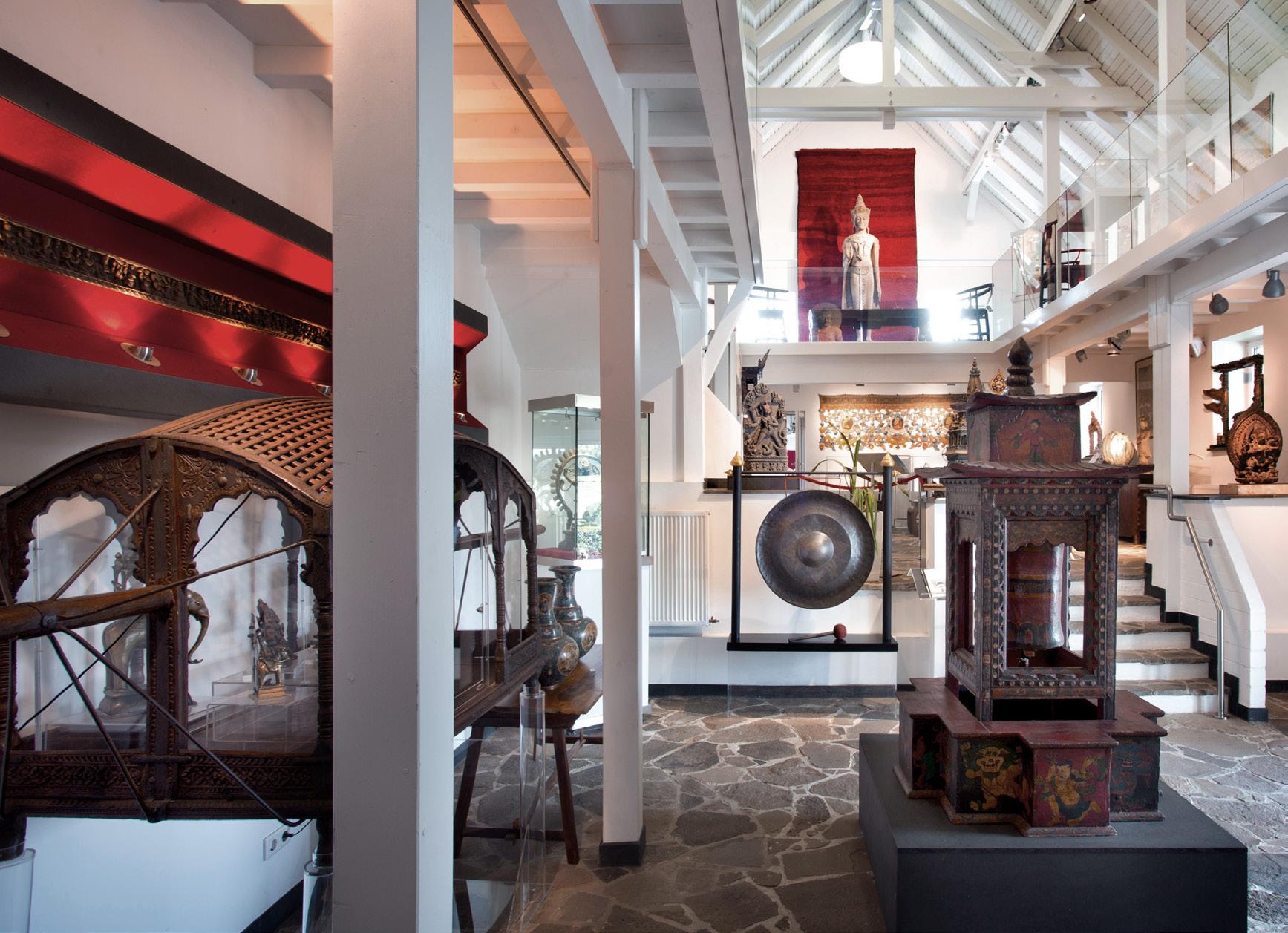
It is with great respect that we present the second and final part of the Peter Kienzle-Hardt Museum Treasury, a unique collection that stands as both a personal legacy and a window into the artistic and spiritual traditions of many diverse cultures. This compendium of religious art and cultural heritage, assembled over decades by the Kienzle siblings and lovingly preserved through the stewardship of their sole heir Peter Kienzle-Hardt, reflects not only their shared fascination with Asian culture but also their profound respect for the spiritual and artistic heritage of the regions they explored. In this foreword, we invite you to discover the compelling story behind this extraordinary collection, its journey through time, and the legacy it offers to connoisseurs and collectors around the world.

Dr. Horst Kienzle (1924-2019), the youngest of three siblings who grew up in Stuttgart before and during World War II, was only fifteen years old when the Nazis invaded Poland in 1939. His sister Else (1912-2006), the eldest, studied at the University of Tübingen from 1935 to 1937. She was a frontline medic during the war and later became a successful pharmacist who ran her own pharmacy near Bad Cannstatt station in Stuttgart for decades. His brother Reinhold (1917-2008) served in the Luftwaffe during the war and afterwards pursued a career as an engineer. Like all families during the Second World War, the Kienzle siblings must have witnessed unfathomable horrors. While all three led relatively long lives, none of them ever married or had any children.

The siblings lived together for much of their lives, sharing homes in the Stuttgart borough of Bad Cannstatt, where Else’s pharmacy still operates to this day, and Oberammergau in Garmish-Partenkirchen, where Horst was chief anesthesiologist at the county hospital between 1968 and 1990.

They were avid travelers, beginning their journeys in the 1950s across West Asia with their mother Emilie (1882-1970). The family’s wealth originated from Kienzle Uhren, Germany’s oldest watchmakers. Horst and Else’s professions provided the financial means to travel extensively and amass a significant art collection over decades.
By the early 1970s, this collection had gained renown, as evidenced by a statement written by Dr. Marianne Yaldiz, director of the Museum of Indian Art in Berlin from 1986 to 2006.
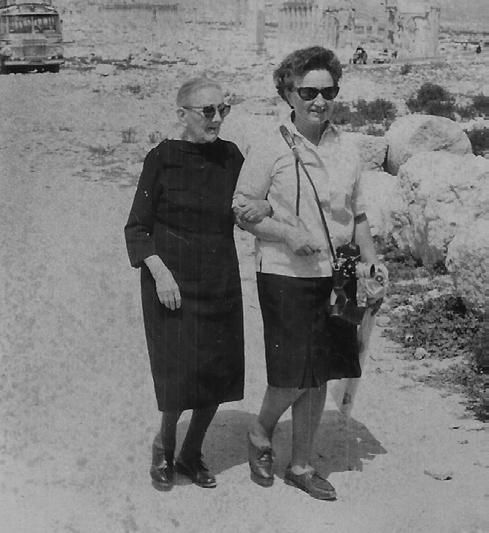
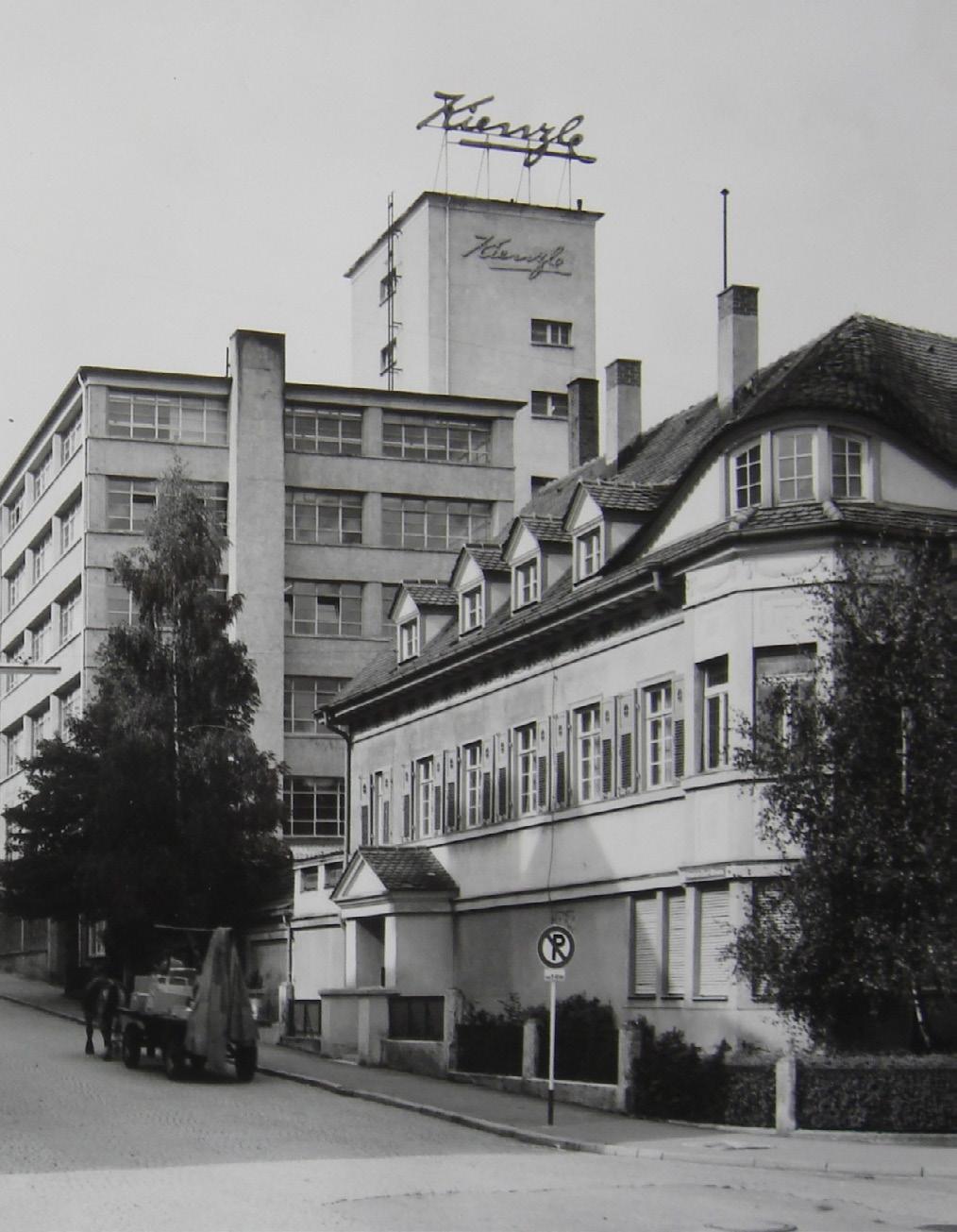


Many of the Kienzles’ trips , including their first ventures into the Himalayan realm, were organized by the mountaineer Günter Hauser (1928-1981) and his travel company Hauser Exkursionen. Günter Hauser was the first German to organize expeditions in Nepal, and for his services to the country he was named Royal Nepalese Consul in Munich (as can also be seen in visa stamps on the Kienzles’ passports).
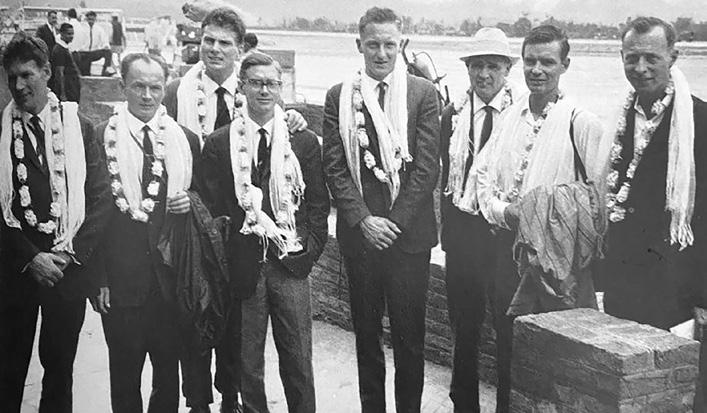
The siblings were also friends with the Austrian explorer Heinrich Harrer (1912-2006), author of Seven Years in Tibet (1952), famously portrayed by Brad Pitt in the 1997 film adaptation. While Hauser’s expeditions focused on extended hikes, ascending mountain peaks, and reaching new heights in a strictly literal sense, the Kienzles sought out and explored temples, monasteries, and markets, striving to experience religious festivals, dances, and other rituals and celebrations.

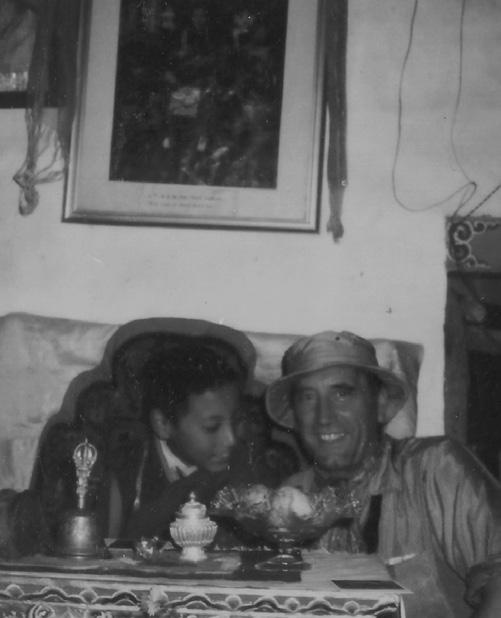
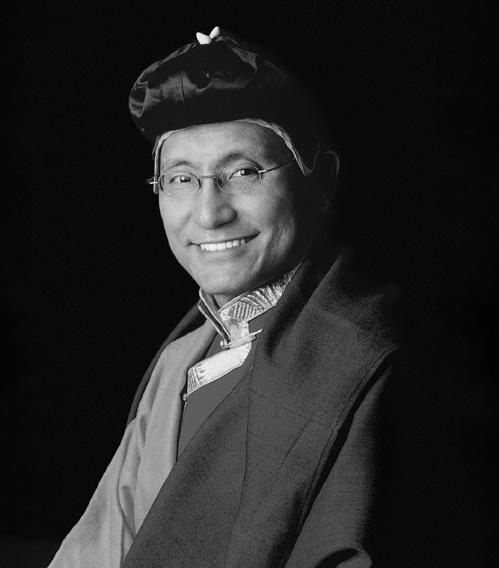
Driven by their ever-growing hunger for fine bronzes and thangkas, they would always try to find the best pieces wherever they traveled, investing large sums of money and forging lasting relationships to ensure they could acquire them. Their fervor and success in this pursuit, unparalleled among their fellow travelers, is not only demonstrated by their collection but further recorded in correspondences between Horst Kienzle and several businesses and individuals in Nepal and India, including the 12th Gyalwang Drukpa, Jigmet Pema Wangchen (b. 1963) in Ladakh.

The Kienzles supplemented their collection with purchases from auction houses and dealers such as Joachim Baader with his gallery Schoettle Ostasiatica in Stuttgart, Ludwig Bretschneider in Munich, and a young Peter Hardt, who would later play a pivotal role in the collection’s future. According to a statement written by Dr. Horst Kienzle on New Year’s Eve 2015, the siblings spent a total of DEM 2,500,000 or approx. EUR 4,000,000 on their collection alone – a conservative estimate calculating inflation based on the assumption that the bulk of their purchases were made between 1965 and 1985.
Born in 1946 in Remscheid, Peter Hardt began his career as a graphic artist and typesetter. He and his wife Ingrid (d. 2005), a schoolteacher, lived a relatively simple life until one day Ingrid confiscated a book from a student and gave it to Peter to read: Ich radle um die Welt (‘I Cycle Around the World’) by the German journalist and travel writer Heinz Helfgen (1910-1990). Helfgen’s account of his trip around the world on a bicycle between 1951 and 1953 deeply inspired Peter, and he convinced Ingrid to embark on a similar journey beginning in 1973. For almost a year, they cycled around the globe and discovered breathtaking sights and fascinating cultures. The experience profoundly changed their outlook and their lives.
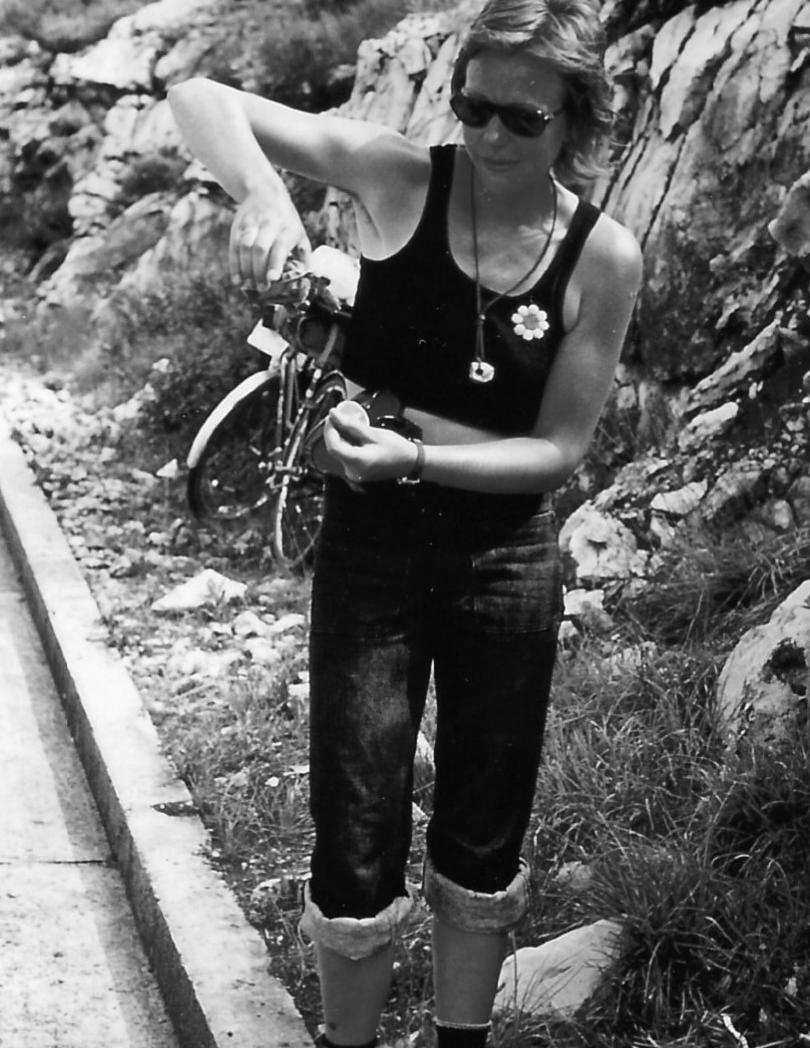
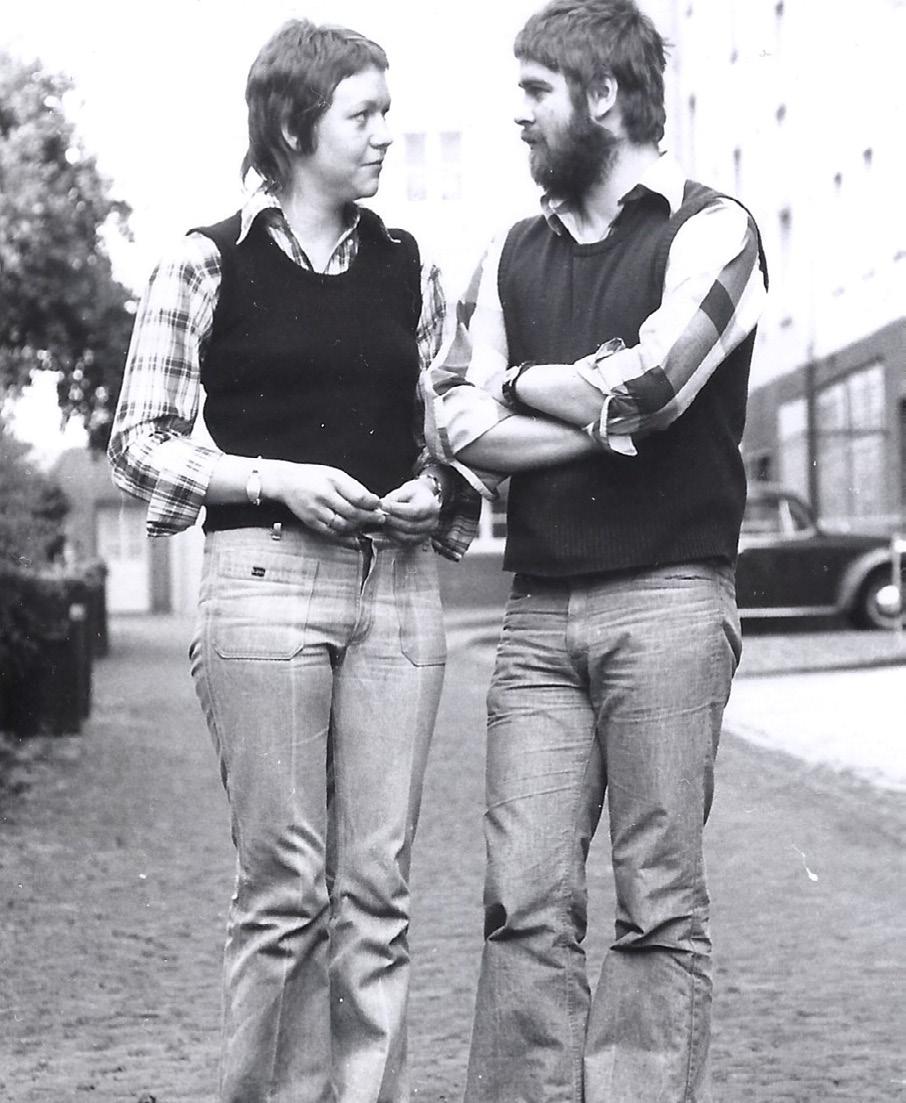

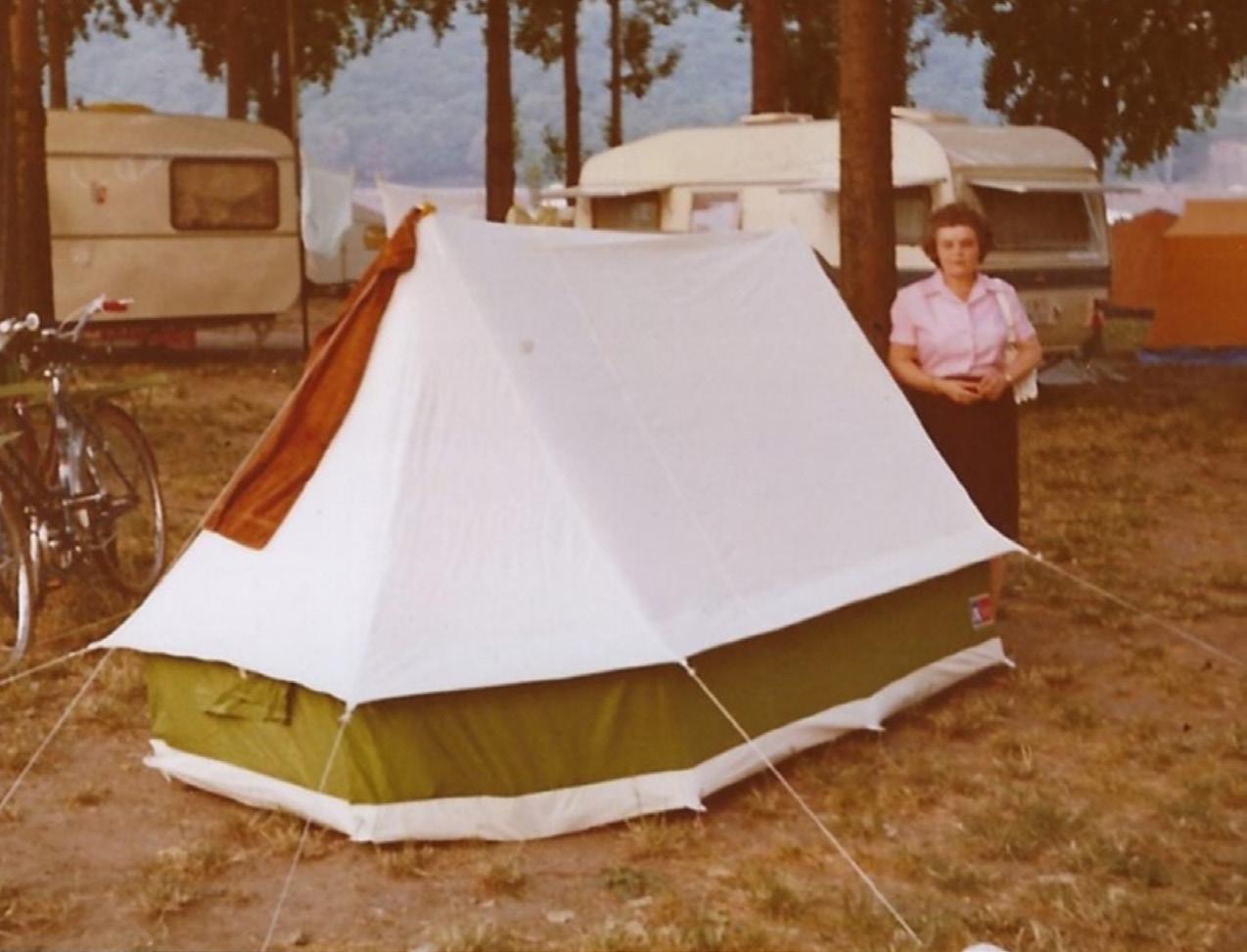
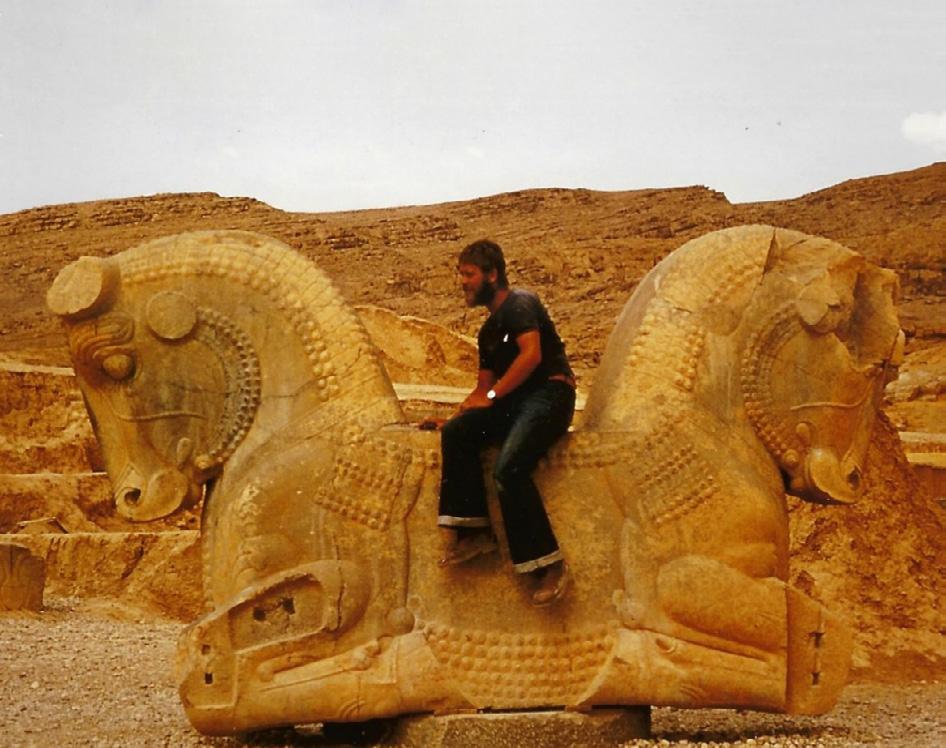
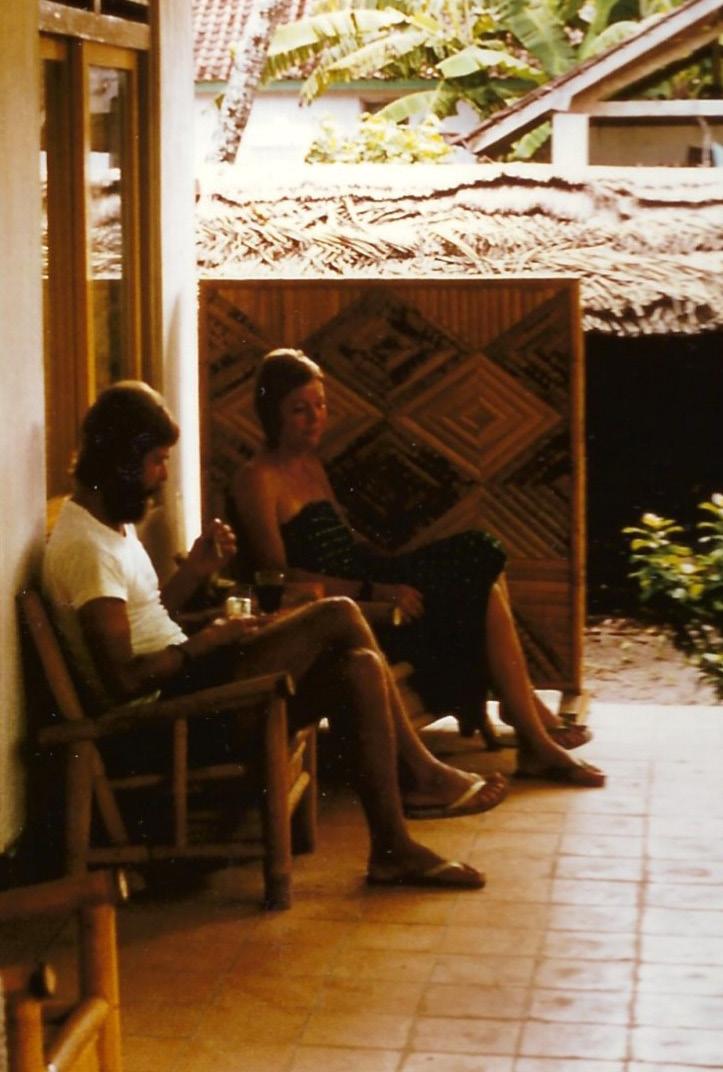
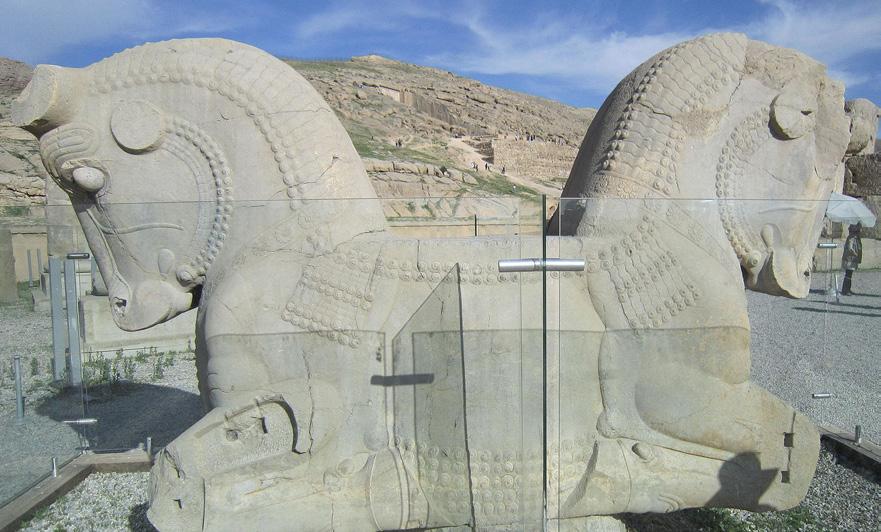
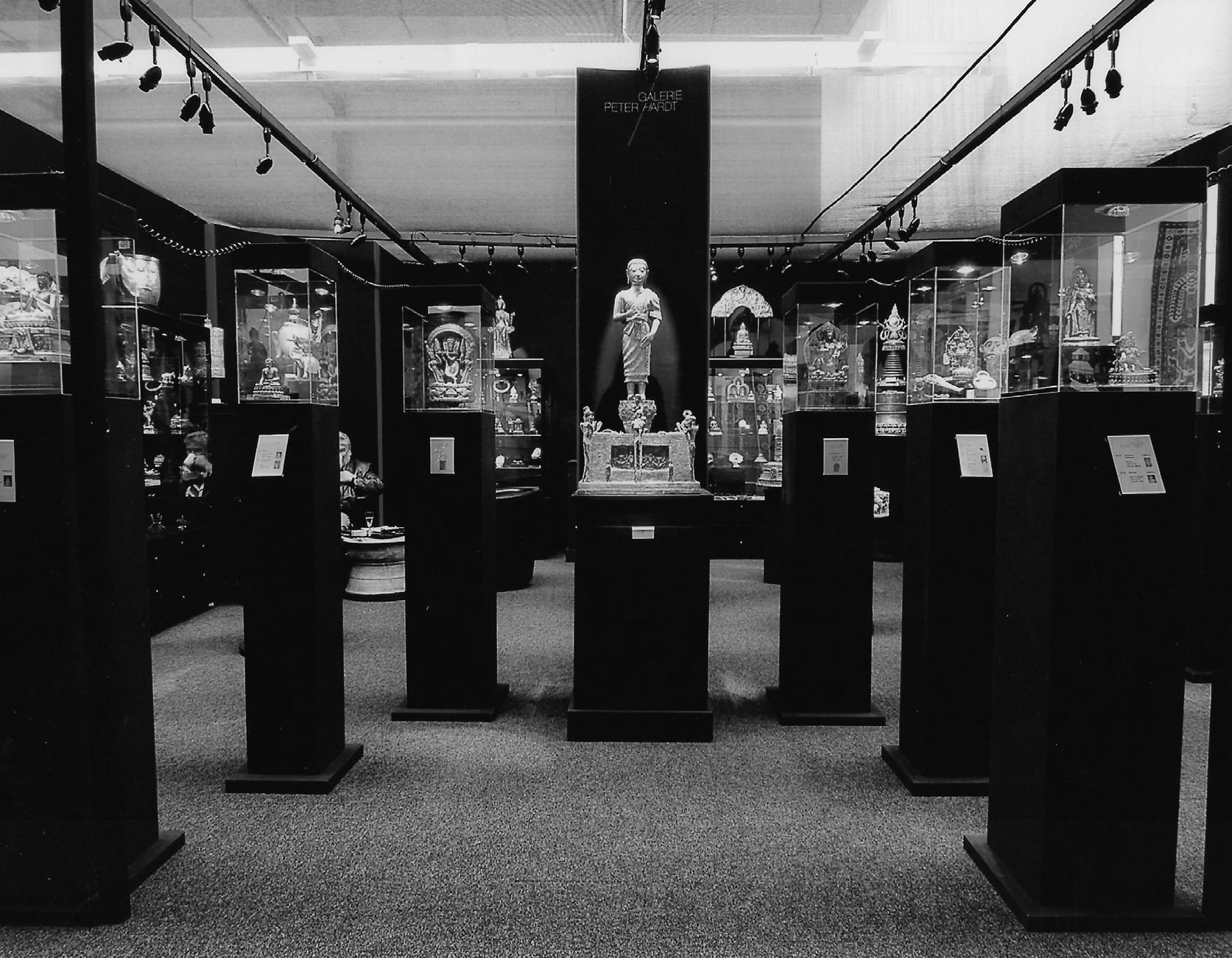
Upon returning to Germany, the couple began to sell some of the souvenirs they brought with them at local antique and flea markets. Their immediate success and heartfelt desire to share their experience of foreign cultures and passion for Asian art drove them to start a small business they named Kunsthandwerk der Nomaden (‘artisan crafts of the nomads’), Galerie Hardt, based in a small cottage in Sieplenbusch, Radevormwald in the former Duchy of Berg. Renamed simply Galerie Hardt in 1976, the gallery developed into one of Germany’s foremost purveyors of Asian antiques and works of art. Numerous trips across Asia followed, although these were now usually made by car.
Throughout his storied career, Peter organized countless exhibitions and participated in major international art fairs. He made many important contacts during this time and eventually met the Kienzle siblings, who shared his passion for Asian art and culture. A strong bond and deep friendship developed, ultimately leading to the creation of the Museum für Asiatische Kunst decades later.
In the early 2000s , nearly twenty years after the Kienzle siblings stopped collecting around 1985, they began searching for a custodian for their collection. They turned to their old friend Peter Hardt, but their initial hopes of donating the collection to a state museum were unfulfilled, as none could ensure its permanent exhibition. Eventually they decided that Peter Hardt would build a private museum of Asian art in Sieplenbusch – the same location as his first gallery. Planning and construction took over a decade and cost more than three million euros
When the museum opened to the public in 2014, Horst was the only surviving sibling. He attended the opening ceremony and moved to Radevormwald to remain close to the collection, living with Peter Hardt and his second wife Hong Li-Hardt (b. 1971). The museum became his pride, and he cheekily referred to himself as its ‘guard dog’. Featuring over 200 diverse and beautiful exhibits surrounded by a sculpture garden with over-lifesize statues of Buddha and other deities near a large koi pond, the museum was run by Li, who had emigrated from Shanghai and met Peter in 2009. Peter continued Galerie Hardt to help sustain the museum, even as visitor numbers remained modest. Before his death in 2019, Horst bequeathed his entire property to Peter and legally adopted him as his son, who has been using the name Peter Kienzle-Hardt ever since.
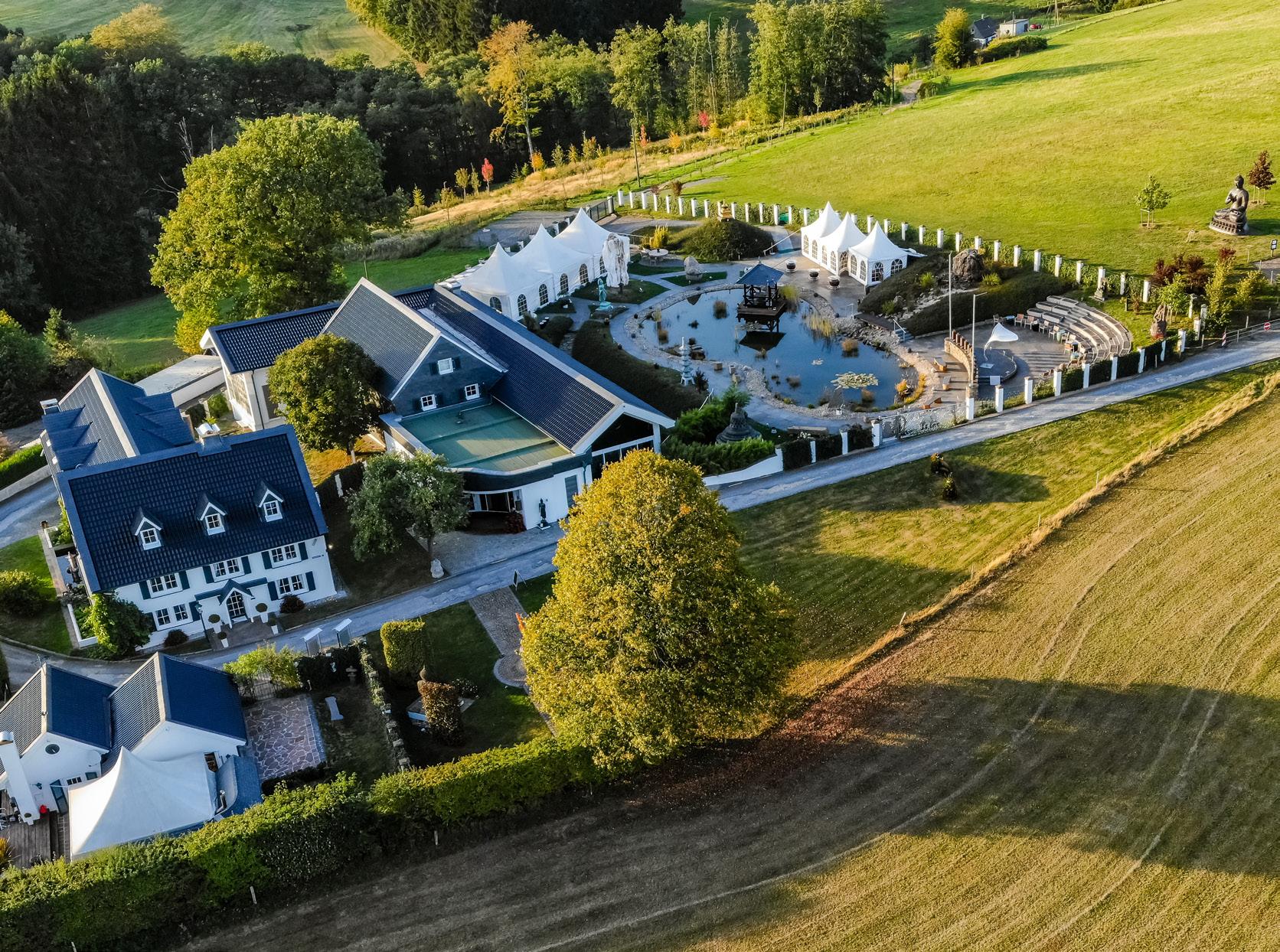
After art fairs and shows were canceled during the CoV pandemic, Peter Hardt retreated from the gallery business in 2020. The museum, now reliant on its own revenue, began hosting more events like their popular annual light festival as well as jazz concerts, Chinese costume shows, and large weddings. However, several important pieces from Peter’s private collection, including objects formerly in the Kienzle Family Collection and deaccessioned from the museum, had to be sold through auction houses to keep the museum afloat.
In the summer of 2024, the museum closed its doors, officially for renovations, but heading into an uncertain future. It is a sad and telling fact that despite the years of hard work and millions of euros spent, the substantial, unique, and important collection built by the Kienzle siblings could be preserved in its entirety for only a short time in the oft-touted cultural landscape of Germany, which offers no subsidies for private museums and is mired in endless regulations. Yet the museum’s struggles allowed us at Zacke the privilege of putting together a phenomenal two-part auction that has already resonated powerfully in the Asian art world.
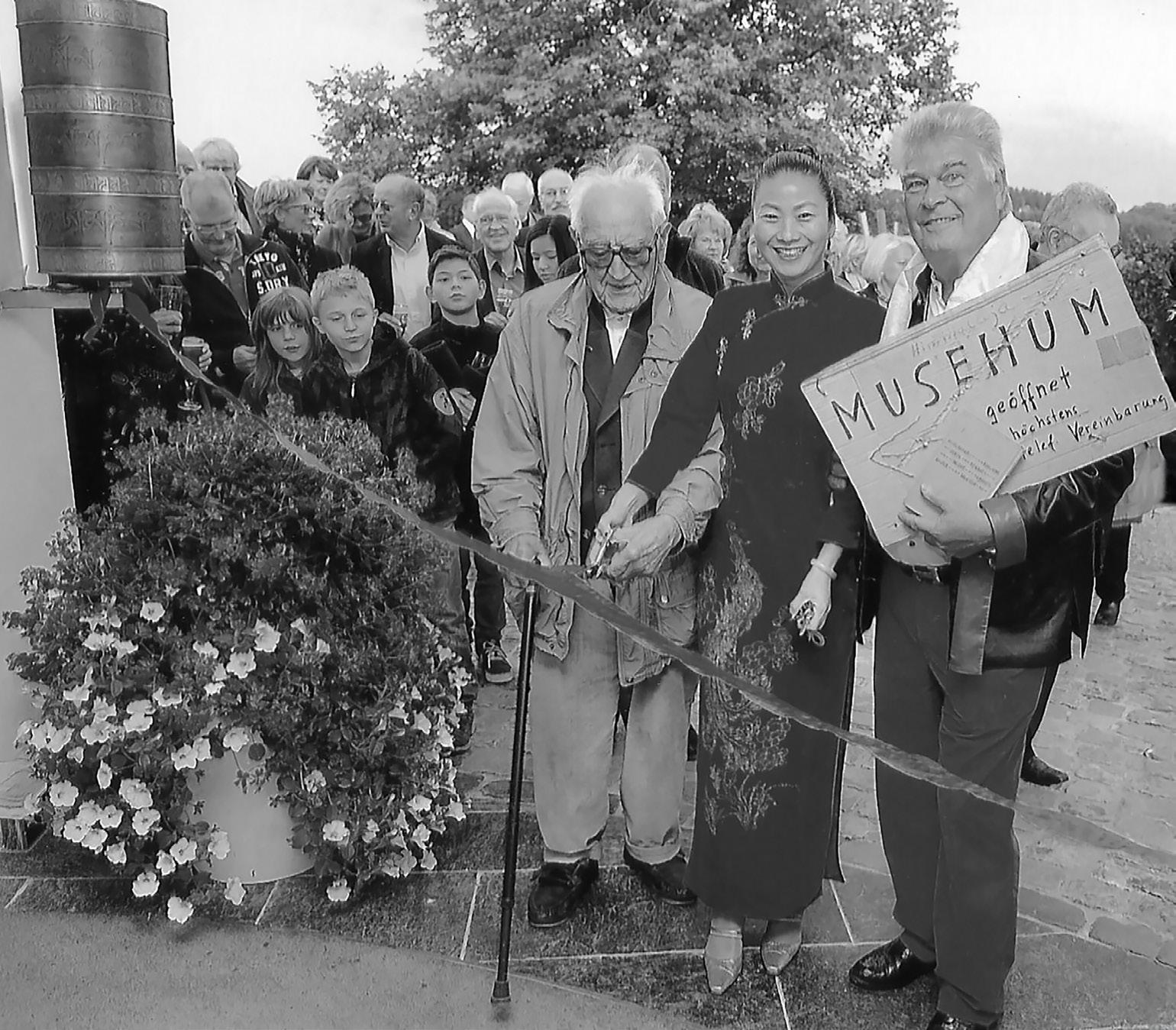
The first part of this Museum Treasury auction, which focused on Buddhist and Himalayan art, took place on 7 March 2025 and achieved a near 100 % sell-through rate , with several pieces reaching remarkably high results, such as the monumental bronze Padmasambhava, lot 96, sold for EUR 104,000 , and the late Malla lacquered wood figure of Green Tara, lot 74, sold for EUR 65,000. We were honored to welcome Peter Kienzle-Hardt himself to the auction, alongside bidders and visitors from around the world. The sale was a resounding success, providing a fitting continuation of the Kienzle-Hardt legacy and reaffirming our customers’ appreciation for authentic works of art imbued with history and spiritual power.
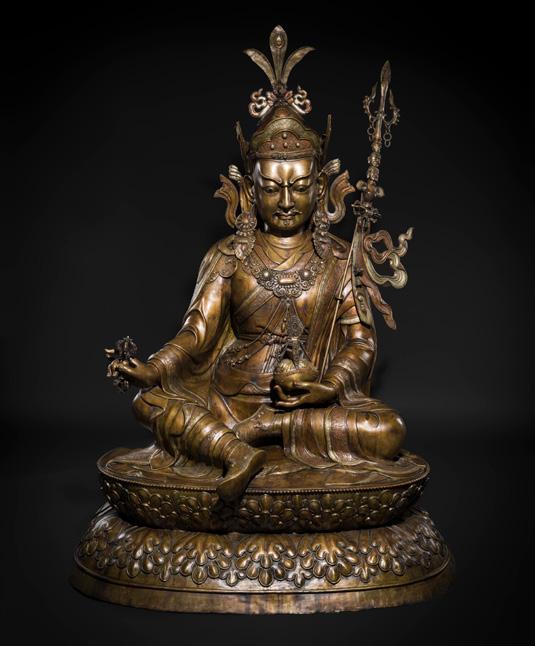
Sold for €104,000
The wood frieze from the Kasthamandap shrine in Kathmandu, withdrawn before the first sale (lot 122) and currently awaiting repatriation to Nepal, bears mentioning in this regard. Its origin was identified by Nepalese cultural activists including Lost Arts of Nepal, who claimed it had been “stolen” after the 2015 earthquake. While we support efforts to protect cultural heritage, we reject public accusations when evidence is inconclusive. In fact, the Kienzles most likely acquired the panel during one of their visits to Kathmandu decades earlier.
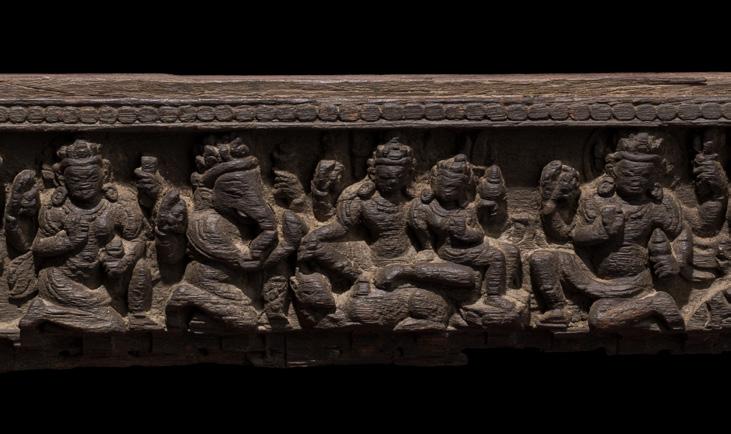
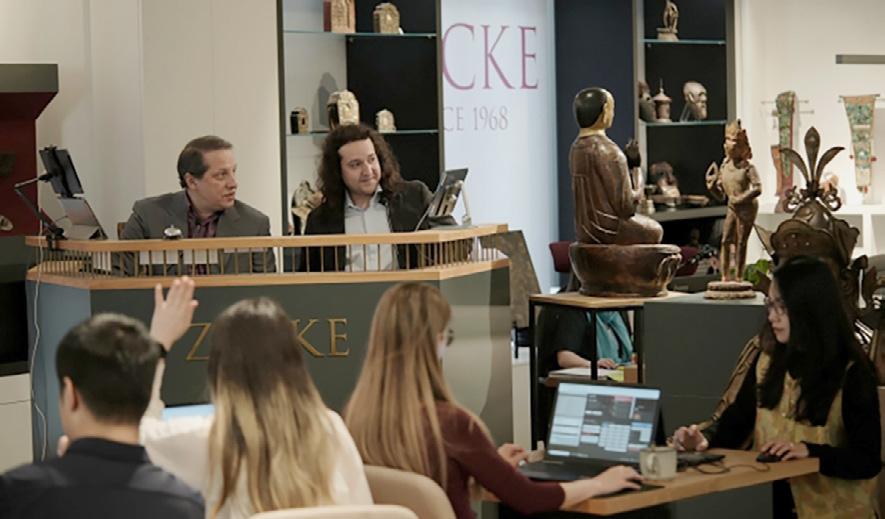

salvage re-enter the art market through legitimate channels. It is highly plausible the frieze was removed during such a renovation and sold locally, where the Kienzles, known for their methodical and direct approach to collecting, acquired it from a local dealer or craftsman, unaware of any future controversy. Nevertheless, we are facilitating its return in a spirit of transparency and respect, with the expectation that it will be reinstated in the rebuilt Kasthamandap and its return officially commemorated. We hope to share positive news on this front soon.
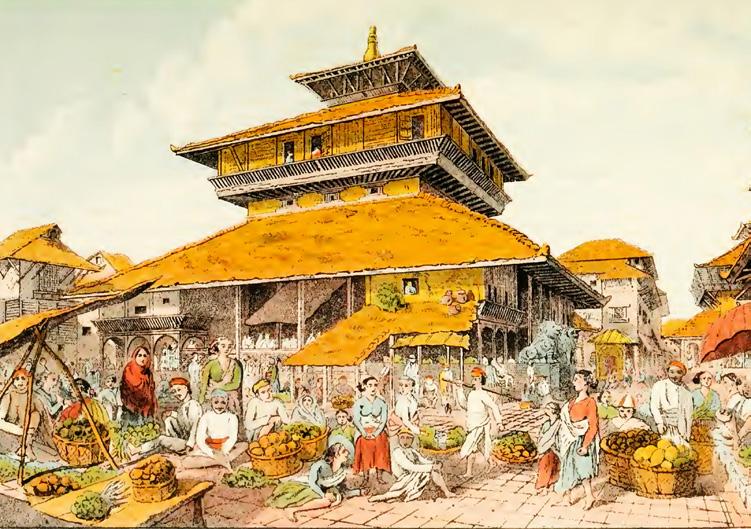
was
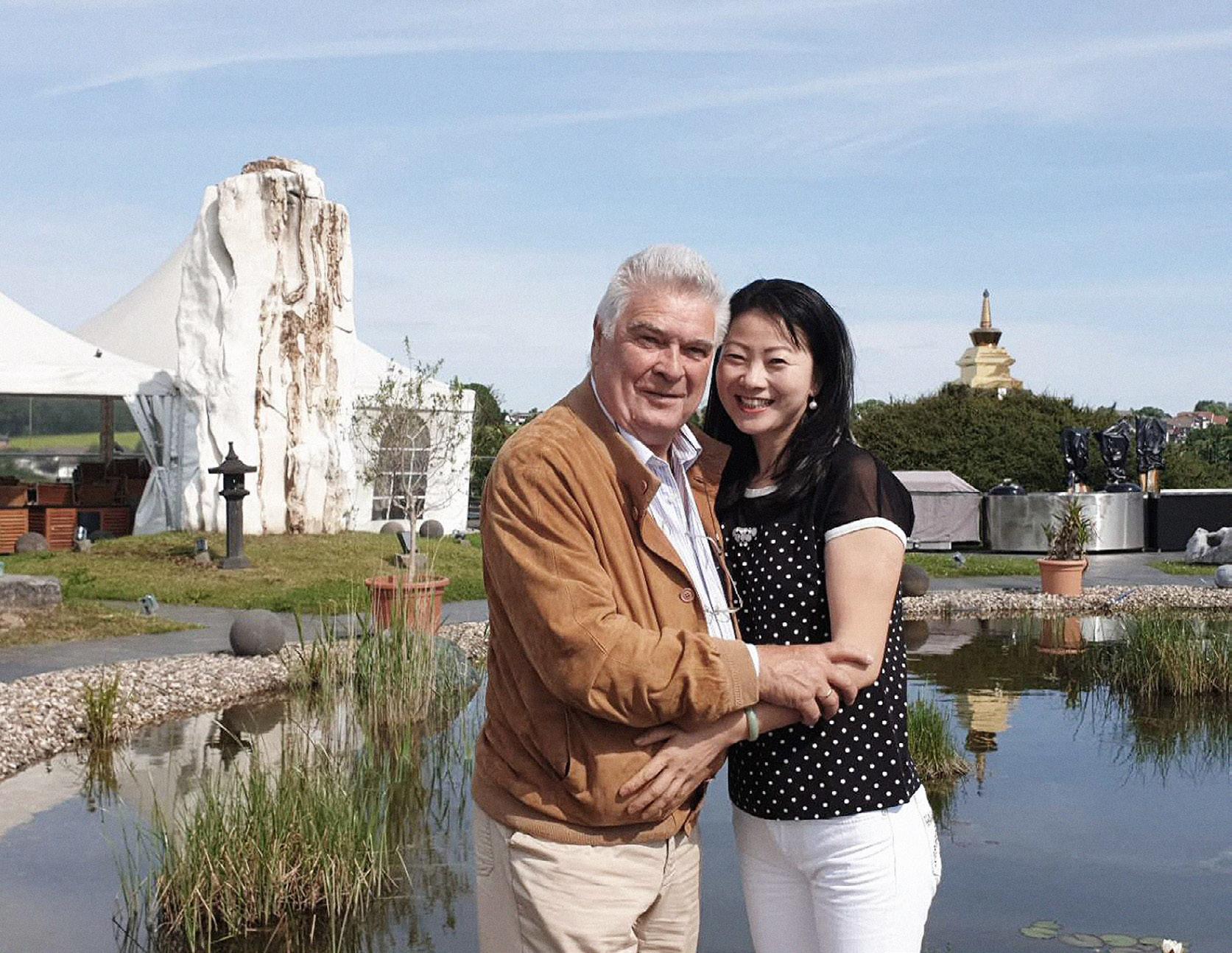
This auction offers a broader perspective than the first, spanning four continents and six millennia, in keeping with the Kienzles’ dual roles as cultural explorers and patrons. There is a focus on the arts of India and Southeast Asia, particularly Thailand, complemented by Chinese works including a historically important group of official stone weights (lots 1070–1074), as well as remarkable artifacts from around the world. As in the first sale, the selection includes many decorative objects including those of daily use, ritual implements, and musical instruments, but the majority comprises religious images, some created for everyday people and others for elites and kings, with spectacular highlights surpassing anything seen in Part I, such as two colossal 3.5-meter (!) bronze statues of Avalokiteshvara and Buddha (lots 1137 and 1138), and a monumental 175 cm tall Gandharan schist torso of Buddha (lot 1140).
The lots in this auction are the last remaining objects deaccessioned from the Museum für Asiatische Kunst , which will continue to operate as an event space. This sale marks the conclusion of a remarkable journey shaped by devotion, curiosity, and deep reverence for the cultures encountered. We are proud and delighted to carry this legacy forward and invite you to take part in writing the next chapter.
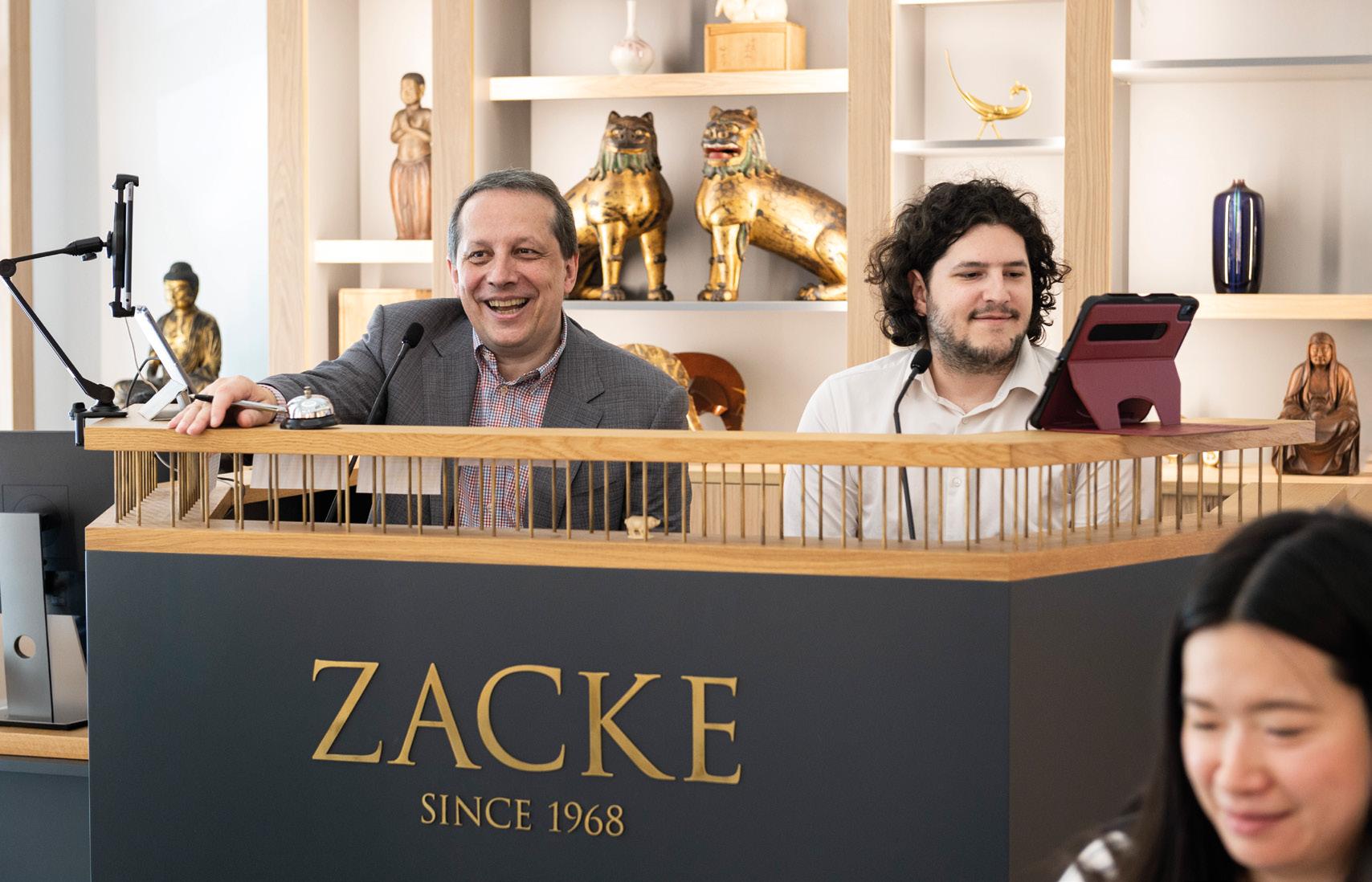
Dear Collectors,
We have opened our brand-new, 6,000-square-foot exhibition, showroom, and auction rooms at Zelinkagasse 6, 1010 Vienna!
Starting 1 September you’ll be able to explore the exceptional pieces featured in this auction at Zelinkagasse 6, 1010 Vienna.
We have opened our brand-new, 6,000-square-foot exhibition, showroom, and auction rooms at Zelinkagasse 6, 1010 Vienna!
We have opened our brand-new, 6,000-square-foot exhibition, showroom, and auction rooms at Zelinkagasse 6, 1010 Vienna!
HOW TO FIND OUR NEW AUCTION & SHOWROOM JOIN US LIVE
10 September 2025 at 11 am CET
Attend in person at our new auction room at Zelinkagasse 6 or participate online via Zacke
Live – and enjoy premium buyer’s terms with no additional online bidding fees.
10 September 2025 at 11 am CET
Starting 1 September you’ll be able to explore the exceptional pieces featured in this auction at Zelinkagasse 6, 1010 Vienna.
Attend in person at our new auction room at Zelinkagasse 6 or participate online via Zacke Live – and enjoy premium buyer’s terms with no additional online bidding fees
Our new additional auction and preview space at Zelinkagasse 6 in Vienna’s 1st district is just a seven-minute walk from our 10,000-square-foot office, photography, video, and cataloging hub at Sterngasse 13.
Register now: www.zacke.at
Starting 1 September you’ll be able to explore the exceptional pieces featured in this auction at Zelinkagasse 6, 1010 Vienna. HOW TO FIND OUR NEW AUCTION & SHOWROOM JOIN US LIVE
Register now: www.zacke.at
10 September 2025 at 11 am CET
Attend in person at our new auction room at Zelinkagasse 6 or participate online via Zacke
Live – and enjoy premium buyer’s terms with no additional online bidding fees
Register now: www.zacke.at
Our new additional auction and preview space at Zelinkagasse 6 in Vienna’s 1st district is just a seven-minute walk from our 10,000-square-foot office, photography, video, and cataloging hub at Sterngasse 13.
Easily accessible by public transport or car (a parking garage is located nearby).
Easily accessible by public transport or car (a parking garage is located nearby).
By Public Transport:
Our new additional auction and preview space at Zelinkagasse 6 in Vienna’s 1st district is just a seven-minute walk from our 10,000-square-foot office, photography, video, and cataloging hub at Sterngasse
SCHOTTENRING station
By Public Transport: SCHOTTENRING station
ZELINKAGASSE 6
STERNGASSE 13
(U2, U4, tram lines 1, 31, 71, D, and bus 3A)
(U2, U4, tram lines 1, 31, 71, D, and bus 3A)
10 September 2025
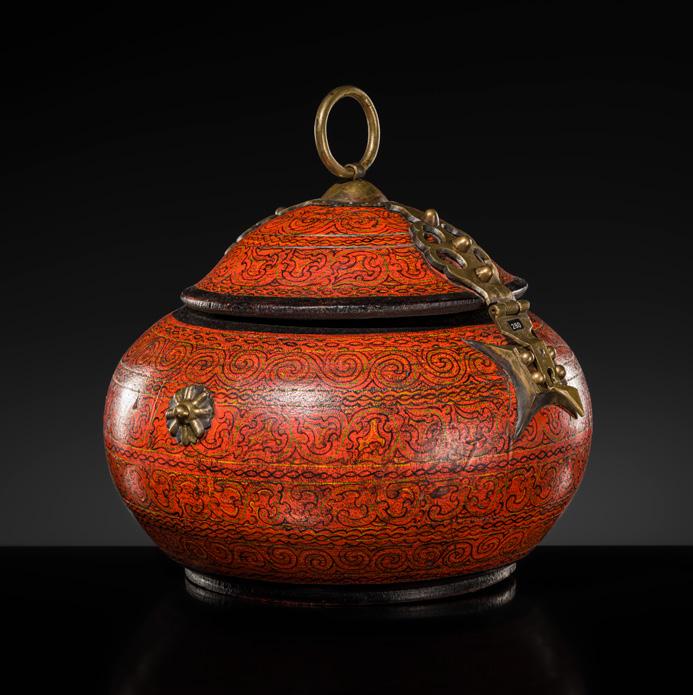
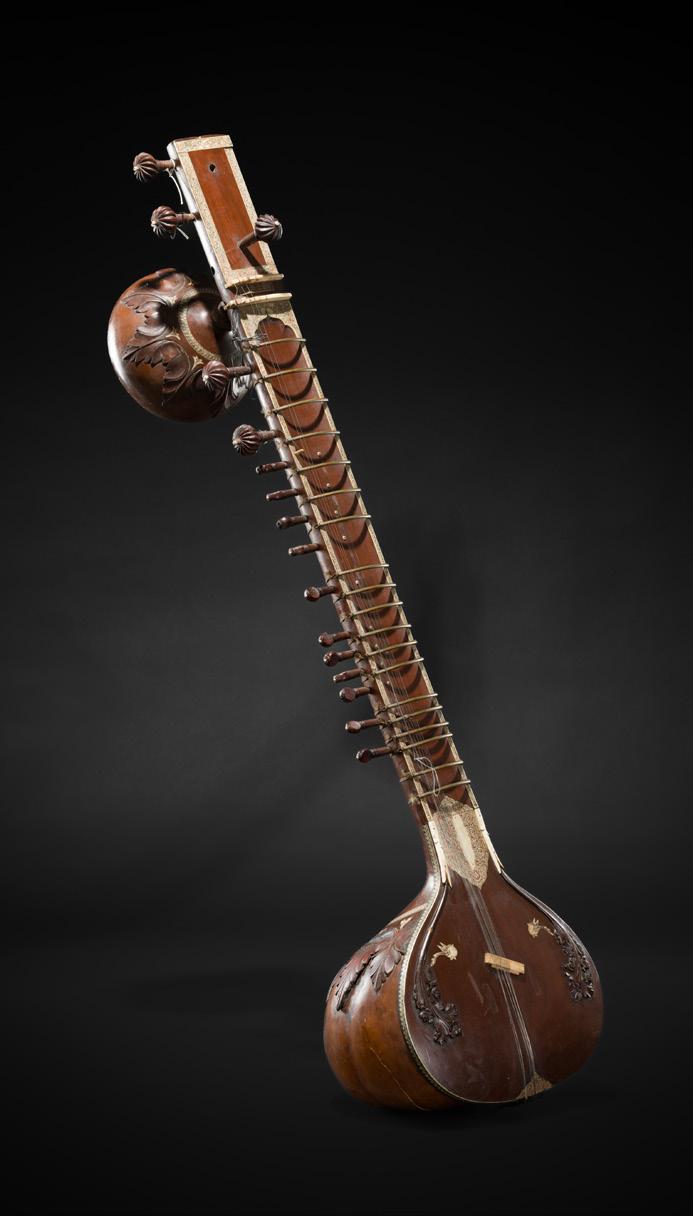

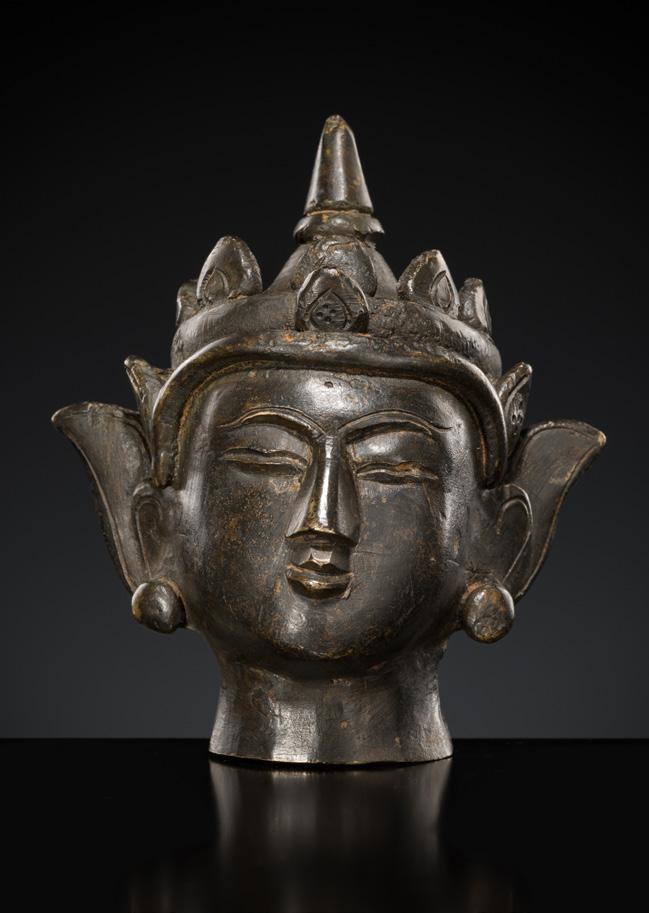
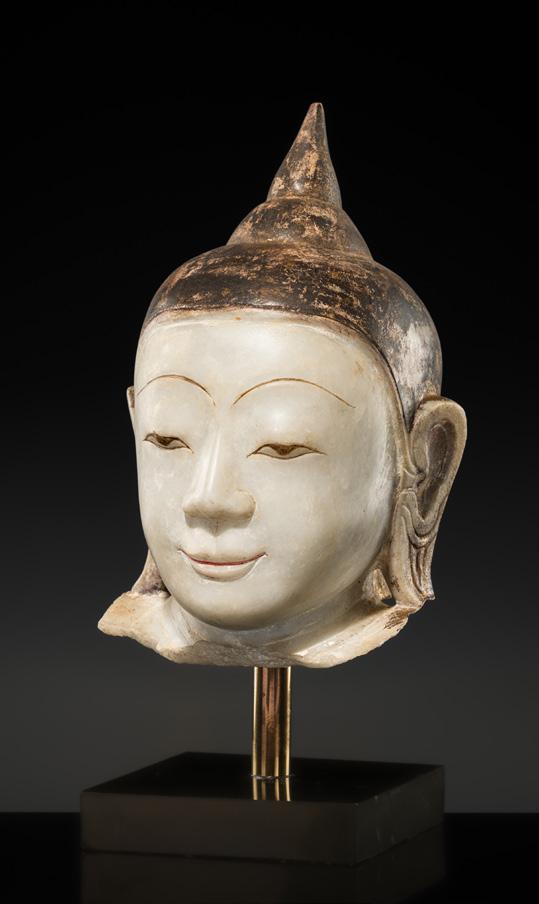
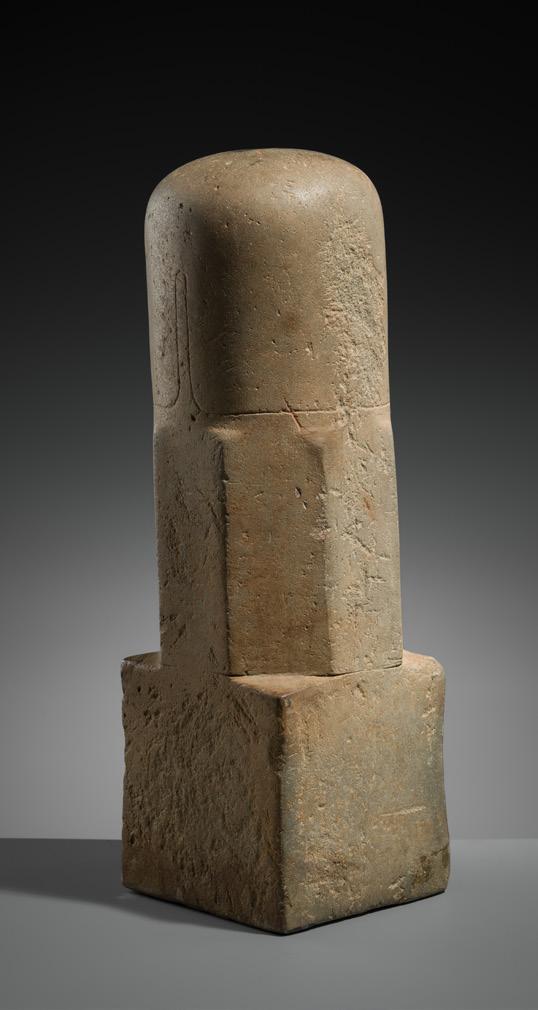
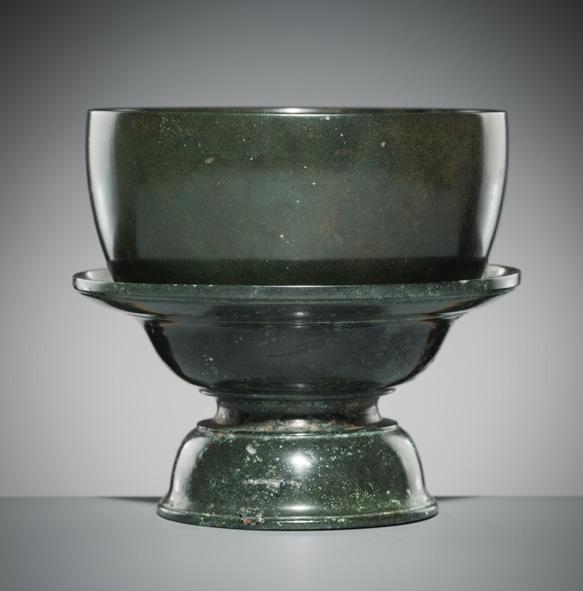

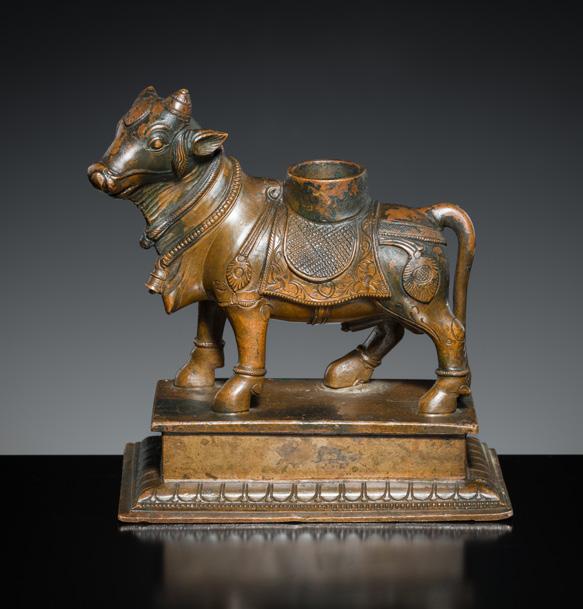
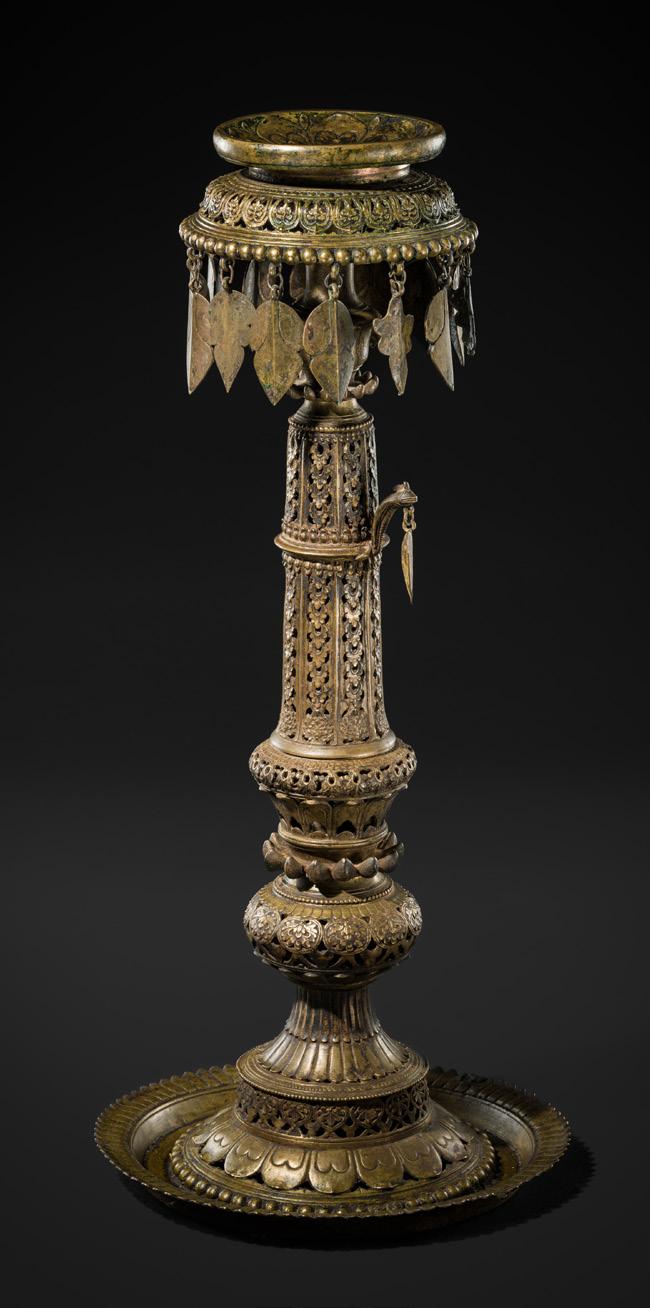

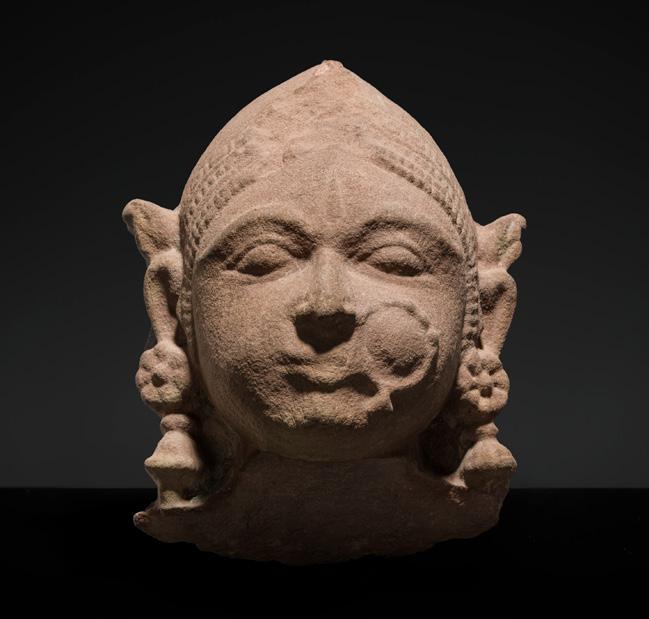


A RARE KHMER SANDSTONE INSCRIBED STELE, BAPHUON PERIOD, 11TH CENTURY
Khmer Empire. The rectangular panel supported on a slightly flaring base and topped by a foliate arch, finely carved to the center with a squatting male deity wearing a pleated sampot, surrounded by inscriptions in Khmer script.
Provenance: Galerie Hardt (established in 1976), Radevormwald, Germany, before 2020. Acquired by the gallery’s founder Peter Hardt (b. 1946) during his extensive travels in Asia, the first of which occurred during a formative world tour in 1973.
Condition: Very good condition with wear, obvious losses, small cracks, signs of weathering and erosion, small nicks, few chips, encrustations. Most of the inscription is preserved well.
Dimensions: Height 55 cm (excl. stand), 65.5 cm (incl. stand)
With an associated wood stand. (2)
Inscriptions on steles constitute an important aspect of the epigraphy of Cambodia. Both Sanskrit and Khmer inscriptions coexisted until the 13th century, after which Sanskrit was no longer used.
The present stele is among the relatively few examples of steles including a sculptural element, either of Hindu or Buddhist content, and that may or may not be related to the actual context; see for example an 11th century stele from Palhal in the National Museum of Cambodia, illustrated ibid., cat. no. 61, p. 247.
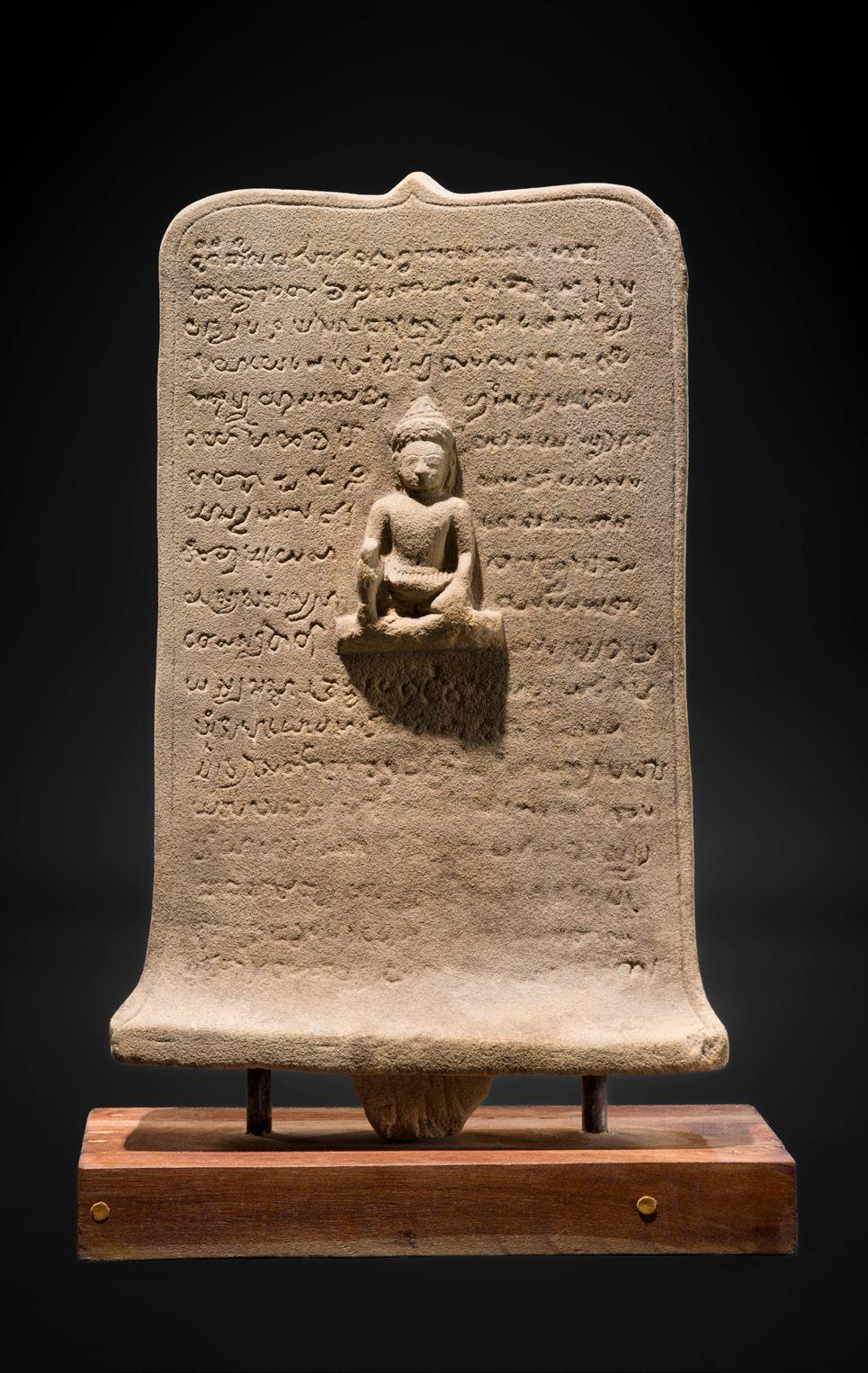
AUCTION RESULT COMPARISON
Type: Closely related
Auction: Bonhams London, 5 November 2009, lot 58
Price: GBP 10,800 or approx. EUR 23,500 converted and adjusted for inflation at the time of writing
Description: A rare Khmer sandstone inscribed stele, Cambodia, Baphuon period, 11th century
Expert remark: Compare the closely related form and similar squatting male deity. Note the size (77.5 cm).
AUCTION RESULT COMPARISON
Type: Closely related
Auction: Christie’s Amsterdam, 12 October 2004, lot 169
Price: EUR 53,775 or approx. EUR 86,500 adjusted for inflation at the time of writing
Description: A rare Khmer, Baphuon style, inscribed sandstone stele, 11th century
Expert remark: Compare the closely related form and similar squatting male deity. Note the size (102 cm).
Estimate EUR 4,000
Starting price EUR 2,000


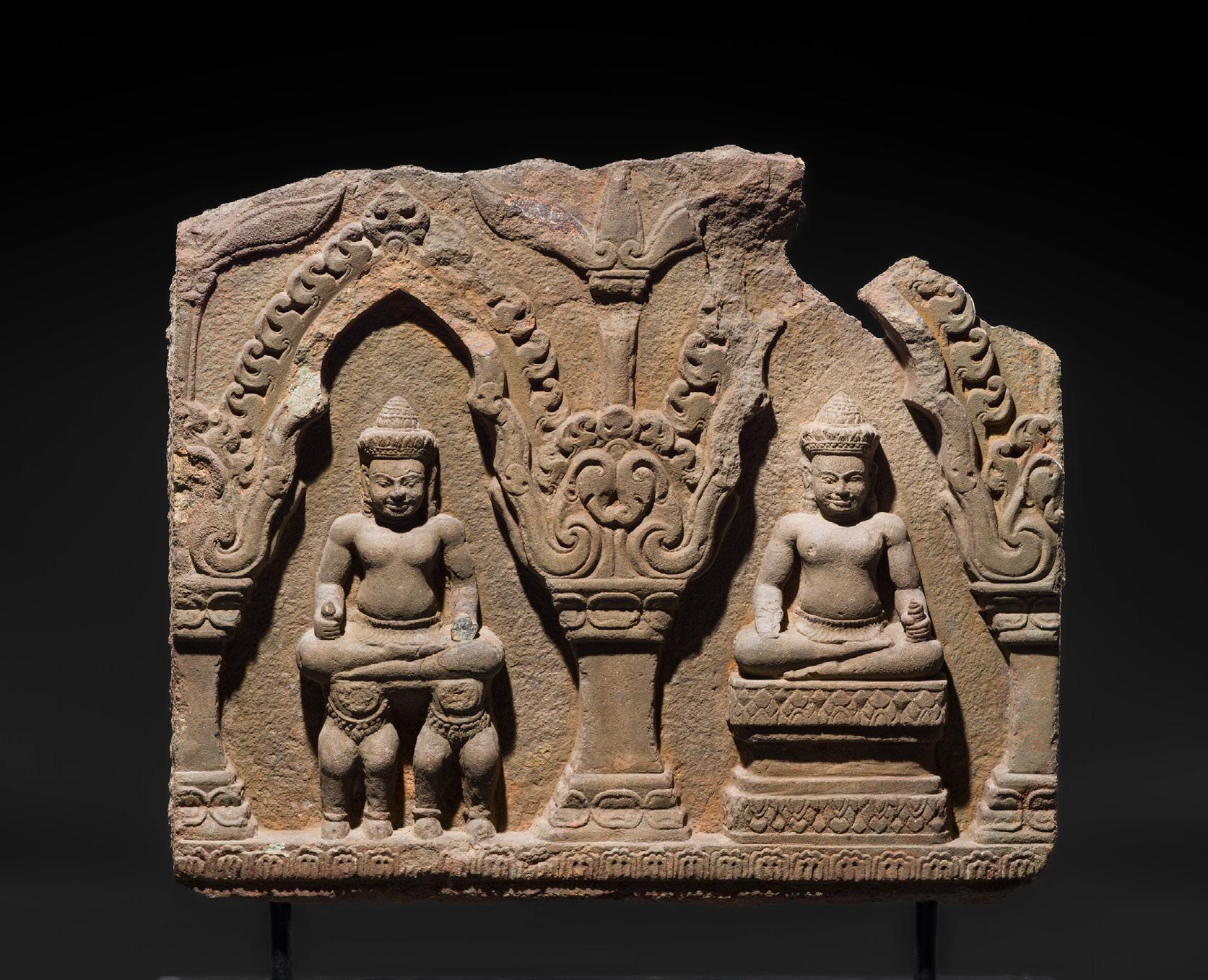
2
A SANDSTONE RELIEF DEPICTING SURYA AND CHANDRA FROM THE NAVAGRAHA, ANGKOR PERIOD, 11TH-12TH CENTURY
Khmer Empire. Finely carved under a foliate niche to depict Surya on a chariot drawn by two horses and Chandra sitting atop a tiered waisted plinth. Each deity is seated cross-legged with one hand clasped around a lotus bud, dressed in a short pleated sampot, all raised atop a lappet lotus band.
Provenance: Galerie Hardt (established in 1976), Radevormwald, Germany, before 2020. Acquired by the gallery’s founder Peter Hardt (b. 1946) during his extensive travels in Asia, the first of which occurred during a formative world tour in 1973.
Condition: Very good condition, commensurate with age. Wear, obvious losses, old repairs, signs of weathering and erosion, scattered nicks and scratches, and encrustations.
Weight: 83.5 kg (incl. stand)
Dimensions: Size 60 x 73 cm (excl. stand), 76 x 77 cm (incl. stand)
EXPERT’S NOTE:
The present lot is most likely a fragment of a relief depicting the nine planetary deities known as Navagraha. Compare a closely related relief of the nine planets dating from the 11th century, in Ak Yom, a smaller site excavated from Angkor’s Western Baray, illustrated by Ang Chouleun, Navagraha, Udaya: Journal of Khmer Studies, no. 14, 2019, p. 141, fig. 2.
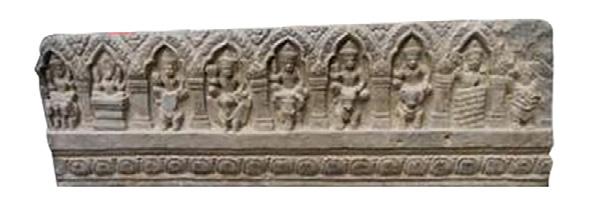
LITERATURE COMPARISON
Compare a closely related stone relief depicting the nine deities, Angkor period, dated 1000-1100, 139.7 cm wide, in the Asian Art Museum, San Francisco, object number B71S9.

AUCTION RESULT COMPARISON
Type: Related
Auction: Christie’s New York, 20 March 2019, lot 658
Price: USD 27,500 or approx. EUR 31,500 converted and adjusted for inflation at the time of writing
Description: A sandstone relief of an apsara, Khmer Bayon period, late 12th13th century
Expert remark: Compare the related manner of carving. Note the size (54.6 cm) and slightly later dating.
Estimate EUR 6,000
Starting price EUR 3,000
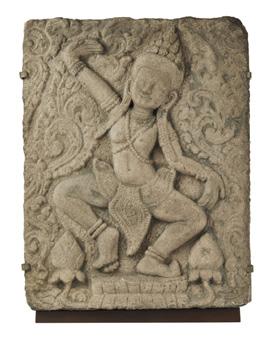

3
Khmer Empire, later Angkor period, Thailand, circa 12th-13th century. Each boldly carved, of octagonal section interrupted by two flat sides due to its structural purpose as corner shaft, one featuring a rectangular section at its base. Both horizontally ridged along their entire length decorated with bands of flower buds and varying foliage in high relief among the grooves. The fossiliferous stone of a reddish tone, marked with small dark patches and white inclusions.
Provenance: The Kienzle Family Collection, Stuttgart, Germany. Acquired between 1950 and 1985 by siblings Else (1912-2006), Reinhold (19172008), and Dr. Horst Kienzle (1924-2019), during their extensive travels in Asia. Subsequently inherited by Dr. Horst Kienzle and bequeathed to the Museum für Asiatische Kunst, Radevormwald, Germany. Released through museum deaccession in 2024.
Condition: Good condition, commensurate with age. Extensive wear, obvious losses, signs of weathering and erosion, scratches, structural fissures, chips, old repairs.
Dimensions: Height 155.3 cm and 167.1 cm (excl. stand); Height 180.2 cm and 189.7 cm (incl. stand)
Each mounted on an associated metal stand. (4)
The present pillars are closely related to examples found in the Khmer temple of Prasat Sikhoraphum, located between the cities of Surin and Sisaket in Thailand. Constructed in the 12th century under the reign of King Suryavaraman II, its five towers are arranged in the same quincunx pattern as Angkor Wat itself, an especially rare configuration outside of Cambodia. This sacred design is limited to royal temples, implying a high pedigree for this site.

Estimate EUR 8,000
Starting price EUR 4,000
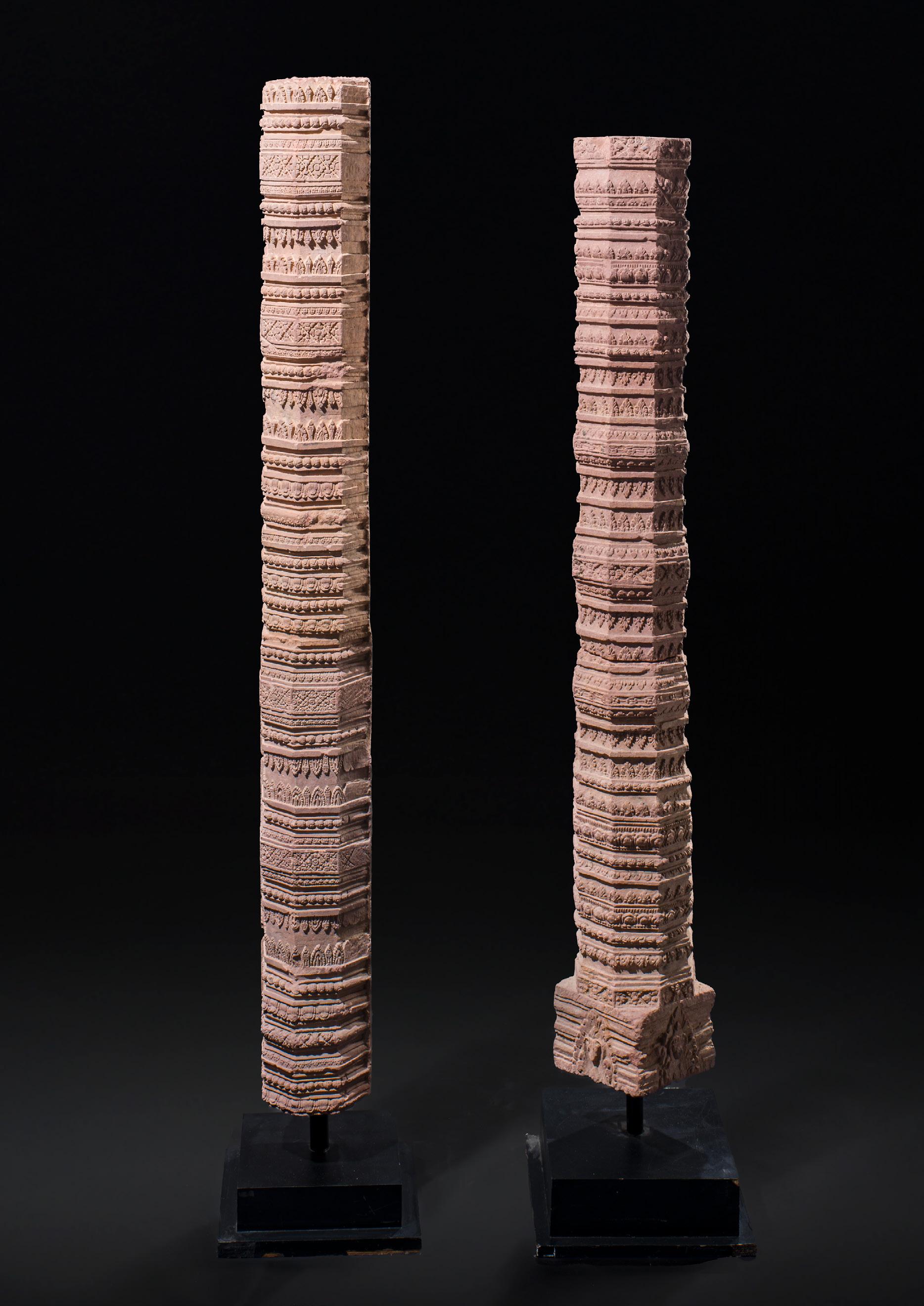
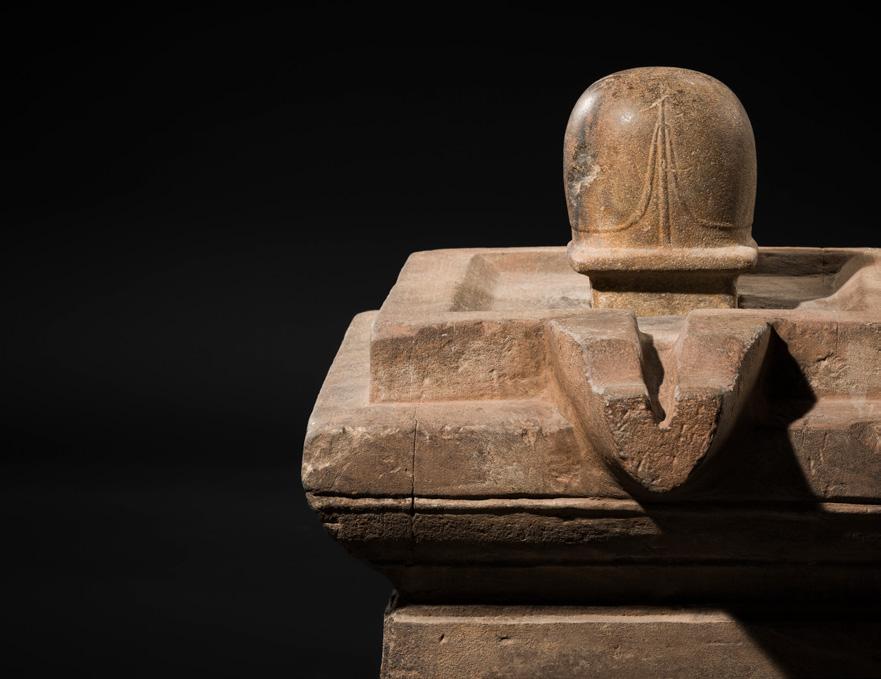
Skillfully carved in two sections, the smoothly polished lingam rising from a square base to a finely incised rounded top, fitted and supported on a tiered yoni terminating in a tapered spout at one end to allow unguents to run off.
Provenance: The Kienzle Family Collection, Stuttgart, Germany. Acquired between 1950 and 1985 by siblings Else (1912-2006), Reinhold (1917-2008), and Dr. Horst Kienzle (1924-2019), during their extensive travels in Asia. Subsequently inherited by Dr. Horst Kienzle and bequeathed to the Museum für Asiatische Kunst, Radevormwald, Germany. Released through museum deaccession in 2024.
Condition: Very good condition, commensurate with age. Old wear, obvious losses, expected signs of weathering and erosion, encrustations, structural fissures, chips, nicks, scratches.
Dimensions: Length 57 cm, Height 53.5 cm
The lingam and yoni are aniconic representations of Shiva and Uma. They are symbolic of the female and male reproductive organs, which within Hinduism bring a balance to the cosmos when joined together. Within Hindu countries, adoration of the lingam was understood to be worship of the great generative principle of the universe, conceptualized as an aspect of Shiva. Some of the Khmer kings identified themselves with Shiva, placing a lingam at the summit of their most important temples as part of their royal paraphernalia.
The two parts of the sculpture, the square yoni and the round lingam, form an inseparable unit. A typical feature of a yoni is also clearly visible on the present lot: the Somasutra, or water outlet. The lingams were cleansed daily and doused with sacred liquids during rituals. The water (including milk or oils) flowed over the Somasutra into a drainage channel outside and seeped into the earth. To prevent uncontrolled overflow, all yoni plates are provided with a surrounding rim. The slightly raised rim and the outlet, along with the opening for the lingam, characterize the typical structure of a yoni.
LITERATURE COMPARISON
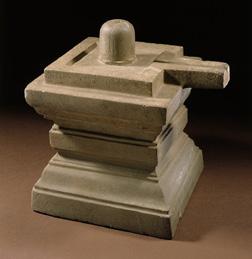

Compare a closely related lingam and yoni dated to the Angkor period, circa 975, 37.5 cm high, in the Metropolitan Museum of Art, object number 1988.393. Compare also a closely related earlier yoni dated late 6th to 9th century with later lingam, preserved in the Sambor Prei Kuk.
Estimate EUR 10,000
Starting price EUR 5,000

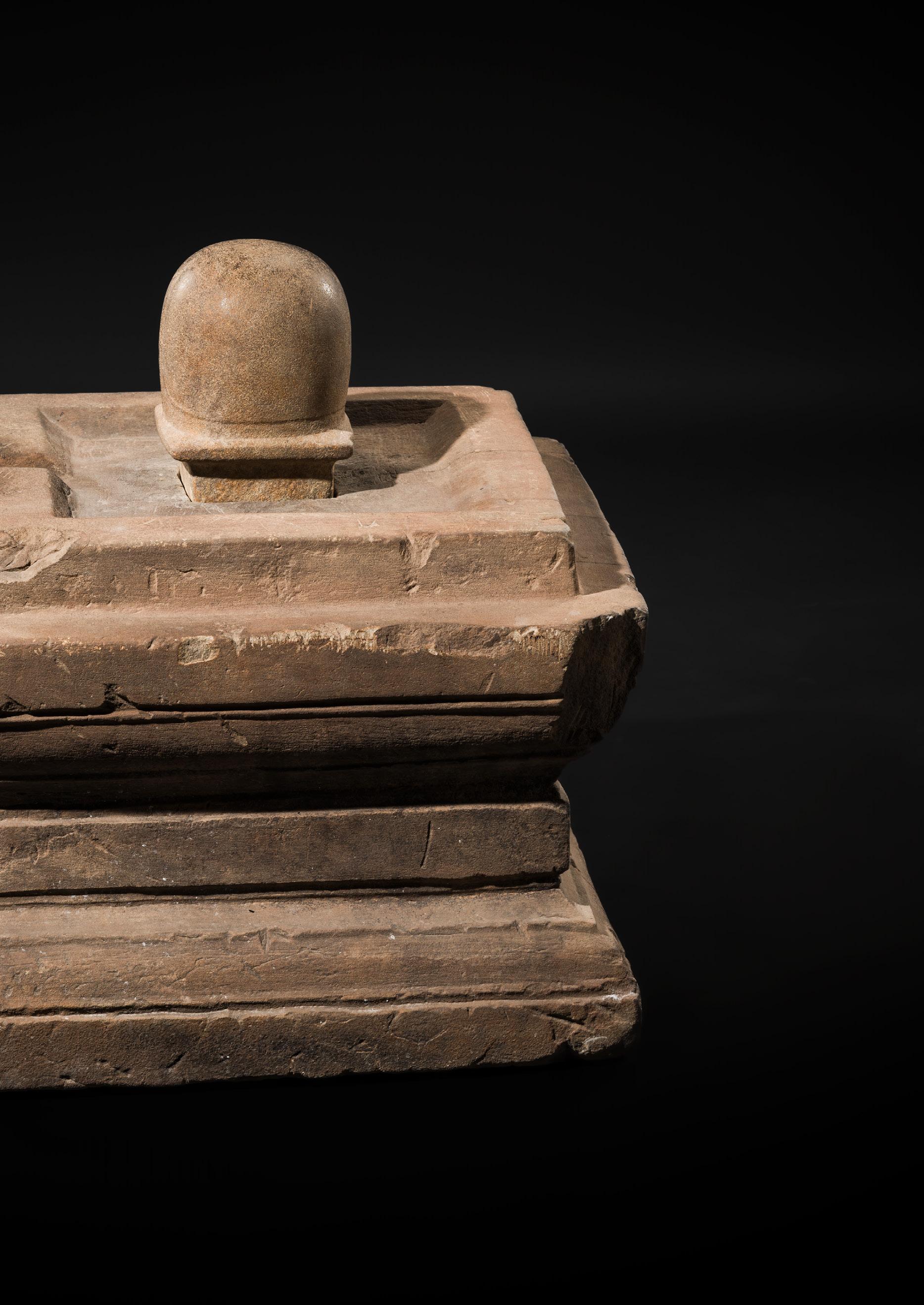
5 A MONUMENTAL (93 CM HIGH) POLISHED SANDSTONE LINGAM, ANGKOR PERIOD, 10TH-13TH CENTURY
Expert’s note: Original Khmer sandstone lingams have become exceedingly rare, particularly those like the present lot, with a top beautifully polished by centuries of rainfall and worship. Also note the magnificent size of this piece.
Khmer Empire. The surface smoothly polished with square base and octagonal mid-section rising to the finely incised cylindrical top. The sandstone with a fine, smooth, naturally grown patina.
Provenance: The Kienzle Family Collection, Stuttgart, Germany. Acquired between 1950 and 1985 by siblings Else (1912-2006), Reinhold (1917-2008), and Dr. Horst Kienzle (1924-2019), during their extensive travels in Asia. Subsequently inherited by Dr. Horst Kienzle and bequeathed to the Museum für Asiatische Kunst, Radevormwald, Germany. Released through museum deaccession in 2024.
Condition: Excellent condition, commensurate with age. Extensive old wear, signs of weathering and erosion, chips, nicks, and scratches.
Dimensions: Height 93 cm
AUCTION RESULT COMPARISON
Type: Closely related
Auction: Christie’s New York, 26 September 2017, lot 216
Price: USD 40,000 or approx. EUR 50,000 converted and adjusted for inflation at the time of writing
Description: A sandstone lingam, Khmer, Angkor period, 13th century
Expert remark: Compare the closely related modeling, manner of carving, and stone. Note the much smaller size (45.8 cm).
Estimate EUR 10,000
Starting price EUR 5,000


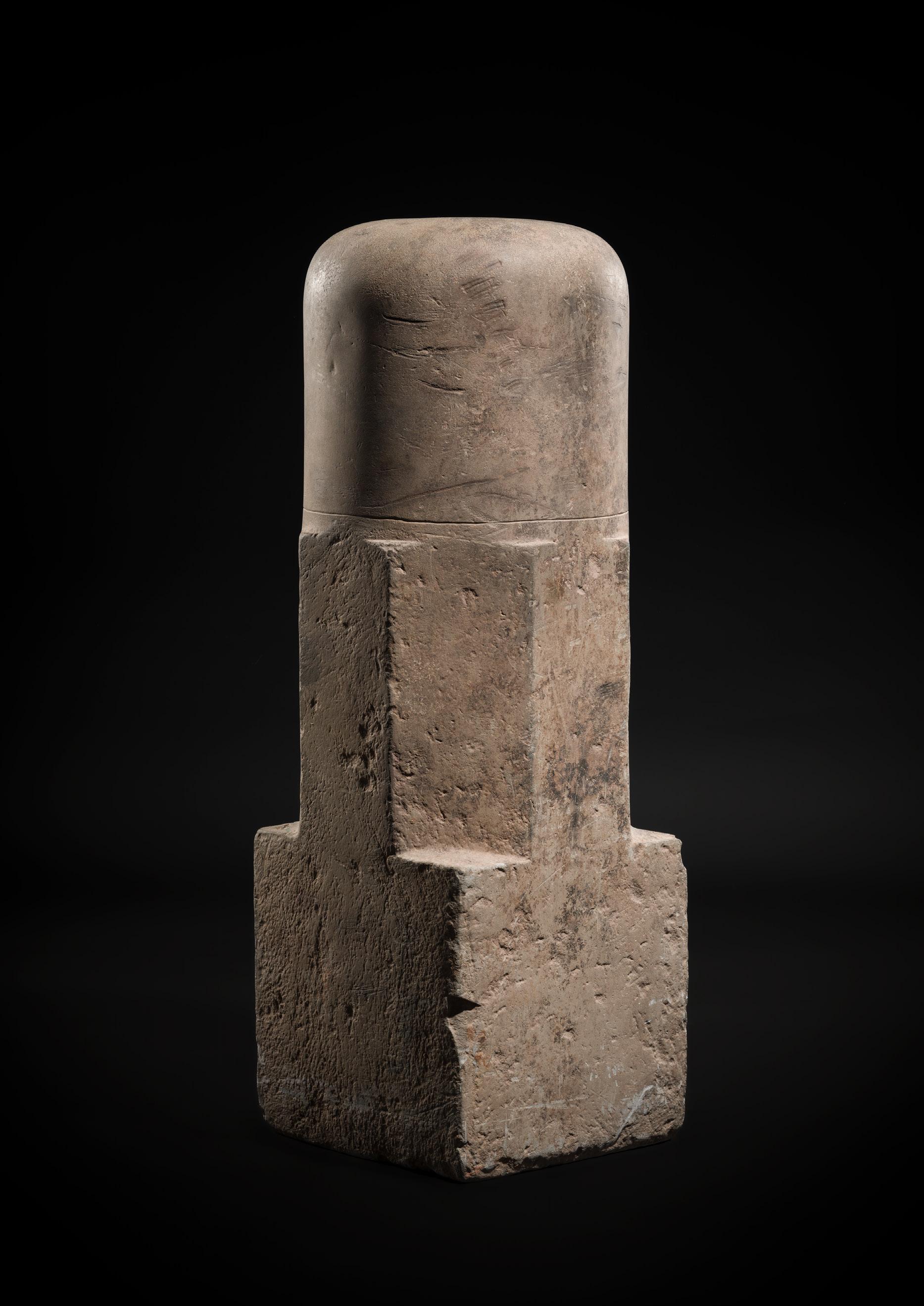
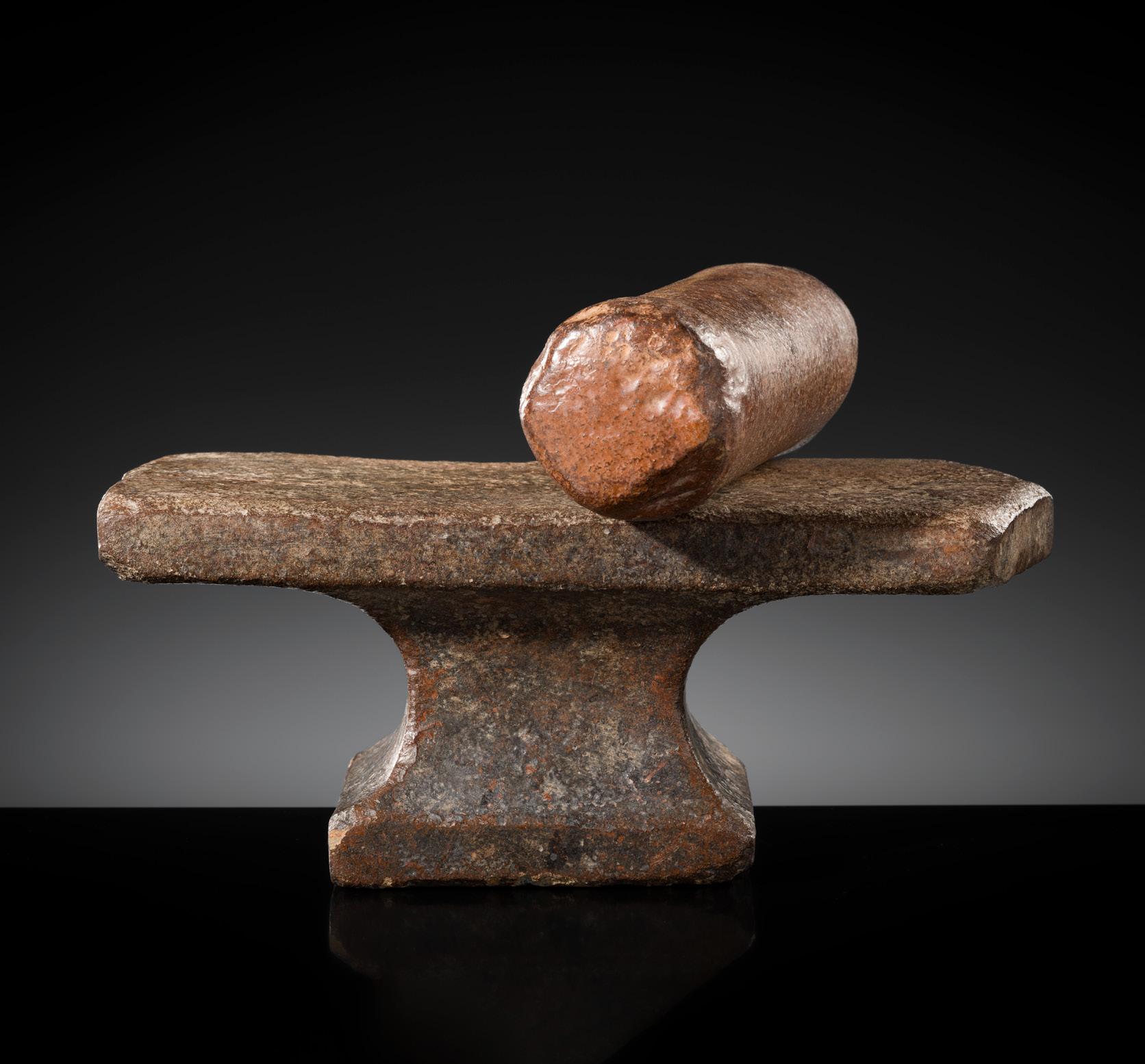
A SANDSTONE PESANI (GRINDING STONE) AND GRINDER, ANGKOR PERIOD
Khmer Empire, 9th-15th century. Each carved from a coarse-grained stone with an abrasive texture, the grinding stone with a flat rectangular top with one pointed end supported on a broad spreading foot, the grinder of cylindrical form. (2)
Provenance: Galerie Hardt (established in 1976), Radevormwald, Germany, before 2020. Acquired by the gallery’s founder Peter Hardt (b. 1946) during his extensive travels in Asia, the first of which occurred during a formative world tour in 1973.
Labels: Galerie Hardt, inscribed ‘Mörser Stone Cambodia, post‘, priced at EUR 4,500
Condition: Very good condition, commensurate with age. Wear, traces of use, signs of weathering, encrustations, chips, minor losses, nicks. Fine, naturally grown patina.
Weight: 16.5 kg (total)
Dimensions: Length 39 cm (the pesani) and 28.6 cm (the grinder)
The pesani, or grinding stone, is an infrequently discussed object of the ancient Khmer Empire but regardless it is prominent throughout, from the 6th-century pre-Angkorian times through the Angkor period. They were likely used for grinding spices to make Ayurvedic medicine, pastes
for ceremonial purposes, and even curry has been proposed. Most are utilitarian and feature no or little decoration. Early French documentation designated grinding stones like these as rasun batau, using the terminology of the Cham, the ancient neighboring state to the east where these artefacts were previously found.
LITERATURE COMPARISON
Compare a closely related sandstone pesani with similarly shaped foot, 34.8 cm long, also dated to the Angkor period, in the National Museum of Cambodia, inventory number Ka.2391.
Estimate EUR 1,000
Starting price EUR 500

Khmer Empire, 9th-15th century. The grinding stone with a flat top and tapered sides supported on a broad rectangular foot, incised with hatched decoration, the grinder of cylindrical form, each carved from a coarse-grained stone with slightly abrasive surface. (2)
Provenance: Galerie Hardt (established in 1976), Radevormwald, Germany, before 2020. Acquired by the gallery’s founder Peter Hardt (b. 1946) during his extensive travels in Asia, the first of which occurred during a formative world tour in 1973.
Labels: Galerie Hardt, inscribed ‘Mörser Kambodia‘, priced at EUR 4,500
Condition: Good condition, commensurate with age. Wear, traces of use, signs of weathering, encrustations, chips, losses, nicks, structural cracks. The grindstone and grinder are both worn down, the latter with an old repair. Fine, naturally grown patina.
Weight: 11.6 kg (total)
Dimensions: Length 40 cm (the pesani) and 24 cm (the grinder)
LITERATURE COMPARISON
Compare a closely related sandstone pesani with similar incision work and of identical size in the National Museum of Cambodia, inventory number Ka.490. Compare a closely related sandstone pesani and grinder, 40.8 cm long, also dated to the Angkor period, in the National Museum of Cambodia, inventory number NMC.1.1-2.
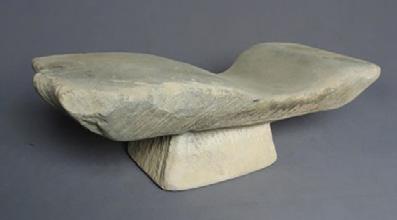
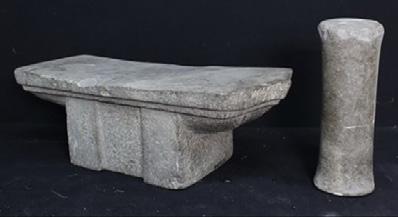
Estimate EUR 1,000
Starting price EUR 500

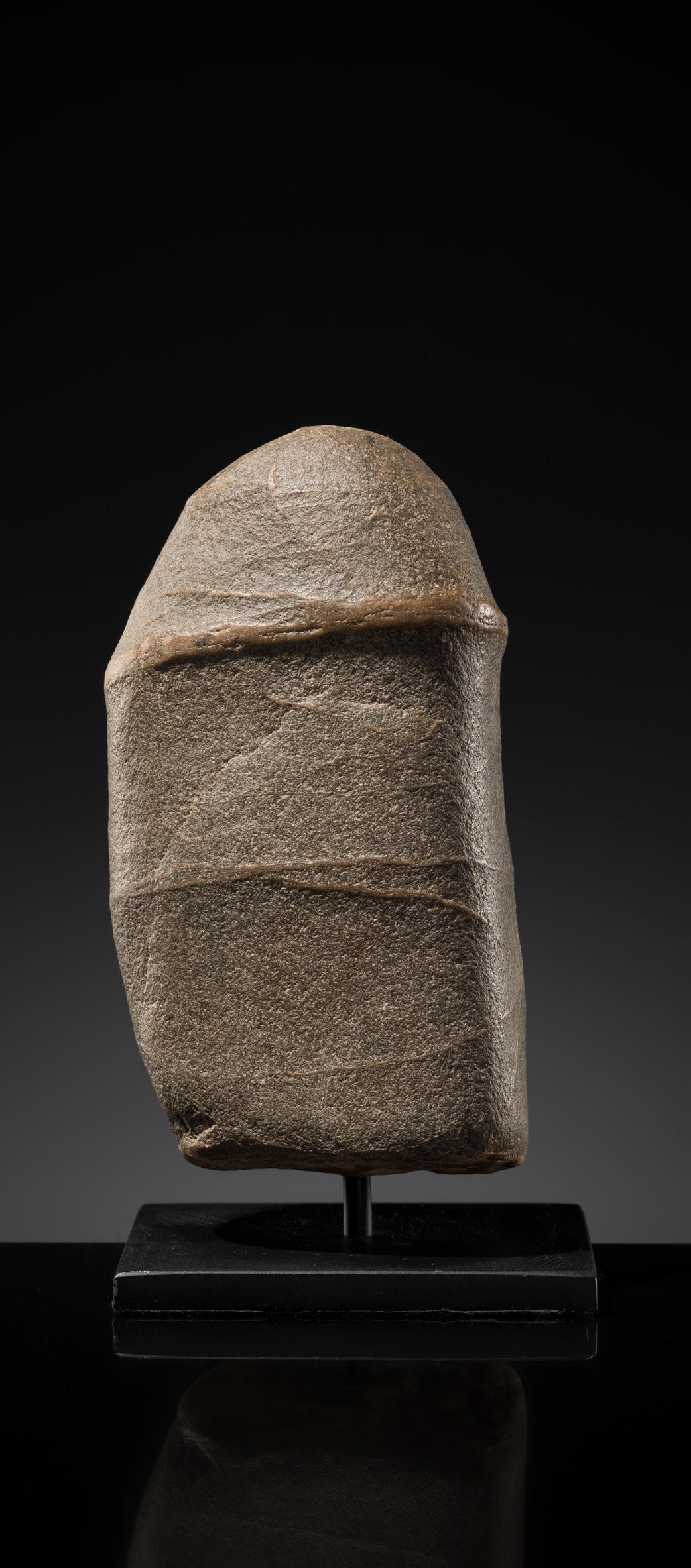
Skillfully carved utilizing the profiled veins of the stone to evoke those of the phallus. The smoothly polished, grainy surface is of a grayish-brown tone.
Provenance: Galerie Hardt (established in 1976), Radevormwald, Germany, before 2020. Acquired by the gallery’s founder Peter Hardt (b. 1946) during his extensive travels in Asia, the first of which occurred during a formative world tour in 1973.
Labels: Galerie Hardt, inscribed ‘Lingam Stein Burma 8.-10. Jahrhundert’, the back ‘1691-04, H:18
B: 9 T: 9’, and priced at EUR 2,750
Condition: Good condition with old wear, natural fissures, minor signs of weathering, few small losses, a minor chip to the lower edge.
Weight: 2.4 kg (incl. stand)
Dimensions: Height 18.4 cm (incl. stand)
Mounted on an associated metal stand. (2)
Shiva is represented most commonly in his aniconic form —as a linga, a shaft of stone that, to varying degrees, assumes the features of a phallus. In the beginning, Shiva was evoked through the worship of naturally occurring objects or landforms acknowledged as a linga.
LITERATURE COMPARISON
Compare a related larger sandstone Shiva linga, Southern Vietnam, dated 5th-6th century, 166 cm high, in the Metropolitan Museum of Art, on loan from the National Museum of Vietnamese History Collections, accession number BTLS 5957.
Estimate EUR 1,000
Starting price EUR 500
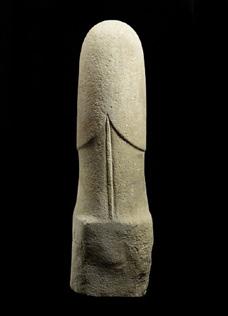
9 A PHALLIC STONE LINGAM, HIMALAYAN REGIONS, 19TH CENTURY OR EARLIER
The limestone is naturalistically and subtly carved, cleverly using the pale gray veins of the stone to evoke those of the phallus, while the dark surface is smoothly polished.
Provenance: Galerie Hardt (established in 1976), Radevormwald, Germany, before 2020. Acquired by the gallery’s founder Peter Hardt (b. 1946) during his extensive travels in Asia, the first of which occurred during a formative world tour in 1973.
Labels: Galerie Hardt, inscribed ‘Lingam Stein Tibet’, the back ‘1690-04, H:17 B: 6 T: 7’, and priced at EUR 1,750
Condition: Very good condition with expected wear, minor signs of weathering, natural fissures, minute surface nicks.
Weight: 1,095 g (incl. stand)
Dimensions: Height 17 cm (incl. stand) and 15 cm (excl. stand)
Mounted on an associated metal stand. (2)
The lingam, deemed the purest embodiment of Shiva, serves as the primary emblem of worship for this Hindu deity and its aniconic form represents a phallus or a pillar of light. Self-manifested or svayambhu lingas are spawned in the bed of the sacred Narmada River in Western India. Occurring through natural rock formations and erosions, ovoid boulders such as the present lot are considered remarkably propitious.
Estimate EUR 1,000 Starting price EUR 500
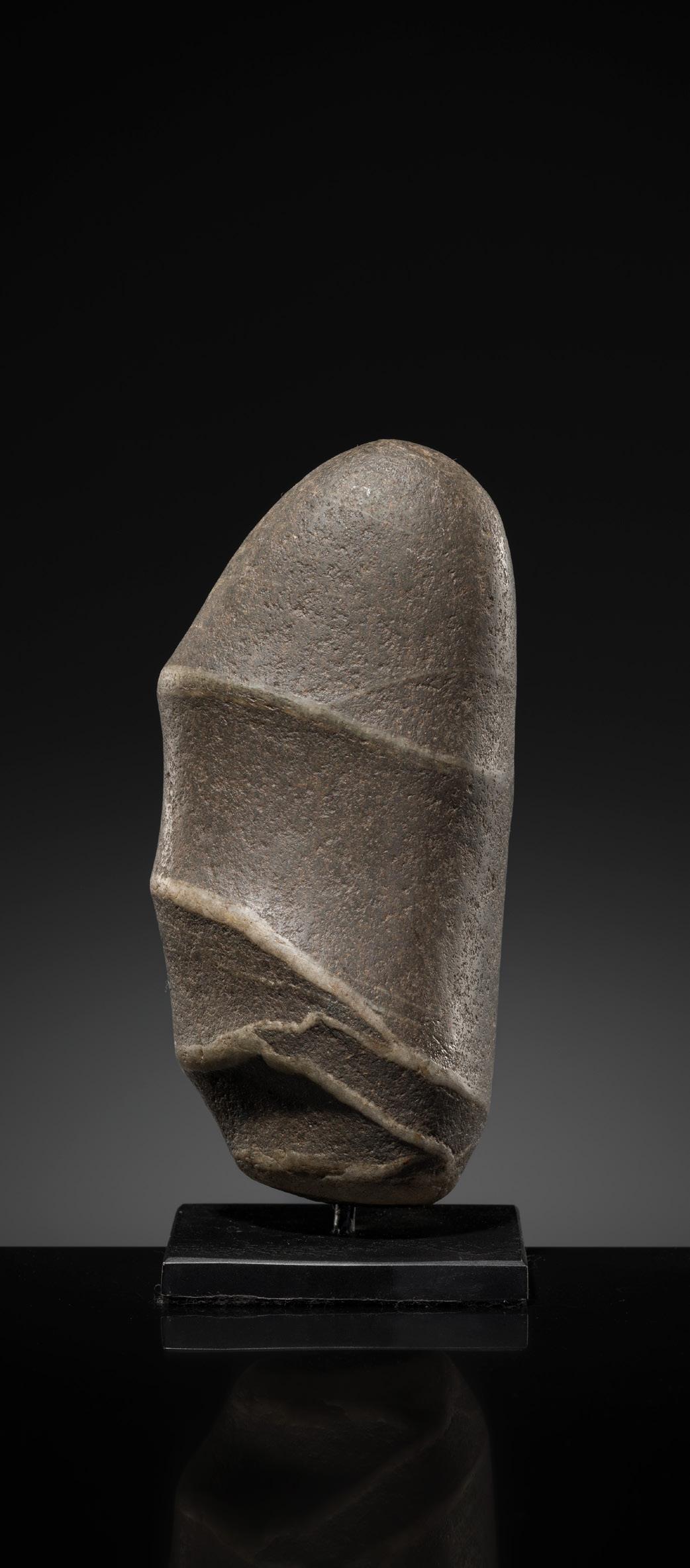
The Kienzle siblings Reinhold, Else, and Horst were avid travelers, beginning their journeys in the 1950s across West Asia with their mother Emilie (1882-1970). The family’s wealth originated from Kienzle Uhren, Germany’s oldest watchmakers. Horst and Else’s professions provided the financial means to travel extensively and amass a significant art collection over decades.
The passports of the Kienzle siblings and their Mother Emilie
The passport of Emilie Kienzle, showing visa stamps for trips to West Asia she undertook with her children Else, Reinhold, and Horst. The passport of Else Kienzle, showing visa stamps for trips to West Asia, Nepal, and Hong Kong, among others

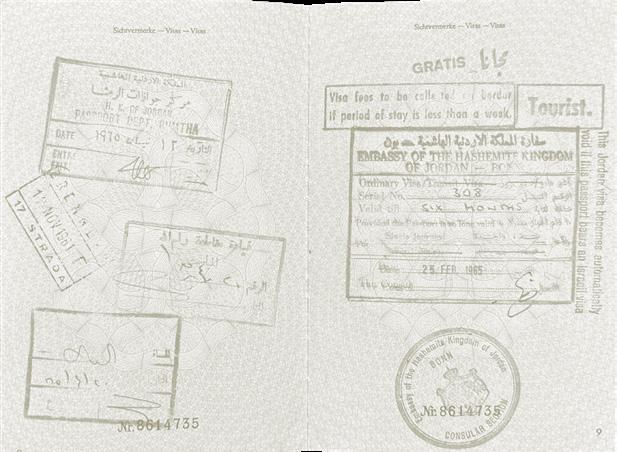
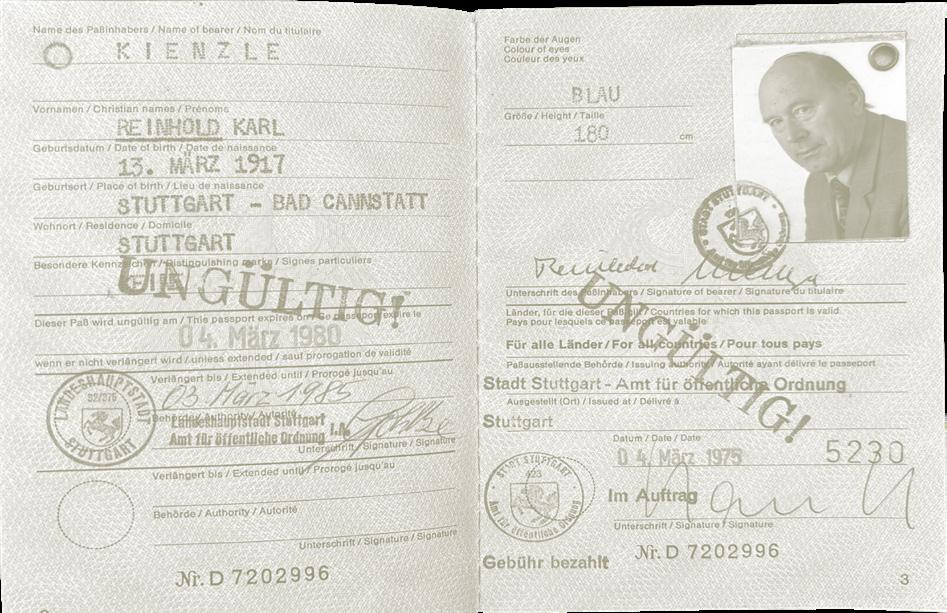
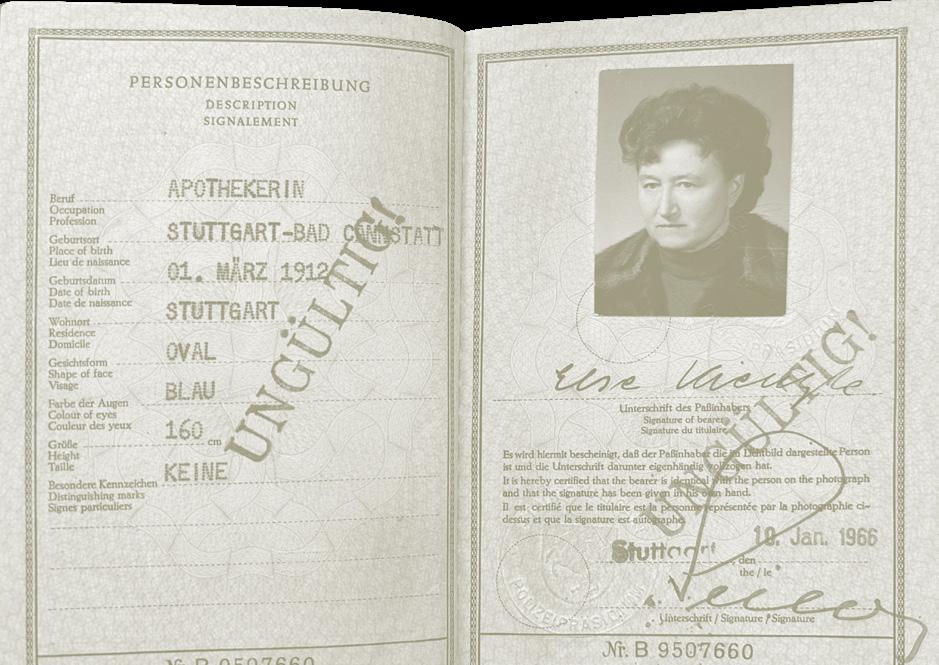
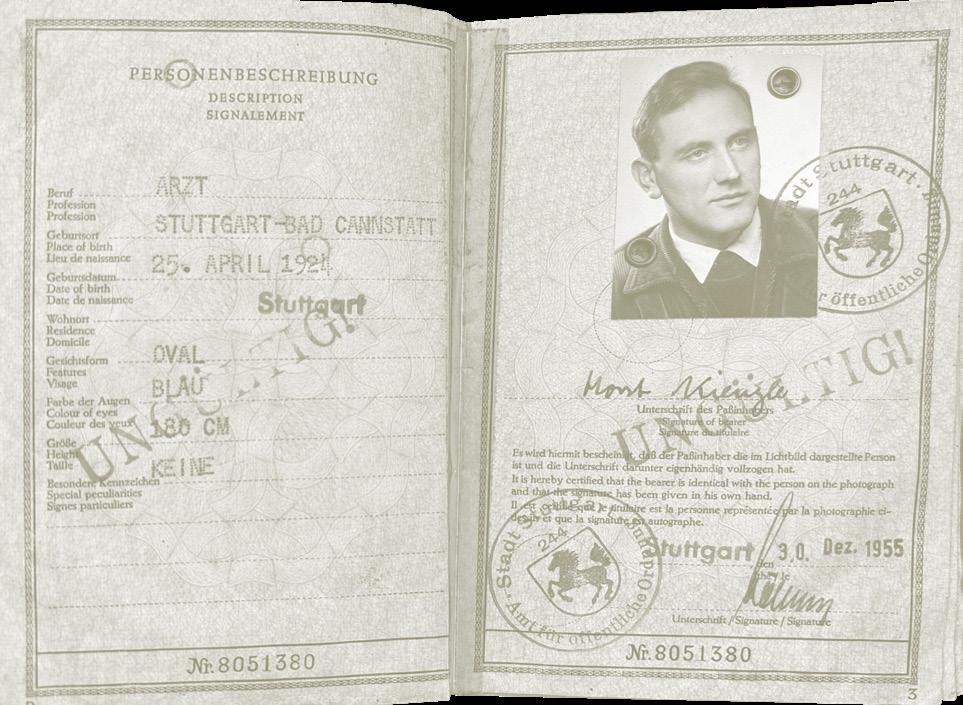

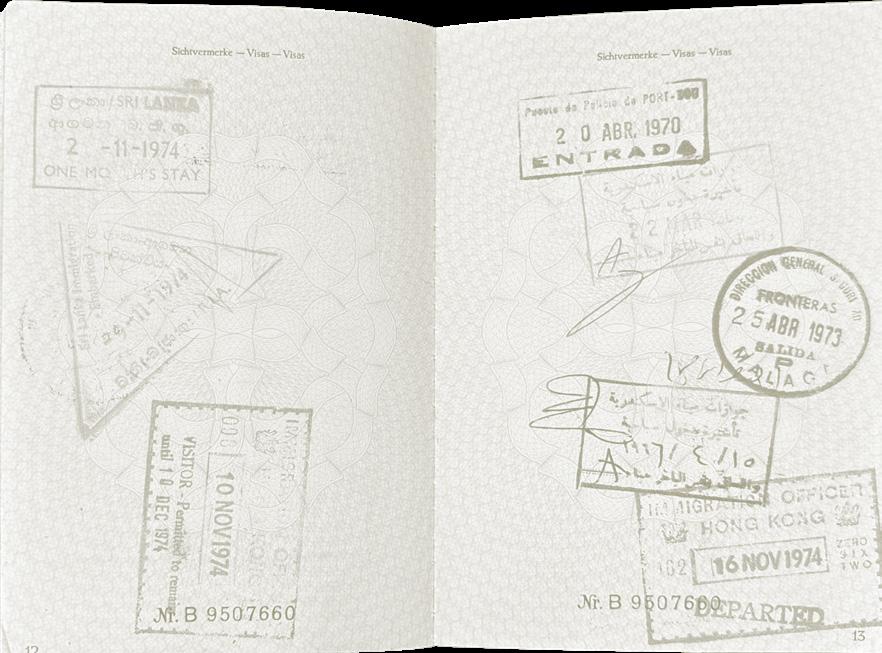



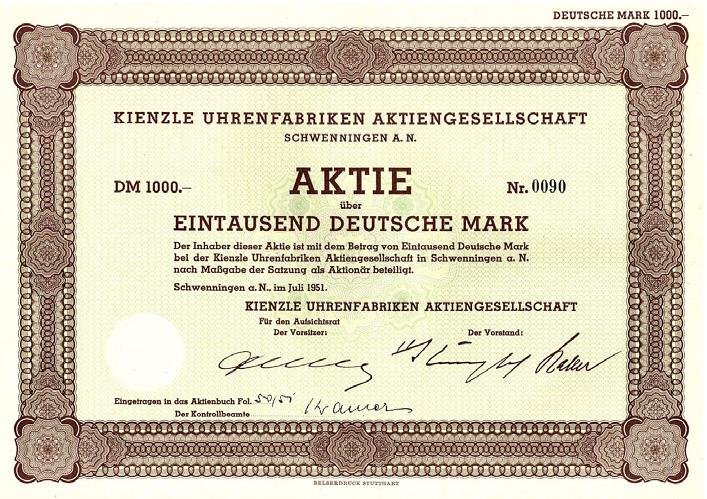
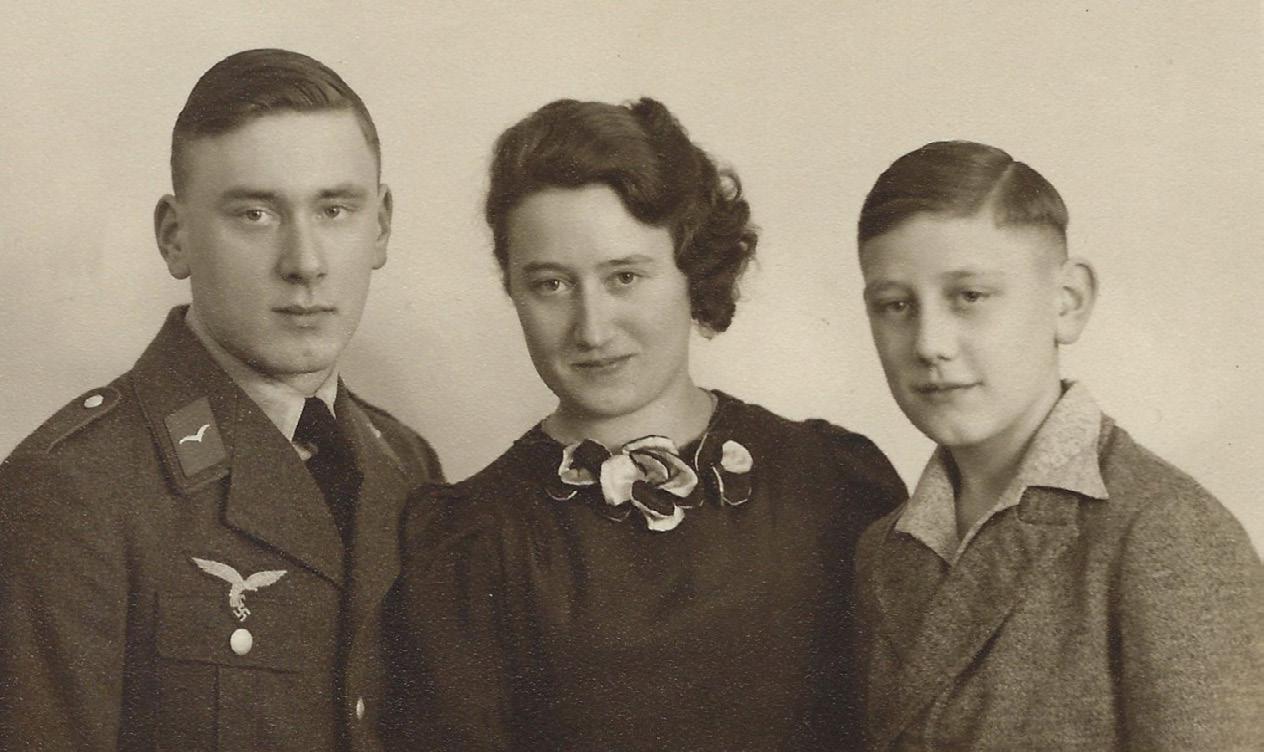
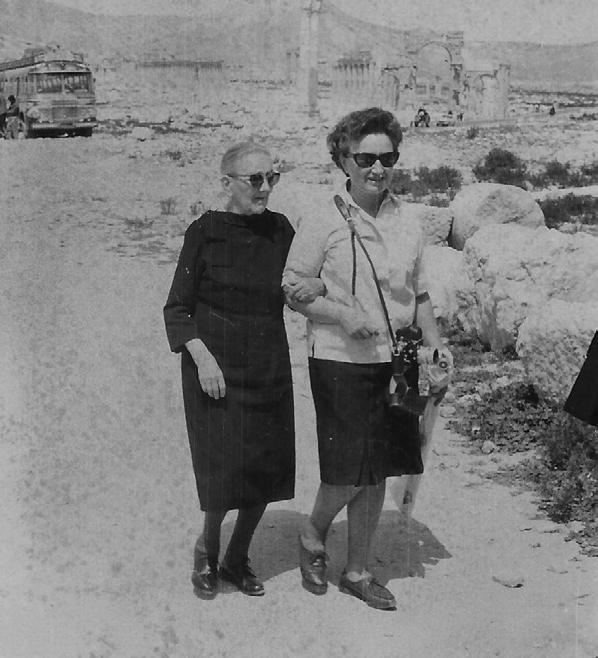

10
A VERY LARGE AND IMPORTANT BRONZE FIGURE OF BUDDHA, LAOS, 16TH-17TH CENTURY
Finely cast seated in dhyanasana on a tall tiered hexagonal base, his right hand lowered in bhumisparsha mudra and the left held in dhyana mudra above his lap, wearing a tight-fitting robe with beaded hems at the ankles and long fishtail pleat draped over the left shoulder, the serene face with heavy-lidded eyes, arched brows, and full lips forming a benevolent smile, flanked by elongated earlobes, the hair arranged in tight curls over the ushnisha topped by a flame finial.
Provenance: The Kienzle Family Collection, Stuttgart, Germany. Acquired between 1950 and 1985 by siblings Else (1912-2006), Reinhold (1917-2008), and Dr. Horst Kienzle (1924-2019), during their extensive travels in Asia. Subsequently inherited by Dr. Horst Kienzle and bequeathed to the Museum für Asiatische Kunst, Radevormwald, Germany. Released through museum deaccession in 2024.
Condition: Good condition with minor wear and casting irregularities. Few nicks, light surface scratches, remnants of pigments. Minor loss to the ketumala. The bronze with a fine, naturally grown, smooth patina.
Dimensions: Height 87.2 cm
The history and religion of Laos and northern Thailand share a various degree of assimilation and development. The founder of the Thai Lan Na Kingdom, King Mangrai, took Vientiane under his rule in the 13th century. Half a century later, the Thai exile, Fa Ngum, broke away and established the Lao kingdom Lan Xang Hom Khao. He is credited with bringing the Sinhalese Buddhism adopted in Northern Thailand to Laos. Similarly, Lao Buddhist sculpture borrowed heavily from northern Thai styles produced at centres of production like Chiang Mai. Within this context, it is not surprising that the present lot shows stylistic features common to both cultures.
Type: Closely related
Auction: Koller, Zurich, 7 Juni 2016, lot 469
Price: CHF 35,300 or approx. EUR 40,700 converted and adjusted for inflation at the time of writing
Description: A bronze figure of Buddha Shakyamuni seated on a high throne, Laos, c. 16th century
Expert remark: Compare the closely related modeling and manner of casting with similar expression, pose, robe, and base. Note the slightly larger size (93 cm) and inscription to base.
Estimate EUR 6,000
Starting price EUR 3,000
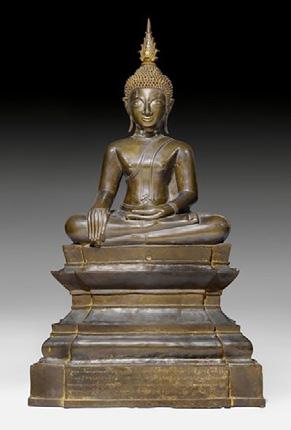


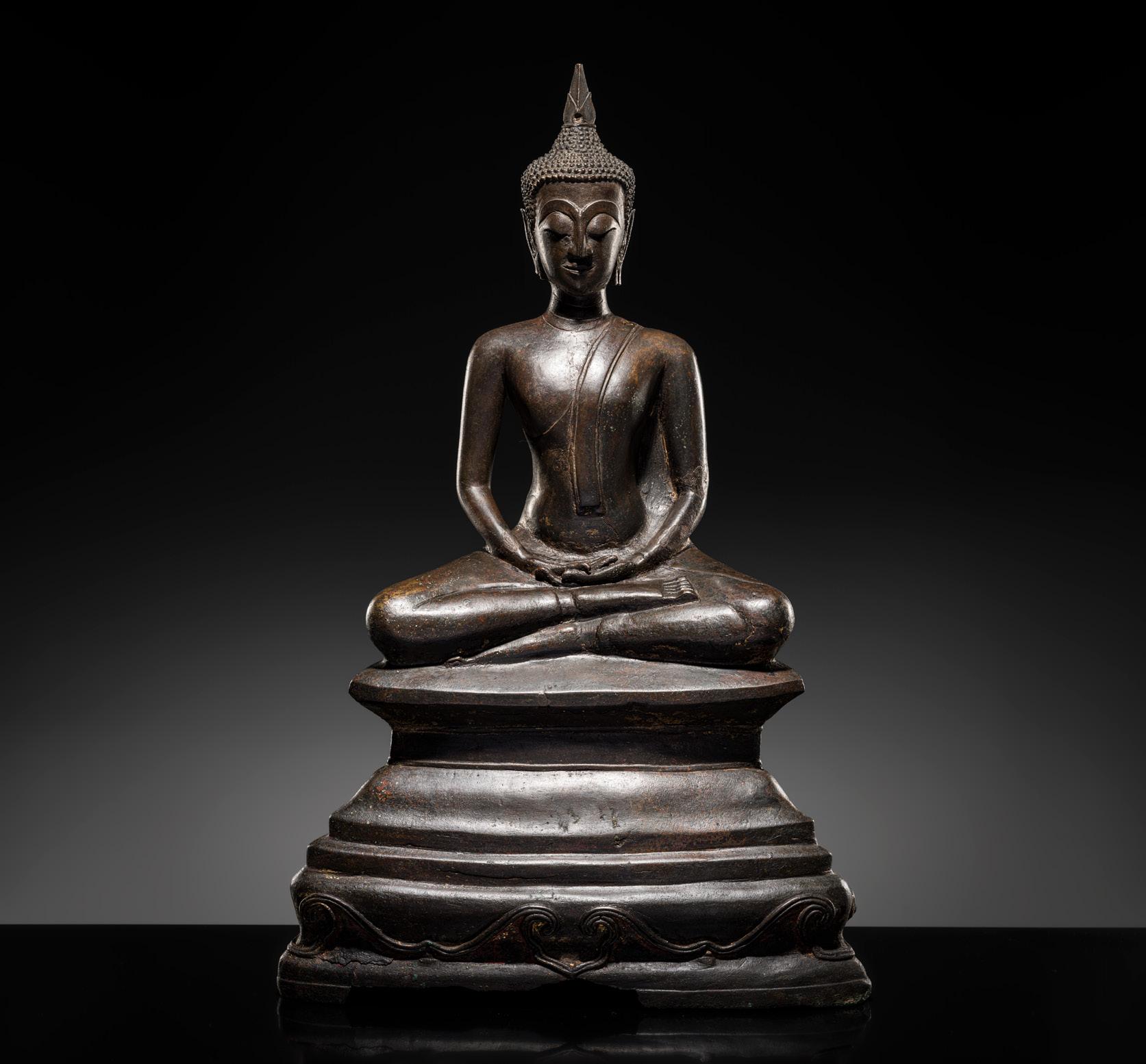
AUCTION RESULT COMPARISON
Type: Closely related
Auction: Christie’s Amsterdam, 31 October 2000, lot 112
A BRONZE FIGURE OF BUDDHA SHAKYAMUNI, LAOS, CHIEN SENG STYLE, 16TH-17TH CENTURY
Finely cast, seated in ardhapadmasana on a stepped base of triangular section decorated with scrolling motifs, with both hands elegantly lowered in dhyana mudra, and boldly dressed in a samghati. His serene face with a meditative expression marked by heavy-lidded downcast eyes set beneath prominent arched brows, and full lips curved into a gentle smile, flanked by elongated earlobes. The hair arranged in tight curls over the ushnishna and topped by the ketumala.
Provenance: The Kienzle Family Collection, Stuttgart, Germany. Acquired between 1950 and 1985 by siblings Else (1912-2006), Reinhold (1917-2008), and Dr. Horst Kienzle (1924-2019), during their extensive travels in Asia. Subsequently inherited by Dr. Horst Kienzle and bequeathed to the Museum für Asiatische Kunst, Radevormwald, Germany. Released through museum deaccession in 2024.
Condition: Overall good condition with old wear, casting irregularities, signs of weathering, minor losses, old repairs and fills, scattered light nicks and small surface scratches, remnants of gilt and pigment, the bronze with a fine, naturally grown, dark patina.
Weight: 9.2 kg
Dimensions: Height 56.5 cm
Price: NLG 19,893 or approx. EUR 14,000 converted and adjusted for inflation at the time of writing
Description: A Laos, Chien Seng style, bronze figure of Buddha Shakyamuni, late 16th century Expert remark: Compare the closely related modeling and manner of casting with similar features and expression. Note the size (34 cm high).
AUCTION RESULT COMPARISON
Type: Closely related
Auction: Sotheby’s Hong Kong, 17 December 2021, lot 3069
Price: HKD 403,200 or approx. EUR 48,500 converted and adjusted for inflation at the time of writing
Description: A large bronze seated figure of Buddha, Laos, 15th-16th century
Expert remark: Compare the closely related modeling and manner of casting with similar features and expression. Note the size (76 cm).
Estimate EUR 4,000
Starting price EUR 2,000
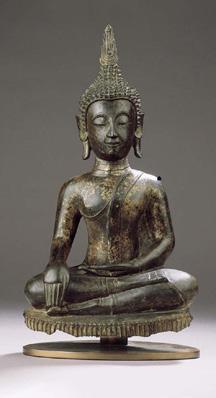


LARGE
Burma, 17th to 19th century or earlier. Standing in samabhanga on a waisted double lotus base, his right hand in abhayamudra, the left lowered and holding the hem of his diaphanous sanghati which covers both shoulders, falling elegantly to his ankles in rippled pleats. The face with accentuated eyebrows above sinuously lidded eyes, aquiline nose, and smiling lips, flanked by elongated earlobes. The hair in tight curls over the prominent ushnisha surmounted by a lotus bud. The back with a loop-form tang.
Provenance: Galerie Hardt (established in 1976), Radevormwald, Germany, before 2020. Acquired by the gallery’s founder Peter Hardt (b. 1946) during his extensive travels in Asia, the first of which occurred during a formative world tour in 1973.
Condition: Very good condition with minor wear and casting irregularities, signs of weathering, the bronze with a naturally grown patina with vibrant malachite encrustation.
Dimensions: Height 112 cm
While the statue exhibits the clear stylistic characteristics and presence typical of a Pagan period bronze, it notably lacks the deep, pervasive corrosion usually observed in pieces from the 12th or 13th century. Moreover, bronzes of this substantial size from that early period are exceedingly rare, owing to the scarcity of metal resources at the time. These factors suggest that the present example was likely cast at a later date, possibly between the 17th and 19th centuries, probably after a wooden model from the period. However, an earlier origin cannot be definitively ruled out. A Pagan bronze of this scale with its base still intact would be exceptionally rare. Burmese sculptural art during the Pagan Empire was heavily influenced by the Pala style—particularly bronzes from Kurkihar— reflecting the close cultural and religious exchanges between the great monasteries of these regions. For comparison, see the Sonnery Kurkihar Buddha sold at Bonhams Hong Kong, 3 October 2017, lot 16, which shares key features such as the circular lotus base, the long flaring robe, and the graceful, silhouetted outline. Similar characteristics, including the undulating folds of the robe, oval face, and sharply defined nose, are also evident in the monumental standing Buddhas of Shwezigon Pagoda, completed under the reign of King Kyansittha (1084–1112/13) of the Pagan dynasty.
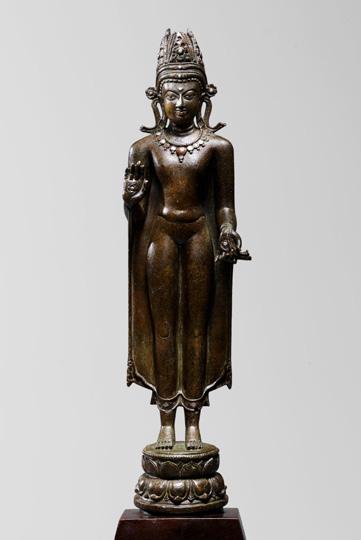
in Myanmar and in mainland Southeast Asia. The Burmese language and culture gradually became dominant in the upper Irrawaddy valley, eclipsing the Pyu, Mon, and Pali norms by the late 12th century. Theravada Buddhism slowly began to spread to the village level although Tantric, Mahayana, Brahmanic, and animist practices remained heavily entrenched at all social strata. Pagan’s rulers built over 10,000 Buddhist temples in the Bagan Archaeological Zone of which over 2,000 remain today. The wealthy donated tax-free land to religious authorities. The kingdom went into decline in the mid-13th century as the continuous growth of tax-free religious wealth by the 1280s had severely affected the crown’s ability to retain the loyalty of courtiers and military servicemen. This ushered in a vicious circle of internal disorders and external challenges by the Arakanese, Mons, Mongols, and Shans. Repeated Mongol invasions between 1277 and 1301 toppled the four-century-old kingdom.
AUCTION RESULT COMPARISON
Type: Closely related
Auction: Christie’s Amsterdam, 10 December 2002, lot 143
Price: EUR 13,145 or approx. EUR 22,000 adjusted for inflation at the time of writing
Description: A Burmese, Pagan style, bronze figure of Buddha Shakyamuni, 12th/13th century
Expert remark: Compare the closely related modeling and manner of casting with similar pose, flaring sanghati with undulating folds, high ushnisha with large bud finial, oval face, and rich green patina. Note the smaller size (47 cm). Like the present lot, this figure lacks the silver-inlaid eyes often seen on this type of sculpture.
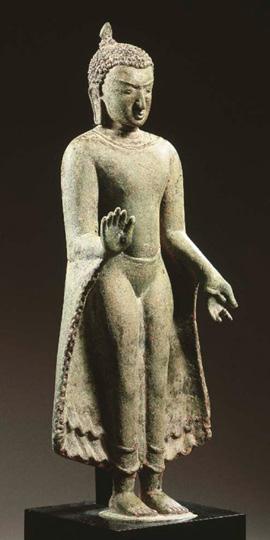
AUCTION RESULT COMPARISON
Type: Closely related
Auction: Christie’s New York, 17 September 1998, lot 170
Price: USD 134,500 or approx. EUR 228,000 converted and adjusted for inflation at the time of writing
Description: A large bronze figure of Buddha, Burma, Pagan period, 12th century
Expert remark: Compare the closely related modeling and manner of casting with similar pose, flaring sanghati with undulating folds, high ushnisha with large bud finial, oval face, and rich green patina. Note the silverinlaid eyes and smaller size (50.5 cm).
The Kingdom of Pagan was the first Burmese kingdom to unify the regions that would later constitute modern-day Myanmar. Pagan’s 250year rule over the Irrawaddy valley and its periphery laid the foundation for the ascent of Burmese language and culture, the spread of Bamar ethnicity in Upper Myanmar, and the growth of Theravada Buddhism
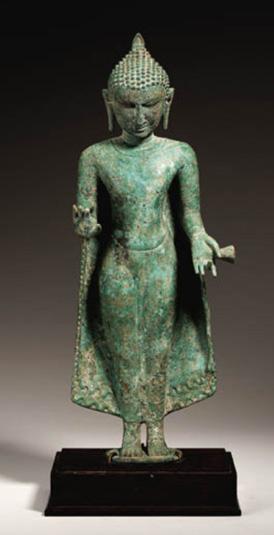
Estimate EUR 8,000
Starting price EUR 4,000
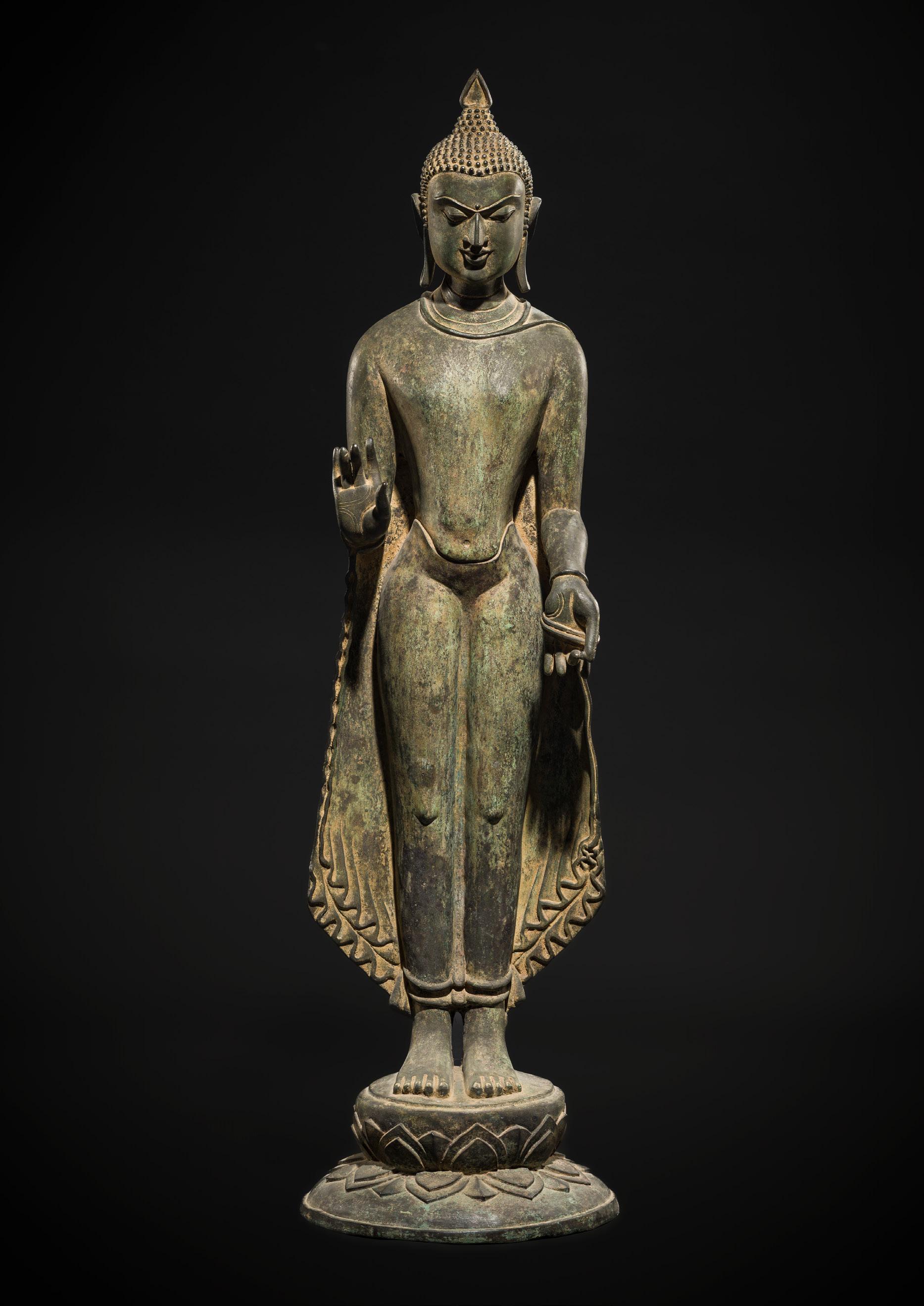
Burma. Finely cast, seated in dhyanasana atop a waisted pedestal with his right hand lowered in bhumisparsha mudra and the left held above the lap holding a round jewel, dressed in a sanghati draped over his left shoulder. The serene face with heavy-lidded downcast eyes below elegantly arched brows, his full bow-shaped lips forming a calm smile, flanked by elongated earlobes. The hair arranged in tight curls over the ushnisha topped by a large bud-shaped ketumala.
Provenance: Galerie Hardt (established in 1976), Radevormwald, Germany, before 2020. Acquired by the gallery’s founder Peter Hardt (b. 1946) during his extensive travels in Asia, the first of which occurred during a formative world tour in 1973.
Condition: Very good condition with minor wear and casting irregularities. Few minute nicks and light surface scratches, minor dents to base. The bronze with a fine, naturally grown, smooth patina with areas of malachite encrustation.
Dimensions: Height 78.5 cm
The founding of Shan States inside the present-day boundaries of Burma began during the Pagan Kingdom in the Shan Hills and accelerated after 1287 when the Kingdom fell to the Mongols. The Tai people, who came south with the Mongols, stayed, and quickly came to dominate much of the northeastern arc of Burma. The newly founded Shan States were multi-ethnic and included minorities such as the Chin, the Kachin, the Wa, the Ta’ang, the Lisu, the Lahu, the Pa O, and the Kayah. Although Burmanized Shans founded the Ava Kingdom that ruled central Burma, other Shan States, Mohnyin in particular, constantly raided Ava territories throughout the years. A Mohnyin-led Confederation of Shan States finally conquered Ava in 1527.
In 1555, King Bayinnaung dislodged Shan king Sithu Kyawhtin from Ava. By 1557 he went on to conquer all of what would become known as the Burmese Shan States under his rule, from the Assamese border in the northwest to those in Kachin and Shan Hills, including the two most powerful Shan States, Mohnyin and Mogaung. The Shan States were reduced to the status of governorships, but the Saophas (rulers) were permitted to retain their royal regalia and their feudal rights over their own subjects. Bayinnaung introduced Burmese customary law and prohibited all human and animal sacrifices. He also required the sons of Saophas to reside in the Burmese king’s palace, essentially hostages, in order to ensure the good conduct of their fathers and to receive training in Burmese court life.
Within this layered political arrangement, the distinct Shan style of Buddhist art emerged: a localized sculptural idiom shaped by Tai traditions, courtly patronage, and cross-regional influences, including Mon, Burmese, and Lanna aesthetics. Though not coterminous with the Shan States themselves, Shan style sculpture flourished within their territories, often serving as expressions of religious devotion, regional identity, and elite legitimacy under shifting regimes of power.
AUCTION RESULT COMPARISON
Type: Closely related
Auction: Christie’s Paris, 15 December 2010, lot 385
Price: EUR 10,000 or approx. EUR 12,000 adjusted for inflation at the time of writing
Description: a bronze figure of Buddha Shakyamuni, Burma, Ava period, 18th century
Expert remark: Compare the closely related modeling and manner of casting. Note the amaller size (63 cm).
AUCTION RESULT COMPARISON
Type: Closely related
Auction: Christie’s Amsterdam, 18 October 2005, lot 118
Price: EUR 11,950 or approx. EUR 18,500 adjusted for inflation at the time of writing
Description: A Burmese, Shan style, bronze figure of Buddha Sakyamuni, 17th century
Expert remark: Compare the closely related modeling and manner of casting. Note the size (92 cm) and different base.
Estimate EUR 6,000
Starting price EUR 3,000
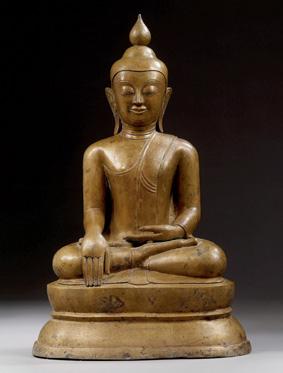
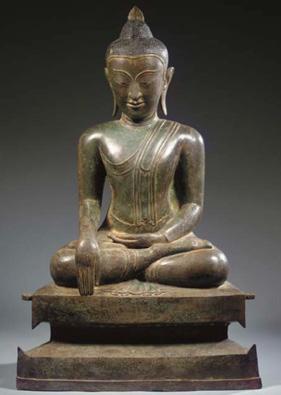
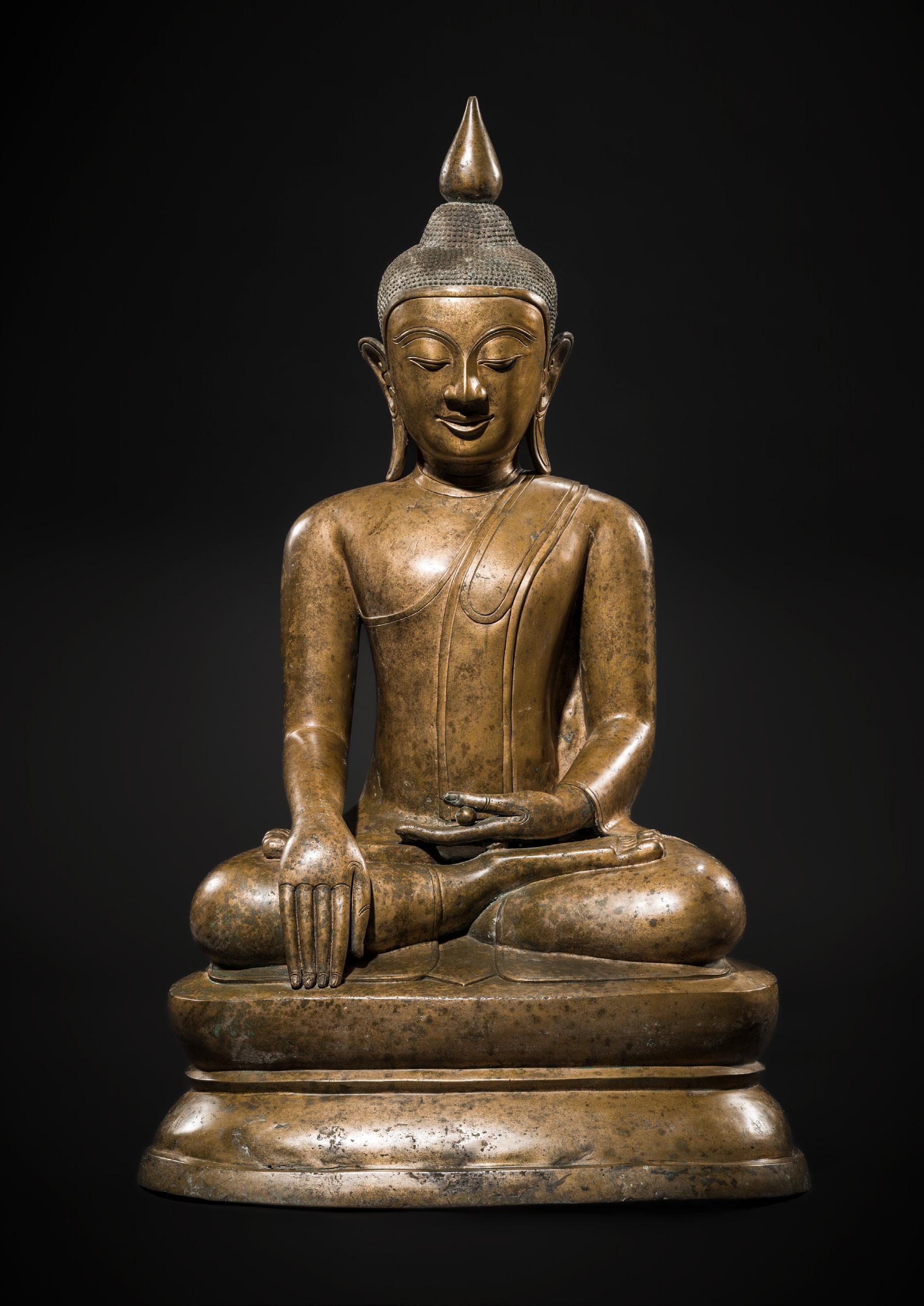

Expert’s Note: Although conservatively dated to the 18th century by Peter Hardt-Kienzle, this Buddha sculpture is, in our view, possibly of a much earlier origin. Several key features suggest a strong influence from the Pagan period in Myanmar (11th–13th centuries), including the almond-shaped eyes, the compact yet powerful body proportions, and the overall character and spiritual presence of the main figure and accompanying attendants. The structure and form of the lotus base, as well as the type and size of timber used, are both consistent with known examples from the Pagan period. Moreover, the surface wear and natural signs of aging clearly support an earlier dating.
Myanmar or Northwestern Thailand. Superbly carved standing in samabhanga on a lotus dais atop a richly detailed base with a central beast mask and two kneeling worshipers. His right hand is lowered in varada mudra and the left is raised toward his shoulder, holding the hem of his long robe cascading in subtly carved folds and culminating in a fishtail draped over the left shoulder, flanked by two bejeweled and crowned bodhisattvas. His serene face is sensitively modeled with downcast eyes and full bow-shaped lips forming an enigmatic smile, framed by the long pendulous lobes and domed ushnisha topped by a bud finial.
Provenance: Galerie Hardt (established in 1976), Radevormwald, Germany, before 2020. Acquired by the gallery’s founder Peter Hardt (b. 1946) during his extensive travels in Asia, the first of which occurred during a formative world tour in 1973.
Labels: Galerie Hardt, printed ‘stehender Buddha, Siam, 18 Jh, Holz gearbeitet‘, and priced at EUR 17,500
Condition: Overall good condition with old wear, natural imperfections, signs of weathering, expected age cracks, losses, minor old repairs and fills, remnants of old lacquer. The wood with a rich, naturally grown patina. Presenting exceptionally well.
Dimensions: Height 187.4 cm (excl. stand), 223.4 (incl. stand)
Mounted on an associated metal stand. (2)
LITERATURE COMPARISON
Compare a related earlier Pagan wood figure of crowned Buddha, dated 12th13th century, 197.5 cm high, in the Metropolitan Museum, object number 1992.382.
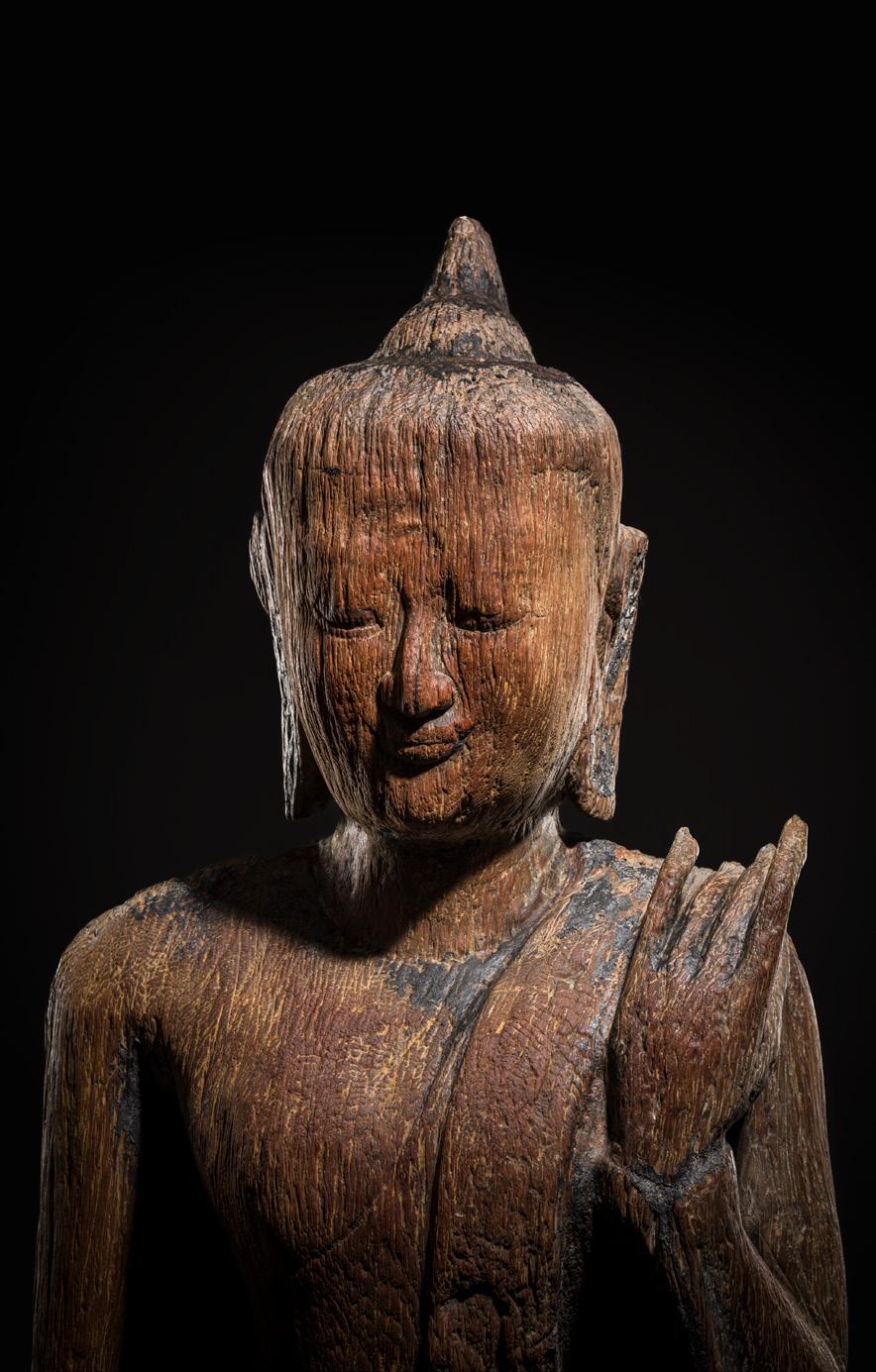
AUCTION RESULT COMPARISON
Type: Closely related
Auction: Bonhams New York, 22 March 2022, lot 321
Price: USD 37,812.50 or approx.
EUR 37,000 converted and adjusted for inflation at the time of writing
Description: A wood figure of Buddha, Myanmar, Pagan period, 12th/13th century
Expert remark: Compare the closely related modeling and manner of carving. Note the smaller size (164.5 cm) and earlier dating.
AUCTION RESULT COMPARISON
Type: Closely related
Auction: Bonhams New York, 18 March 2013, lot 133
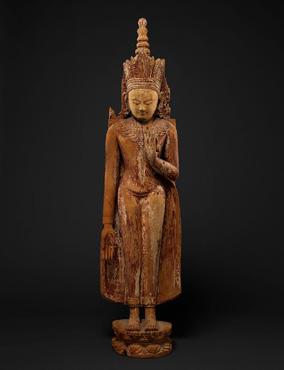
Price: USD 80,500 or approx.
EUR 97,000 converted and adjusted for inflation at the time of writing
Description: A standing crowned wooden Buddha, Burma, Pagan period, 13th/14th century
Expert remark: Compare the closely related modeling and manner of carving. Note the jewelry and the similar size (185.4 cm).
Estimate EUR 12,000
Starting price EUR 6,000
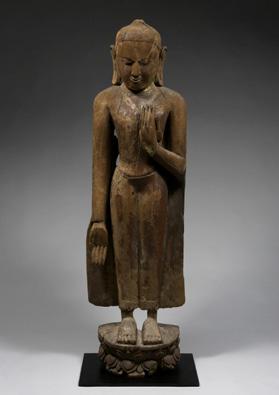

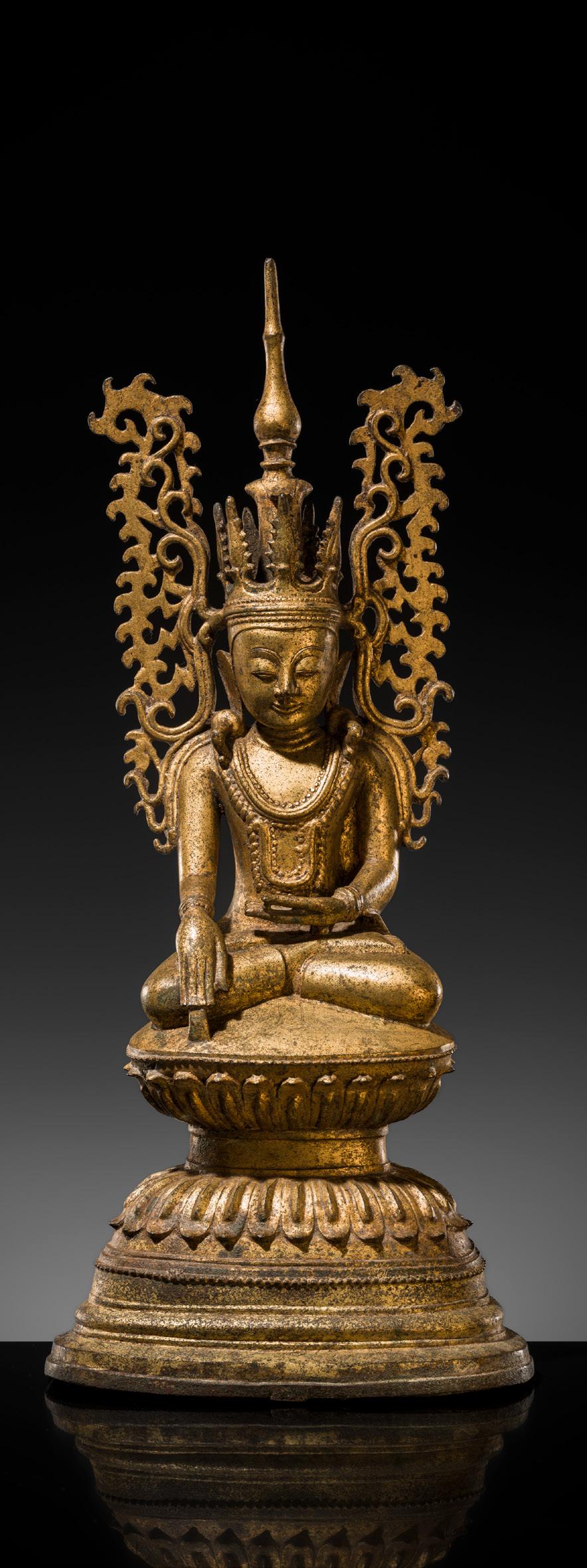
Burma, 18th century. Finely cast, seated in dhyanasana on a waisted double-lotus pedestal with beaded rims raised on a stepped base, his right hand lowered in bhumisparsha mudra while the left is held in dhyana mudra above the lap, wearing a tight-fitting robe and adorned with beaded jewelry, his face in a serene expression with heavy-lidded eyes, elegantly arched brows, and full lips forming a subtle smile, the hair pulled up into a high chignon topped by a tall lotus-bud finial behind the foliate crown with large and intricately cast and pierced ribbons of leafy scroll.
Provenance: The Kienzle Family Collection, Stuttgart, Germany. Acquired between 1950 and 1985 by siblings Else (1912-2006), Reinhold (1917-2008), and Dr. Horst Kienzle (1924-2019), during their extensive travels in Asia. Subsequently inherited by Dr. Horst Kienzle and bequeathed to the Museum für Asiatische Kunst, Radevormwald, Germany. Released through museum deaccession in 2024.
Condition: Very good condition with minor wear and casting irregularities. Light surface scratches and few small nicks. The gilding possibly renewed. The bronze with a fine, naturally grown patina with areas of malachite encrustation to the base.
Weight: 3,381 g
Dimensions: Height 44.8 cm
The founding of Shan States inside the present-day boundaries of Burma began during the Pagan Kingdom in the Shan Hills and accelerated after 1287 when the Kingdom fell to the Mongols. The Tai people, who came south with the Mongols, stayed, and quickly came to dominate much of the northeastern arc of Burma. The newly founded Shan States were multi-ethnic and included minorities such as the Chin, the Kachin, the Wa, the Ta’ang, the Lisu, the Lahu, the Pa O, and the Kayah. Although Burmanized Shans founded the Ava Kingdom that ruled central Burma, other Shan States, Mohnyin in particular, constantly raided Ava territories throughout the years. A Mohnyin-led Confederation of Shan States finally conquered Ava in 1527.
LITERATURE COMPARISON
Compare a closely related giltlacquered bronze figure, 36 cm high, dated 17th-18th century, in the British Museum, registration number 1894,0622.1 (fig. 1).
Compare a closely related bronze figure, 38 cm high, dated to the 17th century, in the Art Institute of Chicago, reference number 1984.1499.
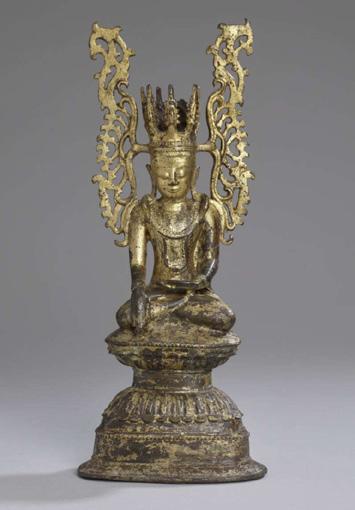
AUCTION RESULT COMPARISON
Type: Closely related
Auction: Bonhams San Francisco, 9 December 2008, lot 5215
Price: USD 2,280 or approx. EUR 3,000 converted and adjusted for inflation at the time of writing Description: A Burmese gilt bronze figure of the Buddha, Shan State, 18th Century Expert remark: Compare the closely related modeling, manner of casting, and gilding. Note the size (39 cm).
Estimate EUR 2,000
Starting price EUR 1,000
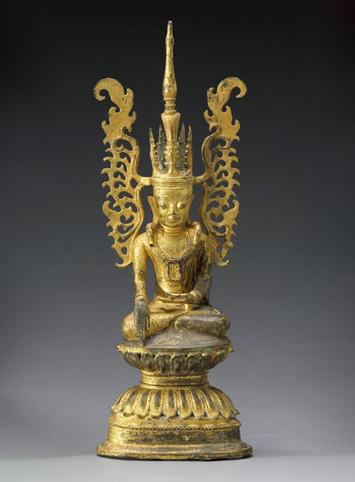
Burma, 18th-19th century. Finely cast, seated in dhyanasana on a waisted double-lotus pedestal with beaded rims raised on a stepped base, flanked by two diminutive figures of worshipers kneeling in prayer, his right hand lowered in varada mudra while the left is held in dhyana mudra above the lap, wearing a tight-fitting robe and adorned with beaded jewelry, his face in a serene expression with heavy-lidded eyes, elegantly arched brows, and full lips forming a subtle smile, the hair pulled up into a high chignon topped by a tall finial behind the foliate crown with large, intricately cast and pierced ribbons of leafy scroll.
Provenance: The Kienzle Family Collection, Stuttgart, Germany. Acquired between 1950 and 1985 by siblings Else (1912-2006), Reinhold (19172008), and Dr. Horst Kienzle (1924-2019), during their extensive travels in Asia. Subsequently inherited by Dr. Horst Kienzle and bequeathed to the Museum für Asiatische Kunst, Radevormwald, Germany. Released through museum deaccession in 2024.
Condition: Good condition with minor wear and casting irregularities. Light scratches, few nicks, minor dents, remnants of lacquer gilding, and small losses to the tips of the finial and crown ribbons. The bronze with a fine, naturally grown, smooth patina, and areas of malachite encrustation to the base and back.
Weight: 6,933 g
Dimensions: Height 45 cm
Jambupati Buddha figures such as this are dressed in the robes of a contemporary Burmese monarch. This relates to a legend, found both in Burma and Thailand, in which the unbelieving Indian king Jambupati was overawed by the Buddha. By appearing in magnificent royal robes, the Buddha demonstrated his great power and converted the king.
LITERATURE COMPARISON
Compare a closely related bronze figure of Jambupati Buddha dated to the 18th century, 53 cm high, in the British Museum, registration number 1969,0211.1.
Compare a related bronze, 40.6 cm high, dated 17th18th century, in the Victoria & Albert Museum, accession number IS.41-1994 (fig. 1).
AUCTION RESULT COMPARISON
Type: Closely related Auction: Bonhams New York, 12-19 March 2021, lot 389
Price: USD 4,462 or approx. EUR 4,700 converted and adjusted for inflation at the time of writing

1
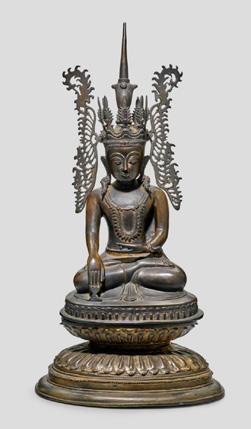
Description: A copper alloy figure of Jambhupati Buddha, Myanmar, 19th century Expert remark: Compare the closely related modeling and manner of casting with similar base. Note the size (68.5 cm) and later date.
Estimate EUR 2,000
Starting price EUR 1,000
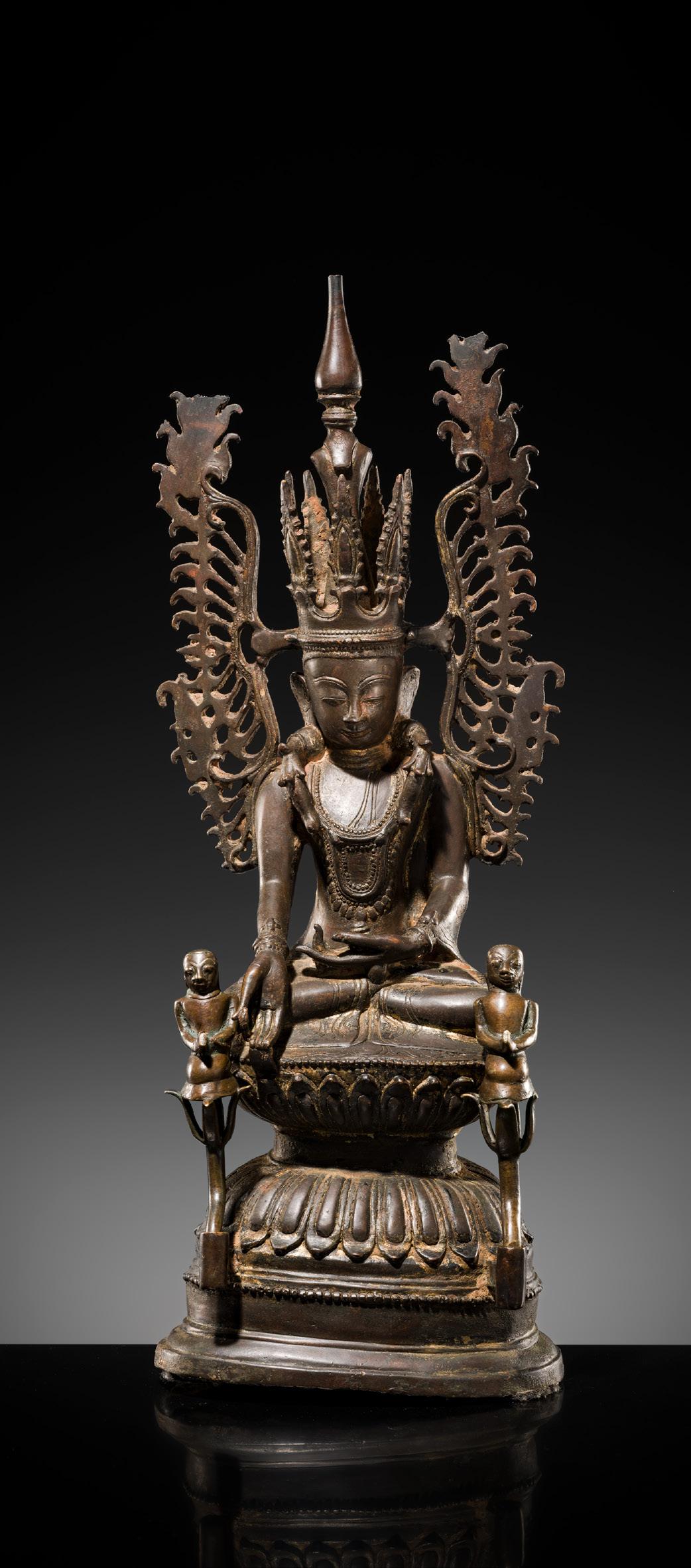
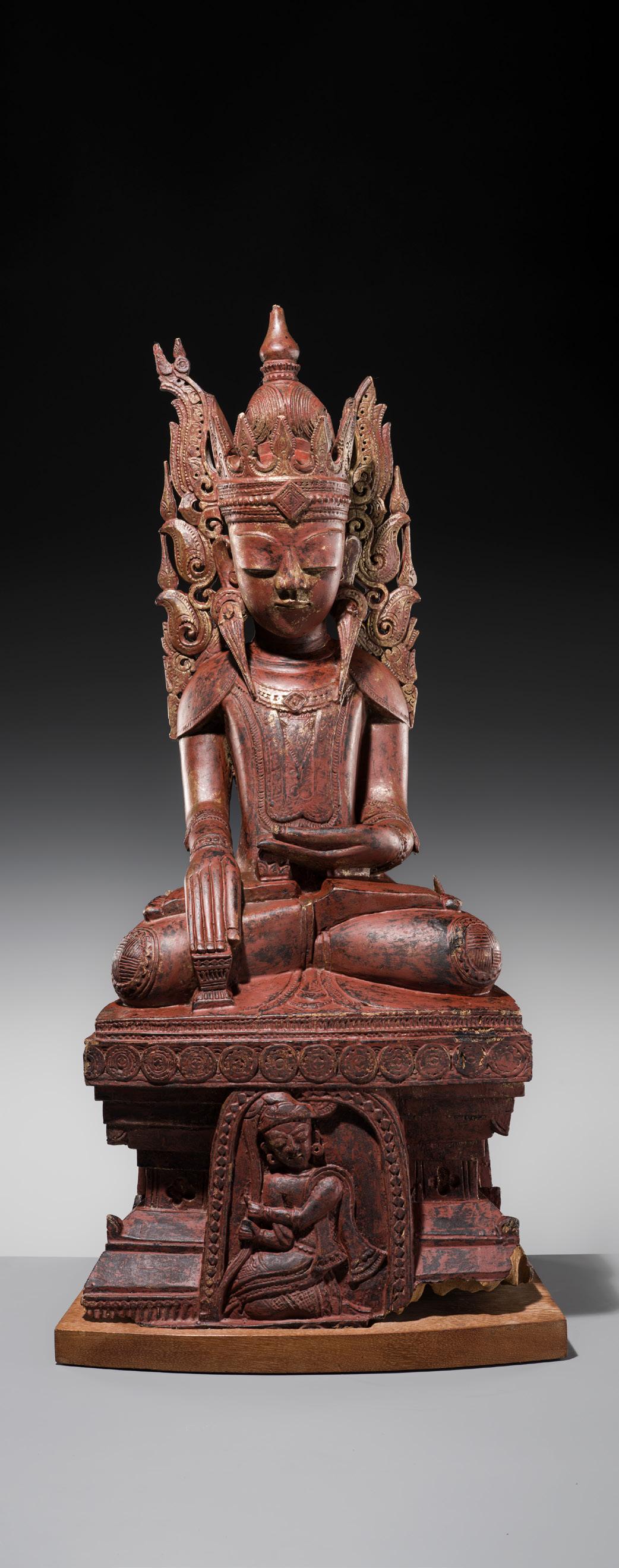
Burma, 18th-19th century. Finely lacquered with gilt and black over a rich red ground, the Buddha is depicted seated in dhyanasana atop a high, tiered throne. It is decorated with a band of floral roundels and a central niche containing a finely carved figure of a kneeling donor. The Buddha’s right hand is lowered in bhumisparsha mudra, while the left rests in his lap. He is wearing the intricate patterned robes, jewelry and ornate tiered crown of a monarch with an elaborate flame-like aureole rising behind him. The serene face with downcast eyes and small lips forming a subtle smile.
Provenance: The Kienzle Family Collection, Stuttgart, Germany. Acquired between 1950 and 1985 by siblings Else (1912-2006), Reinhold (19172008), and Dr. Horst Kienzle (1924-2019), during their extensive travels in Asia. Subsequently inherited by Dr. Horst Kienzle and bequeathed to the Museum für Asiatische Kunst, Radevormwald, Germany. Released through museum deaccession in 2024.
Condition: Overall good condition with expected wear and manufacturing irregularities. Losses to a band, finger, the finial, aureole and lower base. With a hole to the back, a few scratches and stress cracks, and flaking to the lacquer. A rich, smooth, naturally-grown patina.
Weight: 10.6 kg (excl. stand), 12.8 kg (incl. stand)
Dimensions: Height 86 cm (excl. stand), 90 cm (incl. stand)
With an associated wood stand. (2)
Jambupati Buddha figures such as this are dressed in the robes of a contemporary Burmese monarch. This relates to a legend, found both in Burma and Thailand, in which the unbelieving Indian king Jambupati was overawed by the Buddha. By appearing in magnificent royal robes, the Buddha demonstrated his great power and converted the king.
LITERATURE COMPARISON
Compare a closely related lacquer wood figure of Jambupati Buddha dated to the 18th century, 99.1 cm high, in the Kaba Aye Buddhist Art Museum, Yangon, museum number 71-1387.
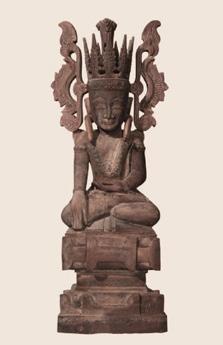
AUCTION RESULT
COMPARISON
Type: Closely related
Auction: Christie’s Amsterdam, 18 October 2005, lot 116
Price: EUR 5,975 or approx. EUR 9,400 adjusted for inflation at the time of writing
Description: A Burmese, Shan style, gilt, black and red lacquered wood figure of Buddha Sakyamuni Expert remark: Compare the closely related modeling, manner of carving, lacquering, and size (86 cm).
Estimate EUR 2,000
Starting price EUR 1,000
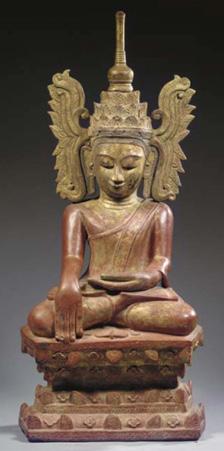

18 TWO LARGE GILT AND RED-LACQUERED PALM LEAF AND WOOD KAMMAVACA BOOKS, KONBAUNG DYNASTY
Burma, 19th century. Each comprising seven double-sided palm-leaf folios with Burmese tamarind seed script (Square Burmese Script) in Pali, the text written using lacquer ink, and two wood covers finely decorated with Devas within shaped reserves surrounded by rich foliate designs.
Provenance: The Kienzle Family Collection, Stuttgart, Germany. Acquired between 1950 and 1985 by siblings Else (1912-2006), Reinhold (1917-2008), and Dr. Horst Kienzle (1924-2019), during their extensive travels in Asia. Subsequently inherited by Dr. Horst Kienzle and bequeathed to the Museum für Asiatische Kunst, Radevormwald, Germany. Released through museum deaccession in 2024.
Condition: Good condition with expected wear, traces of use, and manufacturing irregularities, one cover with a loss and another with a small chip to one corner, few minuscule nicks, little rubbing, minor flaking to lacquer, little soiling and natural craquelure to folios.
Weight: 4 kg (total)
Dimensions: Length 59 cm (each book cover)
Each mounted on black cloth as a hanging scroll with a wood handle. (20)
Kammavaca manuscripts, as the present one, are usually highly ornamental, with thickly applied lacquer and gilded decorations on both covers and leaves, and Pali text written in ornate Burmese characters,
‘tamarind-seed’ script. They are often commissioned by lay patrons as gifts to monasteries.
LITERATURE COMPARISON
Compare a closely related Kammavaca manuscript dated to the 19th century, 58.4 cm long, in the Los Angeles County Museum of Art, accession number M.2017.121.1.
AUCTION RESULT COMPARISON
Type: Closely related
Auction: Christie’s London, 27 April 2012, lot 515
Price: GBP 2,500 or approx. EUR 5,000 (for one) converted and adjusted for inflation at the time of writing
Description: A large Buddhist manuscript (Kammavaca), Konbaung dynasty, Burma, 19th century


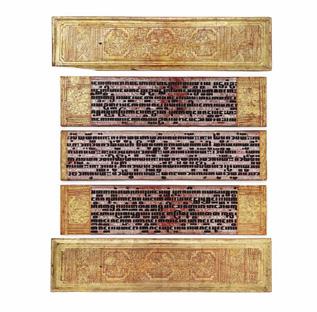
Expert remark: Compare the closely related material, seed script and covers, and size (62 cm). Note the different mounting.
Estimate EUR 2,000
Starting price EUR 1,000

19
A MAGNIFICENT LARGE GILT AND PAINTED WHITE MARBLE HEAD OF BUDDHA, MANDALAY, 18TH-19TH CENTURY
Burma. Finely carved, the serene face sensitively modeled with a meditative expression marked by downcast eyes with heavy sinuous lids and elegantly arched brows centered by a raised circular urna, his full bow-shaped lips forming a calm smile, flanked by long pendulous earlobes, the hair arranged in tight curls over the high domed ushnisha and secured by an intricately worked gilt-metal band with colorful glass inlays and foliate decoration.
Provenance: The Kienzle Family Collection, Stuttgart, Germany. Acquired between 1950 and 1985 by siblings Else (1912-2006), Reinhold (19172008), and Dr. Horst Kienzle (1924-2019), during their extensive travels in Asia. Subsequently inherited by Dr. Horst Kienzle and bequeathed to the Museum für Asiatische Kunst, Radevormwald, Germany. Released through museum deaccession in 2024.
Condition: Good condition with wear and obvious losses, few nicks, light surface scratches, expected minor losses to inlays, flaking and losses to gilt, remnants of pigment.
Weight: 23 kg (incl. stand)
Dimensions: Height 33.6 cm (excl. stand), 52.5 cm (incl. stand)
Mounted on an associated metal stand. (2)
AUCTION RESULT COMPARISON
Type: Closely related Auction: Christie’s Amsterdam, 21 November 2001, lot 145
Price:
EUR 4,112 or approx.
EUR 7,100 adjusted for inflation at the time of writing
Description: A Burmese, Mandalay, alabaster head of Buddha Shakyamuni, 18th-19th century
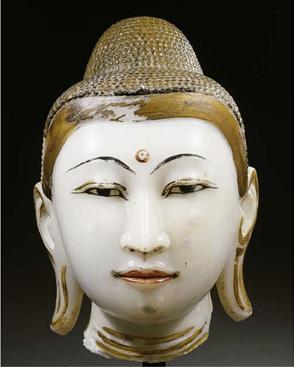
Expert remark: Compare the closely related modeling and manner of the carving, gilding, and painting, with similar features and expression. Note the similar size (37 cm).
Estimate EUR 3,000
Starting price EUR 1,500
20 A GILT-LACQUERED AND GLASS INLAID WHITE ALABASTER HEAD OF BUDDHA, MANDALAY, 18TH-19TH CENTURY
Burma. Finely carved, the serene face finely painted and sensitively modeled with a meditative expression marked by downcast eyes with neatly incised heavy lids and elegantly arched brows, his slender lips forming a calm smile, flanked by elongated earlobes, the gilt-lacquered hair worked in tight curls over the high domed ushnisha and secured by a broad headband richly inlaid with floral designs in pink and green glass framed by line bands in mirror glass and centered by a central gemstone cabochon.
Provenance: Galerie Hardt (established in 1976), Radevormwald, Germany, before 2020. Acquired by the gallery’s founder Peter Hardt (b. 1946) during his extensive travels in Asia, the first of which occurred during a formative world tour in 1973. Condition: Overall good condition with wear, obvious losses, few nicks, light surface scratches, expected minor losses to inlays, flaking and minor losses to gilt, remnants of pigment. Repairs to one ear.
Weight: 20 kg (incl. stand)
Dimensions: Height 33 cm (excl. stand), 53 cm (incl. stand)
With an associated metal stand. (2)
Expert’s note: The headband is decorated in the thayo technique, a process whereby thin rolled strands of lacquer and ash putty are applied in patterns. This work has then been gilded along with the rest of the hair. It was then inlaid with small roundels of glass backed with red and green foil in flower motifs. The dry lacquer was procured from China while the glass inlay was sourced from Thailand. The style and technique are typical of the art of the Mandalay period in Myanmar.
Literature comparison: Compare a related gilt lacquered and glass inlaid marble figure of Buddha, Burma, 18th century, 48 cm high, in the British Museum, registration number 1872,0701.9.
Estimate EUR 3,000
Starting price EUR 1,500

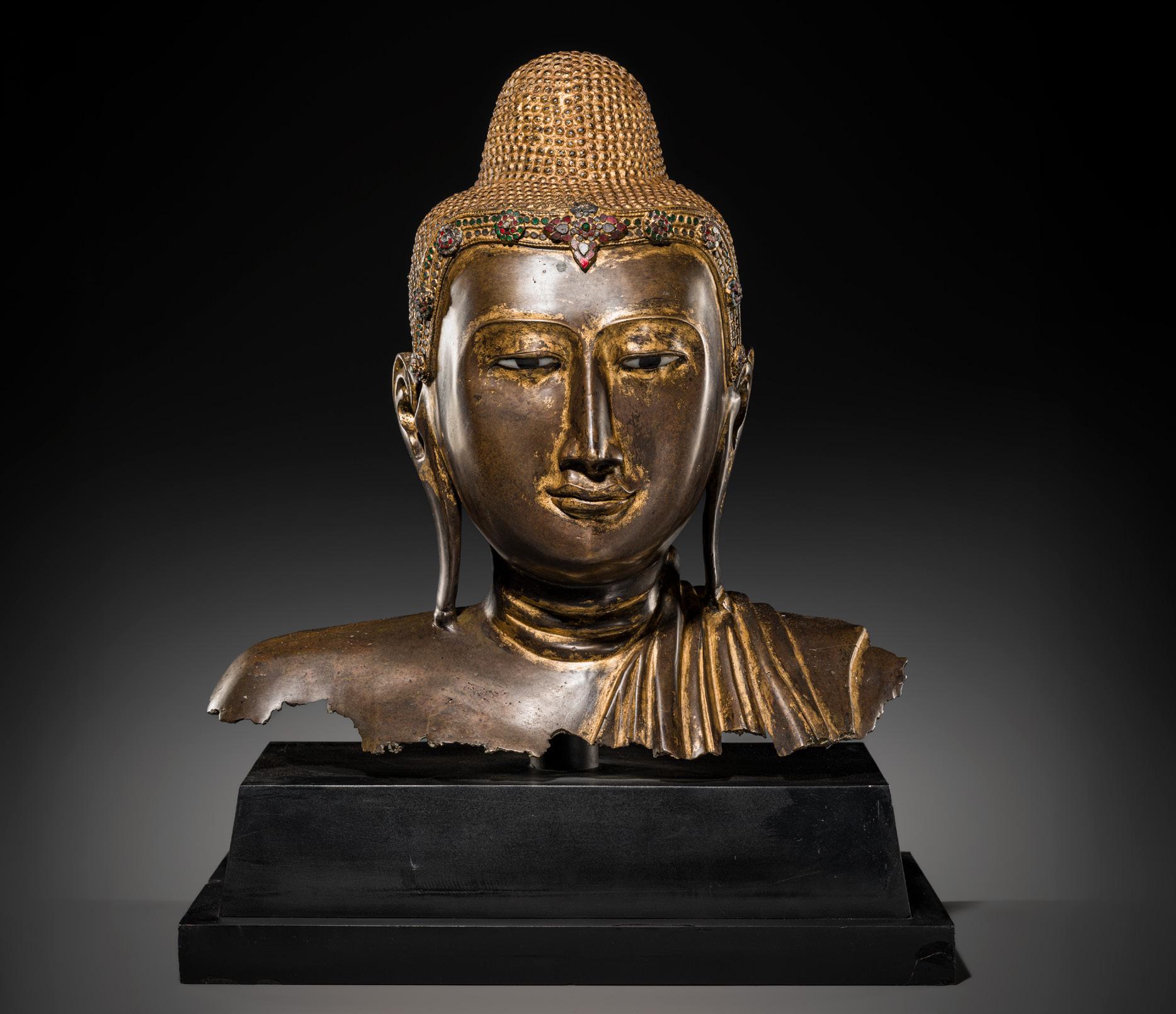
A RARE AND LARGE GILT-LACQUERED BRONZE BUST OF BUDDHA, EARLY MANDALAY PERIOD
Expert’s note: This superb bust represents the high point of the Mandalay period for traditional Burmese sculpture. It most likely belonged to an exceptionally large seated figure—standing figures were more commonly carved from wood during this period—of around two meters height.
Burma, 1853-1948, and most likely early in this period. Finely cast, the face sensitively modeled in a serene expression marked by heavylidded, almond-shaped eyes inlaid with mother-of-pearl and black lacquer, below gently arched brows centered by the long prominent nose above full bow-shaped lips forming an enigmatic smile, flanked by elongated earlobes, the hair arranged in tight curls over the high ushnisha and secured by a headband richly inlaid with floral designs in ruby-red, emerald-green, and mirror glass.
Provenance: Galerie Hardt (established in 1976), Radevormwald, Germany, before 2020. Acquired by the gallery’s founder Peter Hardt (b. 1946) during his extensive travels in Asia, the first of which occurred during a formative world tour in 1973.
Condition: Overall good condition with wear, manufacturing irregularities, obvious losses, minor fatigue cracks, few nicks, light surface scratches, extensive rubbing, flaking, and losses to lacquer, remnants of pigment, expected minor losses to inlays. The bronze with a fine, naturally grown, dark patina.
Weight: 33.9 kg (incl. stand)
Dimensions: Height 48.5 cm (excl. stand), 62.5 cm (incl. stand)
Mounted on an associated metal stand. (2)
AUCTION RESULT COMPARISON
Type: Closely related
Auction: Christie’s Paris, 31 October 2006, lot 542
Price: EUR 8,400 or approx. EUR 11,500 adjusted for inflation at the time of writing
Description: A Burmese, Mandalay style, bronze head of Buddha Sakyamuni, 18th century Expert remark: Compare the closely related modeling and manner of casting with particularly similar eyes. Note the size (50 cm) and earlier dating.
Estimate EUR 3,000
Starting price EUR 1,500
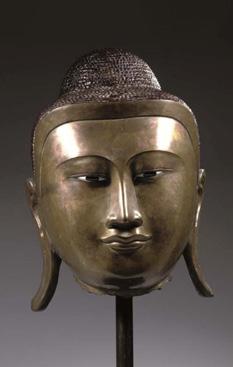
Burma. Finely carved, the serene face with heavylidded downcast eyes below sinuous brows, his full bow-shaped lips forming a benevolent smile, flanked by long pendulous lobes, highlighted with neatly incised lines, the hair arranged in tight curls over the ushnisha topped by a large, separately carved, bud-form ketumala.
Provenance: Galerie Hardt (established in 1976), Radevormwald, Germany, before 2020. Acquired by the gallery’s founder Peter Hardt (b. 1946) during his extensive travels in Asia, the first of which occurred during a formative world tour in 1973.
Condition: Overall good condition with expected wear and obvious losses, few age cracks, light surface scratches, wear to lacquer, minor old repairs. Good, naturally grown patina.
Dimensions: Height 56.9 cm (excl. stand), 67.2 (incl. stand)
Mounted on an associated stand. (2)
The founding of Shan States inside the present-day boundaries of Burma began during the Pagan Kingdom in the Shan Hills and accelerated after 1287 when the Kingdom fell to the Mongols. The Tai people, who came south with the Mongols, stayed, and quickly came to dominate much of the northeastern arc of Burma. The newly founded Shan States were multi-ethnic and included minorities such as the Chin, the Kachin, the Wa, the Ta’ang, the Lisu, the Lahu, the Pa O, and the Kayah. Although Burmanized Shans founded the Ava Kingdom that ruled central Burma, other Shan States, Mohnyin in particular, constantly raided Ava territories throughout the years.
Within this layered political arrangement, the Shan style of Buddhist art emerged, a localized sculptural idiom shaped by Tai traditions, courtly patronage, and crossregional influences, including Mon, Burmese, and Lanna aesthetics. Though not coterminous with the Shan States themselves, Shan style sculpture flourished within their territories and, by the 18th century, had spread across the Burmese cultural sphere. These works often served as expressions of religious devotion, regional identity, and elite legitimacy under shifting regimes of power.
COMPARISON
Type: Closely related Auction: Christie’s, 8 May 2002, lot 578
Price: EUR 6,572.50 or approx. EUR 11,000 adjusted for inflation at the time of writing
Description: A Burmese, Shan style, gilt blacklacquered wood head of Buddha Shakyamuni, 19th century

Expert remark: Compare the closely related modeling, manner of carving, and lacquering. Note the size (75 cm).
Estimate EUR 3,000
Starting price EUR 1,500
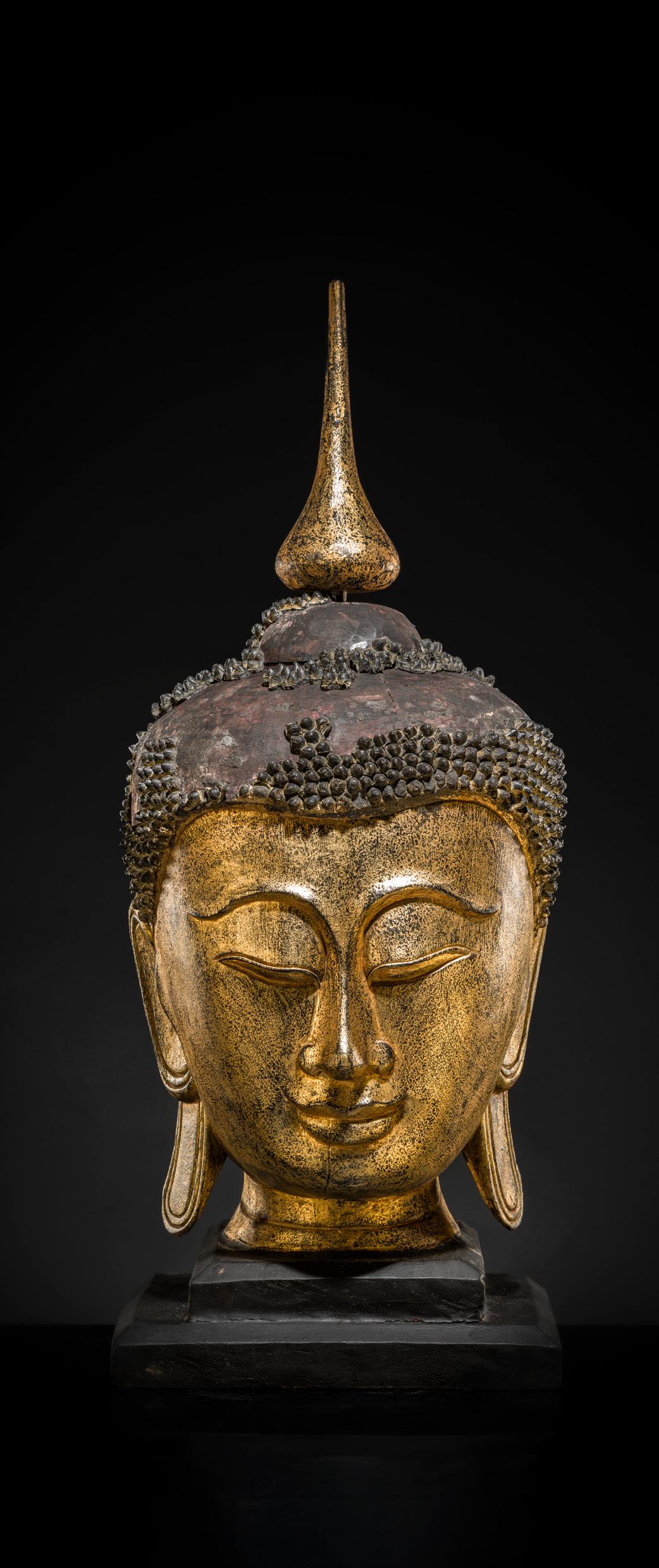
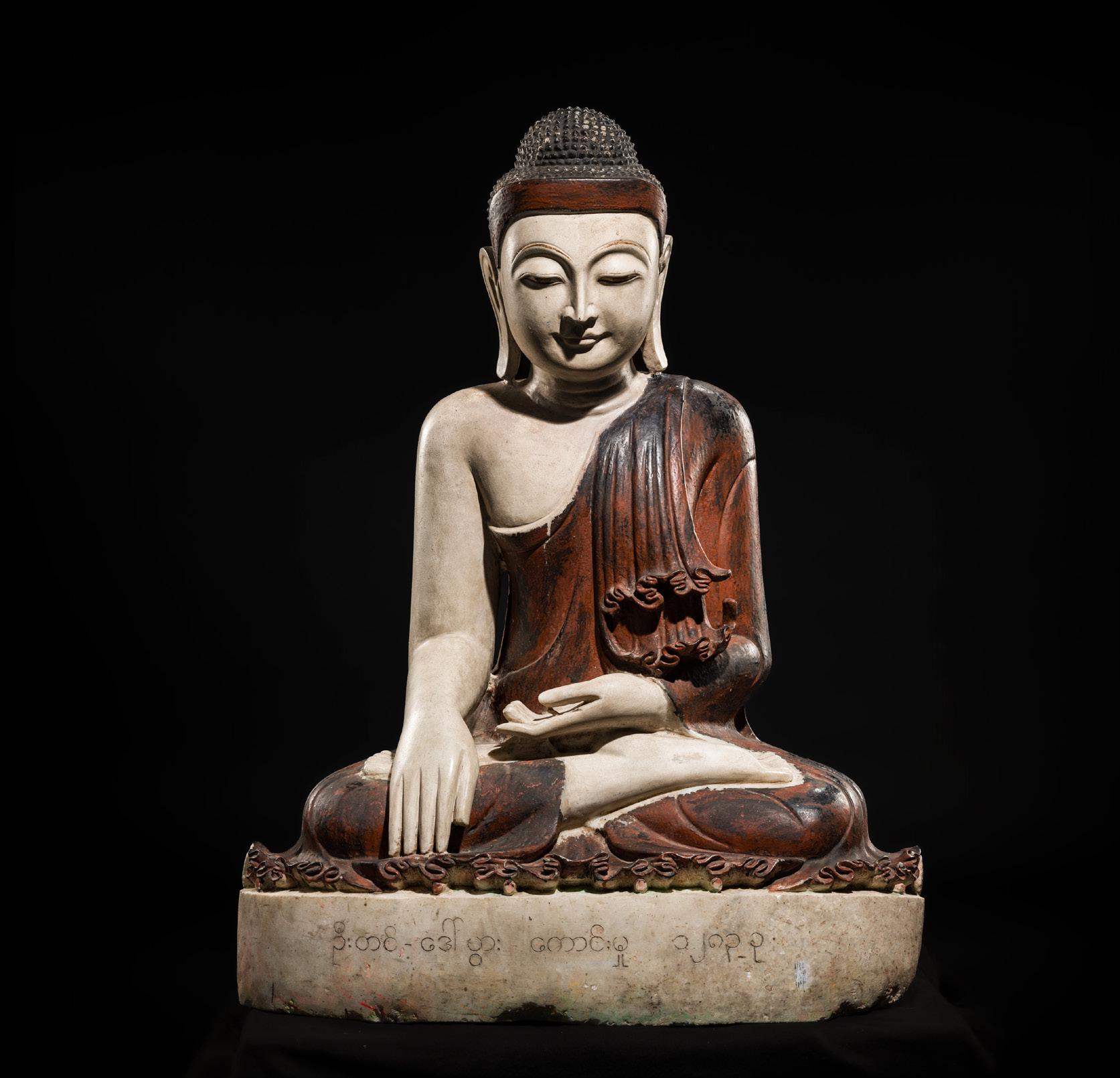
A LARGE LACQUERED WHITE MARBLE FIGURE OF BUDDHA, MANDALAY STYLE
Burma, 19th to early 20th century. Well carved seated in dhyanasana atop an oval base, his right hand lowered in bhumisparsha mudra and the left held in dhyana mudra above the lap, wearing loose-fitting monastic robes gathering in frill-like folds at the top of the base. His face finely painted with gilt and skillfully modeled in a serene expression with downcast eyes and subtle smile, flanked by long pendulous earlobes. The hair secured by a plain tiara and arranged in tight curls over the high domed ushnisha.
Provenance: The Kienzle Family Collection, Stuttgart, Germany. Acquired between 1950 and 1985 by siblings Else (1912-2006), Reinhold (1917-2008), and Dr. Horst Kienzle (1924-2019), during their extensive travels in Asia. Subsequently inherited by Dr. Horst Kienzle and bequeathed to the Museum für Asiatische Kunst, Radevormwald, Germany. Released through museum deaccession in 2024.
Labels: Galerie Hardt, inscribed ‘Reg 127512’, and priced at EUR 12,750
Condition: Very good condition with expected wear, flaking and losses to the lacquer, minor losses to lower edge of the base, a small section of the hem with an old repair. Some of the lacquer with old touchups.
Dimensions: Height 107 cm
LITERATURE COMPARISON
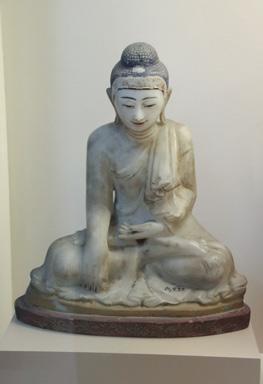
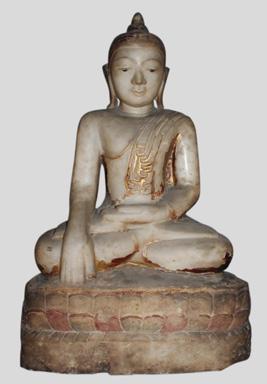
Compare a closely related marble figure of Buddha, dated 19th-20th century, in the National Museum of Thailand, Bangkok. Compare a related giltlacquered marble figure of Buddha, dated 18th-19th century, 89 cm high, in the British Museum, registration number 1880.1536.
Estimate EUR 8,000
Starting price EUR 4,000

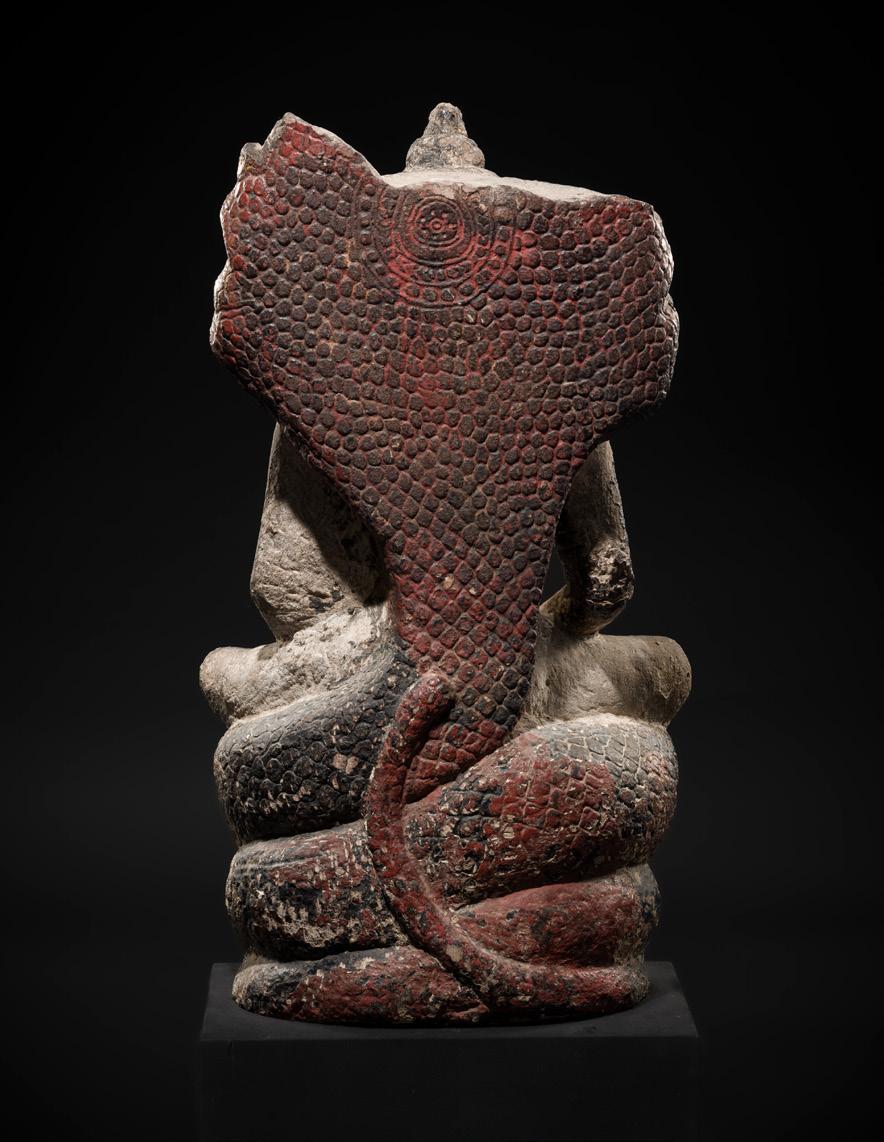
24
Thailand. Powerfully sculpted, seated in dhyanasana on the scaled coils of Muchalinda, his hands lowered in dhyanamudra, richly adorned with jewelry. The face with downcast eyes in a benevolent expression, flanked by elongated earlobes with pendant earrings. The hair arranged in curly rows over the domed ushnisha and surmounted by a knopform finial, backed by a seven-headed naga hood which is painted in red and black with traces of gilding.
Provenance: The Kienzle Family Collection, Stuttgart, Germany. Acquired between 1950 and 1985 by siblings Else (1912-2006), Reinhold (1917-2008), and Dr. Horst Kienzle (1924-2019), during their extensive travels in Asia. Subsequently inherited by Dr. Horst Kienzle and bequeathed to the Museum für Asiatische Kunst, Radevormwald, Germany. Released through museum deaccession in 2024.
Condition: Very good condition, commensurate with age. Old wear, obvious losses, cracks, signs of weathering and erosion, encrustations, scattered nicks and scratches, small chips. Flaking and losses to pigment and gilt. A section of the right arm with old repairs and touchups.
Dimensions: Height 91 cm (excl. stand), 104 cm (incl. stand)
Mounted on an associated base. (2)
The concept of this particular iconographic subject goes back to a specific event in the life of Buddha Shakyamuni in the sixth week after his Enlightenment at Bodhgaya in northern India. One day, when he was meditating, a thunderstorm broke out and the serpent king, named Muchalinda, emerged from its subterranean abode, extending its large hood over the meditating Buddha in order to protect him during his meditation.
The ancient city of Lopburi has a history dating back to the Dvaravati period more than 1000 years ago. According to the Northern Chronicles, the Lavo Kingdom was founded by Phraya Kalavarnadishraj, who came
from Takkasila in 648 AD. The city was incorporated into the administration structure of the Khmer Empire during the reign of Suryavarman I (10061050). According to a legend in the Northern Chronicles, in 903, a king of Tambralinga invaded and took Lavo and installed a Malay prince to the Lavo throne. The Malay prince was married to a Khmer princess who had fled an Angkorian dynastic bloodbath. The son of the couple contested for the Khmer throne and became Suryavarman I, thus bringing Lavo under Khmer domination through personal union. Suryavarman I also expanded into Isan, constructing many temples.
LITERATURE COMPARISON
Compare a closely related Lopburi style Buddha Muchalinda in the King Narai National Museum, Thailand.
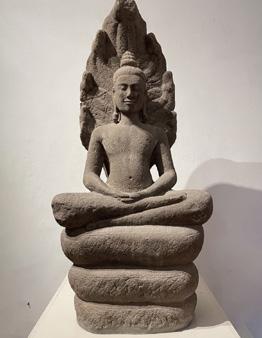
AUCTION RESULT COMPARISON
Type: Closely related
Auction: Sotheby’s New York, 24 March 2004, lot 48
Price: USD 40,000 or approx. EUR 60,000 converted and adjusted for inflation at the time of writing
Description: Buddha sheltered by Muchalinda, red sandstone, Central Thailand, Lopburi region
Expert remark: Note the size (99.1 cm).
Estimate EUR 14,000
Starting price EUR 7,000
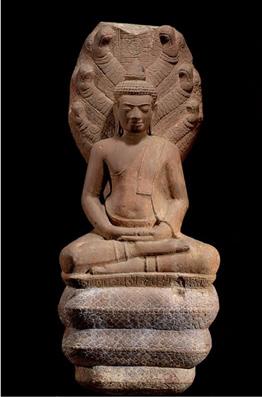
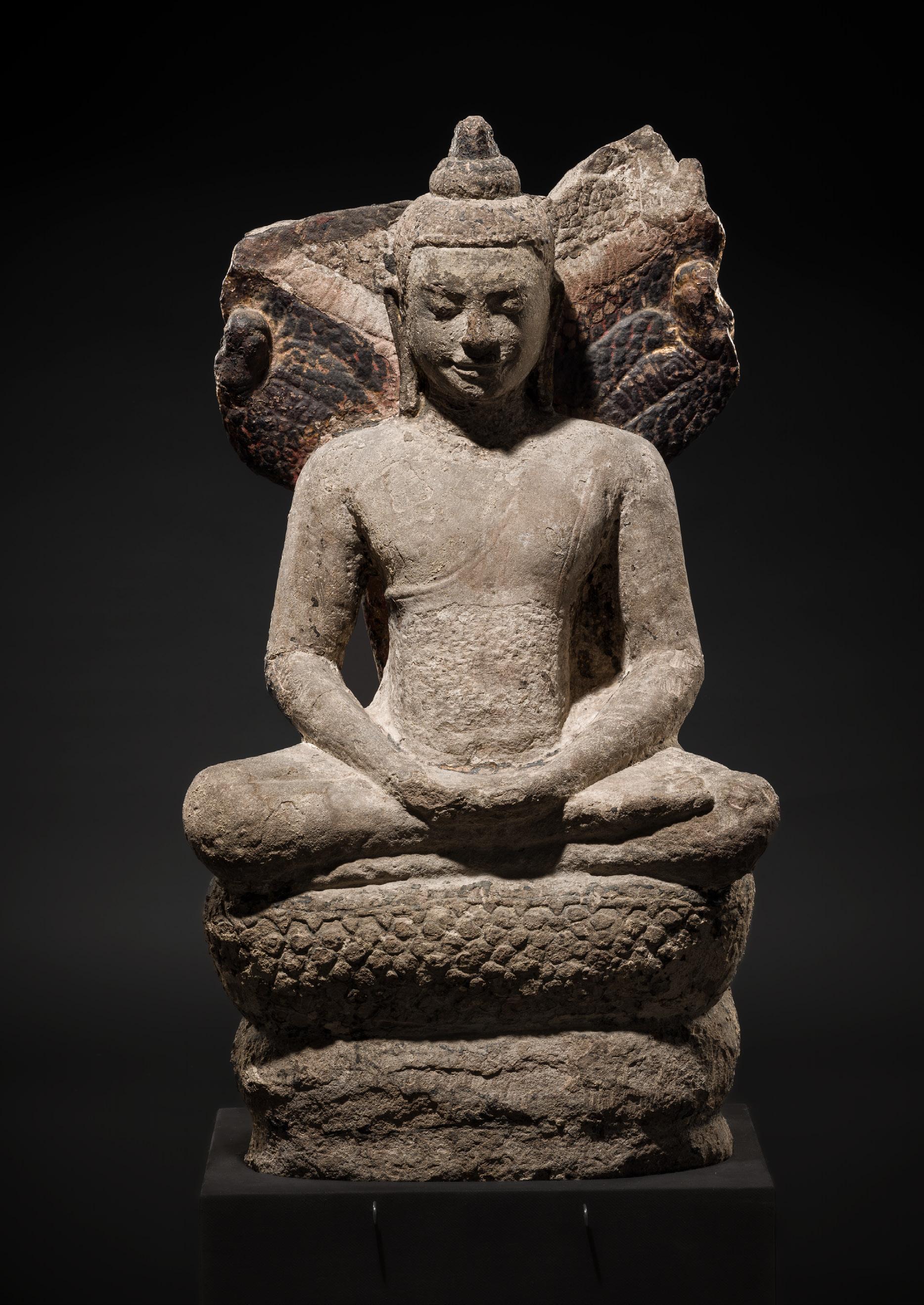
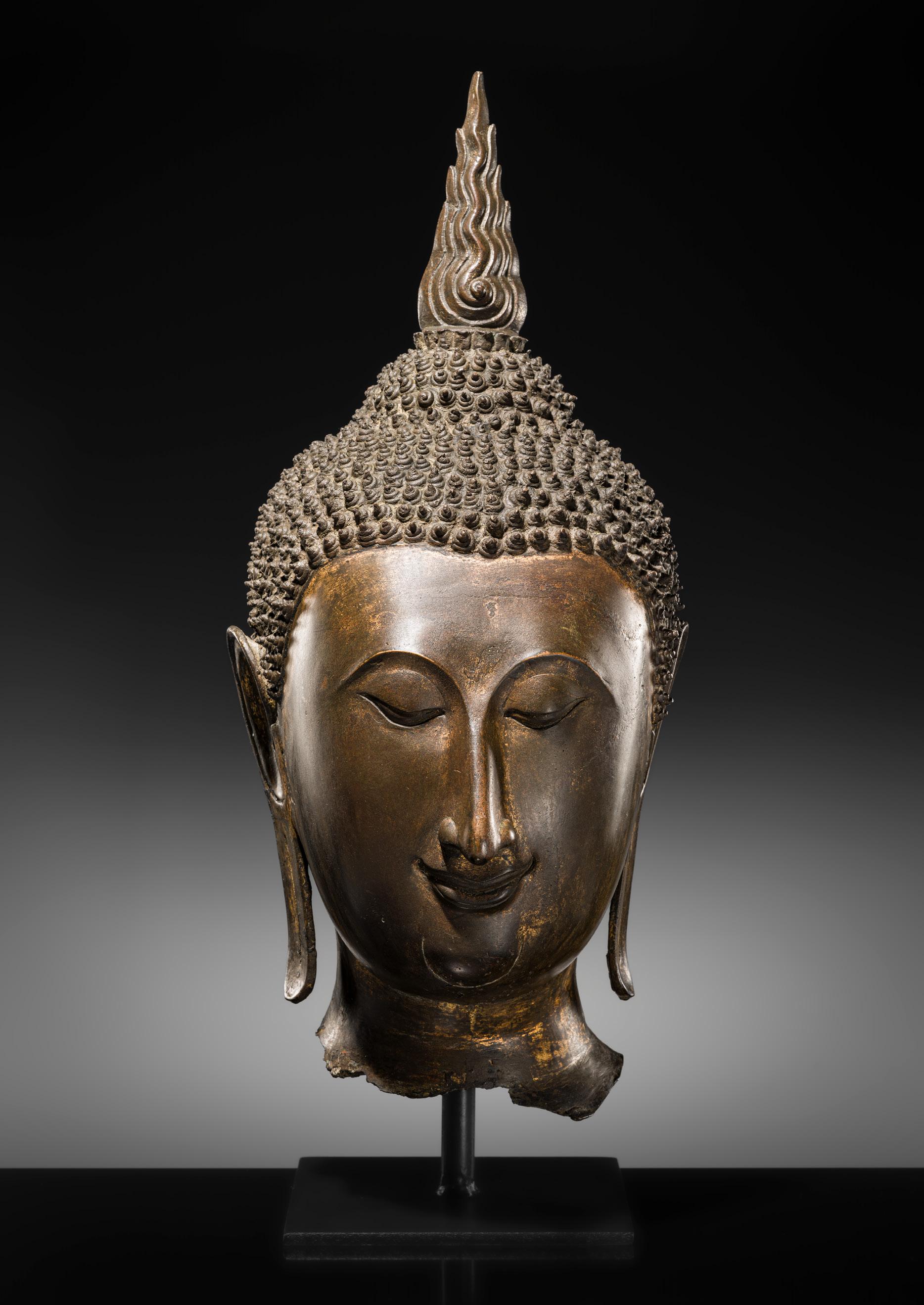
25
Thailand. Superbly cast, the face exquisitely modeled in a serene expression with heavy-lidded downcast eyes, elegantly arched brows, neatly incised slender lips forming a benevolent smile, flanked by elongated ears, the hair arranged in tight snail-shell curls over the high ushnisha surmounted by a tall flaming finial rising from a lotus blossom.
Provenance: Galerie Hardt (established in 1976), Radevormwald, Germany, before 2020. Acquired by the gallery’s founder Peter Hardt (b. 1946) during his extensive travels in Asia, the first of which occurred during a formative world tour in 1973.
Condition: Good condition with old wear and casting irregularities. Obvious losses, few light nicks and small dents, flaking and extensive losses to gilt. The left cheek and temple with a fine fissure with few associated old small fills and minor touchups. The bronze with a fine, naturally grown, warm patina.
Weight: 22.8 kg (incl. stand)
Dimensions: Height 60 cm (excl. stand), 68.5 cm (incl. stand)
Mounted on a modern metal stand. (2)
Expert’s note:
It is difficult to conceive just how massive the entire sculpture to which this monumental head originally belonged would have been. Few works of comparable size have survived, and this magnificent head is one of the largest in private hands. However, two examples currently in museums should be mentioned. The first is in the Ackland Art Museum in Chapel Hill, North Carolina (see literature comparison), and the second is in the permanent collection of the National Museum, Bangkok, though its sharper features suggest a slightly later date (see Jean Boisselier, The Heritage of Thai Sculpture, New York, 1975, no. 12, pp. 31 and 222). As can be seen in these two pieces and the present example, Thai artisans were highly skilled at bronze casting and capable of producing monumental figures in seated, standing, and even walking postures.
Buddhist art produced during the Sukhothai Kingdom (1238-1438) of North-Central Thailand displays a remarkably cohesive style. During this golden age of Thai art, the kingdom’s Theravada affiliation inspired the production of serene Buddha figures. The faces are characterized by an oblong shape with full cheeks and ears flared slightly at the tips, and the heavy-lidded eyes angle slightly towards the nose to reinforce the interior nature of the gaze. Although it lasted only two centuries, the Sukhothai Kingdom gave birth to a school of art in Thailand that is considered comparable to that of the Gupta Dynasty in India in terms of both artistry and influence. The Sukothai kingdom lasted for just two centuries but was an extremely wealthy and powerful period in the history
of Thailand. Artists produced some of the most sophisticated and original sculpture found in Thailand. They were the first to depict the Buddha in four different attitudes: standing; seated; walking and reclining, and the influence from this period can be seen in Thai sculpture throughout subsequent centuries. Religious texts prescribed strict definitions as to how the Buddha should be depicted and these rules were firmly adhered to while maintaining a fluidity of line and creating an additional element characterized by Griswold as a “fiery energy”.
LITERATURE COMPARISON

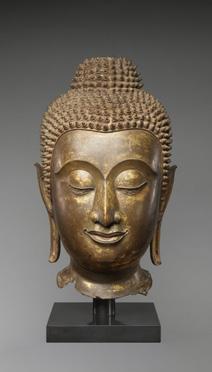
Compare a closely related larger Sukhothai gilt-bronze head of Buddha, dated to the 15th century, 97.2 cm high, in the Ackland Art Museum, The University of North Carolina at Chapel Hill, object number 91.2. Compare a closely related, slightly later gilt-bronze head of Buddha, dating from the early Ayutthaya period, 39.4 cm high, in the Metropolitan Museum of Art, object number 2019.570.12.
AUCTION RESULT COMPARISON
Type: Closely related
Auction: Sotheby’s New York, 23 March 2007, lot 49
Price: USD 72,000 or approx. EUR 98,000 converted and adjusted for inflation at the time of writing
Description: Head of Buddha, copper alloy, Thailand, Sukhothai period
Expert remark: Compare the closely related modeling and manner of casting with similar facial features, expression, hairstyle, and size (62.4 cm).
Estimate EUR 12,000
Starting price EUR 6,000
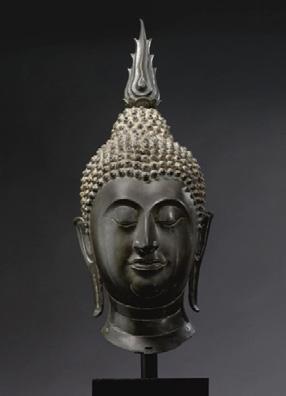
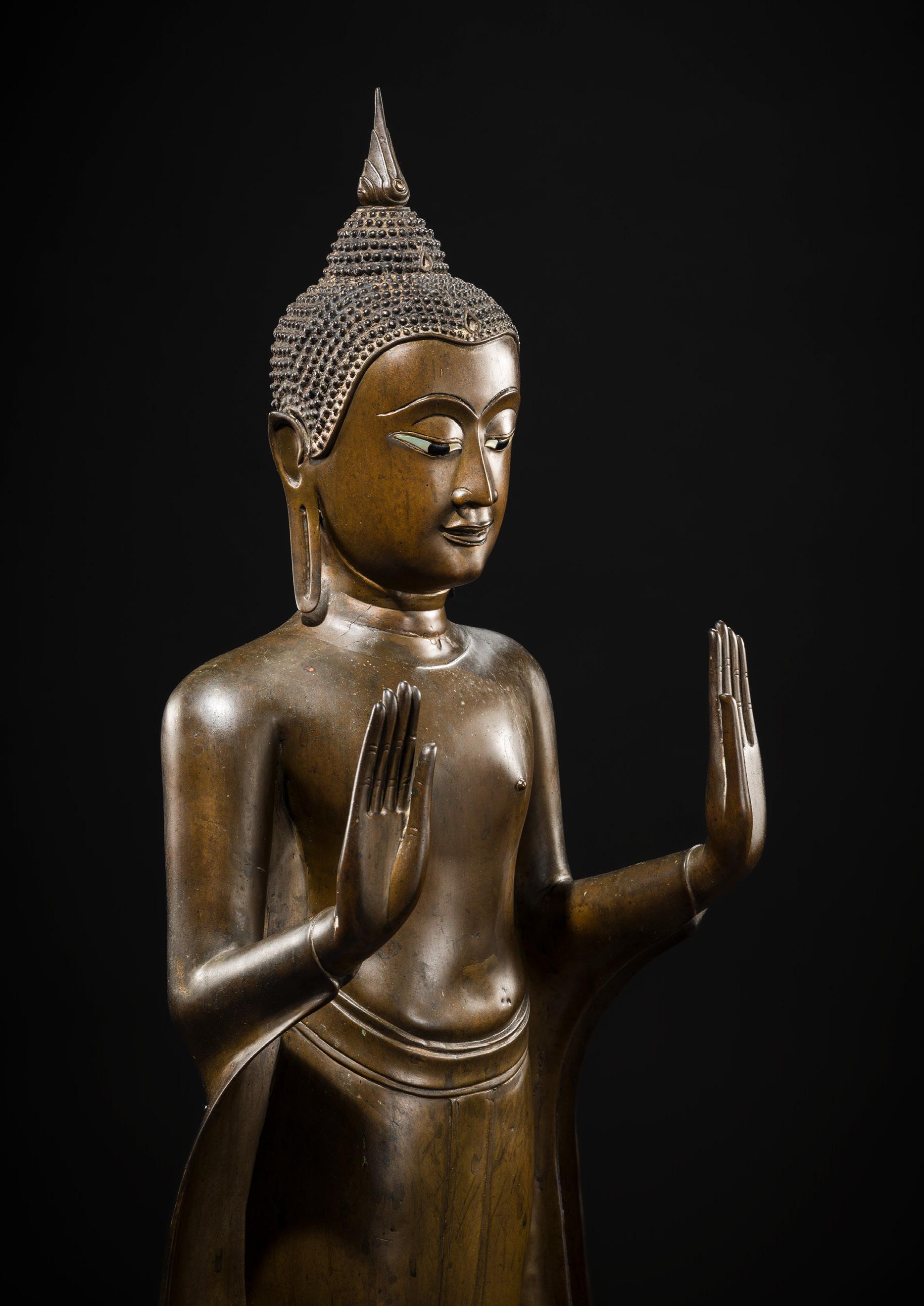
Thailand. Finely cast standing in samabhanga atop a square base with both hands extended in abhaya mudra. The figure wears a diaphanous sanghati draping elegantly from his arms, tied at the waist by a sash. His serene face finely modeled with full lips forming a gentle smile and heavy-lidded downcast eyes inlaid with mother-of-pearl as well as blacklacquer pupils, flanked by long pendulous lobes. The hair is arranged in tight curls, centered by a teardrop-shaped emblem over the domed ushnisha surmounted by a flame finial.
Provenance: Galerie Hardt (established in 1976), Radevormwald, Germany, before 2020. Acquired by the gallery’s founder Peter Hardt (b. 1946) during his extensive travels in Asia, the first of which occurred during a formative world tour in 1973.
Condition: Very good condition with minor wear and casting irregularities. Few tiny nicks and minute dents, light surface scratches, tiny casting or fatigue cracks. The bronze with a fine, naturally grown, smooth patina.
Weight: 17.5 kg (incl. stand)
Dimensions: Height 75.7 cm (excl. stand), 110.6 cm (incl. stand)
Mounted on an associated stand. (2)
During the 14th through 16th centuries, Thailand’s Ayutthaya kingdom became one of the most powerful forces on mainland Southeast Asia. Continuing the artistic trajectory set forth under the Sukhothai, the Theravada polity sponsored the production of Buddha images fashioned in a new distinct style. The faces display a curvilinear contour with the hairline lower towards the sinuous browline accentuated by elongated ears flared at upper and lower tips. The eyes, extending evenly across the width of the face, are three-quarters closed to endow the figure with a sense of serenity that is at once inwardly directed and also engaged with the world.
AUCTION RESULT COMPARISON
Type: Closely related
Auction: Koller, Zurich, 7 June 2016, lot 462
Price: CHF 12,500 or approx. EUR 14,500 converted and adjusted for inflation at the time of writing
Description: A fine bronze figure of the standing Buddha, Thailand, Ayutthaya period, 16th century
Expert remark: Compare the closely related modeling and manner of casting. Note the size (91 cm).
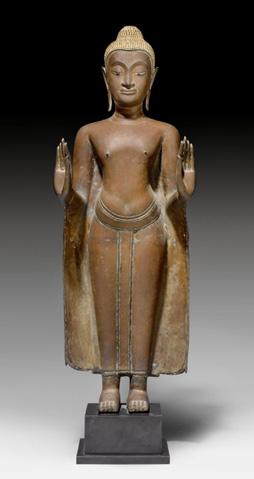
AUCTION RESULT COMPARISON
Type: Closely related
Auction: Christie’s Paris, 6 July 2022, lot 233
Price: EUR 22,680 or approx. EUR 24,500 adjusted for inflation at the time of writing
Description: A bronze figure of Buddha Shakyamuni, Thailand, Ayutthaya period, 17th century
Expert remark: Compare the closely related modeling and manner of casting. Note the size (106 cm).
Estimate EUR 8,000
Starting price EUR 4,000

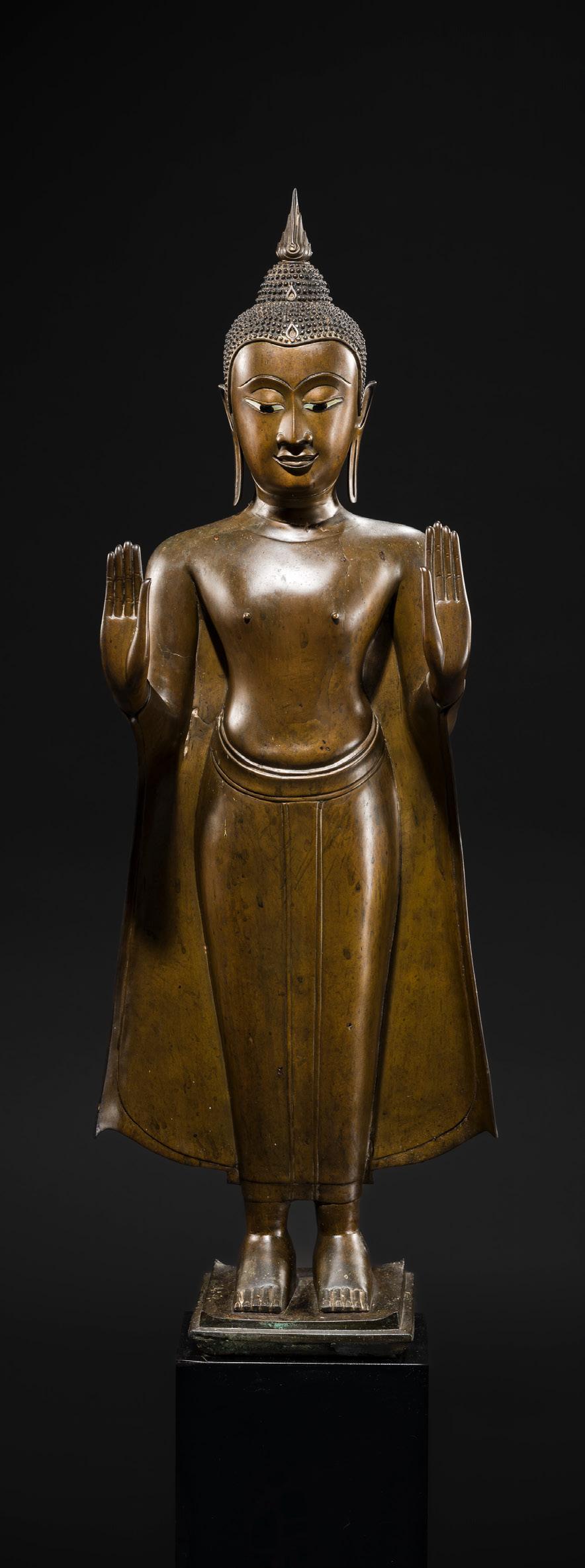
27
A LARGE BRONZE-COATED SANDSTONE HEAD OF CROWNED BUDDHA, PHRA CHAO SONG KHRUANG (‘A LORD WEARING ORNAMENTS’), AYUTTHAYA PERIOD
Exhibited: Galerie Hardt, 102. Kunst & Antiquitäten Messe München, 26-29 October 2023.
Thailand, 16th-17th century. Finely carved from hard sandstone and coated with a thin layer of bronze, the narrow face bearing a serene expression marked by heavy-lidded eyes, gently arched brows, a broad prominent nose, and full lips forming a calm smile. The crown intricately decorated with beaded, scrolling, floral, and flame designs below the conical ushnisha.
Provenance: Galerie Hardt (established in 1976), Radevormwald, Germany, before 2020. Acquired by the gallery’s founder Peter Hardt (b. 1946) during his extensive travels in Asia, the first of which occurred during a formative world tour in 1973.
Condition: Extensive wear, signs of deep weathering and erosion, encrustations, obvious losses, chips and losses to bronze coating, traces of gilt and pigments, the bronze with a rich, naturally grown, dark patina with malachite encrustation. Displaying superbly.
Weight: 20.1 kg (excl. stand)
Dimensions: Height 38.8 cm (excl. stand)
With a fitted wooden stand. (2)
The image of the Buddha wearing a distinctive crown is often described with the popular Thai term Phra Chao Song Khruang (A Lord Wearing Ornaments). The standard depiction of the Buddha throughout the Buddhist world shows him without jewels or other adornment, with distended earlobes signifying the earthly wealth he renounced when he left the palace. In Southeast Asia, however, crowned images of the Buddha were popular in the twelfth and thirteenth centuries, and then again in the sixteenth century when adorned Buddhas proliferated. The most popular explanation for this contradiction on his common demeanor derives from the Jambupatisutta, which tells the story of the arrogant and boastful king Jambupati. The Buddha appeared before Jambupati, bedecked and bejeweled, thus humbling him. An alternate explanation is that the
crowned Buddha is Maitreya, the Buddha of the future, who in this lifetime is a bodhisattva, a situation that may require that he be shown expressing both identities. Maitreya worship was widespread from the sixth century, as Buddhists commonly believe that those born during Maitreya’s lifetime automatically achieve enlightenment.
During the fourteenth through sixteenth centuries, Thailand’s Ayutthaya kingdom became one of the most powerful forces on mainland Southeast Asia. Continuing the artistic trajectory set forth under the Sukhothai, the Theravada polity sponsored the production of Buddha images fashioned in a new distinct style. Images of Buddha in royal attire, such as the present example where he is crowned and bejeweled, became increasingly popular. Ayutthaya period faces display a curvilinear contour with the hairline extending towards the sinuous browline, accentuated by elongated ears flared at the upper and lower tips. The eyes, extending evenly across the width of the face, are three-quarters closed to endow the figure with a sense of serenity that is at once inwardly directed and also engaged with the world.
AUCTION RESULT COMPARISON
Type: Related
Auction: Christie’s Amsterdam, 8 May 2001, lot 563
Price: NLG 19,975 or approx. EUR 15,500 converted and adjusted for inflation at the time of writing
Description: A Thai, Ayutthaya style, bronze head of Buddha Sakyamuni, 17th century
Expert remark: Compare the closely related subject and modeling with similar crown, features, and size (34 cm). Note this is a solid-cast bronze head.
Estimate EUR 8,000
Starting price EUR 4,000


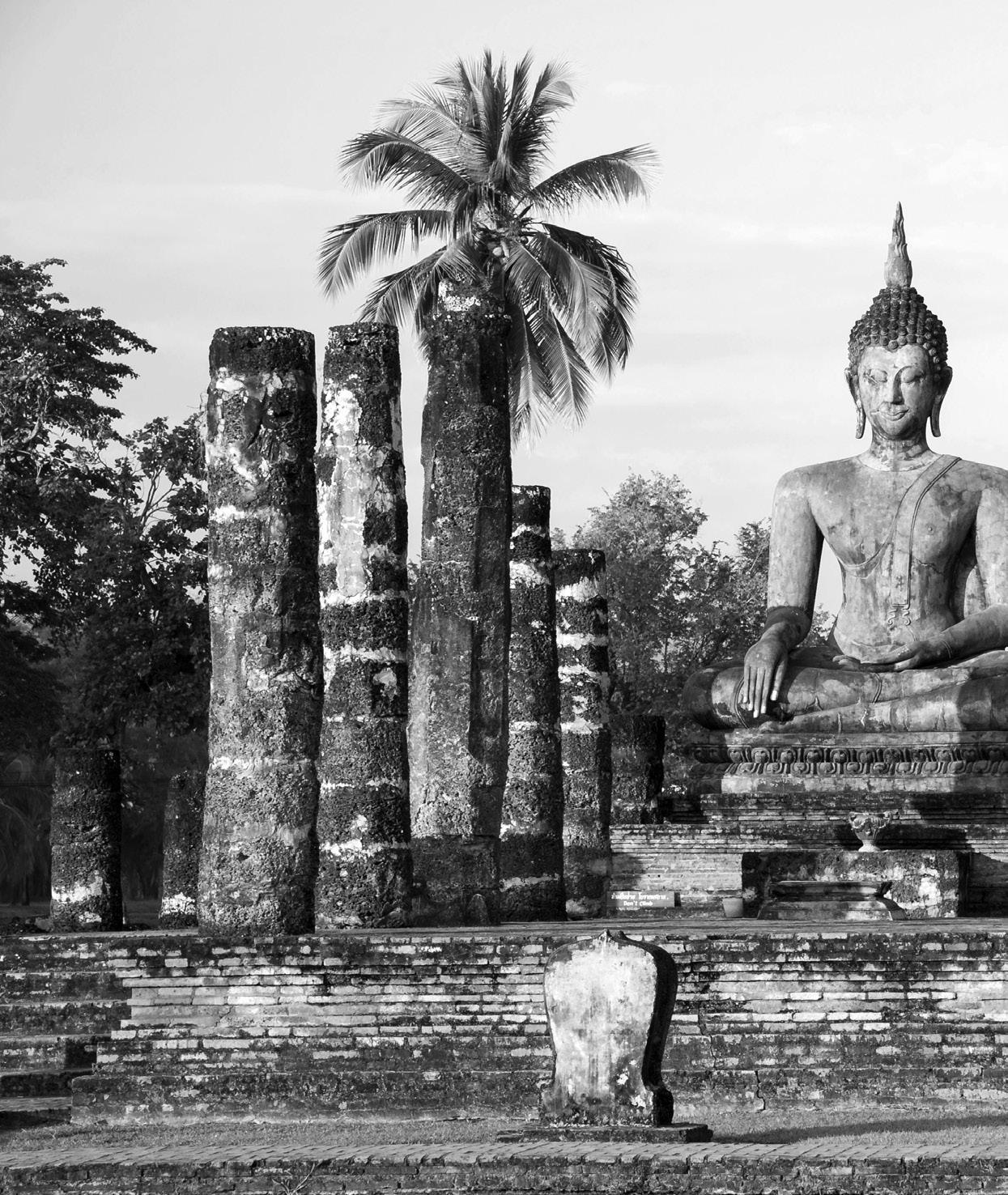
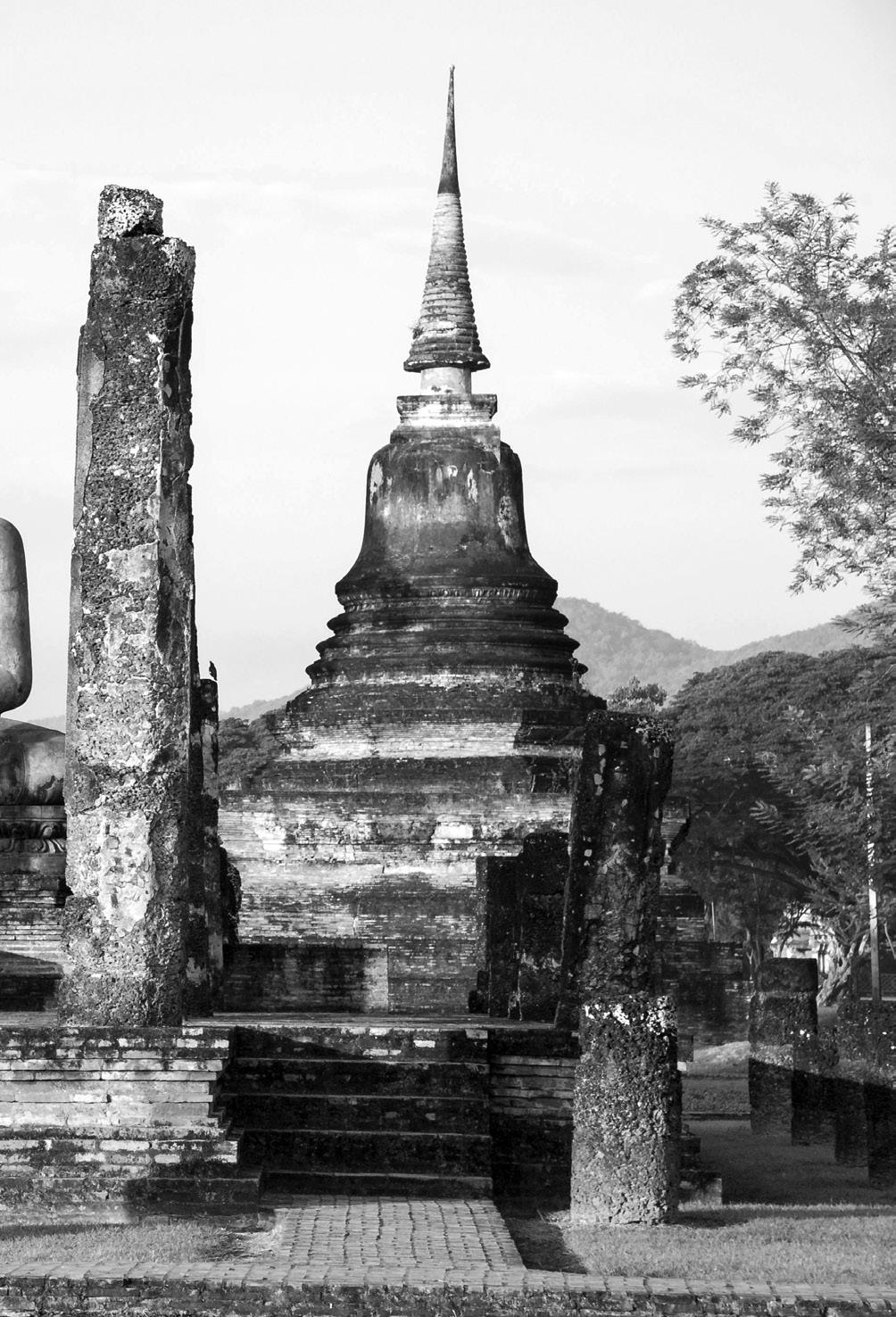


28
A RARE GROUP OF FIVE LARGE (156 CM HIGH) GILT-LACQUERED FIGURES OF BUDDHAS, LATE AYUTTHAYA TO EARLY RATTANAKOSIN PERIOD
Thailand, 17th to 18th century. Each standing in samabhanga atop a separately cast, octagonal, multi-tiered pedestal, wearing long, loosefitting monastic robes. Each hold their hands in different mudras, such as abhaya, anjali, and dhyana. They wear diaphanous monastic robes secured at the waist by a belt and have serene faces with heavy-lidded, downcast eyes, thin lips that form a calm smile, as well as elegantly arched brows. Their hair is arranged in pointed curls around a high ushnisha, which is surmounted by a separately cast ketumala. (5)
Provenance: The Kienzle Family Collection, Stuttgart, Germany. Acquired between 1950 and 1985 by siblings Else (1912-2006), Reinhold (1917-2008), and Dr. Horst Kienzle (1924-2019), during their extensive travels in Asia. Subsequently inherited by Dr. Horst Kienzle and bequeathed to the Museum für Asiatische Kunst, Radevormwald, Germany. Released through museum deaccession in 2024.
Condition: Good condition with expected wear and casting irregularities. Some areas of the gilding may have been refreshed in the 19th or early 20th century. Light scratches, tiny nicks and dents, extensive flaking to the gilt, and casting fissures. The figures can be moved from the base. A rich, naturally-grown, smooth patina, and areas of malachite encrustations.
Dimensions: Height circa 156 cm (each)
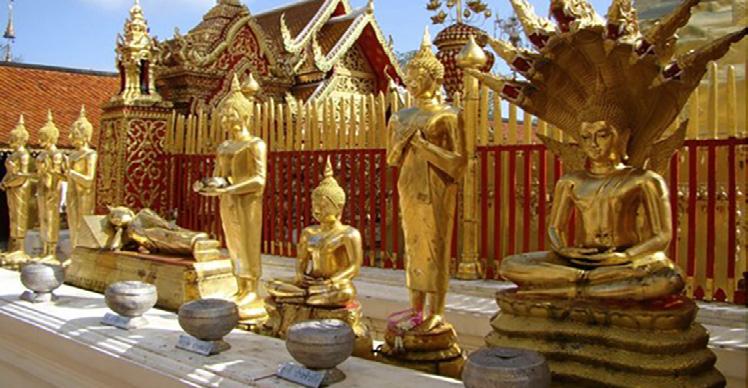
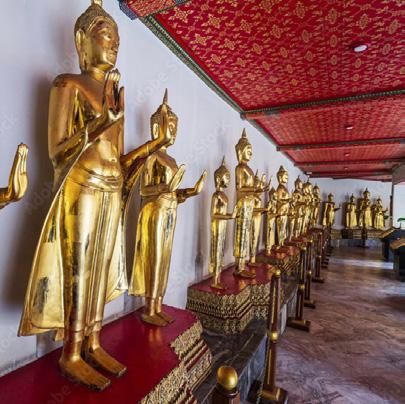
The Pali literature of the Theravada tradition includes tales of 28 previous Buddhas. In countries where Theravada Buddhism is practiced by the majority of people, such as Thailand, it is customary for Buddhists to hold elaborate festivals, especially during the fair weather season, paying homage to the last 28 Buddhas described in the Buddhavamsa. The Buddhavamsa is a text which describes the life of Gautama Buddha and the 27 Buddhas who preceded him, along with the future Metteyya Buddha. This lot comprises five figures from the lineage of the 28 Buddhas honored in the Theravada tradition, as seen in temple settings such as Wat Phra That Doi Suthep in Chiang Mai, where shrines to each of the Buddhas are arranged for devotional veneration, and Wat Pho, one of the best-known temples in Bangkok. Groups of Buddhas such as the present lot are exceedingly rare and almost never found outside of public shrines and temples.
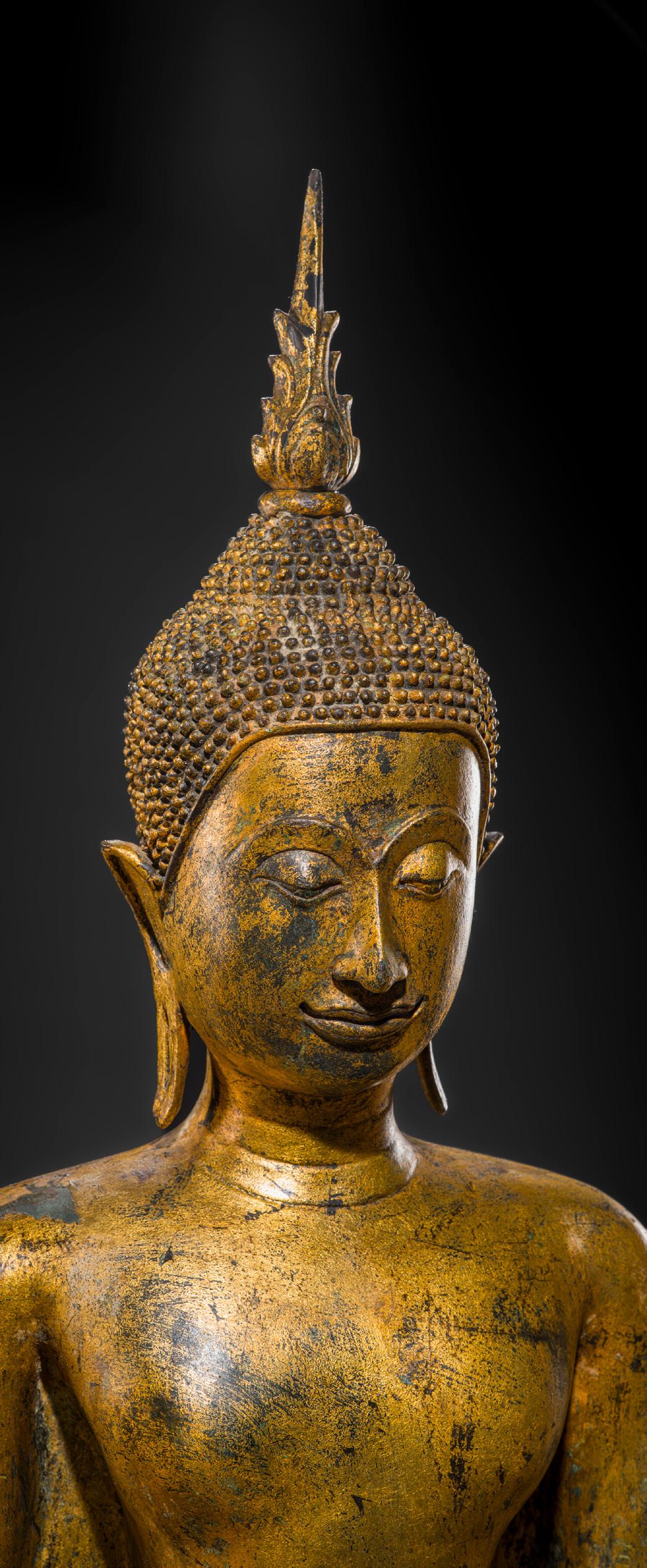
Thailand’s Ayutthaya kingdom was one of the most powerful forces in mainland Southeast Asia between the 14th and 18th centuries. Continuing the artistic trajectory set forth under the Sukhothai, the Theravada polity sponsored the production of Buddha images fashioned in a new distinct style. The faces display a curvilinear contour with the hairline lower, towards the sinuous brow line, accentuated by elongated ears flared at upper and lower tips. The eyes, extending evenly across the width of the face, are three-quarters closed to endow the figure with a sense of serenity that is at once inwardly directed and also engaged with the world.
Literature comparison:
Compare a related gilt-bronze figure of Buddha dated to the 15th century, 156.2 cm high, in the Metropolitan Museum of Art, accession number 1991.423.
AUCTION RESULT COMPARISON
Type: Closely related
Auction: Sotheby’s New York, 20 March 2025, lot 551
Price: USD 165,100 or approx. EUR 145,000 (for one) converted and adjusted for inflation at the time of writing
Description: A large giltbronze figure of Shakyamuni Buddha, Thailand, Ayutthaya period, 15th century
Expert remark: Compare the closely related modeling, manner of casting, and gilding, with similar robe, facial features, and expression. Note the size (155 cm) and earlier dating.
AUCTION RESULT COMPARISON
Type: Closely related
Auction: Sotheby’s Melbourne, 1 May 2007, lot 83
Price: AUD 14,400 or approx. EUR 13,000 (for one) converted and adjusted for inflation at the time of writing
Description: A gilt bronze standing Buddha, Thai, late Ayuthya period, early 18th century
Expert remark: Compare the closely related modeling, manner of casting, and gilding, with similar robe, facial features, and expression. Note the size (98 cm).
Estimate EUR 30,000
Starting price EUR 15,000

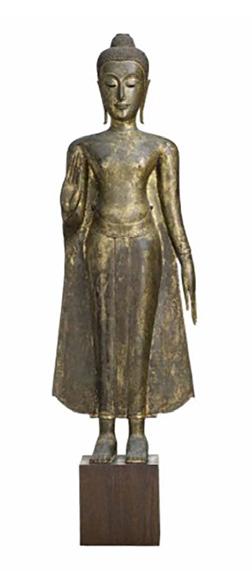
A MASSIVE BRONZE FIGURE OF BUDDHA SHAKYAMUNI, 18TH-19TH CENTURY
Northern Thailand. Seated in dhyanasana atop a beaded lotus throne raised on a separately cast stepped plinth decorated with bands of flowerheads and foliate emblems, his right hand lowered in bhumisparsha mudra and the left resting in his lap held in dhyana mudra, wearing close-fitting monastic robes, the serene face with lacquer-inlaid eyes, arched brows, and full lips forming a calm smile, flanked by elongated earlobes, the hair arranged in tight snail-shell curls over the ushnisha surmounted by a large flaming ketumala.
Weight: 68.6 kg
Dimensions: Height 110 cm
Provenance: Galerie Hardt (established in 1976), Radevormwald, Germany, before 2020. Acquired by the gallery’s founder Peter Hardt (b. 1946) during his extensive travels in Asia, the first of which occurred during a formative world tour in 1973.
Condition: Very good condition with minor wear and manufacturing irregularities. Few nicks, light dents, small surface scratches. The bronze with a fine, naturally grown patina with areas of verdigris.
Estimate EUR 6,000
Starting price EUR 3,000

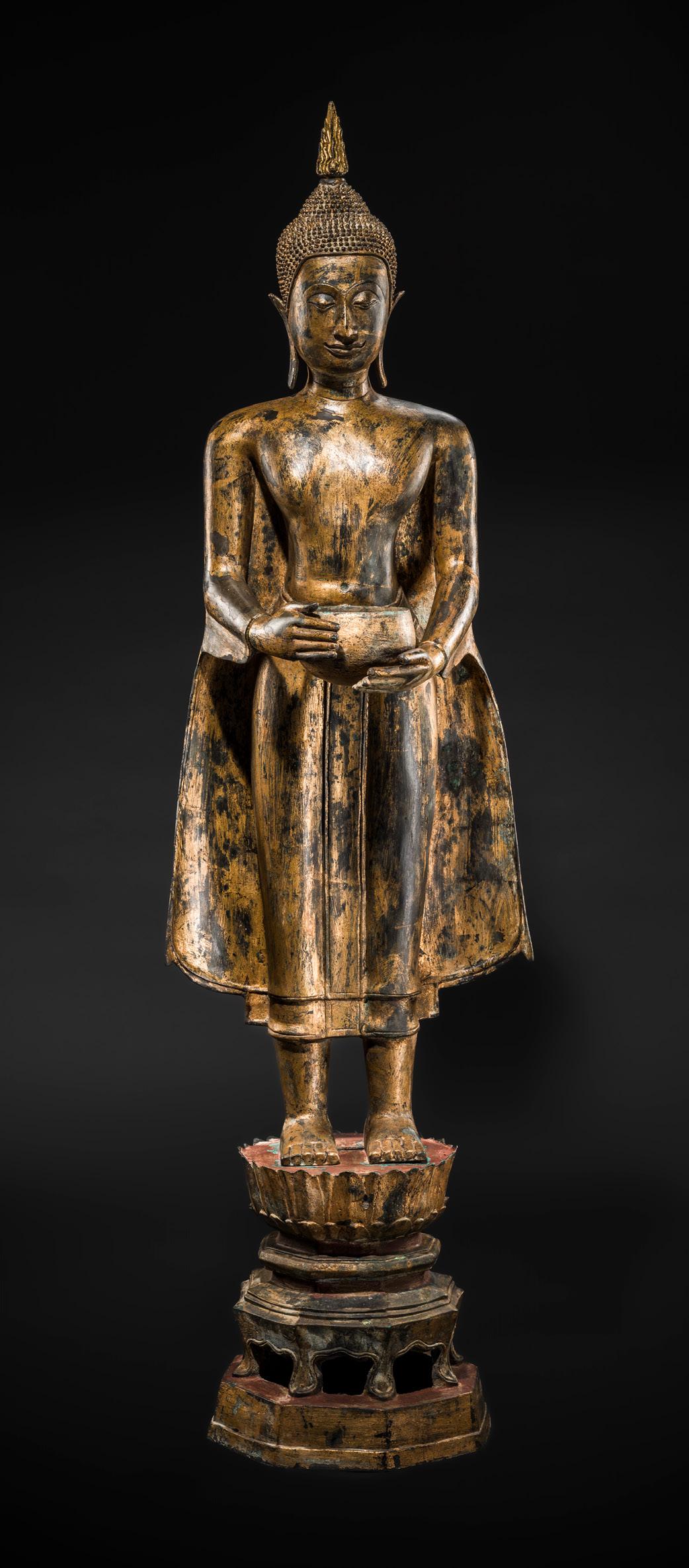
30
A VERY LARGE (117 CM HIGH) AND IMPRESSIVE GILT-BRONZE FIGURE OF BUDDHA, LATE AYUTTHAYA TO EARLY RATTANAKOSIN PERIOD
Thailand, 17th to 18th century. Heavily cast, standing in samabhanga atop a separately cast lotus pedestal, holding both hands in abhaya mudra. Wearing diaphanous monastic robes secured at the waist by a belt. His serene face with heavy-lidded downcast eyes, thin lips forming a calm smile, elegantly arched brows, and his hair arranged in pointed curls around a high ushnisha. The base cast with a ring.
Provenance: Galerie Hardt (established in 1976), Radevormwald, Germany, before 2020. Acquired by the gallery’s founder Peter Hardt (b. 1946) during his extensive travels in Asia, the first of which occurred during a formative world tour in 1973.
Condition: Good condition with expected wear and casting irregularities. Tiny nicks and dents, signs of weathering, extensive flaking to the gilt, casting fishes and a loss to the finial. A rich, naturallygrown, smooth patina, and areas of malachite encrustations.
Weight: 26.8 kg
Dimensions: Height 117 cm
AUCTION RESULT
COMPARISON
Type: Closely related
Auction: Christie’s London, 11 May 2016, lot 91
Price: GBP 12,500 or approx. EUR 22,500 converted and adjusted for inflation at the time of writing
Description: A giltbronze figure of Buddha, Thailand, Ayutthaya period, 17th century
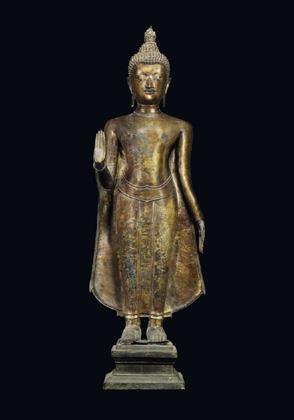
Expert remark: Compare the closely related modeling, manner of casting, and gilding, with similar robe, facial features, and expression. Note the smaller size (104 cm) and inlaid eyes.
Estimate EUR 6,000
Starting price EUR 3,000
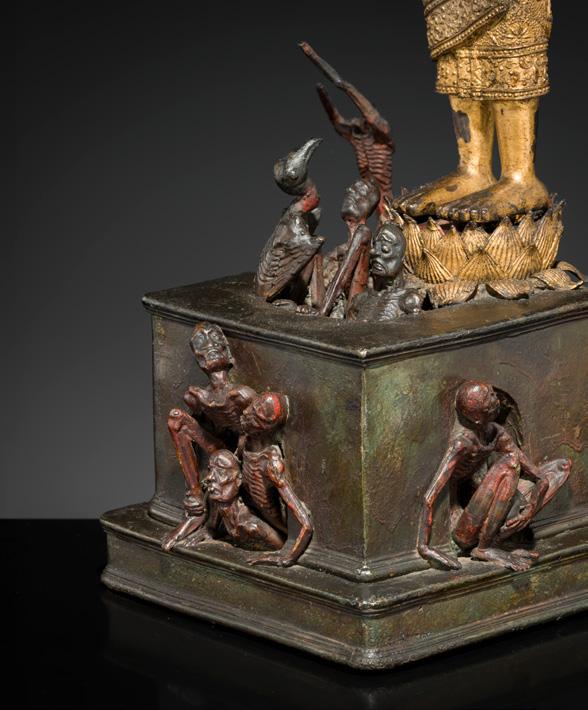
Thailand, reign of King Rama III, 1824-1851. Heavily cast, standing in samabhanga atop an intricately worked lotus dais, raised on a stepped square base from which skeletal bodies with imploring gestures emerge, some bearing animal heads. The towering figure of Phra Malai with both hands lowered in front of the abdomen, clad in a pleated closefitting sanghati, lavishly embroidered with diapered floral designs and medallions (pha lai), secured with a beaded sash. His serene face with a meditative expression marked by heavy-lidded downcast eyes set beneath arched brows, and full lips curved into a gentle smile, flanked by elongated earlobes, the hair arranged in tight curls.
Provenance: Galerie Hardt (established in 1976), Radevormwald, Germany, before 2020. Acquired by the gallery’s founder Peter Hardt (b. 1946) during his extensive travels in Asia, the first of which occurred during a formative world tour in 1973.
Condition: Good condition with old wear and casting irregularities, scattered nicks and surface scratches, some rubbing and light touchups to gilding, flaking to lacquer, and expected losses to extremities of some of the small figures. The bronze bearing a fine, naturally grown, dark patina.
Weight: 9.5 kg
Dimensions: Height 52.8 cm
Phra Malai's tale is widely recognized across Southeast Asia, particularly in Thailand and Laos. The narrative revolves around a devout and benevolent monk who undertakes a remarkable journey into the depths of Hell, his purpose is to impart teachings and provide solace to the tormented inhabitants of the underworld. The present example is a particularly well-executed piece illustrating this legend, which was popular during the Rattanakosin period.
Literature comparison: Compare a related piece illustrated by Jean Boisselier, La sculpture en Thailande, Fribourg, 1987, plate 141.
AUCTION RESULT COMPARISON
Type: Closely related
Auction: Christie’s London, 11 May 2016, lot 73
Price: GBP 2,500 or approx. EUR 4,500 converted and adjusted for inflation at the time of writing
Description: A parcel gilt-lacquered bronze figure of Phra Malai, Thailand, Rattanakosin period, early 19th century
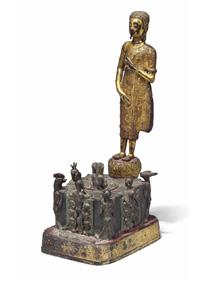
Expert remark: Compare the closely related form of the figure, the decorative style of his garment and the grim scene at his feet with emaciated bodies. Note the similar size (45 cm).
Estimate EUR 3,000
Starting price EUR 1,500
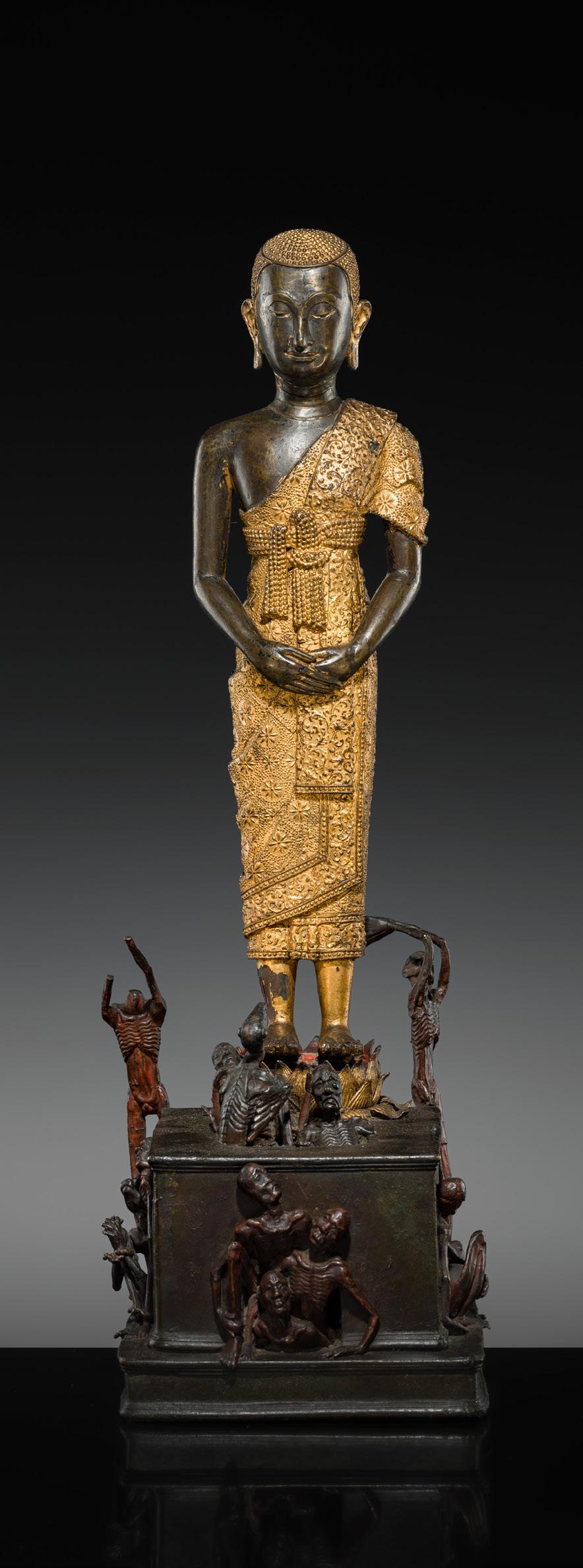
A VERY LARGE (187 CM HIGH) GILT-LACQUERED FIGURE OF BUDDHA SHAKYAMUNI WITH CANOPY, RATTANAKOSIN PERIOD
Thailand, reign of King Rama I-III, 1782-1851. Seated in ardha padmasana on a four-tiered triangular pedestal intricately decorated with geometric and floral designs. His right hand is lowered in bhumisparsha mudra while the left is held in dhyana mudra. He is dressed in a close-fitting sanghati lavishly decorated with diapered designs and floral roundels (pha lai). His face in a serene expression with heavy-lidded eyes, gently arched brows, prominent nose, and full lips forming a calm smile, flanked by long pendulous earlobes. The hair arranged in tight curls over the ushnisha surmounted by a separately cast flame finial. The figure sheltered beneath a large canopy in the form of a four-tiered reticulated parasol anchored to the back of the base.
Provenance: The Kienzle Family Collection, Stuttgart, Germany. Acquired between 1950 and 1985 by siblings Else (1912-2006), Reinhold (1917-2008), and Dr. Horst Kienzle (1924-2019), during their extensive travels in Asia. Subsequently inherited by Dr. Horst Kienzle and bequeathed to the Museum für Asiatische Kunst, Radevormwald, Germany. Released through museum deaccession in 2024.
Condition: Good condition with expected surface wear and casting irregularities, including few nicks and light scratches, small dents, rubbing and flaking to gilding, with remnants of lacquer and minor touchups.
Dimensions: Height 141 cm (excl. canopy) and 187 cm (incl. canopy)
Floral patterns are the most common designs on nineteenthcentury patterned robes, owing to their association with royalty, as such patterns on articles of clothing were reserved for use among royalty and members of the court. It was, therefore, suitable for exalted figures such as Prince Siddhartha and the Buddha to be depicted in similar motifs. Other motifs such as patterns of small seated Buddhas or geometric shapes can also be found on robes of mid-nineteenth-century sculptures; they are, however, not as common (see Melody Rod-Ari, The Buddha as Sacred Siamese King, The Walters Art Museum Journal, vol. 73, 2018, pp. 25-34).
The canopy is a rare feature that closely relates to the Emerald Buddha, an image of the meditating Buddha considered the sacred palladium of Thailand, carved in the 15th century from green jasper and clothed in gold, enshrined beneath a similar canopy in the Temple of the Emerald Buddha (Wat Phra Kaew) on the grounds of the Grand Palace in Bangkok. This image has played a central role in Thailand’s cultural and spiritual life for centuries. Early in the Bangkok period, the Emerald Buddha was occasionally paraded through the streets to protect the city from calamities like plague and cholera. This practice was discontinued during King Rama IV’s reign as it was feared that the image could be damaged during the procession and the king’s belief that “diseases are caused by germs, not by evil spirits or the displeasure of the Buddha”. The Emerald Buddha also marks the changing of the seasons in Thailand, with the king presiding over seasonal ceremonies. In a ritual held at the temple three times a year, the decoration of the statue is changed at the start of each of the three seasons. Rama I initiated this ritual for the hot and rainy seasons, and Rama III introduced the ritual for the winter. The robes and decorations which adorn the image represent those of monks and the king, depending on the season, while the king himself formally dresses as the Emerald Buddha.
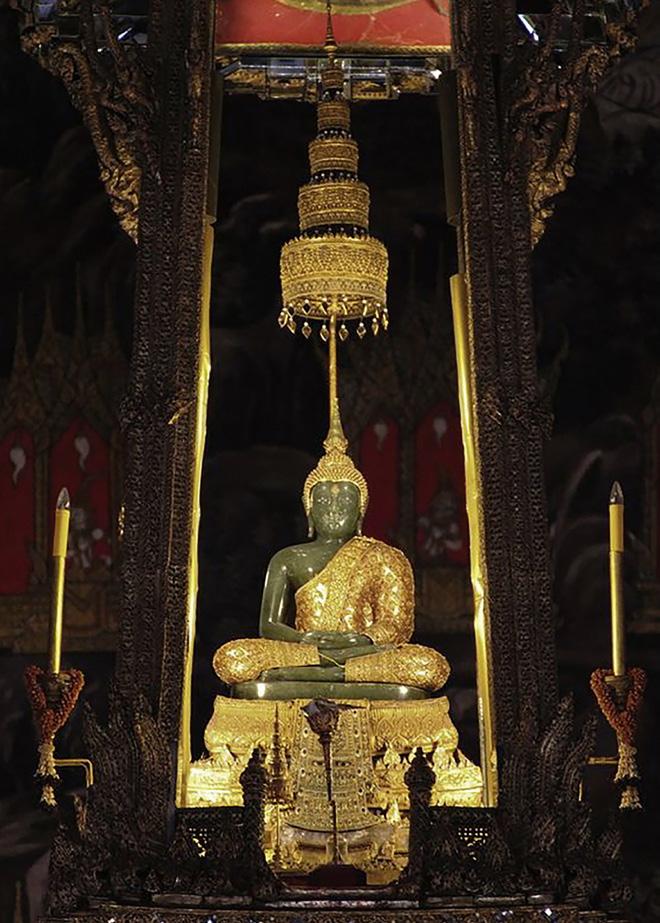
The Emerald Buddha enshrined beneath a canopy similar to that found on the present lot, in the Temple of the Emerald Buddha (Wat Phra Kaew) on the grounds of the Grand Palace in Bangkok, Thailand
Literature comparison: Compare a related gilt-lacquered brass figure of Buddha, dated ca. 1900, 70 cm high, in the Walters Art Museum, accession number 54.2987. See further examples of gilt lacquered bronze figures of Buddha Shakyamuni illustrated by Melody Rod-Ari, The Buddha as Sacred Siamese King, The Walters Art Museum Journal, vol. 73, 2018, figs. 1-5.
Type: Closely related
Auction: Bonhams New York, 23 July 2020, lot 841
Price: USD 22,575 or approx.
EUR 23,500 converted and adjusted for inflation at the time of writing
Description: A gilt lacquer copper alloy figure of Buddha, Thailand, Rattanakosin period, 19th century

Expert remark: Compare the closely related modeling and manner of casting with similar pose, robe, and face. Note the much smaller size (90 cm) as well as the missing flame, base, and canopy.
Estimate EUR 30,000
Starting price EUR 15,000


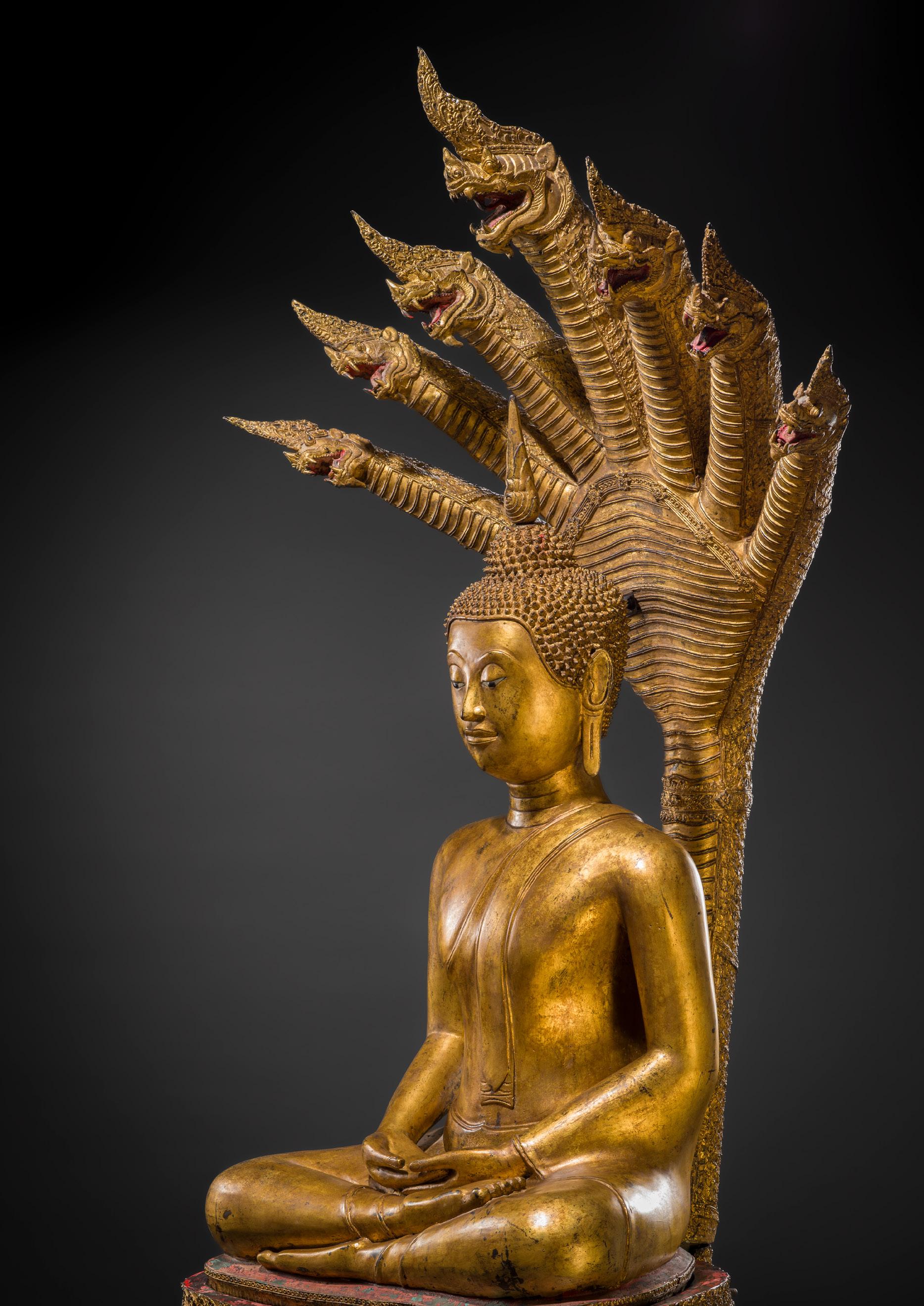
33 A MONUMENTAL (194 CM HIGH) GILT-LACQUERED BRONZE FIGURE OF BUDDHA MUCHALINDA, RATTANAKOSIN PERIOD
Thailand, reign of King Rama I-III, 1782-1851. Finely cast seated in ardha padmasana on a richly decorated throne atop the scaled coils of Muchalinda who rises above the Buddha’s head to form a separately cast protective hood. His hands are lowered in dhyana mudra, and he is dressed in a close-fitting sangati draped over the left shoulder. His serene face with heavy-lidded eyes, gently arched brows, prominent nose, and full lips forming a calm smile, flanked by long pendulous earlobes. The hair carefully arranged in tight curls over the ushnisha surmounted by a separately cast flame.
Provenance: The Kienzle Family Collection, Stuttgart, Germany. Acquired between 1950 and 1985 by siblings Else (1912-2006), Reinhold (1917-2008), and Dr. Horst Kienzle (1924-2019), during their extensive travels in Asia. Subsequently inherited by Dr. Horst Kienzle and bequeathed to the Museum für Asiatische Kunst, Radevormwald, Germany. Released through museum deaccession in 2024.
Labels: Galerie Hardt, inscribed ‘Buddha durch Naga […], Siam um 1850, Bangkok-Stil’, the back ‘Reg. 19516, H:194 B: 108 T: 79’, and priced at EUR 85,000
Condition: Good condition with expected wear and casting irregularities, few small nicks and light surface scratches, small dents, little rubbing, touchups, and minimal losses to gilding and lacquer.
Weight: ca. 325 kg
Dimensions: Height 194 cm
This finely cast popular representation of the Buddha is giltlacquered and modeled in a style typical of the Rattanakosin period that commenced in 1782. The Buddha sheltering under the seven-headed naga is typical of the showy glitter cherished at this time. Its iconography relates to the life story of the Historical Buddha, Shakyamuni: in the fifth week of the seven weeks, he meditated after attaining Enlightenment, when he was seated at the edge of Lake Muchalinda, a terrible storm arose, causing the waters of the lake to rise. Seeing that Buddha was lost in meditation, the serpent (naga) king Muchalinda slipped his coils under Buddha’s body, lifting him above the flood. At the same time, he spread the hoods of his seven heads to shelter him. This image is found throughout Southeast Asia.
Floral patterns are the most common designs on nineteenthcentury patterned robes, owing to their association with royalty, as such patterns on articles of clothing were reserved for use among royalty and members of the court. It was, therefore, suitable for exalted figures such as Prince Siddhartha and the Buddha to be depicted in similar motifs. Other motifs such as patterns of small seated Buddhas or geometric shapes can also be found on robes of mid-nineteenth-century sculptures; they are, however, not as common (see Melody Rod-Ari, The Buddha as Sacred Siamese King, The Walters Art Museum Journal, vol. 73, 2018, pp. 25-34).
LITERATURE COMPARISON
Compare a closely related smaller Rattanakosin gilt-lacquered bronze figure of Buddha Muchalinda, dated early 19th century, 74.3 cm high, in the Art Gallery of New South Wales, Sydney, accession number, 8337.
AUCTION RESULT COMPARISON
Type: Closely related
Auction: Bonhams Hong Kong, 29 March 2018, lot 46
Price: HKD 625,000 or approx. EUR 60,500 converted and adjusted for inflation at the time of writing
Description: A lacquer gilt-bronze figure of Buddha under Muchalinda, Thailand, mid-19th century
Expert remark: Compare the closely related modeling, manner of casting, decoration, and subject. Note the much smaller size (83 cm).
Estimate EUR 30,000
Starting price EUR 15,000
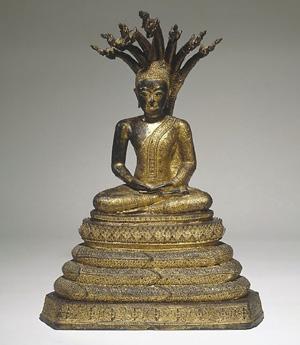

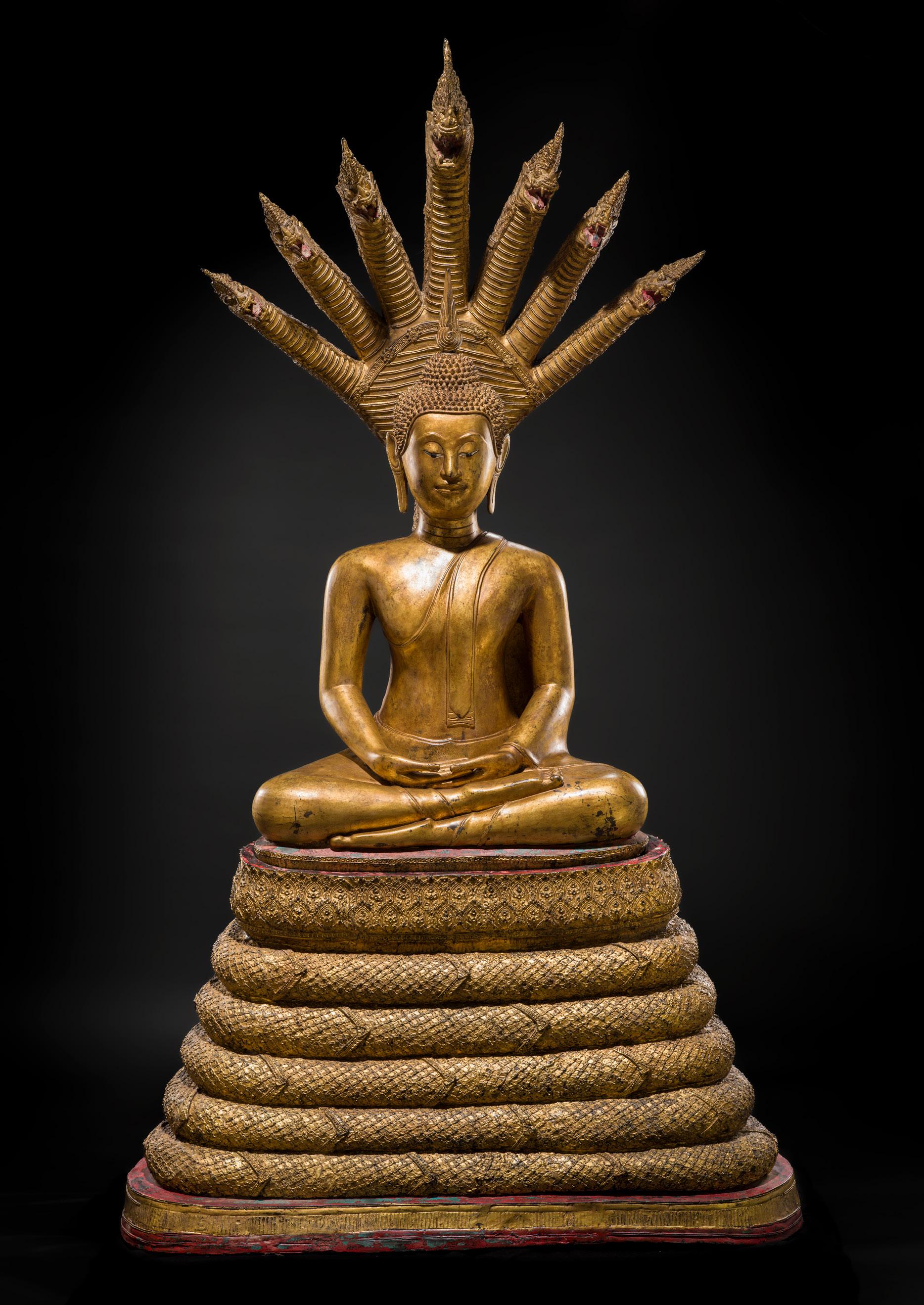

AND MONUMENTAL
POLYCHROME
Finely carved standing in samapada atop a square base with his right hand raised in abhaya mudra and the left hanging pendent to the side, dressed in a sheer robe that hangs gracefully from his forearms, with tapering hems, adorned with a bejeweled and floral-decorated belt, pectoral, and necklace. The serene face with full bow-shaped lips and almond-shaped eyes inlaid in bone and black glass, flanked by elongated earlobes with large pendeloque earrings, the hair pulled up into a high conical chignon and secured with an ornate crown.
Provenance: The Kienzle Family Collection, Stuttgart, Germany. Acquired between 1950 and 1985 by siblings Else (1912-2006), Reinhold (1917-2008), and Dr. Horst Kienzle (1924-2019), during their extensive travels in Asia. Subsequently inherited by Dr. Horst Kienzle and bequeathed to the Museum für Asiatische Kunst, Radevormwald, Germany. Released through museum deaccession in 2024.
Condition: In good condition commensurate with age, material, and monumental size. Exhibiting expected wear and natural imperfections, including age-related cracks and fissures. Some flaking, minor chips, and old restorations are present. The head has been reattached. Extensive wear and losses to the gilt and polychromy. Overall, the piece presents exceptionally well.
Dimensions: Height 265 cm
The image of the Buddha wearing a distinctive crown and elaborate ornamentation is often described with the popular Thai term Phra Chao Song Khruang (A Lord Wearing Ornaments). The standard depiction of the Buddha throughout the Buddhist world shows him without jewels or other adornment, with distended earlobes signifying the earthly wealth he renounced when he left the palace. In Southeast Asia, however, crowned images of the Buddha were popular in the twelfth and thirteenth centuries, and then again in the sixteenth century when adorned Buddhas proliferated. The most popular explanation for this contradiction on his common demeanor derives from the Jambupatisutta, which tells the story of the arrogant and boastful king Jambupati. The Buddha appeared before Jambupati, bedecked and bejeweled, thus humbling him. An alternate explanation is that the crowned Buddha is Maitreya, the Buddha of the future, who in this lifetime is a bodhisattva, a situation that may require that he be shown expressing both identities. Maitreya worship was widespread from the sixth century, as Buddhists commonly believe that those born during Maitreya’s lifetime automatically achieve enlightenment.
LITERATURE COMPARISON
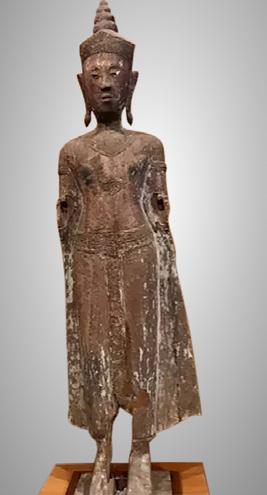
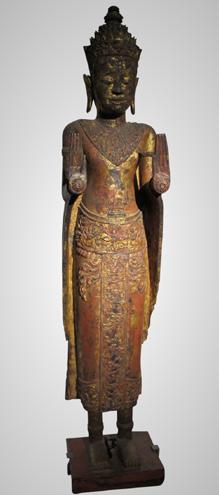
Carved wood figures of this size are exceedingly rare and the present example is possibly the largest in private hands. Compare a related smaller Thai carved wood figure of Buddha in the National Museum of Kamphaeng Phet. Compare a related smaller Cambodian giltlacquered wood figure of Buddha with motherof-pearl and glass inlays, 18th-19th century, 180 cm high, in the Musée Guimet, Paris, and illustrated by Pierre Baptiste and Thierry Zéphir, L’art Khmer dans les collections du musée Guimet, 2008, p. 449.
Estimate EUR 30,000
Starting price EUR 15,000

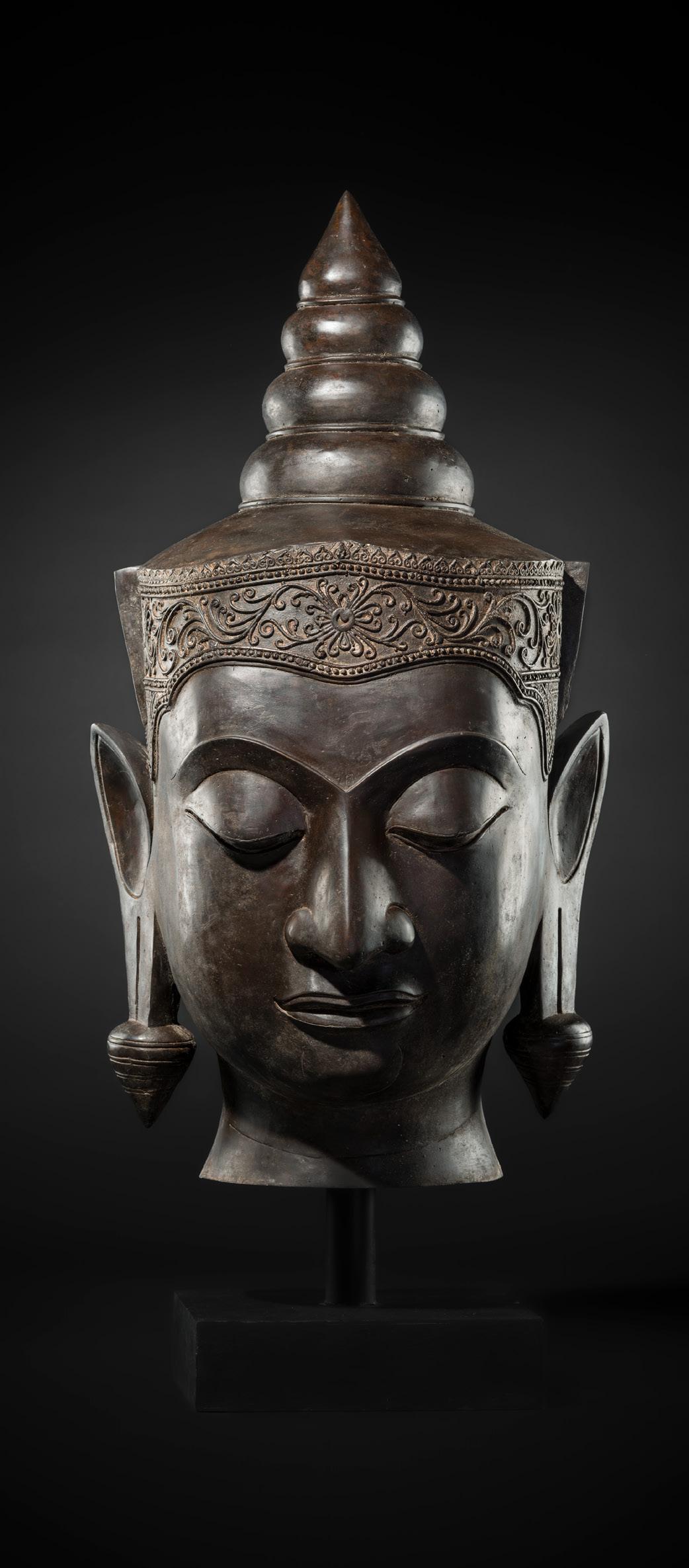
35
A MONUMENTAL (88 CM HIGH) BRONZE HEAD OF CROWNED BUDDHA, PHRA CHAO SONG KHRUANG (‘A LORD WEARING ORNAMENTS’), AYUTTHAYA PERIOD
Thailand, circa 17th-18th century or earlier (the Ayutthaya period spans from 1351 to 1767 CE). Finely cast with a serene expression marked by heavy-lidded downcast eyes below elegantly arched brows as well as a long aquiline nose and full lips forming a calm smile, flanked by elongated earlobes with pendeloque earrings. The Buddha wears a distinctive-style diadem closely associated with the later Ayutthaya period, combined with a conical ushnisha that has assumed the form of a tier of honorific umbrellas, each of diminishing size, replicating those seen at the summit of Thai stupas.
Provenance: The Kienzle Family Collection, Stuttgart, Germany. Acquired between 1950 and 1985 by siblings Else (1912-2006), Reinhold (19172008), and Dr. Horst Kienzle (1924-2019), during their extensive travels in Asia. Subsequently inherited by Dr. Horst Kienzle and bequeathed to the Museum für Asiatische Kunst, Radevormwald, Germany. Released through museum deaccession in 2024.
Condition: Very good condition with wear and casting irregularities. Small losses, few dents, scattered nicks and scratches, encrustations, and surface abrasion, overall presenting splendidly. Fine, naturally grown patina.
Weight: 32.9 kg (excl. stand)
Dimensions: Height 88 cm (excl. stand)
With an associated stand. (2)
Expert’s note: It is difficult to conceive just how massive the entire sculpture to which this monumental head originally belonged would have been. Few works of comparable size have survived, and this magnificent head is the largest of its kind in private hands. As can be seen in the present example, Thai artisans were highly skilled at bronze casting and capable of producing monumental figures in seated, standing, and even walking postures. The style of the present Buddha is most associated with standing figures, however, and the complete sculpture probably stood at around four meters tall
AUCTION RESULT
COMPARISON
Type: Related
Auction: Christie’s New York, 22 March 2023, lot 366
Price: USD 25,200 or approx. EUR 23,500 converted and adjusted for inflation at the time of writing
Description: A bronze head of Buddha, Thailand, Ayutthaya, 15th-16th century

Expert remark: Compare the closely related modeling and similar facial expression, crown, and tiered chignon. Note the much smaller size (25.4 cm) and earlier dating.
Estimate EUR 6,000
Starting price EUR 3,000
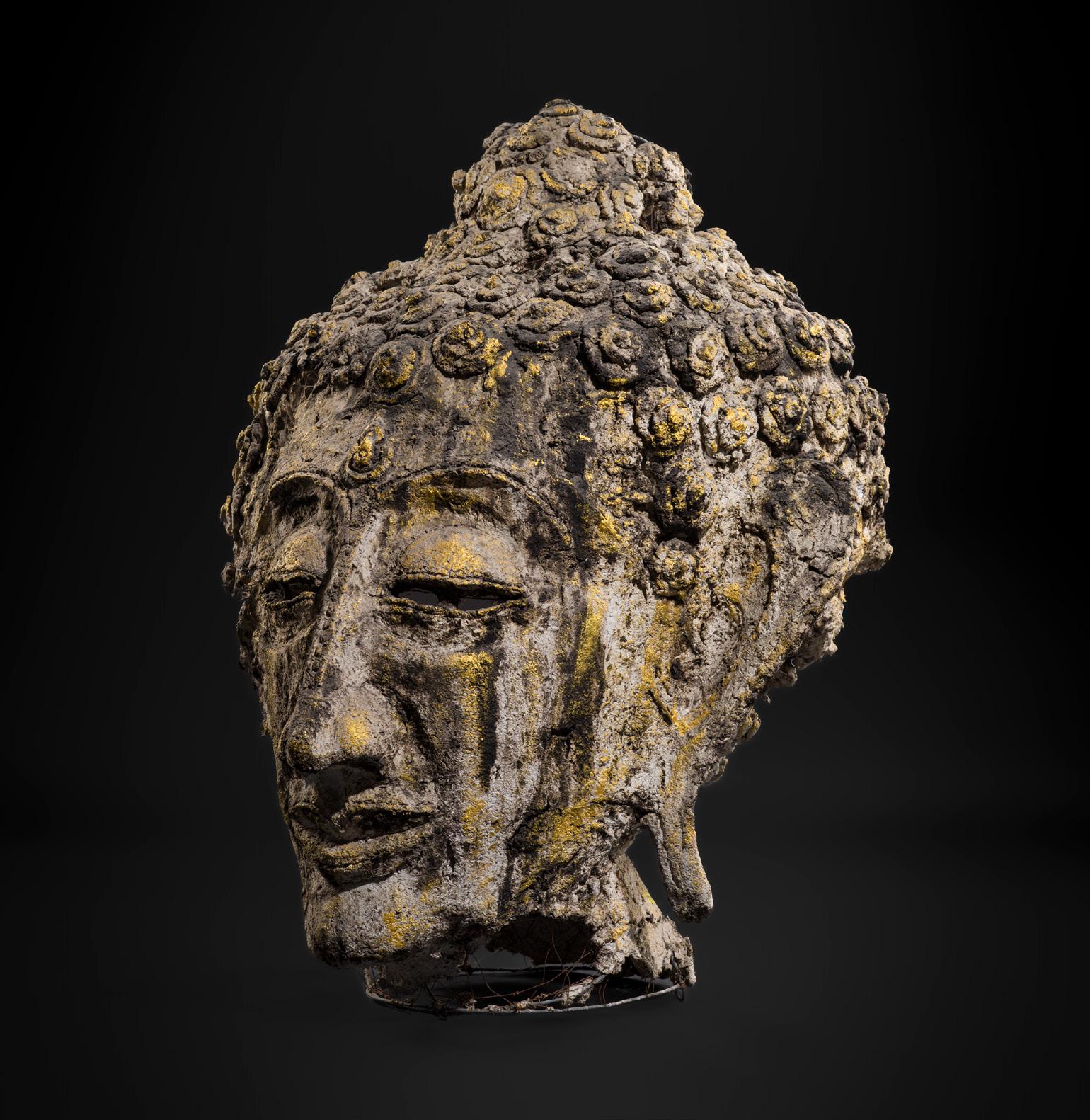
Southeast Asia, probably northern Thailand or Laos. The oval face modeled with a meditative expression marked by downcast eyes below gently arched brows and centered by a tear-shaped urna, thin nose, and bow-shaped lips, flanked by elongated earlobes, the hair in rows of tight snail-shell curls, and surmounted by an ushnisha. The gaunt face no doubt enhanced by the exposure to the natural elements. The gray papier mâché supported on a wire armature and covered in gilt and black splashes.
Provenance: The Kienzle Family Collection, Stuttgart, Germany. Acquired between 1950 and 1985 by siblings Else (1912-2006), Reinhold (1917-2008), and Dr. Horst Kienzle (1924-2019), during their extensive travels in Asia. Subsequently inherited by Dr. Horst Kienzle and bequeathed to the Museum für Asiatische Kunst, Radevormwald, Germany. Released through museum deaccession in 2024.
Condition: Extensive wear, traces of use, manufacturing irregularities, signs of weathering, flaking, losses, warping.
Weight: 6.3 kg
Dimensions: Height 82 cm
This Buddha head was most likely made for a Buddhist procession or festival in Southeast Asia. One of the most popular festivals is Vesak Day, an annual Buddhist celebration held in many South and Southeast Asian countries to commemorate the birth, enlightenment, and passing of Gautama Buddha. Another important festival is Khao Phansa (Buddhist Lent), which is celebrated in Thailand and marks the beginning of the annual, three-month rains retreat for monastics. It originated in India as a period in which the ancient monastic order ceased their itinerant activities during the monsoon season. The Pi Mai Lao festival (Lao New Year Festival) is one of the most important events on the Buddhist calendar in Laos, based on Khmer and Mon Burmese traditions. All these festivities are celebrated with colorful processions of Buddhist sculptures.
Estimate EUR 1,000 Starting price EUR 500
37
Thailand, Rattanakosin period, circa 19th to mid-20th century or a bit earlier. Superbly cast, the oval face with a serene expression, the heavylidded downcast eyes below arched brows converging on a narrow nose bridge. His bow-shaped lips forming a crescent smile, flanked by elongated concave ears, the hair tightly arranged in small snail-shell curls over the high ushnisha topped by a tall, separately cast flame finial.
Provenance: The Kienzle Family Collection, Stuttgart, Germany. Acquired between 1950 and 1985 by siblings Else (1912-2006), Reinhold (1917-2008), and Dr. Horst Kienzle (1924-2019), during their extensive travels in Asia. Subsequently inherited by Dr. Horst Kienzle and bequeathed to the Museum für Asiatische Kunst, Radevormwald, Germany. Released through museum deaccession in 2024.
Condition: Very good condition with minor wear and manufacturing irregularities including casting fissures. Few nicks, light surface scratches, remnants of pigments. A fine, naturally-grown, dark patina and areas of malachite encrustations.
Weight: 33.6 kg (incl. stand)
Dimensions: Height 106 cm (excl. stand), 126 cm (incl. stand)
Mounted on an associated metal stand. (2)
Thailand’s Ayutthaya kingdom was one of the most powerful forces in mainland Southeast Asia between the 14th and 18th centuries. Continuing the artistic trajectory set forth under the Sukhothai, the Theravada polity sponsored the production of Buddha images fashioned in a new distinct style. The faces display a curvilinear contour with the hairline lower, towards the sinuous browline, accentuated by elongated ears flared at upper and lower tips. The eyes, extending evenly across the width of the face, are three-quarters closed to endow the figure with a sense of serenity that is at once inwardly directed and also engaged with the world.
AUCTION RESULT
Type: Closely related
Auction: Christie’s Amsterdam, 24 May 2006, lot 703
Price: EUR 15,600 or approx. EUR 24,500 adjusted for inflation at the time of writing
Description: A Thai, Ayutthaya style, bronze head of Buddha Sakyamuni, 18th century
Expert remark: Compare the closely related modeling and manner of casting with similar features and expression. Note the much smaller size (67 cm).
Estimate EUR 6,000
Starting price EUR 3,000



(LOTS 38-39)
Bronzes of such breathtaking size are extremely rare. Dating largescale bronze sculptures of this magnitude is inherently challenging due to the scarcity of securely dated comparanda. Very few monumental bronzes from Asia have survived intact; many were melted down, fragmented, or remain undocumented in temple or private collections. As a result, precise attribution is often impossible without inscriptions or archaeological provenance.
That said, the tradition of casting monumental bronzes in Asia began as early as the 8th century, particularly within Buddhist and Hindu religious contexts. These sculptures, typically made for temples or ceremonial use, reflect extraordinary technical sophistication and spiritual intent. Lots 38 and 39 can be easily distinguished from later or modern reproductions by their exceptional casting quality, the clearly natural and consistent patina, and above all, their profound dedication to simplicity. Stylistically, they show a relative consistency that aligns with early traditions rather than eclectic
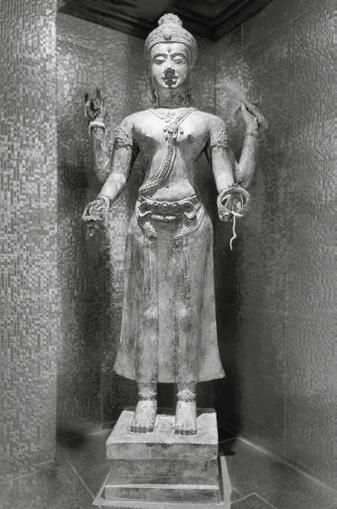
later revivals. Most tellingly, the surface reveals none of the ornamental clutter often seen in 20th-century religious statuary. In comparison, one may consider a related group of large bronze figures with similarly aged patinas—such as a Fig 1: Srivijaya-style Avalokiteshvara currently housed at Wat Thai Samakkhi, a Thai temple constructed in 1939 in Mae Kasa. These examples, while impressive in scale, lack the serene restraint and sculptural clarity of the present lots.
From a technical standpoint, the Avalokiteshvara (lot 38) is most likely of a slightly earlier date than the standing Buddha (lot 39). Its greater weight, minimal iron content (and hence almost no corrosion from rust), and heightened attention to finishing—particularly in the careful treatment of luting lines and other casting seams—support this assessment.
Ancient monumental bronze sculptures from Asia that compare in size and spiritual authority are extremely rare but do exist, including:
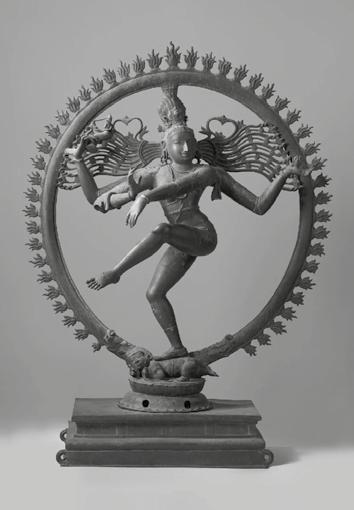
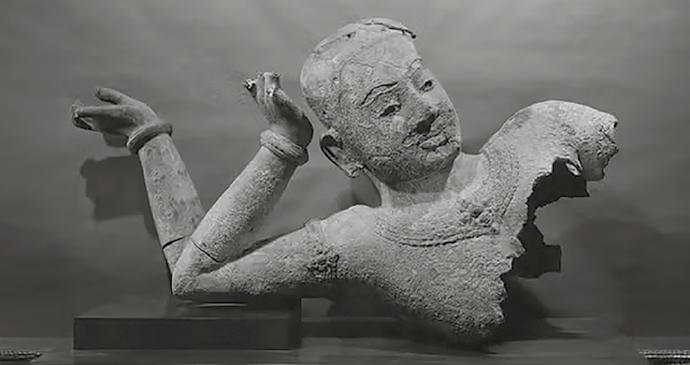
–
–
–
3: Vishnu (fragment)
– Khmer Empire, Cambodia, 11th–12th century
– National Museum of Cambodia, Phnom Penh
– The original size of this statue would have been between 5 and 6 meters.


Fig. 4: Standing Buddhas, Bagan
– Pagan Kingdom, Burma (Myanmar), 11th–12th century
– At the cardinal points of the Swezigon Paya are four shrines, each of which houses a 4m-high bronze standing Buddha. Cast in 1102 AD, these figures are Bagan's largest surviving bronze Buddhas
Given this context, the present works stand among a very small number of bronzes that combine monumental scale, historical depth, and sculptural purity—characteristics that set it apart from modern and contemporary interpretations.

BRONZE STATUE OF AVALOKITESHVARA, SRIVIJAYA KINGDOM STYLE, CIRCA 18TH-19TH CENTURY OR EARLIER
38
Southeast Asia, probably northern Thailand or Cambodia. Massively cast standing in samabhanga atop a double lotus pedestal raised on a circular plinth. The bodhisattva of compassion is dressed in a long flowing dhoti with subtly modeled folds at the hem and neatly incised belts and sashes, his graceful body richly adorned with elaborate beaded and foliate jewelry.
His face with a serene expression marked by heavy-lidded eyes with recessed and incised pupils, and slender lips forming a calm smile, flanked by elongated earlobes. The hair elegantly falling in long tresses over the shoulders and pulled up into a high chignon centered by an image of Buddha Amitabha, behind the ornate tiara.
Provenance: The Kienzle Family Collection, Stuttgart, Germany. Acquired between 1950 and 1985 by siblings Else (1912-2006), Reinhold (1917-2008), and Dr. Horst Kienzle (1924-2019), during their extensive travels in Asia. Subsequently inherited by Dr. Horst Kienzle and bequeathed to the Museum für Asiatische Kunst, Radevormwald, Germany. Released through museum deaccession in 2024.
Condition: Very good condition with expected wear, casting irregularities, multiple luting lines, traces of weathering, soil encrustations, few fatigue cracks, the bronze overall with naturally grown verdigris and patches of turquoise-colored encrustation. German Export License: Ausfuhrgenehmigung Nr. 132/2024, dated 25 June 2025, has been granted. A copy accompanies this lot.
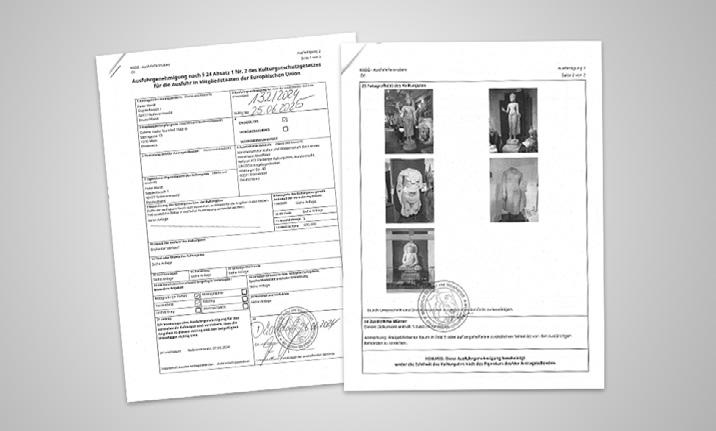
Weight: approx. 500 kg
Dimensions: Height approx. 345 cm
LITERATURE COMPARISON
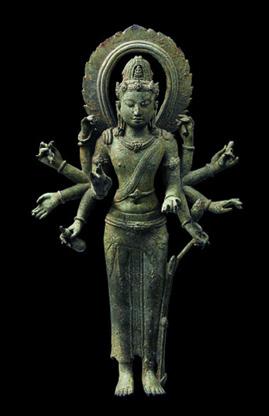
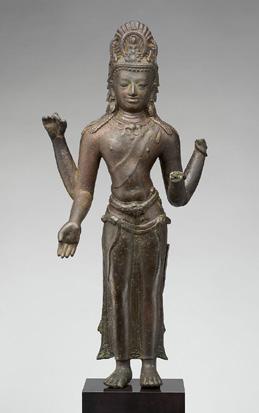
The present statue is cast in the style of the Srivijaya Kingdom, spanning from Indonesia over Malaysia to Southern Thailand in the late first millennium. See a Srivijaya copper alloy figure of Avalokiteshvara, 34 cm high, in the Musée Guimet, accession number MG3816 and exhibited by the Metropolitan Museum of Art, Lost Kingdoms: Hindu-Buddhist Sculpture of Early Southeast Asia, 5th to 8th Century, New York, 14 April-27 July 2014, cat. no. 161, as well as a four-armed bronze Avalokiteshvara in the Metropolitan, object number 1982.64, included in the same exhibition, cat. no. 158.
Estimate EUR 120,000
Starting

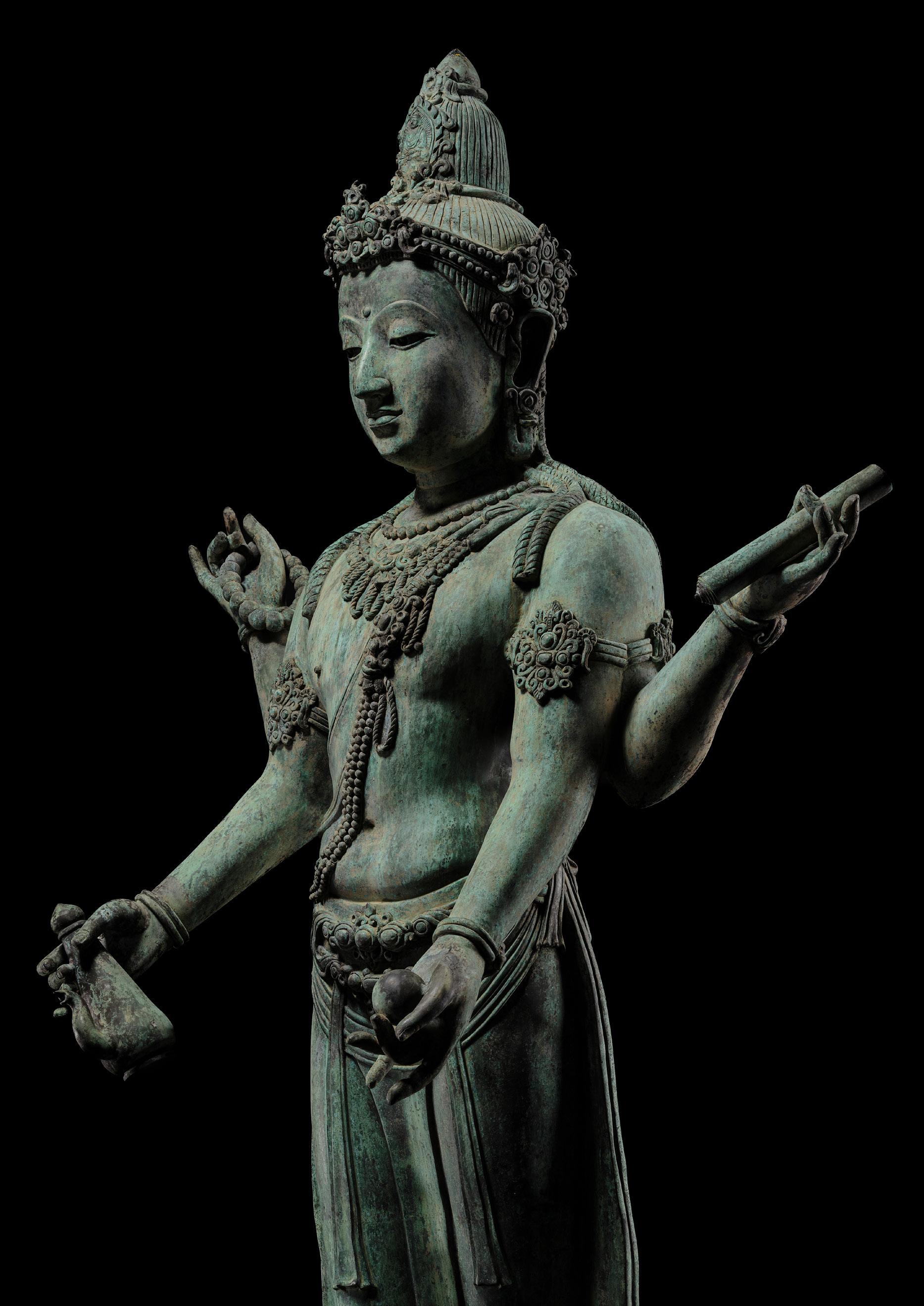
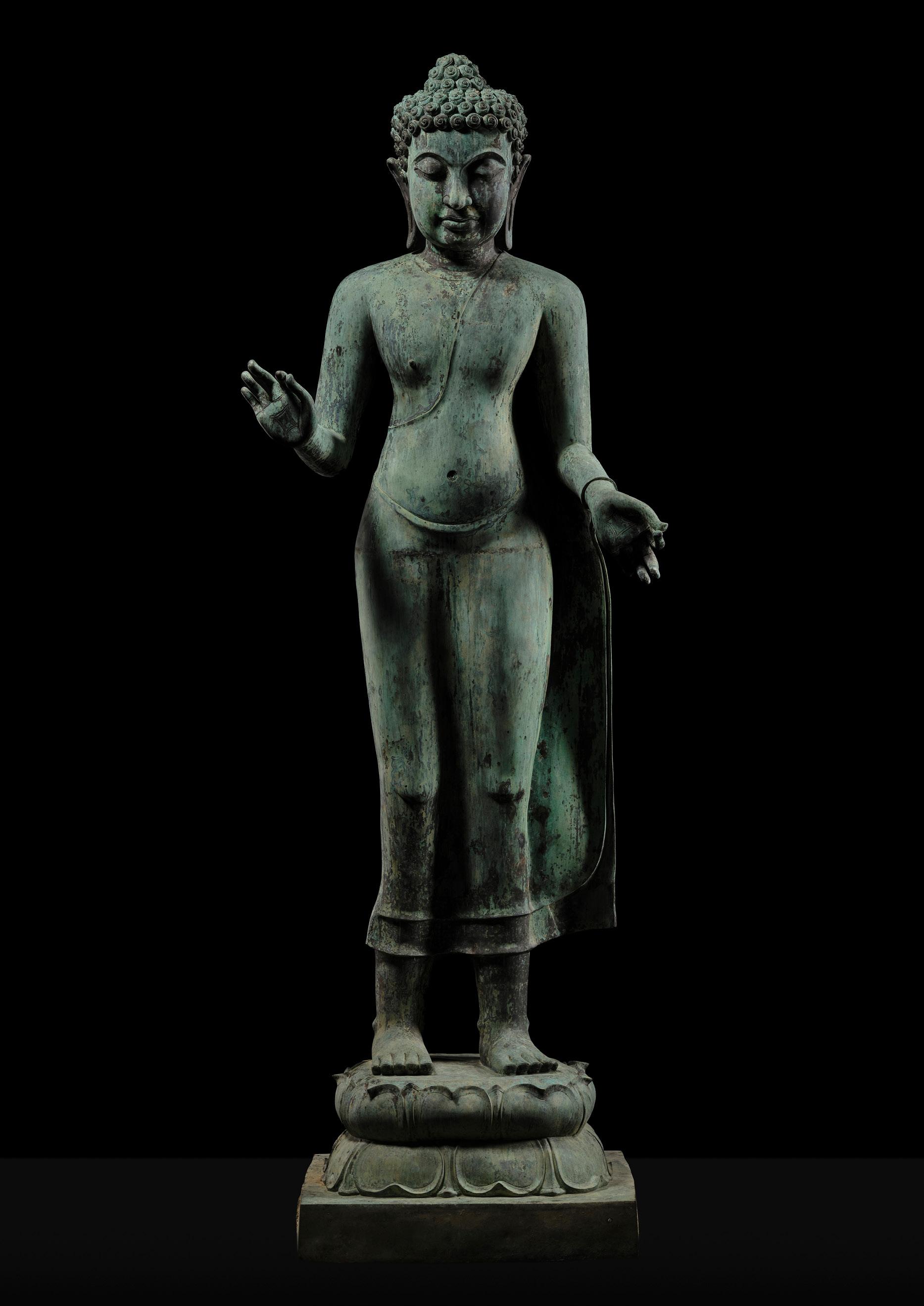
39
A COLOSSAL (3.5 METERS HIGH) BRONZE STATUE OF BUDDHA, MON DVARAVATI STYLE, 19TH TO FIRST HALF OF THE 20TH CENTURY OR EARLIER
Southeast Asia, probably northern Thailand or Cambodia. Massively cast standing in samabhanga with the right hand raised in abhaya mudra, the left lowered in varada mudra, dressed in a loosefitting diaphanous uttarasanga draped elegantly over his left shoulder and flaring downward in a gently undulating hemline above the dhoti. The face with a serene, meditative expression marked by heavy-lidded eyes, arched brows, aquiline nose, and full lips forming a subtle smile, flanked by elongated lobes. The hair is neatly arranged in snail-shell curls, each meticulously modeled individually, over the domed ushnisha
Provenance: The Kienzle Family Collection, Stuttgart, Germany. Acquired between 1950 and 1985 by siblings Else (1912-2006), Reinhold (1917-2008), and Dr. Horst Kienzle (1924-2019), during their extensive travels in Asia. Subsequently inherited by Dr. Horst Kienzle and bequeathed to the Museum für Asiatische Kunst, Radevormwald, Germany. Released through museum deaccession in 2024.
Condition: Good condition with expected wear, casting irregularities, several clearly visible luting lines, traces of weathering, soil and cuprite encrustations, the undersides of the arms and other areas where rainwater has pooled with distinct areas of corrosion, the figure overall with spots of iron corrosion and few small associated losses, flaking, few fatigue cracks, the bronze overall with naturally grown verdigris and patches of turquoise-colored encrustation.
German Export License: Ausfuhrgenehmigung Nr. 132/2024, dated 25 June 2025, has been granted. A copy accompanies this lot.
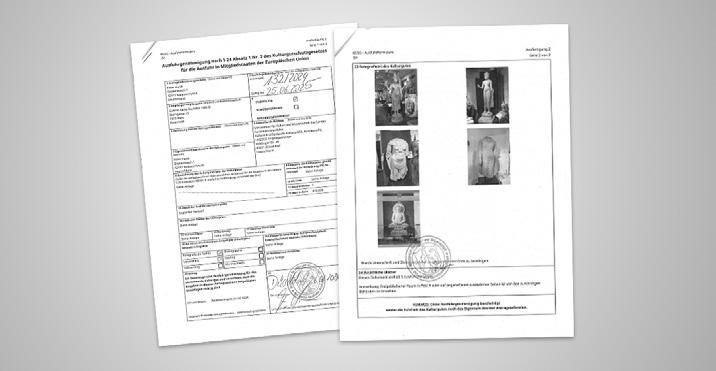
Weight: approx. 400 kg
Dimensions: Height approx. 350 cm
Monumental bronze sculpture in Southeast Asia during the 19th and 20th centuries reflects the dynamic interplay between tradition, modernity, and political power, particularly in Thailand and Cambodia. In 19th-century Thailand, under the reigns of Kings Rama III and Rama V, largescale bronzes emerged as both devotional icons and imperial statements, often situated in prominent urban and temple settings. Royal commissions, such as equestrian statues and massive Buddha images, fused classical Sukhothai and Ayutthaya aesthetics with Western casting techniques introduced through diplomatic and colonial contact.
LITERATURE COMPARISON
The present statue is cast in the Mon-Dvaravati style. The Mon polity of Dvaravati, based around the Chao Phraya and Mae Klang river basins of central Thailand, was one of the earliest and most important societies in mainland Southeast Asia. Their style was bold, self-assured, recognizable, and highly influential on subsequent Thai sculpture and artistic production throughout Southeast Asia. See a silver figure of Buddha, 39.4 cm high, in the Metropolitan Museum of Art, object number 1993.387.6, included in the exhibition Lost Kingdoms: Hindu-Buddhist Sculpture of Early Southeast Asia, 5th to 8th Century, New York, 14 April-27 July 2014, cat. no. 120.
AUCTION RESULT COMPARISON
Type: Related
Auction: Christie’s New York, 21 March 2015, lot 1069
Price: USD 68,750 or approx. EUR 80,000 converted and adjusted for inflation at the time of writing
Description: A bronze figure of Buddha, Khmer or Thai style
Expert remark: This bronze depicting the same subject but of much smaller size (73.5 cm) was previously in the collection of the famed New York dealer Robert H. Ellsworth, undated by Christie’s and offered without reserve.
Estimate EUR 80,000
Starting price EUR 40,000
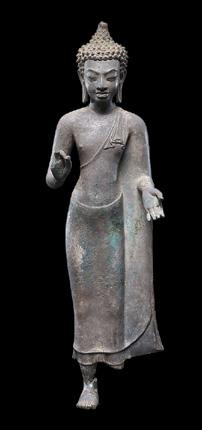
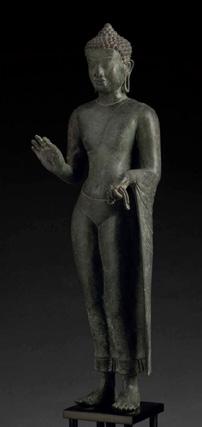
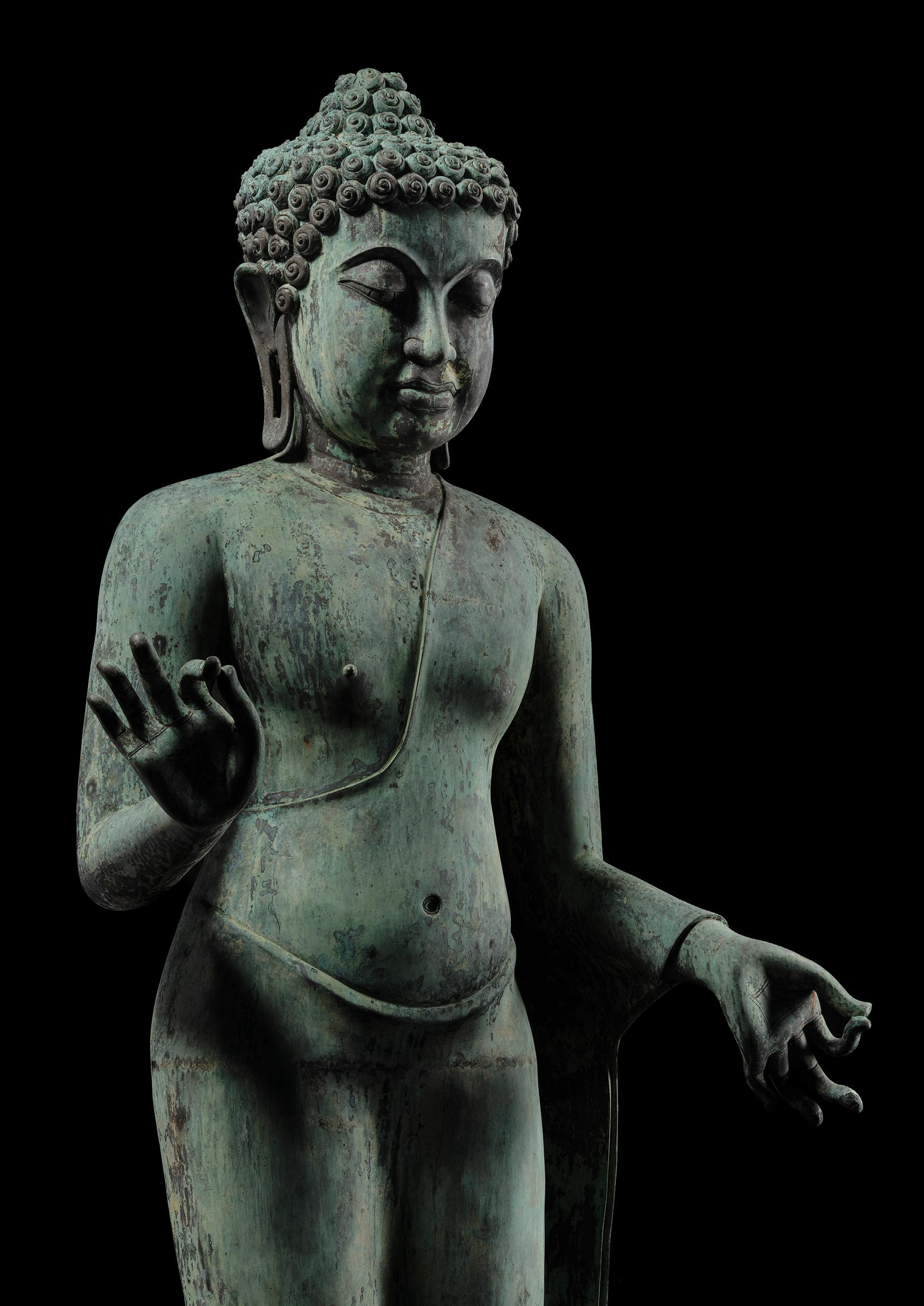
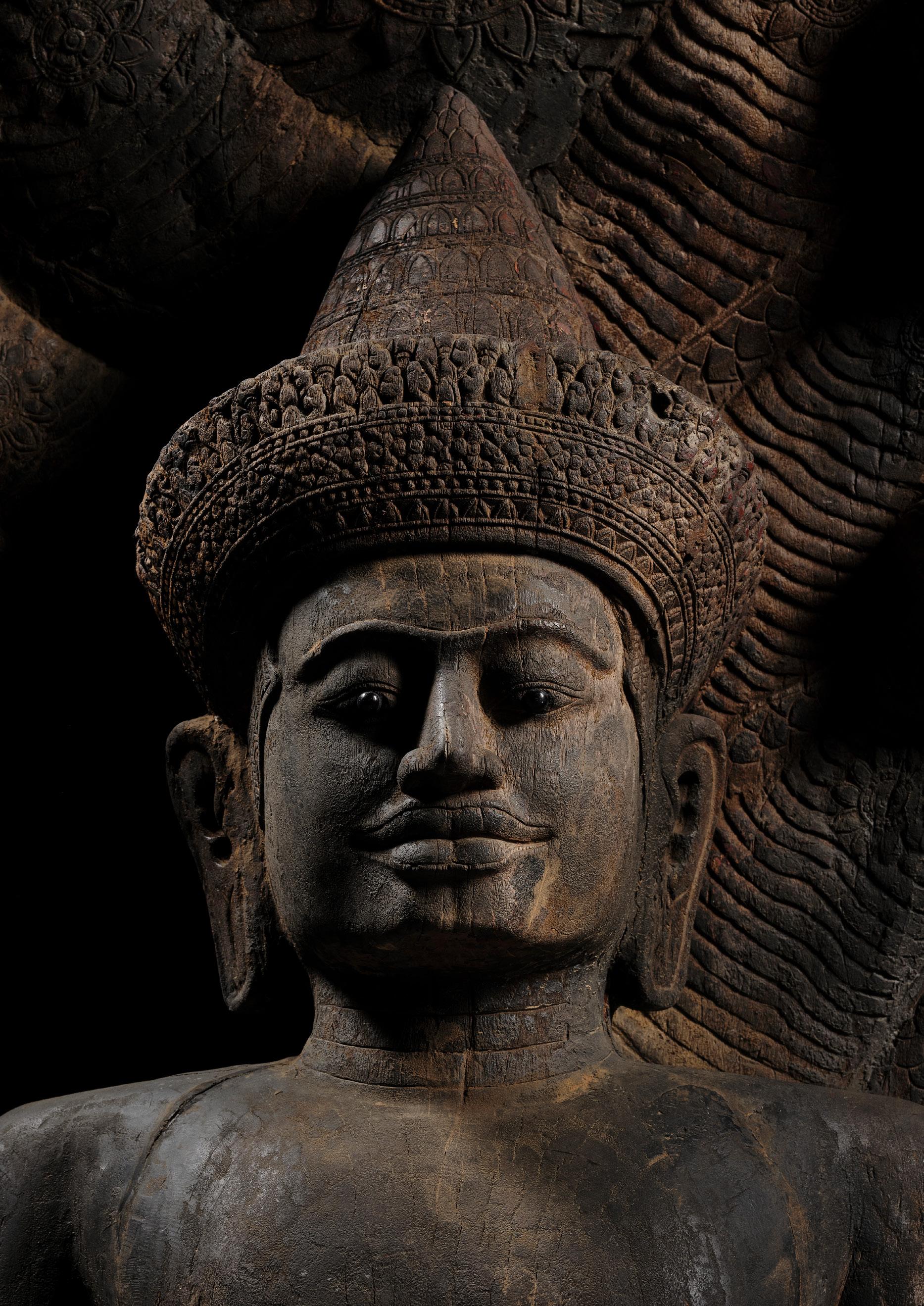
40
A MONUMENTAL (215 CM HIGH) AND IMPORTANT WOOD SCULPTURE OF BUDDHA MUCHALINDA, POST-ANGKORIAN PERIOD
Cambodia, circa 17th to 18th century or earlier. Powerfully carved, seated in ardha padmasana on the scaled coils of Muchalinda, his hands lowered in dhyanamudra. The face sensitively modeled in a serene expression with almond-shaped eyes finely inlaid with deep sapphire-blue glass pupils and full bow-shaped lips forming an enigmatic smile. The hair pulled up into a conical chignon decorated with petals and beading behind the wide, flaring tiara richly carved with similar designs as well as floral and foliate bands. Backed by the well-detailed seven-headed naga hood, the central serpent decorated with a sun wheel, the back similarly intricately carved with overlapping scales and an ornate lotus medallion.
Provenance: The Kienzle Family Collection, Stuttgart, Germany. Acquired between 1950 and 1985 by siblings Else (1912-2006), Reinhold (1917-2008), and Dr. Horst Kienzle (1924-2019), during their extensive travels in Asia. Subsequently inherited by Dr. Horst Kienzle and bequeathed to the Museum für Asiatische Kunst, Radevormwald, Germany. Released through museum deaccession in 2024.
Condition: In good condition, consistent with a monumental wood statue exposed to the elements over centuries. Displays expected signs of weathering, including flaking, age cracks, and splits with associated old fills. Minor losses are present, along with extensive remnants of pigment and lacquer. Small repairs are visible, unobtrusive wood sections may be later additions—typical for statues of comparable age and scale. The wood has developed a fine, naturally grown dark patina.
Weight: approx. 340 kg (incl. base)
Dimensions: Height 215 cm (excl. base)
With an associated base. (2)
EXPERT’S NOTE
The present sculpture, though of later date and larger size, closely resembles Angkor Watstyle examples in bronze and sandstone, such as those published in Helen Ibbitson Jessup and Thierry Zephir (ed.), Sculpture of Angkor and Ancient Cambodia: Millennium of Glory, 1997, pp. 268-270 and 272, nos. 73, 74, and 76, or the figure sold at Zacke, 11 March 2022, lot 568. A statue of Buddha protected by the naga was the main cult image of the Bayon temple, and Jayavarman VII identified himself with it (ibid., p. 272). Embracing Buddhism with fever, he aligned himself with the image of the Buddha seated on a serpent, as the divine form under which he would be venerated. Compare a 12th-century sandstone figure of Buddha Muchalinda, originally from Puor near Siem Reap and now in the National Museum of Cambodia (fig. 1)
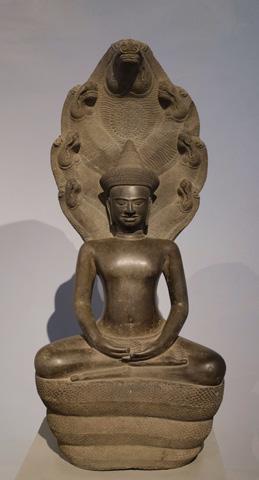
LITERATURE COMPARISON
Compare a related earlier post-Angkorian wood figure of Buddha on Naga, dated 14th-16th century, 92 cm high, in the Takeo Provincial Museum, inventory number MTK.215. Compare a related post-Angkorian monumental wood figure of a standing Buddha in the National Museum of Cambodia (fig. 2)
Estimate EUR 16,000
Starting price EUR 8,000

2

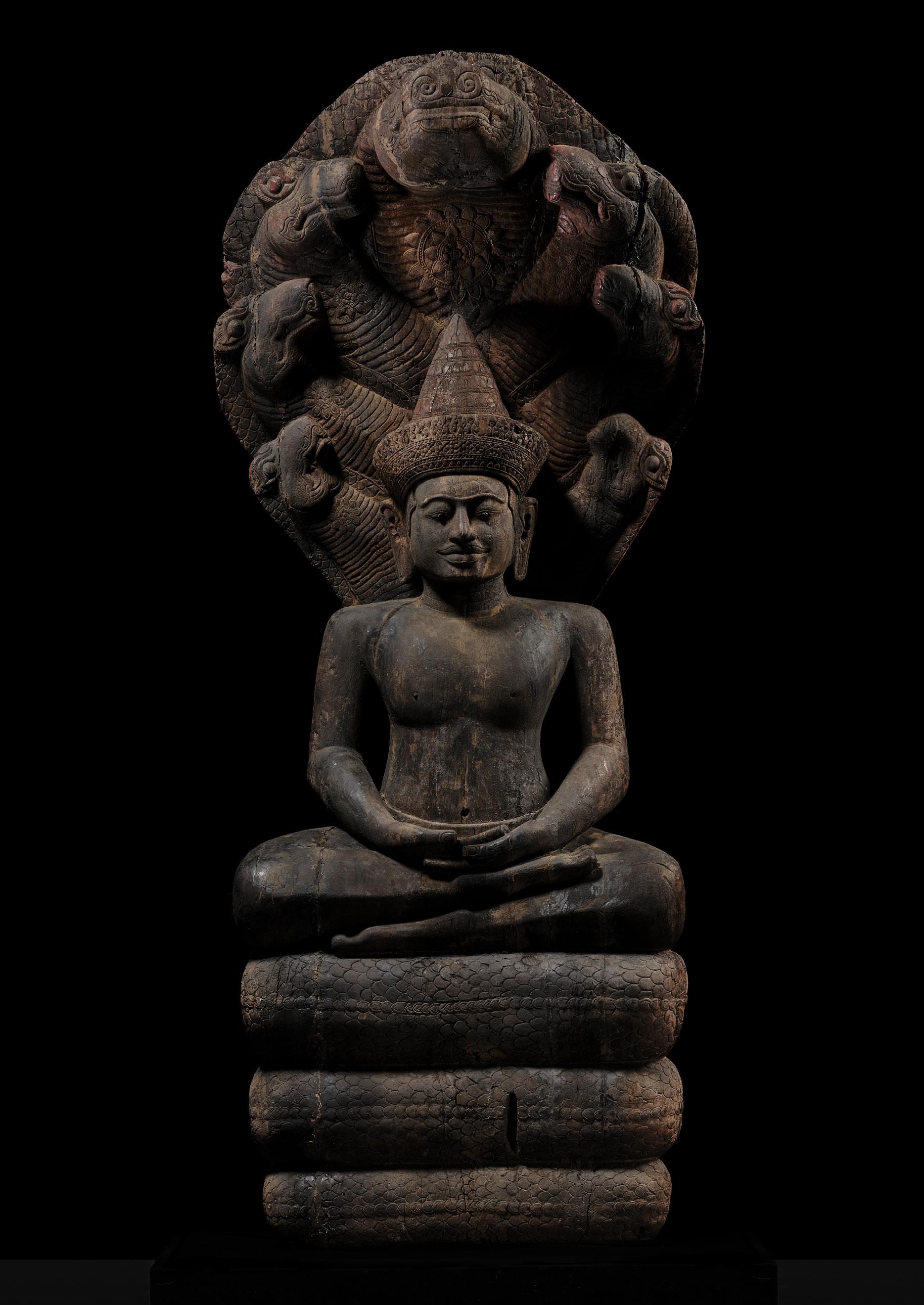

A RARE COPPER ALLOY FIGURE OF DATTATREYA, POST-ANGKOR PERIOD
Cambodia, 17th-18th century or earlier. Standing in samabhanga, embodying the unified form of the Trimurti, represented by the three heads of Brahma, Vishnu, and Shiva. The six arms hold attributes associated with each deity, including a conch, discus, mace, staff, scripture, and lotus. The deity is dressed in a long, richly incised dhoti with central fishtail fold, and his body is adorned with two necklaces.
The central head representing Vishnu bears the Vaishnavite tilaka. The right face is Shiva’s, with a tripundra on the forehead and an elegant mustache. The left face belongs to Brahma with an oval urna. Each face bears a serene expression with wide almond-shaped eyes, deeply incised brows, and full lips, the hair pulled up into a neatly arranged jatamukuta.
Provenance: Galerie Hardt (established in 1976), Radevormwald, Germany, before 2020. Acquired by the gallery’s founder Peter Hardt (b. 1946) during his extensive travels in Asia, the first of which occurred during a formative world tour in 1973.
Labels: Galerie Hardt, printed ‘Dattatreya – Trimurti Stil. Reg #S19045. Kambodscha. 17/18 Jahrhundert. Kupferhaltige Bronze’, and priced at EUR 12,750
Condition: Overall good condition with expected wear and manufacturing irregularities including casting patches. The legs with old repairs, possibly inherent to the manufacture. Minor losses mostly to the back, few small nicks, small dents, light surface scratches, remnants of gilt and pigment, encrustations. The back with a large aperture, and two additional compartments to the legs, the latter sealed. The bronze with a fine, naturally grown, smooth patina, with areas of malachite encrustation.
Weight: 9.5 kg (excl. stand)
Dimensions: Height 46.6 cm (excl. stand), 52 cm (incl. stand)
With an associated acrylic stand. (2)
This finely cast bronze represents Dattatreya, the composite Hindu deity who embodies the Trimurti—Brahma, Vishnu, and Shiva—in a single unified form. The iconographic core remains consistent with classical Indian representations: three heads symbolizing the three gods and six arms holding their respective attributes. The serene expression and composed stance evoke Dattatreya’s role as both divine embodiment and spiritual teacher, bridging the domains of asceticism and cosmic power. This representation first appeared in medieval Hindu art, particularly sculpture and temple reliefs from the 12th century in regions such as Kalinga and South India. However, depictions of this deity in Southeast Asian art are exceedingly rare, with no other examples found in public or private collections.
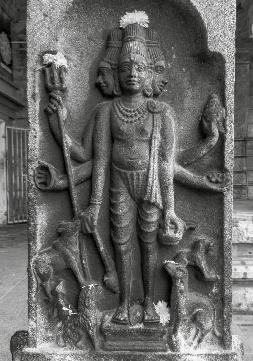
A stone relief depicting Dattatreya in the Jambukeswarar Temple, Tiruchirapalli district, Tamil Nadu
The present sculpture is stylistically attributable to post-Angkor Cambodia , likely dating from the late 17th or 18th century, when bronze casting continued under royal patronage at the court of Oudong , then the capital. Following the decline of Angkor as a political center, Hindu imagery persisted even as Theravada Buddhism rose to dominance. In this context, the sculpture can be understood not merely as a replication of Indian models but as a localized adaptation, combining Khmer formal aesthetics with Hindu metaphysical symbolism. Distinctive features such as the rounded facial contours, stylized topknot, and the sharp fishtail
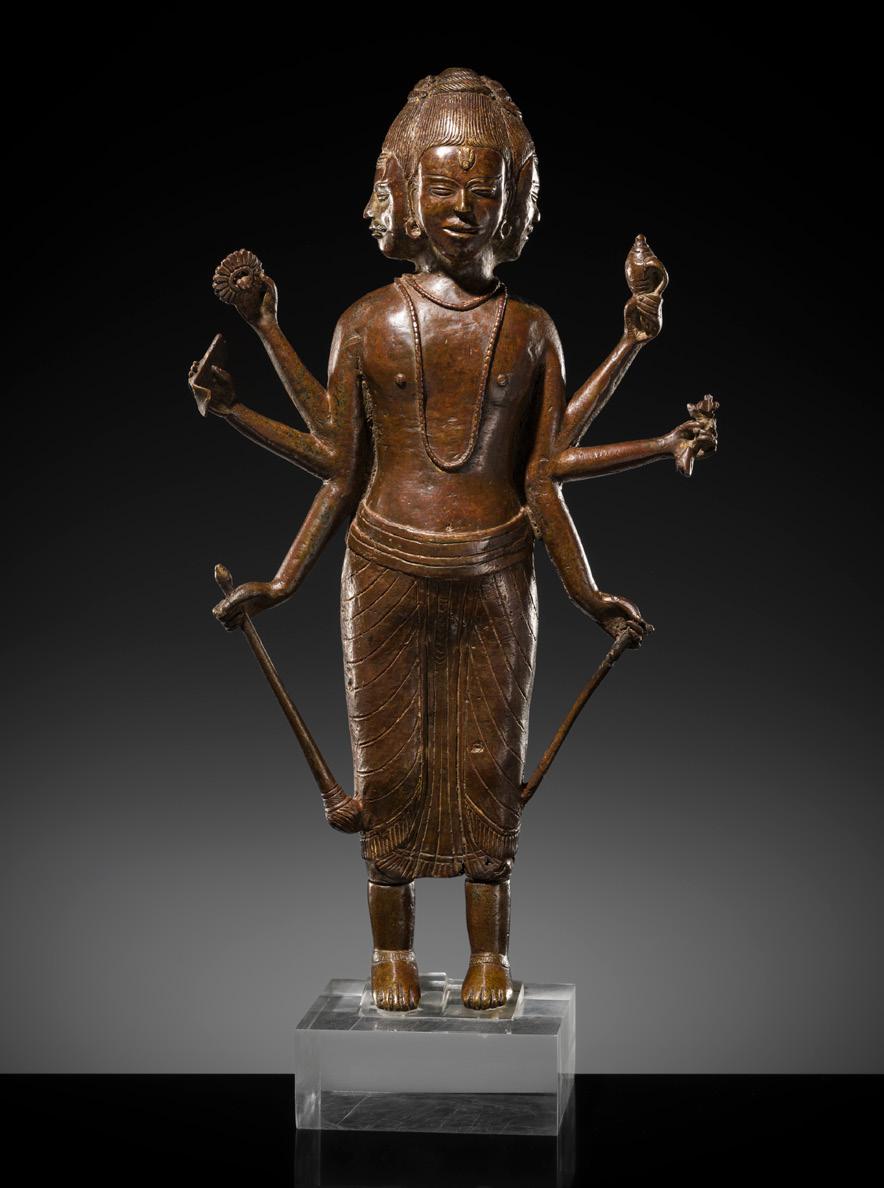
hem of the lower garment situate the work within the visual language of late Khmer bronze sculpture, distinguished by its polished surfaces, compositional symmetry, and restrained ornamentation.
This sculpture underscores the permeability of cultural and religious boundaries in early modern Cambodia, where Indic iconography continued to be transmitted, transformed, and recontextualized, and shows how post-Angkor artisans selectively engaged with classical Indian models, preserving their spiritual potency while adapting them to local sensibilities. As both a rare representation of Dattatreya in a Southeast Asian context and a finely executed devotional object, the work stands as a testament to the resilience and adaptability of Hindu imagery in Cambodia’s complex religious landscape.
LITERATURE COMPARISON
Compare a later Indian silver figure of Dattatreya, dated late 19th-early 20th century, 127.3 cm high, at Bonhams New York, 17 September 2014, lot 168.
AUCTION RESULT COMPARISON
Type: Related
Auction: Christie’s New York, 17 September 1998, lot 191
Price: USD 9,200 or approx. EUR 15,800 converted and adjusted for inflation at the time of writing
Description: A bronze group of a deity on a bird, Khmer, Post Angkor period, circa 15th century
Expert remark: Compare the related modeling and manner of casting with similar facial features. Note the different subject and the size (39.5 cm).
Estimate EUR 6,000
Starting price EUR 3,000
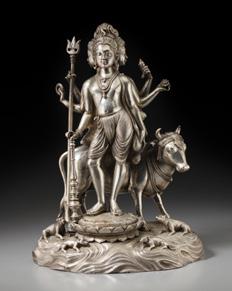

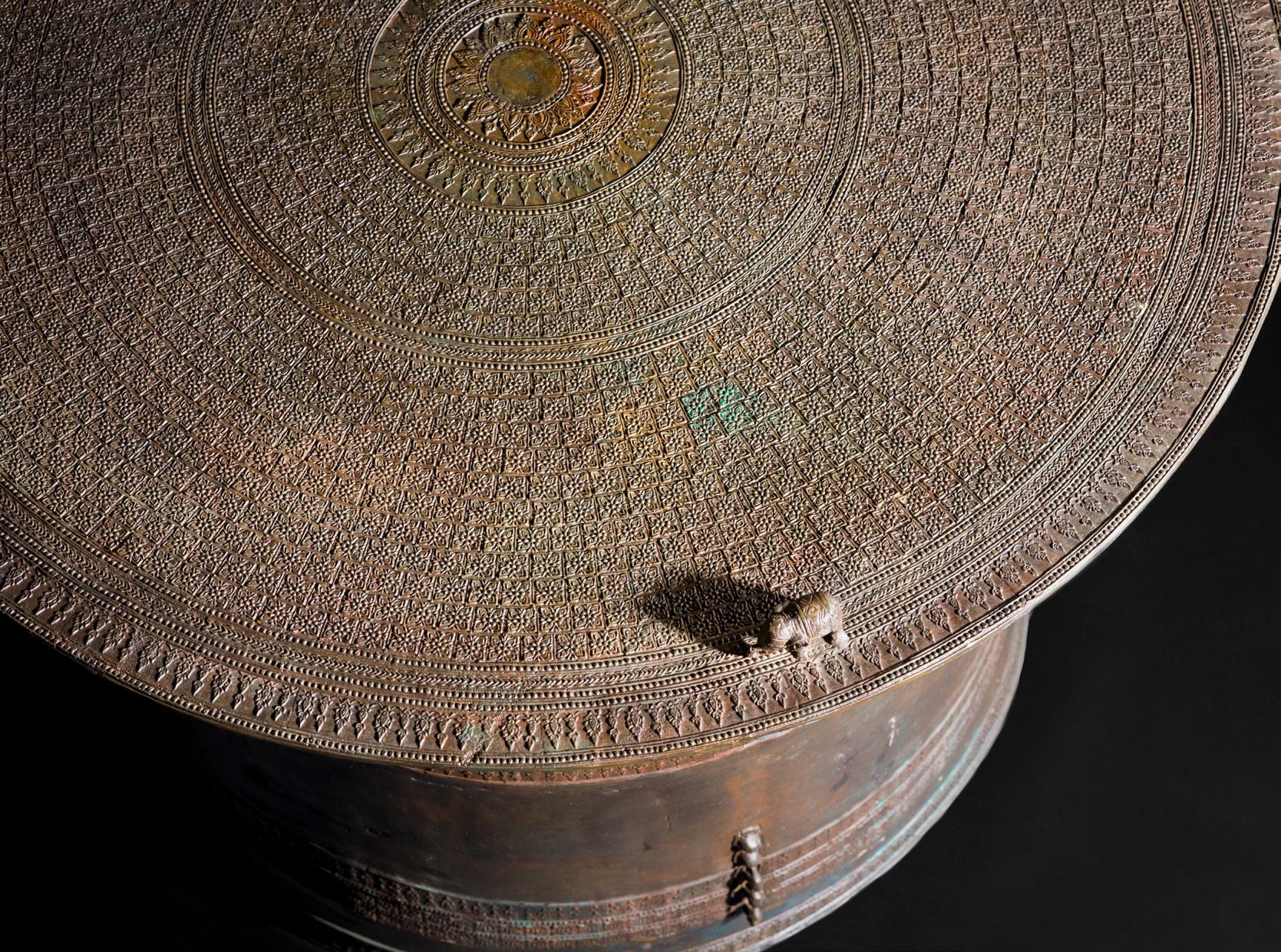
42
Expert’s note: This type of drum comes in various sizes with most ranging between 40 and 65 cm in diameter. The present lot is of exceptionally large size, possibly the largest of its kind, and must therefore be considered extremely rare.
Southeast Asia, first half of the 20th century or earlier. Finely cast, the flat top with concentric bands of stylized blossoms centered by a flower and petals, the rim lined by beaded and foliate bands and set with four elephants. The tapering body with further decorative bands and double strap handles above a procession of three elephants and two frogs descending towards the base.
Provenance: The Kienzle Family Collection, Stuttgart, Germany. Acquired between 1950 and 1985 by siblings Else (1912-2006), Reinhold (1917-2008), and Dr. Horst Kienzle (1924-2019), during their extensive travels in Asia. Subsequently inherited by Dr. Horst Kienzle and bequeathed to the Museum für Asiatische Kunst, Radevormwald, Germany. Released through museum deaccession in 2024.
Condition: Good condition with expected old wear, casting irregularities, old soldering marks, small repairs, dents, small bruises, losses and minor warping. The bronze with a fine, naturally grown patina with malachite encrustations.
Dimensions: Diameter 102 cm, Height 70.3 cm
This bronze rain drum is based on the drums created by the Dong Son culture in the Red River Delta of northern Vietnam. These drums were produced from about 600 BC or earlier until the third century AD and are one of the culture’s most astounding examples of metalworking. The discovery of Dong Son drums in New Guinea is seen as proof of trade connections – spanning at least the past thousand years – between this region and the technologically advanced societies of Java and China.
The importance of these drums to the Karen meant that the master craftsmen of the Shan people had to undergo certain purification rites before a drum could be cast at a time predetermined by astrological calculations. On the day before, they were required to undergo a cleansing ritual to invoke spiritual guidance during casting. After bathing, they made offerings of fruit and candles, then slept undisturbed that evening. When they arrived at the foundry the following morning, a circle was marked out in which the casting was to be performed. Within this area the wearing of footwear was prohibited. Swearing and the consumption of intoxicants were also forbidden until the work was completed. In addition to the various sub-groups of Karen, buyers from Laos, Thailand and other regions used to converge on Ngwedaung at the end of the rainy season in October-November to purchase drums to sell to various tribal groups such as the Tsa Khamu. During the late 19th century, non-Karen hill people, attracted to the area by the prospect of work with British teak loggers, bought large numbers of Karen drums and transported them to Thailand and Laos. Consequently, their owners frequently incorrectly identify their drums as being indigenous to these countries.
Type: Related
Auction: Christie’s New York, 21 March 2015, lot 1011
Price: USD 32,500 or approx. EUR 38,000 converted and adjusted for inflation at the time of writing
Description: A Southeast Asian bronze rain drum, 18th/19th century
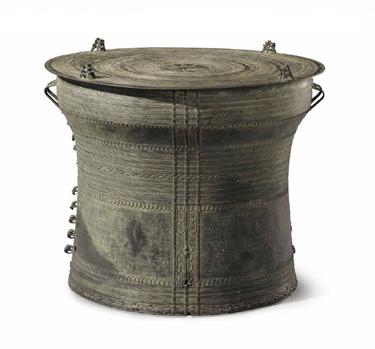
Expert remark: Compare the closely related form, manner of casting, and decoration. Note the the size (52.6 cm).
Estimate EUR 10,000
Starting price EUR 5,000
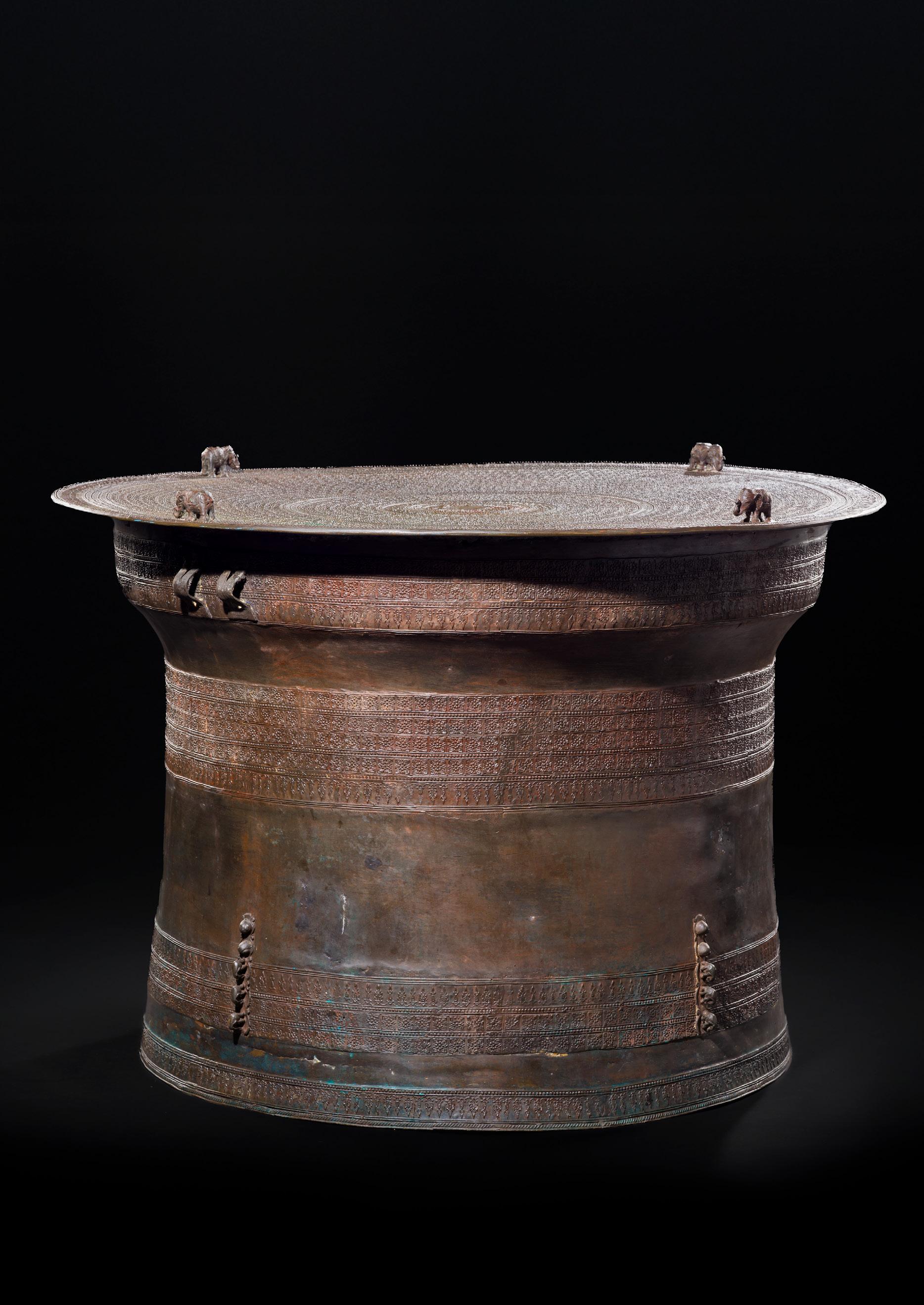
A LARGE BRONZE RAIN DRUM, KAREN PEOPLE, 18TH-19TH CENTURY
Southeast Asia. The drum shows a central twelve-ray star medallion on the flat top encircled by concentric bands of floral, fish, and geometric decoration and with four groups of frogs piled on top of one another applied to the edge. The flaring body with a pair of double-strap handles and neatly decorated with bands of geometric, foliate designs, and a procession of three elephants. The rims are lined with finely braided bands.
Provenance: Galerie Hardt (established in 1976), Radevormwald, Germany, before 2020. Acquired by the gallery’s founder Peter Hardt (b. 1946) during his extensive travels in Asia, the first of which occurred during a formative world tour in 1973.
Condition: Good condition with minor wear, traces of use, and casting irregularities. Small dents, nicks, scratches, malachite and cuprite encrustations, flaking to the malachite patina, and some warping.
Weight: 9.5 kg
Dimensions: Height 51.5 cm
The Karen used to store their treasures in frog drums and bury them secretly in the ground, believing that they could take their possessions with them after death. Until the sixteenth century it was the custom of the Shan, Karen, and other tribes of eastern Burma at the death of a chief to bury his possessions, including his wives, elephants, weapons and other valued objects. The Karen, like other drum users in Yunnan and Vietnam, were known to bury their drums with their owners.
LITERATURE COMPARISON
Compare a closely related bronze rain drum dated to the 19th century, 47 cm high, in the Victoria & Albert Museum, accession number IM.19-1915.

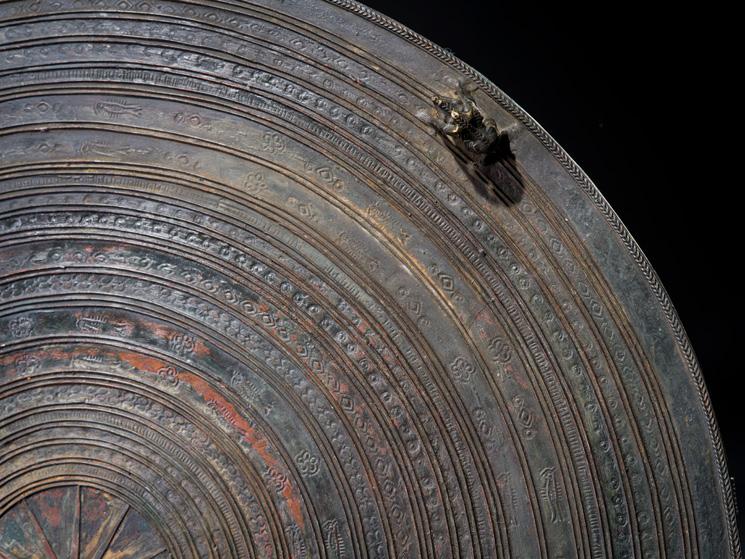
AUCTION RESULT COMPARISON
Type: Closely related
Auction: Christie’s New York, 16 September 2008, lot 584
Price: USD 5,250 or approx. EUR 6,700 converted and adjusted for inflation at the time of writing
Description: A bronze rain drum, Southeast Asia, 18th century
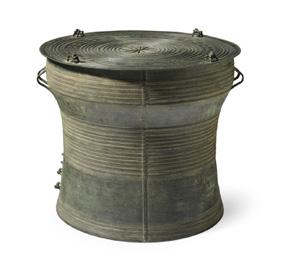
Expert remark: Compare the closely related form, manner of casting, and size (53.3 cm).
Estimate EUR 2,000
Starting price EUR 1,000
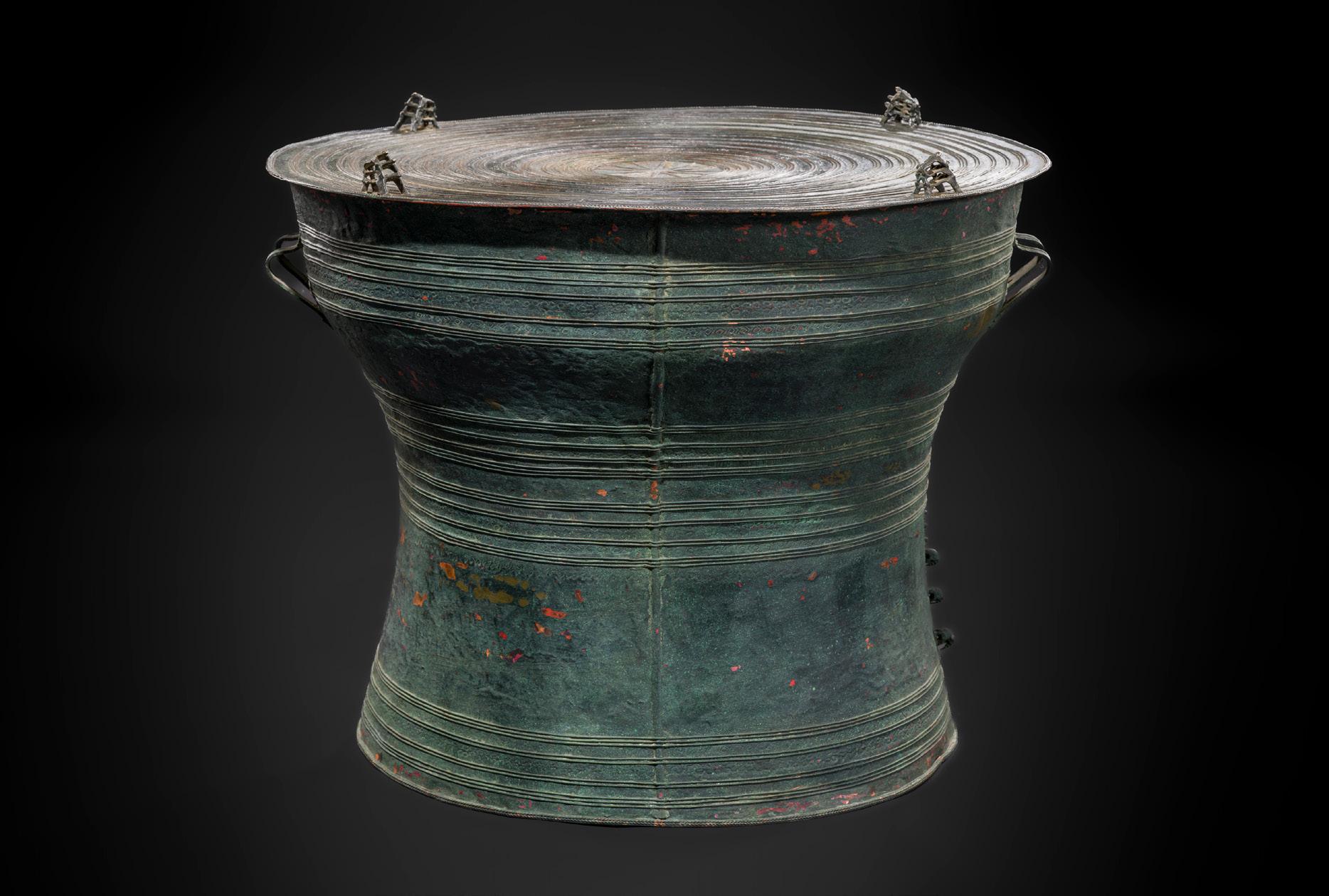
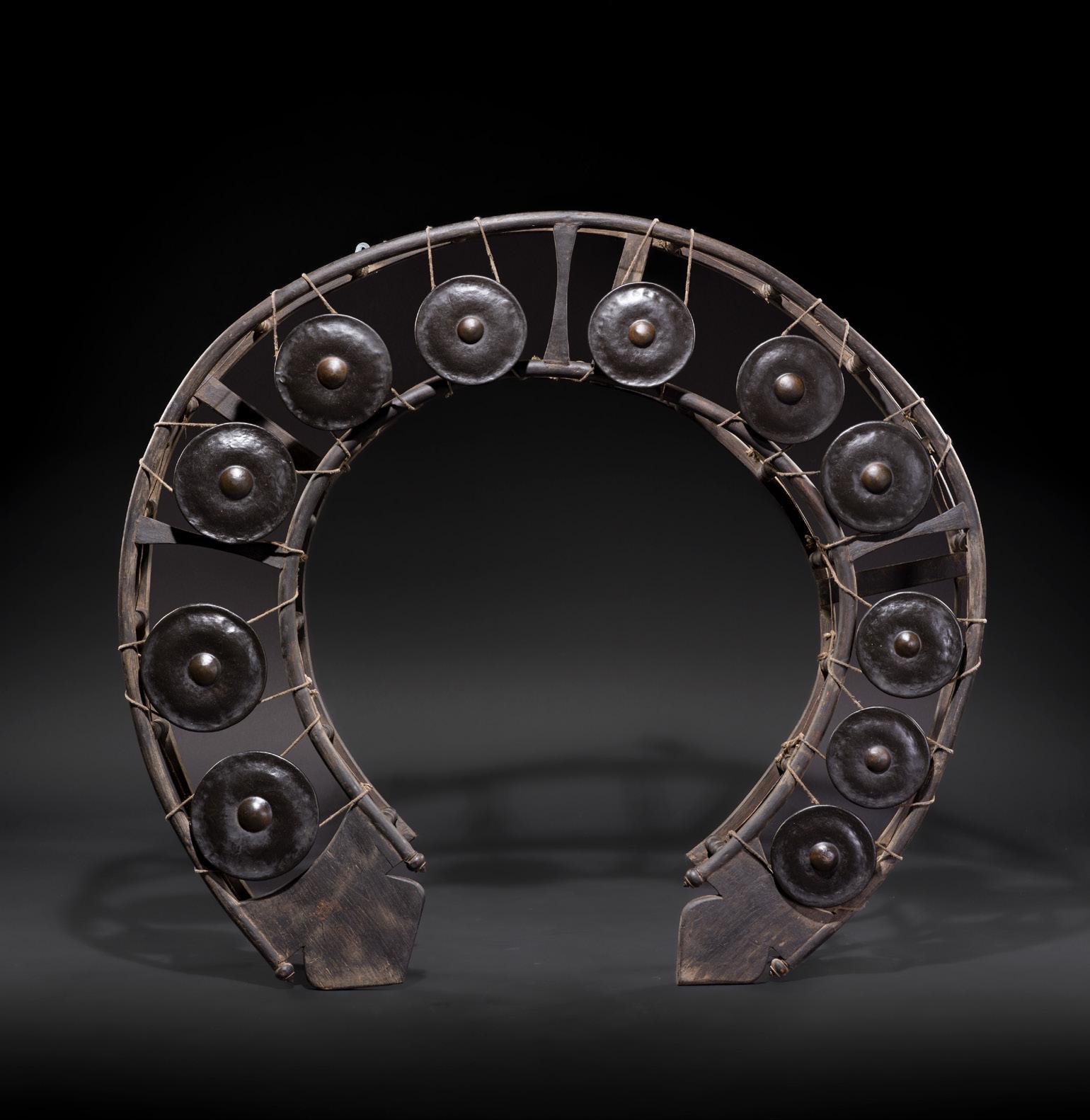
44
Thailand, 19th-20th century. The percussion instrument comprising eleven bossed gongs, each individually tuned to a specific pitch, arranged within a wood circular, double-braced frame. The gongs unevenly spaced and suspended by cords, enabling them to resonate freely when struck.
Provenance: Galerie Hardt (established in 1976), Radevormwald, Germany, before 2020. Acquired by the gallery’s founder Peter Hardt (b. 1946) during his extensive travels in Asia, the first of which occurred during a formative world tour in 1973. Condition: Good condition overall with expected wear, manufacturing irregularities, traces of use, the gongs with few nicks, light surface scratches, and small dents, the wood frame with minor age cracks.
Dimensions: Diameter 117.3 cm
With modern metal mounts for suspending the instrument at height.
The origin of the Khong Wong can be traced to the broader tradition of gong chime instruments prevalent across Southeast Asian cultures, including Myanmar, Laos, Thailand, Cambodia, and Indonesia. The use of gongs in Piphat musical ensembles has been documented in these regions for centuries, with historical evidence indicating their presence as early as the 13th century. In Thailand, ancient musicians adopted and refined
these musical instruments, which became an essential component of the kingdom’s classical music during the Ayutthaya period, a time when Thai classical music flourished and court ensembles attained remarkable levels of sophistication. Historically, the Khong Wong was played in courts and temples, symbolizing prestige and spiritual significance, during royal ceremonies, Buddhist rituals, and traditional theater performances known as Khon (masked dance-drama).
Khong Wong can be found with varying numbers of bossed gongs mounted within circular frames throughout the Southeast Asian regions, typically ranging from six up to eighteen graduated gongs. The number of gongs determines the instrument’s melodic range and shapes the structure and character of the musical pieces played on this instrument.
LITERATURE COMPARISON
Compare a related khong wong, dated 20th century, 125.7 cm diameter, in the Metropolitan Museum of Art, object number 1986.467.27a–c. Compare a related khong wong, dated 19th century, 123 cm long, in the Museo d’Arte Orientale di Venezia, inventory number, 16649/4341.
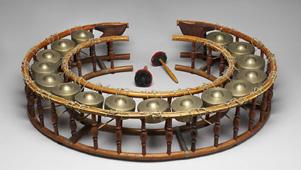
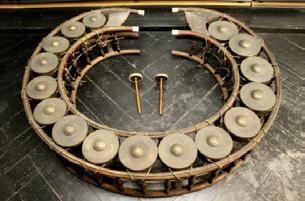
Estimate EUR 2,000
Starting price EUR 1,000
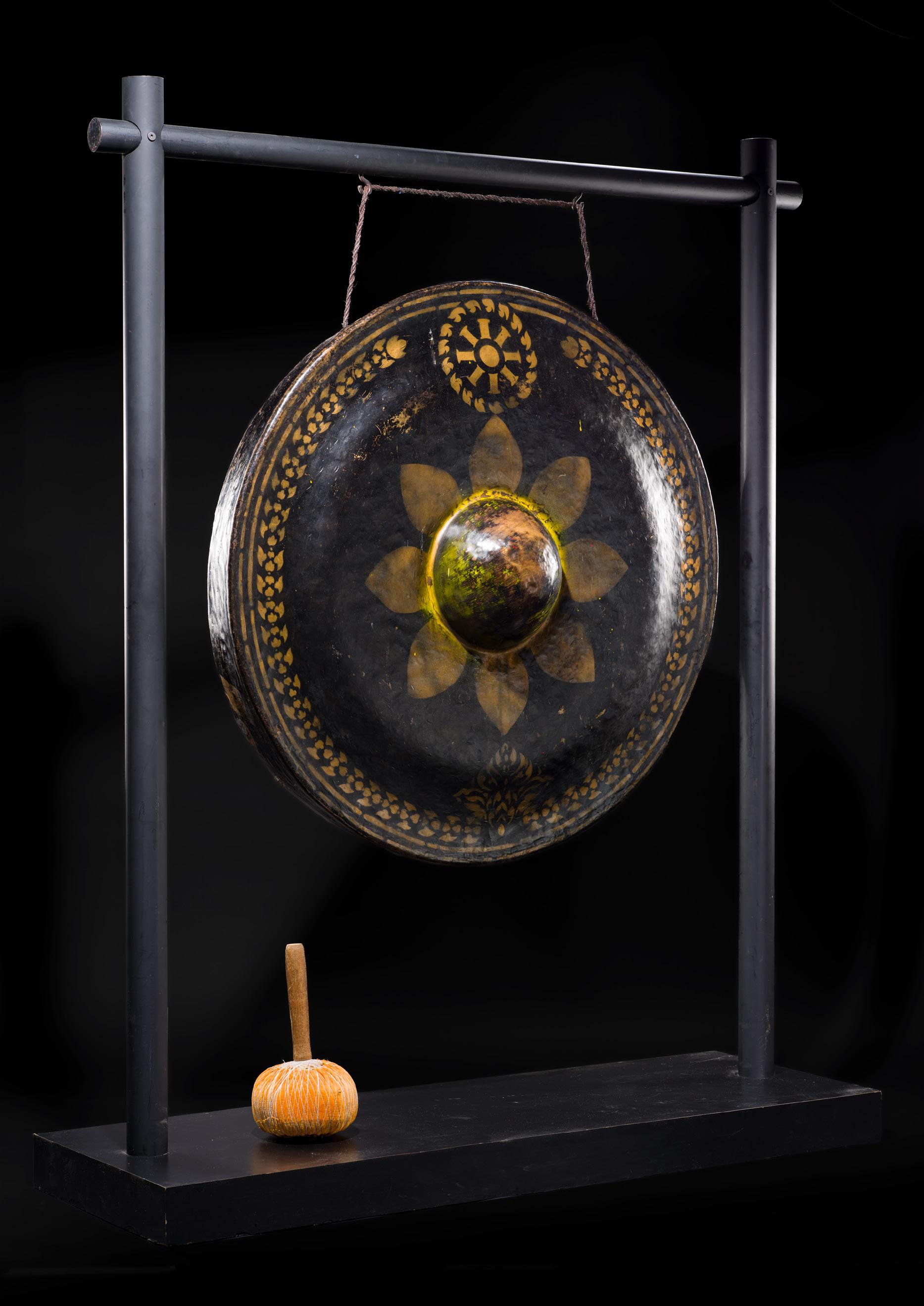
A COLOSSAL GILT-LACQUERED BRONZE GONG, 19TH-EARLY 20TH CENTURY
Expert’s note: The sound of this gong is as monumental as its appearance, carrying for a mile or more, indicating it was likely used in a large temple or palace compound. Antique gongs of this size are exceedingly rare with very few comparable examples found in public or private collections. Thus, this gong stands out as a unique and exceptional artifact.
Thailand or Burma. Heavily cast, of circular form with a large central boss encircled by a band of petals to evoke a flowerhead, enclosed within a band of stylized foliage centered at the top by an eight-armed cross, all framed by two line-borders. The upper edge pierced twice to allow for suspension.
Provenance: The Kienzle Family Collection, Stuttgart, Germany. Acquired between 1950 and 1985 by siblings Else (1912-2006), Reinhold (1917-2008), and Dr. Horst Kienzle (1924-2019), during their extensive travels in Asia. Subsequently inherited by Dr. Horst Kienzle and bequeathed to the Museum für Asiatische Kunst, Radevormwald, Germany. Released through museum deaccession in 2024.
Condition: Good condition with ancient wear, casting irregularities, and traces of use, scattered nicks, small surface scratches, expected dents, remnants of pigment, rubbing and touchups to lacquer.
Dimensions: Diameter 109.5 cm, Height 204.2 (incl. stand)
With a striker with a rounded head wrapped in orange cloth, and suspended from a modern metal stand. (3)
LITERATURE COMPARISON
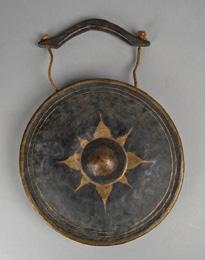
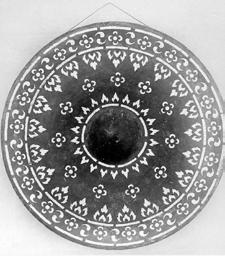
Compare a closely related smaller Burmese brass gong of similar form and decoration, dated to the early 20th century, 24.5 cm diameter, in the British Museum, registration number As1948,07.89. Compare a closely related Burmese or Thai smaller brass gong of similar form and decoration, dated to the 19th century, 41.4 cm diameter, in the Metropolitan Museum of Art, object number 09.69.1.
AUCTION RESULT COMPARISON
Type: Closely related
Auction: Christie’s New York, 5 June 2004, lot 994
Price: USD 7,767 or approx. EUR 11,500 converted and adjusted for inflation at the time of writing
Description: A Thai or Burmese Gong, Hsàingwàing [sic]
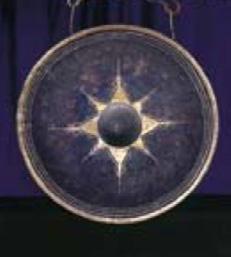
Expert remark: Compare the closely related form and decoration of the gong. Note the gilt-lacquered wood stand with Garuda and that the gong is of smaller size than the present lot.
Estimate EUR 8,000
Starting price EUR 4,000

A LARGE AND MASSIVE GILTLACQUERED BRONZE STUPA, THAILAND, 16TH CENTURY OR LATER
Cast in two sections, of circular form, the dome supported on a stepped spreading base decorated with a lozenge band toward the top and surmounted by the square harmika incised with a floral band, topped by a spiraling elongated spire that culminates in a finely pointed lotus bud.
Provenance: The Kienzle Family Collection, Stuttgart, Germany. Acquired between 1950 and 1985 by siblings Else (1912-2006), Reinhold (19172008), and Dr. Horst Kienzle (1924-2019), during their extensive travels in Asia. Subsequently inherited by Dr. Horst Kienzle and bequeathed to the Museum für Asiatische Kunst, Radevormwald, Germany. Released through museum deaccession in 2024.
Condition: Good condition with expected wear and manufacturing irregularities. Few nicks, light scratches, signs of weathering, flaking and losses to lacquer, an aperture drilled to the base, remnants of pigment. The bronze with a rich, naturally grown, dark patina, and small areas of malachite encrustation.
Weight: 30.5 kg
Dimensions: Height 80.7 cm
The reliquary is a miniature form of brick stupa which has been built in many areas of Thailand. The bellshaped design found at Sukhothai in the late 13th century and afterwards at Ayutthaya was probably inspired by examples from Pagan in Burma, which in turn were probably influenced by Sri Lankan stupa designs.
LITERATURE COMPARISON
Compare a closely related gilt-lacquered brass stupa, 78.7 cm high, dated 16th century or later, in the British Museum, registration number 1957,1014.1.a-b.
Estimate EUR 4,000
Starting price EUR 2,000

A MASSIVE GILT-LACQUERED MARBLE ‘KEKKU’ STUPA, SHAN STATES, KONBAUNG PERIOD
Burma, 1752-1885. Of square form, each side with an arched niche framed by two columns below a foliate design, supported on a tall waisted base and surmounted by a tiered octagonal spire crowned by a bud-form finial.
Provenance: The Kienzle Family Collection, Stuttgart, Germany. Acquired between 1950 and 1985 by siblings Else (1912-2006), Reinhold (19172008), and Dr. Horst Kienzle (1924-2019), during their extensive travels in Asia. Subsequently inherited by Dr. Horst Kienzle and bequeathed to the Museum für Asiatische Kunst, Radevormwald, Germany. Released through museum deaccession in 2024. Labels: Galerie Hardt, inscribed ‘Stupa Marmor Burma 19. Jhd.’, and priced at EUR 3,250 Condition: Good condition with expected wear, minor losses, small chips, flaking and losses to lacquer, signs of weathering, encrustations, remnants of pigment.
Weight: 11.8 kg
Dimensions: Height 51.3 cm

The Kekku Pagodas, located in Myanmar’s Shan State, form an extraordinary complex of over 2,400 stupas, believed to date back as far as the 3rd century BCE, though most were constructed between the 16th and 18th centuries. These stupas, closely clustered together and often intricately decorated with stucco figures, represent the rich Buddhist heritage of the Pa-O ethnic group, who continue to venerate the site. According to local legend, the earliest pagodas were established by missionaries of King Ashoka, lending the site both historical depth and spiritual significance. The Kekku complex remained relatively unknown to outsiders until the late 20th century due to its remote location and political inaccessibility.
Estimate EUR 1,000
Starting price EUR 500
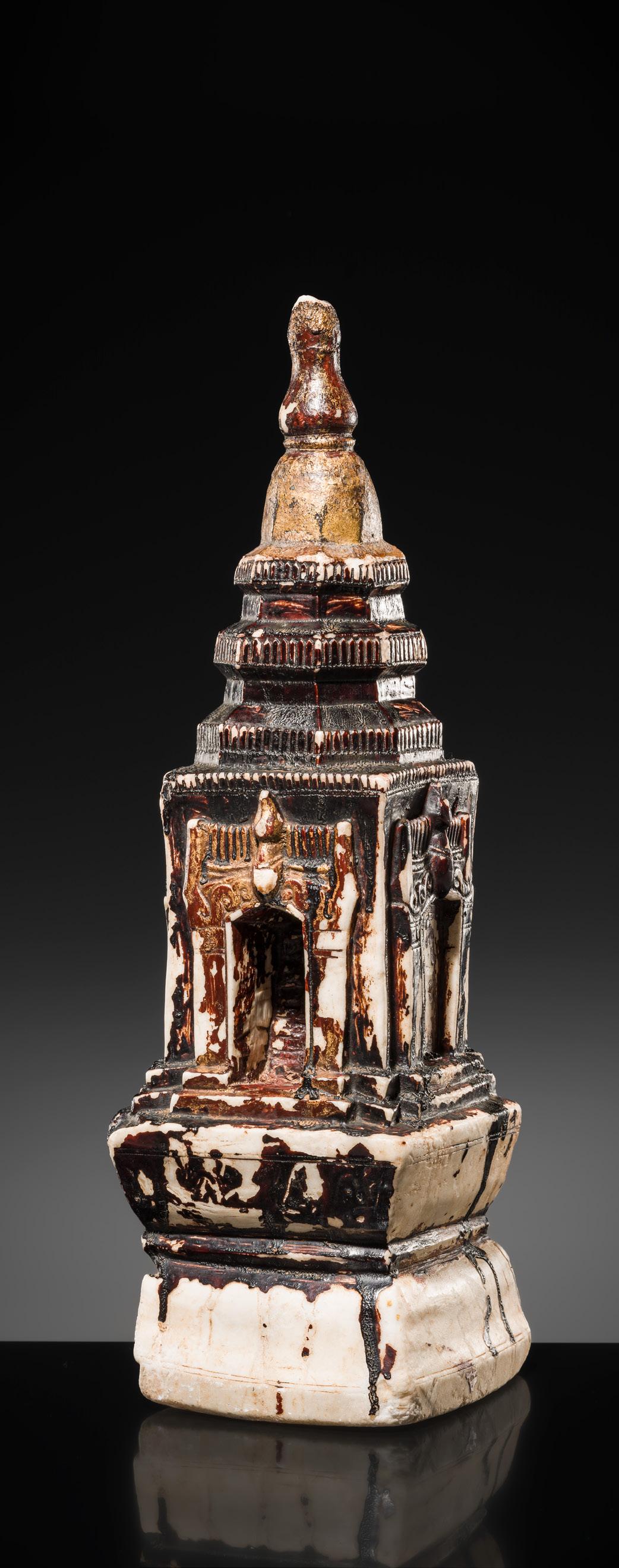
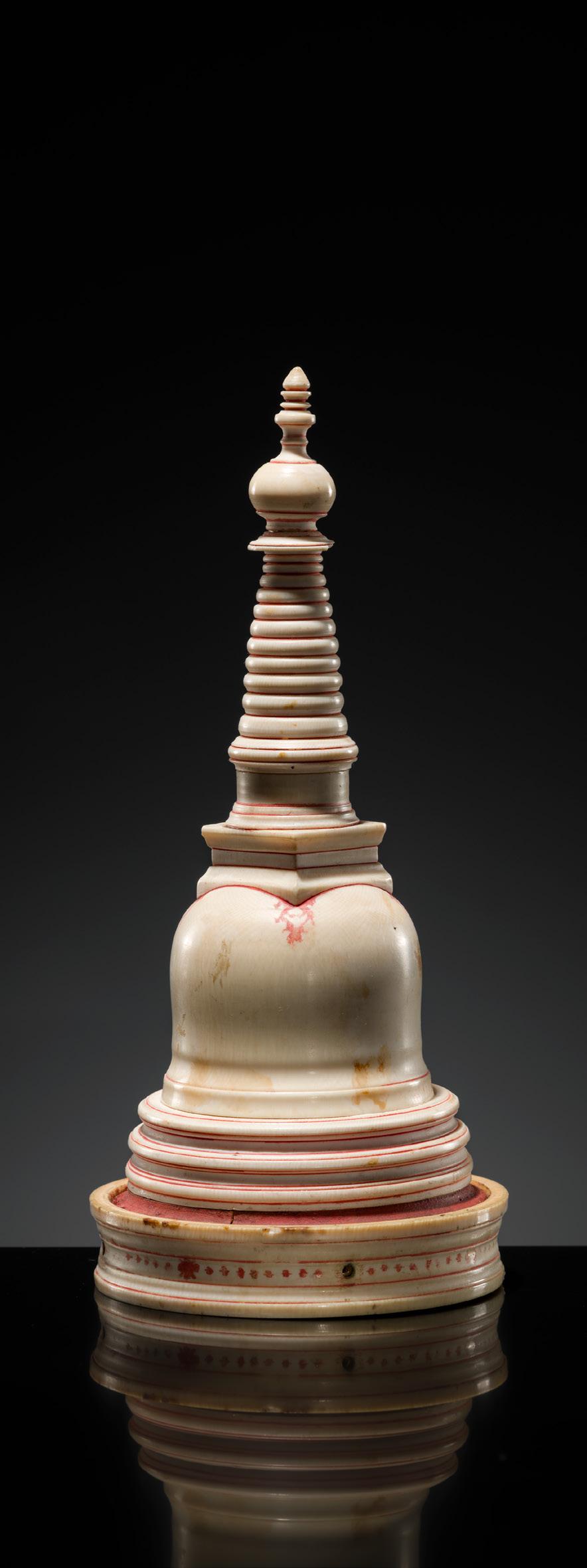
48 AN IVORY RELIQUARY IN THE FORM OF A MINIATURE STUPA, KANDY PERIOD, 17TH-18TH CENTURY
Sri Lanka. Of circular form, the domed body raised on a stepped base atop a waisted plinth with wood core, decorated with floral, petal, and line bands encircling the dome and base as well as four foliate emblems at the shoulder to each corner of the square harmika surmounted by a similarly decorated spire culminating in a vase-form finial.
Provenance: Galerie Hardt (established in 1976), Radevormwald, Germany, before 2020. Acquired by the gallery’s founder Peter Hardt (b. 1946) during his extensive travels in Asia, the first of which occurred during a formative world tour in 1973.
Labels: Galerie Hardt, inscribed ‘Stupa Elfenbein Siam 1850’, priced at EUR 7,250
Condition: Good condition with minor wear and manufacturing irregularities including slight gaps and remnants of adhesive between the wood core and ivory exterior of the plinth. One section of the spire chipped, few minute chips to edges and minuscule nicks, rubbing and losses to pigments, the wood core with an age crack. The ivory with a fine, naturally grown, pale honey patina.
CITES: European Union Certificate number AT 25-B-0116, dated 31 March 2025.
Weight: 318 g
Dimensions: Height 21.5 cm
Miniature stupas were used in Sri Lankan Buddhism as relic containers. A hierarchy of relics, ranked by their closeness, both physically and in time, to the person of the Buddha himself, was acknowledged in early Buddhism. The Buddha’s corporeal remains were the highest form of relic, and over time, those associated with revered teachers assumed a similar, if lesser, status. Stupa reliquaries of this type were used to house the ashes of revered monks.
Literature comparison: Compare a closely related ivory reliquary in the shape of a stupa, Sri Lanka, dated to the 18th century, 16.8 cm high, in the Metropolitan Museum of Art, object number 2010.475.7a–c. Compare a closely related ivory votive stupa, Sri Lanka, dated 17th-18th century, 20.6 cm high, in the Los Angeles Country Museum of Art, object number M.78.101.2.
Estimate EUR 2,000
Starting price EUR 1,000

49 AN IVORY FIGURE OF BUDDHA SHAKYAMUNI, 18TH-19TH CENTURY
Sri Lanka, Kandy period. Finely carved seated in ardha padmasana with his hands lowered in dhyana mudra, wearing a richly pleated sanghati draped over his left shoulder. His serene face with downcast eyes, incised spiral urna, and subtle smile, the hair arranged in tight curls, the head surmounted by a flaming ketumala.
Provenance: The Kienzle Family Collection, Stuttgart, Germany. Acquired between 1950 and 1985 by siblings Else (1912-2006), Reinhold (1917-2008), and Dr. Horst Kienzle (1924-2019), during their extensive travels in Asia. Subsequently inherited by Dr. Horst Kienzle and bequeathed to the Museum für Asiatische Kunst, Radevormwald, Germany. Released through museum deaccession in 2024.
Condition: Fine condition with expected wear. Few age cracks, a loss to the hip, tiny nicks, light scratches, and remnants of pigments. The back and lower body with an old repair, with associated small ivory fills and a small gap above the feet. Fine, naturally grown, honeybrown patina.
CITES: European Union Certificate number AT 25-B-0111, dated 31 March 2025.
Weight: 89 g (incl. base)
Dimensions: Height 10.8 cm (incl. base), 8.9 cm (excl. base)
With an associated wood base. (2)
LITERATURE COMPARISON
Compare a closely related small ivory figure of Buddha Shakyamuni dated to the 18th century, 2.85 cm high, in the Los Angeles Country Museum of Art, accession number M.80.228.15 (fig. 1). Compare a related small ivory figure of a standing Buddha dated to the 19th century, 10 cm high, in the British Museum, registration number 1898,0702.70.
Estimate EUR 1,000
Starting price EUR 500
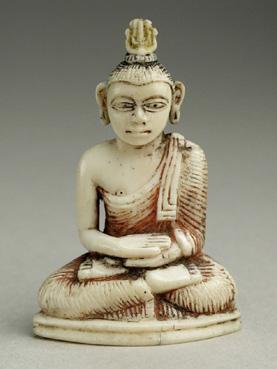
fig. 1
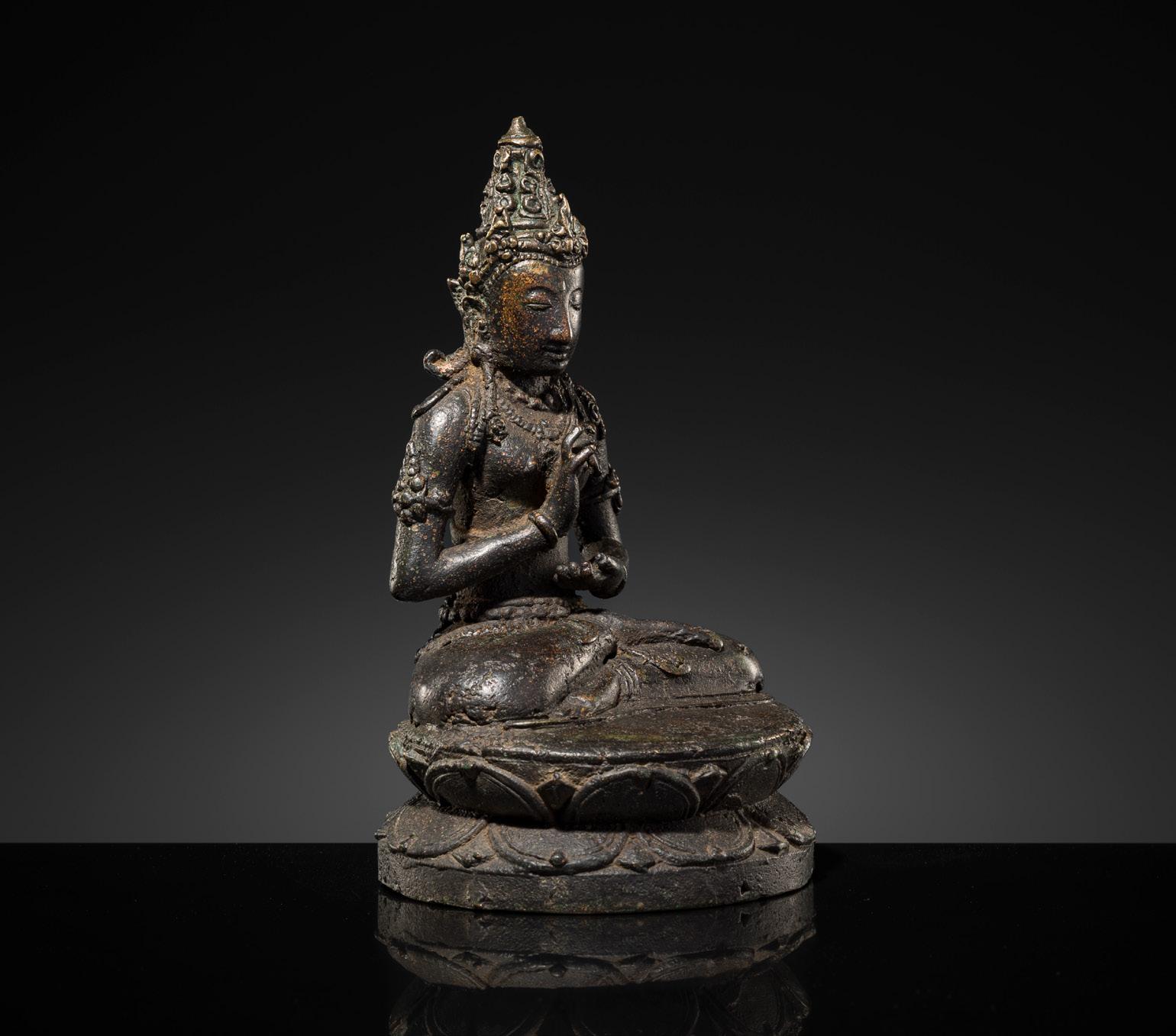
50 A BRONZE FIGURE OF VAIROCANA, CENTRAL JAVA, 9TH-11TH CENTURY
Indonesia. Finely cast seated in ardha padmasana on a double-lotus base with the hands held in dharmachakra mudra, dressed in a long dhoti, secured with a sash and richly adorned with beaded and foliate jewelry. The face modeled in a serene expression with neatly incised downcast eyes and gently arched brows, a prominent nose, and full lips forming a calm smile. The head crowned by a karanda mukata of piled rings diminishing in size and culminating in a lotus bud.
Provenance: Galerie Hardt (established in 1976), Radevormwald, Germany, before 2020. Acquired by the gallery’s founder Peter Hardt (b. 1946) during his extensive travels in Asia, the first of which occurred during a formative world tour in 1973.
Condition: Good condition, commensurate with age, with old wear and casting irregularities, scattered nicks, surface scratches, small dents, and minor losses to the base and the lower section of the figure. Remnants of gilt. Displaying superbly overall. The bronze with a fine, naturally grown patina.
Weight: 502 g
Dimensions: Height 14.2 cm
The present work’s style and composition are evidently inspired by the art of the contemporaneous Pala kingdom of Northeastern India, to which are added distinct local adaptations. For example, the wide lotus petals with pointed tips, and their staggered arrangement between top and bottom layers, copy those of 9th-century Pala bronzes. See two bronzes of Avalokiteshvara and Tara from Nalanda monastery in Niharranjan Ray, Eastern Indian Bronzes, New Delhi, 1986, nos. 110a and 124.
Buddhism in Java did not evolve as a mere extension of Indian Buddhism but developed into another prominent international center for Buddhist scholarship, with the highly esteemed monument of Borobudur at its core. The continuous links between Java and religious centers in India,
particularly with Nalanda monastery, are well documented, and important historic figures such as Yijing, the famous 7th-century Chinese traveller, and Atisha, the renowned 11th-century Bengali pandit, spent significant time studying in Java.
AUCTION RESULT COMPARISON
Type: Closely related
Auction: Bonhams Hong Kong, 5 October 2020, lot 110
Price: HKD 160,000 or approx. EUR 19,500 converted and adjusted for inflation at the time of writing
Description: A copper alloy figure of Vairocana, Java, Indonesia, circa 10th century Expert remark: Compare the closely related modeling, manner of casting, and subject. Note the size (20.4 cm).
AUCTION RESULT COMPARISON
Type: Closely related
Auction: Bonhams New York, 18 March 2013, lot 131
Price: USD 22,500 or approx. EUR 27,000 converted and adjusted for inflation at the time of writing
Description: A copper alloy figure of a bodhisattva, Indonesia, Central Java, 9th/10th century

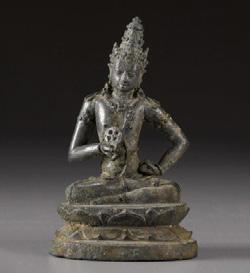
Expert remark: Compare the closely related modeling and manner of casting. Note the size (11.2 cm).
Estimate EUR 2,000
Starting price EUR 1,000
RARE ANDESITE RELIEF PANEL DEPICTING RAMA, SITA, AND LAKSHMANA LEAVING AYODHYA FOR EXILE, 9TH-13TH CENTURY
Indonesia, Java. Finely carved to depict a mythical-beast form chariot drawn by two horses, with Rama and his wife Sita seated in the back, with Lakshmana in the front holding the reins, flanked by two guardian figures carrying a large mace (gada) and a spear, all above a pedestal carved with a lotus petal trim.
Provenance: Galerie Hardt (established in 1976), Radevormwald, Germany, before 2020. Acquired by the gallery’s founder Peter Hardt (b. 1946) during his extensive travels in Asia, the first of which occurred during a formative world tour in 1973.
Condition: Very good condition, commensurate with age. Wear, obvious losses, signs of weathering and erosion, natural imperfections, obvious losses, small chips, scattered nicks and scratches, encrustations, and expected signs of weathering and erosion.
Dimensions: Length 110 cm
Numerous Hindu and Mahayana Buddhist temple complexes were built in Java during the Shailendra Dynasty (c. 730-930), including the great “cosmic mountain” of Borobudur in the 9th century. The present lot shares close affinities with the bas-reliefs at Prambanan, a 9th-century Hindu temple compound in the Special Region of Yogyakarta, in southern Java, Indonesia, dedicated to the Trimurti, the expression of God as the Creator (Brahma), the Preserver (Vishnu), and the Destroyer (Shiva). It was originally built in 850 during the reign of the Hindu Sanjaya dynasty. The temple compound, a UNESCO World Heritage Site, is the largest Hindu temple site in Indonesia and the second largest in Southeast Asia after Angkor Wat. It is characterized by its tall and pointed architecture,
typical of Hindu architecture, and by the towering 47-metre-high (154 ft) central building inside a large complex of individual temples. Prambanan temple compounds originally consisted of 240 temple structures, which represented the grandeur of ancient Java’s Hindu art and architecture, and is also considered as a masterpiece of the classical period in Indonesia.
In the Hindu epic Ramayana , Rama, along with his wife Sita and brother Lakshmana, left Ayodhya for exile due to a promise made by King Dasharatha, Rama’s father. This exile was orchestrated by Kaikeyi, one of Dasharatha’s wives, who desired her son Bharata to be the next king. Despite the citizens’ pleas and deep affection for Rama, he chose to uphold his father’s word and embarked on a 14-year exile. They were escorted by Sumantra, the royal charioteer, and initially reached the banks of the Tamsa River. The people of Ayodhya followed them, but Rama, Sita, and Lakshmana eventually left them behind during the night to begin their journey into the forest.
LITERATURE COMPARISON
Compare a closely related carved panel depicting figures riding a horse-drawn chariot, Java, 11th-13th century, in the collection of British archaeologist and TV presenter James Balme, published on his YouTube channel Tvpresenter4history. Compare a closely related bas-relief depicting Ram, Sita, and Lakshmana leaving Ayodhya for exile, in the Hindu temple complex of Prambanan, built around circa 900 (fig 1).
Estimate EUR 6,000
Starting price EUR 3,000

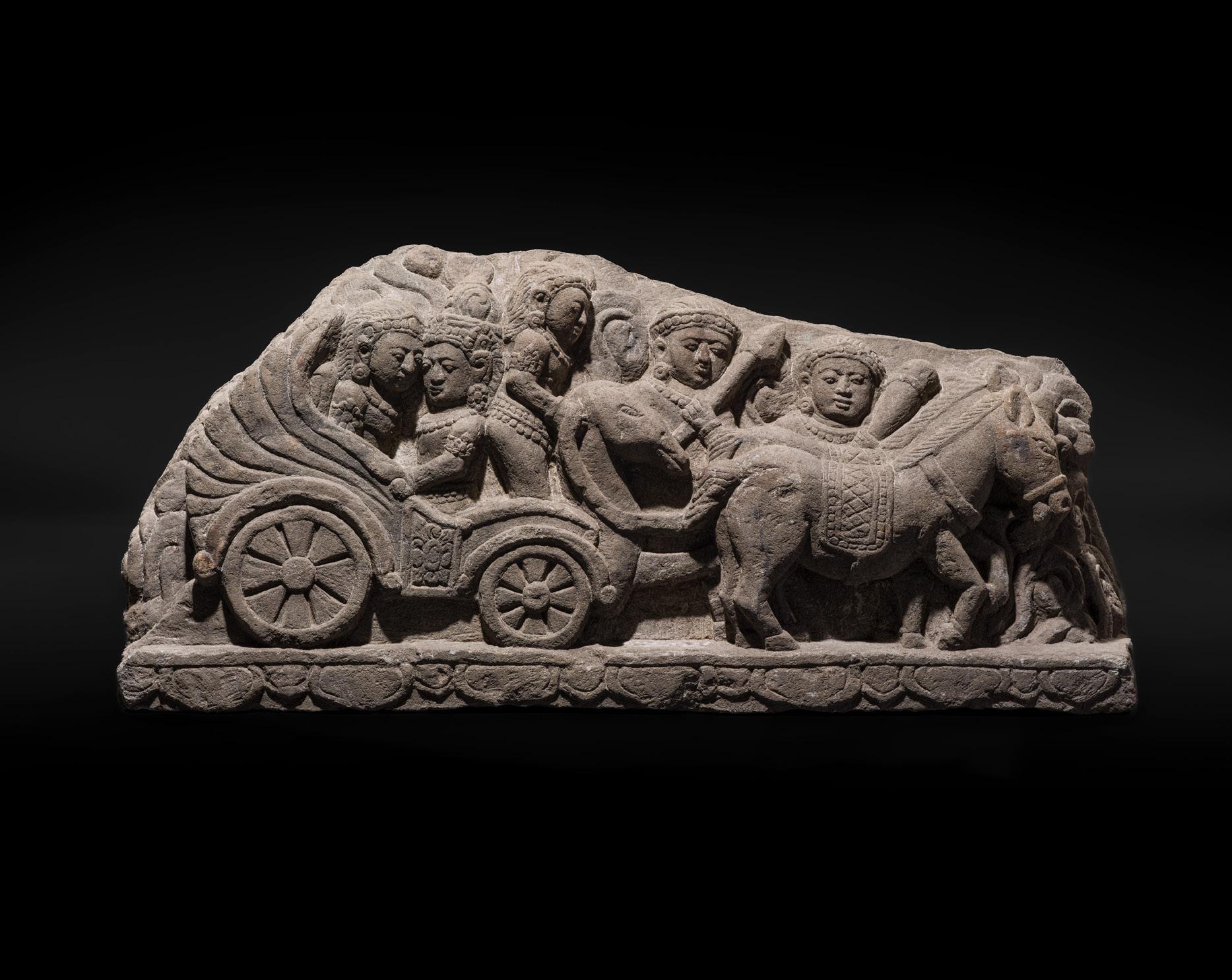

52
BRONZE
OF
The structure consists of a bell-shaped dome resting on a tiered circular base, decorated with a continuous band of stylized lotus petals. The dome is pierced with a series of openwork diamond-shaped motifs, reminiscent of the perforated stupas found at Borobudur, as well as with further incised lotus petals to the top. Above rises a square harmika, culminating in a hexagonal, tapering spire.
Provenance: The Kienzle Family Collection, Stuttgart, Germany. Acquired between 1950 and 1985 by siblings Else (1912-2006), Reinhold (19172008), and Dr. Horst Kienzle (1924-2019), during their extensive travels in Asia. Subsequently inherited by Dr. Horst Kienzle and bequeathed to the Museum für Asiatische Kunst, Radevormwald, Germany. Released through museum deaccession in 2024.
Condition: Good condition with old wear and casting irregularities. Few nicks, dents, surface rubbing, light scratches, as well as minor warping. Extensive wear to silvering. The bronze with a fine naturally grown, dark patina.
Weight: 1.4 kg
Dimensions: Height 33.5 cm
On the upper terraces of the Borobudur Temple in Central Java, iconic perforated stupas encase meditating Buddha images. Built by the Shailendra dynasty around 825 CE, Borobudur is one of the greatest Buddhist monuments of all time, having one of the largest and most complete ensembles of Buddhist narrative relief panels in the world. Structured as a mandala of stacked platforms representing the three planes of existence in Mahayana cosmology (the world of desire, the world of forms, and the world of formlessness), Borobodur invites pilgrims circumambulating its didactic panels and sculpture to shuck the trappings of their perceived reality and realize their true inherent formlessness. This small, bell-shaped stupa, pierced with diamond-shaped openings and surmounted by a spire, directly reflects the design of the seventy-two lattice stupas that crown Borobudur’s summit.
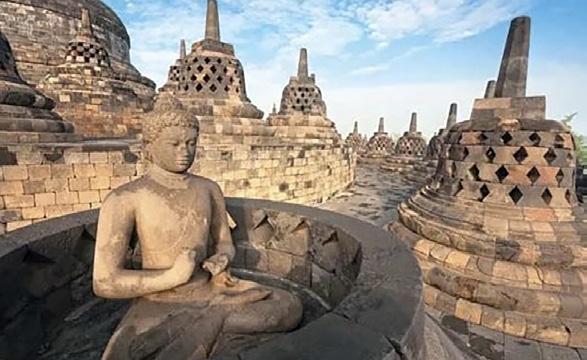
Estimate EUR 2,000
Starting price EUR 1,000
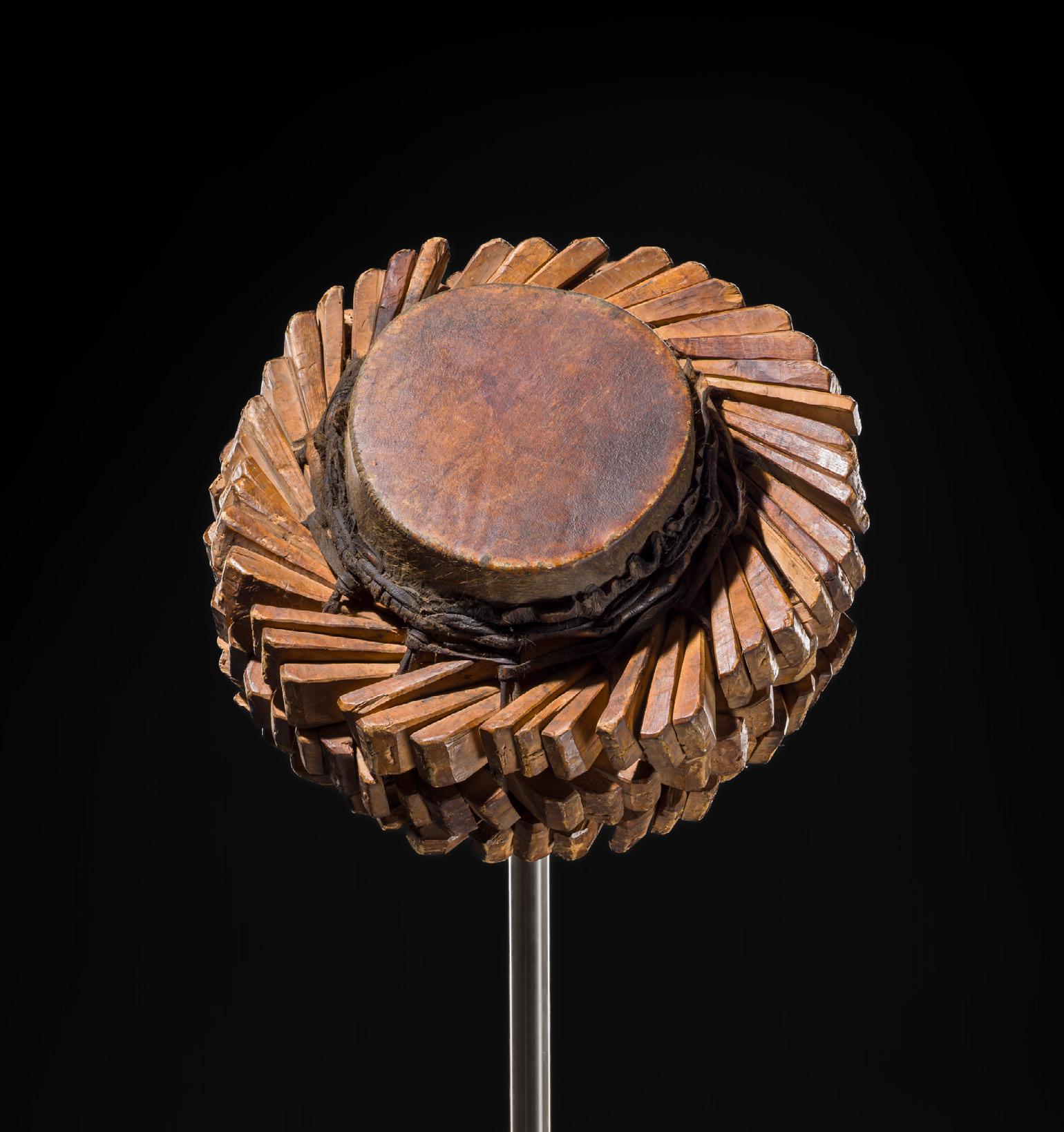
A LEATHER AND WOOD WEDGE DRUM, LAMBA, SUMBA ISLAND, 19TH-20TH CENTURY
Indonesia. The double-headed drum is made of two thick deer skin covered heads over a hollowed out chunk of log, the side bindings consisting of three rows of interlocking wooden wedges, a section of leather cord is also tied around the rims of the drumheads and functions as a loop for hanging the drum or as a handle when played in side.
Provenance: Galerie Hardt (established in 1976), Radevormwald, Germany, before 2020. Acquired by the gallery’s founder Peter Hardt (b. 1946) during his extensive travels in Asia, the first of which occurred during a formative world tour in 1973.
Condition: Good condition with wear, traces of use, and natural imperfections including expected age cracks and fissures. Few nicks, light scratches, and small losses.
Weight: 11.8 kg (excl. stand)
Dimensions: Width 50 cm
With an associated metal stand. (2)
The wedge-drum, or lamba, is a drum used by the people of Sumba, an island in eastern Indonesia. It is played during festival ceremonies such as funeral events. Only one lamba is played at a time with the metal gongs and young men take turns beating out the dance rhythms.
The interlocking wedges are used for tuning, by pushing in to tighten or pulling out to loosen the tension on the drumheads.
LITERATURE COMPARISON
Compare a closely related wood, hide, and cloth lamba, wedge drum, Sumba Island, Indonesia, dated to the mid20th century, 29.2 cm wide, in the Hartenberger World Music Collection of Historical Instruments, accession number AS-MBST-26-14.
Estimate EUR 2,000
Starting price EUR 1,000
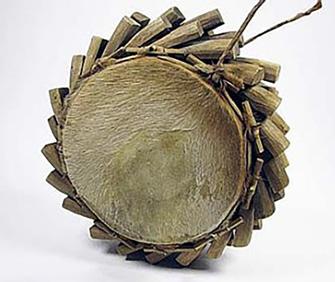
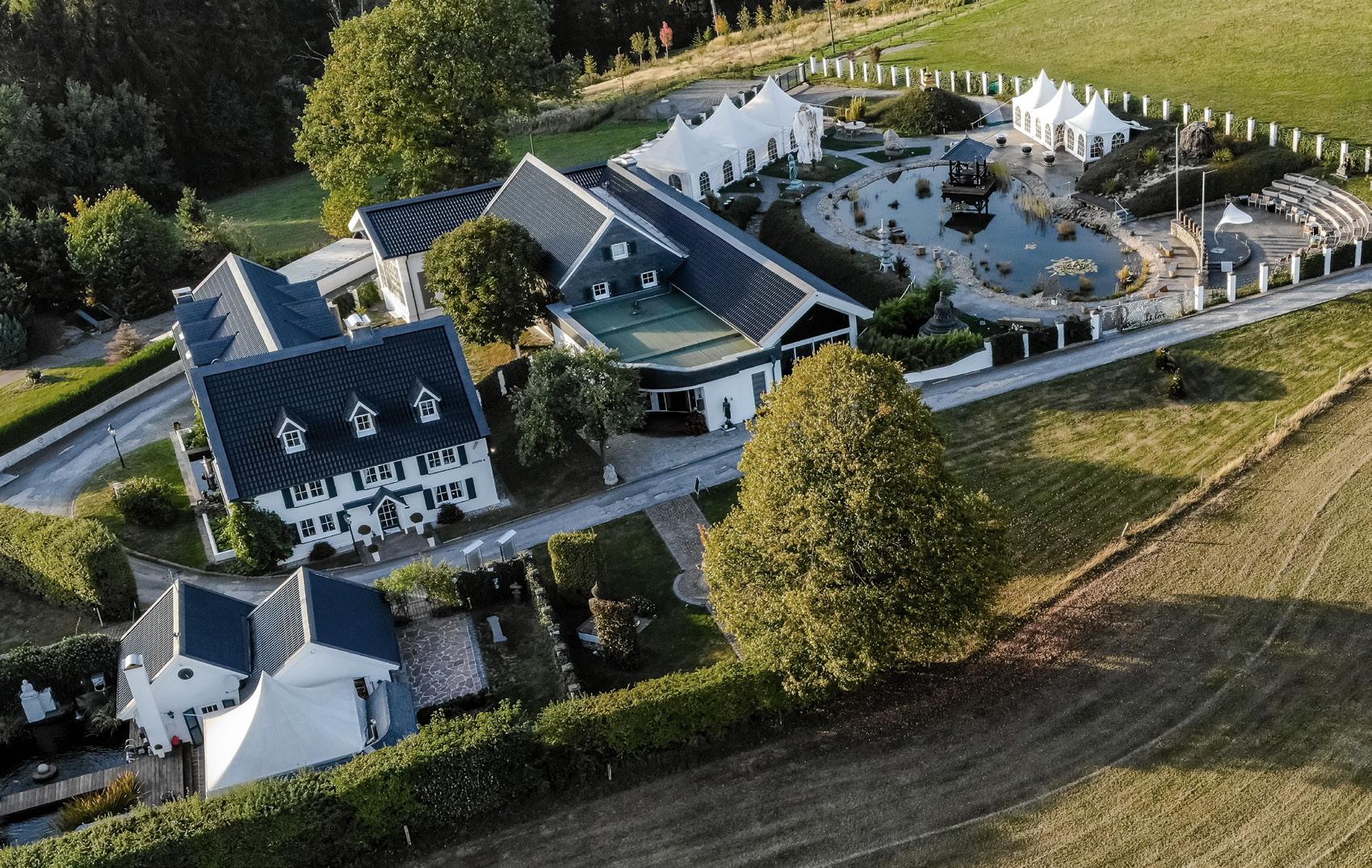

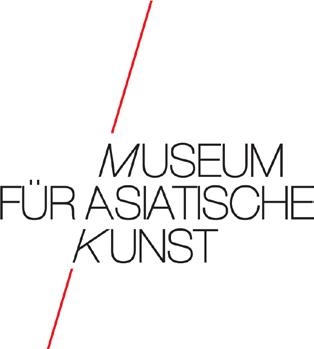
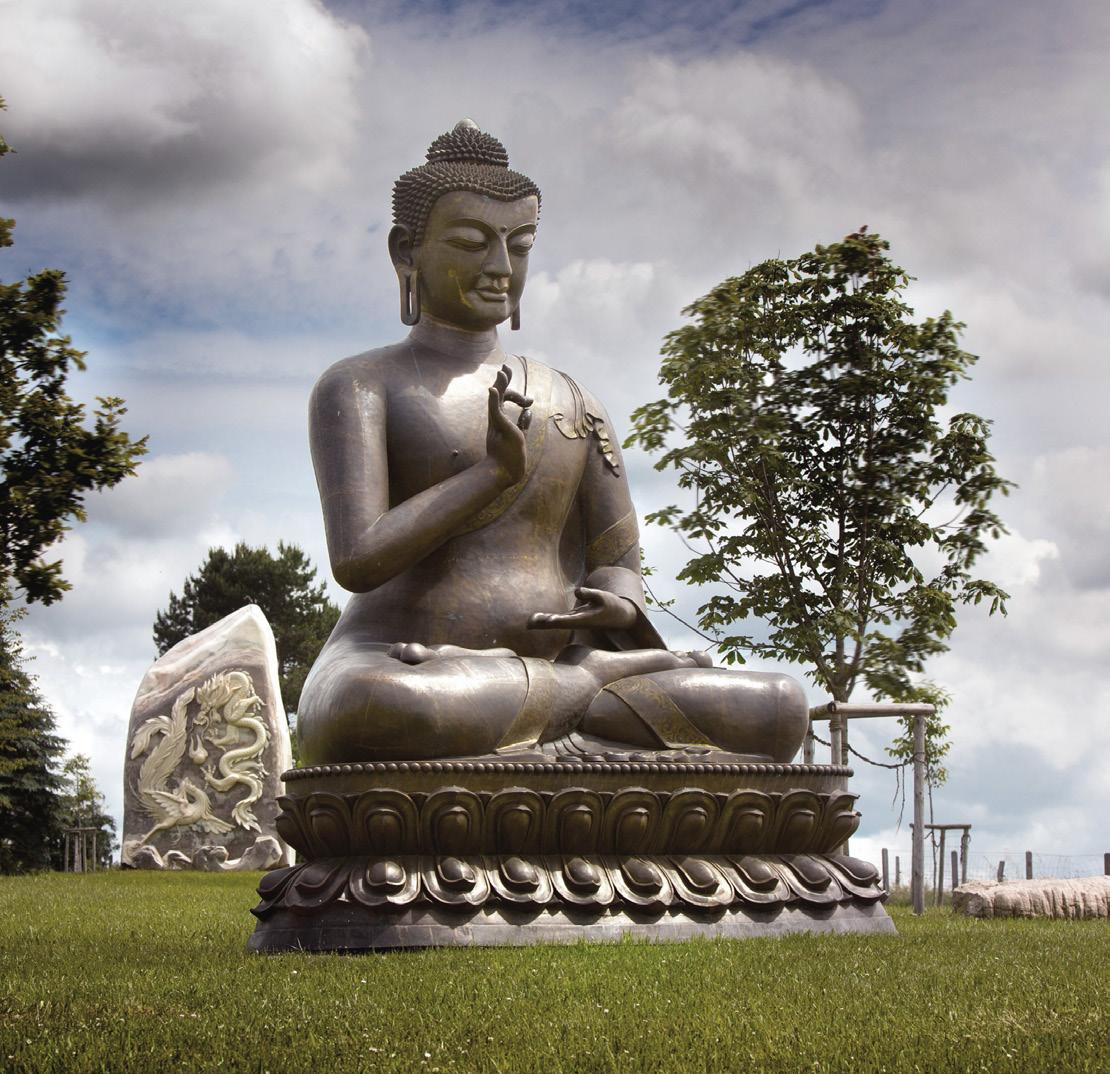


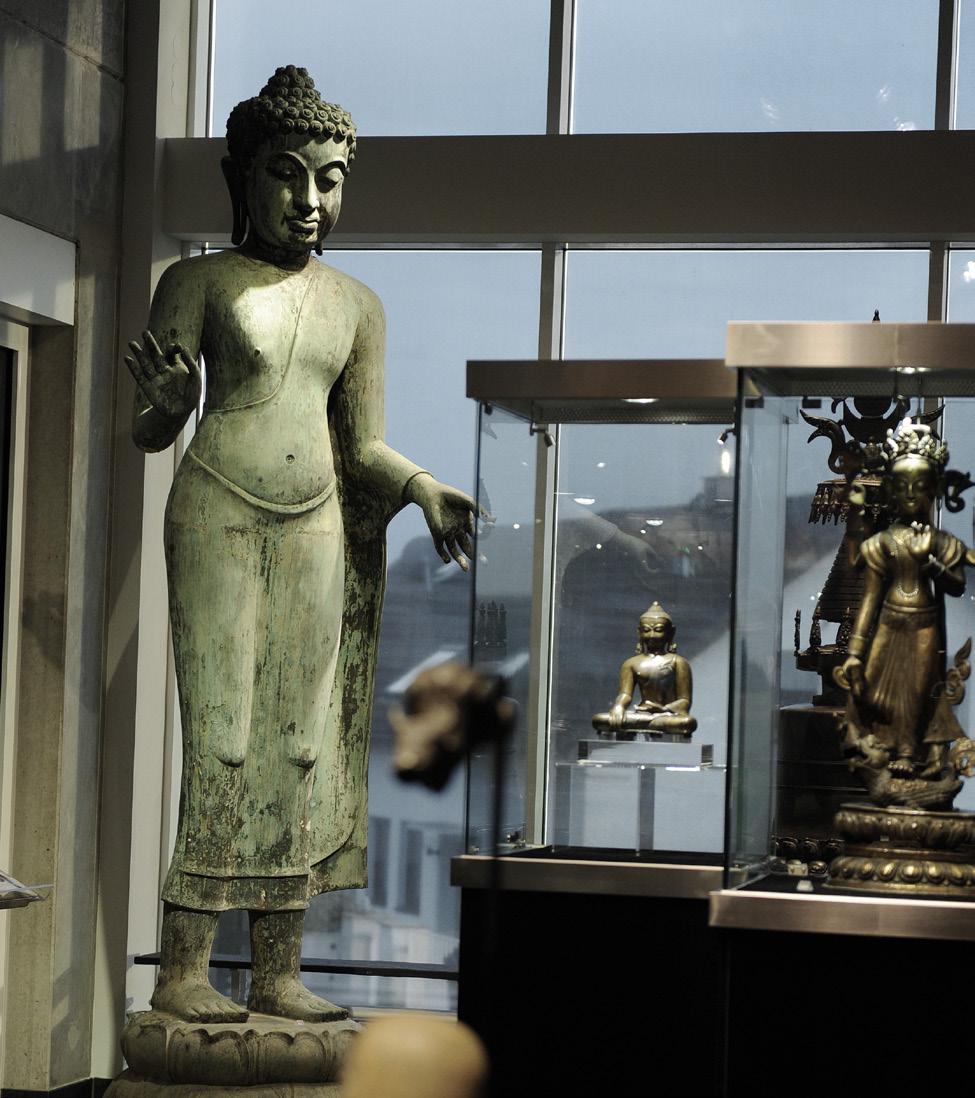
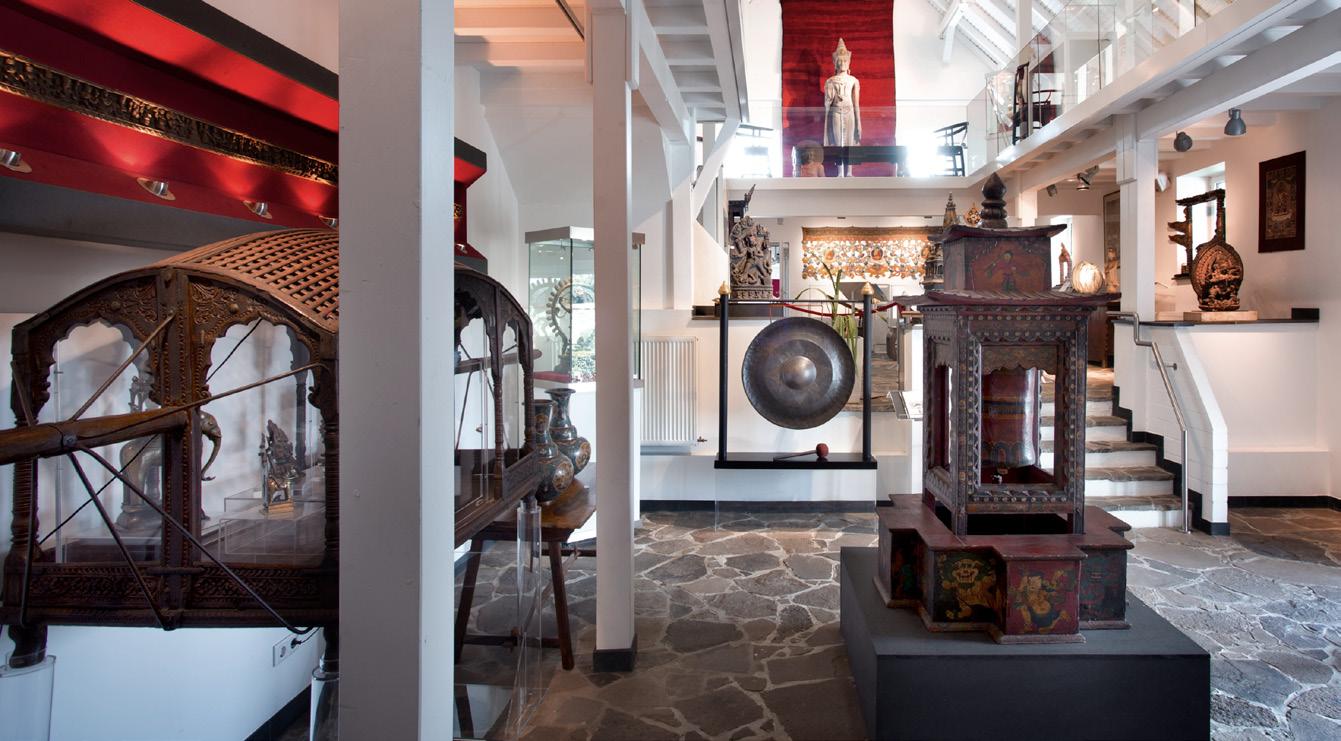
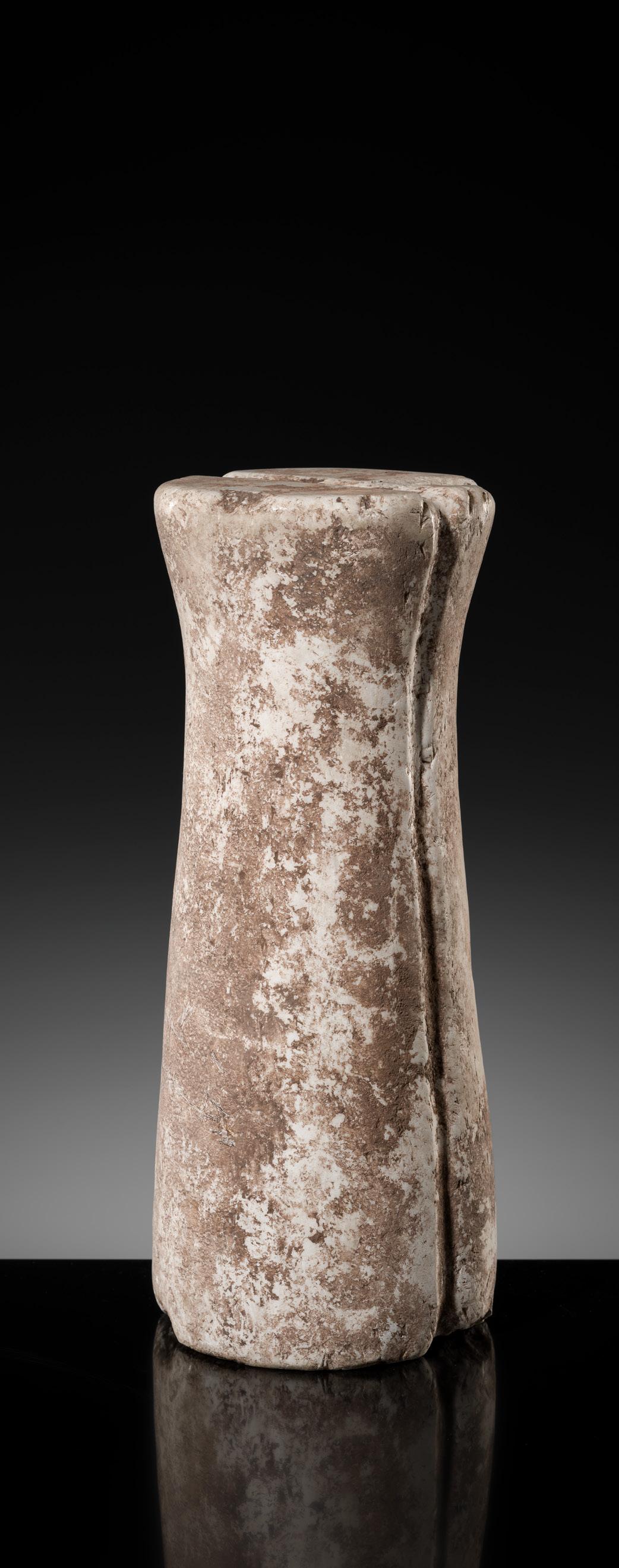
54
A BACTRIAN LIMESTONE COLUMN IDOL, LATE 3RD-EARLY 2ND MILLENNIUM BC
Oxus Civilization. Of slightly tapered cylindrical form, the top and base with crescent-shaped central grooves which run down the sides of the body. The pale brown fossiliferous stone with white patches and inclusions.
Provenance: The Kienzle Family Collection, Stuttgart, Germany. Acquired between 1950 and 1985 by siblings Else (1912-2006), Reinhold (19172008), and Dr. Horst Kienzle (1924-2019), during their extensive travels in Asia. Subsequently inherited by Dr. Horst Kienzle and bequeathed to the Museum für Asiatische Kunst, Radevormwald, Germany. Released through museum deaccession in 2024.
Condition: Good condition, commensurate with age. Expected old wear, signs of weathering and erosion, few minor losses, scattered nicks, chips to edges, some of which have smoothened over time, surface scratches, natural fissures.
Weight: 12.4 kg
Dimensions: Height 35.7 cm
The Oxus Civilization or Bactria–Margiana Archaeological Complex (BMAC), recently dated to ca. 2250-1700 BC, is the modern archaeological designation for a Bronze Age civilization of Central Asia, previously dated to ca. 2400-1900 BC by Sandro Salvatori, in its urban phase or integration era. Though it may be called the ‘Oxus civilization’, apparently centered on the upper Amu Darya (Oxus River) in Bactria, most of the BMAC’s urban sites are actually located in Margiana (modern Turkmenistan) on the Murghab river delta and the Kopet Dagh mountain range. There are a few later sites in northern Bactria (ca. 1950–1450 BC), the territory of southern Uzbekistan, but they are mostly graveyards belonging to the BMACrelated Sapalli culture. A single BMAC site, known as Dashli, lies in southern Bactria, the territory of northern Afghanistan. Sites found further east, in southwestern Tajikistan, though contemporary with the main BMAC sites in Margiana, are only graveyards, with no urban developments associated with them. BMAC sites were discovered and named by the Soviet archaeologist Viktor Sarianidi when he was excavating in northern Afghanistan between 1969 and 1979. Sarianidi’s excavations revealed numerous monumental structures in many sites, fortified by impressive walls and gates. Reports on the BMAC were mostly confined to Soviet journals. A journalist from The New York Times wrote in 2001 that during the years of the Soviet Union, the findings were largely unknown to the West until Sarianidi’s work began to be translated in the 1990s.
AUCTION RESULT COMPARISON
Type: Closely related
Auction: Christie’s London, 12 May 2004, lot 183
Price: EUR 7,170 or approx. EUR 12,000 adjusted for inflation at the time of writing
Description: A Bactrian marble column idol, 2nd millennium BC
Expert remark: Compare the closely related form, manner of carving, and color of the stone.
Note the size (29.5 cm).
Estimate EUR 2,000
Starting price EUR 1,000
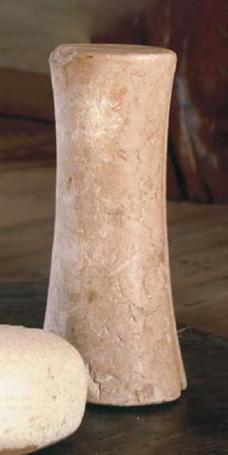
A BACTRIAN STONE COLUMN IDOL, 2ND MILLENNIUM BC
Oxus Civilization. The column of waisted form slightly flaring towards the ends, the top with a crescent-shaped central groove. The dark green fossiliferous stone with white veins and inclusions.
Provenance: The Kienzle Family Collection, Stuttgart, Germany. Acquired between 1950 and 1985 by siblings Else (1912-2006), Reinhold (19172008), and Dr. Horst Kienzle (1924-2019), during their extensive travels in Asia. Subsequently inherited by Dr. Horst Kienzle and bequeathed to the Museum für Asiatische Kunst, Radevormwald, Germany. Released through museum deaccession in 2024.
Condition: Good condition, commensurate with age. Expected old wear and signs of weathering and erosion, nibbling to the edges, some of which have smoothened over time, and natural fissures. Old repairs and minor fills.
Weight: 10.5 kg
Dimensions: Height 34.4 cm
Several stone objects of this shape have been excavated at sites of the Oxus Civilization. However, it is still unknown what purpose they once fulfilled. It is suggested that these miniature columns at some point entered the rituals of the Oxus funerary practices, having previously performed a practical function that involved strong laces running around and causing intensive wear to the grooves. The present object belongs to a group of shorter, heavily polished columns with one central groove along the top and bottom.
AUCTION RESULT COMPARISON
Type: Closely related
Auction: Christie’s London, 12 May 2004, lot 189
Price: EUR 4,182 or approx. EUR 6,900 adjusted for inflation at the time of writing
Description: A Bactrian stone column idol, 2nd millennium BC
Expert remark: Compare the closely related form, color of the stone, manner of carving, and size (37 cm).
Estimate EUR 2,000
Starting price EUR 1,000
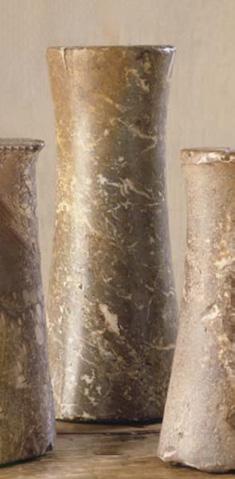

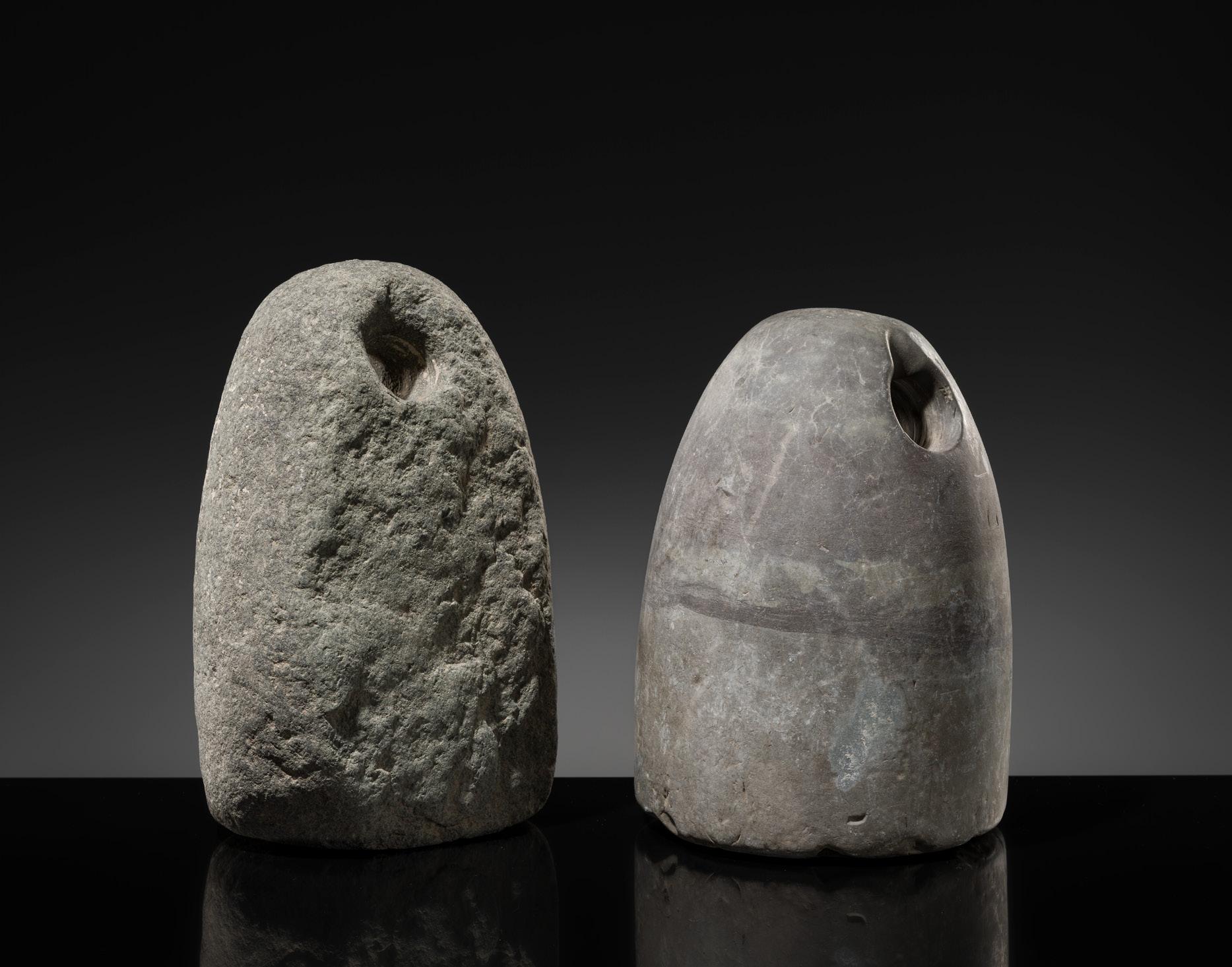
56
A PAIR OF BACTRIAN STONE WEIGHTS, LATE 3RD TO EARLY 2ND MILLENNIUM BC
Oxus Civilization. Both stones of high domed form supported on a flattened base and perforated for suspension at the top, the holes converging in a V-shape. The fossiliferous stones of varying greyish tones, one presenting a polished surface with dark patches, white inclusions and some greenish mottling, the other exhibiting a rough texture with whitish veining.
Provenance: The Kienzle Family Collection, Stuttgart, Germany. Acquired between 1950 and 1985 by siblings Else (1912-2006), Reinhold (1917-2008), and Dr. Horst Kienzle (1924-2019), during their extensive travels in Asia. Subsequently inherited by Dr. Horst Kienzle and bequeathed to the Museum für Asiatische Kunst, Radevormwald, Germany. Released through museum deaccession in 2024.
Condition: Very good condition, commensurate with age, with expected old wear and signs of weathering and erosion, few obvious losses, nicks, chips, scratches, natural fissures.
Weight: 15.9 kg (total)
Dimensions: Height 22 cm and 24 cm
The Oxus Civilization or Bactria–Margiana Archaeological Complex (BMAC), recently dated to ca. 2250-1700 BC, is the modern archaeological designation for a Bronze Age civilization of Central Asia, previously dated to ca. 2400-1900 BC by Sandro Salvatori, in its urban phase or integration era. Though it may be called the ‘Oxus civilization’, apparently centered on the upper Amu Darya (Oxus River) in Bactria, most of the BMAC’s urban sites are actually located in Margiana (modern Turkmenistan) on the Murghab river delta and the Kopet Dagh mountain range. There are
a few later sites in northern Bactria (ca. 1950–1450 BC), the territory of southern Uzbekistan, but they are mostly graveyards belonging to the BMAC-related Sapalli culture. A single BMAC site, known as Dashli, lies in southern Bactria, the territory of northern Afghanistan. Sites found further east, in southwestern Tajikistan, though contemporary with the main BMAC sites in Margiana, are only graveyards, with no urban developments associated with them. BMAC sites were discovered and named by the Soviet archaeologist Viktor Sarianidi when he was excavating in northern Afghanistan between 1969 and 1979. Sarianidi’s excavations revealed numerous monumental structures in many sites, fortified by impressive walls and gates. Reports on the BMAC were mostly confined to Soviet journals. A journalist from The New York Times wrote in 2001 that during the years of the Soviet Union, the findings were largely unknown to the West until Sarianidi’s work began to be translated in the 1990s.
COMPARISON
Type: Closely related
Auction: Christie’s New York, 9 December 2015, lot 99
Price: USD 8,750 or approx. EUR 10,500 (for two) converted and adjusted for inflation at the time of writing
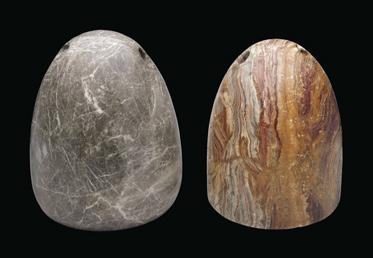
Description: Two Bactrian stone weights, ca. late 3rd to 2nd millennium BC
Expert remark: Compare the closely related form, material, and perforation style. Note the similar size (22.5 cm).
Estimate EUR 2,000
Starting price EUR 1,000
A RARE PAIR OF LARGE STONE RINGS, PREDYNASTIC PERIOD
Egypt, ca. 3850-2960 BC. Each of circular form, one pierced with a small aperture. The dark greenish fossiliferous stone with white inclusions, one with iron-russet patches. (2)
Provenance: The Kienzle Family Collection, Stuttgart, Germany. Acquired between 1950 and 1985 by siblings Else (1912-2006), Reinhold (1917-2008), and Dr. Horst Kienzle (1924-2019), during their extensive travels in Asia. Subsequently inherited by Dr. Horst Kienzle and bequeathed to the Museum für Asiatische Kunst, Radevormwald, Germany. Released through museum deaccession in 2024.
Condition: Good condition, commensurate with age. Ancient wear, signs of weathering and erosion, few obvious losses, old smoothened chips, natural fissures and cracks, old repairs.
Weight: 8.4 kg (total)
Dimensions: Diameter 25.3-27.2 cm
LITERATURE COMPARISON
Compare a related Egyptian steatite bracelet dated to the Predynastic period in the Metropolitan Museum of Art, object number 10.176.68.
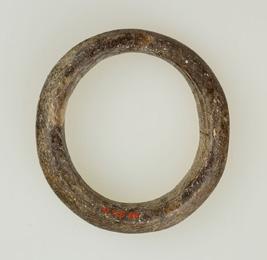
Estimate EUR 2,000
Starting price EUR 1,000
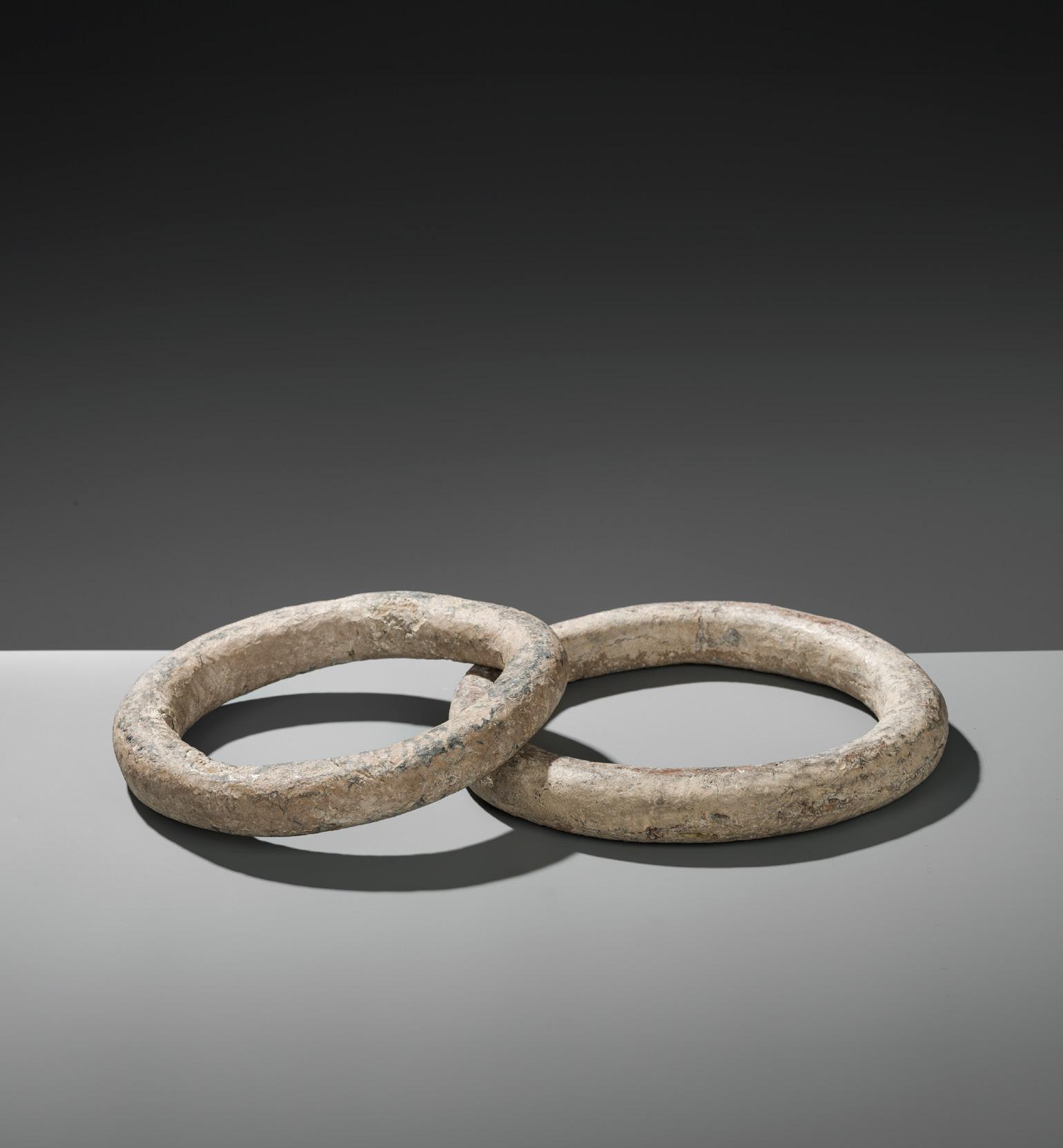
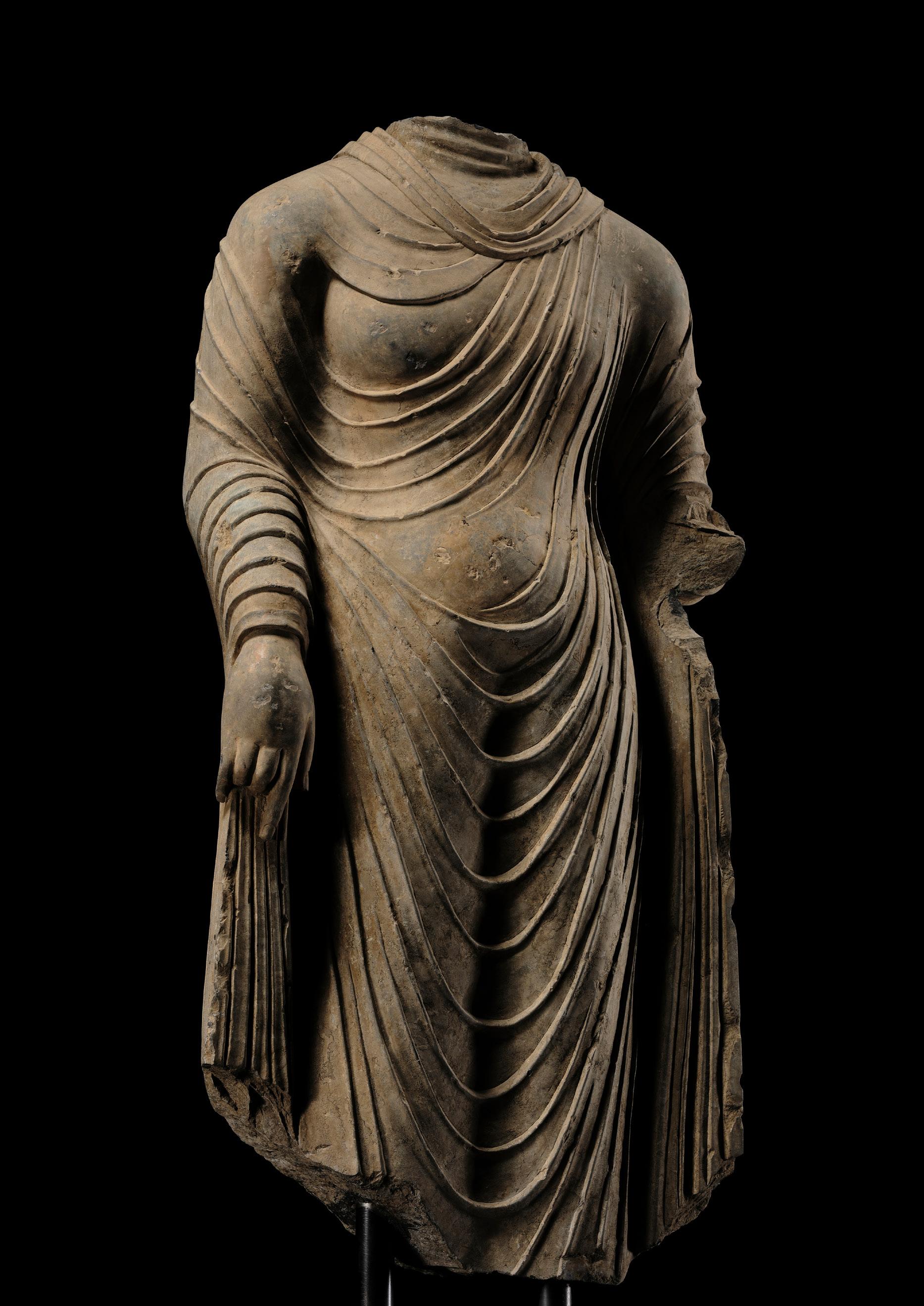
Superbly carved, standing in a slight tribhanga with the left hand lowered and grasping the hem of his voluminous robe gracefully cascading in naturalistically modeled U-shaped folds that reveal the harmonious contours of his powerful body, further enhanced by cream-colored encrustations.
Provenance: The Kienzle Family Collection, Stuttgart, Germany. Acquired between 1950 and 1985 by siblings Else (1912-2006), Reinhold (1917-2008), and Dr. Horst Kienzle (1924-2019), during their extensive travels in Asia. Subsequently inherited by Dr. Horst Kienzle and bequeathed to the Museum für Asiatische Kunst, Radevormwald, Germany. Released through museum deaccession in 2024.
Condition: Very good condition, commensurate with age. Obvious losses, signs of weathering and erosion particularly to the reverse, encrustations, minor old fills, structural cracks, chips, nicks, scratches.
German Export License: Ausfuhrgenehmigung Nr. 132/2024, dated 25 June 2024, has been granted. A copy accompanies this lot.

Weight: approx. 740 kg (incl. base)
Dimensions: Height 175 cm (excl. base), 218 cm (incl. base)
Mounted on an associated metal stand. (2)
Gandhara was an ancient region in present-day northern Pakistan and eastern Afghanistan, and a major center for Buddhist culture and art from around the 1st century BC to the 5th century AD. Situated on the historic Silk Route, Gandhara served as a geographical junction where early elements of the Western classical world intersected with Indian iconography and regional traditions. The impact of Hellenistic art on Gandhara represents an intriguing instance of cultural interplay following Alexander the Great's 4th-century BC conquests and the ensuing formation of Hellenistic realms in Central Asia. This integration of Greek artistic traditions with indigenous and Buddhist motifs gave rise to the unique style of Gandharan art, prominently visible from the 1st century CE onward. However, it wasn’t until the 2nd century that the first human images of the Buddha (rather than aniconic images such as footprints, riderless horses, and parasols) began to appear.
The Gandharan Buddhist culture was characterized by its distinctive art style, which combined Greek artistic styles such as a highly realistic depiction of human facial features and expressions, a naturalistic portrayal of the human body, along with detailed treatment of muscles and drapery. This was a major departure from the more stylized and abstracted forms common in earlier Indian art. Sculptures of the historical Shakyamuni Buddha such as the present, for instance, often show him in a robe that closely drapes his body, revealing the form beneath in a manner reminiscent of Greek and Roman statues. The present torso exemplifies this art form and is one of the largest Gandharan torso sculptures preserved outside of Pakistan. Only a very small number of Gandharan sculptures would have been larger, including, for instance, the 2.5m standing figure of Buddha in the Miho Museum, illustrated in Catalogue of the Miho Museum, Kyoto, 1997, pl. 72.
LITERATURE COMPARISON
Compare two well-known closely related Gandharan schist figures of Buddha, 264 and 213 cm high, unearthed from SahriBahlol Mound B and now in the Peshawar Museum, illustrated for example in Juhyung Rhi, “Identifying Several Visual Types in Gandhāran Buddha Images.” Archives of Asian Art, vol. 58, 2008, p. 43-85, figs. 11 and 13.
AUCTION RESULT COMPARISON
Type: Closely related
Auction: Sotheby’s New York, 21 March 2024, lot 814
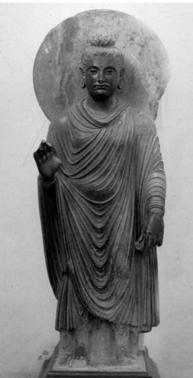
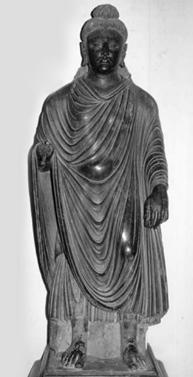
Price: USD 300,000 or approx. EUR 266,000 converted and adjusted for inflation at the time of writing
Description: A monumental torso of Shakyamuni Buddha, Ancient region of Gandhara, 3rd-4th Century
Expert remark: Compare the closely related modeling and manner of carving with similar posture and robe. Note the smaller size (144.8 cm).
AUCTION RESULT COMPARISON
Type: Closely related
Auction: Christie’s Paris, 13 June 2018, lot 232
Price: EUR 247,500 or approx. EUR 289,000 adjusted for inflation at the time of writing
Description: A rare and important grey schist torso of Buddha Shakyamuni, ancient region of Gandhara, 2nd-3rd century
Expert remark: Compare the closely related modeling and manner of carving with similar posture and robe. Note the smaller size (129 cm).
Estimate EUR 80,000
Starting price EUR 40,000
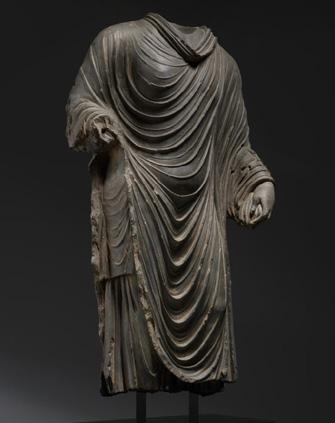
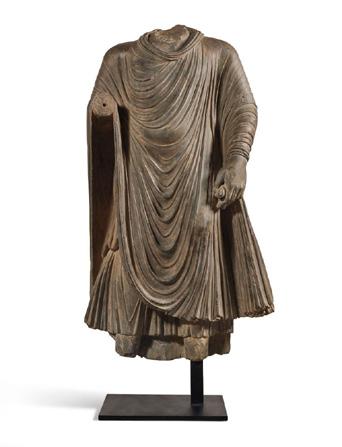


59
A GRAY SCHIST CARVING OF A BUDDHIST LION, KUSHAN PERIOD
Ancient region of Gandhara, 2nd-3rd century. Expressively carved with bulging eyes and slightly furrowed snout, the mouth wide open in a ferocious roar, the long mane with undulating strands of hair combed to the side.
Provenance: Galerie Hardt (established in 1976), Radevormwald, Germany, before 2020. Acquired by the gallery’s founder Peter Hardt (b. 1946) during his extensive travels in Asia, the first of which occurred during a formative world tour in 1973.
Labels: Galerie Hardt, inscribed ‘Löwe, Stein, Afghanistan, 2.-3. Jahrhundert’, the back ‘Reg. Nr. 20716’, and priced at EUR 12,750
Condition: Good condition, commensurate with age, with old wear and extensive signs of weathering and erosion, including obvious losses and encrustations. With remnants of old pigments.
Weight: 54.2 kg (excl. stand), 61.6 kg (incl. stand)
Dimensions: Length 57.2 cm
With an associated modern stand. (2)
The lion is a symbol of the Shakya clan, from which Buddha Shakyamuni descended. The lion is associated with regality, strength and power, and his teachings are sometimes referred to as the Lion's Roar. As guardian animals of the Buddhist faith, figures of lions would protect the entrances of Buddhist edifices. Schist images of lions are surprisingly rare, and the present example possibly served as a throne support.
Literature comparison:
Compare a related Gandharan schist lion dated 2nd-3rd century, 50.8 cm high, in the Metropolitan Museum of Art, object number 32.70.
AUCTION RESULT COMPARISON
Type: Closely related
Auction: Christie’s New York, 20 September 2007, lot 218
Price: USD 20,000 or approx. EUR 27,000 converted and adjusted for inflation at the time of writing
Description: A gray schist lion head, Gandhara, dated 2nd-3rd century Expert remark: Compare the closely related modeling and manner of carving with similar facial features and flowing mane. Note the different size (26.6 cm).
AUCTION RESULT COMPARISON
Type: Closely related
Auction: Christie’s New York, 23 March 1999, lot 7
Price: USD 20,700 or approx. EUR 35,000 converted and adjusted for inflation at the time of writing
Description: A gray schist carving of a lion, Gandhara, dated ca. 3rd century Expert remark: Compare the closely related modeling and manner of carving with similar facial features and flowing mane. Note the size (39.4 cm).
Estimate EUR 4,000
Starting price EUR 2,000


Northern India. Of circular form, deeply carved with a pair of footprints adorned with incised swastikas above triratnas on the toes, the soles similarly adorned with larger triratnas, enclosed by a band of flowerheads and a lappet border to the outer edge.
Provenance: Galerie Hardt (established in 1976), Radevormwald, Germany, before 2020. Acquired by the gallery’s founder Peter Hardt (b. 1946) during his extensive travels in Asia, the first of which occurred during a formative world tour in 1973.
Condition: Very good condition, commensurate with age. Wear, small chips, one minor loss to a corner, scattered nicks and scratches, encrustations, and signs of weathering and erosion.
Weight: 78 kg
Dimensions: Diameter 64 cm
Buddhapada images such as the present lot demonstrate the proliferation of the dharma, and its size conveys the power of Buddhist teachings. The swastika—an ancient fertility symbol—on the toes represent immutability, while the triratna symbol represents the three jewels of Buddhism: Buddha, dharma, and sangha.
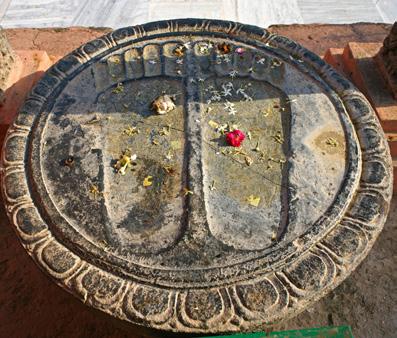
EXPERT’S NOTE:
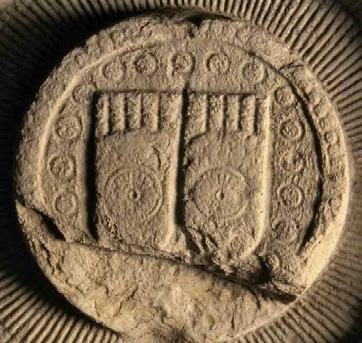
LITERATURE COMPARISON
Compare a related green gray schist of Buddha’s footprint, Uttar Pradesh, 2nd-1st century BC, in the Chhatrapati Shivaji Maharaj Vastu Sangrahalaya, Mumbai, illustrated in the Virtual Museum of Images & Sounds, accession number 15406. fig. 2 fig. 1
The present lot relates closely to a number of examples found in the Mahabodhi Temple in Bodh Gaya and the Amaravati Stupa in Andhra Pradesh, two of the earliest and most important Buddhist sites. Compare a circular schist relief of Buddha’s footprints encircled by lotus petals in the Mahabodhi temple (fig. 1), one of the most revered Buddhist pilgrimage sites in the world. The temple marks the location where Siddhartha Gautama attained enlightenment under the Bodhi Tree, becoming the Buddha, and dates back to the 3rd century BC when Emperor Ashoka first visited the site and erected a shrine. Compare also a circular buddhapada within a lotus blossom carved from stone, from Amaravati and now in the Government Museum at Egmore, Chennai, illustrated in the Virtual Museum of Images & Sounds, accession number ACSAA_12172 (fig. 2). The Amaravati Stupa was also originally built under Ashako, and the stupa subsequently evolved over centuries into a grand structure richly adorned with intricate carvings and detailed narrative reliefs. These sculptures, depicting scenes from the life of the Buddha and Jataka tales, are considered masterpieces of early Indian art and reflect the development of the Amaravati School of sculpture. Though much of the original structure is now in ruins, the site remains significant for its historical and artistic value.
AUCTION RESULT COMPARISON
Type: Closely related
Auction: Christie’s New York, 23 September 2020, lot 618
Price: USD 337,500 or approx. EUR 394,000 converted and adjusted for inflation at the time of writing
Description: A rare green schist Buddhapada, Ancient region of Gandhara, probably Swat Valley, 2nd-4th century CE
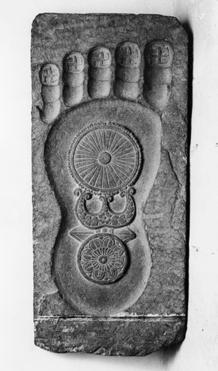
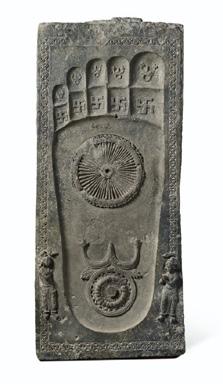
Expert remark: Compare the closely related modeling and manner of carving with similar geometric band to the side, sharing a clear iconographic influence with the present lot, and likely dating to the same period. Note the larger size (82.9 cm) and that only a single footprint is portrayed.
Estimate EUR 10,000
Starting price EUR 5,000
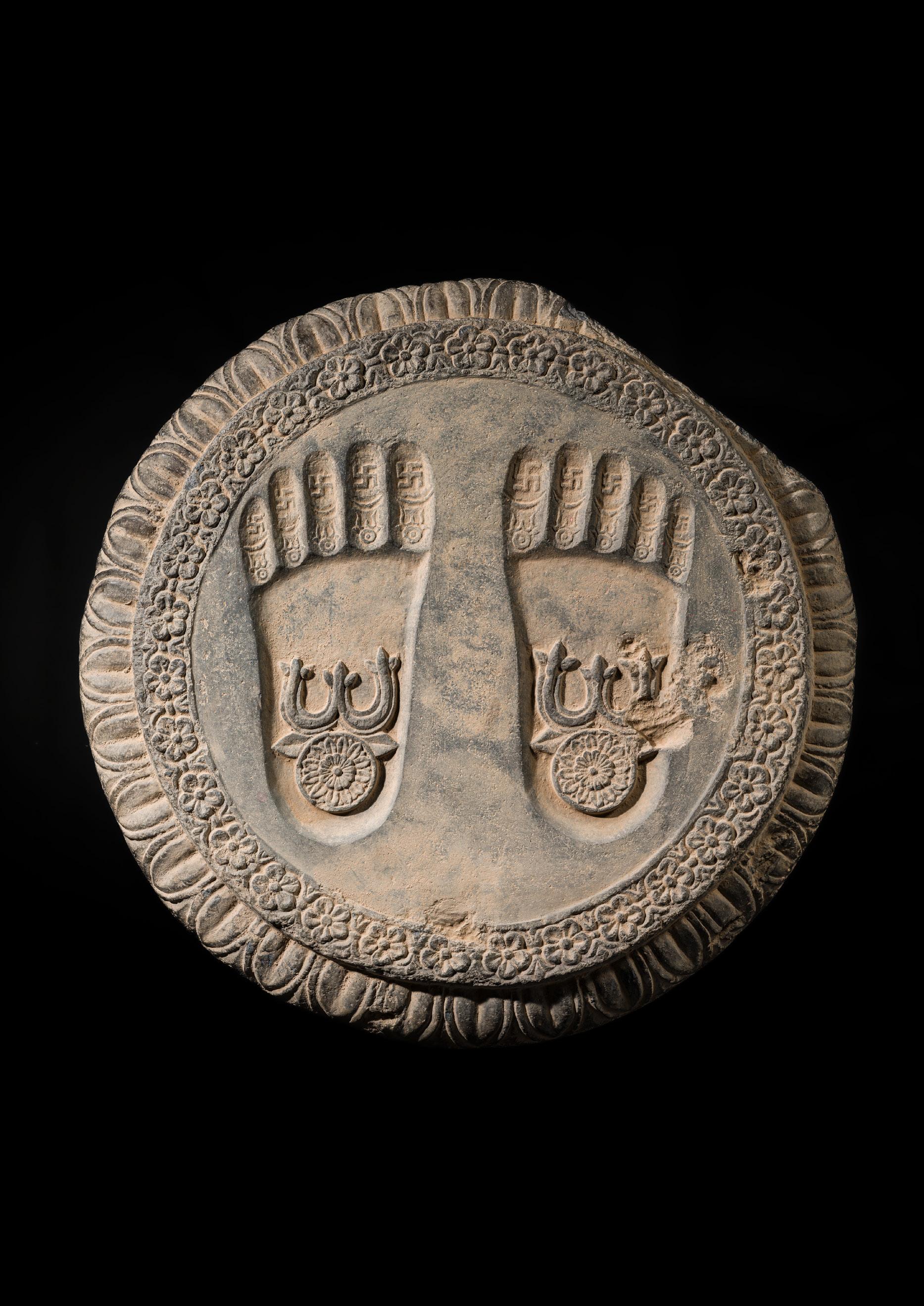
A MASSIVE SANDSTONE BUDDHAPADA, 19TH CENTURY OR EARLIER
India. The circular top raised on a footed octagonal base and carved in relief with an imprint of the Buddha’s feet, each centered by a chakra (wheel), the toes incised with two rows of scroll emblems.
Provenance: The Kienzle Family Collection, Stuttgart, Germany. Acquired between 1950 and 1985 by siblings Else (1912-2006), Reinhold (1917-2008), and Dr. Horst Kienzle (1924-2019), during their extensive travels in Asia. Subsequently inherited by Dr. Horst Kienzle and bequeathed to the Museum für Asiatische Kunst, Radevormwald, Germany. Released through museum deaccession in 2024.
Condition: Very good condition with expected wear, minor signs of weathering, surface scratches, small chips and losses to edges, remnants of adhesive. One row of the incised spirals later reworked.
Dimensions: Length 56.5 cm, Height 80.5 cm (incl. stand)
Mounted on a tall, black-lacquered wood stand. (2)

Depictions of the Buddhapada, or footprints of the Buddha, were one of the early aniconic symbols used to denote the presence of the Buddha. The historical Buddha was first revered through emblems that evoke his presence rather than through figurative images, as the Buddha himself professed the danger of attachment to icons in his own pursuit of enlightenment. Thus, the present aniconic symbol can be thought to represent the early, foundational principles of Buddhist philosophy and the Four Noble Truths.
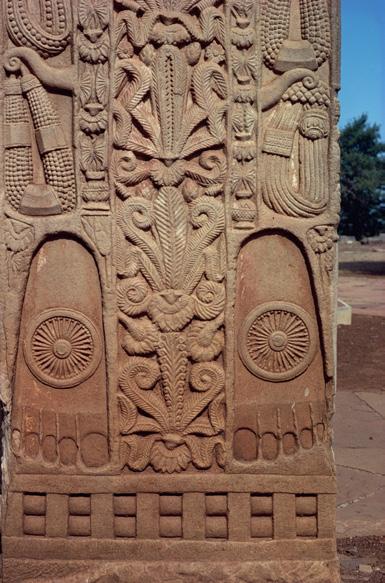
The Buddhapada in the present lot draws its inspiration from monumental examples such as those carved on the northern gateway of the renowned Great Stupa at Sanchi, Madhya Pradesh, one of the oldest surviving stone architectural structures in India, whose construction began in the 3rd century BC under the patronage of Emperor Ashoka and was intended as a grand funerary mound to enshrine and honor the relics of the Buddha following his death.
LITERATURE COMPARISON
Compare a Gandharan schist Buddhapada, dated 2nd-3rd century, 37 cm high, in the Lahore Museum, accession number G-124.
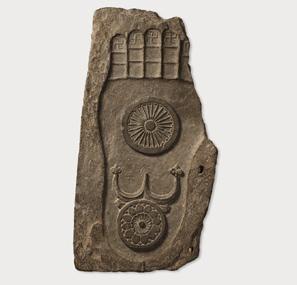
Estimate EUR 4,000
Starting price EUR 2,000
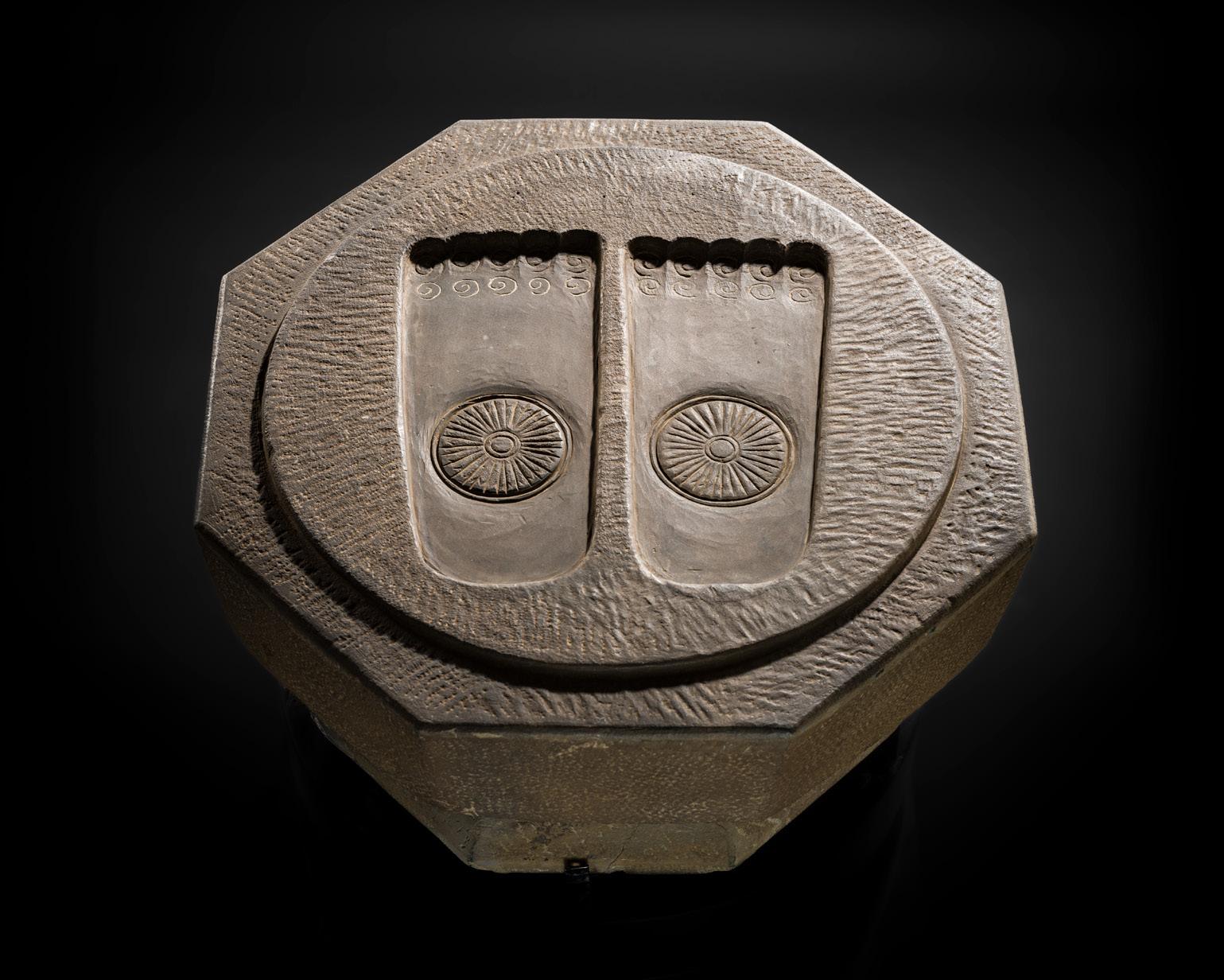
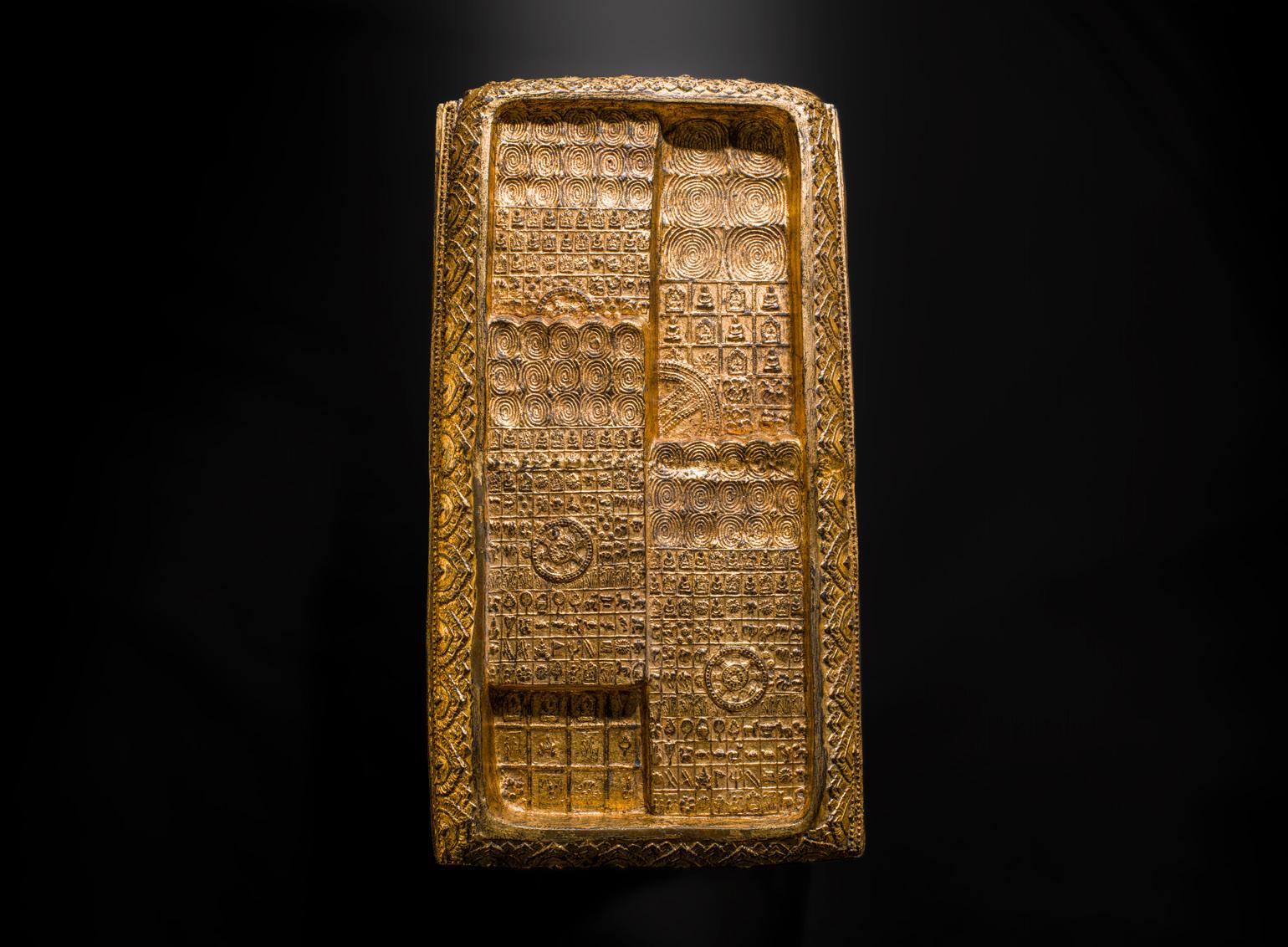
62 A GILT-LACQUER BRONZE SCULPTURE OF THE WALKING BUDDHA’S FOOTPRINTS, BUDDHAPADA, RATTANAKOSIN PERIOD
Thailand, reign of King Rama I-III, 1782-1851. The rectangular base cast with the foot imprints of the Walking Buddha, the soles centered by stylized sun emblems surrounded by rows of squares containing Buddhas, animals, flowers, and other emblems, the top with three rows of concentric circles symbolizing the prints of the toes. The borders tiered and decorated with floral borders and a wide band of upturned lotus petals.
Provenance: The Kienzle Family Collection, Stuttgart, Germany. Acquired between 1950 and 1985 by siblings Else (1912-2006), Reinhold (1917-2008), and Dr. Horst Kienzle (1924-2019), during their extensive travels in Asia. Subsequently inherited by Dr. Horst Kienzle and bequeathed to the Museum für Asiatische Kunst, Radevormwald, Germany. Released through museum deaccession in 2024.
Condition: Good condition with minor wear and casting irregularitites. Few minor losses. Little rubbing, light flaking, and minor losses to the gilt.
Dimensions: Length 105.3 cm
With a fitted stand on casters. (2)
These large bronze footprints are one of the aniconic representations of the Buddha, popular in the early days of Buddhism before depictions of the Buddha were known. The footprint of the Buddha represents the spreading of his teachings. This particular symbol was known in Thailand from the fifteenth century onwards.
LITERATURE COMPARISON
Compare a closely related sculpture of Buddha’s footprint, Burma, dated 18th-19th century, in the British Museum, museum number 1826,0211.2 (fig. 1). For an earlier example, see Jean Boisselier, La sculpture en Thailande, Fribourg, 1987, pl. 131. Carol Stratton illustrates a wood example in Buddhist Sculptures of Northern Thailand, Chiang Mai, 2004, p. 302. fig. 1
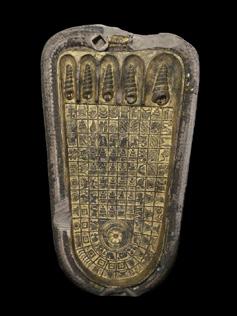
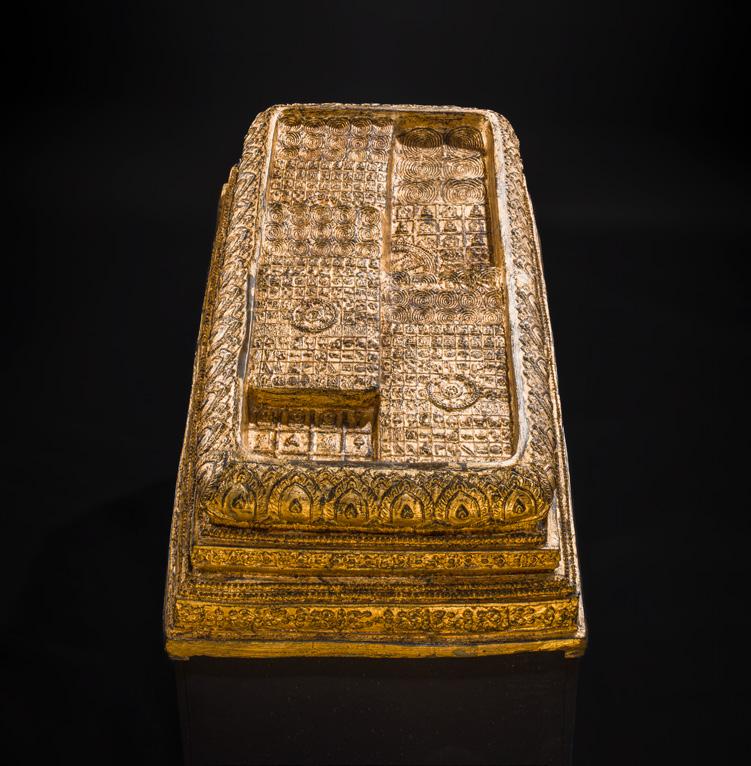
AUCTION RESULT COMPARISON
Type: Closely related
Auction: Christie’s London, 11 May 2016, lot 90
Price: GBP 2,500 or approx. EUR 4,500 converted and adjusted for inflation at the time of writing
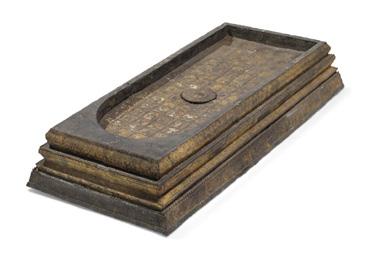
Description: A gilt and red-lacquered bronze Buddhapada (foot imprint of the Buddha), Thailand, Rattanakosin period, 19th century Expert remark: Compare the closely related form, design, manner of casting, and gilding. Note the different size (180 cm) and that only one footprint is depicted.
Estimate EUR 4,000
Starting price EUR 2,000
A RARE AND IMPORTANT SILVER-INLAID BRONZE
FIGURE OF MAITREYA, POST-GANDHARA, SWAT VALLEY OR KASHMIR, 6TH-7TH CENTURY
Finely cast standing in samabhanga on a circular lotus blossom atop a stepped square plinth, backed by an elaborate combined nimbus and aureole with radiating ovoid spokes tipped with a triratna motif. His right hand is raised and holding a mala (rosary), while the left is lowered and holds a small vase. He is framed by an elaborate mandorla, intricately worked with radiating flame motifs. He wears a tall conical crown, large circular earrings, and ornate jewelry, along with a pleated dhoti with a flowing tail and a scarf draped over one shoulder. The face is serene, with wide silver-inlaid eyes, thick eyelids, full lips, and elongated earlobes.
Provenance: Galerie Hardt (established in 1976), Radevormwald, Germany, before 2020. Acquired by the gallery’s founder Peter Hardt (b. 1946) during his extensive travels in Asia, the first of which occurred during a formative world tour in 1973.
Labels: Galerie Hardt, printed ‘stehender Buddha Bronze Kashmir, 12 Jh‘ (sic!), priced at EUR 12,750
Condition: Very good condition with minor wear and casting irregularities. Few minuscule nicks, some dents, and light scratches. A thick naturally-grown patina with areas of malachite encrustation.
Weight: 619 g
Dimensions: Height 19 cm
This impressive figure of Maitreya belongs to an extremely rare type of bronze figure cast in the regions of ancient Gandhara and the Swat Valley in the fifth through seventh centuries. The solidly cast bronze is a masterpiece of the Buddha image, illustrating the exquisite marriage of the contemporary Gupta style with the earlier influences of Hellenistic Gandhara.
During the Kushan period, Gandhara was a fervent center of Buddhism, with thousands of monasteries sprawled across the wide riverine plains and tucked away in the more remote valleys north of the Kabul River. The demand for images of the Buddha was great and the vast quantity of works in schist and stucco, and to a lesser degree terracotta and bronze, illustrates the rich artistic tradition of the region. The decline of the Kushans, however, precipitated the invasion of the Huns in the middle of the fifth century, and the peace and splendor of Gandhara was destroyed. Those that survived sought refuge in the remote valleys of Swat and the Hindu Kush, where Buddhism quietly endured until the invasion of Muslim forces in the tenth and eleventh centuries.
During the fifth through seventh centuries, the period referred to as Post-Gandhara, the production of large Buddhist works in stone and stucco declined, while the creation of smaller scale images in bronze reached a zenith. This phenomenon must be explained in part by the new conditions of Buddhist worship during this time; except for certain sites such as Bamiyan, the large and wealthy monasteries of the previous era had been replaced by smaller, migratory groups of worshipers. The Chinese pilgrim Xuanzang, who traveled to India in the first half of the seventh century, described the situation in Swat as follows: “There had formerly been 1400 monasteries but many of these were now in ruins, and once there had been 18,000 [Buddhist] Brethren but these had gradually decreased until only a few remained” (U. von Schroeder, Indo-Tibetan Bronzes, 1981, p. 72).
Buddhist adherents were pushed to the margins of society and could no longer afford to commission large and permanently installed works. Images in stucco were extremely fragile, while works in schist were too heavy to transport. Bronze, on the other hand, was durable, and when scaled down to a small size and cast in several parts, could be bundled up and carried from place to place. Despite the reduced size, the present work would no doubt have been an expensive and precious object of veneration.
The combined nimbus and aureole backplate of the present work is related to the small group of late Gandharan bronzes where the backplate has survived, but with an unprecedented flourish of details. Art historians have labeled the unusual radiating spokes as a pearl and oval pattern –a lozenge that extends from a single bead and terminates in three beads arranged in a triangle. The exact significance of the shape is unclear, although some have suggested the three beads may relate to the triratna, the ‘Three Jewels’ of Buddhism - the Buddha, the dharma, and the sangha (brotherhood of monks). The form is clearly related to the stucco halos found in niches in the caves of Bamiyan, dated to the late sixth and early seventh centuries, and it is partly through the connection of the two halo types that scholars have dated the corpus of the late Gandhara bronzes. The radiating spokes of the backplate provide a visual dynamism in its juxtaposition with the restrained pose of the Buddha and may represent the omnipotence of Buddha’s law.
LITERATURE COMPARISON
Compare a related larger bronze figure of a standing Buddha dated ca. late 6th century, 33.7 cm high, in the Metropolitan Museum of Art, object number 1981.188a, b.
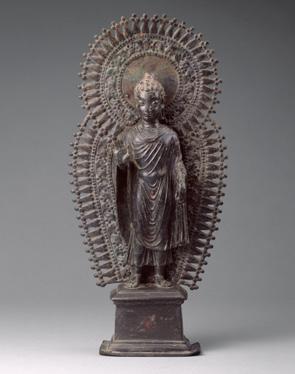
AUCTION RESULT COMPARISON
Type: Closely related
Auction: Christie’s New York, 20 March 2014, lot 1604
Price: USD 509,000 or approx. EUR 605,000 converted and adjusted for inflation at the time of writing
Description: A highly important and rare bronze figure of Buddha, Gandhara, 6th/7th century
Expert remark: Compare the closely related material, casting manner, aureole and size (22 cm).
Estimate EUR 8,000
Starting price EUR 4,000
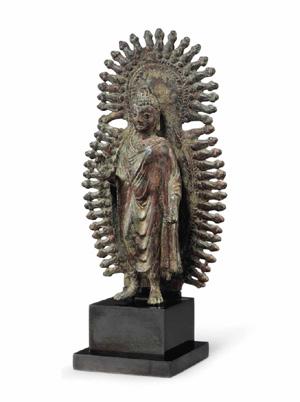

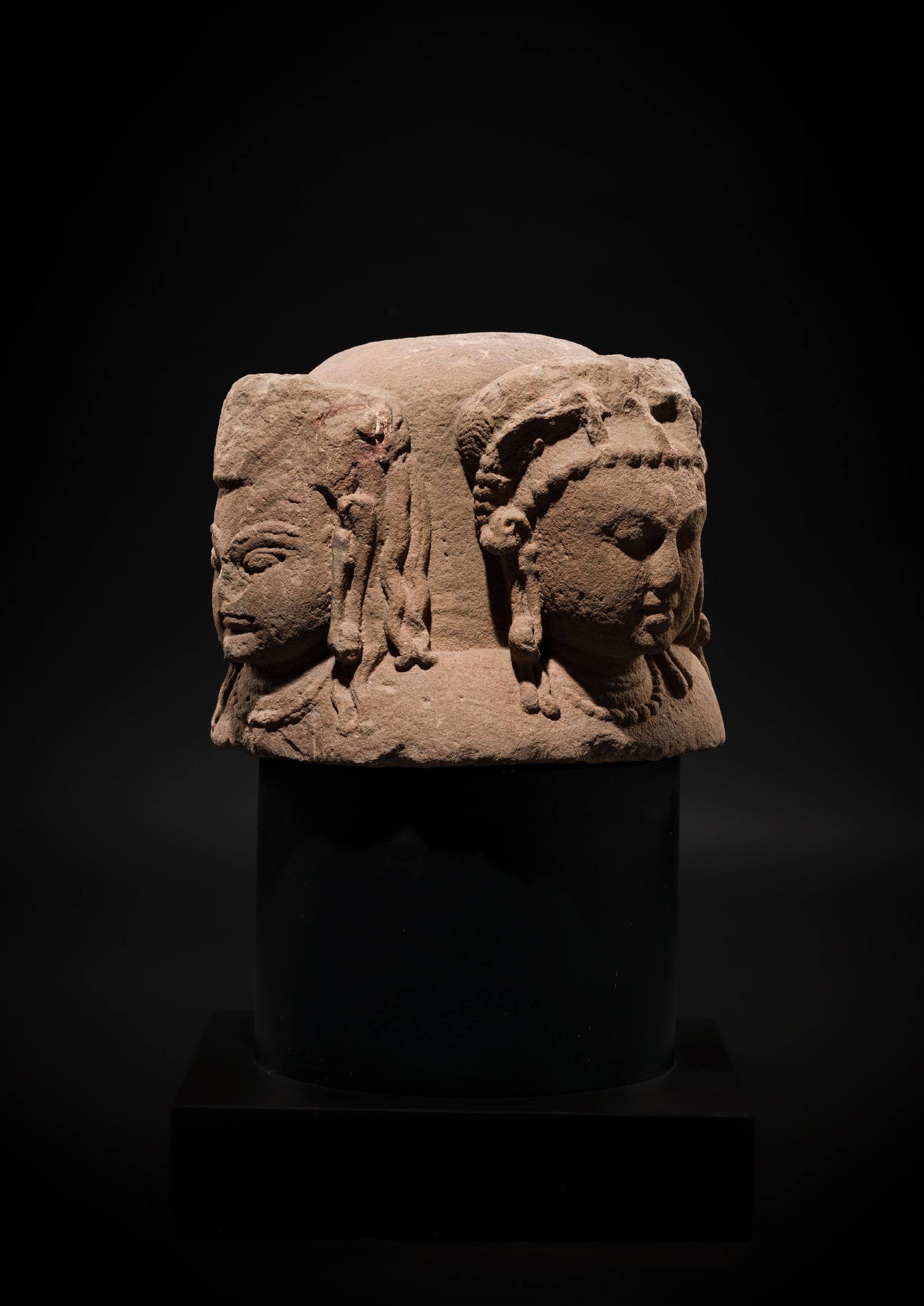
Northwestern India. Of columnar form, carved in high relief with the four heads of Shiva. Each face is finely carved with varying expressions, wide eyes under thick brows, centered by a tilak, and the hair fashioned in a jatamukuta, falling along the shoulders.
The central face represents Sadyojata as Mahadeva (benign); the right face, Aghora as Bhairava (fearsome); the left, Vamadeva as Uma, Shiva’s
Weight: 56 kg (incl. stand)
Dimensions: Height 26.5 cm (excl. stand) and 55 cm (incl. stand)
With an associated stand. (2)
In Shaiva mythology, Shiva’s multiple forms are represented as four or five heads on a linga, an iconography known as chaturmukha or panchamukha linga. These anthropomorphic forms allow devotees to see and be seen by Shiva.

65 A WHITE MARBLE CHATURMUKHA LINGAM, 8TH-10TH CENTURY
Northern India. Of columnar form, the smoothly polished surface carved in high relief above ribbed bands with the four heads of Shiva. The east face represents Mahadeva, carved with a serene expression, heavy-lidded eyes under arched brows centered by a third eye, adorned with bulbous earrings, the hair tied in a looped chignon, secured by a beaded band and further adorned with a headband centered by a trident; the west face representing Tatpurusha, who is similarly depicted, varying only in jewelry, wearing circular earrings and a headband centered by bull horns; the North face is Vamadeva whose similarly tied hair lacks adornments; and the fourth and south face is the wrathful Aghora as Bhairava, carved with a menacing expression, fang baring, and scornful eyes under furrowed brows centered by the third eye.
Provenance: The Kienzle Family Collection, Stuttgart, Germany. Acquired between 1950 and 1985 by siblings Else (1912-2006), Reinhold (1917-2008), and Dr. Horst Kienzle (1924-2019), during their extensive travels in Asia. Subsequently inherited by Dr. Horst Kienzle and bequeathed to the Museum für Asiatische Kunst, Radevormwald, Germany. Released through museum deaccession in 2024.
Condition: Good condition, commensurate with age. Wear, obvious losses, natural imperfections including age cracks and fissures, scattered nicks and scratches, small chips, encrustations, and signs of weathering and erosion. Small old repairs with associated touchups.
Weight: 41 kg (incl. stand)
Dimensions: Height 51 cm (excl. stand)
Mounted on an associated metal stand. (2)
In Shaiva mythology, Shiva’s multiple forms are represented as four or five heads on a linga, an iconography known as chaturmukha or panchamukha linga. To indicate the power of the god, a protective cobra may extend over Shiva’s head in some sculptures. These anthropomorphic forms allow devotees to see and be seen by Shiva.
The loose waves of hair along with the heavy-lidded almond-shaped eyes and narrow nose echo the visual apparatus of Gandhara, while the rounder facial features are informed by the Gupta style.
LITERATURE COMPARISON
Compare a related lingam with the head of Shiva dated to the 8th century, in the British Museum, registration number 1880.10.
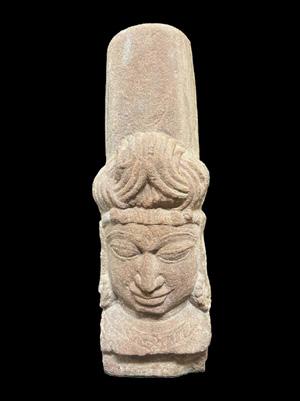
AUCTION RESULT COMPARISON
Type: Related
Auction: Bonhams New York, 19 March 2018, lot 3069
Price: USD 75,000 or approx. EUR 84,000 converted and adjusted for inflation at the time of writing
Description: A marble mukhalinga, Hindu Shahi, circa 9th century
Expert remark: Compare the related modeling and faces influenced by Gandhara and Gupta iconography. Note the smaller size (25.9 cm).
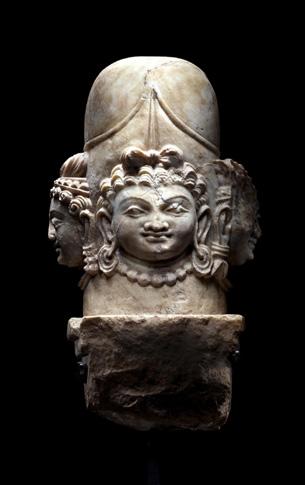
Estimate EUR 8,000
Starting price EUR 4,000
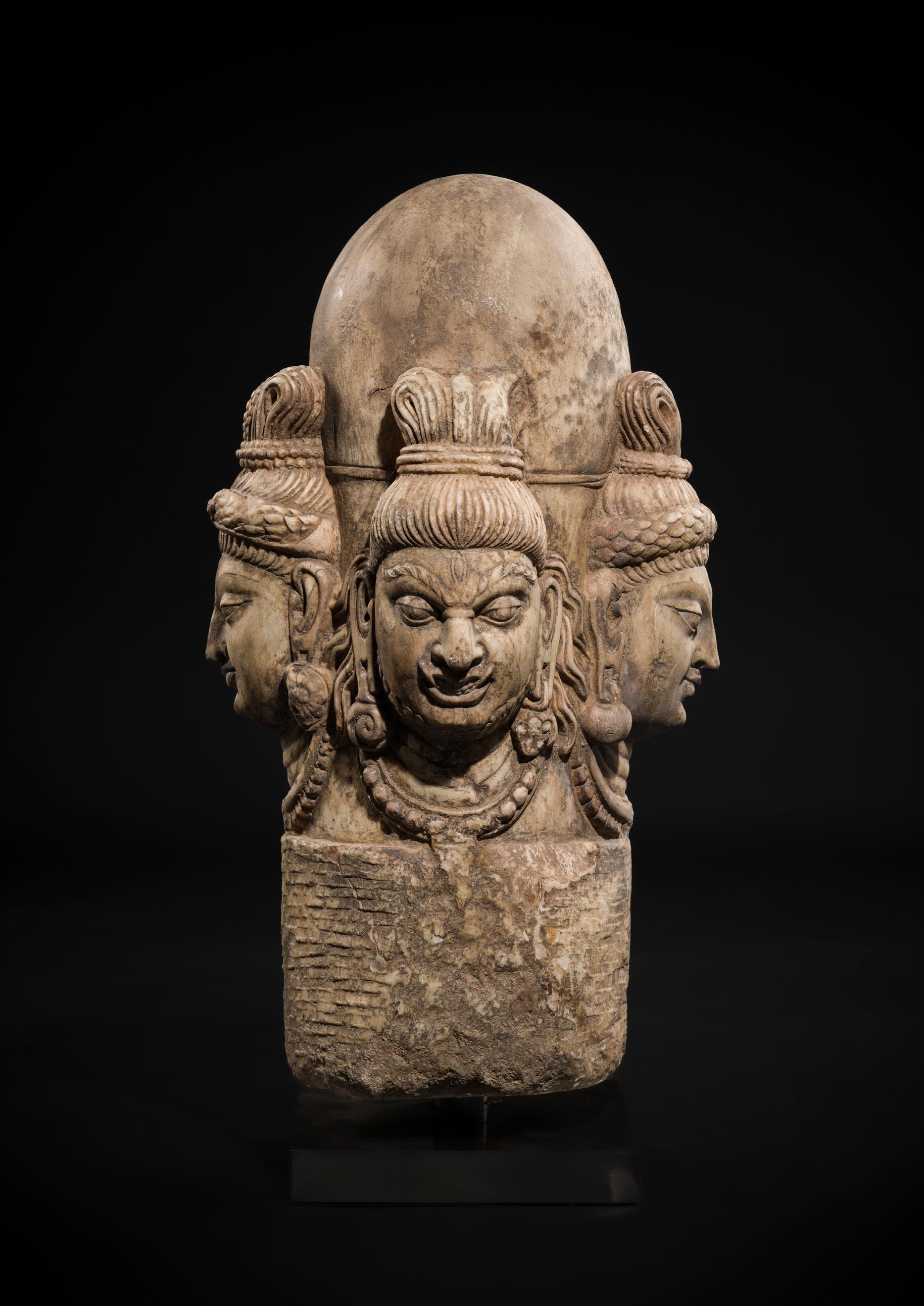
A LARGE SILVER-INLAID BRONZE
FIGURE OF THE CROWNED BUDDHA, KASHMIR, 9TH-10TH CENTURY
Finely cast standing in a slight tribhanga atop a flat circular base, the right hand lowered in varadamudra and the left raised holding the folds of his diaphanous sanghati. The deity adorned with beaded foliate jewelry, the serene face with full lips, downcast eyes and gently arched brows, centered by a raised urna, and flanked by ears with large foliate earrings. The hair pulled up into an elegant chignon behind the tall foliate crown. The bronze with a naturally grown dark patina with scattered malachite encrustations.
Provenance: Galerie Hardt (established in 1976), Radevormwald, Germany, before 2020. Acquired by the gallery’s founder Peter Hardt (b. 1946) during his extensive travels in Asia, the first of which occurred during a formative world tour in 1973.
Condition: Very good condition, commensurate with age and material. Surface wear, casting flaws, minor abrasions, dents, and scratches throughout, with evidence of natural weathering, oxidation, corrosion, and mineral accretions. Microscopic traces of original fire gilding are still visible. The reverse shows minor areas of restoration and infill. The base appears to be a later addition, as indicated by soldering seams and subsequent repairs. The naturally grown patina is particularly notable, exhibiting complex tonal variations in malachite green and black, indicative of longterm burial or exposure. The silver inlays remain largely intact, typical of this group.
Weight: 5,591 g
Dimensions: Height 44.3 cm
The Buddha is usually depicted in a monk’s simple garments; however, when he wears rich jewelry and a crown, he evokes the special form of Buddha as a cakravartin, or universal monarch. In Kashmir this form also recalls the splendor of the Buddha in heaven, where he reveals himself to the bodhisattvas. Both the high diadem and tasseled cape reflect Central Asian influence on Kashmiri Buddhist art of this period.
LITERATURE COMPARISON
Compare a closely related Kashmir brass figure of the crowned Buddha, 51.8 cm high, dated to the 9th century, in the Metropolitan Museum of Art, object number 1970.297.
Estimate EUR 10,000
Starting price EUR 5,000
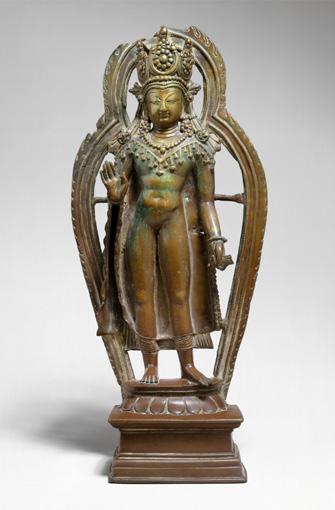
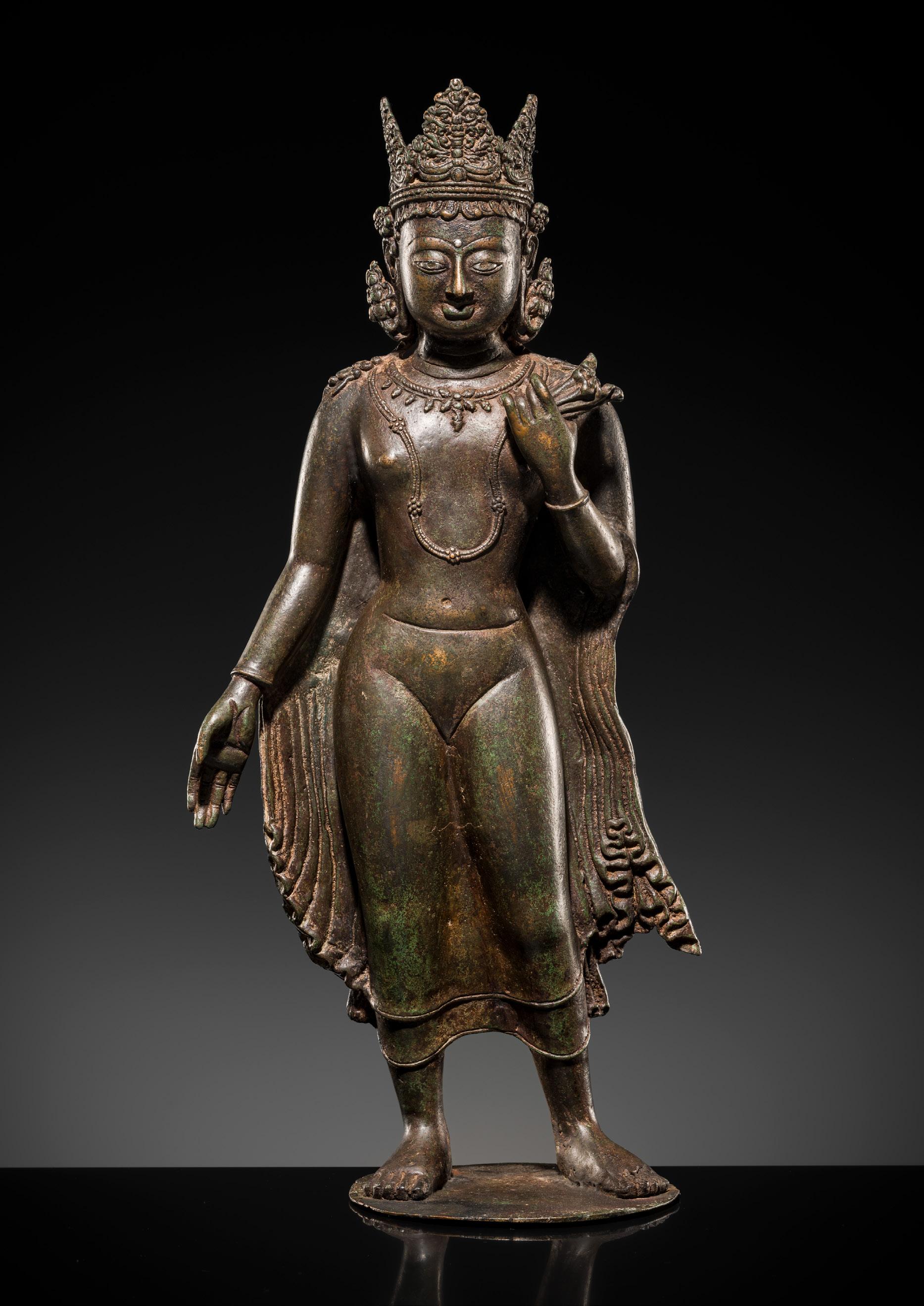
The multi-armed goddess beautifully modeled with one foot atop the buffalo as her lion mount bites into his hindquarters, her face with a beatific smile as she pierces the demon with a trident just as he emerges from his animal form, the demon’s decapitated buffalo head to her foot. Her arms fanning out holding various attributes. The face dominated by wide eyes, the deity heavily adorned with jewelry, all raised on a tall base and flanked by adorant figures and deities.
Provenance: The Kienzle Family Collection, Stuttgart, Germany. Acquired between 1950 and 1985 by siblings Else (1912-2006), Reinhold (1917-2008), and Dr. Horst Kienzle (1924-2019), during their extensive travels in Asia. Subsequently inherited by Dr. Horst Kienzle and bequeathed to the Museum für Asiatische Kunst, Radevormwald, Germany. Released through museum deaccession in 2024.
Condition: Very good condition, commensurate with age.
Extensive wear, obvious losses, structural fissures, signs of weathering and erosion, encrustations, scattered nicks and scratches, small chips.
Dimensions: Height 101.5 cm (excl. stand), 103 cm (incl. stand)
Mounted on an associated stand. (2)
Mahishasura was a pious devotee to Brahma and was rewarded with a boon that no man or god would be able to conquer him. Thus invincible, he battled the gods and took over the heavens. Helpless against Brahma’s boon, the gods appealed to the goddess Parvati, who agreed to harness the shakti of all female celestial beings to fight Mahishasura. She assumed the form of Durga and borrowed weapons from each god. After nine days of fighting, she vanquished Mahishasura and his army and restored the heavens to the gods.
This sculpture depicts the final moments of the duel between the goddess and the demon. Durga stands on the buffalo as she plunges her trident into the animal to pull the demon out from the neck and send him to the netherworlds. Her lion prepares to bite into the rump for good measure.
The worship of a mother goddess as the source of life and fertility has ancient roots, but the composition of the text Devi Mahatmya (“Glory of the Goddess”) during the fifth to sixth century led to the dramatic transformation of the female principle into a Great goddess of cosmic powers. Durga is the cosmic Magna Mater, and this popular iconic type encapsulates the struggle between the goddess and the demon Mahishasura, who symbolizes ignorance, disorder, chaos, and evil. Later textual sources generally refer to the subject as Mahishasuramardini, or “killer of the buffalo demon.” She remains the most important and popular form of the great goddess known generically as Devi or Shakti.
AUCTION RESULT COMPARISON
Type: Closely related
Auction: Sotheby’s New York, 1 April 2005, lot 32
Price: USD 20,000 or approx. EUR 28,500 converted and adjusted for inflation at the time of writing
Description: Durga, sandstone, Central India
Expert remark: Compare the closely related modeling, manner of carving, and subject. Note the much smaller size (76.8 cm).
Estimate EUR 12,000
Starting price EUR 6,000
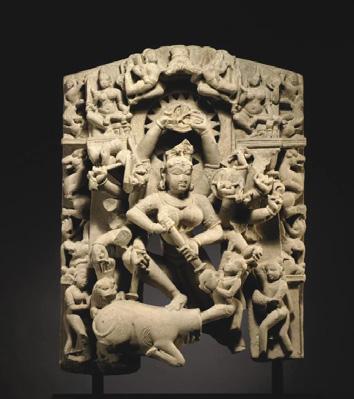
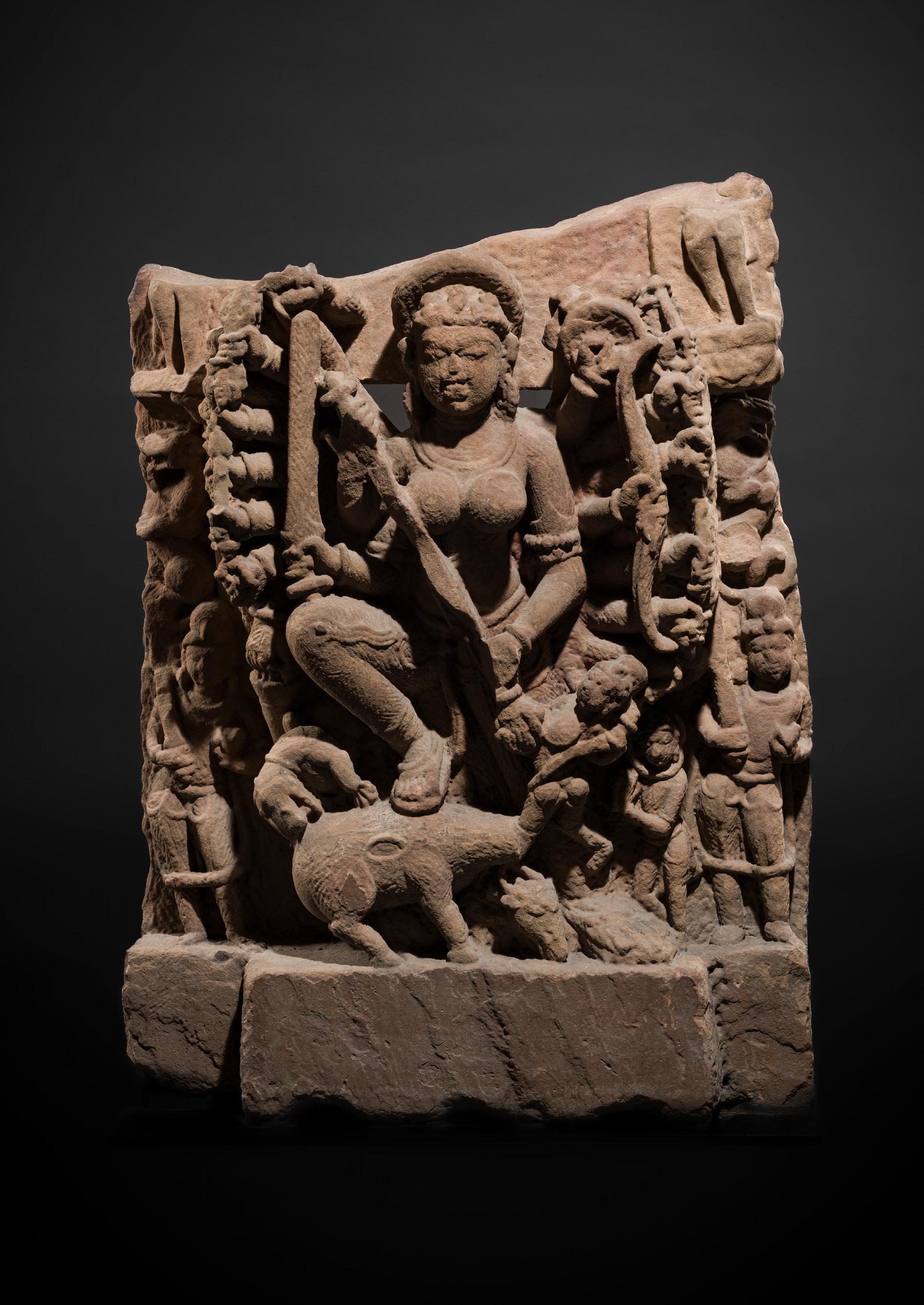
A RARE AND IMPORTANT BLACK STONE STELE OF BUDDHA PREACHING THE FIRST SERMON AT SARNATH, PROBABLY RATNAGIRI, 9TH-12TH CENTURY
Exhibited: Hardt & Sons, Arts of Pacific Asia Show, Asia Week New York, 22-25 March 2007.
Eastern India, Orissa. Exquisitely carved, seated in dhyanasana atop a double lotus base supported on a stepped pedestal centered by a diminutive image of Buddha Amitabha flanked by lions and worshipers within columned niches above two deer surrounded by ritual objects, and backed by an openworked foliate arch supported on two pillars and topped by three leafy branches, flanked by four bohisattvas seated in lalitasana below two garland-bearing vidyadharas.
The Buddha’s hands are raised to his chest and held in dharmachakra mudra, and he is dressed in a sheer sanghati with the folds piled below the ankles, the face with a serene expression with heavy-lidded downcast eyes below arched brows and pursed lips forming a gentle smile, flanked by long pendulous earlobes, the hair in tight curls over the prominent ushnisha.
The four bodhisattvas can be identified as Avalokiteshvara in the upper right by the small image of Amitabha in his crown, above Manjushri with the book of wisdom, the left side with Vajrapani holding a vajra and Maitreya with a bunch of nagakesara flowers.
Provenance: The Kienzle Family Collection, Stuttgart, Germany. Acquired between 1950 and 1985 by siblings Else (1912-2006), Reinhold (1917-2008), and Dr. Horst Kienzle (1924-2019), during their extensive travels in Asia. Subsequently inherited by Dr. Horst Kienzle and bequeathed to the Museum für Asiatische Kunst, Radevormwald, Germany. Released through museum deaccession in 2024.
Condition: Good condition, commensurate with age. Old wear, obvious losses, structural fissures, scattered chips, small nicks, signs of weathering and erosion, encrustations. The stone with a fine, naturally grown, lustrous patina.
Dimensions: Height 80 cm
This stele is a refined example of Orissan sculpture, bearing close affinity to the Pala style. Distinctive Orissan features include the trefoil arch and the flat and paper-like lotus petals of the base. The present sculpture closely resembles a black stone stele excavated from the famed monastic site of Ratnagiri (see literature comparison). Both works feature the Buddha seated in full yogic position with hands held in dharmachakra mudra, flanked by four bodhisattvas in lalitasana, beneath a leafy arch populated by vidyadharas, and supported by a base with lions and devotees. The iconographic and stylistic parallels, particularly the modeling of the body, the openworked arch, and the tiered doublelotus base, strongly support an origin in Ratnagiri or a closely associated workshop.
Ratnagiri was a major center of Buddhist learning and tantric practice between the 7th and 12th centuries CE. While under the cultural orbit of the Pala Empire, Ratnagiri was directly patronized by regional rulers such as the Bhauma-Kara and Somavamshi dynasties, who supported Vajrayana institutions and commissioned richly carved stelae such as this
one. The combination of Pala-influenced sculptural idioms, as seen in the soft modeling and elaborate composition, with distinctively local Odishan features situates this piece securely within that context.
The Buddha preaching his first sermon in a deer forest at Sarnath, north of Bodhgaya, where he had experienced enlightenment some weeks prior, is a popular subject in medieval Indian art. This moment, known as the Dharmachakra Pravartana or Turning of the Wheel of the Law, marks the foundation of the Buddhist sangha and the beginning of the Buddha’s teaching career. The presence of this iconography in Ratnagiri’s sculptural corpus suggests its importance not only as a doctrinal reference but also as a visual embodiment of Ratnagiri’s own role as a center of Buddhist transmission and instruction.
LITERATURE COMPARISON
Compare a closely related stele depicting the same subject dated to the 10th century in the Ratnagiri Archeological Museum, Odisha, and illustrated by the Western Himalaya Archive Vienna, no. 22 (fig. 1). Compare a related Pala stele depicting the same subject, dated to the 11th century, 61.6 cm high, in the Metropolitan Museum of Art, object number 20.43. Compare a related stele of Buddha and the Eight Great Events from his life, dated to the Pala period, 9th century, 51.5 cm high, in the British Museum, registration number 1872,0701.24.
COMPARISON
Type: Closely related Auction: Christie’s New York, 13 September 2011, lot 268 Price: USD 86,500 or approx. EUR 106,000 converted and adjusted for inflation at the time of writing
Description: A black stone stele of seated Buddha, Northeastern India, Pala period, circa 10th century
Expert remark: Compare the closely related subject and similar modeling and expression. Note the much smaller size (63.5 cm).
Estimate EUR 30,000
Starting price EUR 15,000

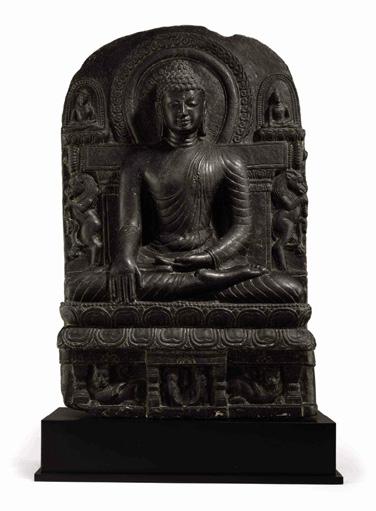
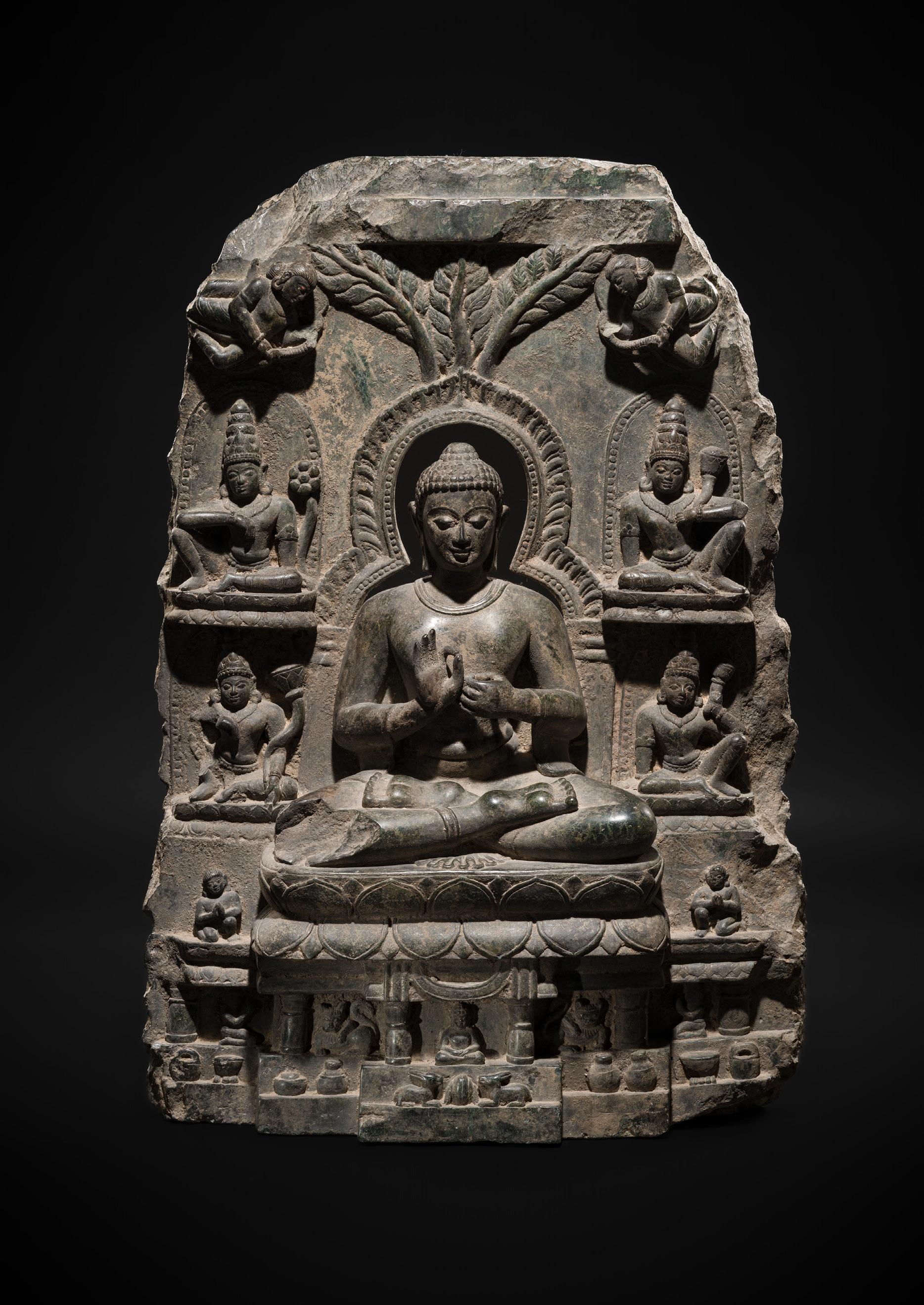
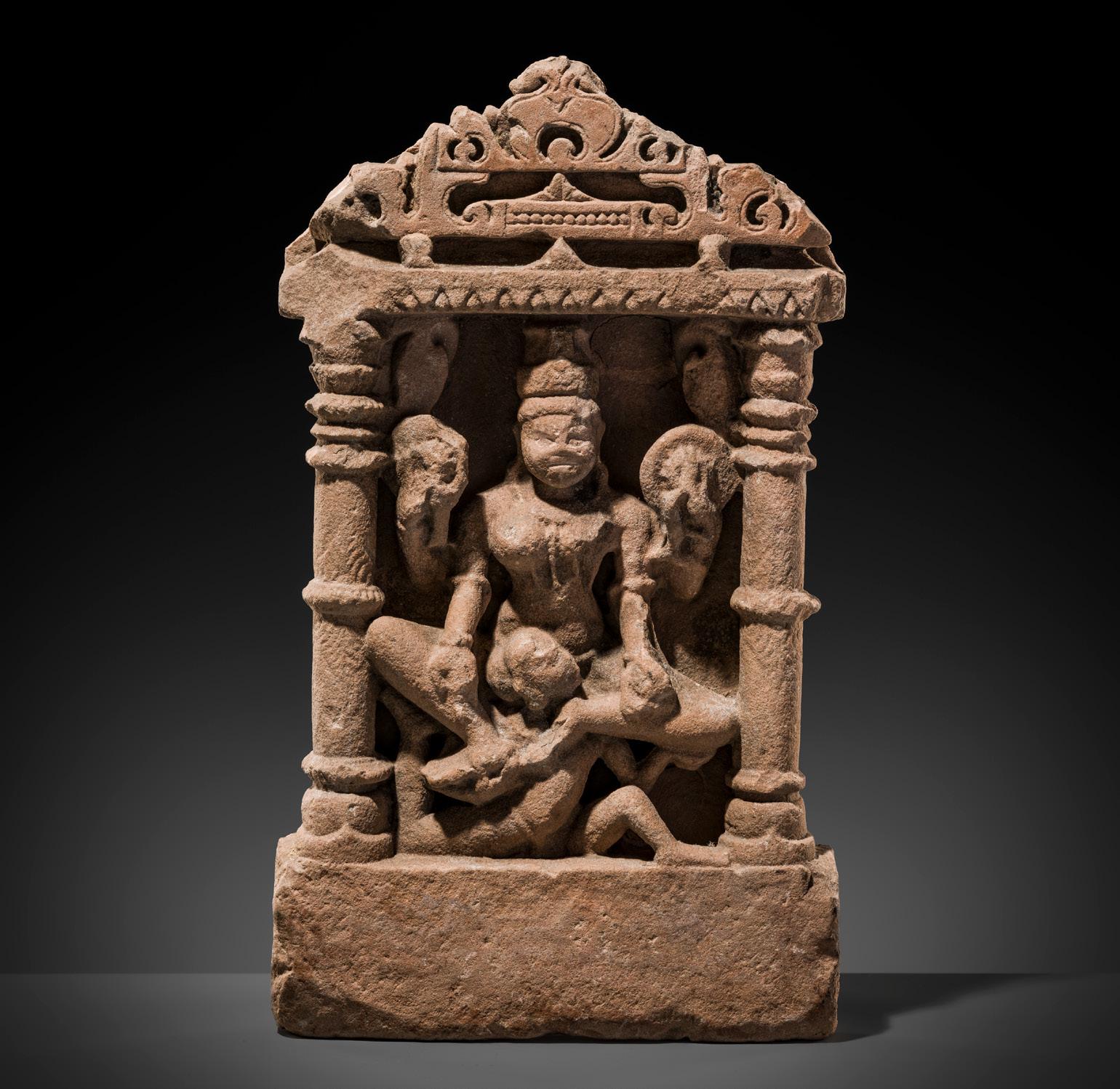
69
A BUFF SANDSTONE RELIEF PANEL OF VAIKUNTHA KAMALAJA ATOP GARUDA, CENTRAL INDIA, 10TH-12TH CENTURY
Finely carved in relief within a recessed niche, the four-armed deity sits in lalitasana atop his vahana, Garuda. His primary hands, lowered in varada mudra, while his secondary arms are raised, clutching a disc and conch, all framed beneath a tiered shikhara.
Provenance: The Kienzle Family Collection, Stuttgart, Germany. Acquired between 1950 and 1985 by siblings Else (1912-2006), Reinhold (1917-2008), and Dr. Horst Kienzle (1924-2019), during their extensive travels in Asia. Subsequently inherited by Dr. Horst Kienzle and bequeathed to the Museum für Asiatische Kunst, Radevormwald, Germany. Released through museum deaccession in 2024.
Condition: Good condition, commensurate with age. Old wear, obvious losses, nicks and scratches, small chips, encrustations, signs of weathering and erosion. Two small sections in the background with old repairs.
Weight: 4,977 g
Dimensions: Height 37.5 cm
Vaikuntha-Kamalaja (or Lakshmi-Narayana) is a composite androgynous form of the Hindu god Vishnu and his consort Lakshmi. VaikunthaKamalaja is a rare form, mostly restricted to Nepal and the Kashmir region of India. Like Ardhanarishvara, Vaikuntha-Kamalaja is depicted as half male and half female, split down the middle. The iconography symbolizes the oneness or non-duality of male and female principles of the universe. Vaikuntha-Kamalaja is mentioned in few Tantric and iconographical texts.
LITERATURE COMPARISON
Compare a related buff sandstone relief depicting Vishnu atop Garuda, Central India, 50.2 cm high, at Sotheby’s New York, 24 March 2004, lot 34. Compare a related buff sandstone relief in the City Palace Museum, Udaipur (fig. 1). For an Indian bronze figure depicting the same subject, see Himalayan Art Resources, item number 24136.
AUCTION RESULT COMPARISON
Type: Related
Auction: Bonhams New York, 11 September 2012, lot 48
Price: USD 6,000 or approx. EUR 7,300 converted and adjusted for inflation at the time of writing
Description: A red sandstone relief panel of Shiva, central India, circa 11th century

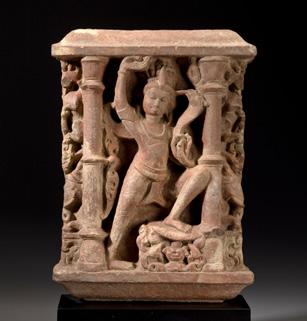
Expert remark: Compare the related composition and manner of carving with similar pillars on either side of the main figure. Note the size (43 cm).
Estimate EUR 1,000 Starting price EUR 500

LITERATURE COMPARISON
Finely cast, the central four-armed deity standing on a lotus base over a plinth, holding a lotus bud, mace, chakra and conch in his four hands, dressed in a short dhoti and adorned with various necklaces and garlands, the oval head surmounted by a cylindrical headdress, backed by a an openworked throneback. Vishnu is attended by his two consorts, the goddess of poetry and music Sarasvati and the goddess of fortune Lakshmi, as well as devotees and donors below.
Provenance: Galerie Hardt (established in 1976), Radevormwald, Germany, before 2020. Acquired by the gallery’s founder Peter Hardt (b. 1946) during his extensive travels in Asia, the first of which occurred during a formative world tour in 1973.
Condition: Good condition, commensurate with age. Extensive wear, obvious losses, some warping, and rubbing predominantly from centuries of worship within the culture. The bronze with a smooth, naturally grown, dark patina.
Weight: 177 g
Dimensions: Height 10.6 cm
Compare a closely related brass Vishnu triad, dated to the 12th century, 15.5 cm high, illustrated by M. Postel, A. Neven, and K. Mankodi, Antiquities of Himachal, 1985, p. 131, fig. 177 (fig. 1). Compare a related bronze figure of Ganesha, Himachal Pradesh, 12th century, 17.1 cm high, in the Museum Rietberg, Zurich, inventory number 2005.13, previously sold at Christie’s New York, 31 March 2005, lot 98 (sold for USD 11,400 or approx. EUR 16,000 converted and adjusted for inflation at the time of writing). fig. 1
AUCTION RESULT COMPARISON
Type: Closely related
Auction: Christie’s New York, 19 March 2014, lot 1086
Price: USD 9,375 or approx. EUR 11,000 converted and adjusted for inflation at the time of writing
Description: A brass altar of Vishnu, Himachal Pradesh, circa 12th century
Expert remark: Compare the closely related modeling, manner of casting, and subject. Note the different size (22.6 cm).
Estimate EUR 1,000
Starting price EUR 500
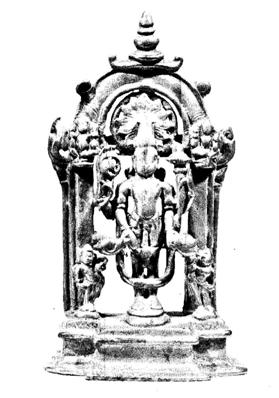
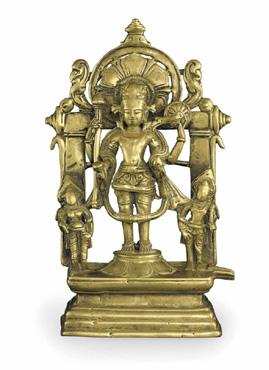
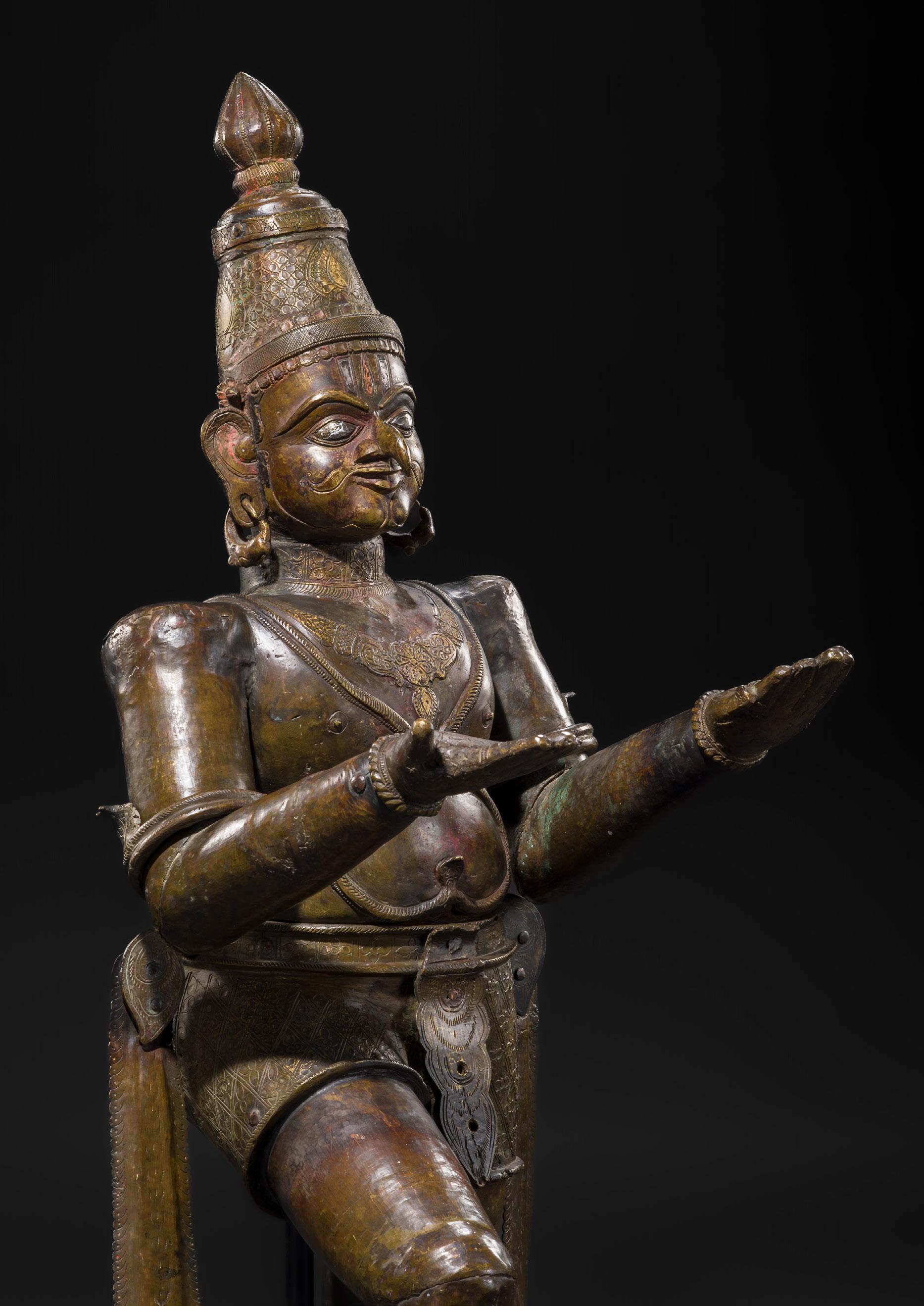
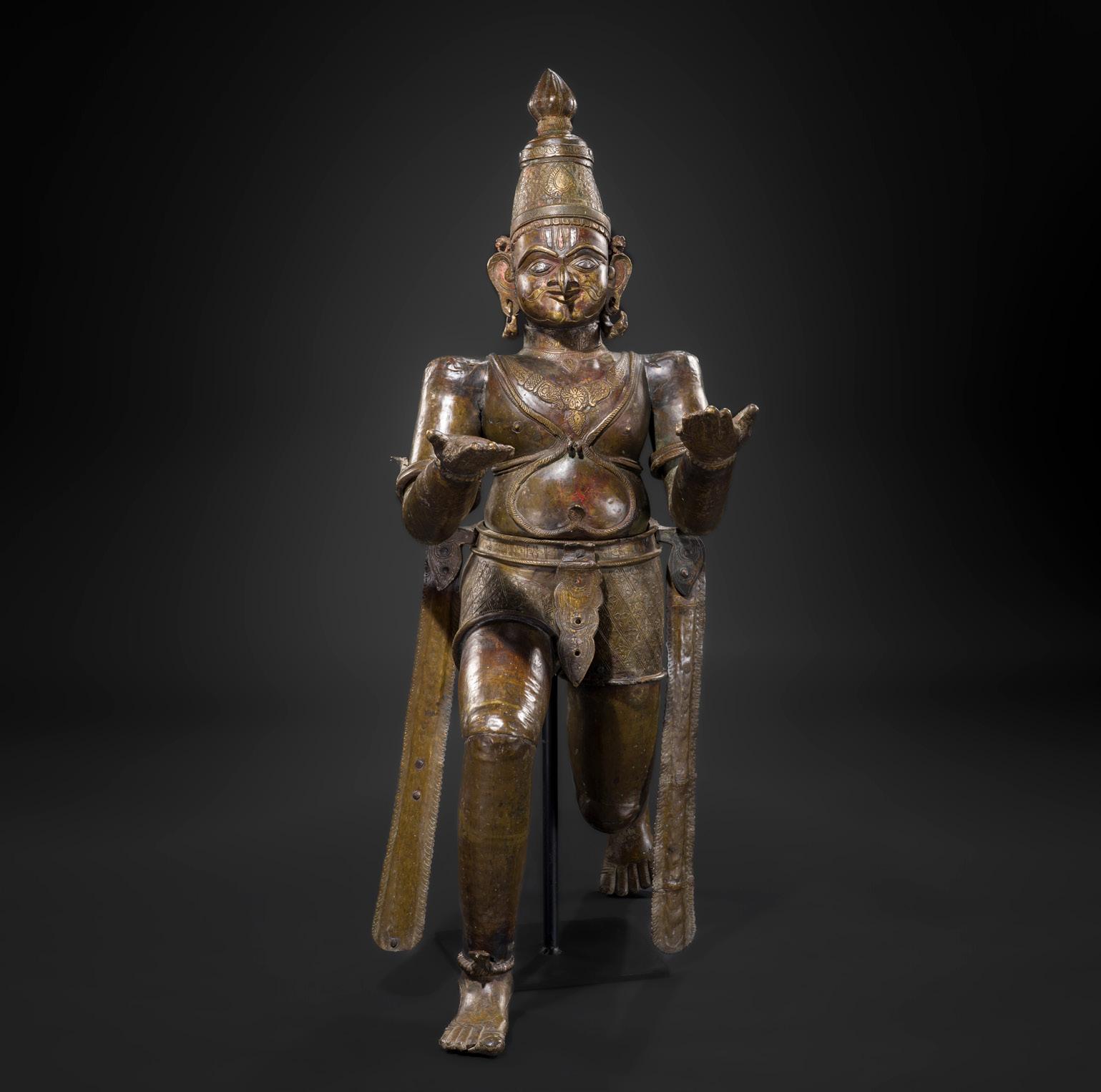
A FINE AND VERY LARGE (113 CM HIGH) SILVER AND COPPER-INLAID BRONZE FIGURE OF GARUDA, SOUTH INDIA, 17TH-18TH CENTURY
Superbly cast, this large, muscular bronze figure is shown in a powerful kneeling posture, one leg bent beneath him, arms outstretched in reverence. The deity is simply clad in a short langot (loincloth) and adorned with snake-form jewelry. His bearded face is fiercely expressive, with bulging silver-inlaid eyes beneath arched brows, centered by a tilak inlaid with copper and silver. A hooked nose and gently pursed lips form a calm, subtle smile. Flanking the face are wing-shaped ears, each suspending a loose earring in the form of a mythical beast. His hair is arranged in a tiered, conical chignon rising behind a foliate tiara.
Provenance: The Kienzle Family Collection, Stuttgart, Germany. Acquired between 1950 and 1985 by siblings Else (1912-2006), Reinhold (1917-2008), and Dr. Horst Kienzle (1924-2019), during their extensive travels in Asia. Subsequently inherited by Dr. Horst Kienzle and bequeathed to the Museum für Asiatische Kunst, Radevormwald, Germany. Released through museum deaccession in 2024.
Condition: Overall good condition. Wear, manufacturing irregularities, small losses, rubbing, tiny dings, scattered nicks and scratches, and signs of weathering. Expected losses and rubbing to inlays. Remnants of ancient pigment. Old repairs and touchups. Presenting exceptionally well.
Dimensions: Height 113 cm
With an associated metal stand. (2)
LITERATURE COMPARISON
Compare a related gilt wood figure of Garuda, Tamil Nadu, dated to the 19th century, in the National Museum, New Delhi. Compare a related bronze figure of Hanuman in the National Craft Museum, New Delhi.
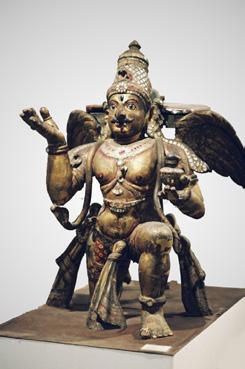
AUCTION RESULT COMPARISON
Type: Related
Auction: Christie’s New York, 18 September 2013, lot 253
Price: USD 30,000 or approx. EUR 36,000 converted and adjusted for inflation at the time of writing
Description: A bronze figure of Garuda, North India, Himachal Pradesh, 15th-16th century
Expert remark: Compare the closely related subject and similar modeling of the tall chignon and hooked nose. Note the smaller size (47.8 cm) and lack of inlays.
Estimate EUR 16,000
Starting price EUR 8,000
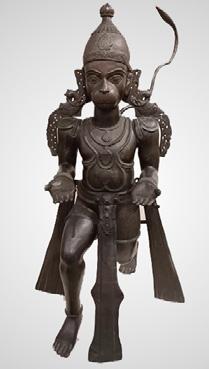
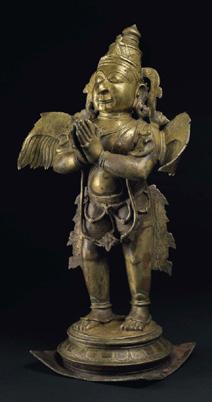
Two passports of Peter Hardt documenting his world tour on a bicycle –note that the second passport was issued in Jakarta, Indonesia during the trip
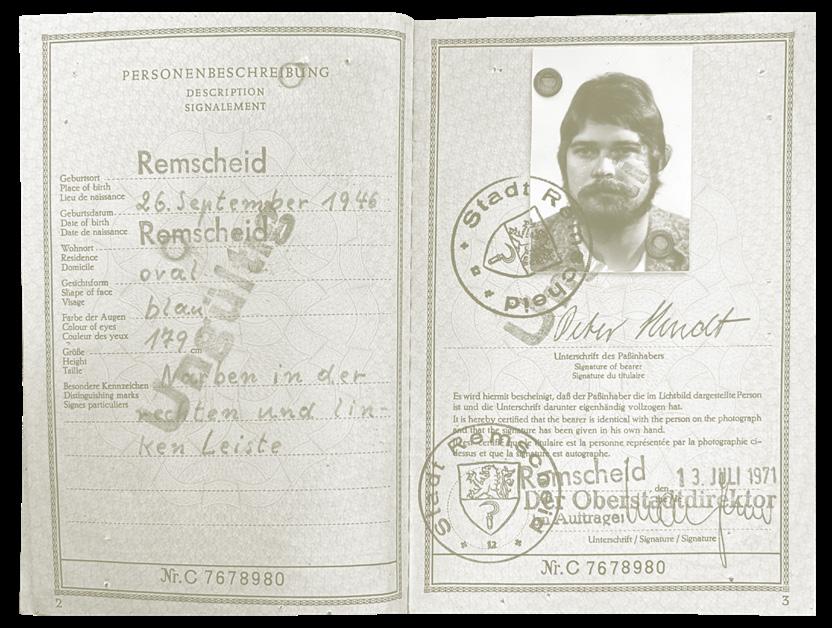


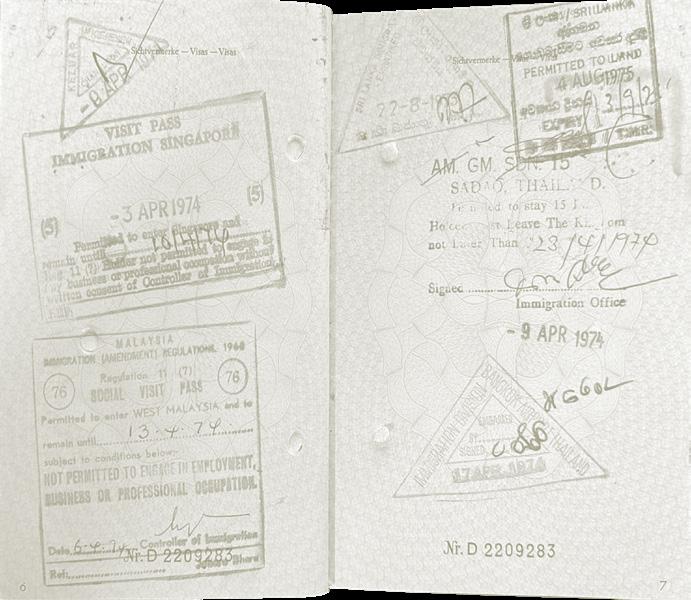
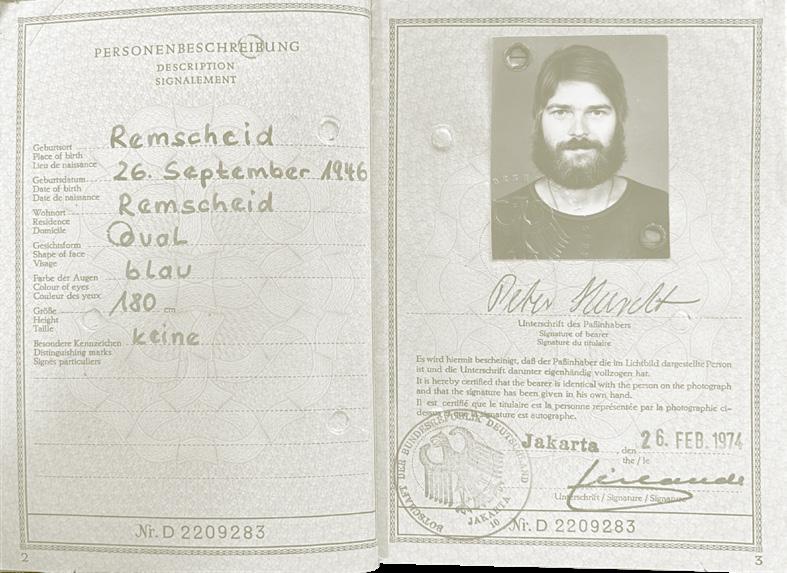
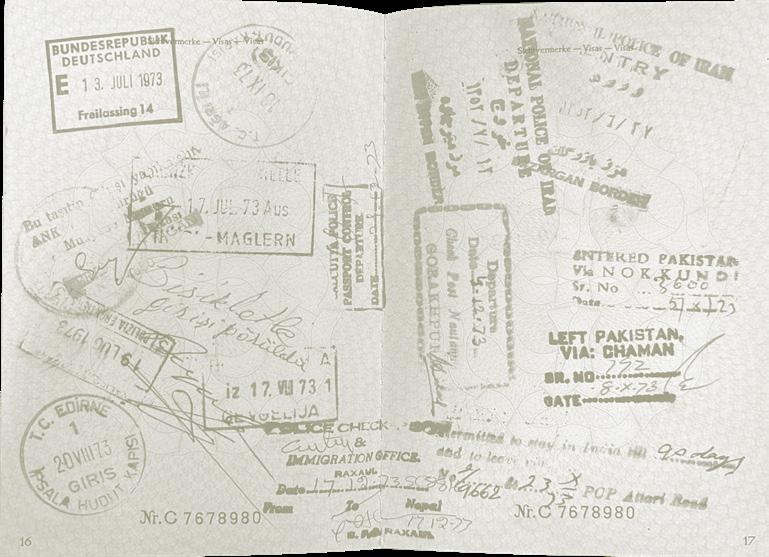
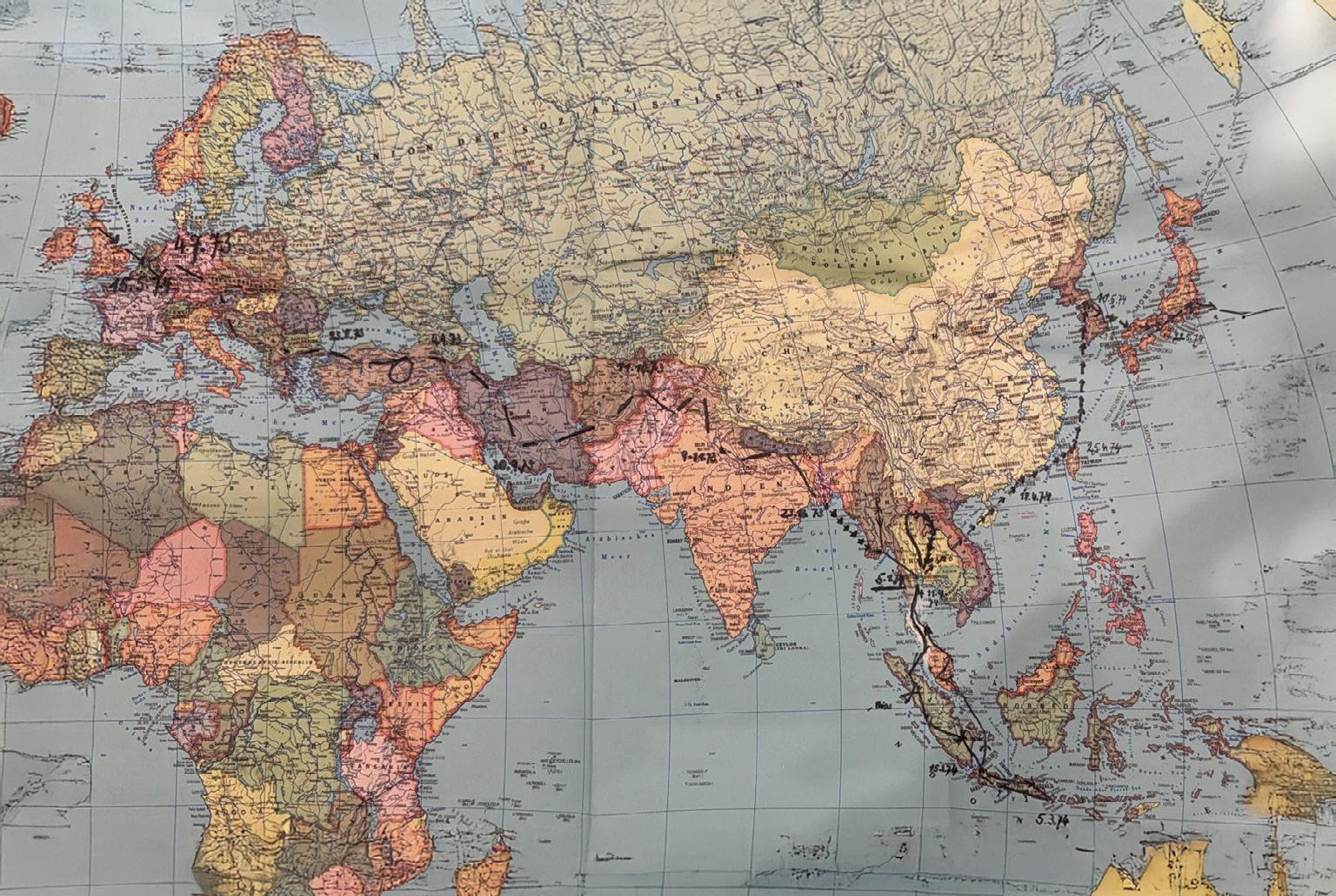

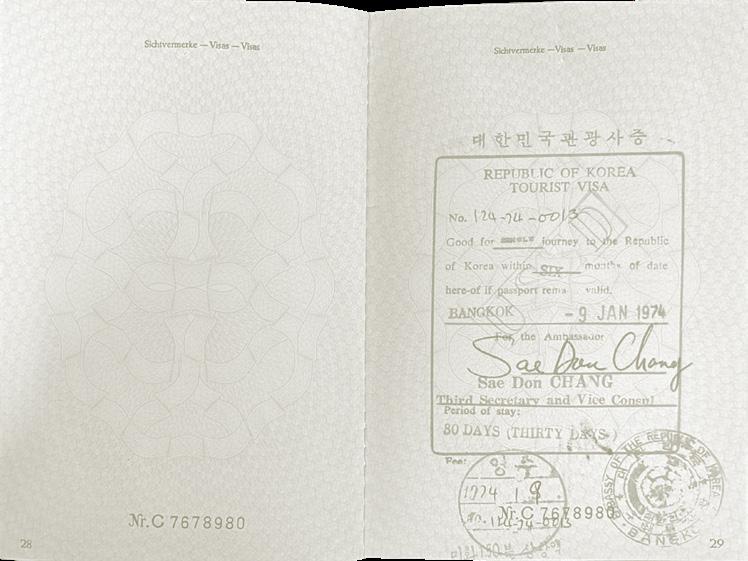
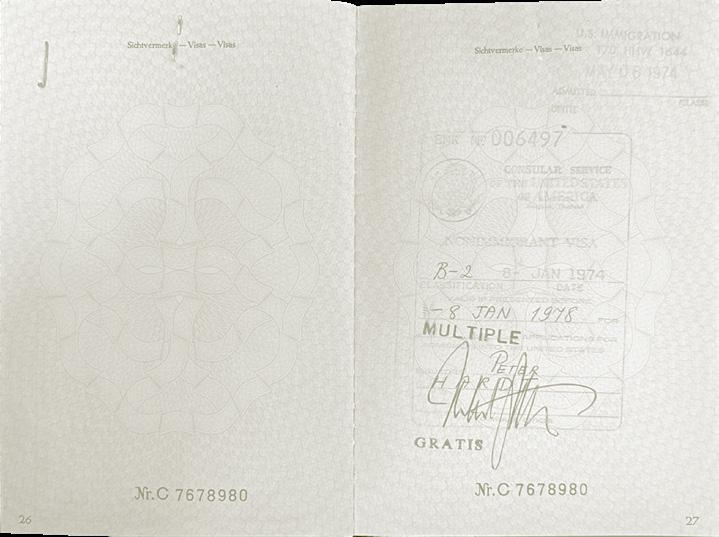


The route of Ingrid and Peter Hardt’s 1973-1974 journey
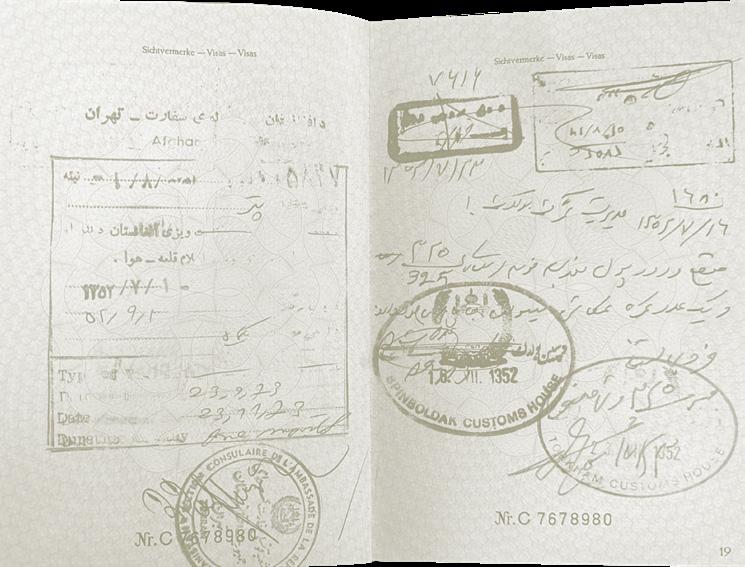
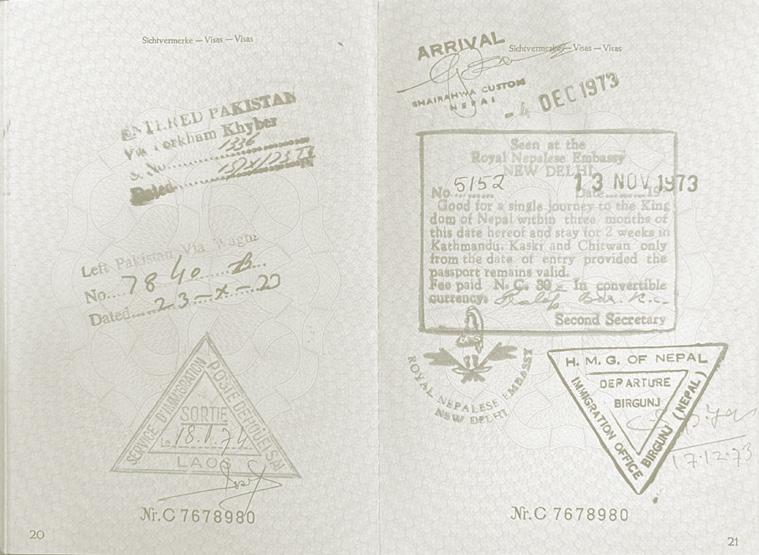
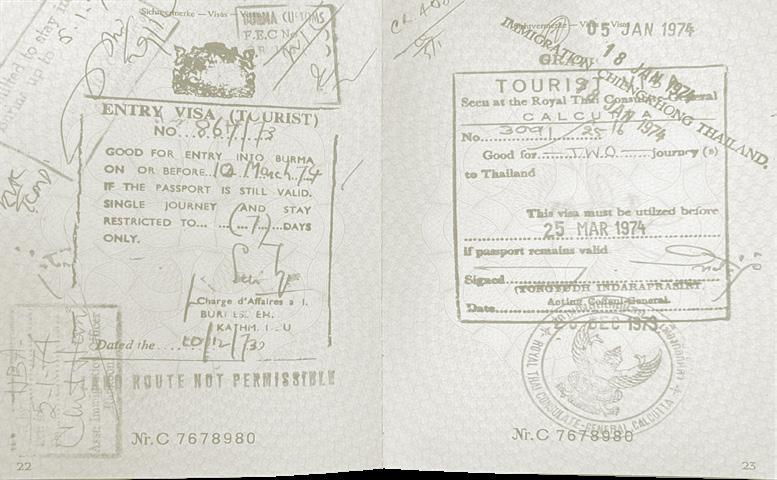



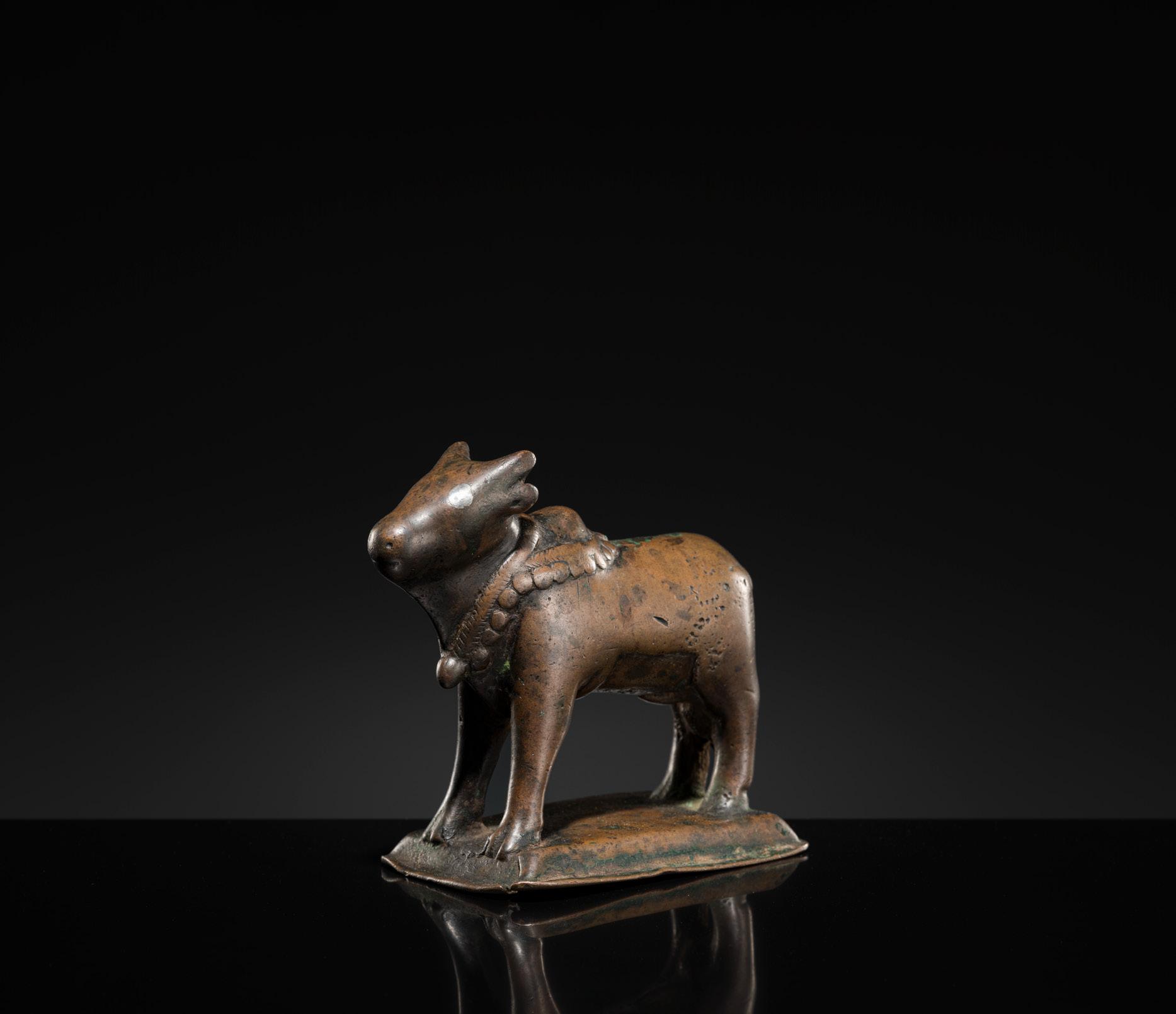
A SILVER-INLAID BRONZE FIGURE OF NANDI, HIMACHAL PRADESH, 10TH CENTURY
North India. Heavily cast, the holy white bull standing foursquare atop a rectangular pedestal, the neck adorned with neatly incised and beaded collars suspending a central bell, the animal well detailed with short horns, large silver-inlaid eyes, and characteristic hump.
Provenance: The Kienzle Family Collection, Stuttgart, Germany. Acquired between 1950 and 1985 by siblings Else (1912-2006), Reinhold (1917-2008), and Dr. Horst Kienzle (1924-2019), during their extensive travels in Asia. Subsequently inherited by Dr. Horst Kienzle and bequeathed to the Museum für Asiatische Kunst, Radevormwald, Germany. Released through museum deaccession in 2024.
Condition: Good condition with wear and casting irregularities, light nicks, small surface scratches, expected rubbing, minuscule losses to inlays, encrustations. The base with minor warping and a crack to one corner. The bronze with a smooth, naturally grown patina with areas of malachite encrustation.
Weight: 776.5 g
Dimensions: Height 10.2 cm, Length 9.5 cm
Nandi is Shiva’s mount and the gatekeeper of Shiva in Hindu mythology. He is seen as full of joy (nandi) in the presence of his master. An image of controlled virility and devotion, he would typically be placed in front of a Shiva temple facing a shrine.
AUCTION RESULT COMPARISON
Type: Related
Auction: Christie’s New York, 24 September 2020, lot 958
Price: USD 5,000 or approx. EUR 5,400 converted and adjusted for inflation at the time of writing
Description: A bronze figure of Uma Maheshvara, North India, Himachal Pradesh, probably Chamba, 10th century Expert remark: Compare the related manner of casting, decoration, and subject, with similar coppery bronze, silver inlays, and depiction of Nandi. Note the size (13.9 cm).
Estimate EUR 1,000
Starting price EUR 500
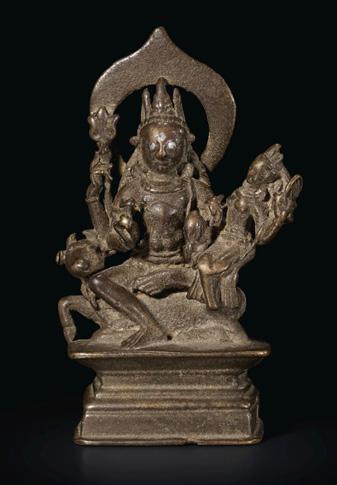
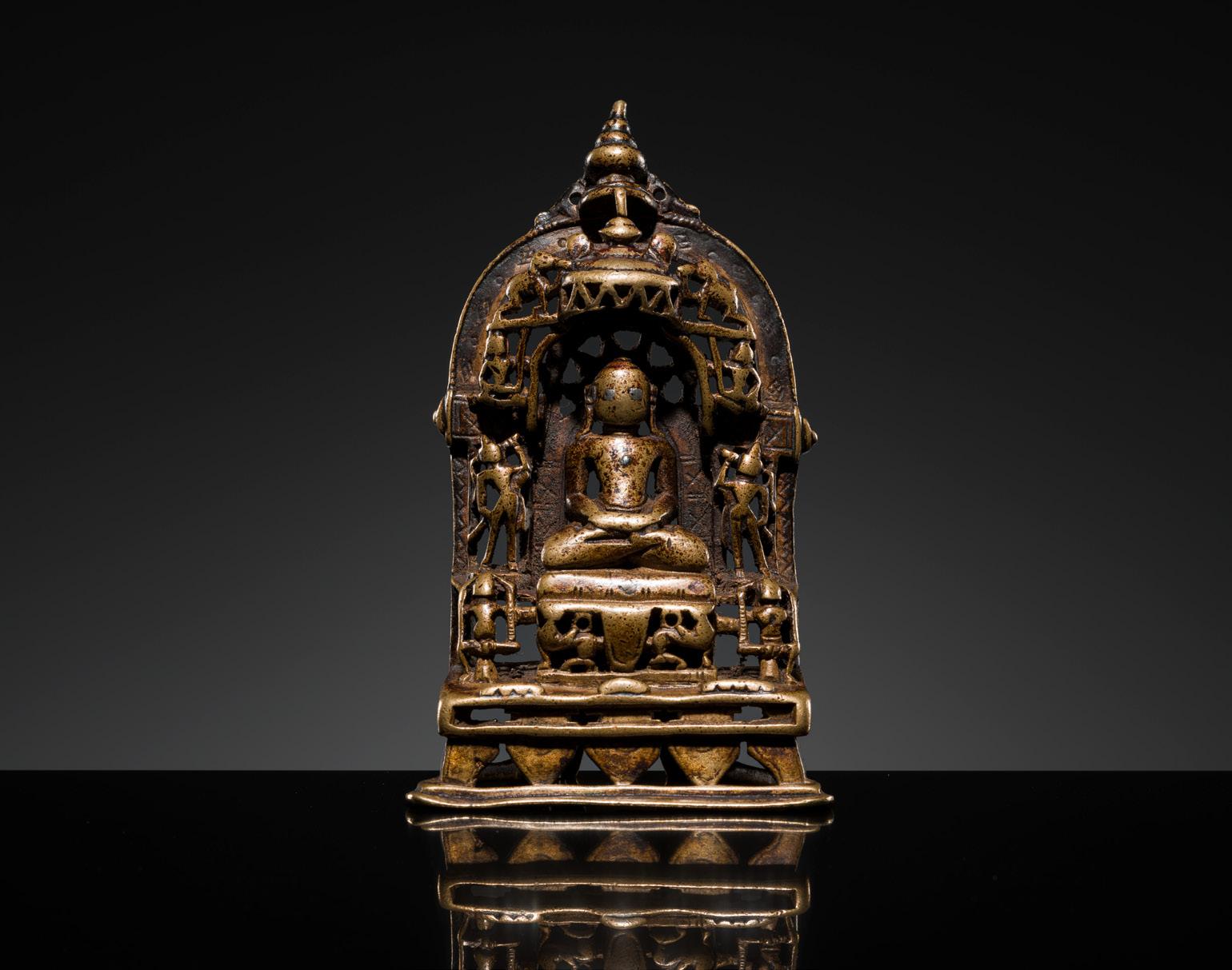
Western India. Well cast in openwork and neatly inlaid with silver and copper. The central deity seated in dhyanasana on a cushioned throne supported by two addorsed lions, surrounded by seated and standing figures of jinas and attendants. The arched throne back with elephant heads flanking a canopy below the kalasha-form finial.
Inscriptions: The back with a dedicatory inscription in Devanagari script, dating the present lot to Samvat 1382 (corresponding to 1325).
Provenance: The Kienzle Family Collection, Stuttgart, Germany. Acquired between 1950 and 1985 by siblings Else (1912-2006), Reinhold (1917-2008), and Dr. Horst Kienzle (1924-2019), during their extensive travels in Asia. Subsequently inherited by Dr. Horst Kienzle and bequeathed to the Museum für Asiatische Kunst, Radevormwald, Germany. Released through museum deaccession in 2024.
Condition: Very good condition with expected wear and rubbing predominantly from centuries of worship within the culture. Light nicks, small surface scratches, minor dents, casting irregularities. The bronze with a fine, naturally grown, smooth patina.
Weight: 228.8 g
Dimensions: Height 11.1 cm
In Jainism, Tirthankara was a savior who succeeded in crossing over life’s stream of rebirths, making a path for others to follow. Each cosmic age produces its own group of twenty-four Tirthankaras. Jain shrines are often cast in metal, exemplified by the current lot, as the cold surface of the metal serves to remind and emphasize the frozen detachment from life. These shrines are not worshiped as personal gods capable of bestowing blessings or interfering with human events, but rather as representatives of great beings with a sense of renunciation and the highest virtues. Jain believers pay homage in the hope that they in turn will be encouraged along the path towards their final self-liberation.
LITERATURE COMPARISON
Compare a related bronze Jain shrine, 18.3 cm high, dated by inscription to 1236 AD, in the British Museum, registration number 1996,1002.2.
AUCTION RESULT COMPARISON
Type: Closely related Auction: Zacke, Vienna, 25 April 2020, lot 453
Price: EUR 4,298 or approx. EUR 5,500 adjusted for inflation at the time of writing
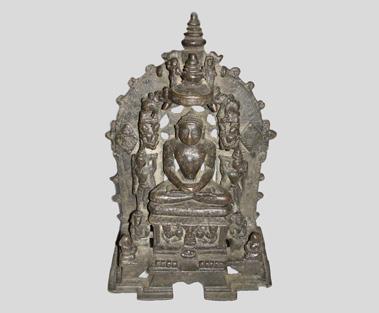
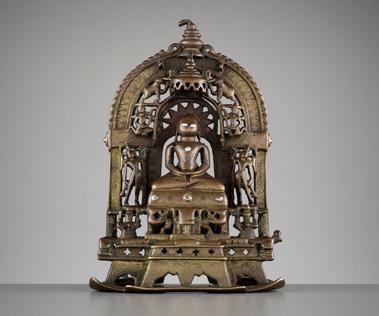
Description: A dated 1322 Jain silver-inlaid Buddhist altar shrine, Western India, Rajasthan Expert remark: Compare the closely related modeling and manner of casting. Note the size (17.2 cm) and that this shrine is dated to the year 1322, three years earlier than the present lot.
Estimate EUR 1,000
Starting price EUR 500

A BRONZE GROUP OF GANESHA AND SHAKTI, VIJAYANAGAR EMPIRE, 16TH CENTURY
South India. The elephant-headed deity seated atop a circular lotus base raised on a waisted plinth, his primary hands holding a kalash and supporting Shakti resting on his right leg, secondary hands holding various attributes including a lasso, ankusha, lotus, disk, and gada. Lord Ganesha is cast with a genial character and an elegant gait, wearing modest regalia, with emphasis given to the swells and contours of his limber modeling. His vahana, the rat, is seated on its haunches at his left foot, its forelimbs clasped around an offering for the deity.
Provenance: Galerie Hardt (established in 1976), Radevormwald, Germany, before 2020. Acquired by the gallery’s founder Peter Hardt (b. 1946) during his extensive travels in Asia, the first of which occurred during a formative world tour in 1973.
Labels: Galerie Hardt, typed ‘Ganesha mit Gefährtin, Bronze, Indien, 16 Jh’, the back ‘Reg #3722’, priced at EUR 1,250
Condition: Good condition with wear and casting irregularities, few minuscule losses, expected rubbing, light nicks, surface scratches. The bronze with a rich, naturally grown, dark patina with areas of malachite encrustation.
Weight: 365.5 g
Dimensions: Height 7.8 cm
AUCTION RESULT COMPARISON
Type: Closely related
Auction: Sotheby’s New York, 21 March 2023, lot 182
Price: USD 4,445 or approx. EUR 4,400 converted and adjusted for inflation at the time of writing
Description: A bronze figure of Ganesha, Tamil Nadu, 16th century
Expert remark: Compare the closely related modeling and related pedestal and size (11.1 cm).

Estimate EUR 1,000
Starting price EUR 500

75
The four-armed deity standing in a dynamic pose within a cloud-form niche centered by a kirtimukha mask, richly adorned with jewelry, holding a sword, bow, and arrow in his hands. His ornate crown flanked by the sun and crescent moon, a diminutive figure of Daksha and Sati in the lower left and right corner, all in high relief. Mounted on a copper plate which bears a massive handle on the reverse.
Provenance: The Kienzle Family Collection, Stuttgart, Germany. Acquired between 1950 and 1985 by siblings Else (1912-2006), Reinhold (1917-2008), and Dr. Horst Kienzle (1924-2019), during their extensive travels in Asia. Subsequently inherited by Dr. Horst Kienzle and bequeathed to the Museum für Asiatische Kunst, Radevormwald, Germany. Released through museum deaccession in 2024.
Labels: Inscribed ‘ […] Central Indian. 16th cent.’
Condition: Good condition with old wear, commensurate with age. Small losses, minor dents, and few nicks. The sword lost. Fine, naturally grown patina overall.
Weight: 1,231 g
Dimensions: Height 23.7 cm
Expert’s note: This is an unusual, heavily cast and finely worked piece with some puja (prayer) wear. It most probably adorned a household shrine or a small shrine within a temple.
Virabhadra, an incarnation of Shiva, created after Shiva’s wife Sati, was not invited to a great sacrifice given by her father Daksha. Being greatly humiliated, Sati went to the banquet and threw herself on the sacrificial fire. When Shiva heard of his wife’s death, he tore a hair from his head and threw it to the ground. Virabhadra, a great hero-warrior, arose from this hair. He cut off Daksha’s head in his rage and hurled it into the sacrificial fire. After the other gods calmed Shiva down, Daksha’s head was replaced by that of a ram, and he later became a devotee of Shiva.
The handle on the back allows the temple priest to hold the plaque during ceremonies, making it turn clockwise and bringing it near the devotees so that it could touch them as if to absorb the god’s radiating power through physical contact. Many plaques are worn down by centuries of ritual manipulation, for the images of the gods are daily washed, sprinkled with special substances, dressed or covered in flowers.
LITERATURE
COMPARISON
Compare a closely related altar panel depicting Virabhadra, 17.5 cm high, in the Horniman Museum & Gardens, museum number 19.3.51/2.
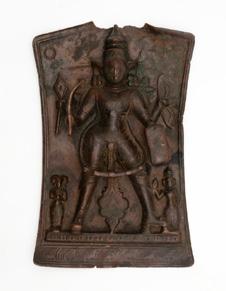
Compare a closely related copper-brass ceremonial shield with a similar plaque of Virabhadra, dated to the 18th century, in the British Museum, registration number 1853,0108.9.
AUCTION RESULT COMPARISON
Type: Closely related
Auction: Koller, Zurich, 14 June 2017, lot 440
Price: CHF 1,500 or approx. EUR 1,700 converted and adjusted for inflation at the time of writing
Description: A fine copper repoussé plaque of Virabhadra used by Jangam priests. India, Maharashtra, 16th/17th c.
Expert remark: Compare the closely related form, subject, modeling, and size (23 cm).
Estimate EUR 2,000
Starting price EUR 1,000


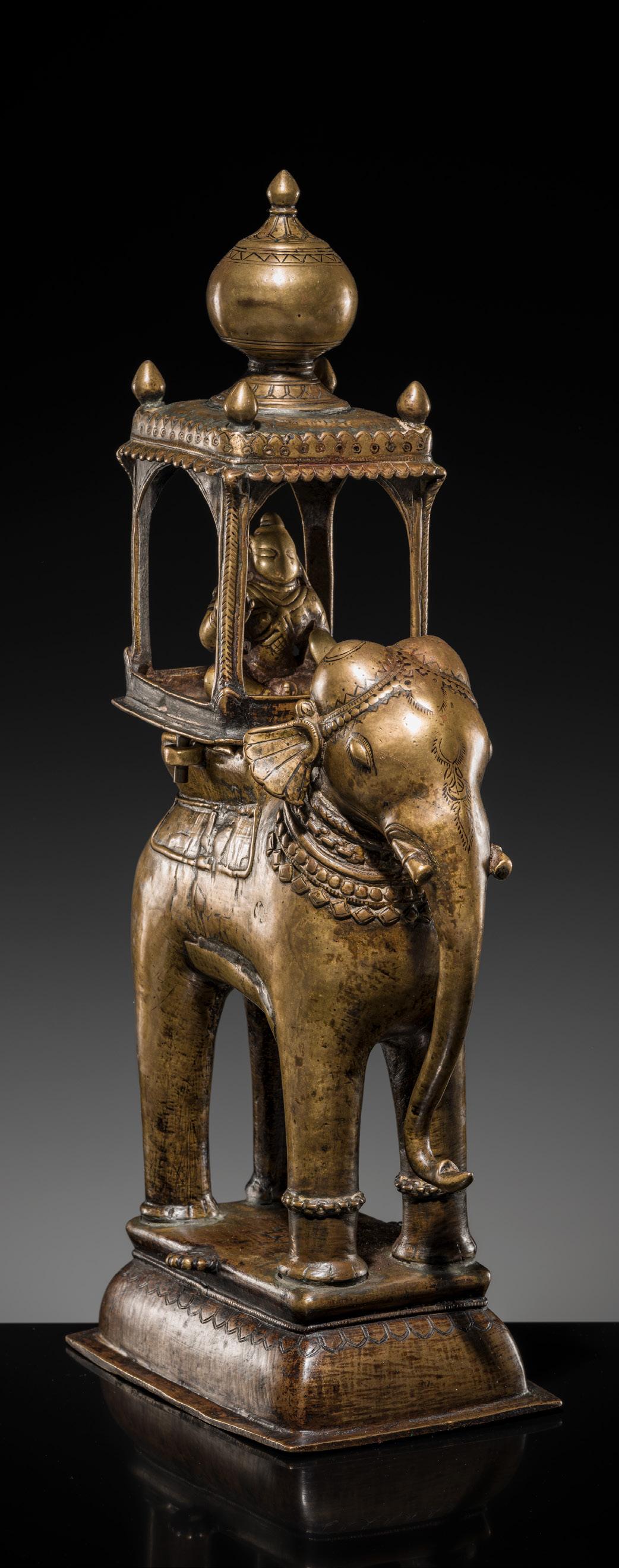
A BRONZE MODEL OF AN ELEPHANT WITH CANOPY CONTAINING A BRASS FIGURE OF MALE DEITY, DECCAN, 17TH CENTURY
India. The richly caparisoned and bejeweled elephant standing on a rectangular plinth incised with petal bands below a beaded rim and set with loops to either side, its back surmounted by a howdah (canopied seat) supported by four slender pillars and crowned with a large bulbous finial. Detailed incised ornamentation decorates the elephant’s head and neck, including an elaborate headpiece and collar. Seated within the separately cast howdah is a removable brass figure of a male deity seated with legs bent to the side, holding a shield in one hand.
Provenance: The Kienzle Family Collection, Stuttgart, Germany. Acquired between 1950 and 1985 by siblings Else (1912-2006), Reinhold (19172008), and Dr. Horst Kienzle (1924-2019), during their extensive travels in Asia. Subsequently inherited by Dr. Horst Kienzle and bequeathed to the Museum für Asiatische Kunst, Radevormwald, Germany. Released through museum deaccession in 2024.
Condition: Good condition with minor wear and casting irregularities. Light warping, few small dents, minute nicks, small surface scratches. The belly with an old repair and associated soldering marks possibly inherent to the manufacture. Rich, naturally grown, dark patina.
Weight: 5,923 g
Dimensions: Height 47 cm
AUCTION RESULT COMPARISON
Type: Closely related Auction: Bonhams
London, 7 June 2023, lot 38
Price: GBP 3,840 or approx. EUR 4,900 converted and adjusted for inflation at the time of writing
Description: A brass elephant with canopy, Deccan, 17th Century Expert remark: Compare the closely related modeling and manner of casting. Note the different size (30.5 cm).
Estimate EUR 2,000
Starting price EUR 1,000
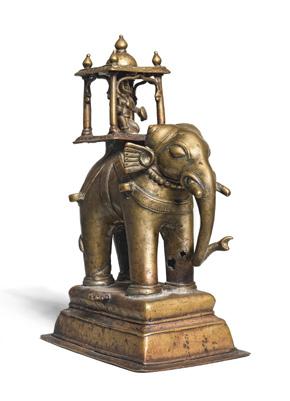
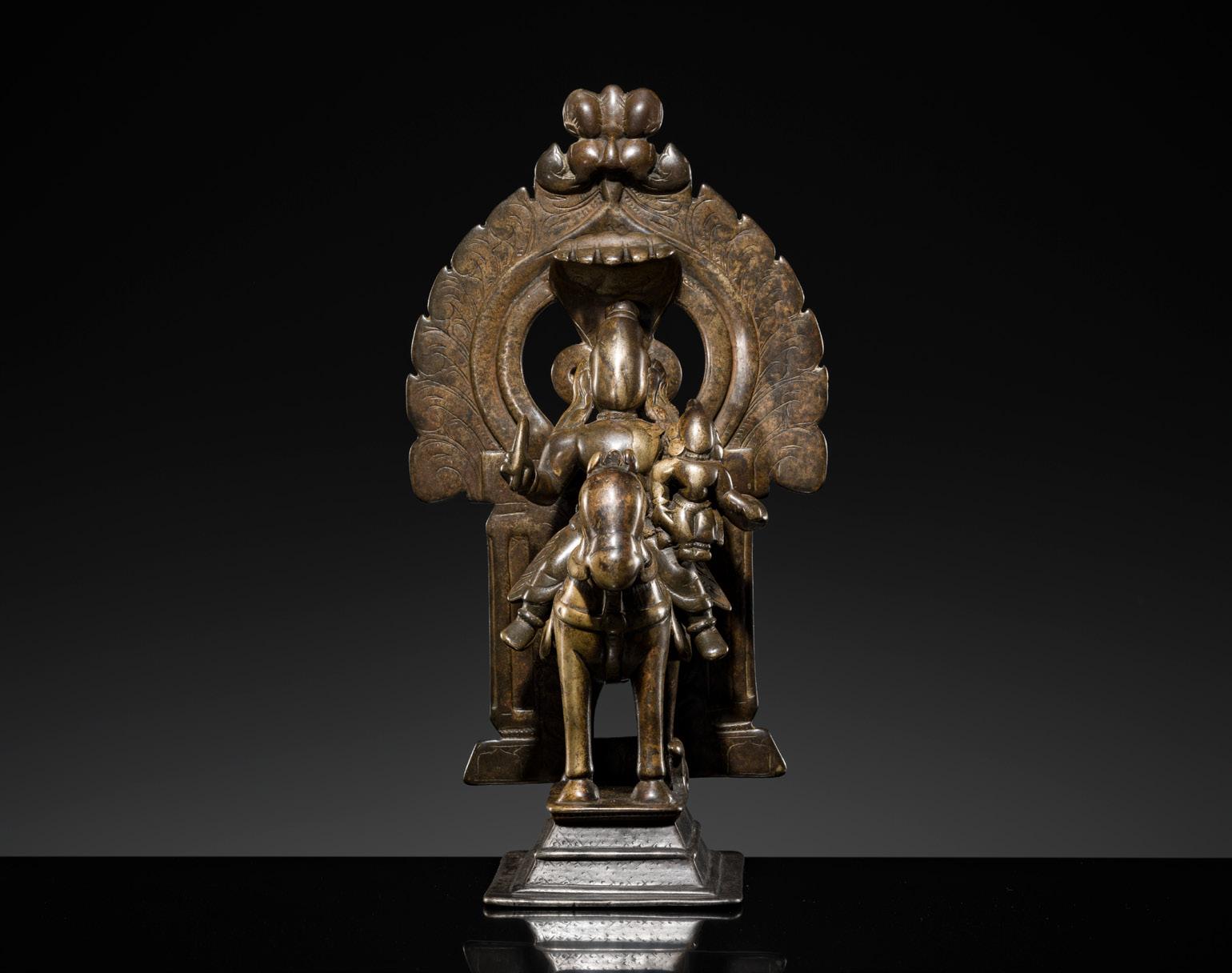
77
A BRASS GROUP OF KHANDOBA AND MHALSA, DECCAN, 18TH CENTURY
India. Well cast in three detachable pieces, Khandoba (Shiva) seated atop his saddled and bridled steed, next to the figure of Mhalsa (Parvati), on a stepped rectangular pedestal. They are accompanied by a dog. Khandoba is holding a sword in one hand and a bowl in the other. His head is surmounted by a conical headdress. The horse’s mane and tail are neatly incised. Framed by an elaborate mandorla incised with petal-lappets and centered by a five-headed naga hood, below the fierce kirtimukha.
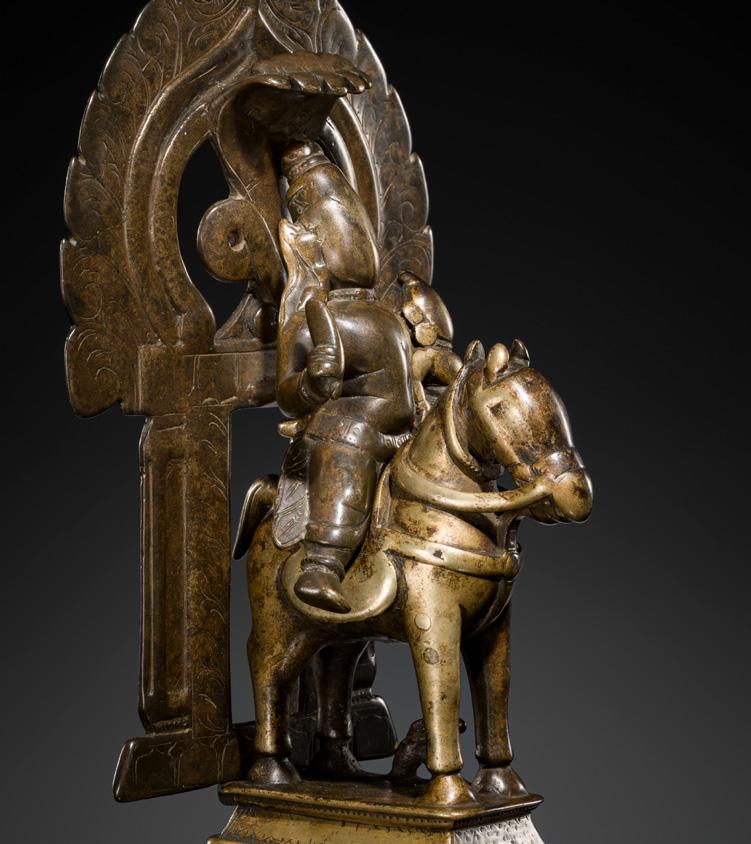
Provenance: The Kienzle Family Collection, Stuttgart, Germany. Acquired between 1950 and 1985 by siblings Else (1912-2006), Reinhold (1917-2008), and Dr. Horst Kienzle (1924-2019), during their extensive travels in Asia. Subsequently inherited by Dr. Horst Kienzle and bequeathed to the Museum für Asiatische Kunst, Radevormwald, Germany. Released through museum deaccession in 2024.
Condition: Good condition with expected old wear, predominantly from centuries of worship within the culture, casting irregularities including small circular patches, light warping, rubbing, few small nicks.
Weight: 1,145.9 g
Dimensions: Height 21.2 cm
Khandoba is a male Hindu deity of Southern and Western India who is still widely worshiped in Maharashtra and regarded as the guardian deity of the Deccan. He was originally depicted with the head of a dog, and vestiges of this remain in his worship to this day. His usual attributes are a sword, a trident, and a drum. His vehicle (vahana) is a horse and he may also be shown associated with a dog. The foremost center of Khandoba worship is the temple of Jejuri in Maharashtra. The legends of Khandoba, found in the text Malhari Mahatmya and also narrated in folk songs, revolve around his victory over demons Mani-malla and his marriages.
LITERATURE COMPARISON
Compare a related brass figure of Khandoba and Mhalsa seated on a horse, 15 cm high, dated 18th-19th century, in the British Museum, registration number 1853,0108.3.
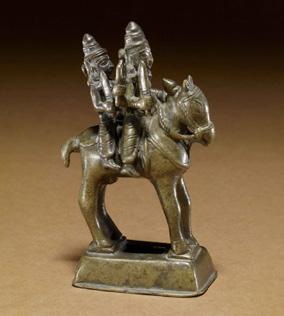
Estimate EUR 1,000 Starting price EUR 500

78
A MINIATURE BRONZE FIGURE OF RAMA, 17TH-18TH CENTURY
South India. Cast standing in samabhanga on a stepped square base, the arms thrust forward, holding a bow in his right hand and an arrow in his left, dressed in a long dhoti fastened at the waist and draped between the legs, and adorned with ribbons and beaded jewelry. The face with large almond-shaped eyes and full lips. The hair pulled up into a conical chignon secured by a foliate crown, the head backed by a small knop.
Provenance: The Kienzle Family Collection, Stuttgart, Germany. Acquired between 1950 and 1985 by siblings Else (1912-2006), Reinhold (1917-2008), and Dr. Horst Kienzle (1924-2019), during their extensive travels in Asia. Subsequently inherited by Dr. Horst Kienzle and bequeathed to the Museum für Asiatische Kunst, Radevormwald, Germany. Released through museum deaccession in 2024.
Condition: Very good condition with minor wear and casting irregularities. Few tiny nicks, small surface scratches, expected rubbing, remnants of pigment. The bronze with a fine, naturally grown, smooth patina and areas of malachite encrustation to the underside.
Weight: 80 g
Dimensions: Height 7.8 cm
Rama is a major deity of Hinduism and the seventh avatar of the god Vishnu, one of his most popular incarnations along with Krishna, Parshurama, and Gautama Buddha. He is the central figure of the ancient
Hindu epic Ramayana, a text historically popular in the South Asian and Southeast Asian cultures. Rama is especially important to Vaishnavism, and ancient Jain Texts also mention Rama as the eighth balabhadra among the 63 salakapurusas. In Rama-centric traditions of Hinduism, he is considered the Supreme Being.
LITERATURE COMPARISON
Compare a related bronze figure of Rama dated 18th century, 12.7 cm high, in the British Museum, registration number 1940,0716.340. Compare a related miniature bronze figure of Rama dated 18th-19th century, 4.6 cm high, in the Victoria and Albert Museum, accession number 533(IS) (fig. 1).
Estimate EUR 1,000
Starting price EUR 500
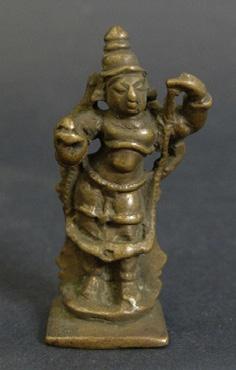
1

A SMALL BRONZE FIGURE OF DURGA SLAYING THE BUFFALO-DEMON MAHISHA, DECCAN, 17TH-18TH CENTURY
Finely cast, the eight-armed goddess depicted in a dynamic pose, triumphantly standing over the vanquished buffalo demon Mahisha atop a rectangular waisted base, subduing him with her main hands while the six secondary arms radiate around her holding weapons and attributes. Her face with large almond-shaped eyes and full lips, flanked by prominent ears, the hair fashioned into a high conical chignon.
Provenance: The Kienzle Family Collection, Stuttgart, Germany. Acquired between 1950 and 1985 by siblings Else (1912-2006), Reinhold (1917-2008), and Dr. Horst Kienzle (1924-2019), during their extensive travels in Asia. Subsequently inherited by Dr. Horst Kienzle and bequeathed to the Museum für Asiatische Kunst, Radevormwald, Germany. Released through museum deaccession in 2024.
Condition: Good condition with expected wear and manufacturing irregularities including casting fissures and patches, small losses to the back, minor dents, light warping, tiny nicks. The bronze with a fine, naturally grown, warm patina.
Weight: 685 g
Dimensions: Height 16 cm
Mahishasura , a powerful demon in Hindu mythology, is best known for his battle with the goddess Durga, who ultimately defeated him after a fierce conflict. According to legend, Mahishasura, a shape-shifting demon, terrorized the heavens and the earth, earning the wrath of the gods, who created Durga to destroy him. Represented with the head of a buffalo and a human body, Mahishasura symbolizes chaos and evil, while Durga represents divine feminine strength and protection. His
LITERATURE COMPARISON
Compare a closely related Deccan bronze of eight-armed Durga dated to the 18th century, in the British Museum, registration number 1940,0716.39.b.
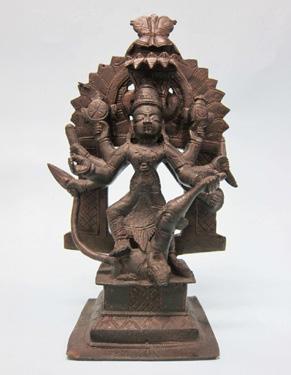
AUCTION RESULT COMPARISON
Type: Closely related Auction: Bonhams London, 8 November 2010, lot 96
Price: GBP 2,000 or approx. EUR 4,200 converted and adjusted for inflation at the time of writing
Description: A Deccan, or other Indian, bronze figure of Durga Mahisasuramardini slaying the Asura, Mahisa, 15th-16th century
Expert remark: Compare the closely related modeling, manner of casting, and size (15 cm).
Estimate EUR 1,000 Starting price EUR 500
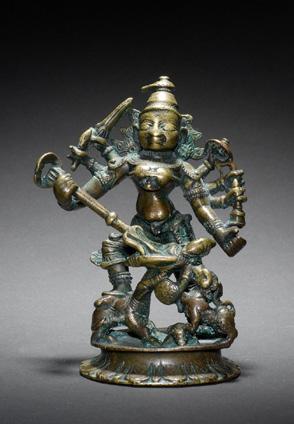

80
A BRONZE FIGURE OF PARVATI, NAYAK PERIOD
South India, 17th-18th century. Finely cast standing in tribhanga atop a circular incised lotus dais raised on a stepped square plinth similarly decorated with lotus petals and geometric designs, flanked by two vertical struts.
The goddess wears a richly pleated and bejeweled dhoti, her body sumptuously adorned with sacred thread and fine beaded jewelry framing her voluptuous breasts, the right hand is in kataka mudra and the left extended in loa hasta.
The face modeled with almond-shaped eyes, arched brows, elongated earlobes and full lips forming a calm smile, the forehead centered by a third eye, the hair fashioned into an elaborate high conical chignon secured by a foliate tiara and topped by a lotiform jewel.
Provenance: Galerie Hardt (established in 1976), Radevormwald, Germany, before 2020. Acquired by the gallery’s founder Peter Hardt (b. 1946) during his extensive travels in Asia, the first of which occurred during a formative world tour in 1973.
Condition: Good condition with minor wear and casting irregularities. Light scratches, scuffs, minor nicks, small dents, fine fissures. The bronze with a fine, naturally-grown, smooth patina, and areas of verdigris.
Weight: 9,812 g
Dimensions: Height 47 cm
LITERATURE COMPARISON
Compare a closely related Nayak style bronze figure of Parvati, 52 cm high, dated 17th18th century, in the Victoria and Albert Museum, accession number 1063-1873.
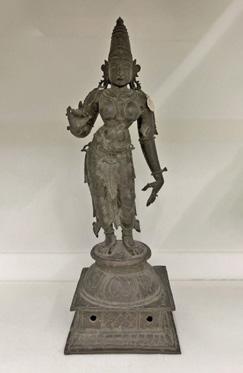
AUCTION RESULT
COMPARISON
Type: Closely related
Auction: Christie’s Paris, 11 June 2014, lot 376
Price: EUR 8,125 or approx. EUR 9,800 adjusted for inflation at the time of writing
Description: A bronze figure of Devi, South India, Kerala region, 16th/17th century
Expert remark: Compare the closely related modeling and manner of casting. Note the much smaller size (36 cm).
Estimate EUR 3,000
Starting price EUR 1,500
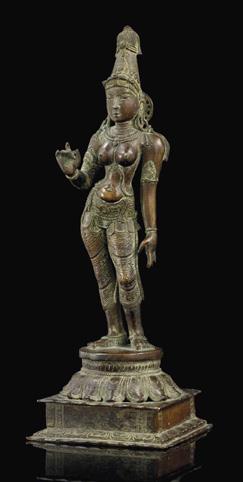
Finely cast, standing atop a double-lotus base raised on a tiered plinth, holding a large diya (oil lamp) in her hands. The deity is dressed in diaphanous dhoti, her bare torso adorned with jewelry, the face with a serene expression, wide eyes, and a broad smile, and the parted hair finely braided in a long plait to the back.
Provenance: The Kienzle Family Collection, Stuttgart, Germany. Acquired between 1950 and 1985 by siblings Else (1912-2006), Reinhold (19172008), and Dr. Horst Kienzle (1924-2019), during their extensive travels in Asia. Subsequently inherited by Dr. Horst Kienzle and bequeathed to the Museum für Asiatische Kunst, Radevormwald, Germany. Released through museum deaccession in 2024.
Condition: Good condition with old wear, traces of use, and casting irregularities. Minute nicks, small surface scratches, light rubbing, encrustations, minor warping, the base with small fatigue cracks and minuscule losses. The bronze with a fine, naturally grown patina with small areas of verdigris.
Weight: 1,534.1 g
Dimensions: Height 27.5 cm
This puja or prayer lamp has been cast in the form of a celestial female attendant, identifiable with Lakshmi, the goddess of light and wealth. She holds a leaf-shaped oil well or wick pan which is deep enough to hold a significant quantity of oil so it will burn for quite some time. This is an important feature consistent with the Hindu precept of akhanda jyot – that a lamp offered to a deity should burn without interruption, the offering of lit lamps to deities being one of the nine essential Brahmanic forms of worship. Donating lamps to a temple is also considered a sacred act which confers merit on the owner. Usually such a gift will be accompanied by a stipend for the ongoing purchase of ghee or oil to be used to fuel the lamps.
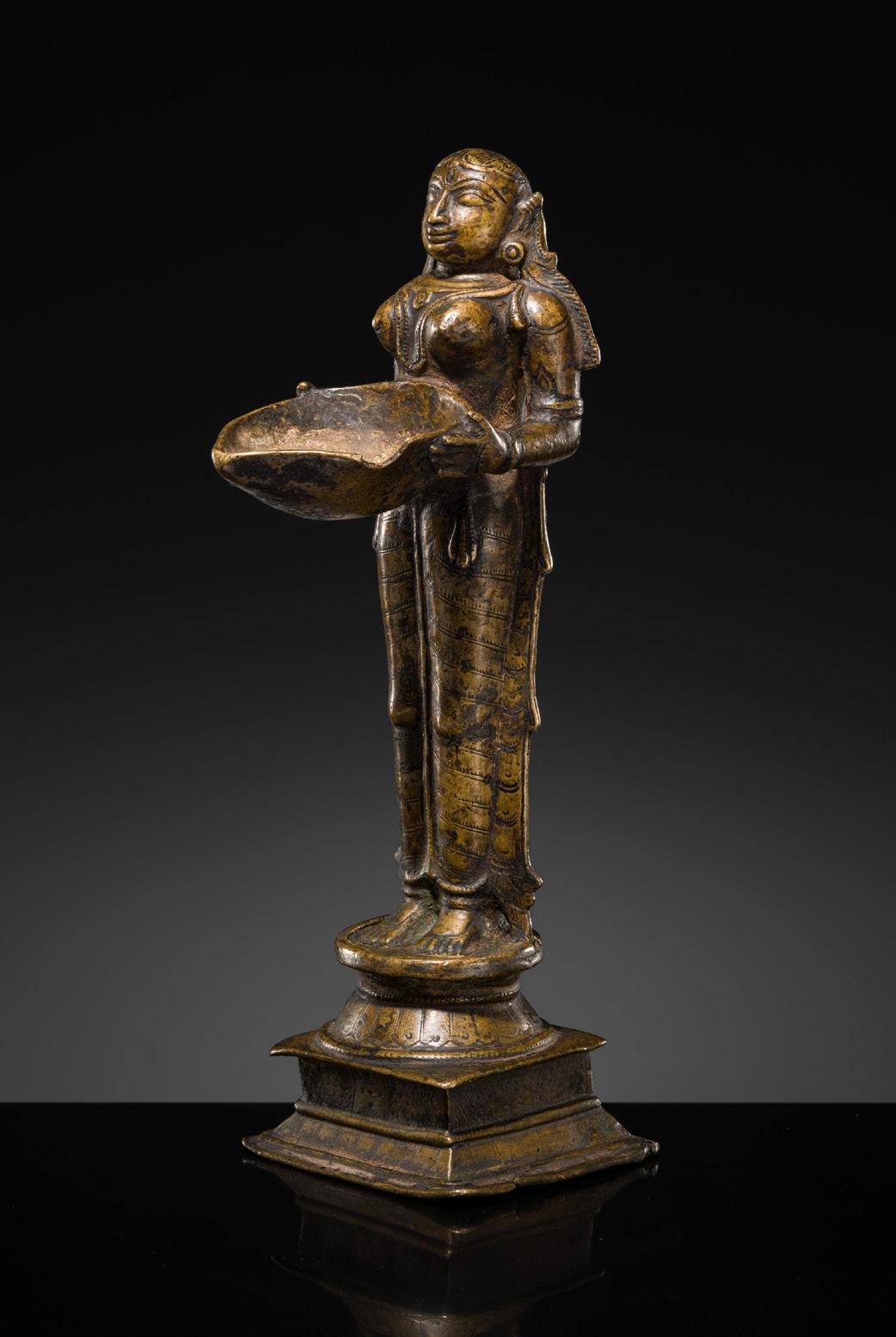
LITERATURE COMPARISON
Compare a related earlier Deepalakshmi bronze, dated to the Vijayanagara period, 15th century, 34 cm high, in the Asian Civilisations Museum, accession number 1994-05384.
Compare a related later brass Deepalakshmi, dated to the 19th century, 44.5 cm high, in the Harn Museum of Art, University of Florida, object number 1987.2.7.
Estimate EUR 2,000
Starting price EUR 1,000

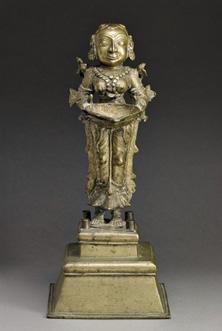
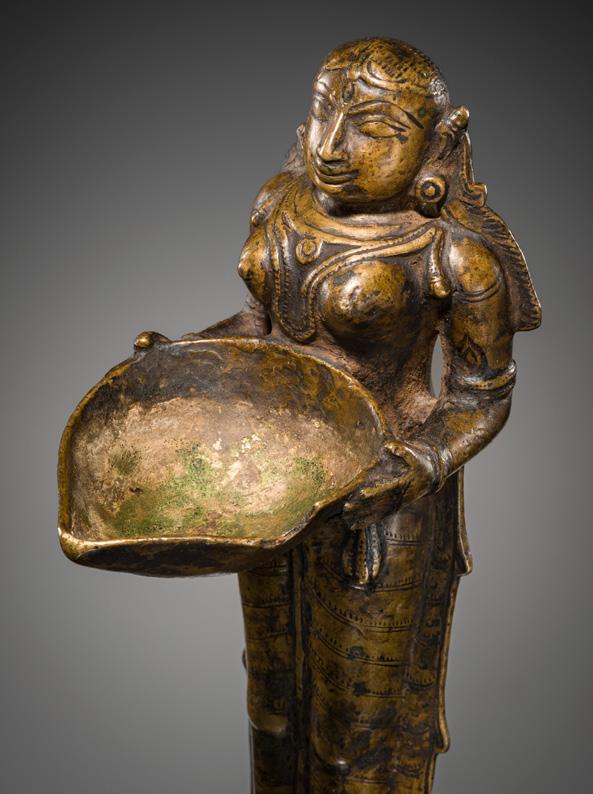

82
A MINIATURE BRONZE FIGURE OF YOGA NARASIMHA WITH NAGA HOOD, 18TH-19TH CENTURY
South India. Finely cast, seated in yogasana on a circular pedestal encircled by lotus petals atop a square waisted base, a yoga strap across his knees, the four-armed deity holds various attributes including the shankha (conch), chakra (discus), gada (mace), and padma (lotus) rising from behind, the five-headed naga towering above.
Provenance: The Kienzle Family Collection, Stuttgart, Germany. Acquired between 1950 and 1985 by siblings Else (1912-2006), Reinhold (1917-2008), and Dr. Horst Kienzle (1924-2019), during their extensive travels in Asia. Subsequently inherited by Dr. Horst Kienzle and bequeathed to the Museum für Asiatische Kunst, Radevormwald, Germany. Released through museum deaccession in 2024.
Condition: Very good condition with minor wear and casting irregularities. Minute nicks, tiny dents, rubbing, and light scratches. The bronze with a fine, naturally grown, smooth patina.
Weight: 178 g
Dimensions: Height 9 cm
Narasimha, the fourth avatar of Vishnu, is among the most powerful and compelling figures in Hindu iconography, representing the victory of divine will and dharma over oppression. Manifesting as a half-man, half-lion, Vishnu assumes this fierce form to vanquish the demon king Hiranyakashipu, who had gained near-invincibility through a boon that protected him from man or beast, indoors or out, by day or night. In
a moment rich with symbolic nuance, Narasimha bursts from a pillar at twilight and slays the demon on the threshold of a palace, thereby circumventing each clause of the boon and restoring cosmic balance.
The present bronze, however, departs from the familiar ferocity of this narrative to depict Yoga Narasimha, a rare and serene aspect of the deity. Seated in a composed meditative posture, this form reflects the avatar’s transcendence and self-mastery after the fury of battle has subsided. With a calm expression and stylized attributes, Yoga Narasimha embodies the integration of divine power and inner stillness – an icon of spiritual equilibrium revered particularly in South Indian Vaishnava tradition.
LITERATURE COMPARISON
Compare a related miniature bronze figure of Lakshmi Narasimha dated 18th century, 10.8 cm high, in the British Museum, registration number 1940,0716.328.
Compare a related bronze figure of Lakshmi Narasimha and Naga dated 18th century, 14.3 cm high, in the Victoria and Albert Museum, accession number 527(IS).
Estimate EUR 1,000
Starting price EUR 500
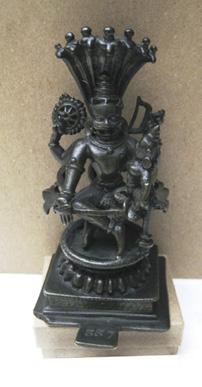
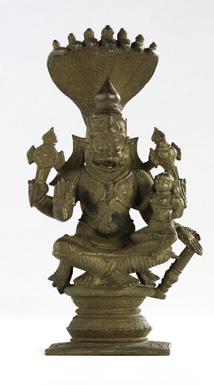


83 A MINIATURE BRONZE SHRINE WITH SHIVA-LINGAM AND NAGA, MAHARASHTRA, 18TH-19TH CENTURY
India. The compactly cast shrine represents the theme of Shiva-Lingam worship, with various members of the Shaivite family including Parvati, Ganesha, Krishna, and Nandi huddled around a central Shiva-Lingam, enclosed within low walls set with four loops, supported on four feet, and centered by a towering naga topped with a bud-shaped finial.
Provenance: Galerie Hardt (established in 1976), Radevormwald, Germany, before 2020. Acquired by the gallery’s founder Peter Hardt (b. 1946) during his extensive travels in Asia, the first of which occurred during a formative world tour in 1973.
Labels: Galerie Hardt, typed ‘Kobrahaube, Lingam und Yoni, Indien, 18/19 Jh’, priced at EUR 1,250
Condition: Good condition with old wear, traces of use, casting irregularities, remnants of pigment, expected rubbing, small losses, light nicks, surface scratches. The bronze with a rich, naturally grown, dark patina.
Weight: 257.1 g
Dimensions: Size 8.8 x 8.8 x 7.2 cm
Such shrines come from the small towns and villages of Maharashtra indicating that these were popular objects of worship in domestic settings. It was customary that these domestic shrines were tended regularly with daily worship and offerings. But rarely are such shrines encountered now.
LITERATURE COMPARISON
Compare a closely related bronze shrine dated to the 19th century in the Mount Holyoke College Art Museum, South Hadley, Massachusetts, accession number MH
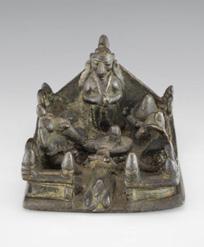
1964.28.O.G. Compare a closely related brass shrine, 8 cm high, dated 1850-1900, in the Spurlock Museum of World Cultures, University of Illinois, accession number 2012.10.0147.
Estimate EUR 500
Starting price EUR 250

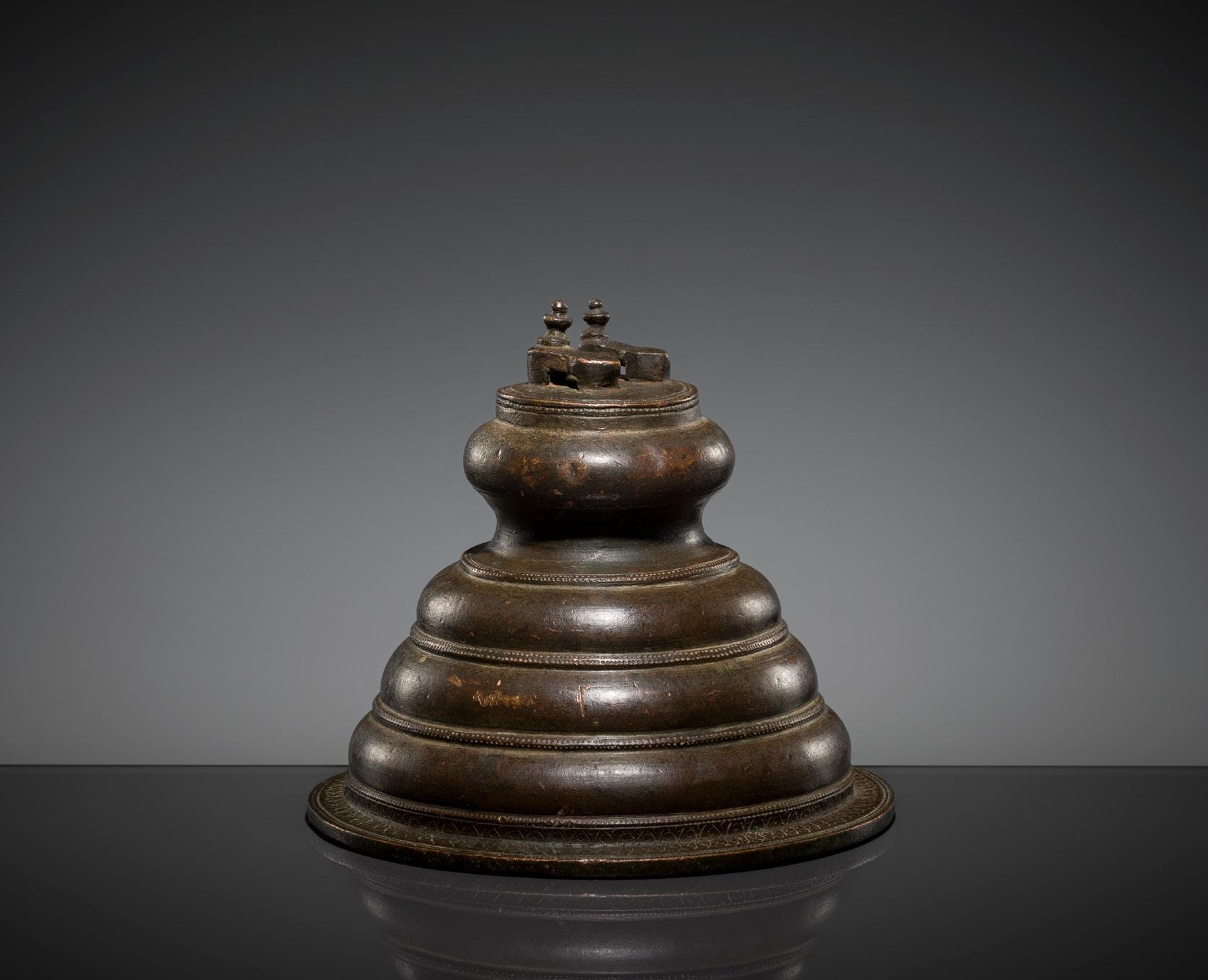
Expert’s note: Paduka are a traditional form of South Asian footwear — simple sandals consisting of a flat sole with a single knob that fits between the big toe and second toe to hold the foot in place. Paduka exist in a variety of forms and materials: they might be shaped like actual feet or take the form of symbolic motifs such as fish. They have been made from wood, ivory, and silver, and may be elaborately decorated, especially when included in a bride’s trousseau. Paduka could also be given as religious offerings or themselves be the object of veneration, symbolizing humility, devotion, and the spiritual path. In some traditions, they represent the sandals of a deity — such as Shiva — or stand for the preceptor or guru, as seen in other examples like a pair of paduka on a lotus pedestal from Andhra Pradesh (see literature comparison).
Probably Andhra Pradesh. Of conical form, the tiered pedestal with beaded edges, surmounted to the flat top with a pair of paduka. Each sandal with a high platform and a post and knob which is positioned between the first and second toes.
Provenance: Galerie Hardt (established in 1976), Radevormwald, Germany, before 2020. Acquired by the gallery’s founder Peter Hardt (b. 1946) during his extensive travels in Asia, the first of which occurred during a formative world tour in 1973.
Labels: Galerie Hardt, inscribed ‘Paar Sandalen von Shiva, Indien, 18. Jh’, priced at EUR 1,250
Condition: Good condition with expected wear and manufacturing irregularities, few light dents, minute nicks, occasional small surface scratches.
Weight: 1,068 g Dimensions: Height 13.2 cm
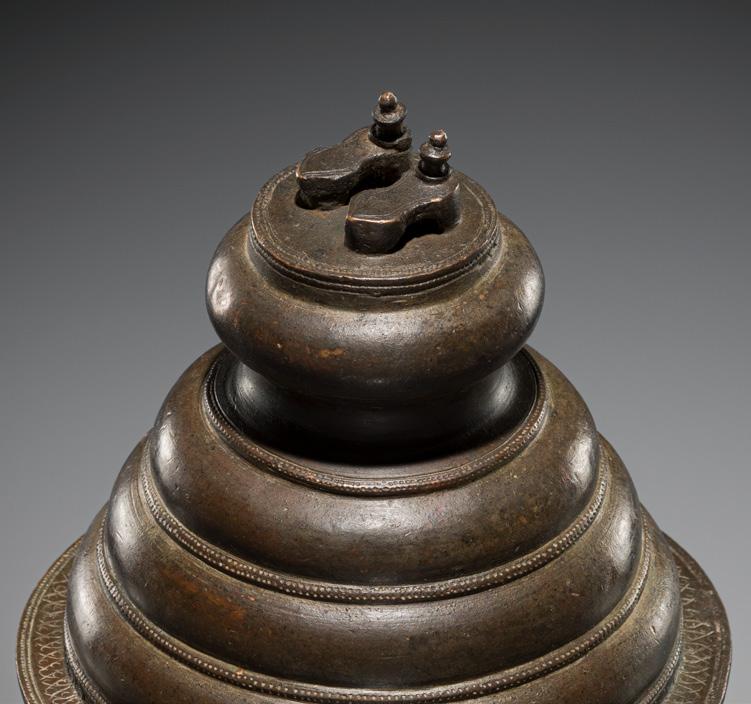
LITERATURE COMPARISON
Compare a related pair of paduka on a lotus pedestal, representing the preceptor or the deity, Andhra Pradesh, 18th-19th century, 18.5 cm wide, exhibited in London by Joost Van den Bergh in Magic Markings: Tantra, Jain & Ritual Art from India, 2016, no. MM07.

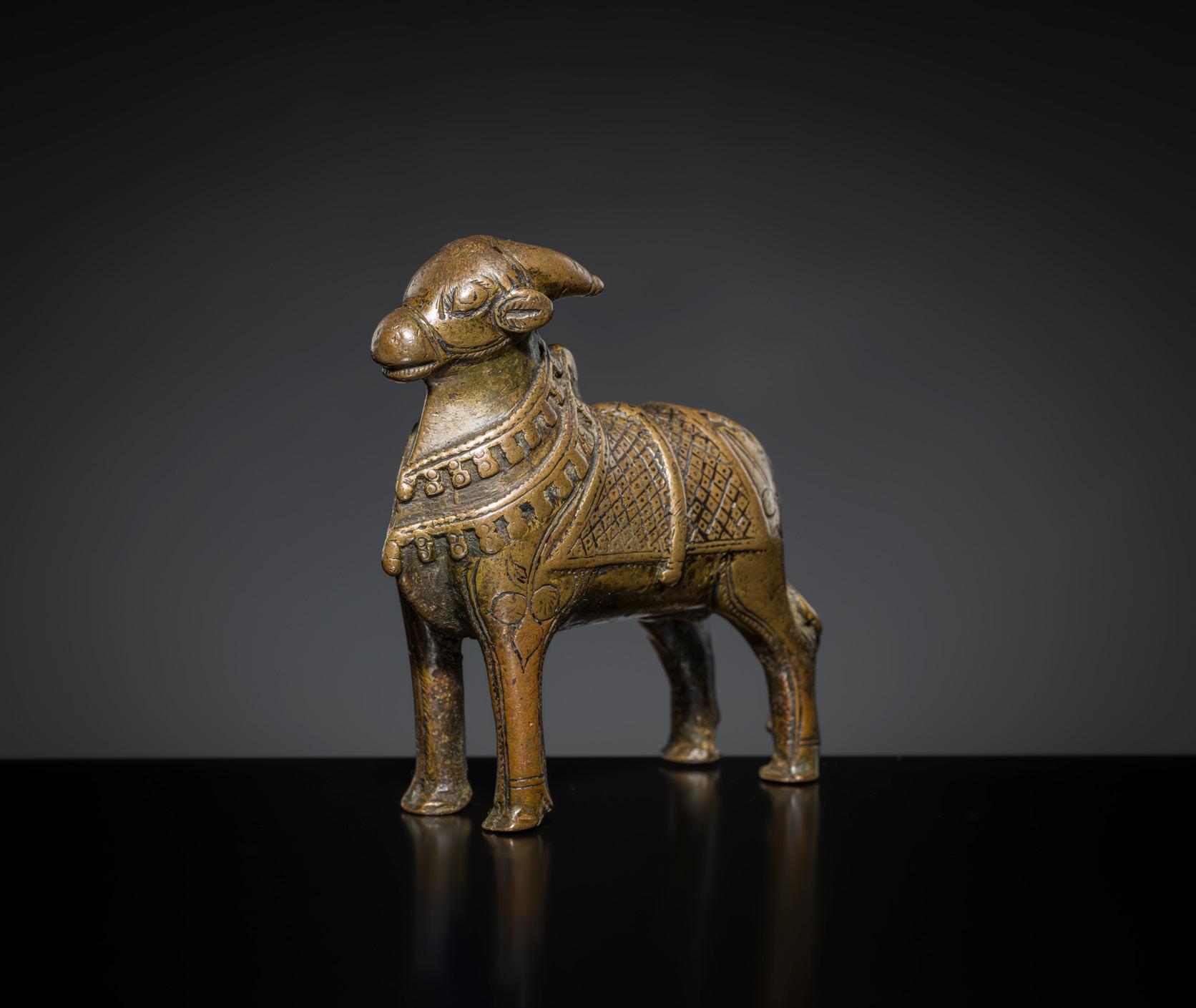
A COPPER ALLOY FIGURE OF NANDI, NORTHERN INDIA, 18TH-19TH CENTURY
Shiva’s bull standing foursquare, finely engraved with geometric and floral motifs. The bridled animal is adorned with belled collars and a draped blanket.
Provenance: Galerie Hardt (established in 1976), Radevormwald, Germany, before 2020. Acquired by the gallery’s founder Peter Hardt (b. 1946) during his extensive travels in Asia, the first of which occurred during a formative world tour in 1973.
Labels: Galerie Hardt, typed ‘Nandi, Bronze, Indien, 19 Jh’, the back ‘Reg #5822’, priced at EUR 1,750
Condition: Good condition with wear and casting irregularities. Nicks, scratches, dings, rubbing, and encrustations. A section of the tail partially lost. Naturally grown patina.
Weight: 776.5 g
Dimensions: Height 10.2 cm, Length 9.5 cm
LITERATURE COMPARISON
Compare a related North Indian gilded bronze Nandi dated to 18th-19th century, sold by Michael Backman Ltd., inventory number 9161.
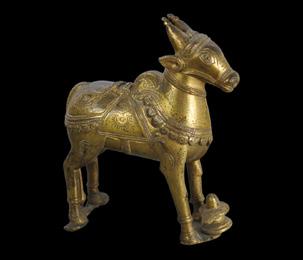
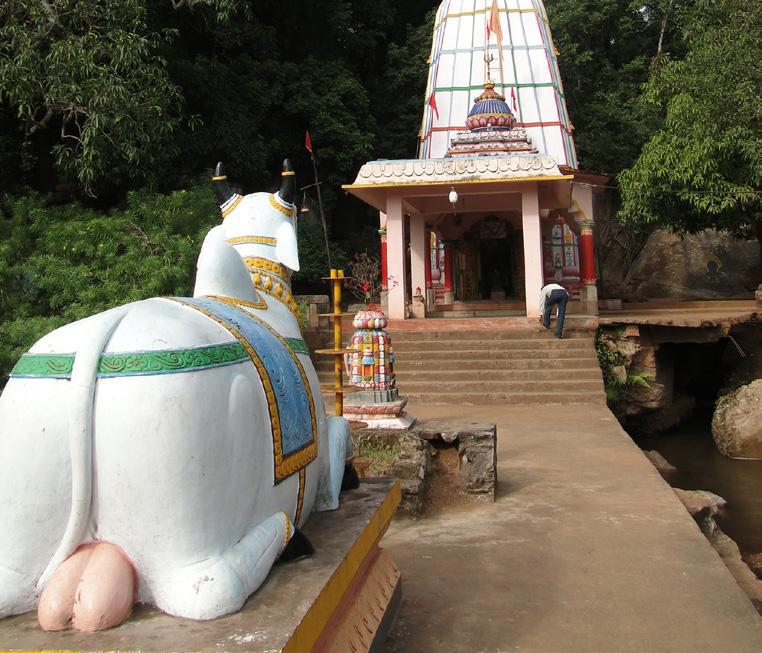
Nandi is Shiva’s mount and the gatekeeper of Shiva in Hindu mythology. He is seen as full of “joy” (nandi) in the presence of his master. Larger Nandi images are often placed at the entrance of Shiva temples. They have long been associated with fertility, illustrated by the custom of worshipers touching such images’ testicles as they enter the temple, particularly if they wish to expand their family. Accordingly, the image here has prominent testicles.
Estimate EUR 500
Starting price EUR 250

A GROUP OF THREE KONDH TRIBAL BRONZES OF WARRIORS ON HORSEBACK, EASTERN INDIA, LATE 19TH-EARLY 20TH CENTURY
Kondh Tribe. Comprising three equestrian warriors, each mounted on horses standing foursquare with loops to each foot. Cast using the traditional lost-wax technique (cire perdue) as warriors holding weapons astride horses with elongated limbs and intricate surface texture. (3)
Provenance: The Kienzle Family Collection, Stuttgart, Germany. Acquired between 1950 and 1985 by siblings Else (1912-2006), Reinhold (1917-2008), and Dr. Horst Kienzle (1924-2019), during their extensive travels in Asia. Subsequently inherited by Dr. Horst Kienzle and bequeathed to the Museum für Asiatische Kunst, Radevormwald, Germany. Released through museum deaccession in 2024.
Condition: Good condition with minor wear and casting irregularities, few minor losses, light dents, minute nicks, small surface scratches.
Weight: 1,512 g (total)
Dimensions: Length 12.5-18.4 cm
The Kondh tribe, one of India’s largest indigenous communities, inhabits the forested highlands of Odisha and parts of Chhattisgarh.
Known for their deep-rooted spiritual connection to the land, the Kondh express their beliefs through ritual, oral tradition, and material culture. Though not widely associated with metalworking, certain Kondh groups have long commissioned or created lost-wax bronze figures—stylized depictions of animals, ancestors, and deities—used in ancestral rites, village ceremonies, and votive offerings. These bronzes are not merely decorative, but charged with symbolic and ritual significance.
LITERATURE COMPARISON
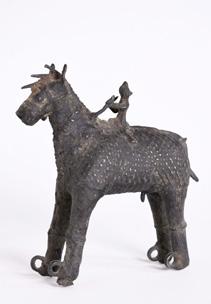
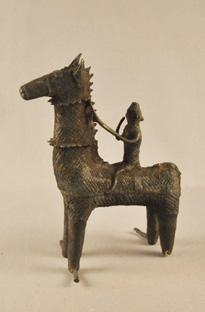
Compare a closely related Kondh tribal bronze of a warrior dated to the first half of the 20th century, in the Museum Rietberg, inventory number 2018.756. Compare a closely related Kondh tribal bronze of a warrior, India, dated to the early 20th century, in the collection of the Spurlock Museum, University of Illinois at Urbana-Champaign, artifact identification 2014.01.0057.
Estimate EUR 1,000
Starting price EUR 500
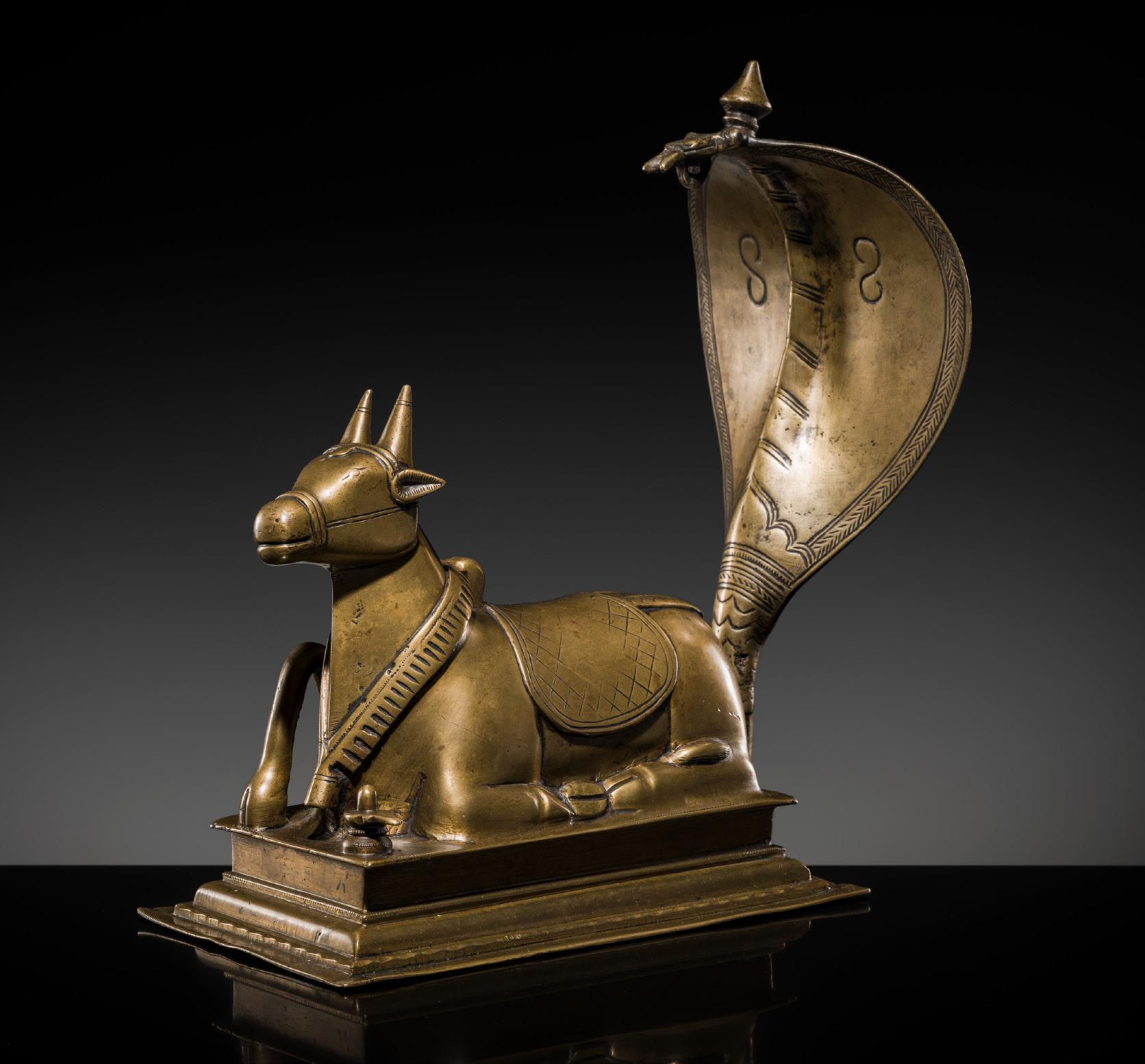
LITERATURE COMPARISON
A BRONZE FIGURE OF NANDI CANOPIED BY A NAGA, 18TH-19TH CENTURY
India. Cast in two sections, the holy white bull seated in a recumbent pose with three legs tucked in atop a tiered rectangular base, a small yoni-lingam before him. A yoke-like collar encircles Nandi’s neck, and a neatly incised saddle blanket covers his back, the animal well detailed with small round eyes, a long muzzle, two conical horns, and pricked ears. All beneath the protective presence of a naga, its tall arching cobra hood elegantly shaped and decorated with a finely incised border and central spine, topped by a jewel finial.
Provenance: Galerie Hardt (established in 1976), Radevormwald, Germany, before 2020. Acquired by the gallery’s founder Peter Hardt (b. 1946) during his extensive travels in Asia, the first of which occurred during a formative world tour in 1973.
Condition: Very good condition with minor wear and casting irregularities. Miniature nicks, tiny dents, rubbing, and light scratches. The bronze with a fine, naturally grown, smooth patina and areas of malachite encrustations to the underside.
Weight: 3,061 g
Dimensions: Height 28.2 cm
Compare a closely related bronze of Nandi, 17 cm high, dated to the 19th century, in the Museo Nacional de Antropologia, inventory number CE1999/3/29.
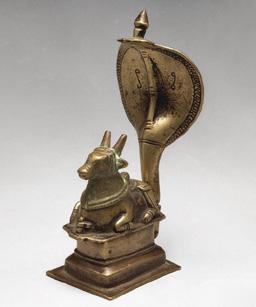
AUCTION RESULT COMPARISON
Type: Closely related
Auction: Lempertz Cologne, 3 June 2015, lot 517
Price: EUR 2,480 or approx. EUR 3,100 adjusted for inflation at the time of writing
Description: A Maharashtra bronze figure of Nandi canopied by a cobra, 18th century
Expert remark: Compare the closely related form, modeling, manner of casting, subject, and size (26.5 cm).
Estimate EUR 1,000
Starting price EUR 500
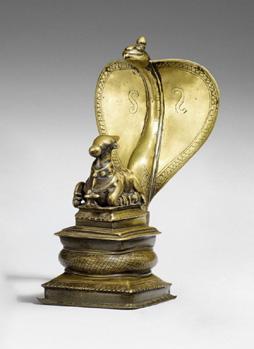

88
SHAIVITE
South India. Of globular form, supported on a short spreading foot, the rounded sides rising to a waisted neck with an everted rim with a flat lip adorned with diminutive figures of Nandi alternating with miniature yoni-lingams. The body decorated in relief with the head of Shiva repeated twice, Ganesha flanked by attendants, and the divine couple Shiva and Parvati between two coiled snakes and under the sun and moon.
Provenance: Galerie Hardt (established in 1976), Radevormwald, Germany, before 2020. Acquired by the gallery’s founder Peter Hardt (b. 1946) during his extensive travels in Asia, the first of which occurred during a formative world tour in 1973.
Condition: Very good condition with old wear and casting irregularities. Nicks, scratches, dings, rubbings, encrustations, and signs of wear and use. The bronze with a rich, naturally grown, dark patina with malachite and cuprite encrustations.
Weight: 1,675.9 g
Dimensions: Height 15 cm
The Vibhutipatra, a container for sacred ash (Vibhuti), holds deep spiritual significance in Hinduism, particularly in devotion to Lord Shiva. It symbolizes purity, divine blessings, detachment from the material world, and the triumph over the cycle of rebirth. The Vibhuti itself, when applied to the body, is believed to connect individuals with the divine, protect against negative energies, and regulate the chakras.
LITERATURE COMPARISON
Compare a closely related Vibhuti holder, Tamil Nadu, 12 cm wide, in the Gangaikonda Cholapuram Site Museum, museum number 1185, and illustrated in the Virtual Museum of Images & Sounds, accession number D14757.
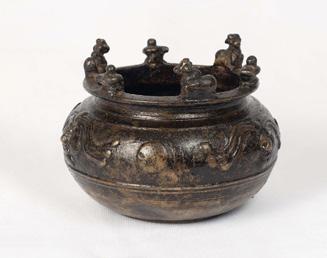

Estimate EUR 1,000
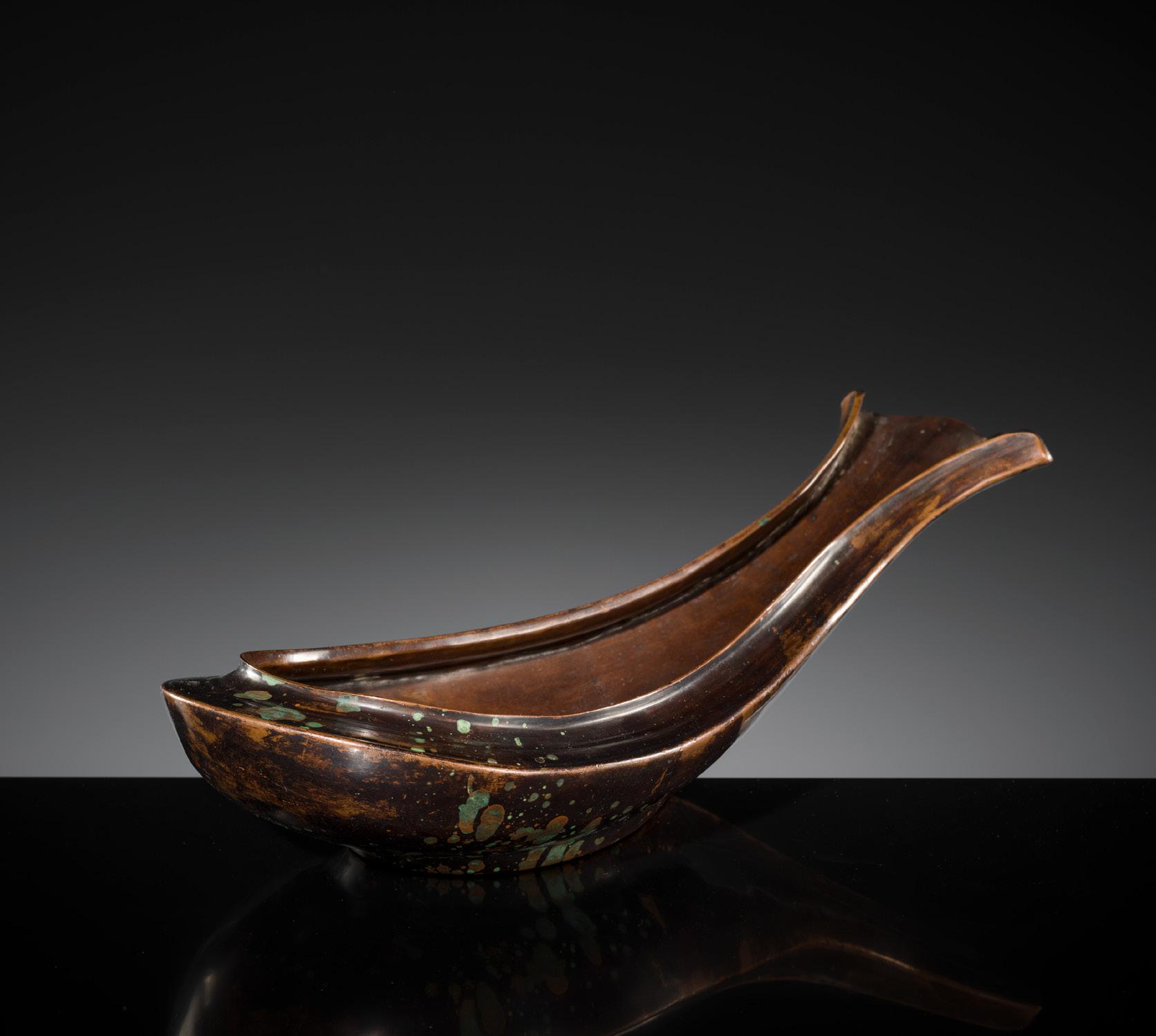
A COPPER ‘YONI’ LIBATION VESSEL, ARGHA PATRA, 18TH-19TH CENTURY
India. Finely cast, of symmetrical elongated tear form, supported on a narrow-indented base, surmounted by inverted, ridged shoulders and rising to a raised rim. The copper bearing a fine, naturally grown patina.
Provenance: Galerie Hardt (established in 1976), Radevormwald, Germany, before 2020. Acquired by the gallery’s founder Peter Hardt (b. 1946) during his extensive travels in Asia, the first of which occurred during a formative world tour in 1973.
Labels: Galerie Hardt, inscribed ‘Yoni Kupfer geschlagen, 18.-19. Jahrhundert’, the back ‘Süd Indien, Reg. Nr. 1685-04’, and priced at EUR 2,250
Condition: Very good condition with wear, casting irregularities, and traces of use, minute nicks and small surface scratches, light warping, the copper with a rich, warm patina with areas of malachite encrustation.
Weight: 843 g
Dimensions: Length 32.6 cm
The vessel known as ‘argha patra’ is a widely witnessed form intended for ritual purposes, evolving from traditional representations of the ‘yoni’, the female generative organ. Revered as a symbol of fertility, it is believed to be the locus of spiritual power and creative energy. The symmetrical form embodies an ideal of female beauty, frequently compared to the
lotus flower, representing the origin of the mandala and the energy of cosmic waters. The waves depicted around the rim of the vessel refer to the primordial ocean where the god Vishnu, reclining upon the coils of his celestial serpent Ananta, envisioned the creation of the Universe.
This form of vessel is intended to be filled with water while held in the hand during the ritual of ‘puja’, with the indent in the base used to place a finger for balance. The water is then poured onto the sculpture of a deity to bathe the god or goddess as an act of worship.
LITERATURE COMPARISON
Compare two closely related copper libation vessels from Bangladesh, dated 18th-19th century, in the Asian Civilisations Museum, accession number 201700282. Compare a related copper libation bowl from Bengal, dated to the early 20th century, 36.5 cm long, in the Victoria and Albert Museum, accession number IS.472009.
Estimate EUR 1,000
Starting price EUR 500

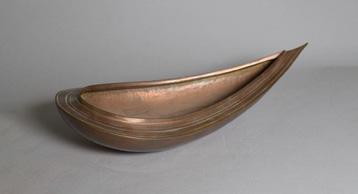

A LARGE WHITE MARBLE FIGURE OF A GUARDIAN LION, NORTHWESTERN INDIA, 18TH-19TH CENTURY OR EARLIER
Rajasthan or Gujarat. Skillfully carved standing foursquare in a dynamic stance on a rectangular base. The head held high with finely modeled mane, small funnel-shaped ears, and distinctive facial features including almond-shaped eyes and a protruding snout with open jaws revealing sharp fangs and a rolling tongue.
Provenance: The Kienzle Family Collection, Stuttgart, Germany. Acquired between 1950 and 1985 by siblings Else (1912-2006), Reinhold (1917-2008), and Dr. Horst Kienzle (1924-2019), during their extensive travels in Asia. Subsequently inherited by Dr. Horst Kienzle and bequeathed to the Museum für Asiatische Kunst, Radevormwald, Germany. Released through museum deaccession in 2024.
Condition: Good condition with expected wear, minor signs of weathering and erosion, encrustations, scattered nicks, small chips and minor losses to edges. The white marble exhibiting a beautiful, naturally grown patina.
Dimensions: Height 55.2 cm
AUCTION RESULT COMPARISON
Type: Related
Auction: Christie’s New York, 24 September 2020, lot 971
Price: USD 15,000 or approx. EUR 16,000 converted and adjusted for inflation at the time of writing
Description: A white marble figure of an elephant, India, 18th-19th century
Expert remark: Compare the related stone and manner of carving with similar base. Note the different size (28 cm) and subject.
Estimate EUR 2,000
Starting price EUR 1,000
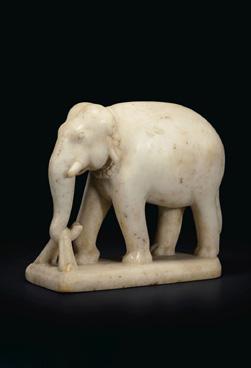
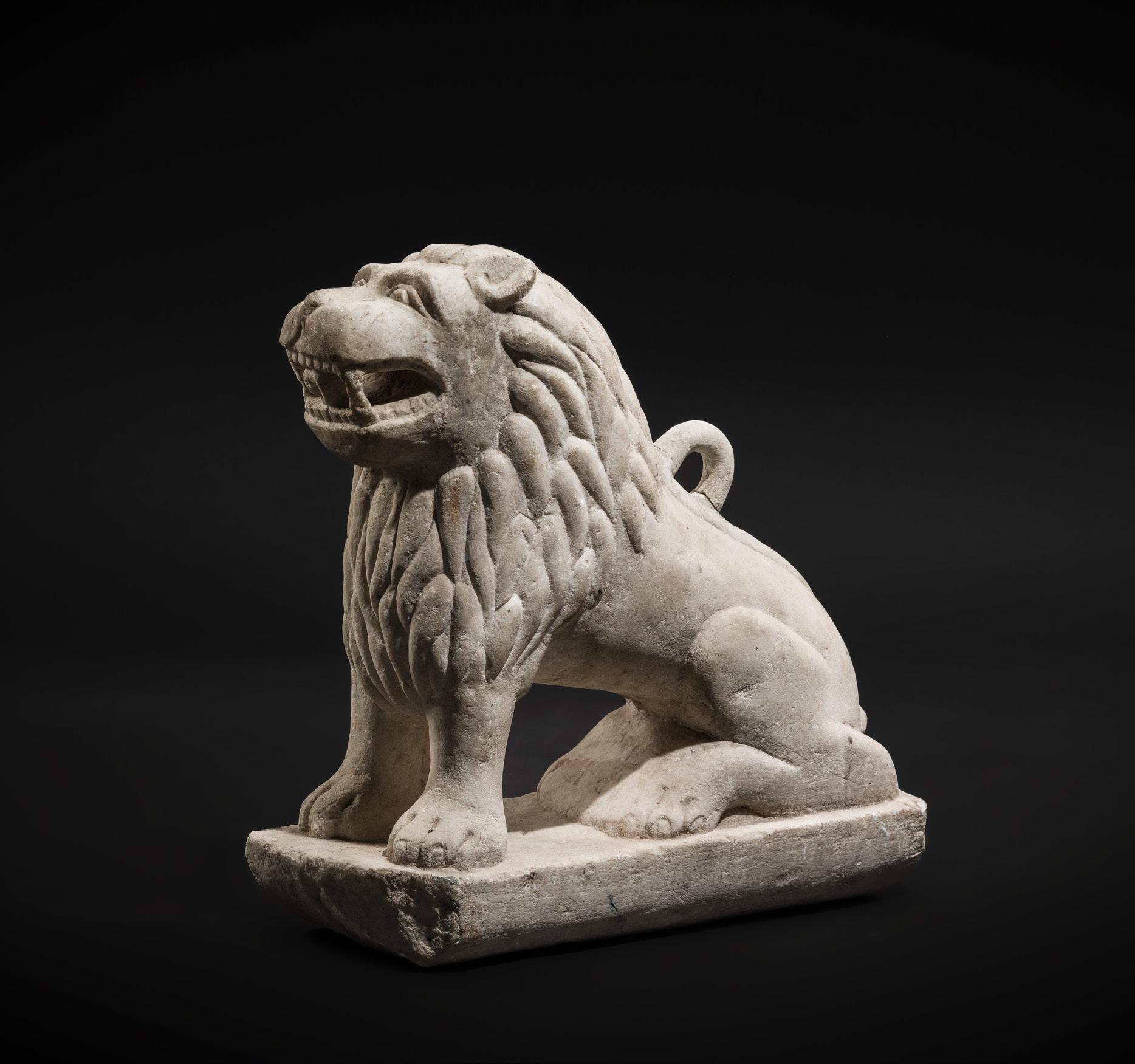
A LARGE WHITE MARBLE FIGURE OF A GUARDIAN LION, NORTHWESTERN INDIA, 18TH-19TH CENTURY OR EARLIER
Rajasthan or Gujarat. Well carved seated on its haunches atop a rectangular base. The head held high with finely modeled mane, small funnel-shaped ears, and distinctive facial features including almondshaped eyes and a protruding snout with open jaws revealing sharp fangs and a rolling tongue.
Provenance: The Kienzle Family Collection, Stuttgart, Germany. Acquired between 1950 and 1985 by siblings Else (1912-2006), Reinhold (1917-2008), and Dr. Horst Kienzle (1924-2019), during their extensive travels in Asia. Subsequently inherited by Dr. Horst Kienzle and bequeathed to the Museum für Asiatische Kunst, Radevormwald, Germany. Released through museum deaccession in 2024.
Condition: Good condition with expected wear, minor signs of weathering and erosion, encrustations, scattered nicks, small chips and minor losses to edges. The tail with old repair. The white marble exhibiting a beautiful, naturally grown patina.
Dimensions: Height 49.1 cm
Freestanding sculptures of lions are seen in temple complexes across India. They are also seen on the flat ledge above the frontal projection of the shikhara (temple tower) which rises above the threshold of the temple sanctum. Its prominent location would highlight the role of the lion both as guardian of the temple and as an assistant in the process of divine illumination.
LITERATURE COMPARISON
Compare a related earlier Amaravati guardian lion carved in limestone (‘Palnad marble’), dated to the 2nd century, 105 cm high, in the British Museum, registration number 1880,0709.105.
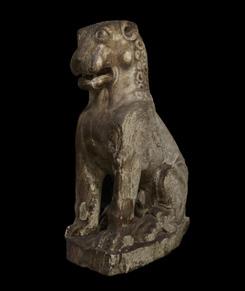
Estimate EUR 2,000
Starting price EUR 1,000
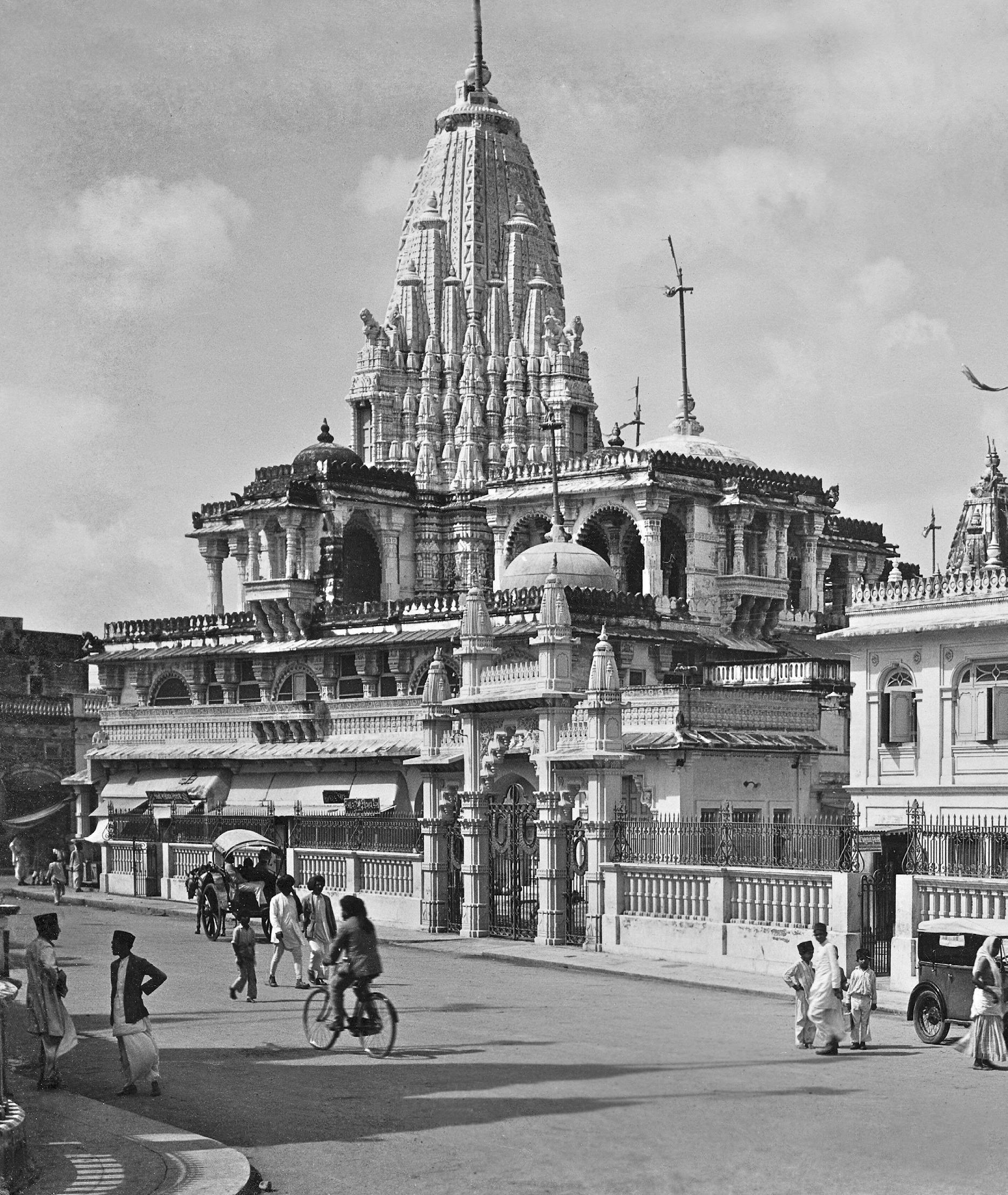

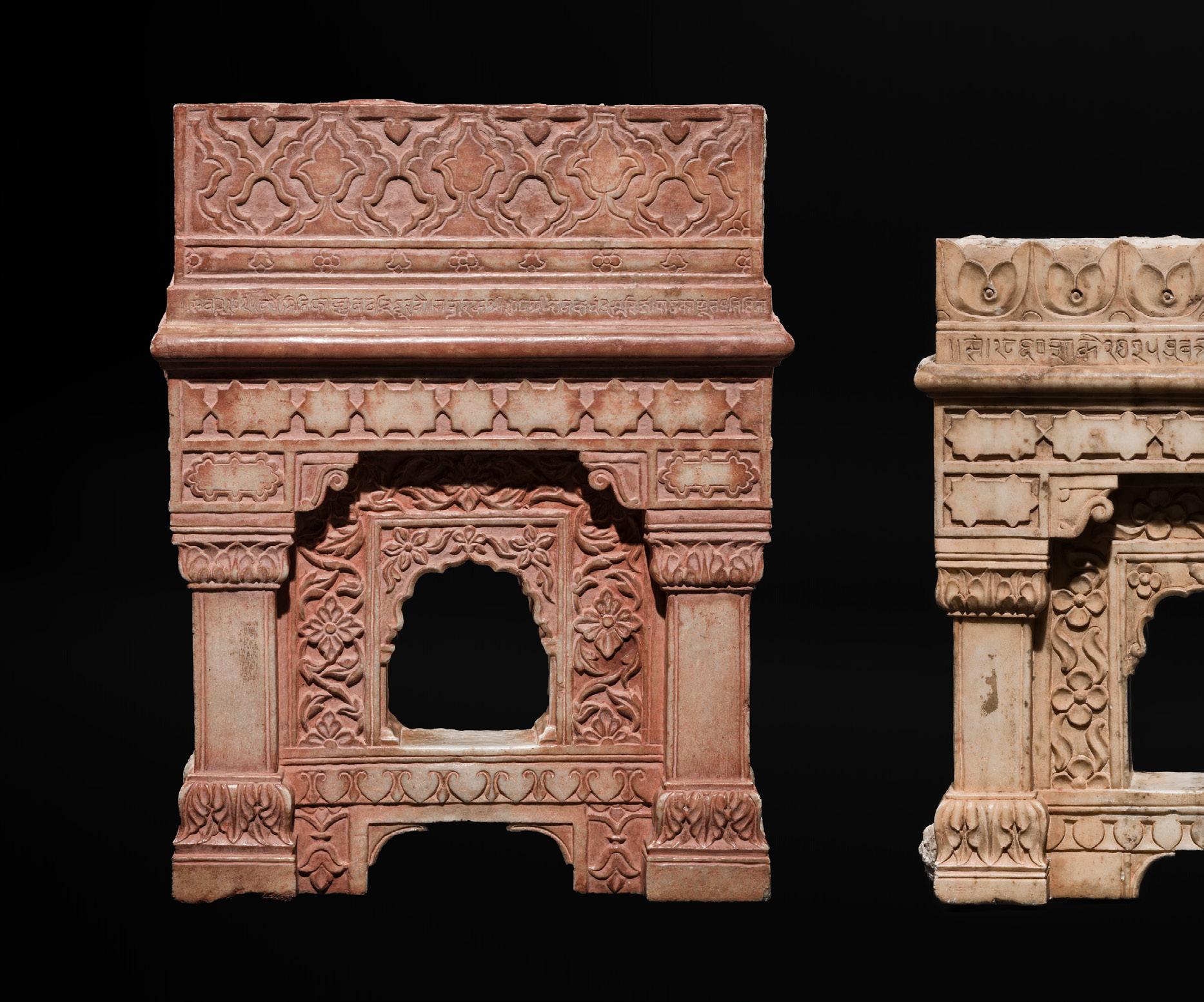
A GROUP OF THREE MUGHAL MARBLE ‘CHINI-KHANA’ PANELS
Northern India, 17th-18th century. Each panel skillfully carved in the form of an aedicule, with robust pilasters of rectangular section and squat capitals supporting broad entablatures, articulated by fine cornice lines, and a recessed aperture in the form of a polylobed arch centering the composition. All lavishly decorated with intricate floral designs and geometric patterns, two panels including a slender inscribed frieze. (3)
Provenance: Galerie Hardt (established in 1976), Radevormwald, Germany, before 2020. Acquired by the gallery’s founder Peter Hardt (b. 1946) during his extensive travels in Asia, the first of which occurred during a formative world tour in 1973.
Labels: Galerie Hardt, inscribed ‘Fenster, Marmor, Indien, 17. Jarhhundert’, the back ‘Reg. Nr. 90008, H: 40 B: 33 T: 9 cm’; ‘Reg. Nr. 90108, H: 48, B: 36, T: 10 cm’; and, ‘Reg. Nr. 90208, H: 49 B: 36 T: 9 cm’ respectively, each priced at EUR 9,500
Condition: Very good condition with expected old wear, manufacturing irregularities, signs of weathering and erosion, small chips and losses, cracks, and few surface scratches. The marble has been carefully cleaned and maintained over the centuries, in keeping with the customary care for this type of structural element.
Weight: 93.4 kg (total)
Dimensions: Height 40.1 (the smallest) and 49.2 cm (the largest)
Chini-khana, translated as ‘china room’ or ‘house of china’, was a name originally given to buildings or chambers during the Timurid era created as a dedicated space for the display of Chinese ceramics. Porcelain, regarded as a prestigious commodity, had been collected, gifted, and displayed at Muslim royal courts since the ninth century. The appreciation for it and other fine Chinese wares increased even more significantly though following the Mongol invasions of the thirteenth century. In response, new methods for storing and presenting these prized objects were developed in courtly settings. The marble panels comprising the present lot were arguably conceived as wall niches within such chambers. For an in-depth study on the development of chini-khana in Mughal architecture, see Mehreen Chida-Razvi, From Function to Form: Chini-khana in Safavid and Mughal Architecture, South Asian Studies, vol. 35, no. 1, 2019, pp. 82-106.
These marble panels derive their form from the jharoka, an architectural element of medieval Indian origin with Arab influences, particularly prominent in Mughal and Rajasthani cultures. Traditionally, a jharoka is an elevated projecting balcony that overhangs the walls of a palace, supported by brackets and topped with a dome or vault. As noted by George Michell, it was from a jharokha that Mughal emperors made their first public appearance each day, allowing their subjects visual contact with their sovereign. In everyday life, the jharoka also served to provide women with the opportunity to observe the street while remaining unseen from outside. See John Burton-Page (ed. George Michell), Indian Islamic Architecture: Forms and Typologies, Sites and Monuments, Leiden and Boston, 2008.
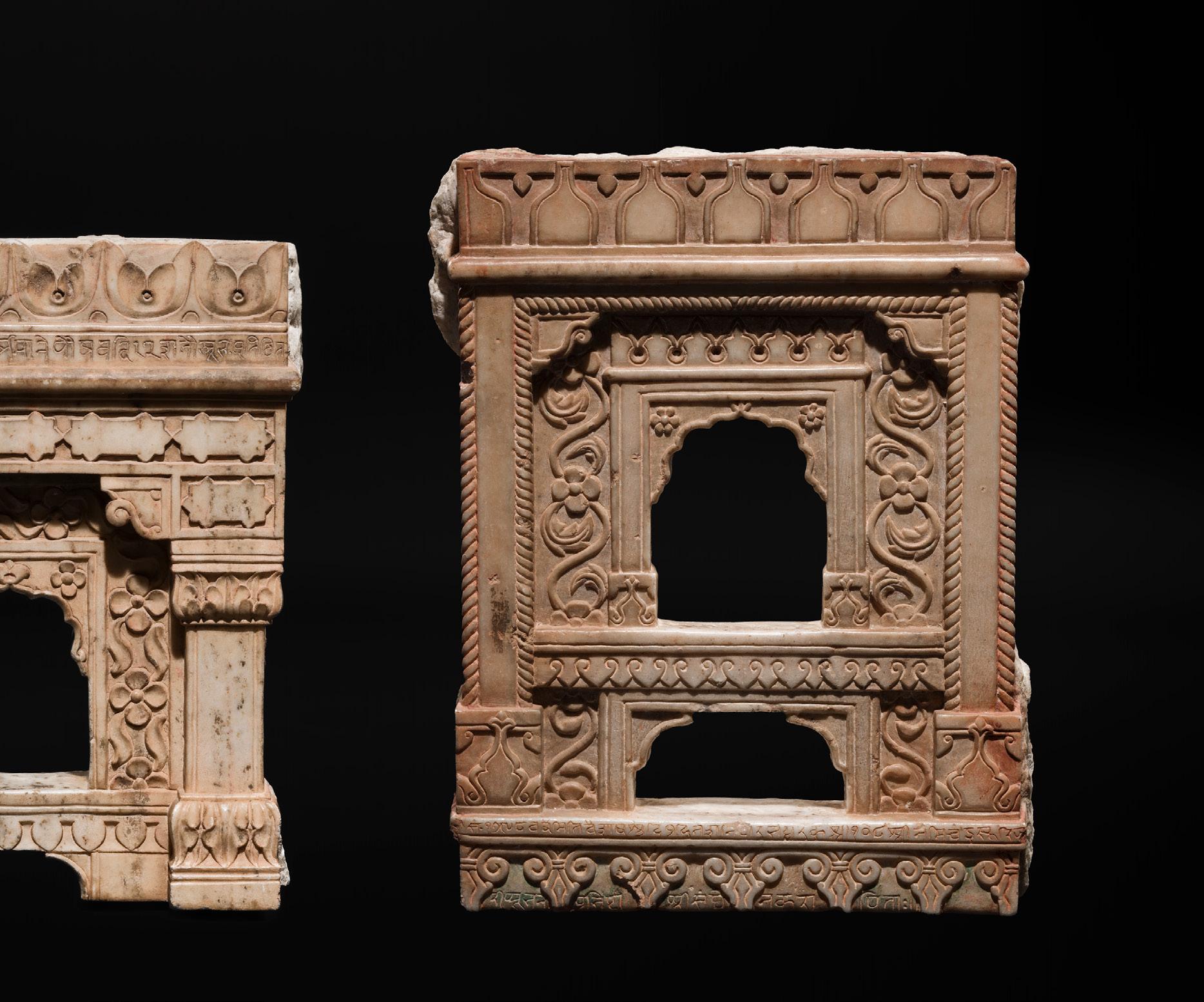
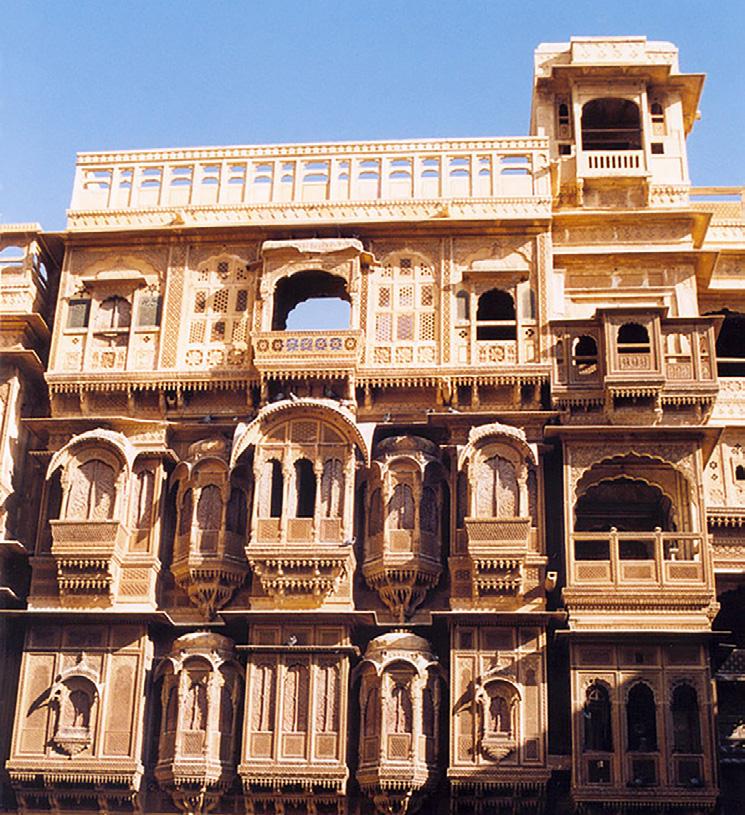
AUCTION RESULT COMPARISON
Type: Related
Auction: Christie’s London, 24 October 2019, lot 147
Price: GBP 10,000 or approx. EUR 16,000 (for one) converted and adjusted for inflation at the time of writing
Description: A Mughal red sandstone panel, India, 17th century
Expert remark: Compare the related form and design. Note the different material and size (139.7 cm).
AUCTION RESULT COMPARISON
Type: Related
Auction: Bonhams London, 19 April 2007, lot 387
Price: GBP 4,800 or approx. EUR 11,000 (for one) converted and adjusted for inflation at the time of writing
Description: A Mughal red sandstone chini kana panel, India, early 17th century
Expert remark: Compare the related form and design. Note the different material and size (98.5 cm).
Estimate EUR 6,000
Starting price EUR 3,000
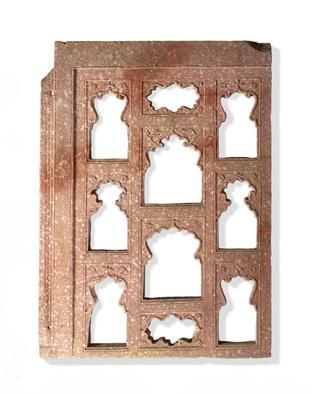
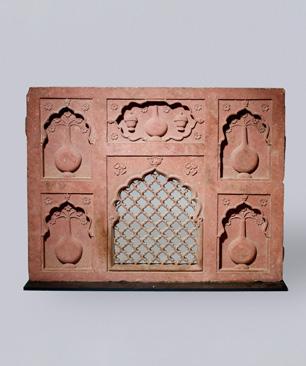
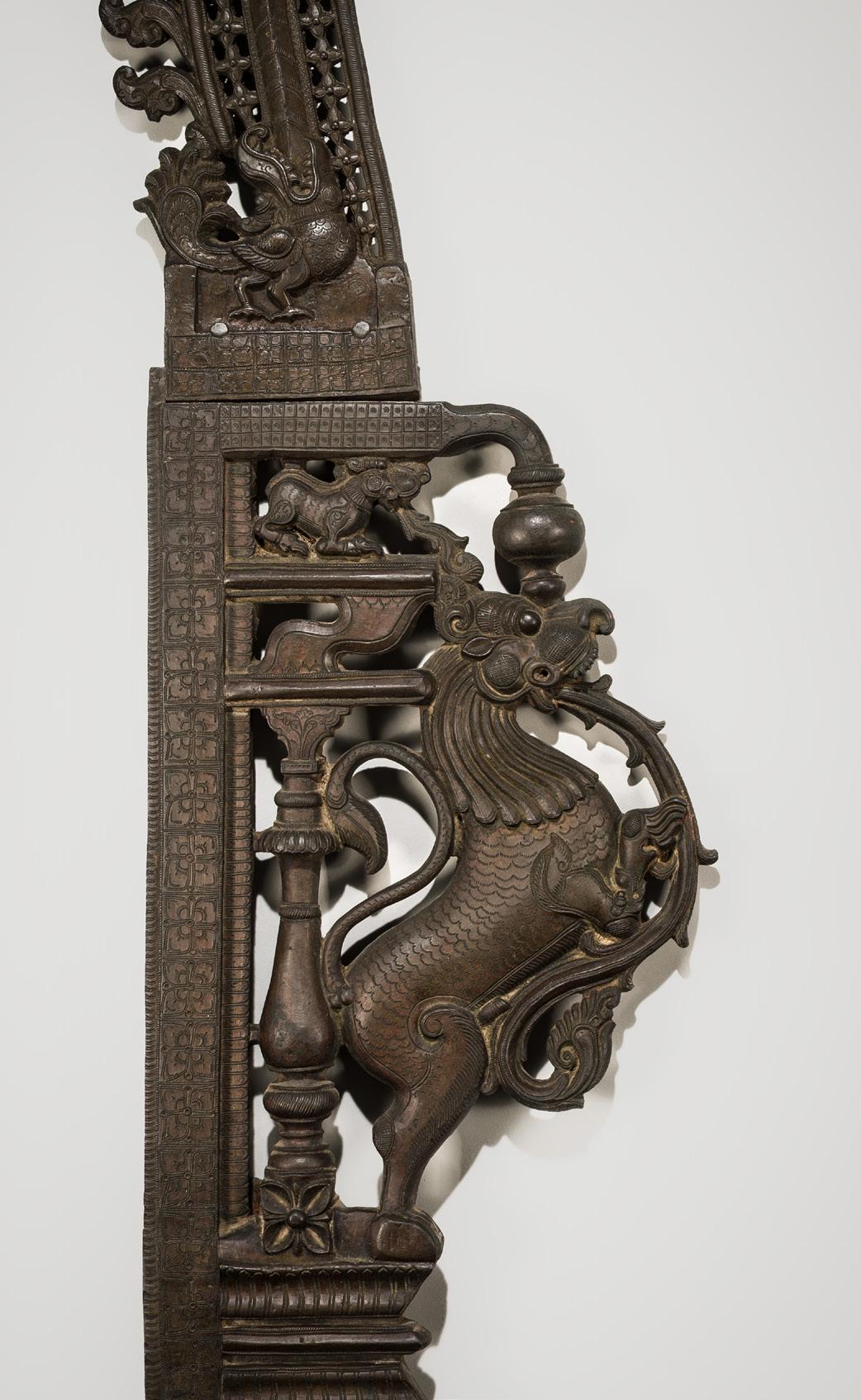
93
South India. Separately cast in openwork, the ornamental arch edged by tongues of flames and culminating in a fierce yali-head to center, supported on two columns with a tiered base and depicting a rearing yali with its paws raised and gaping mouths revealing sharp fangs, all below recumbent yalis spewing flames.
Provenance: The Kienzle Family Collection, Stuttgart, Germany. Acquired between 1950 and 1985 by siblings Else (1912-2006), Reinhold (19172008), and Dr. Horst Kienzle (1924-2019), during their extensive travels in Asia. Subsequently inherited by Dr. Horst Kienzle and bequeathed to the Museum für Asiatische Kunst, Radevormwald, Germany. Released through museum deaccession in 2024.
Condition: Excellent condition with minor wear and casting irregularities. Small nicks and minor traces of use.
Dimensions: Height 146 cm
This magnificent prabhavali from Kerala must have been a surround for an important deity in a shrine. The prabhavali acts as an aura to an icon and is an attribute used to denote divinity or royalty. Judging from the large size and its casting as a free-standing nimbus, this may have been used in conjunction with an utsava murti that was worshiped at darshan outside the temple premises or during special festivals. The intricate decorations of the arch are symbolic of fire and would have been a powerful backdrop to the idol.
The word prabhavali literally means a ‘circle of flames’ or ‘garland of light’, derived from the Sanskrit words prabha for ‘lustre’, ‘light’, or ‘shine’, and vali for ‘circle’. It represents an exquisite, ornamental arch that can be seen behind deities in most Hindu temples and homes in India.
Literature comparison:
Compare a closely related large bronze arch with a yali head to the center in the Raja Dinkar Kelkar Museum, Pune. Compare a closely related bronze prabha and peedom, dated 1800-1900, in the Krishnapuram Palace, Kayamkulam, Kerala.
Estimate EUR 8,000
Starting price EUR 4,000
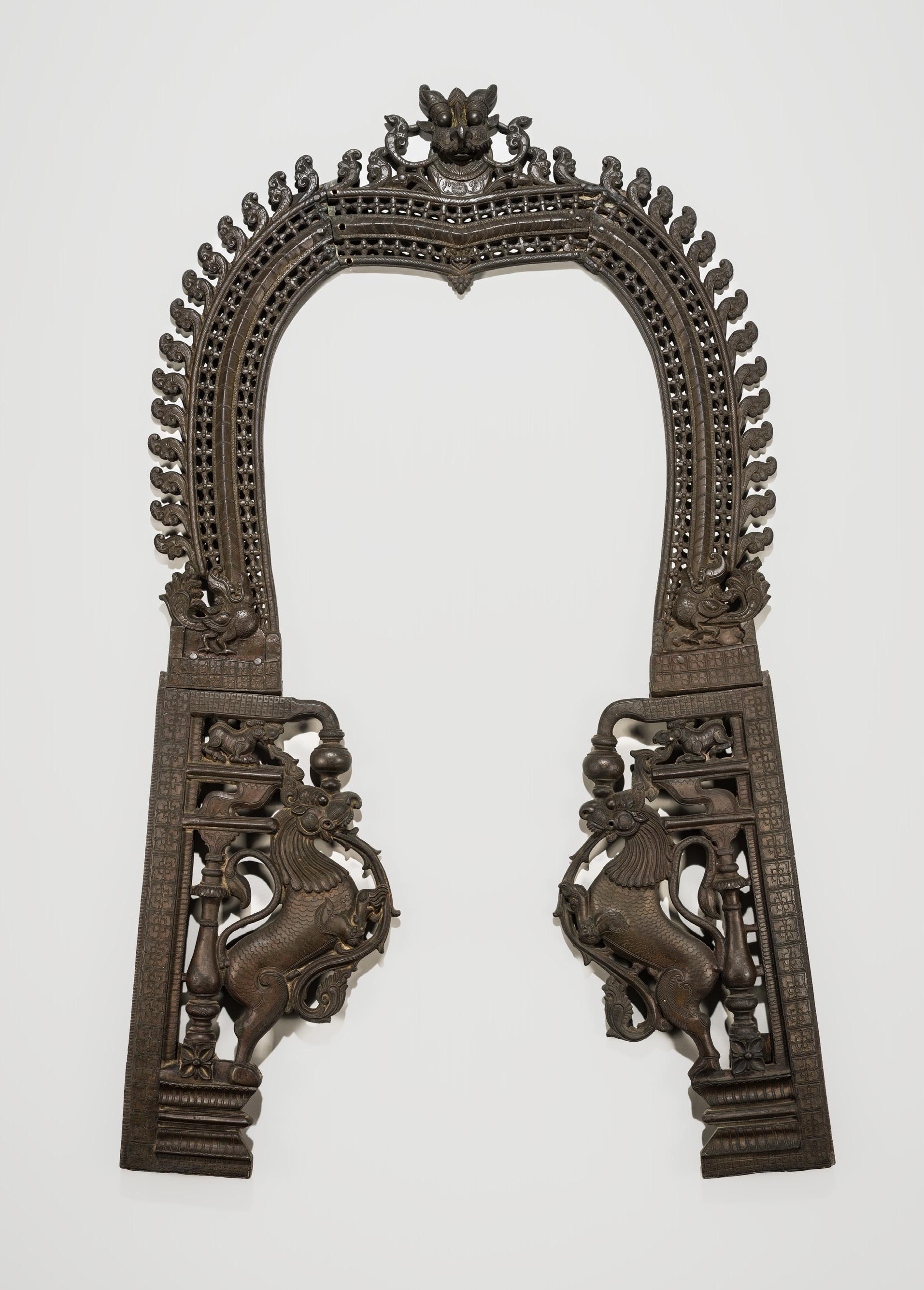
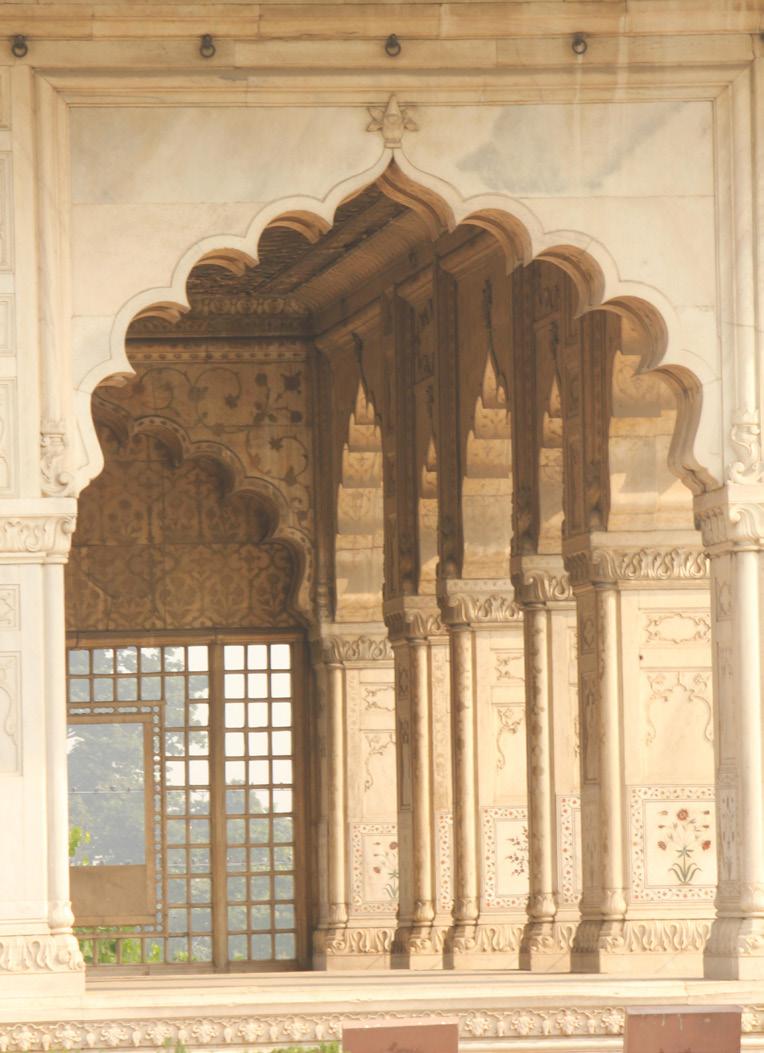
Western India. The multifoil arch framed by a rectangular pediment divided into multiple intricately carved panels with geometric patterns, decorative bands, and floral designs, all richly polychromed in shades of red, green, yellow, and blue. The doors with molded panels below metal bars set behind the arch.
Provenance: The Kienzle Family Collection, Stuttgart, Germany. Acquired between 1950 and 1985 by siblings Else (1912-2006), Reinhold (1917-2008), and Dr. Horst Kienzle (1924-2019), during their extensive travels in Asia. Subsequently inherited by Dr. Horst Kienzle and bequeathed to the Museum für Asiatische Kunst, Radevormwald, Germany. Released through museum deaccession in 2024.
Condition: Good condition overall with expected wear, traces of use, manufacturing irregularities, and natural imperfections, scattered chips and losses, age cracks, extensive flaking and rubbing to lacquer.
Dimensions: Height 273 cm
Gujarat’s wood architecture is a testament to the region’s rich artisanal heritage, particularly evident in the traditional havelis of Patan and Ahmedabad, where intricately carved columns, brackets, and balconies feature detailed geometric, floral, and textile-inspired motifs. These structures, dating as far back as the 16th century, highlight the enduring craftsmanship of the Hindu Suthar community, whose legacy of wood carving continues to shape the state’s cultural identity. While modern architecture in Gujarat has shifted away from wood, its historical significance endures, most strikingly in landmarks like the Swaminarayan Temple in Kalupur, Ahmedabad, where elaborately carved wooden elements reflect both religious devotion and artistic excellence.
The arched form seen here draws from the ancient Gujarati tradition of the torana, an ornamental gateway that framed sacred and ceremonial passageways across Hindu, Jain, and Buddhist architecture. From as early as the 10th century, these cusped arches and floral spandrels appeared in temple and civic architecture throughout western India. By the 17th century, this distinctive arch form had entered the mainstream Mughal design vocabulary, visible most clearly in monumental structures like the Red Fort in Delhi. There, the cusped arch re-emerges in imperial stone, echoing the carved wooden traditions of Gujarat in a new material language. The present doorway, with its layered carving and classic arched silhouette, stands not only as an object of regional craftsmanship but also as part of a broader architectural continuum, one that stretches from the merchant homes of Gujarat to the palaces of the Mughal court.
LITERATURE
COMPARISON

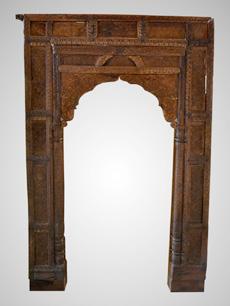
Compare two closely related arched doorways from Gujarat, dated to the late 19th century, in the South Asia Collection Museum, Norwich, accession numbers IN5.2 and IN5.3, illustrated by Jay Thakkar, Report on Wooden Architecture Collection of Gujarat at SADACC Trust, United Kingdom, 2015, p. 25 and 27, respectively. A copy of the full report showing further examples of Gujarat architecture is available upon request.
Estimate EUR 4,000
Starting price EUR 2,000
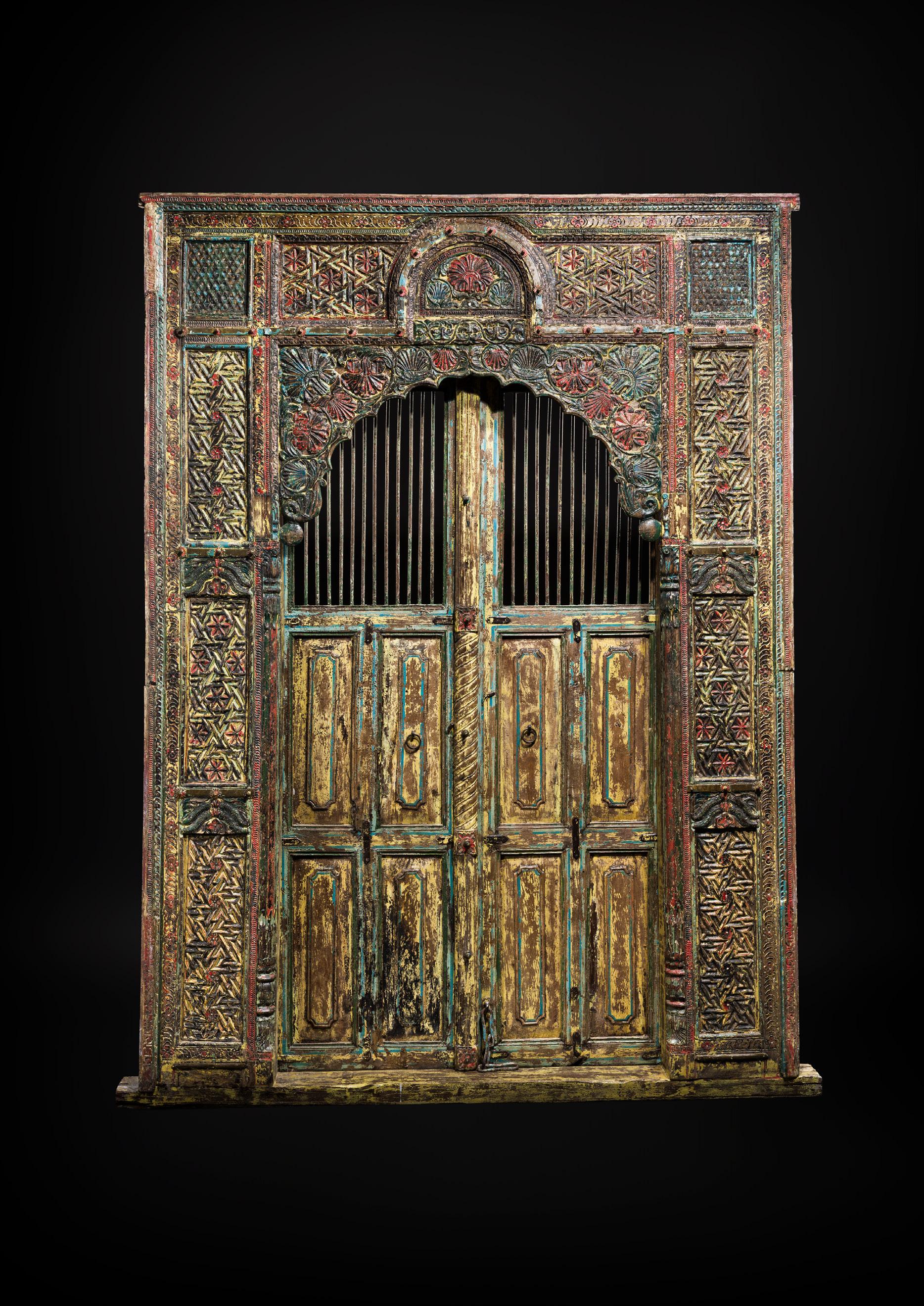
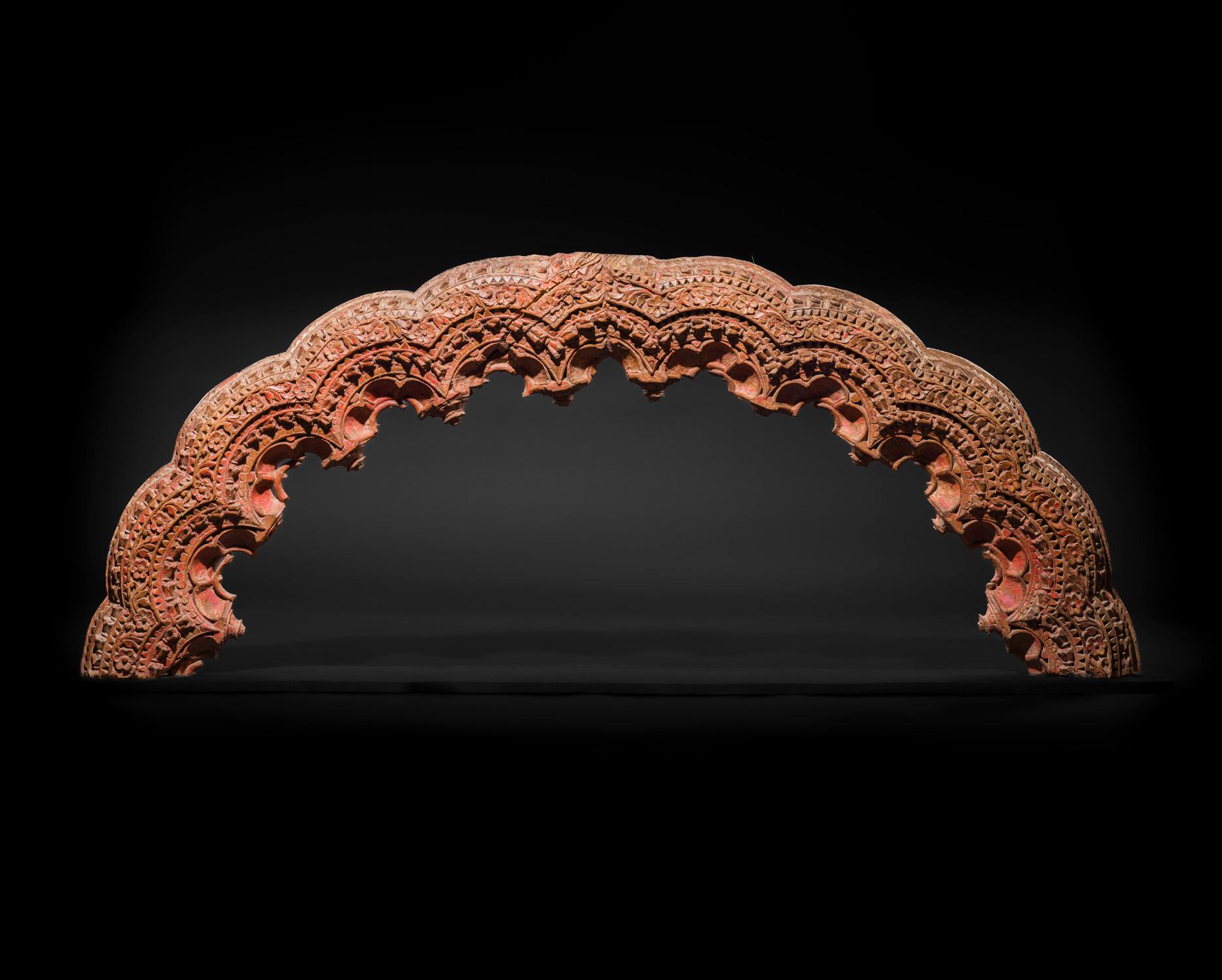
Western India, 19th century or earlier. Of polylobed form, each foil elegantly shaped with petal-like contours and its apex crowned by stylized flowerheads. The body outlined by rope moldings enclosing deeply carved scrolling tendrils, foliate designs, dentil bands, and further flowerheads, composed of two separately carved sections, joined at the apex of the upper central point.
Provenance: Galerie Hardt (established in 1976), Radevormwald, Germany, before 2020. Acquired by the gallery’s founder Peter Hardt (b. 1946) during his extensive travels in Asia, the first of which occurred during a formative world tour in 1973. Condition: Good condition overall with old wear, manufacturing irregularities, and signs of weathering and erosion, including some chips and losses to exposed areas, fissures and age cracks, flaking and extensive rubbing to lacquer.
Dimensions: Length 196.8 cm
In the regions of Gujarat and Central India, a particular variant known as the Makara Torana flourished in the 11th century. Named after the mythical sea creature Makara, the vahana (vehicle) of the sea god Varuna, this form features the Makara motif prominently at the base of the arch. These designs found remarkable expression in temple architecture, most notably at the Sun Temple in Modhera, from which the present lot clearly draws inspiration.
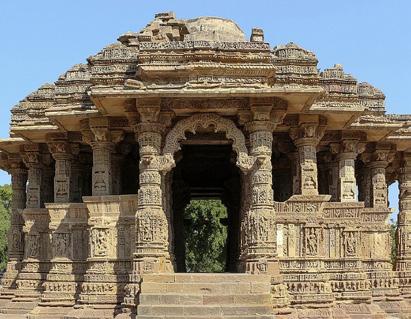
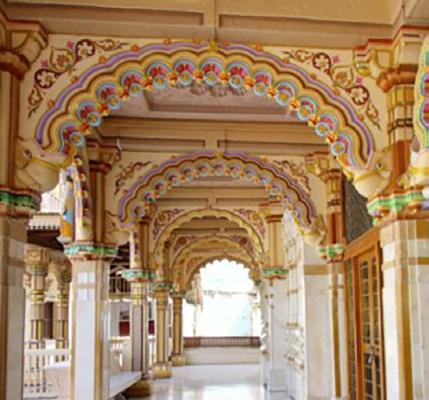
Exterior of a Swaminarayan Temple in Kalupur, Ahmedabad, Gujarat
Gujarat’s wood architecture is a testament to the region’s rich artisanal heritage, particularly evident in the traditional havelis of Patan and Ahmedabad, where intricately carved columns, brackets, and balconies feature detailed geometric, floral, and textile-inspired motifs. These structures, dating as far back as the 16th century, highlight the enduring craftsmanship of the Hindu Suthar community, whose legacy of wood carving continues to shape the state’s cultural identity. While modern architecture in Gujarat has shifted away from wood, its historical significance endures—most strikingly in landmarks like the Swaminarayan Temple in Kalupur, Ahmedabad, where elaborately carved wooden elements reflect both religious devotion and artistic excellence.
LITERATURE COMPARISON
Compare an earlier sandstone temple illika-torana (cusped arch) from Palitana, Gujarat, dated 11th-12th century, in the Victoria & Albert Museum, accession number IM.53 to 55-1916.
Estimate EUR 1,000
Starting price EUR 500

A COFFERED WOOD DOOR DEPICTING DANCING DEITIES, 19TH TO 20TH CENTURY OR EARLIER
Western India. Boldly carved with five rows of three vertical panels depicting various deities including Shiva and Parvati to the top, classical dancers, and musicians. Each panel is housed within a lobed frame and interspersed with metal fittings and separated by pairs of large flowerheads, all below two circular medallions to the top enclosing recumbent birds with voluminous plumage. The door is set with a C-form handle to the back.
Provenance: Galerie Hardt (established in 1976), Radevormwald, Germany, before 2020. Acquired by the gallery’s founder Peter Hardt (b. 1946) during his extensive travels in Asia, the first of which occurred during a formative world tour in 1973.
Condition: Good condition with expected wear, traces of use, and natural imperfections including age cracks and fissures, minor losses, small chips to edges, scattered light nicks and surface scratches, the fittings with minor corrosion. Remnants of varnish and pigment. The wood with a fine, naturally grown, dark patina.
Dimensions: Size 157 x 75 cm (excl. stand), 170 x 75 cm (incl. stand)
Mounted on a modern metal stand. (2)
Carved wooden doors formed an important part of traditional homes, often carrying symbolic motifs that were sometimes enhanced with natural coloring. The present example features figural panels depicting dancers, musicians, and deities, reflecting themes commonly seen in Odishan temple and folk art. Circular medallions and animal forms add to the symbolic character, often representing auspiciousness and protection. Likely once part of a noble or merchant household, the door combines craftsmanship with cultural narrative, serving both decorative and spiritual purposes.
Literature comparison: Compare a related wood door from Odisha, dated to the 20th century, 180.3 cm high, in the Kala Bhoomi Odisha Crafts Museum, Bhubaneswar, museum number 1/45/24/1/17/01086, and illustrated in the Virtual Museum of Images & Sounds, accession number KB00828.
AUCTION RESULT COMPARISON
Type: Closely related
Auction: Bonhams London, 13 November 2005, lot 479
Price: GBP 1,200 or approx. EUR 2,900 converted and adjusted for inflation at the time of writing
Description: A coffered wood door, Western India, 18th/19th century
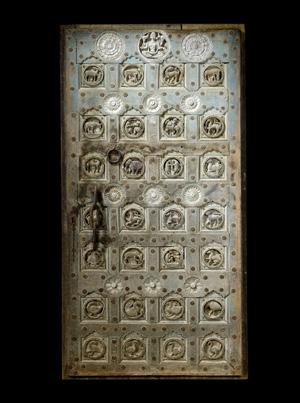
Expert remark: The tightly organized, modular grid of figures and rosettes is also found in doors from Rajasthan and Gujarat, as evidenced by this example. Note the size (174 x 90 cm).
Estimate EUR 2,000
Starting price EUR 1,000


A MUGHAL RED SANDSTONE PANEL, 18TH-19TH CENTURY
Northern India. Finely carved with a crown-like domed roof composed of rich vegetal elements rising from a horizontal base pierced with stylized flowerheads. A frieze of petals anchors the lower register, from which the composition ascends into curving leaf forms that arch outward and terminate in spiral curls, surmounted by a lotus bud finial.
Provenance: Galerie Hardt (established in 1976), Radevormwald, Germany, before 2020. Acquired by the gallery’s founder Peter Hardt (b. 1946) during his extensive travels in Asia, the first of which occurred during a formative world tour in 1973.
Condition: Very good condition with minor wear and natural imperfections. Obvious losses, signs of weathering and erosion, remnants of pigment predominately to the lower area, minor chips, light surface scratches. The stone with a fine, naturally grown, smooth patina.
Weight: 27.7 kg (incl. stand)
Dimensions: Height 40 cm (incl. stand)
Mounted on an associated stand. (2)
This beautiful panel displays the Mughal fascination with naturalistic designs. Equally, the fluidity of the work demonstrates the strength of the Indian stone carving tradition. Stone wall panels ornamented with natural motifs decorated the walls of many Mughal architectural monuments. The Mughals delighted in observing nature, which resulted in the representation of flora and fauna in many different mediums. The red sandstone is typical of the Mathura, Sikri, and Chunar regions of northern India.
LITERATURE COMPARISON
Compare a related Mughal sandstone panel, dated c. 1700, in the Minneapolis Institute of Art, accession number 2000.65.

AUCTION RESULT COMPARISON
Type: Related
Auction: Sotheby’s London, 11 December 2020, lot 35
Price: GBP 20,000 or approx. EUR 32,000 converted and adjusted for inflation at the time of writing
Description: A Mughal carved openwork sandstone panel (Jali), North India, second-half 18th century/early 19th century

Expert remark: Compare the related stone and manner of carving. Note the openwork and different size (111 cm).
Estimate EUR 2,000
Starting price EUR 1,000
The column from Western Asia, 18th-19th century or possibly earlier. The base and capital from Western India, Gujarat, 19th to mid-20th century. Of cylindrical form, the wooden shaft carved in high relief with stylized square Kufic, Naskh, and Thuluth scripts containing religious invocations and devotional prayers from the Shahada and the Basmala, two fundamental declarations of the Islamic faith, arranged in four encircling bands.
The removable stone base finely decorated with lozenge and checkered patterns, stylized floral heads, and a prominent rope-like band encircling its upper section. The wood capital embellished with further foliate motifs and a broad beaded band. Both the inscriptions on the shaft and the decorative elements of the base and capital partially lacquered in shades of turquoise blue.
Provenance: Galerie Hardt (established in 1976), Radevormwald, Germany, before 2020. Acquired by the gallery’s founder Peter Hardt (b. 1946) during his extensive travels in Asia, the first of which occurred during a formative world tour in 1973.
Condition: Good condition with expected wear, traces of use, manufacturing irregularities, signs of weathering and erosion, scattered nicks and scratches, natural fissures and age cracks, small losses to exposed areas, encrustations, remnants of pigment. The base and column appear to have been associated in the 19th century.
Dimensions: Height 295 cm
The pillar is fitted with metal plates at both ends to support and screw the sandstone base and stone crown.
The inscription ‘There is no god but Allah, and Muhammad is His Messenger’ (La ilaha illa Allah, Muḥammadun Rasulu Allah) contained in the upper section of the carved shaft refers to the Shahada, a declaration of faith in the oneness of God, according to Islamic belief and the teachings of the Prophet Muhammad. Its recitation constitutes one of the Five Pillars of Islam in Sunni tradition and represents the profession of faith that every Muslim must pronounce to enter the Islamic religion. The presence of this formula on the surface of the column imbues it with symbolic significance, presenting this foundational statement as a spiritual and moral cornerstone of the Islamic community.
‘In the name of God, the Most Gracious, the Most Merciful’ (Bismillah al-Raḥman al-Rahim) is also inscribed along the intermediate sections of the shaft. Known as the Basmala, this revered formula precedes all but one sura (chapter) of the Qur’an (the exception being Sura 9, al-Tawba) and is among the most frequently uttered verses in the devotional and everyday lives of Muslims. More than a textual preamble, the Basmala serves as a verbal invocation of the divine, recited before engaging in a wide range of actions, from prayer and study to eating or travel. Its inclusion on the column may be understood as a symbolic sanctification of the architectural space, an invocation of divine blessing, and an expression of humility before God.
LITERATURE COMPARISON
Compare a pair of earlier wood square columns with floriated Kufic script featuring verses from the Qur’an, Syria, dated 13th century, in the Museum With No Frontiers, inventory number 145-146.
Estimate EUR 6,000
Starting price EUR 3,000
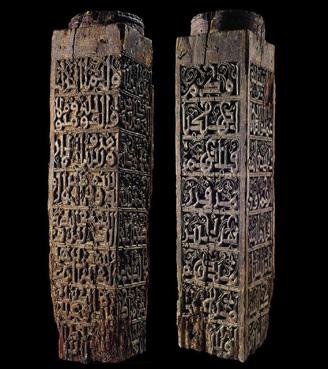

Western India, Gujarat. Each shaft skillfully carved, of circular crosssection with high-relief fluting. The lower portion decorated with encircling foliate designs and a thick, rope-like band, while the upper part transitions into a square-cross section, embellished with stylized acanthus leaves and further floral and geometric motifs framed within a square panel. (2)
Provenance: Galerie Hardt (established in 1976), Radevormwald, Germany, before 2020. Acquired by the gallery’s founder Peter Hardt (b. 1946) during his extensive travels in Asia, the first of which occurred during a formative world tour in 1973.
Condition: Good condition overall with expected wear, signs of weathering, few minor losses to edges, scattered nicks and scratches, age cracks and fissures, partially loose elements to the base, small repairs, flaking to lacquer, and extensive remnants of turquoise pigments.
Dimensions: Height 243 cm (each)
Gujarat’s wood architecture is a testament to the region’s rich artisanal heritage, particularly evident in the traditional havelis of Patan and Ahmedabad, where intricately carved columns, brackets, and balconies feature detailed geometric, floral, and textile-inspired motifs. These structures, dating as far back as the 16th century, highlight the enduring craftsmanship of the Hindu Suthar community, whose legacy of wood carving continues to shape the state’s cultural identity. While modern architecture in Gujarat has shifted away from wood, its historical significance endures—most strikingly in landmarks like the Swaminarayan Temple in Kalupur, Ahmedabad, where elaborately carved wooden elements reflect both religious devotion and artistic excellence.
The shafts of typical Gujarati columns, such as those comprising the present lot, are characteristically articulated into three distinct sections. The lower portion (stambh), generally occupying two-thirds of the total height, is circular in section and often marked by vertical concave ribs that culminate in a band of budding motifs. This is followed by a transitional segment (kanda), which commonly displays mosque-lamp motifs, foliate designs, and small animal depictions. The uppermost section assumes a crisp rectangular profile, typically adorned with geometric twodimensional patterns and floral ornamentation.

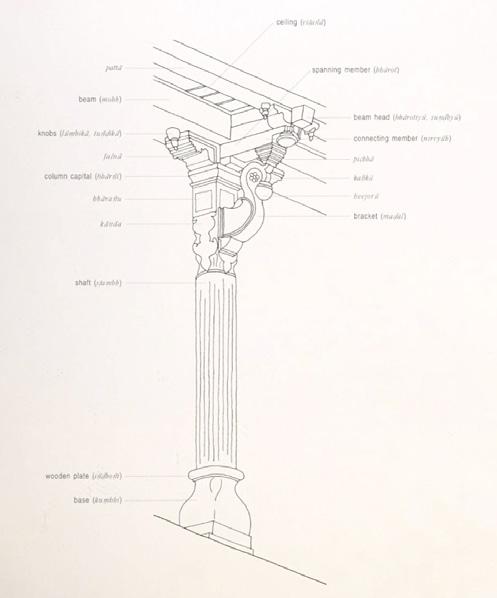
A diagram of the structural elements of a typical wooden column from a Gujarati haveli, see Jay Thakkar, Naqsh: The Art of Wood Carving of Traditional Houses of Gujarat: Focus on Ornamentation, 2004, p. 7
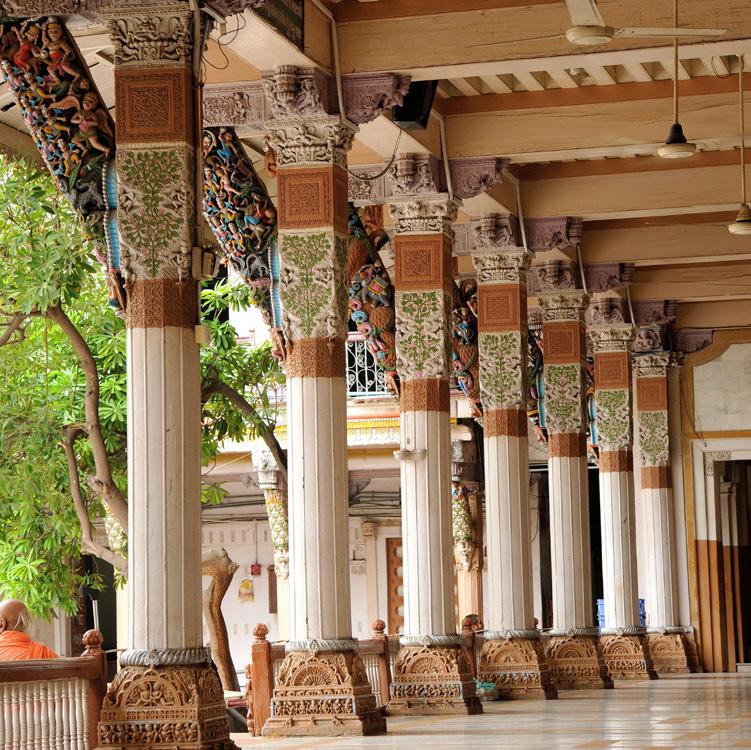
LITERATURE COMPARISON

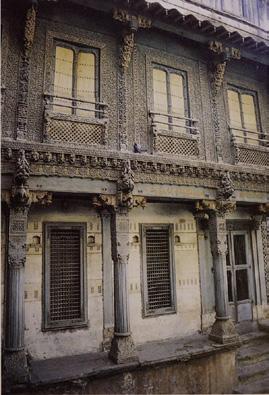
Compare a closely related wood column (thamblo), with a square base and wood mythical beast bracket, attributed to North or Central Gujarat and dated mid19th century, in the South Asia Collection Museum, Norwich, illustrated by Jay Thakkar, Report on Wooden Architecture Collection of Gujarat at SADACC Trust, United Kingdom, 2015, p. 43. A copy of the full report showing further examples of Gujarat architecture is available upon request. See also a Gujarat haveli with closely related wood columns, illustrated by Jay Thakkar, Naqsh: The Art of Wood Carving of Traditional Houses of Gujarat: Focus on Ornamentation, 2004, p. 13, fig. 13.I.
Estimate EUR 6,000
Starting price EUR 3,000

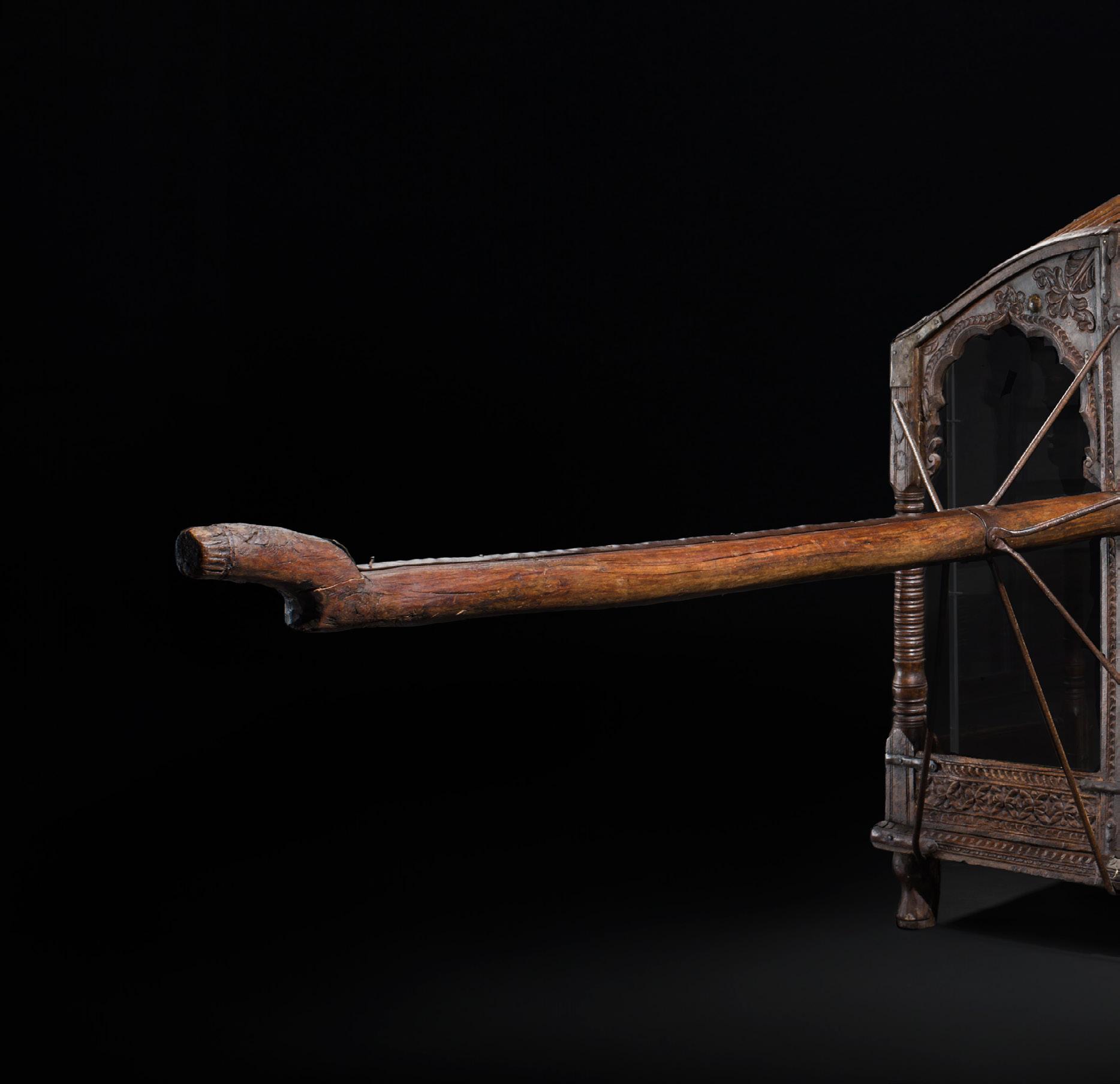
Constructed with iron and brass fittings, the palanquin with a domed latticework roof supported by a triple arched lintel above turned columns set on a flat bed, the exterior richly carved in shallow relief with scrolling foliage and floral designs, all supported on four short feet, flanked by two long poles.
Provenance: The Kienzle Family Collection, Stuttgart, Germany. Acquired between 1950 and 1985 by siblings Else (1912-2006), Reinhold (1917-2008), and Dr. Horst Kienzle (1924-2019), during their extensive travels in Asia. Subsequently inherited by Dr. Horst Kienzle and bequeathed to the Museum für Asiatische Kunst, Radevormwald, Germany. Released through museum deaccession in 2024.
Condition: Good condition with expected wear, traces of use, small repairs to the poles, age cracks and splits, minor chips, dents, few tiny losses, the iron fittings with areas of corrosion.
Dimensions: Length 415 cm (incl. handles), Height 110 cm
The interior has been fitted as a display case with fully functional light fixtures and acrylic glass panels. These fittings can be entirely removed, thus restoring the piece to its original condition without difficulty.
Palanquins were the most popular mode of transportation in British India before the advent of horse-drawn carriages and the railroad. Traditionally carried by bearers, these enclosed litters provided comfort and privacy, especially for women of high status. One enduring tradition is the bridal palanquin, still used in some weddings today. Its intricately carved door and window openings often mirror the architectural motifs of garden courtyards, enhancing the palanquin’s delicate feminine aesthetic.
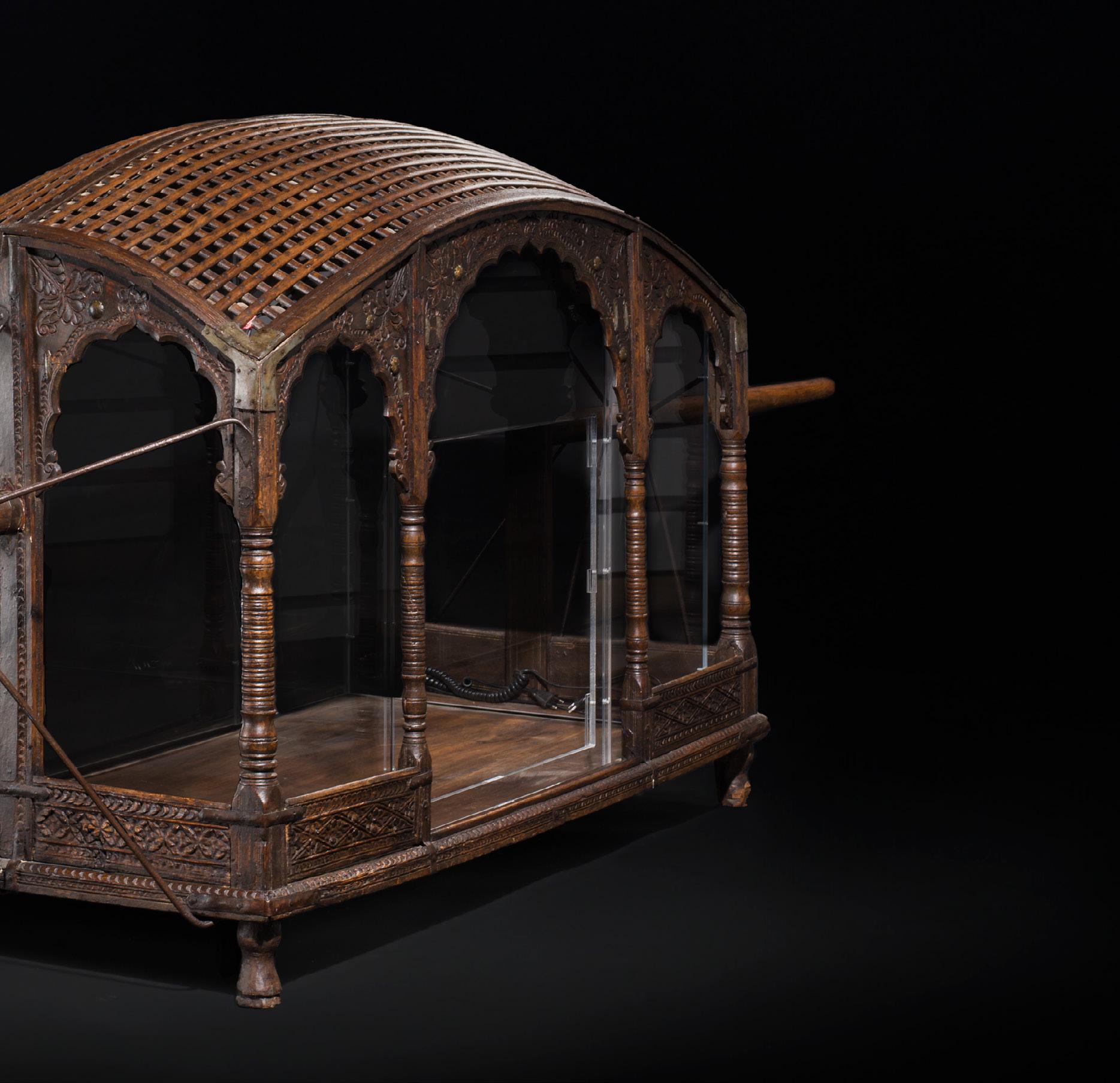
LITERATURE COMPARISON
Compare a closely related palanquin, dated to the 19th century, India, 398 cm long, in the Sheikh Faisal Bin Qassim Al Thani Museum, inventory number FBQ.HH.523.
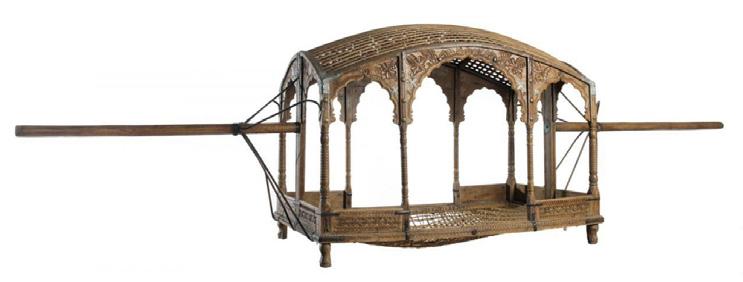
Estimate EUR 6,000
Starting price EUR 3,000
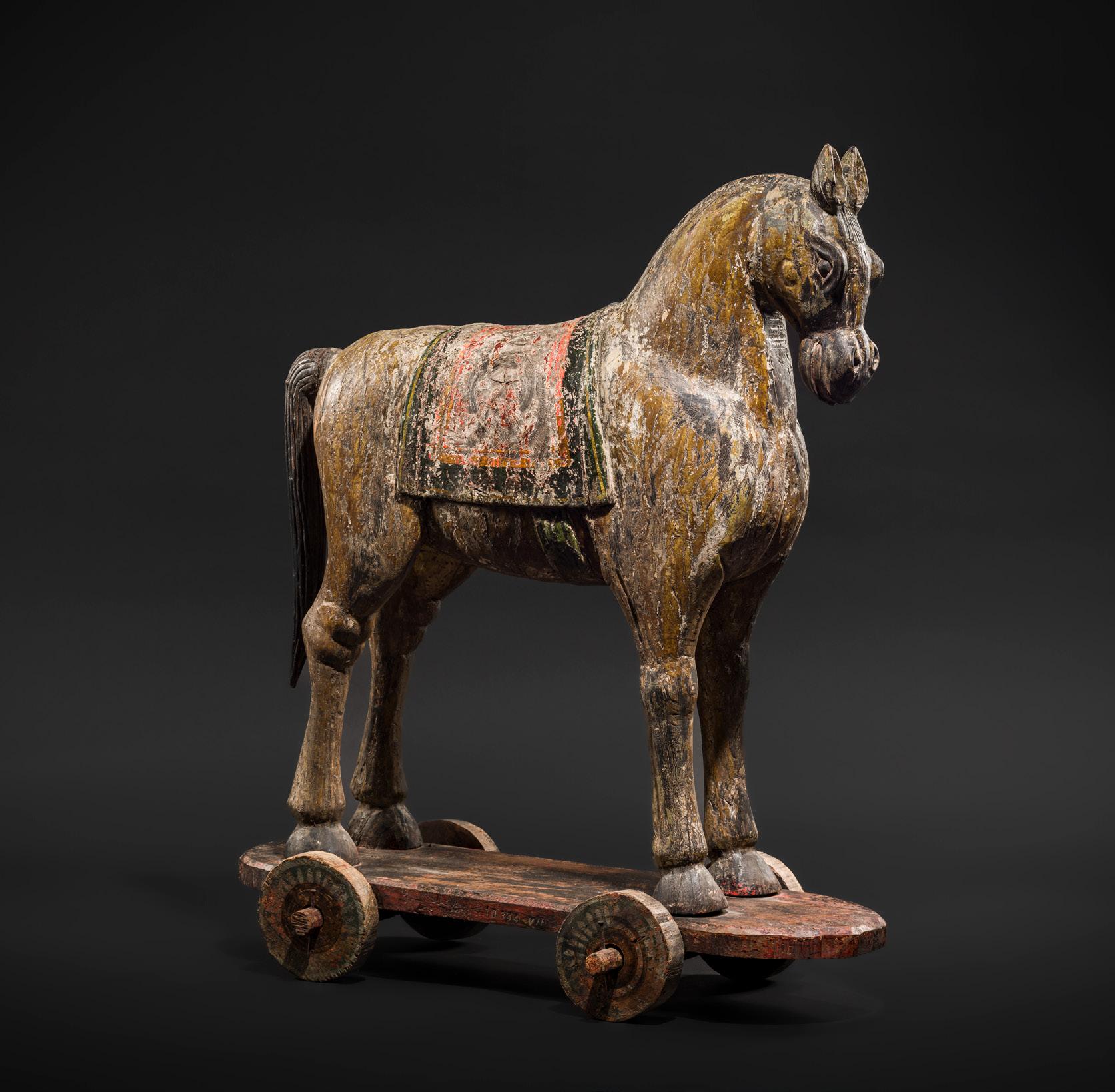
A RARE AND LARGE POLYCHROME WOOD PULL-TOY HORSE
India, Rajasthan, 19th to first half of the 20th century. Boldly carved, standing foursquare on a wheeled base, the animal draped with a colorful saddlecloth, the pendent tail and mane falling to one side deeply incised, the head with slightly bulging eyes, round muzzle, and upright ears, the lips parted to reveal the teeth.
Provenance: Galerie Hardt (established in 1976), Radevormwald, Germany, before 2020. Acquired by the gallery’s founder Peter Hardt (b. 1946) during his extensive travels in Asia, the first of which occurred during a formative world tour in 1973.
Condition: Wear, manufacturing irregularities, minor age cracks, extensive rubbing and losses to polychromy, scratches, small nicks, old repairs and minor touchups.
Dimensions: Length 82.2 cm, Height 97.3 cm
This exquisitely carved wooden pull-toy horse is a rare example of Anglo-Raj craftsmanship, likely commissioned for the child of a British officer or Indian noble at the height of the colonial period during the late 19th century. Such toys were never mass-produced; each was individually crafted by local artisans, often given as gifts to aristocratic children and intended not only as playthings but also as markers of status and cultural exchange.
COMPARISON
Type: Related
Auction: Christie’s New York, 21 September 2007, lot 312 A
Price: USD 5,000 or approx. EUR 6,500 converted and adjusted for inflation at the time of writing
Description: A polychromed wooden figure of a horse, India, Rajasthan, 19th century
Expert remark: Compare the closely related modeling and manner of carving with similar pose and features. Note the size (77.5 cm) and better-preserved pigments.
Estimate EUR 2,000
Starting price EUR 1,000
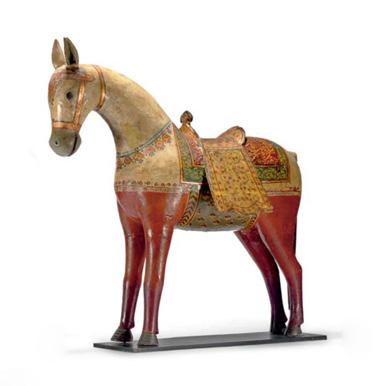
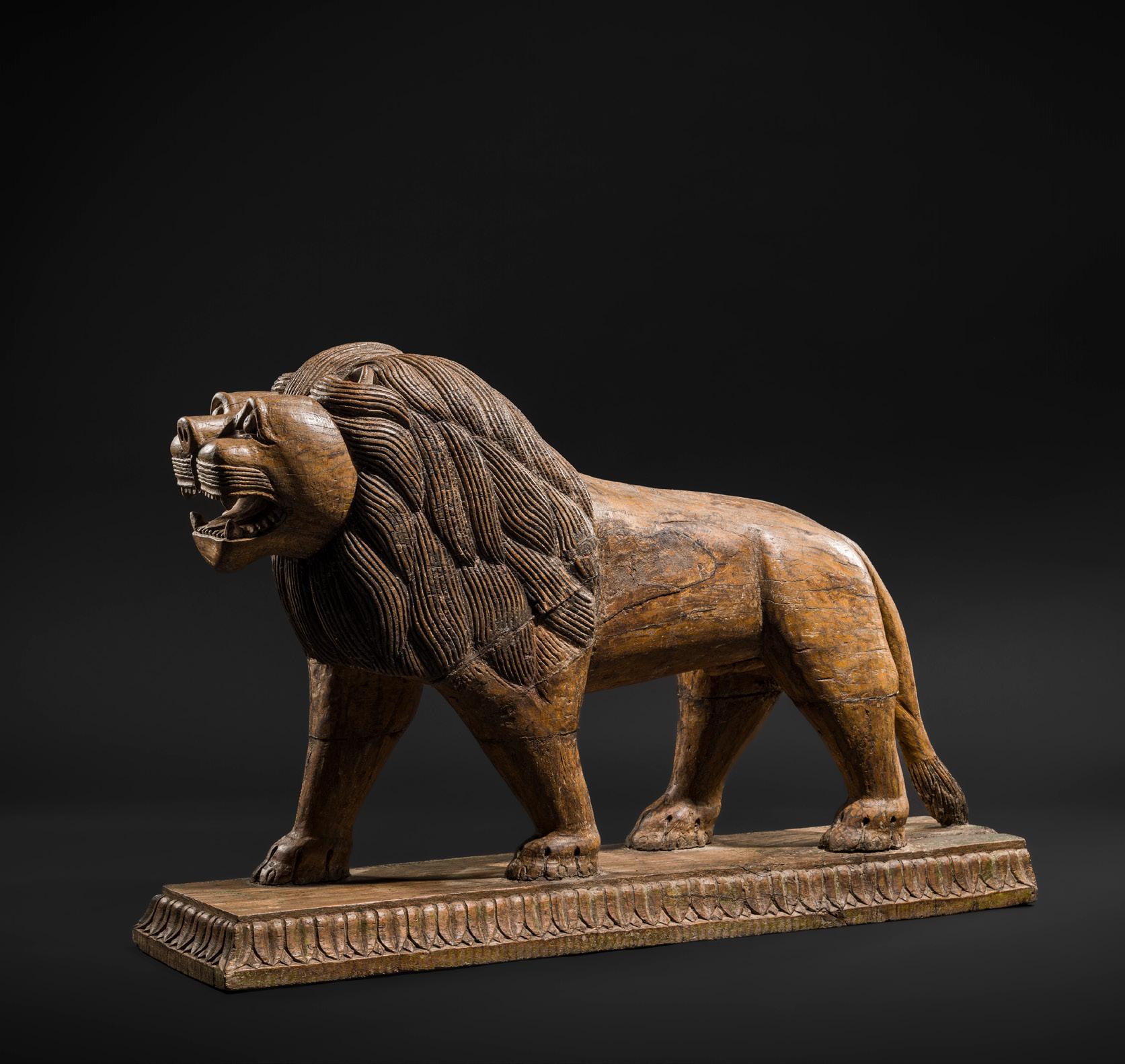
AUCTION RESULT COMPARISON
Type: Related
Auction: Lyon & Turnbull, Edinburgh, 5 September 2024, lot 510
Price: GBP 4,536 or approx.
102
A LARGE WOOD FIGURE OF A LION, SOUTH INDIA, PROBABLY TAMIL NADU, 19TH-20TH CENTURY
Skillfully carved, standing foursquare in a dynamic stance atop a rectangular plinth with a foliate border. The large body of the animal extending into a bushy tail and a thick mane that frames its raised head, holding a fierce expression marked by a prominent brow, bulging eyes, and a protruding snout with incised whiskers and open jaws revealing sharp fangs and a boldly carved tongue.
Provenance: Galerie Hardt (established in 1976), Radevormwald, Germany, before 2020. Acquired by the gallery’s founder Peter Hardt (b. 1946) during his extensive travels in Asia, the first of which occurred during a formative world tour in 1973.
Condition: Good condition overall with extensive wear, manufacturing irregularities, and natural imperfections, including small chips, fissures, and age cracks. The head and legs of the animal exhibiting signs of restoration. The base with old remnants of green pigment.
Dimensions: Length 118 cm, Height 74.5 cm
EUR 5,500 converted and adjusted for inflation at the time of writing
Description: Indian carved and polychromed life-size model of a lion, 19th century

Expert remark: Compare the closely related subject with similar pose. Note the different size (175 cm).
AUCTION RESULT COMPARISON
Type: Related
Auction: Christie’s New York, 27 September 2023, lot 590
Price: USD 50,400 or approx.
EUR 45,500 converted and adjusted for inflation at the time of writing
Description: A monumental painted wood figure of a lion, South India, Tamil Nadu, 19th-20th century
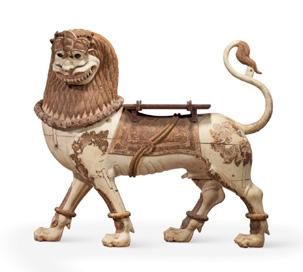
Expert remark: Compare the closely related subject with similar pose. Note the different size (166.4 cm).
Estimate EUR 2,000
Starting price EUR 1,000
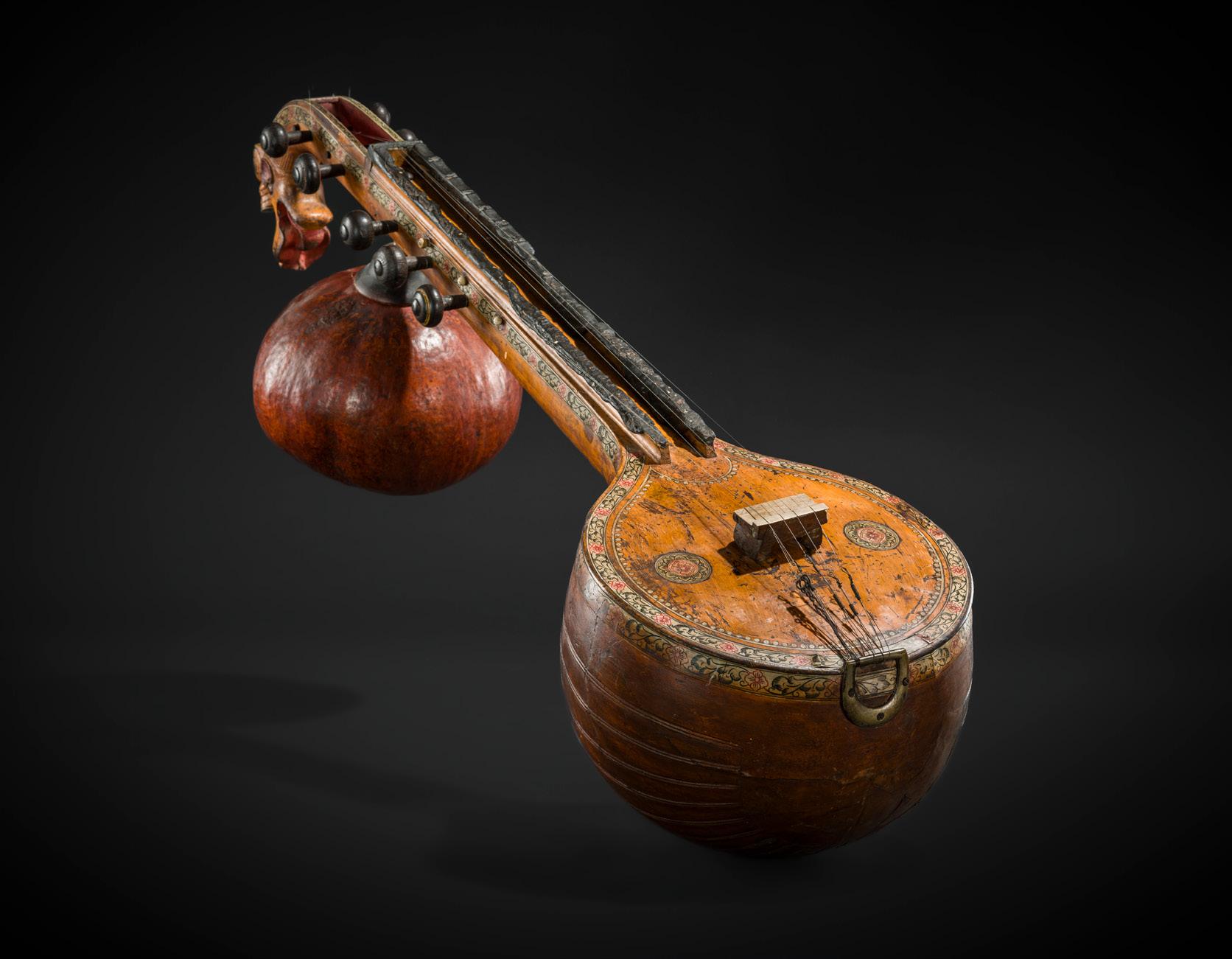
103
India, Tamil Nadu, 20th century. The hollowed body extending to a long neck fitted with 7 flank pegs for the melody and drone strings, the underside issuing a bulbous sarrokai (resonator), all terminating in a pegbox carved as the head of a yali, the edges decorated with foliate bands enclosing flowerheads borne on leafy vines.
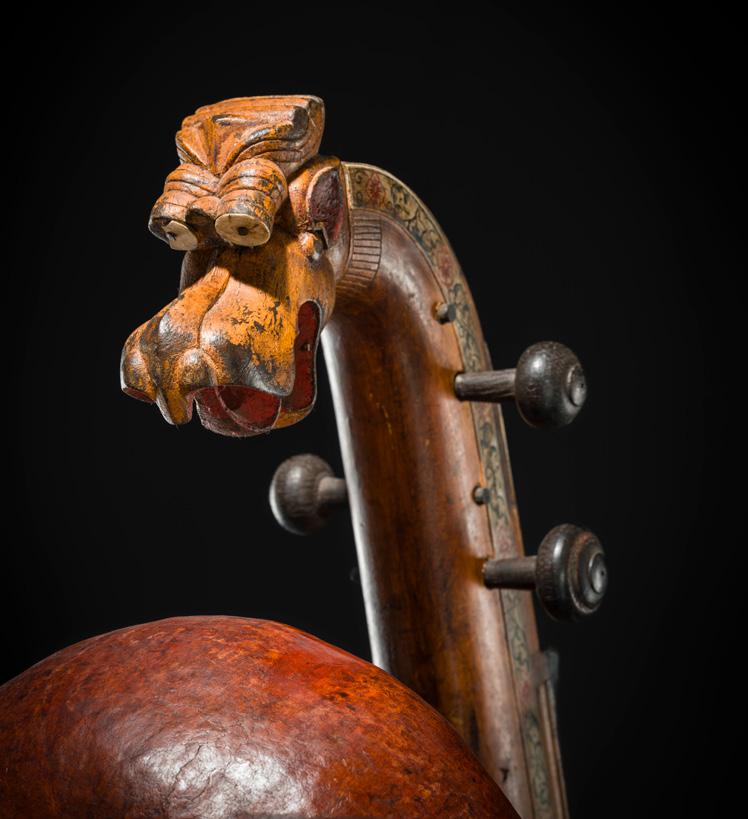
Provenance: Galerie Hardt (established in 1976), Radevormwald, Germany, before 2020. Acquired by the gallery’s founder Peter Hardt (b. 1946) during his extensive travels in Asia, the first of which occurred during a formative world tour in 1973.
Condition: Good condition with expected wear, traces of use, and manufacturing irregularities. Small losses and natural age cracks, some with repairs and touchups, small nicks, occasional light scratches, minor chips.
Dimensions: Length 137 cm
The Saraswati Veena is one of the most revered string instruments in Indian classical music. Named after Goddess Saraswati, the Hindu deity of knowledge, wisdom, music, and arts, the Veena holds a sacred place in Indian culture and tradition. Traditionally carved from a single piece of jackwood, the instrument has four main playing strings and three drone strings, allowing for rich tonal quality and melodic depth. Historically, the Veena is mentioned in ancient texts such as the Vedas, and it has been depicted in temple sculptures and paintings for centuries. Its spiritual significance is heightened by its association with Goddess Saraswati, who is often portrayed holding the instrument in her hands, emphasizing its role in the pursuit of knowledge and inner harmony.
LITERATURE COMPARISON
Compare a closely related modern Saraswati veena, Chennai, made between ca. 1980 and 1991, in the Collection of Musical Instruments at the University of Göttingen, inventory number 1881 +a.
Estimate EUR 1,000
Starting price EUR 500

BONE-INLAID
Burma. In the form of a crocodile with a raised head, upturned curling tail, and finely carved feet with foliate vine shackles, the mouth open in a small grin revealing teeth within, two fangs inlaid in bone, strung with strings from a plate near the crocodile’s head stretching along the back to one of the turning screws. The underside with a sliding cover opening to reveal the hollow interior.
Provenance: Galerie Hardt (established in 1976), Radevormwald, Germany, before 2020. Acquired by the gallery’s founder Peter Hardt (b. 1946) during his extensive travels in Asia, the first of which occurred during a formative world tour in 1973.
Labels: Galerie Hardt, inscribed ‘Musikinstrument Holz, Siam um 1850’, the back ‘Reg 817, B:150 H:20 T:12’, priced at EUR 3,750
Condition: Good condition with wear, traces of use, and natural imperfections including age cracks and fissures. Minor chips, few nicks, small losses, and the strings lost.
Weight: 4.1 kg
Dimensions: Length 148 cm
Sometimes referred to as a crocodile zither, this instrument is known for its characteristic buzzing sound, said to emulate a crocodile’s mating call. Often, when an instrument mimics an animal, it is believed one can
access qualities inherent to the animal, in this case, strength and ability to easily move from land to water. This may be associated with passage between the lands of the living and the dead.
The instrument likely originated with the Mon people, an ethnic group that inhabited the Irrawaddy River delta, believed to be among the earliest civilizations in the area. Later, as power and territory shifted, the Mon were divided between Myanmar (Burma) and Thailand. It may be for this reason that similar zithers can be found in Thailand and neighboring Cambodia. Similar box zithers exist throughout Southeast Asia and, although the shape is not maintained, the reptilian name persists as chakhe in Thailand or kacapi in Indonesia and the Philippines.
LITERATURE COMPARISON
Compare a closely related mi-gyaung, Burmese, late 19th century, 137.2 cm long, in the Metropolitan Museum of Art, object number 89.4.1473. Compare a closely related mi-gyaung, Myanmar, dated circa 1860-1885, in the National Music Museum, South Dakota, object number 02618.
Estimate EUR 2,000
Starting price EUR 1,000
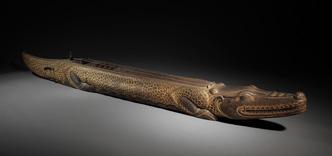
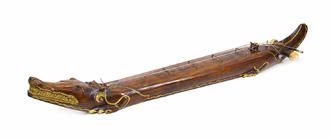

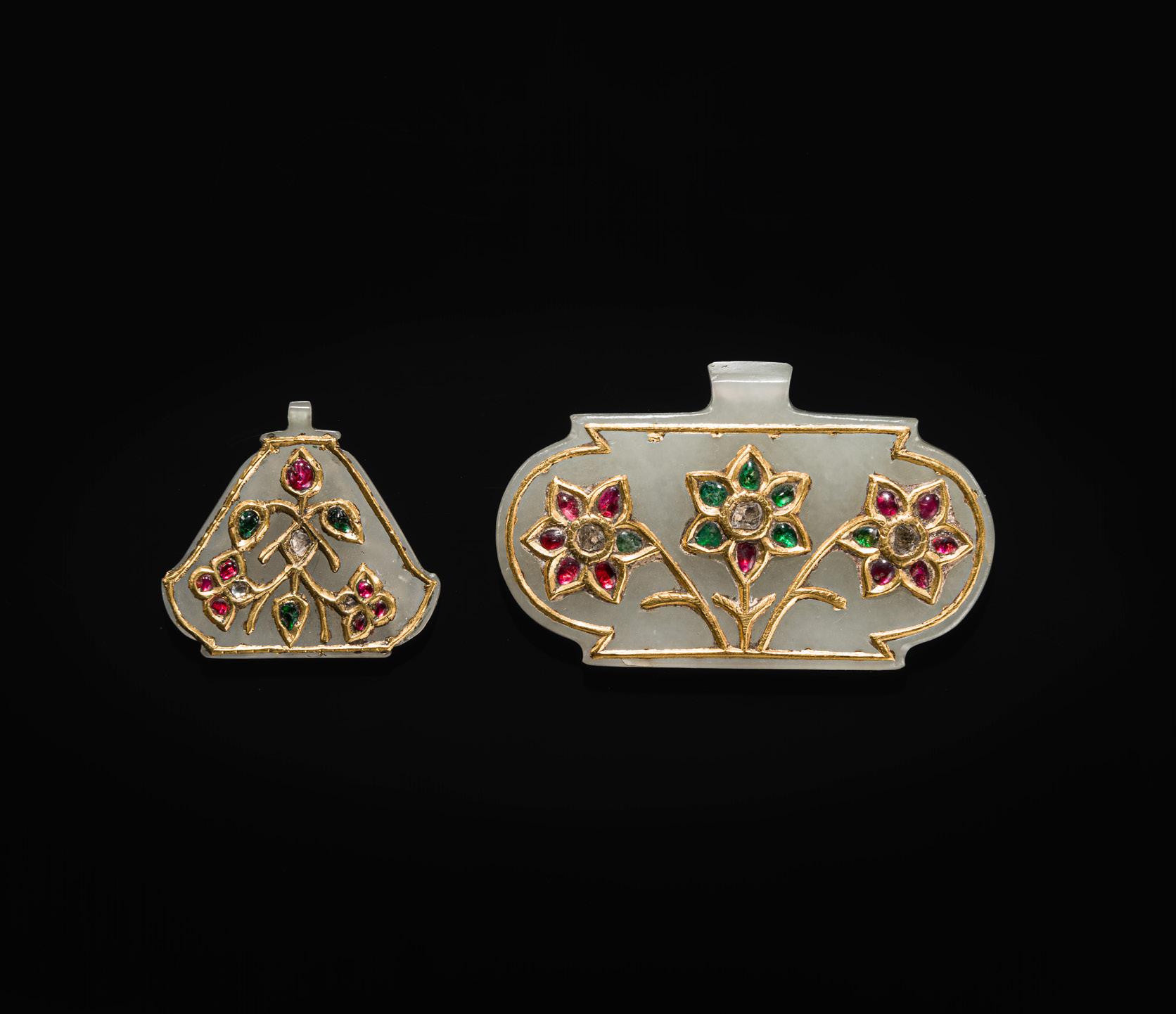
105
A GROUP OF TWO MUGHAL GEM- AND GOLD-SET JADE PENDANTS, HALDILI, 18TH-19TH CENTURY
Northern India. Two jade pendants. The larger of a horizontally elongated and lobed form, framed by a gold frame. The smaller of lotus petal shape, with the back textured. Each minutely inlaid with gold and set with diamonds, rubies, and emeralds, decorated with symmetrical floral motifs. Both with a pierced suspension piece at the top. The finely polished, highly translucent, and semi-transparent stones of an even white tone. (2)
Provenance: Galerie Hardt (established in 1976), Radevormwald, Germany, before 2020. Acquired by the gallery’s founder Peter Hardt (b. 1946) during his extensive travels, the first of which occurred during a formative world tour in 1973.
Condition: Very good condition with minor wear and manufacturing irregularities. With minuscule nibbling, few inlays with small losses and others may have been replaced over time.
Weight: 24 g (total)
Dimensions: Length 3 cm and 5.3 cm
A haldili is a pendant amulet worn to control involuntary palpitations of the heart. Haldilis are usually decorated with a linear, conventionalized, symmetrical branching tree-of-life pattern, the gemstones being a reference to fruit or flowers on the tree of life. The reverse side of the haldili can be plain which may mean it was intended for use by a Hindu, or, if for a Muslim, it was never inscribed.
The jade for these amulets was traditionally mined in Turkistan, prepared in Jaipur, and inlaid in Delhi or Jaipur by means of the Kundan process. For a full description of Haldili ornamentation, see Traditional Jewelry of India, by Oppi Untracht, pages 116-119.
LITERATURE COMPARISON
Compare a related bell-shaped jade plaque with gem inlays, dated to the 18th to 19th century, in the Collection of the Victoria & Albert Museum, accession number 684-1874.
AUCTION RESULT COMPARISON
Type: Closely related
Auction: Christie’s London, 1 October 2012, lot 165
Price: GBP 4,000 or approx. EUR 7,800 converted and adjusted for inflation at the time of writing
Description: A diamond and gemset jade pendant, India, 19th or 20th century
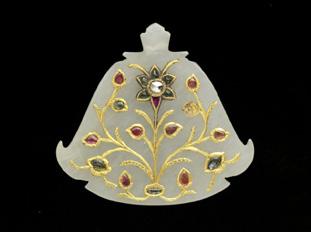
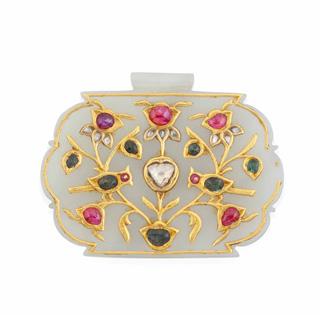
Expert remark: Compare the closely related form, materials, and technique. Note the size (6.5 cm).
Estimate EUR 1,000
Starting price EUR 500
Northwestern India, Rajasthan Pratabgarh. Both intricately worked with neatly incised and punched gold overlays applied to a transparent emerald-green glass ground. The first, an octagonal pendant, is mounted in silver with an openworked scroll border, pierced suspension loop and small holes to the reverse, and depicts crowned Shiva seated in dhyanasana flanked by two attendants, each below a canopy framed by slender pillars, above a recumbent Nandi. The second is a plaque of oval form and presents a dynamic hunting scene, with three armed figures pursuing a lion, surrounded by pheasants and floral vines. (2)
Provenance: Galerie Hardt (established in 1976), Radevormwald, Germany, before 2020. Acquired by the gallery’s founder Peter Hardt (b. 1946) during his extensive travels, the first of which occurred during a formative world tour in 1973.
Condition: Very good condition with minor wear and manufacturing irregularities including pitting to the plaque. Minuscule nibbles and light surface scratches.
Weight: 17 g (total)
Dimensions: Length 3.5-4.4 cm
The fascinating technique known as Thewa originates from the town of Pratapgarh in Rajasthan. The unique technique is a closely guarded practice and is claimed to have originated seven centuries ago, with the practice passed down from father to son. Although the appearance is similar to traditional enamel work, the process involves heat-fusing a thin gold foil sheet to the visible surface of an already existing sheet of glass. Light is reflected via a separate sheet of metal foil placed below the glass sheet. The craft flourished in Victorian times with British women purchasing them as souvenirs and returning to Britain with them. Articles of European style and function, such as the present lot, were popular luxury items for visiting Europeans in the 19th century. Themes often seen are based on Hindu Mythology or Mughal court scenes, historical events or they incorporate images of flora and fauna.
LITERATURE COMPARISON
Compare a related Thewa brooch decorated with a hunting scene, 4.1 cm wide, dated to the 19th century, in the Metropolitan Museum, object number 53.167.
Estimate EUR 1,000
Starting price EUR 500
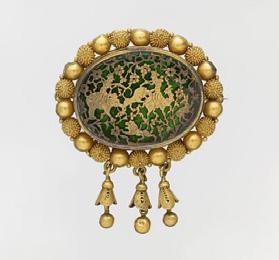
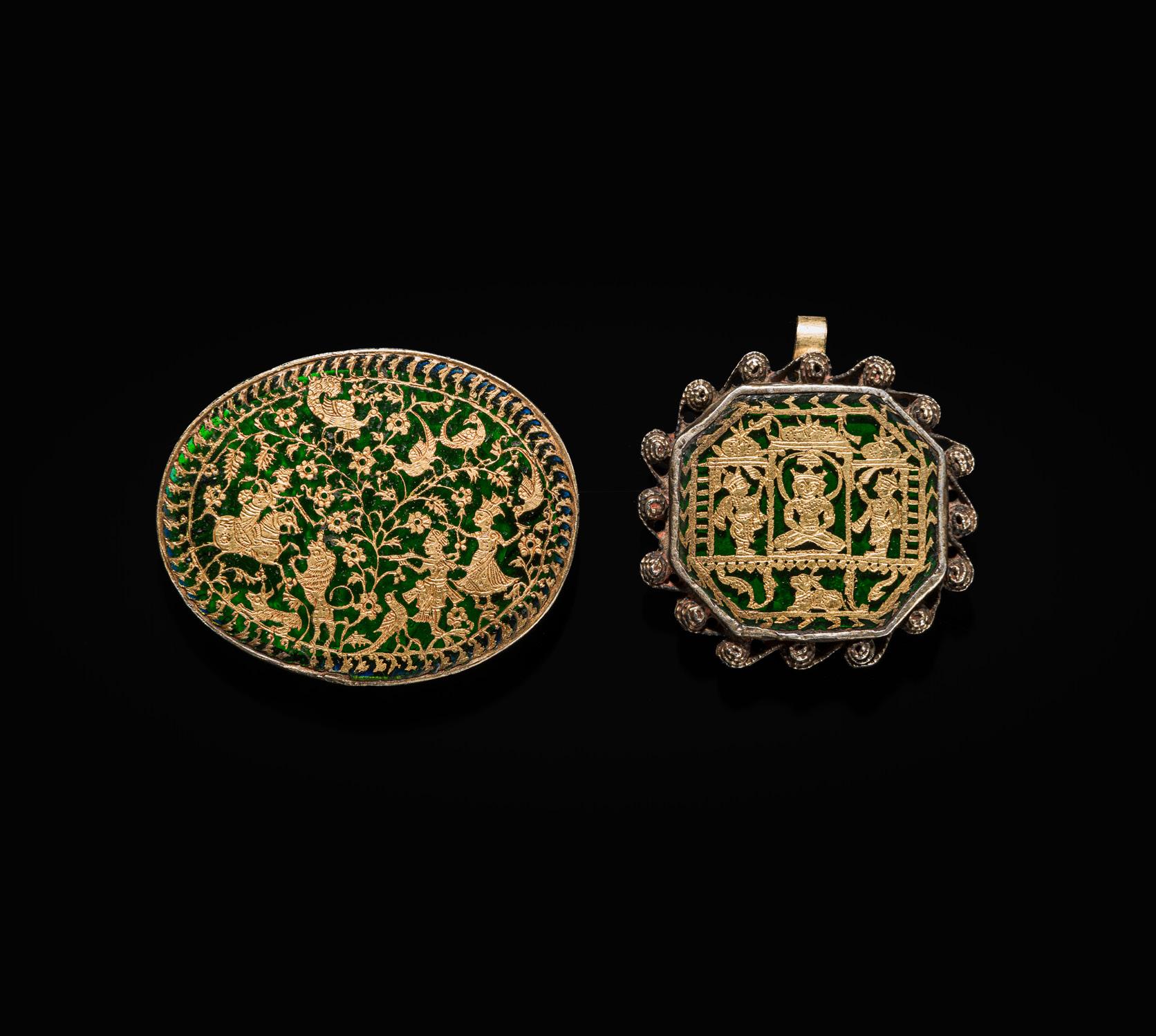

107
A COPPER CEREMONIAL SHIELD WITH SILVER REPOUSSÉ PLAQUE DEPICTING
Karnataka. Finely worked in relief, the deity is depicted standing in tribhanga on a flat base, holding a sword in one hand and a shield in the other, with additional attributes in his further raised arms. He is flanked by two attendants and framed by lobed decorative bands embellished with floral motifs. The figure of Virabhadra is richly adorned with ornate jewelry and wears a tall, conical headdress
Provenance: Galerie Hardt (established in 1976), Radevormwald, Germany, before 2020. Acquired by the gallery’s founder Peter Hardt (b. 1946) during his extensive travels in Asia, the first of which occurred during a formative world tour in 1973.
Labels: Galerie Hardt, inscribed ‘Virabhadra Silver back Copper Karnataka 19. Jh.’, priced at EUR 3,750
Condition: Very good condition with minor wear, traces of use, and manufacturing irregularities. Few minute dents and tiny nicks, expected rubbing and minor tarnish.
Weight: 667 g
Dimensions: Height 18 cm
Virabhadra, an incarnation of Shiva, created after Shiva’s wife Sati, was not invited to a great sacrifice given by her father Daksha. Being greatly humiliated, Sati went to the banquet and threw herself on the sacrificial fire. When Shiva heard of his wife’s death, he tore a hair from his head and threw it to the ground. Virabhadra, a great hero-warrior, arose from this hair. He cut off Daksha’s head in his rage and hurled it into the sacrificial fire. After the other gods calmed Shiva down, Daksha’s head was replaced by that of a ram and he later became a devotee of Shiva.
The cult of Virabhadra largely followed the spread of the Vijayanagar empire, which covered the Deccan plateau and much of the southern tip of India. This militarized version of Shiva became popular probably in the face of the threat that the Hindu states of the south felt from the incursions of the Islamic sultanates. In this way, Virabhadra the warrior was seen as a protector of Hinduism. The deity’s most popular period was the period of the 16th-19th centuries. The cult largely subsided by the early 20th century.
The handle on the back allows the temple priest to hold the plaque during ceremonies, making it turn clockwise and bringing it near the devotees so that it could touch them as if to absorb the god’s radiating power through physical contact. Many plaques are worn down by centuries of ritual manipulation, for the images of the gods are daily washed, sprinkled with special substances, dressed or covered in flowers.
LITERATURE COMPARISON
Compare a closely related silver plaque dated to the 19th century, 15.3 cm high, in the National Heritage Board, accession number 1996-01734.
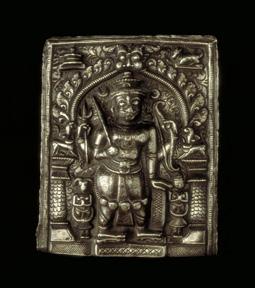
Estimate EUR 1,000
Starting price EUR 500

108
A SILVER REPOUSSÉ AMULET IN THE SHAPE OF A PIPAL LEAF DEPICTING THE DANCING SHIVA BHAIRAVA, AJMER, 19TH CENTURY
India, Rajasthan. Finely embossed and neatly incised to depict the four-armed deity in an animated pose above an emaciated dog and holding a sword, drum, lotus, and trident in his hands, surrounded by auspicious symbols and a severed head, his face with almond-shaped eyes framed by long curled hair secured by a skull tiara. All enclosed within beaded bands, applied with flowers to the four sides, and two loop-cords for suspension to the top.
Provenance: Galerie Hardt (established in 1976), Radevormwald, Germany, before 2020. Acquired by the gallery’s founder Peter Hardt (b. 1946) during his extensive travels in Asia, the first of which occurred during a formative world tour in 1973.
Condition: Very good condition with minor wear and manufacturing irregularities. Small nicks, few dings, and expected tarnish. Remnants of ritual pigment.
Weight: 130.8 g
Dimensions: Height 13.8 cm
Widely worshiped in the Bhil tribal community, Bhairava (or Bheru) is a wandering ascetic, whose form Shiva had to take to atone for a sin. The iconography of Bhairava is typically four-handed, and he is commonly portrayed with the street mutt that followed him around as he begged for alms.
Such amulets are usually strung from a cord and worn around the neck , and it is believed that being in contact with them is a form of constant worship. Other commonly represented figures on such amulets are Hanuman, Durga and local heroes or ‘vira’.
LITERATURE COMPARISON
Compare a closely related silver amulet in the shape of a pipal leaf with the four-armed Dancing Shiva, Ajmere, 1800s, 7 cm high, in the Cleveland Museum of Art, accession number 1916.396.
Estimate EUR 500
Starting price EUR 250
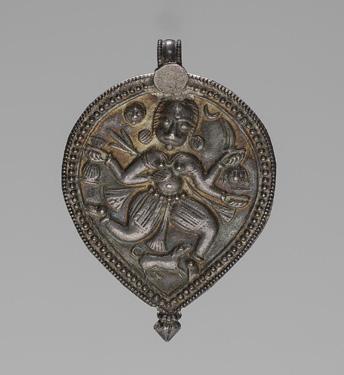
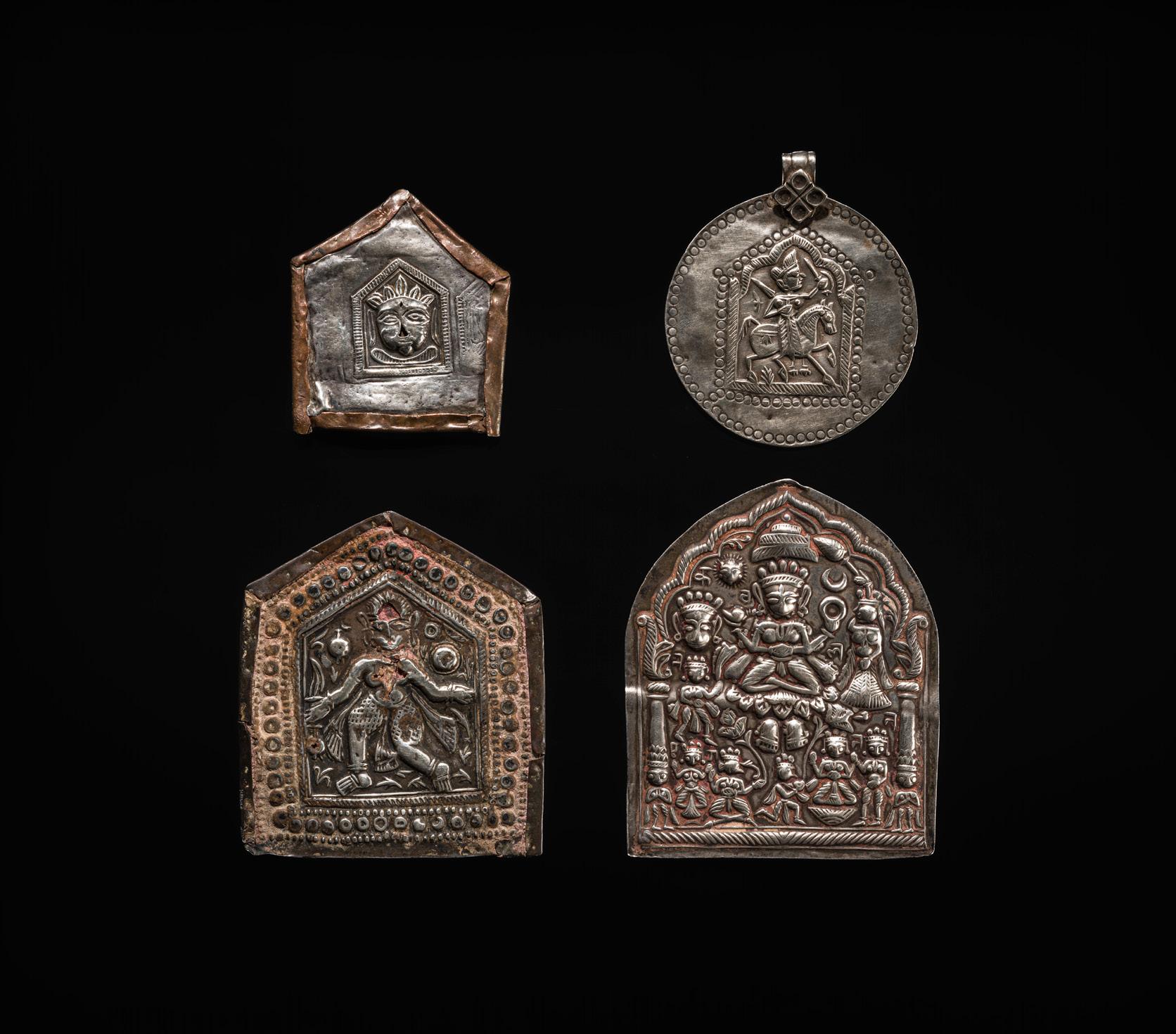
109
A GROUP OF THREE SILVER REPOUSSÉ VOTIVE PLAQUES AND A PILGRIMAGE AND DEVOTIONAL PENDANT, PHUL, MAHARASHTRA, 19TH CENTURY OR EARLIER
India, Deccan. Each finely chased and incised. The pilgrimage and devotional pendant (phul) is of circular form and portrays the folk hero Khandoba mounted on horseback and holding aloft his sword within a foliate arched niche enclosed by ring-punched borders.
The largest plaque is of arched form and depicts the central fourarmed Vishnu seated cross-legged surrounded by Lakshmi, Ganesha, a kneeling Garuda, and further deities, all under a rich foliate canopy supported on two columns rising from the heads of winged figures.
Two further plaques are of pentagonal form, the smaller with the crowned head of Shiva and the larger depicting Shiva Bhairava in a dancing pose with corpulent figure holding a knife surrounded by beaded borders, each mounted in a copper frame, the latter with a fitted acrylic stand. (4)
Provenance: Galerie Hardt (established in 1976), Radevormwald, Germany, before 2020. Acquired by the gallery’s founder Peter Hardt (b. 1946) during his extensive travels in Asia, the first of which occurred during a formative world tour in 1973.
Condition: Overall good condition with expected wear and manufacturing irregularities. Minor dents, light warping, few small losses, minute nicks. Each plaque showing a rich, naturally grown, smooth patina.
Weight: 80 g (total)
Dimensions: Height 5.6 (the smallest) and 8.7 cm (the largest)
LITERATURE COMPARISON
Compare two related phul depicting Khandoba and Shiva Bhairava respectively, each dated 19th-20th century, in the National Gallery of Victoria, accession numbers 2013.213 and 2013.242. Compare a closely related plaque with Vishnu worshiped by Ganesha and Garuda, dated to the 19th century, 8.9 cm high, formerly in the Stella Kramrisch Collection and now in the Philadelphia Museum of Art, accession number 1994-148-160.
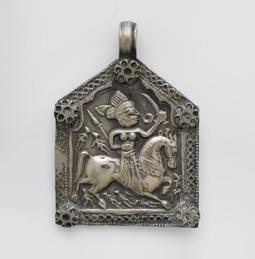
Estimate EUR 1,000 Starting price EUR 500
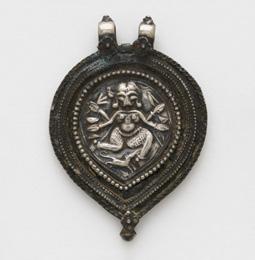
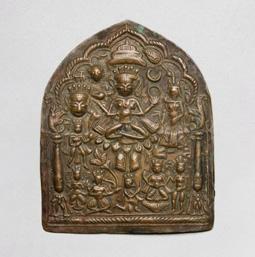
A FINE GROUP OF FIVE SILVER REPOUSSÉ AMULETS, HIMACHAL PRADESH AND RAJASTHAN
Northern India, early to mid-20th century. Comprising a flattened trapezoidal pendant embossed with flowerheads and grapevines, alongside four rectangular pendants containing depictions of Ganesha and Shakti framed by flowers and scrolling foliage; crowned dancers with flared skirts; and a dog in motion surrounded by smaller stylized four-legged creatures. The fourth has a small central window under the foliate niche containing a finely painted image representing Rani Sati as a trishula (trident) with almond-shaped eyes and full lips, below an inscription. All subjects framed by double-beaded bands and applied flowerheads, fitted with several rings for suspension as a pendant, some with hanging metal tassel beads. (5)
Provenance: Galerie Hardt (established in 1976), Radevormwald, Germany, before 2020. Acquired by the gallery’s founder Peter Hardt (b. 1946) during his extensive travels in Asia, the first of which occurred during a formative world tour in 1973.
Condition: Good condition with age wear, manufacturing irregularities, and traces of use, including small nicks, surface scratches, few dents, and expected tarnishing.
Weight: 180 g (total)
Dimensions: Length 7.6 cm (the largest)
LITERATURE COMPARISON
Compare a closely related diestamped silver amulet with bells, Himachal Pradesh, dated mid-20th century, illustrated by René van der Star. Ethnic Jewellery from Africa, Asia and Pacific Islands, Rotterdam, 2002, p. 135.
Estimate EUR 1,000
Starting price EUR 500

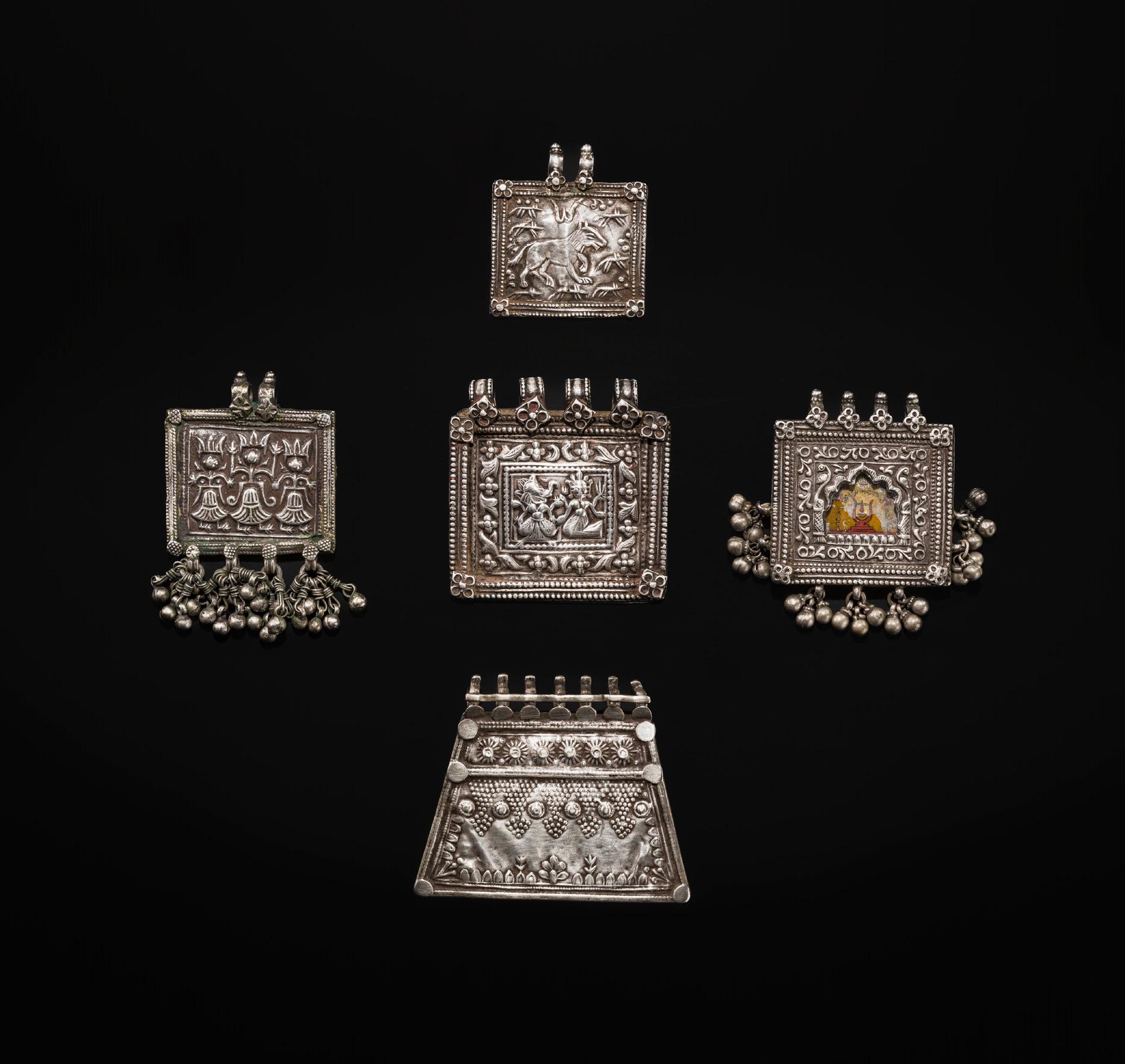
The Kienzles’ fascination with the Himalayan world and their pursuit of fine works of art is recorded in correspondences between Horst Kienzle and several individuals in Nepal and Ladakh.

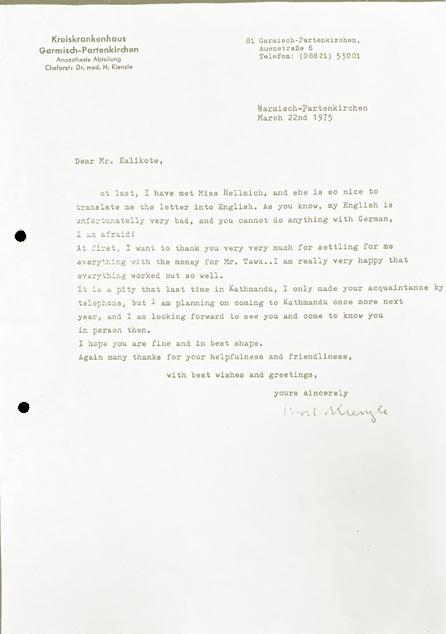

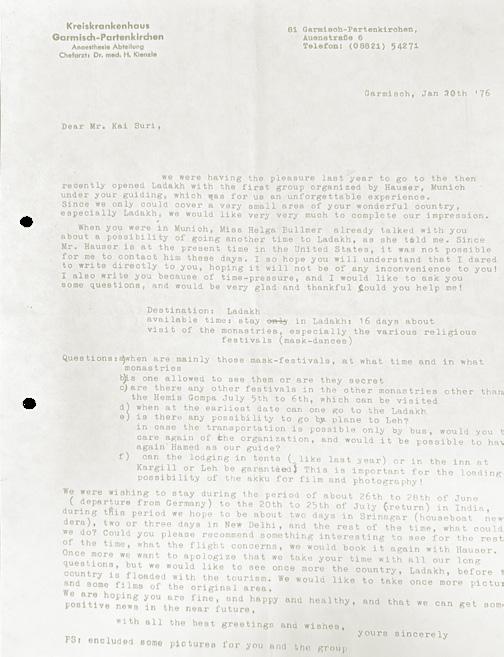
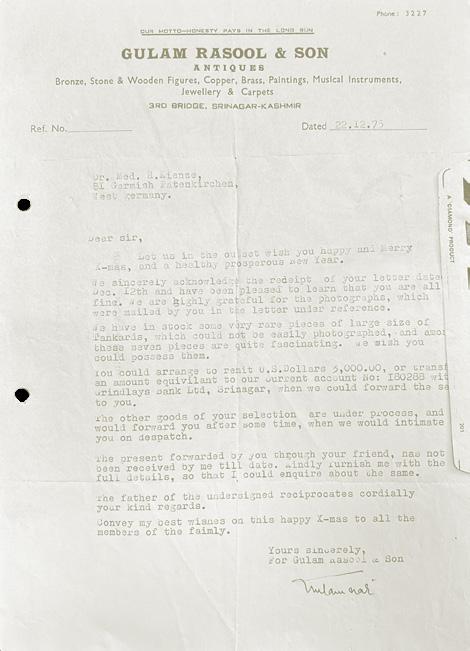

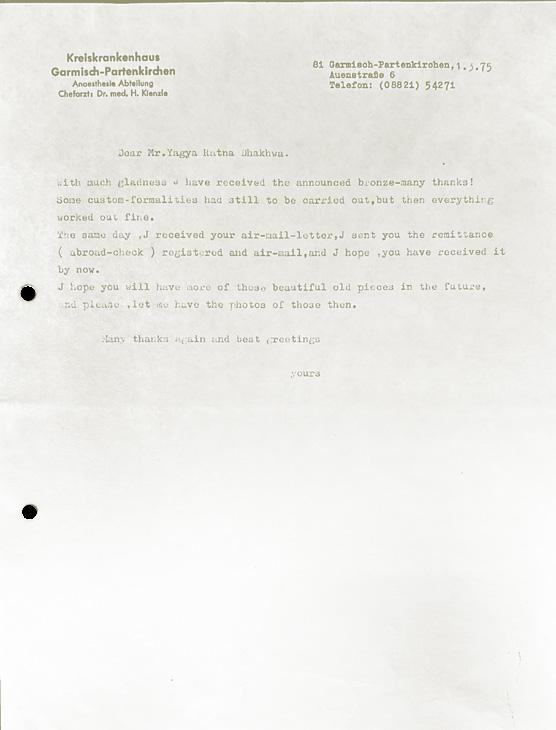
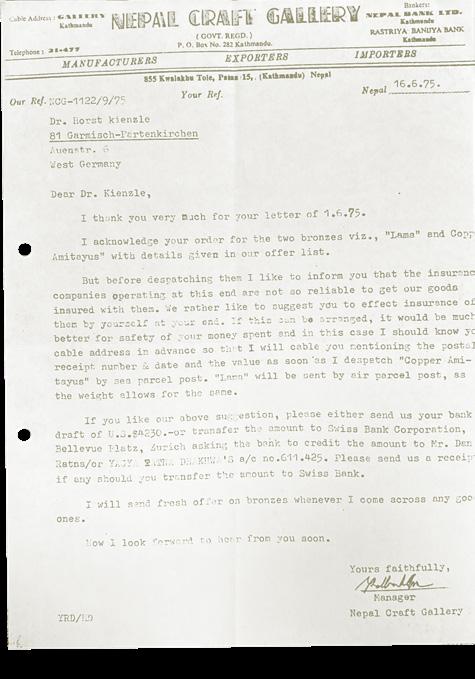
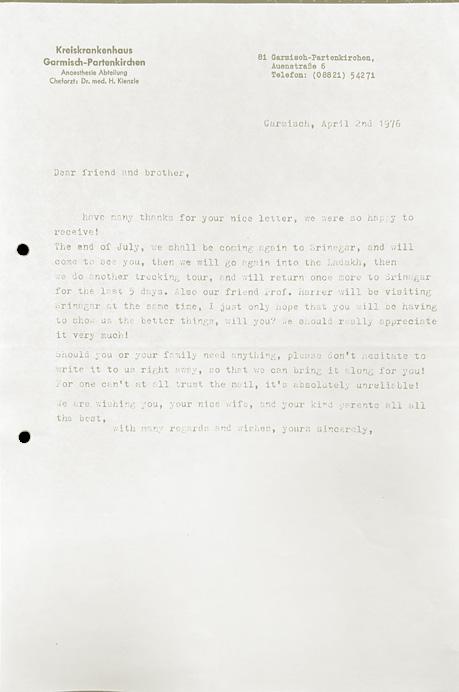
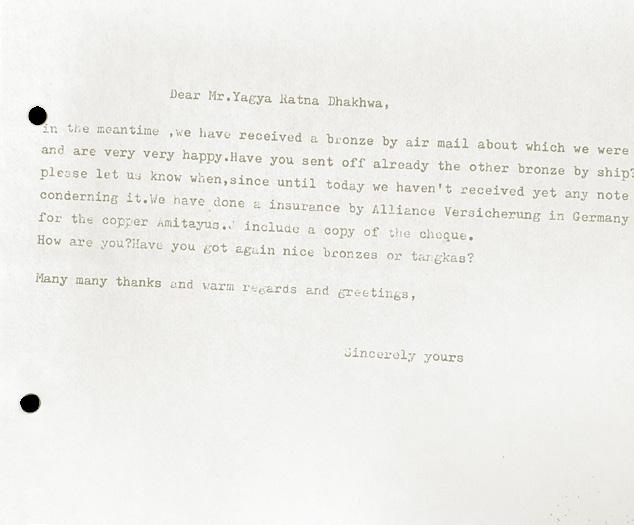
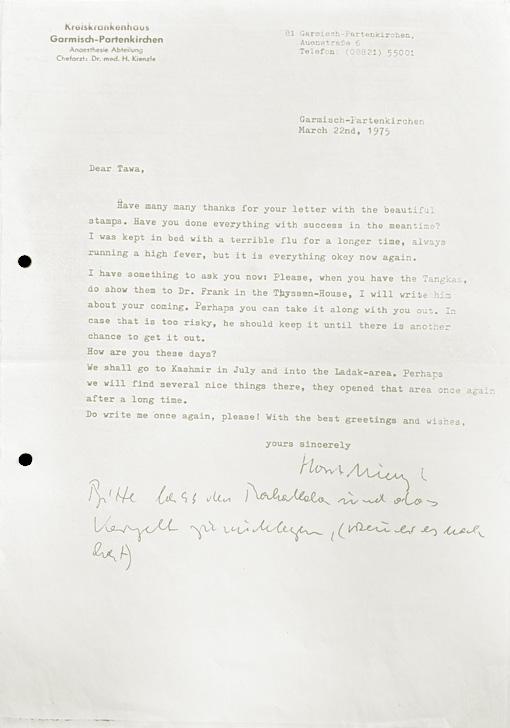

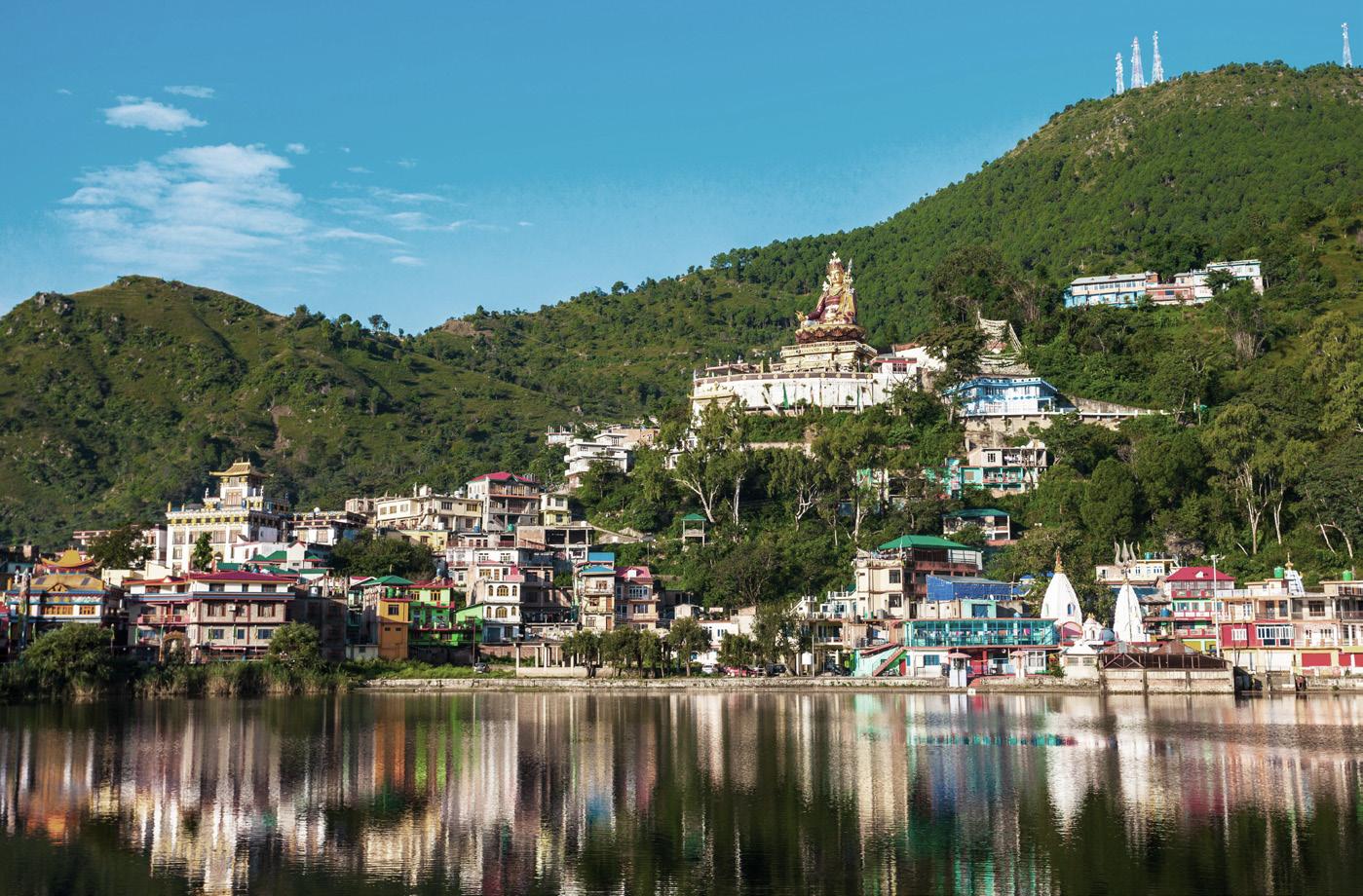
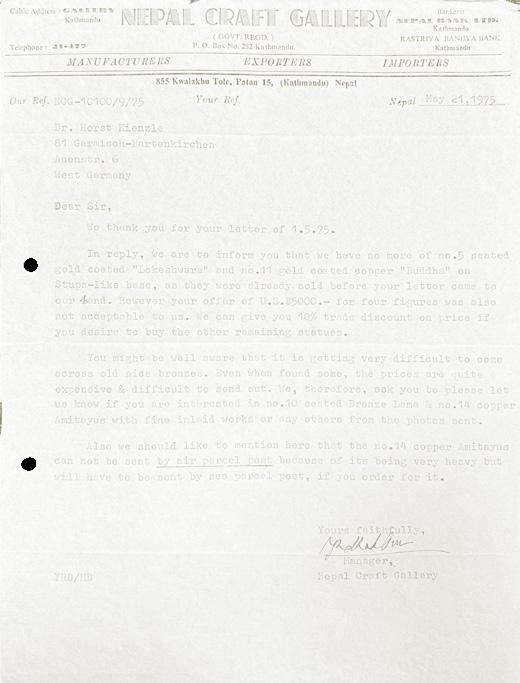
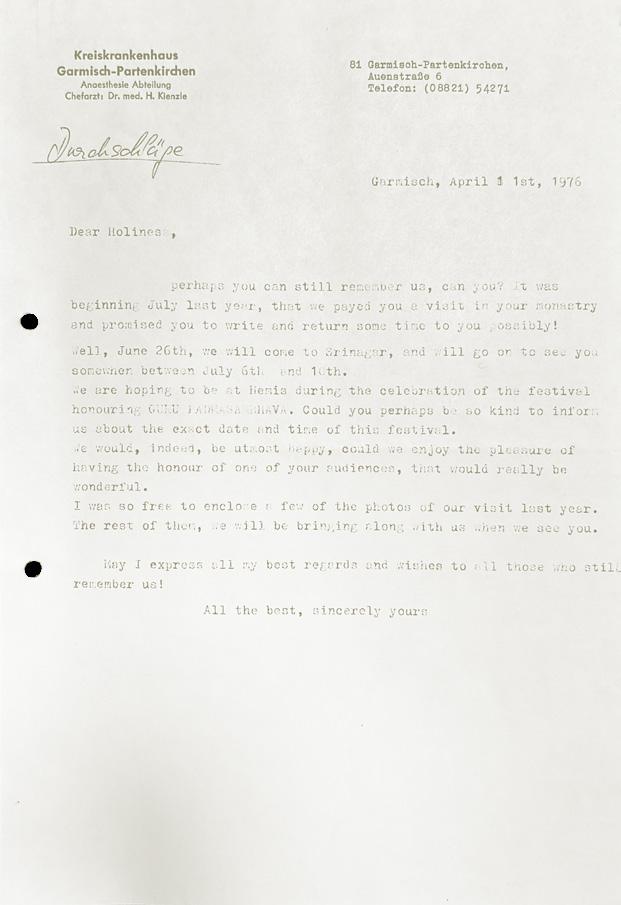


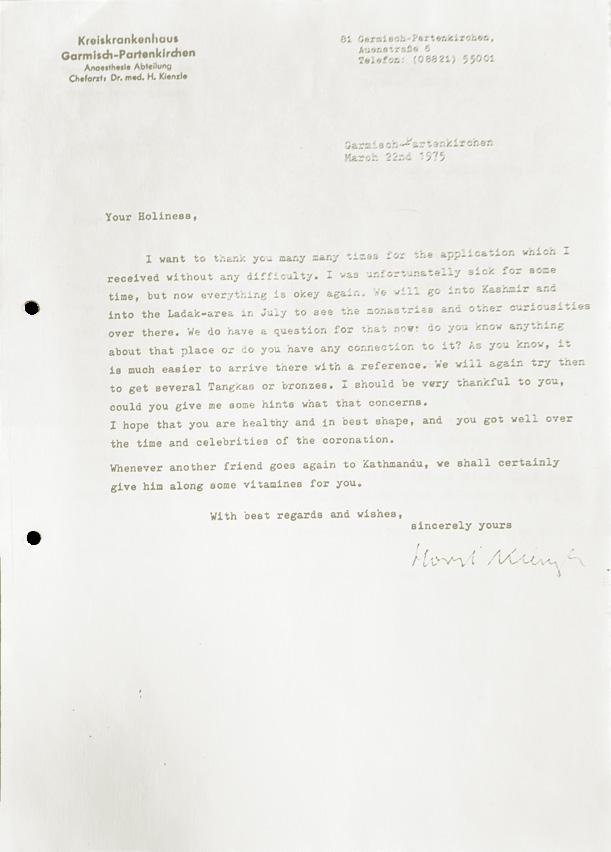
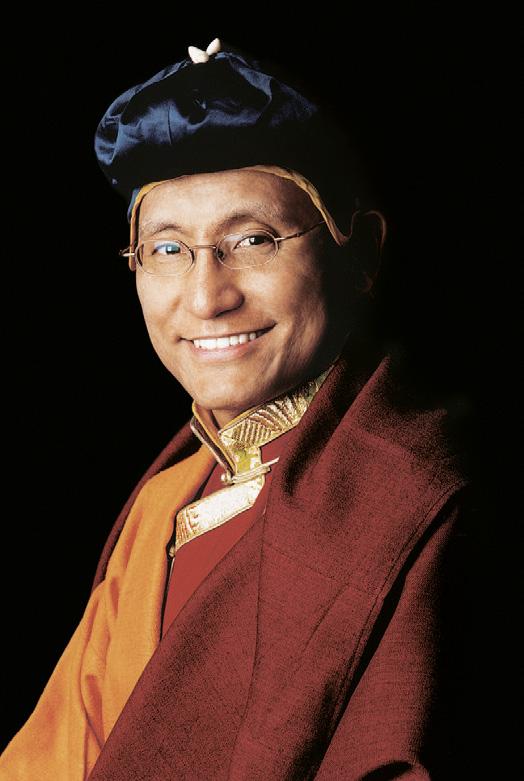
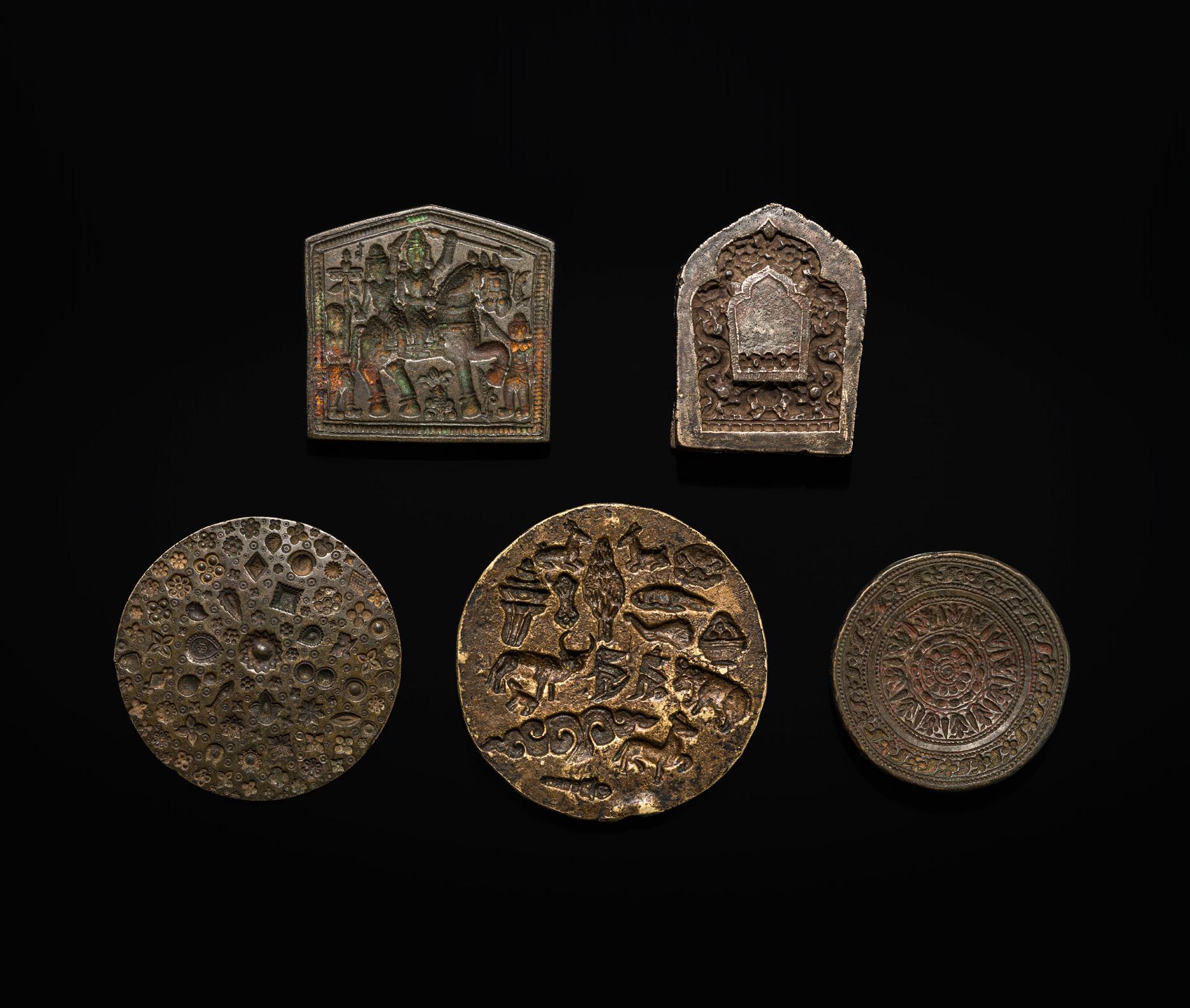
A GROUP OF RARE BRONZE AND BRASS MOLDS WITH LOTUS AND ANIMALS
Tibet, Himalayas, and India, 19th-20th century or earlier. Comprising a Tibetan tsa-tsa mold in the shape of a gau (shrine) with central window of similar form surrounded by scrolling foliage above a lotus-petaled base; a Himalayan circular mold with concentric bands of beads, lines, lotus petals, and leafy floral sprays, the reverse incised with inscriptions in Devanagari script; and another with animals including deer and ox as well as a beast mask and Buddhist emblems; an Indian mold for a phul (pilgrimage and devotional plaque) of pentagonal form depicting Shiva and Parvati on horseback, flanked by attendant figures; and an Indian or Central Asian circular plaque with a dense arrangement of various geometric, floral, and foliate motifs. (5)
Provenance: Galerie Hardt (established in 1976), Radevormwald, Germany, before 2020. Acquired by the gallery’s founder Peter Hardt (b. 1946) during his extensive travels in Asia, the first of which occurred during a formative world tour in 1973.
Condition: Good condition with expected old wear, cast irregularities, and traces of use, including small nicks, surface scratches, some dents, and nibbles to edges. One of the molds bearing remnants of pigments and russet signs of corrosion. Each with a fine, naturally grown patina.
Weight: 1,710 g (total)
Dimensions: Length 10.3 cm (the largest)
Literature comparison: Compare a related bronze tsa-tsa mold of Avalokiteshvara, attributed to the Himalayan region, formerly in the Rubin Museum of Art, illustrated on Himalayan Art Resources, item number 65740. Compare a related aluminum phul with Shiva and Parvati on horseback, India, 19th-20th century, in the National Gallery of Victoria, Melbourne, accession number 2013.226.
Estimate EUR 1,000
Starting price EUR 500
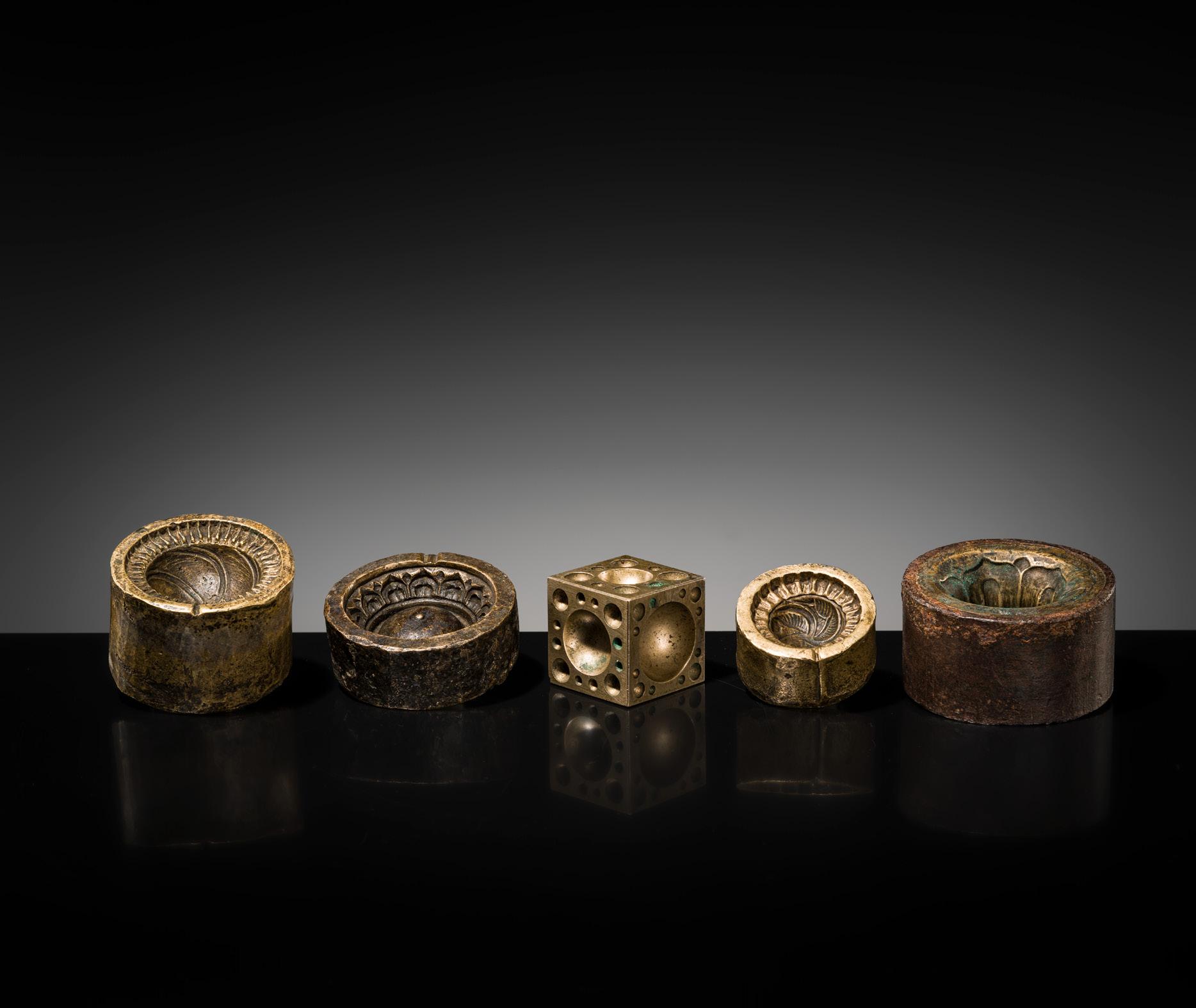
112
A GROUP OF FIVE BUDDHIST BRONZE MOLDS WITH GANKYIL AND LOTUS
Tibet and Himalayan regions, 19th-20th century or earlier. Comprising four cylindrical molds, each finely cast in the negative with Gankyil and stylized lotus flowers, one set within an iron casing, and a fifth of cubic shape with recessed spherical bosses. (5)
Provenance: Galerie Hardt (established in 1976), Radevormwald, Germany, before 2020. Acquired by the gallery’s founder Peter Hardt (b. 1946) during his extensive travels in Asia, the first of which occurred during a formative world tour in 1973.
Condition: Good condition with expected wear, casting irregularities, and traces of use, minute nicks, light surface scratches, small dents, and minor nibbling to edges. Each with a fine, naturally grown patina.
Weight: 3,478 g (total)
Dimensions: Length 7.5 cm (the largest)
Bronze molds such as the present examples were used in the production of both votive tsa-tsas and ornamental metal appliqués for ritual or architectural embellishment. The cavities feature traditional motifs including the lotus, emblematic of spiritual purity, and the gankyil,
the dynamic swirl symbolizing the inseparability of wisdom, method, and bliss in Tibetan Buddhist cosmology. Such molds were employed by monastic artisans and lay craftsmen alike, forming an integral part of devotional and decorative practice, whether pressing sacred clay for consecration or casting embellishments for gilded statues, thrones, or ritual vessels.
AUCTION RESULT COMPARISON
Type: Related
Auction: Christie’s New York, 19 September 2019, lot 38 Price: USD 3,500 or approx. EUR 4,000 converted and adjusted for inflation at the time of writing
Description: A bronze tsa-tsa mold, Tibet, 17th century
Expert remark: Compare the related material and design, albeit for a tsupa tsa-tsa and with a handle.
Estimate EUR 1,000
Starting price EUR 500


113
A LARGE BRONZE TEMPLE
LAMP DEPICTING SURYA ATOP HIS CHARIOT, NEPAL, 18TH CENTURY
Finely cast in openwork, the columnar body rising from a globular element supported on a dome atop the tiered flaring base with beaded edge to a lotus-petaled canopy suspending sixteen bronze foliate tassels, all richly decorated with floral and foliate designs, below the oil tray surmounted by an image of Surya and two attendants atop his nine-horse chariot drawn by a smaller figure in front flanked by two archers.
The Sun God holding a lotus stem in each hand coming to full bloom at the shoulders, wearing a long flaring dhoti, richly adorned with fine jewelry and foliate tiara, and backed by an intricately cast floral mandorla inlaid with rock crystal.
Provenance: The Kienzle Family Collection, Stuttgart, Germany. Acquired between 1950 and 1985 by siblings Else (1912-2006), Reinhold (1917-2008), and Dr. Horst Kienzle (1924-2019), during their extensive travels in Asia. Subsequently inherited by Dr. Horst Kienzle and bequeathed to the Museum für Asiatische Kunst, Radevormwald, Germany. Released through museum deaccession in 2024.
Condition: Overall good condition with expected wear, traces of use, and manufacturing irregularities, minor warping, few small nicks and light surface scratches, minor losses to inlays and one tassel, one section of the column with losses and an old repair. The bronze with a fine, naturally grown, dark patina with areas of verdigris.
Weight: 14.9 kg (total)
Dimensions: Height 117.9 cm
The Hindu sun god Surya is often depicted as a resplendent deity holding lotus flowers in both hands, riding a chariot pulled by nine horses as seen in the present lot. The earliest representations of Surya riding a chariot occur in the Buddhist railings of the Mahabodhi temple in Bodhgaya during the 2nd century BC, but he only began to be worshiped within Hindu temples in the 8th century AD. In Nepal, many Surya temples and artworks trace to the medieval era, such as the 11th-century Thapahiti and Saugal-tol, and 12th century Naksal stone sculptures. One of the notable places where Surya is depicted is the Changu Narayan Temple, a UNESCO World Heritage site near Bhaktapur. This temple features
numerous
and
and Malla periods, with the sun god often shown riding his chariot.
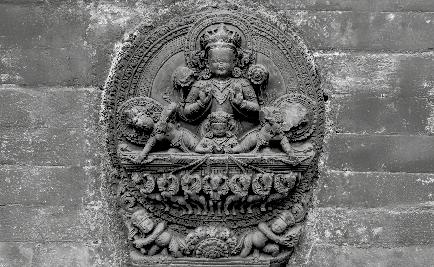
LITERATURE COMPARISON
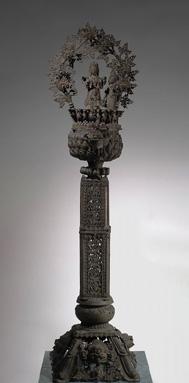

Compare a related Nepalese bronze temple lamp depicting Surya atop his chariot, 199 cm high, dated to the 18th century, in the American Museum of Natural History, New York, accession number 70.2/ 3752 (fig. 1), illustrated on Himalayan Art Resources, item number 95142. Compare a related Nepalese bronze altar lamp depicting a different deity, 86.4 cm high, in the Penn Museum, University of Pennsylvania, object number 29-130-32. Compare a related, slightly earlier figure of Surya in his chariot, 15.5 cm high, 17th century, in the Ashmolean Museum, Oxford, accession number EA1991.176 (fig. 2). fig. 1 fig. 2
Estimate EUR 4,000
Starting price EUR 2,000
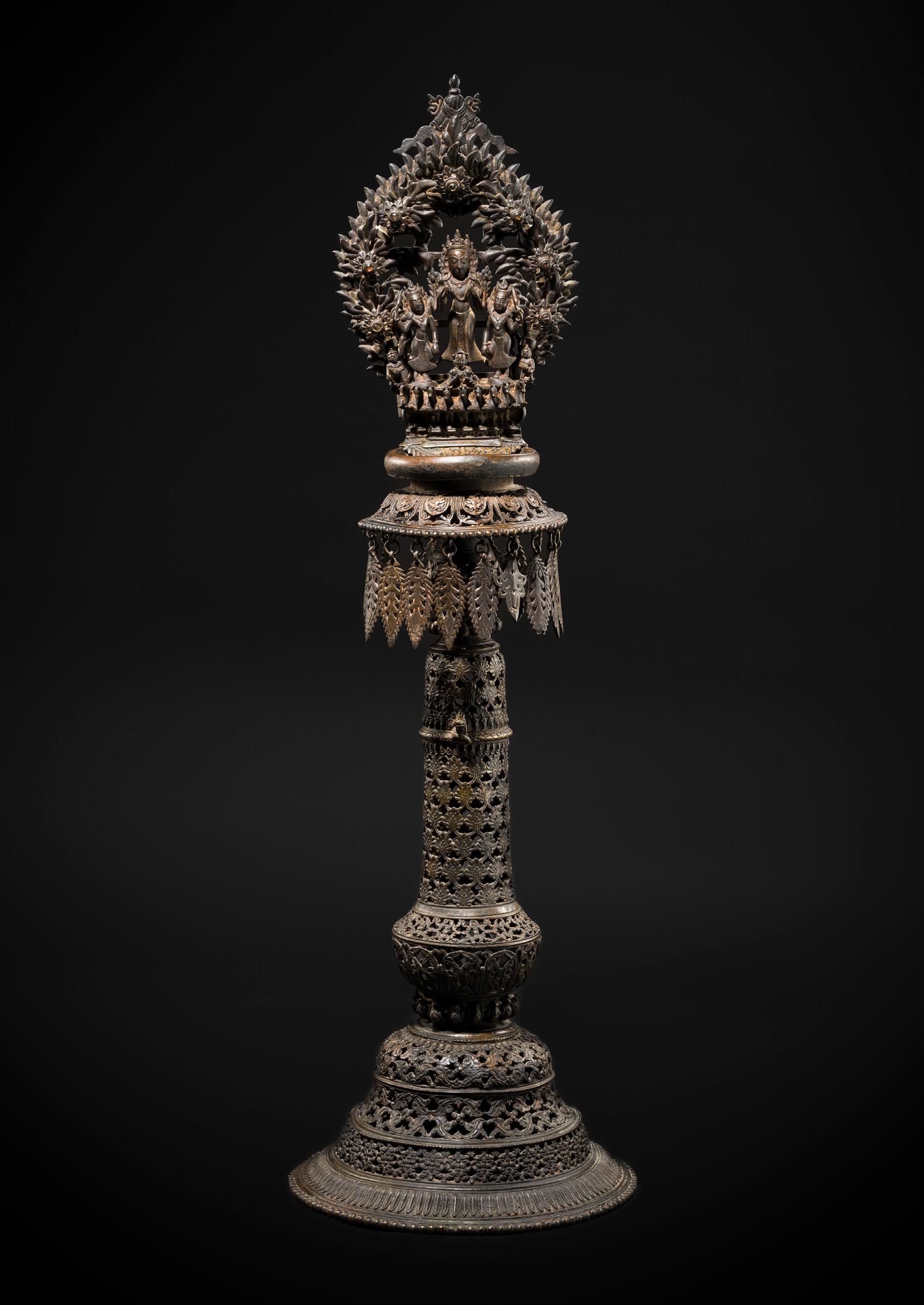
Nepal. Heavily cast, the baluster body of the oil reservoir resting on a splayed foot and decorated with beaded, foliate, and petal bands. The vessel rises into a tall neck with an everted lip, set with a curved handle in the form of a minutely detailed seven-headed naga, sheltering the goddess of serpents Manasa, who holds a conch shell in her hands. The front embellished with a leaf-shaped dalupa (dish), supported by the figure of a female attendant and surmounted by the image of a richly adorned, four-armed Ganesha standing on a rectangular pedestal backed by a foliate mandorla and flanked by two birds.
Provenance: Galerie Hardt (established in 1976), Radevormwald, Germany, before 2020. Acquired by the gallery’s founder Peter Hardt (b. 1946) during his extensive travels in Asia, the first of which occurred during a formative world tour in 1973.
Condition: Very good condition with expected wear, casting irregularities, and traces of use, small nicks and light dents, remnants of gilding. The bronze with a fine, naturally grown patina with areas of verdigris.
Weight: 12.6 kg
Dimensions: Height 51.5 cm
Buddhist and Hindu Newars in the Kathmandu Valley inaugurate life events with the Sagan ritual, in which a household’s female elder lights the Sukunda lamp and makes food offerings. The lamps were used to store oil, which was poured with a ladle into a shallow dish in front of the vase, where a wick was burned using the oil as fuel.
Large examples like the present lot are rare and were also employed in nuptial rites, featuring prominently in ceremonial processions between the residences of the bride and groom.
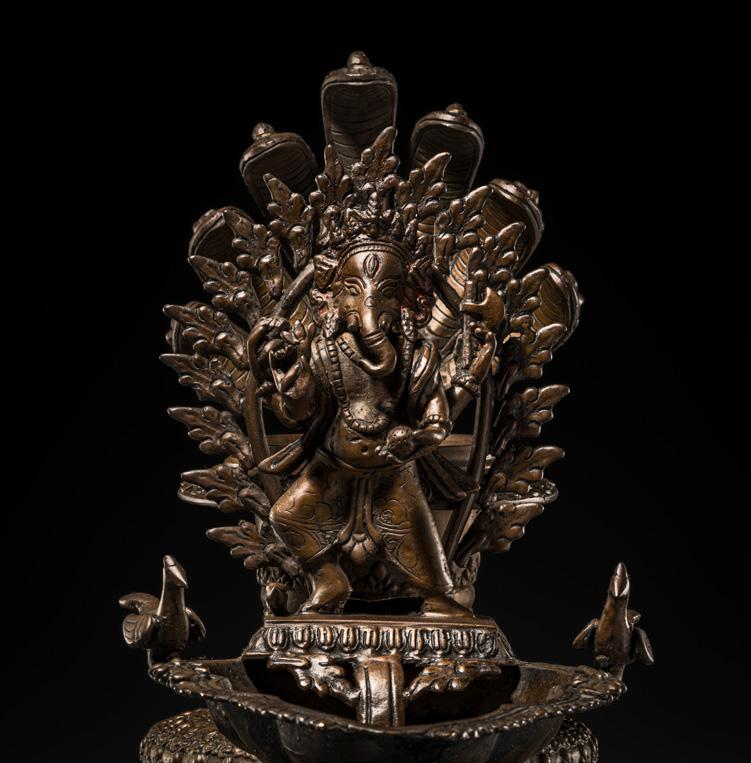
Type: Closely related
Auction: Christie’s Paris, 8 June 2010, lot 393
Price: EUR 2,375 or approx. EUR 3,300 adjusted for inflation at the time of writing
Description: A copper ritual lamp, Sukunda, Nepal, 19th century
Expert remark: Compare the closely related form, decoration, and manner of casting. Note the different size (37 cm).
Estimate EUR 2,000
Starting price EUR 1,000
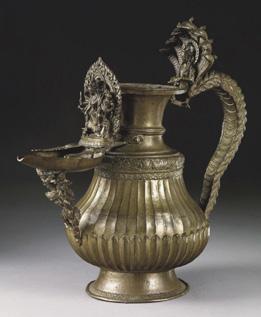
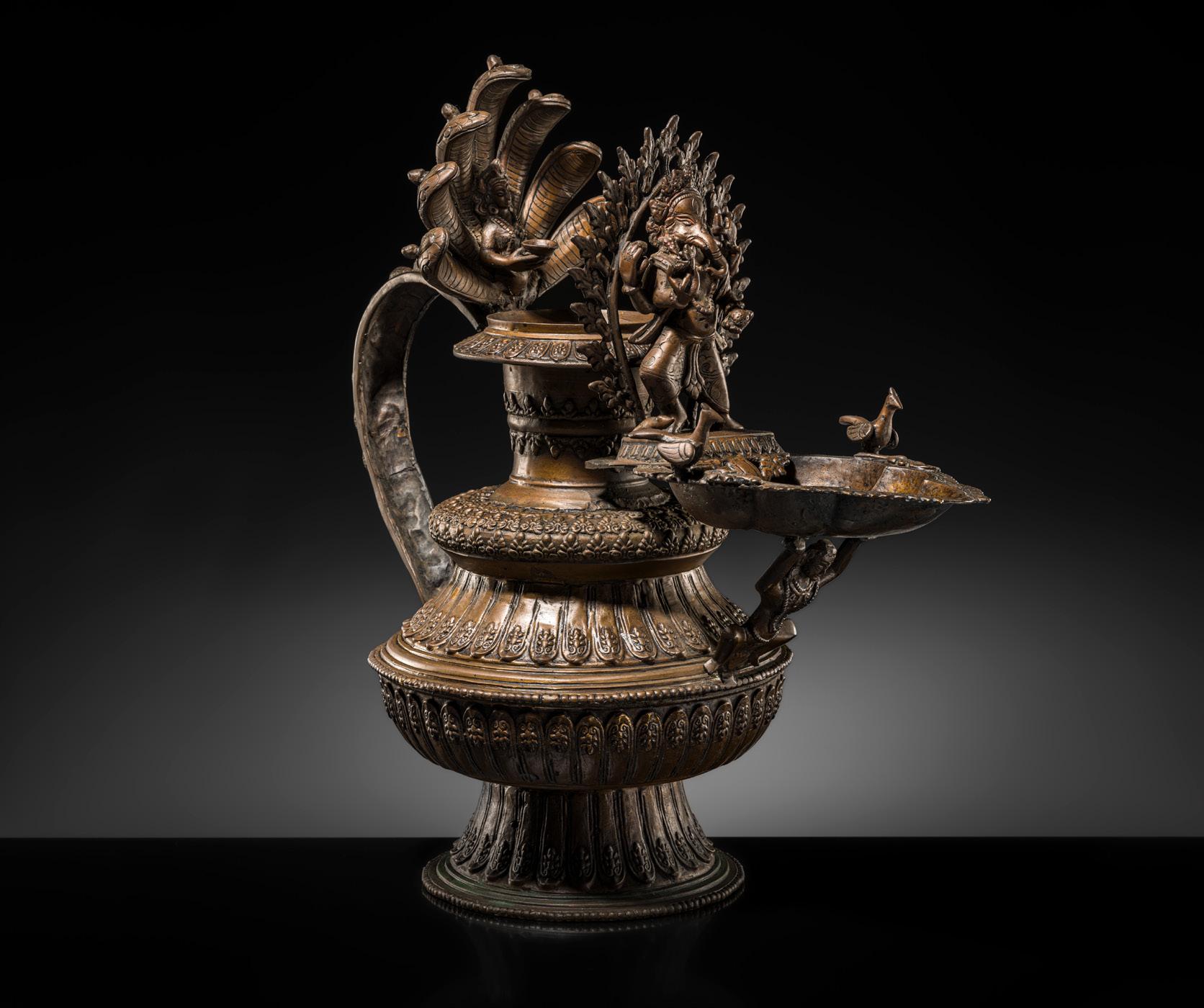

115
India, 19th-first half of the 20th century. Carved from a single block of stone. The circular yoni platform with a gently raised rim and an extended curved spout. The base flares outward in a bell shape. Rising from the center is a smooth, oval lingam, skillfully shaped from naturally banded stone. The entire piece exhibits grey tones.
Provenance: Galerie Hardt (established in 1976), Radevormwald, Germany, before 2020. Acquired by the gallery’s founder Peter Hardt (b. 1946) during his extensive travels in Asia, the first of which occurred during a formative world tour in 1973.
Condition: Very good condition with minor wear and natural imperfections. A few nicks, tiny dents, soiling, light scratches, and remnants of pigments. A fine, naturally grown, smooth patina.
Weight: 8.8 kg
Dimensions: Length 30 cm
The lingam and yoni (or snanadroni) are aniconic representations of Shiva and Parvati. They are symbolic of the female and male reproductive organs, which within Hinduism bring a balance to the cosmos when joined together. Within Hindu countries, adoration of the lingam was understood to be worship of the great generative principle of the universe, conceptualized as an aspect of Shiva.
LITERATURE COMPARISON
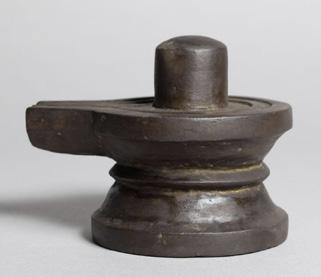

Compare a related steatite lingam and yoni from a single stone, Bengal, dated 19th century, in the Victoria & Albert Museum, accession number IM.465-1924. Compare a related stone lingam and yoni dated 17th-19th century in the Weltmuseum, Vienna, inventory number 166810_a.
Estimate EUR 1,000 Starting price EUR 500
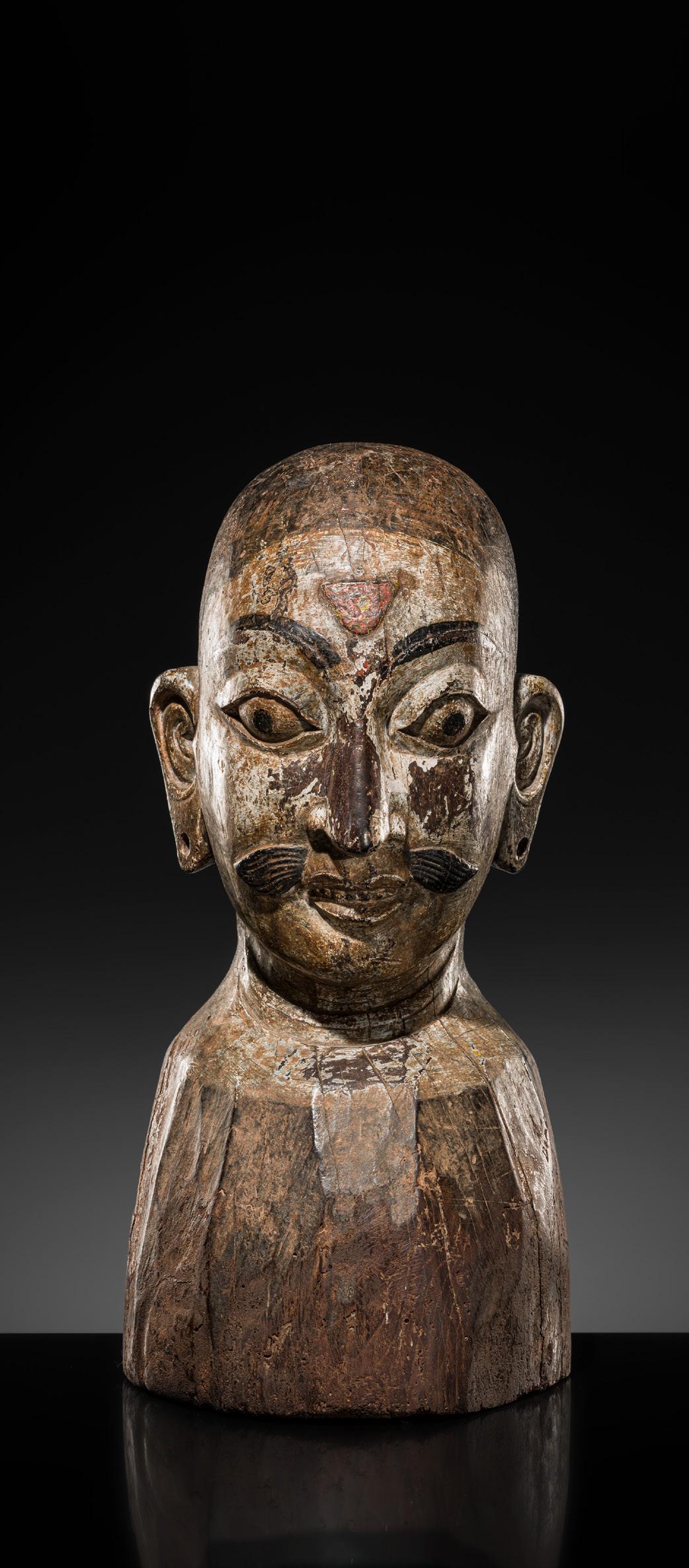
116
A RARE CARVED WOOD BUST OF SHIVA, LATE MALLA, THREE KINGDOMS PERIOD
Nepal, 1520-1768. Boldly carved and finely painted to depict a fierce manifestation of the deity bearing his bare head with bulging eyes and large pupils beneath prominent, arched brows, the forehead centered by a triangular third eye, an aquiline nose, and thick lips accented by a lush mustache, flanked by elongated, pierced earlobes.
Provenance: Galerie Hardt (established in 1976), Radevormwald, Germany, before 2020. Acquired by the gallery’s founder Peter Hardt (b. 1946) during his extensive travels in Asia, the first of which occurred during a formative world tour in 1973.
Condition: Good condition with surface wear, natural imperfections, and signs of weathering and erosion, expected age cracks, flaking to lacquer, minor touchups and few small repairs with remnants of adhesive, overall presenting very well.
Weight: 7.4 kg
Dimensions: Height 45 cm
AUCTION RESULT COMPARISON
Type: Closely related Auction: Sotheby’s Paris, 20 April 2022, lot 179
Price: EUR 3,000 or approx. EUR 3,300 adjusted for inflation at the time of writing
Description: A rare carved wood bust of Shiva, Nepal, Mala (sic!) period, 16th-17th century
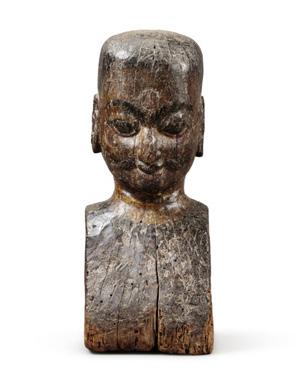
Expert remark: Compare the closely related form and manner of carving, the face with similar features and expression. Note the related size (40 cm).
Estimate EUR 2,000
Starting price EUR 1,000
The structure consists of a circular base with tiered steps leading to a tall dome finely worked with a hatched design encircled by a band of raised lotus petals. The square harmika above is neatly incised on each side with a stylized eye motif. The ribbed spire supports a lotus-decorated parasol with beaded leafform pendants, crowned by a square finial.
Provenance: The Kienzle Family Collection, Stuttgart, Germany. Acquired between 1950 and 1985 by siblings Else (1912-2006), Reinhold (1917-2008), and Dr. Horst Kienzle (1924-2019), during their extensive travels in Asia. Subsequently inherited by Dr. Horst Kienzle and bequeathed to the Museum für Asiatische Kunst, Radevormwald, Germany. Released through museum deaccession in 2024.
Condition: Good condition with minor wear and manufacturing irregularities, including copper casting patches. Few minor fatigue cracks and small tears to base, light dents, minor warping, minute nicks, small scratches. The bronze with a rich, naturally-grown, dark patina with areas of malachite encrustation.
Weight: 7.9 kg
Dimensions: Height 50.7 cm
Expert’s note: The square harmika above the stupa’s dome is engraved on all four sides with a pair of eyes surmounted by a tiered umbrella, replicating features of the Svayambhu (Self-Born) Stupa in Kathmandu, Nepal. As noted by Dina Bangdel, “The Great Stupa, an impressive architectural monument inhabiting a prominent hilltop in the Kathmandu Valley, is the premier religious center of the Newar Buddhist community. It is therefore not surprising that Svayambhu Mahachaitya serves as the stylistic and symbolic prototype of all chaityas, which are regarded at once as replicas and manifestations of the sacred monument.” (see John C. Huntington and Dina Bangdel, The Circle of Bliss: Buddhist Meditational Art, Los Angeles County Museum of Art and Columbus Museum of Art, 5 October 2003 to 9 May 2004, p. 111.)
LITERATURE COMPARISON
Compare a related earlier model of a stupa with incised eyes similar to the Svayambhunath Stupa dated to the 16th century, 16 cm high, in the Metropolitan Museum of Art, object number 1985.400.16.
AUCTION RESULT COMPARISON
Type: Closely related
Auction: Zacke, Vienna, 17 December 2024, lot 19
Price: EUR 4,680
Description: A gilt copper alloy reliquary stupa, Nepal, 17th-18th century
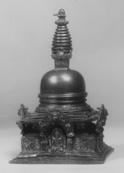
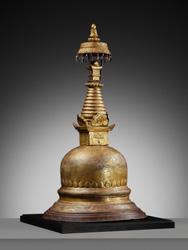
Expert remark: Compare the closely related form, decoration, manner of casting, and gilding. Note the size (66 cm).
Estimate EUR 4,000
Starting price EUR 2,000
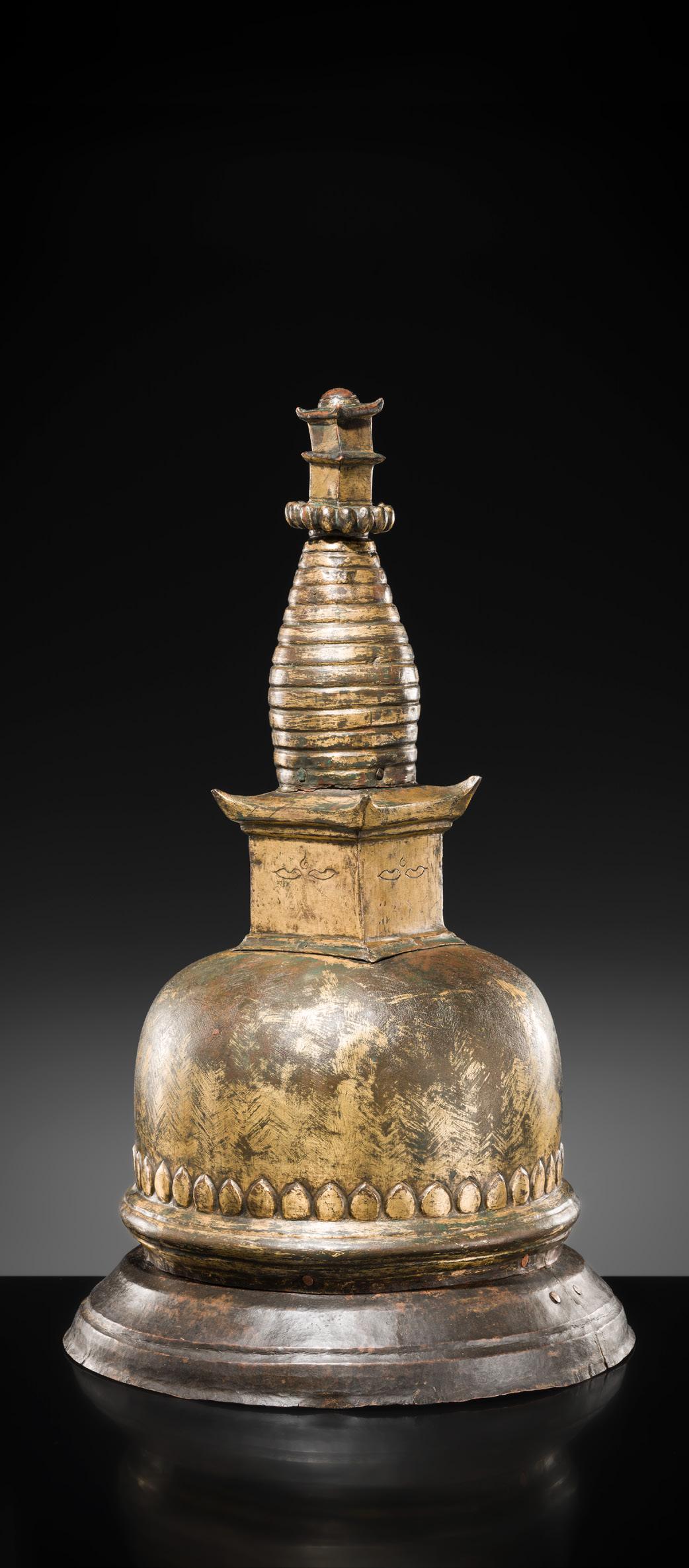
118
Seated in dhyanasana, one hand in vitarka mudra, the other arm raised and holding a sword, dressed in a short dhoti, and adorned with foliate jewelry. His square face with sinuous eyelids, surmounted by a five-leaf crown, the hair tied in a tall chignon, and with a flaming jewel on top.
Provenance: The Kienzle Family Collection, Stuttgart, Germany. Acquired between 1950 and 1985 by siblings Else (1912-2006), Reinhold (1917-2008), and Dr. Horst Kienzle (1924-2019), during their extensive travels in Asia. Subsequently inherited by Dr. Horst Kienzle and bequeathed to the Museum für Asiatische Kunst, Radevormwald, Germany. Released through museum deaccession in 2024.
Condition: Very good condition with minor wear, casting irregularities, fatigue cracks, small dents and nicks. Remnants of ritual pigments.
Weight: 20.1 kg
Dimensions: Height 68 cm
Manjushri, the Bodhisattva of wisdom, is one of the most revered bodhisattvas in Mahayana Buddhism. Representing the embodiment of transcendent wisdom, he plays a central role in Buddhist teachings and iconography as the divine manifestation of enlightened intellect. In Buddhist tradition, Manjushri is portrayed as a youthful, serene figure— often seated in meditative posture or in dynamic pose atop a lion, symbolizing the fearless and powerful nature of wisdom. He typically holds a flaming sword in his right hand, which cuts through ignorance and delusion.
LITERATURE COMPARISON

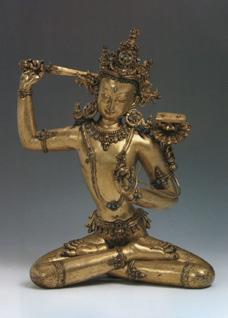
The present lot takes inspiration from highly celebrated works of the 14th century produced by Newar artists of Nepal’s Kathmandu Valley. See, for example, a gilt-copper figure of Manjushri at Sotheby’s Hong Kong, 2 October 2017, lot 3122, and a gilt-copper figure of Arapachana Manjushri from the Bertie Aschmann Foundation at the Museum Rietberg, inventory number BA 64, illustrated on Himalayan Art Resources, item number 1699.
Estimate EUR 6,000
Starting price EUR 3,000

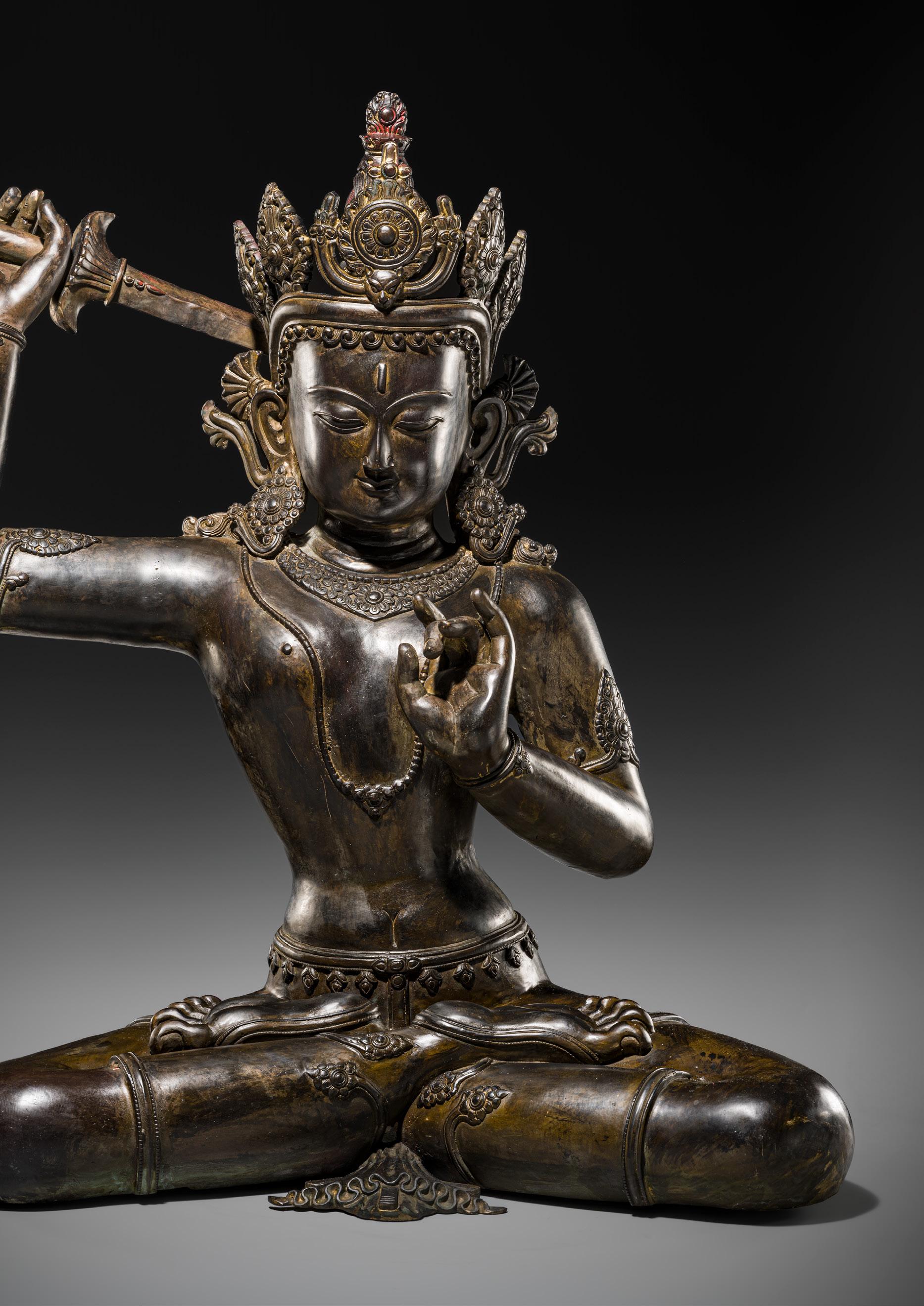
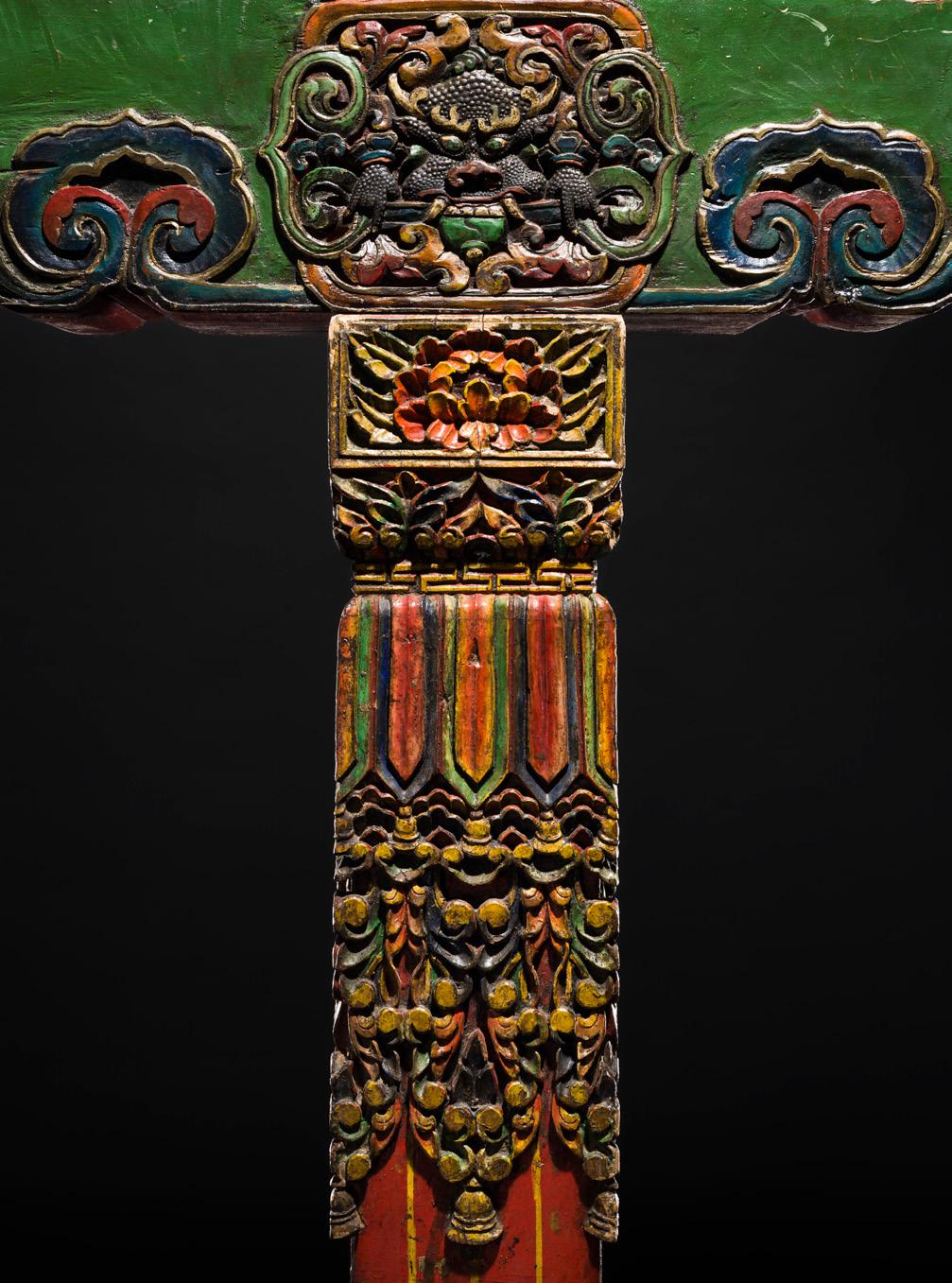
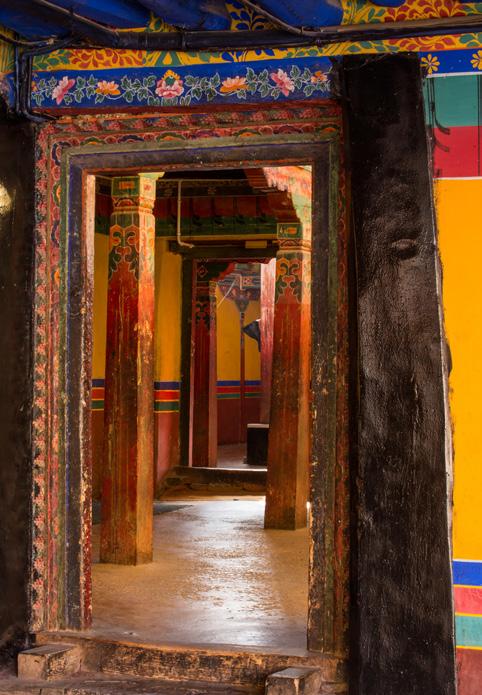
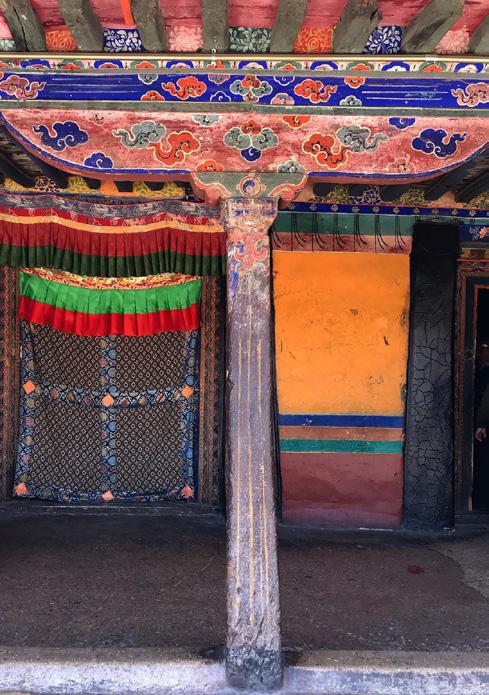
Of typical form, the tapering column supporting the cap block and chock blocks, each segment painted in vibrant pigments of red, green, yellow, and blue, and carved in relief with a kirtimukha mask to the center below a shaped panel enclosing a deer amid foliate scroll, each flanked by ruyi heads, all above the shaft similarly decorated with peony blossoms and lappet bands issuing festooned garlands with bells.
Provenance: Galerie Hardt (established in 1976), Radevormwald, Germany, before 2020. Acquired by the gallery’s founder Peter Hardt (b. 1946) during his extensive travels in Asia, the first of which occurred during a formative world tour in 1973. Condition: Very good condition with old wear and natural imperfections including age cracks, fissures, and insect activity. Obvious losses, stains, chips, expected flaking, rubbing to pigment, and signs of weathering and erosion. Old repairs with associated touchups and layers of varnish.
Dimensions: Height 255 cm
In traditional Tibetan buildings including monasteries, temples, and homes, wood columns like the present lot are a key structural element. These pillars are often elaborately decorated and painted with traditional motifs and religious patterns, reflecting the deep integration of Buddhist symbolism into daily life and architecture. Within religious structures, the placement and decoration of pillars often correspond to the layout of a mandala, reinforcing the spiritual symbolism of the building as a microcosm of the Buddhist universe.
LITERATURE COMPARISON
See a Tibetan structure (most likely a monastery) with similar columns, illustrated by Juan Wang et al, “Study on Aseismic Characteristics of Tibetan Ancient Timber Structure”, in Advances in Materials Science and Engineering, 2017, fig. 1.
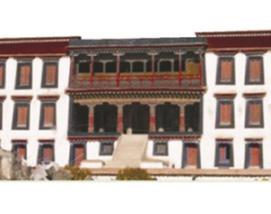
Estimate
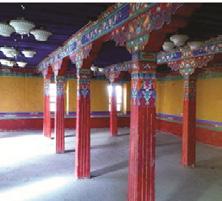
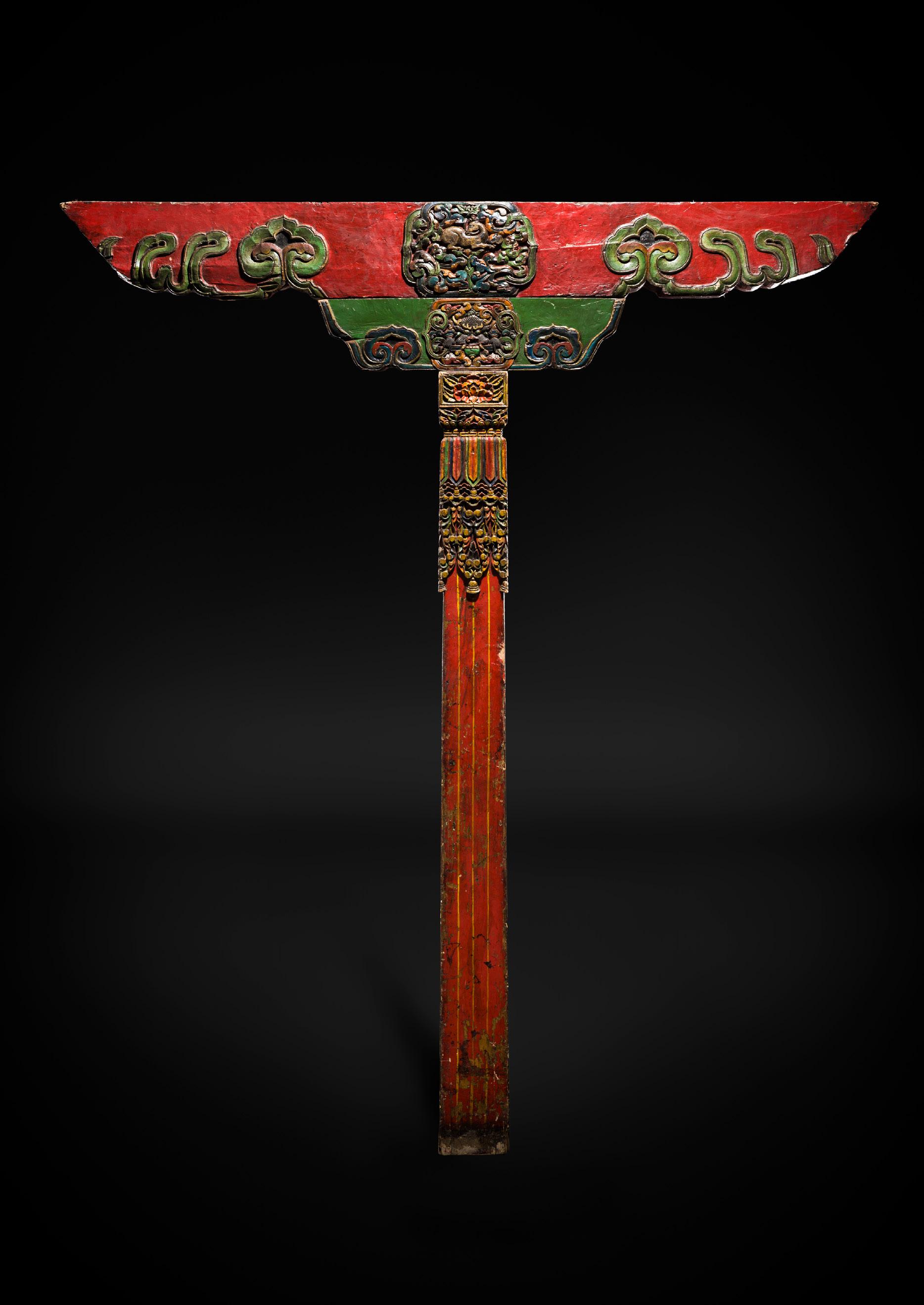
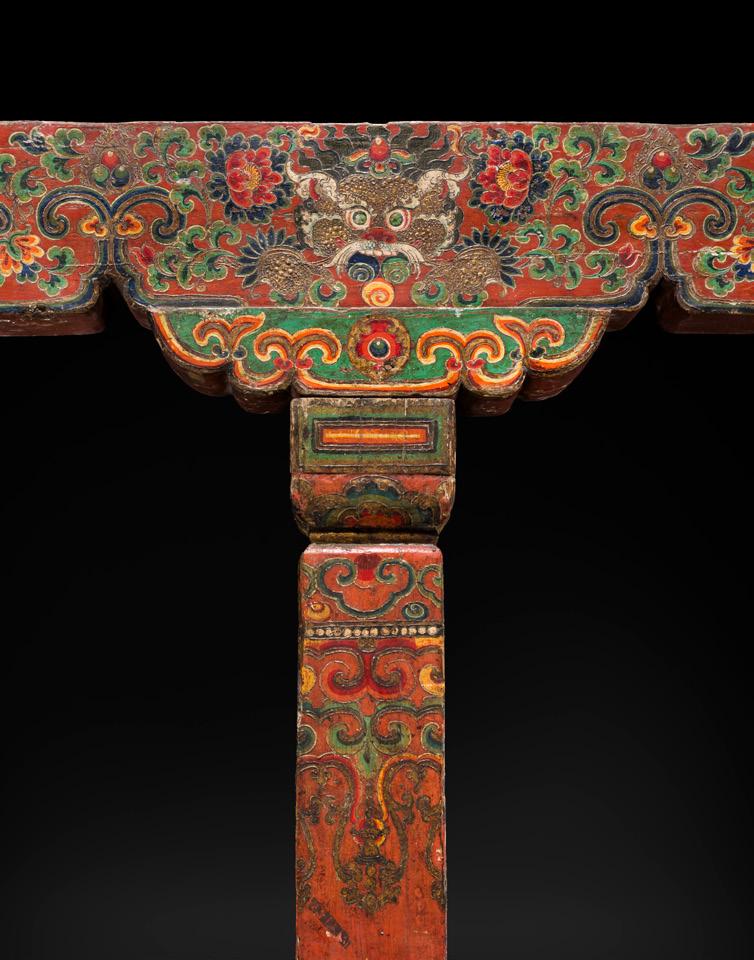
120
Each of typical form, the tapering column supporting the integral cap and chock blocks, each segment painted in vibrant pigments of red, green, yellow, and blue to depict a kirtimukha mask surrounded by blossoms, scrolling foliage, triratna, and ruyi clouds, all above the shaft similarly decorated with geometric designs and bands of ruyi-heads and scrolling vines. (2)
Provenance: Galerie Hardt (established in 1976), Radevormwald, Germany, before 2020. Acquired by the gallery’s founder Peter Hardt (b. 1946) during his extensive travels in Asia, the first of which occurred during a formative world tour in 1973.
Condition: Good condition with old wear and natural imperfections including age cracks, fissures, splinters, and minor signs of insect activity. Obvious losses, stains, chips, expected flaking, rubbing to pigment, and signs of weathering. Old repairs with associated touchups and layers of varnish. Sections of one pillar reinforced with planks of plywood.
Dimensions: Height 259 cm and 233 cm, Length 160 cm
In traditional Tibetan buildings including monasteries, temples, and homes, wood columns like the present lot are a key structural element. These pillars are often elaborately decorated and painted with traditional motifs and religious patterns, reflecting the deep integration of Buddhist symbolism into daily life and architecture. Within religious structures, the placement and decoration of pillars often correspond to the layout of a mandala, reinforcing the spiritual symbolism of the building as a microcosm of the Buddhist universe.


Literature comparison: See a Tibetan structure (most likely a monastery) with similar columns, illustrated by Juan Wang et al, “Study on Aseismic Characteristics of Tibetan Ancient Timber Structure”, in Advances in Materials Science and Engineering, 2017, fig. 1.
Estimate EUR 8,000
Starting price EUR 4,000

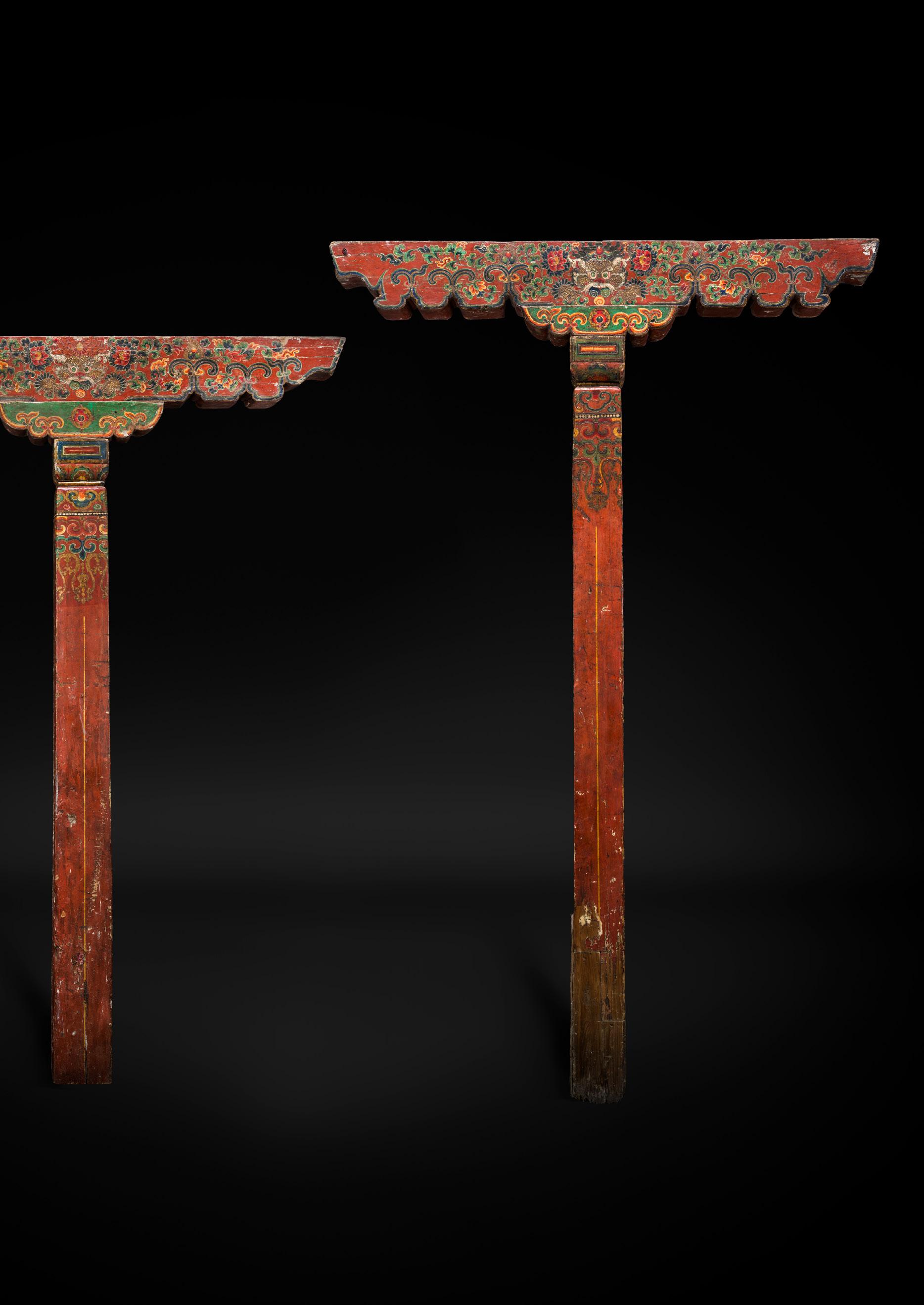


China, Qing dynasty. The intricately constructed model of a traditional Daoist temple with a three-bay main hall, surmounted by a downswept ridged roof with projecting overhang embellished on top with a ridge carved with blossoms and flanked by dragon heads, all supported on four columns, the front with three doors pierced with wan symbols, framed above with intricately carved panels depicting qilin and two horses, all above a balustrade framing the front and sides.
Provenance: The Kienzle Family Collection, Stuttgart, Germany. Acquired between 1950 and 1985 by siblings Else (1912-2006), Reinhold (1917-2008), and Dr. Horst Kienzle (1924-2019), during their extensive travels in Asia. Subsequently inherited by Dr. Horst Kienzle and bequeathed to the Museum für Asiatische Kunst, Radevormwald, Germany. Released through museum deaccession in 2024.
Condition: Overall good condition with expected wear, losses, natural age cracks, few small splits, old repairs, touchups to lacquer, rubbing to gilt, small nicks, few tiny chips.
Weight: 57 kg
Dimensions: Size 130 x 108.7 x 65.7 cm
The family shrine (kan) was an important piece of furniture in a traditional Chinese household. Usually displayed on an altar table against the rear wall of the main reception hall, the shrine itself was often made in the form of a traditional three bay hall complete with hinged doors, tile roof, and decorative brackets. Placed inside the shrine were the spirit tablets of the ancestors. It was believed that the souls of the ancestors resided in the tablets bearing their name and that they had the power to influence the fortune of their living descendants. Ancestral spirits were appraised of all important family events like betrothals, marriages, and the births of sons.
LITERATURE COMPARISON
Compare a related house shrine, dated to the 18th-19th century, size 97.8 x 95.1 x 52.4 cm, in the Minneapolis Institute of Art, accession number 99.130a-h.

AUCTION RESULT
COMPARISON
Type: Related
Auction: Sotheby’s New York, 17 September 2016, lot 1006
Price: USD 18,750 or approx. EUR 21,500 converted and adjusted for inflation at the time of writing
Description: A large cedar wood ancestral shrine, Qing dynasty, 19th century
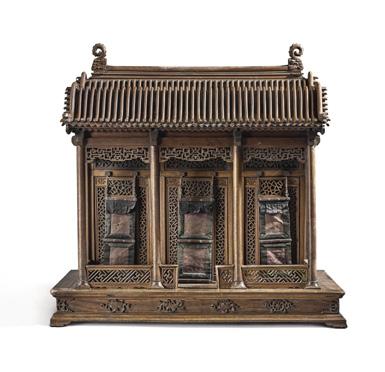
Expert remark: Compare the related form and manner of carving with similar structure and openwork.
Estimate EUR 6,000
Starting price EUR 3,000


China. The case finely carved as a stylized pipa, the body and cover hinged together near the smaller end with a bronze pin cast with a floral knob, the body with recessed sections to the interior, housing a baitong and bone steelyard in the form of a blossom. (2)
Provenance: The Kienzle Family Collection, Stuttgart, Germany. Acquired between 1950 and 1985 by siblings Else (1912-2006), Reinhold (1917-2008), and Dr. Horst Kienzle (1924-2019), during their extensive travels in Asia. Subsequently inherited by Dr. Horst Kienzle and bequeathed to the Museum für Asiatische Kunst, Radevormwald, Germany. Released through museum deaccession in 2024.
Condition: Good condition with expected wear, nicks, and scratches to the covers.
Weight: 949 g
Dimensions: Length 49.2 cm
Dotchin was the common anglicized version of the Chinese name for this type of steelyard, which had long been used in China to weigh small treasures and substantial commodities. During the late 18th century, when opium was smuggled into China by foreign ships, the scale was used amongst others to weigh opium and thus became known as ‘opium scale’ in the West.
LITERATURE COMPARISON
Compare a closely related wood opium scale, in the National Museum of American History, Smithsonian Institution, accession number 321641.
AUCTION RESULT COMPARISON
Type: Related
Auction: Sotheby’s Hong Kong, 9 October 2020, lot 3650
Price: HKD 378,000 or approx. EUR 46,000 converted and adjusted for inflation at the time of writing
Description: A huanghuali steelyard case, early Qing dynasty
Expert remark: Compare the related form. Note the different wood and size (29.5 cm).
Estimate EUR 500
Starting price EUR 250
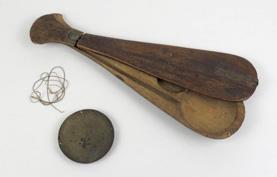

Guanfa refers to official stone weights—or standardized weights—used in ancient China under government regulation. These weights were essential for precise measurement in taxation, commerce, and official storage, helping ensure consistency and fairness across the Empire. The weights were predominantly used in state-run granaries, customs houses, and official markets, where accurate measurement of bulk goods—especially grain and salt—was crucial.
Guanfa were also known as ‘guanma’ or simply ‘fama’ (standard weights). In ancient times, ‘fa’ was also called ‘quan’ or ‘zhui’. They were typically carved from heavy stone, granite or basalt, as these stones were highly durable. Many weights were also marked Guanfa, and had further inscriptions including seal stamps and location or manufacturer notes, indicating state calibration and authority. Some stone weights reached impressive sizes, exceeding 400 jin, far heavier than the metal weights used in retail and difficult to move even for two strong men.
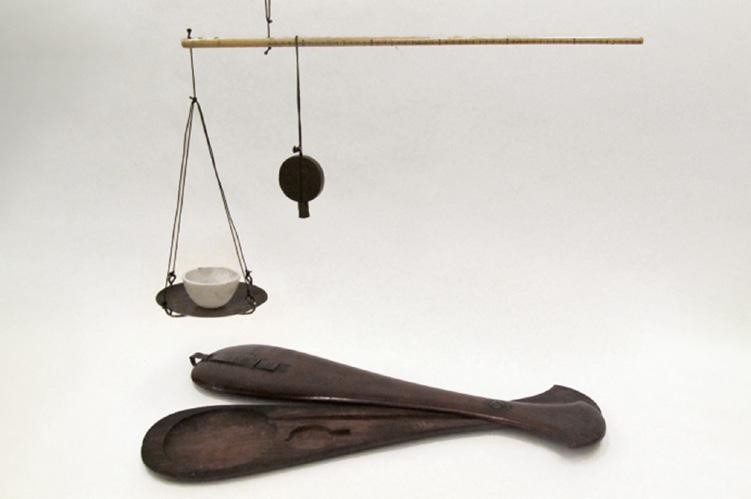
These weights are also referred to as shiquan (stone weights) and should be differentiated from chengtuo (steelyard weights), which were usually made of metal and rarely weighed over 100 jin. The methods of use also differ. A steelyard weight is moved along the arm of a balance scale; when balance is achieved, it indicates the weight of the object being measured. In contrast, a stone weight operates on the principle of a double-arm lever. The lever has equal-length arms on both sides of a central fulcrum. One end holds the object to be weighed, and the other holds the stone weight. When the lever reaches equilibrium, the weight of the object equals that of the stone weight. They also vary in their application: steelyard weights are typically used in retail shops to measure small, variable quantities, while stone weights are suited for weighing large quantities of standardized goods in wholesale transactions.
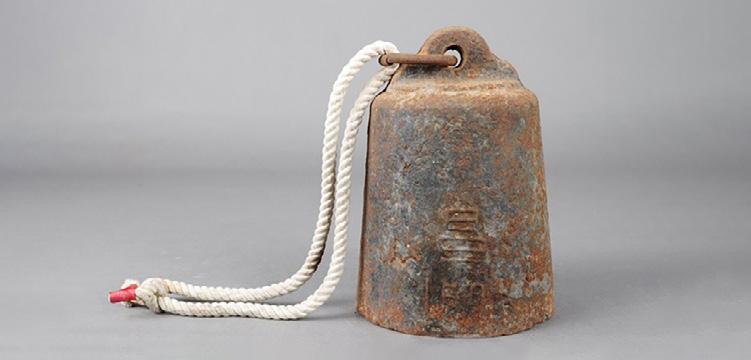
HISTORY
The Song dynasty marked a period of refinement in the standardization and usage of the jin (斤), the basic unit of mass. Over the course of the
dynasty, the weight defined as one jin underwent several adjustments, reflecting a broader dynamic between state control and market practices.
In the early Northern Song, the official weight of one jin was approximately 680 grams. This standard was used primarily for official purposes, including taxation and state granary accounting. By the mid-Northern Song, the jin had effectively decreased to around 640 grams. During the early Southern Song, particularly in the reign of Emperor Shenzong, a further reduction occurred. In daily transactions, especially those involving silver or commodities in the private sector, one jin could be as light as 625 grams. However, for formal state functions such as tribute or tax payments, the more stable 640-gram measure often remained in use. The coexistence of a heavier official scale and a lighter market standard reflects a delicate balance between the central government’s fiscal interests and the realities of a growing market economy.
During the Song dynasty, the salt monopoly stood second only to the land tax in generating revenues, when it provided over 50 percent of the state‘s cash income. The imperial administration of the Song felt fiscal pressures from the start. The government‘s central dilemma was how to maximize state revenues while improving its people‘s welfare. In response to ongoing military pressures, Song emperors assumed near complete control over the fisc in general and the lucrative salt monopoly in particular.
In the course of organizing the salt industry, the government needed different groups of agents to implement and enforce its policies. The state called on salters (salt producers) to produce, under strict regulation; it also frequently relied on professional merchants, who operated subject to obligations and restrictions imposed by the state, and as such may be seen as quasi-official.
Towards the end of the Song dynasty, the Mongol Empire launched a series of powerful military campaigns and soon conquered the Southern Song, establishing the Yuan dynasty. This transition brought significant changes to China‘s political, economic, and administrative systems—including the salt industry. During the war and subsequent Mongol occupation, many salt production sites, especially those along the coast and near salt lakes, were disrupted due to conflict, population displacement, and damaged infrastructure. However, once Mongol rule was established, the Yuan dynasty quickly moved to restore and centralize salt production. They implemented strict state monopolies, reorganized distribution networks, and relied heavily on salt taxes to fund their expansive empire. Large-scale saltworks in places like Yuncheng and Lianghuai were restored and expanded. The Yuan also enforced tight regulation using official weights (such as Guanfa) to ensure consistent taxation and prevent fraud.
Already during the Qing dynasty, the historic importance of official weights was recognized and can be seen from artistic interpretations of these dating back to the Qin dynasty. For an example see an inscribed inkstick in the shape of a weight, dated to the Qing dynasty, 15.2 cm diameter, in the Anhui Museum (fig. 1).
For a very early example, see an inscribed weight, China, Qin dynasty (221–206 BC), at the Metropolitan Museum, New York (fig. 2).
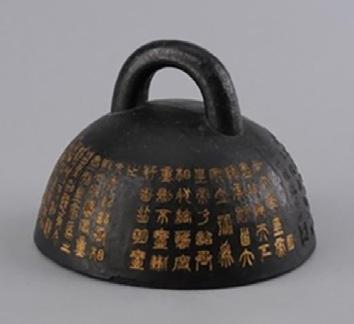
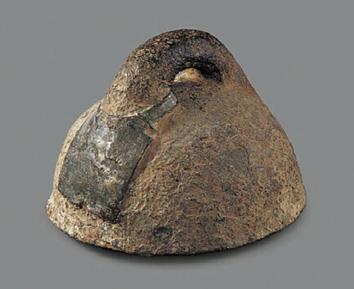
Excavations in Zhangjiawan, Tongzhou, a major node in the historical salt transport and granary system, have uncovered numerous stone weights (shiquan) dating to the Ming dynasty. These include a rare 300 kg stone weight from the Lower Salt Works—one of the largest recorded. These artifacts confirm the critical role of weights in managing salt, one of the most heavily regulated and taxed resources in Chinese history.

123
AN INSCRIBED OFFICIAL STONE WEIGHT FOR THE MEASUREMENT AND WEIGHTS OFFICE OF THE GANZHOU ROUTE, DATED 1284
China, Jiangxi province. The weight of cylindrical form, with two inscriptions to the sides, and surmounted by a beast-form handle. The beasts with bulging eyes, wide snout, the mouth forming a wide grin and bearing sharp teeth.
Inscriptions:
1. ‘Measurement and weights office of the Ganzhou lu’
2. ‘21st year of the Zhiyuan era (corresponding to 1284)’.
Provenance: The Kienzle Family Collection, Stuttgart, Germany. Acquired between 1950 and 1985 by siblings Else (1912-2006), Reinhold (1917-2008), and Dr. Horst Kienzle (1924-2019), during their extensive travels in Asia. Subsequently inherited by Dr. Horst Kienzle and bequeathed to the Museum für Asiatische Kunst, Radevormwald, Germany. Released through museum deaccession in 2024.
Condition: Good condition with expected wear, signs of weathering and erosion, encrustations, small losses, chips, nicks, and scratches.
Weight: 225 kg
Dimensions: Height 64 cm
Towards the end of the Song dynasty, the Mongol Empire launched a series of powerful military campaigns and soon conquered the Southern Song, establishing the Yuan dynasty. This transition brought significant changes to China’s political, economic, and administrative systems—including the salt industry. During the war and subsequent Mongol occupation, many salt production sites, especially those along the coast and near salt lakes, were disrupted due to conflict, population displacement, and damaged infrastructure. However, once Mongol rule was established, the Yuan dynasty quickly moved to restore and centralize salt production. They implemented strict state monopolies, reorganized distribution networks, and relied heavily on salt taxes to fund their expansive empire. Large-scale saltworks in places like Yuncheng and Lianghuai were restored and expanded. The Yuan also enforced tight regulation using official weights (such as Guanfa) to ensure consistent taxation and prevent fraud.
The Ganzhou lu was an administrative division during the Song, Jin and Yuan dynasties in China. In 1277, Ganzhou Lu was promoted to a prefecture belonging to the Jiangxi Province. Its seat was in Gan County (now Ganzhou City, Jiangxi province) and its jurisdiction was equivalent to the area east of Ganzhou City. In 1365, Zhu Yuanzhang (Emperor Shundi) changed its name to Ganzhou fu (prefecture).
Estimate EUR 3,000
Starting price EUR 1,500
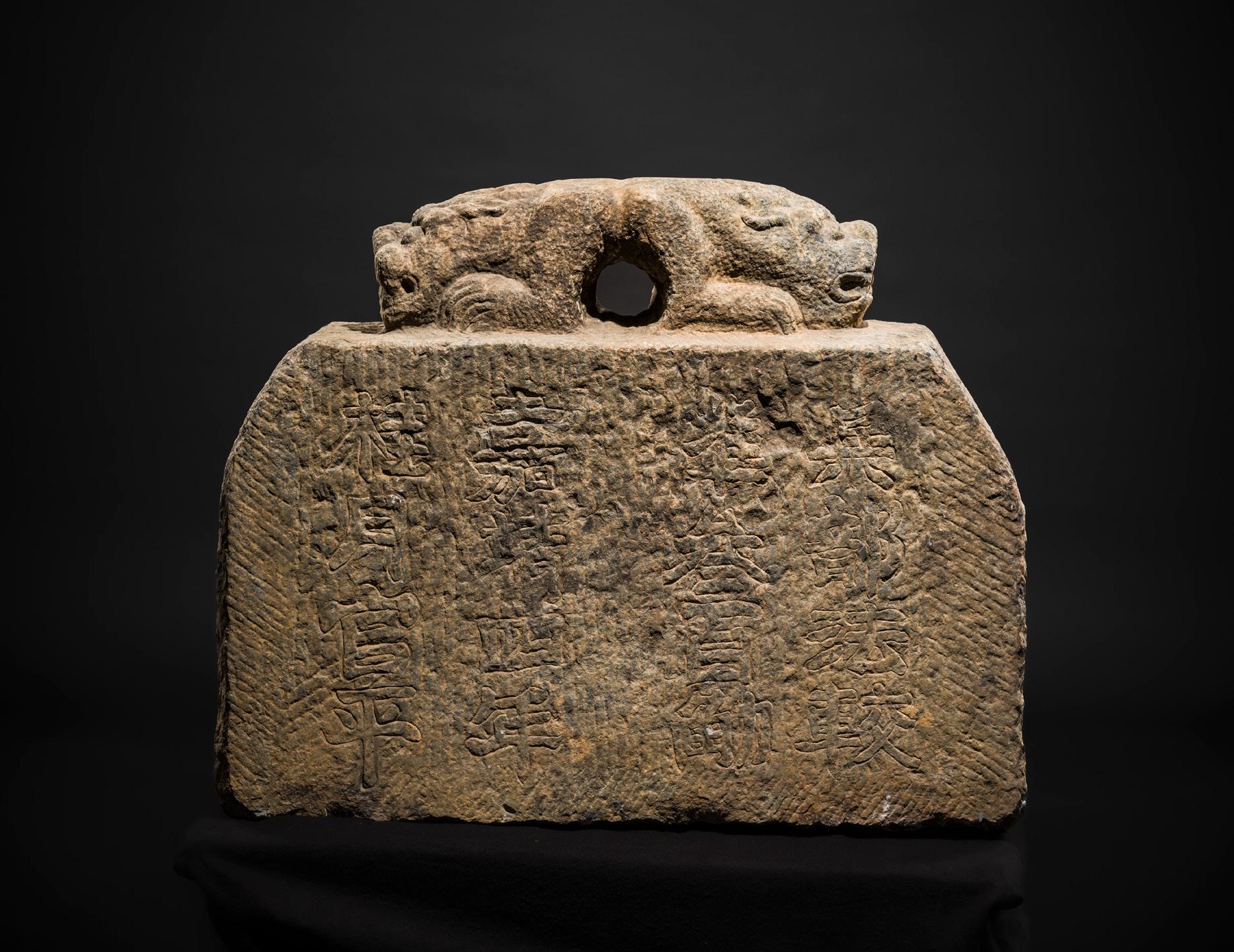
124
A LARGE STONE WEIGHT FOR THE MINISTRY OF NATIONAL DEFENSE, GUANFA, 300 JIN, DATED 1525
China. The weight of rectangular form, tapering towards the top, surmounted by a beast-form handle with two heads, each with bulging eyes, bearing sharp teeth, and three horns. One side incised with inscriptions.
Inscriptions: ‘Competition of the Ministry of National Defense (Bingbufajiao), 300 Jin [approx. 150 kg or more], 4th year of the Jiajing reign [1525], signed on the eight lunar month by the government’.
Provenance: The Kienzle Family Collection, Stuttgart, Germany. Acquired between 1950 and 1985 by siblings Else (1912-2006), Reinhold (1917-2008), and Dr. Horst Kienzle (1924-2019), during their extensive travels in Asia. Subsequently inherited by Dr. Horst Kienzle and bequeathed to the Museum für Asiatische Kunst, Radevormwald, Germany. Released through museum deaccession in 2024.
Condition: Overall good condition with expected wear, signs of weathering and erosion, small losses, chips, structural fissures, nicks, scratches, and old fills to the handle.
Weight: approximately 200-250 kg
Dimensions: Length 78 cm
Many stone weights have been unearthed in Zhangjiawan, Tongzhou, with a large number dating to the Ming dynasty. These are generally cube-shaped, with varying designs for the knob, most made from different types of heavy stone. Many are undecorated, though some bear carved patterns.
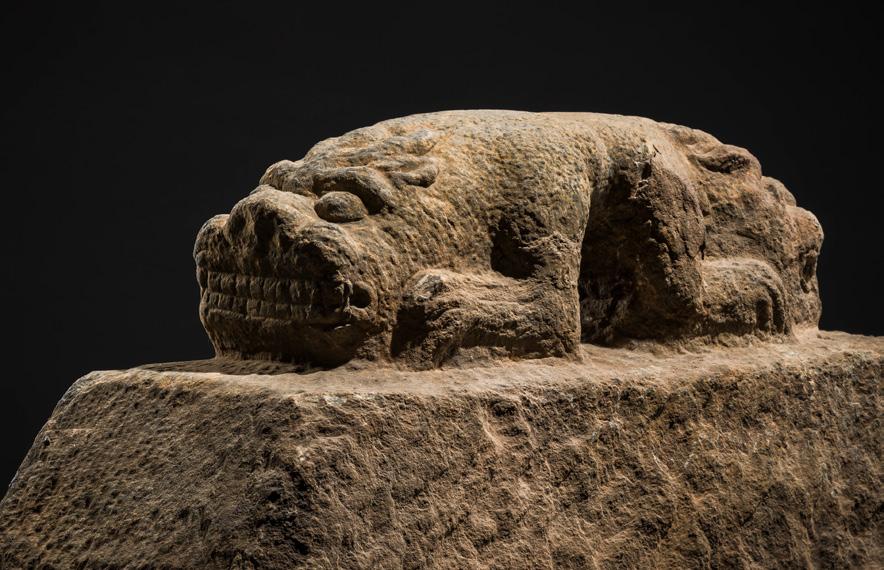
LITERATURE COMPARISON

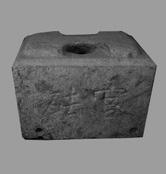
Compare an inscribed granite weight, 47.5 cm long, weighing 300-400 jin, found in the lower salt factory of Zhangjiawan in Tongzhou. Also compare an inscribed limestone weight, 62 cm long, found in the lower salt factory of Zhangjiawan in Tongzhou.
Estimate EUR 4,000
Starting price EUR 2,000

125 AN INSCRIBED IMPERIAL MARBLE WEIGHT FOR THE WENSIYUAN, GUANFA, 160 JIN (102 KG), DATED 1216
China, Anhui province. Of square cross-section, slightly tapering towards the top, surmounted by an arched handle, each side inscribed. The marble is of a creamy-beige color with russet and gray inclusions.
Expert’s note: Stylistically, the calligraphy is fully consistent with a late Song date of 1216, especially for a functional government-issued weight.
Inscriptions:
1. ‘Governor Li Jian of the local administrative office [Quanfu]’
2. ‘Weight 160 jin [approximately 102.4 kg in the Southern Song dynasty)’,
3. ‘Wensiyuan of the Ningguo prefecture [Anhui province]’
4. ‘3rd month of the 9th year of the Jiading era [1216]’.
Provenance: The Kienzle Family Collection, Stuttgart, Germany. Acquired between 1950 and 1985 by siblings Else (1912-2006), Reinhold (1917-2008), and Dr. Horst Kienzle (1924-2019), during their extensive travels in Asia. Subsequently inherited by Dr. Horst Kienzle and bequeathed to the Museum für Asiatische Kunst, Radevormwald, Germany. Released through museum deaccession in 2024.
Condition: Good condition with expected wear, signs of weathering and erosion, encrustations, structural fissures, small losses, chips, nicks, and scratches.
Weight: approximately 109 kg
Dimensions: Height 48 cm
Quanfu was the title of a local administrative office in the Song dynasty. In context of measuring and weighing, it could refer to a government office responsible for maintaining standardized weights and measurement tools.
Ningguo prefecture was established during the Southern Song dynasty. It is located in present-day Anhui province. Over the years, the prefecture’s name and area of jurisdiction changed and after Emperor Xuantong abdicated and the Republic of China was established, the prefecture was abolished.
Wensiyuan, is a Chinese government office, established during the Song dynasty and was responsible for the manufacture of gold and silver crafts, ceremonial objects, utensils, weights, and other items required by the court. It was abolished during the Qing Dynasty.
Estimate EUR 2,000
Starting price EUR 1,000
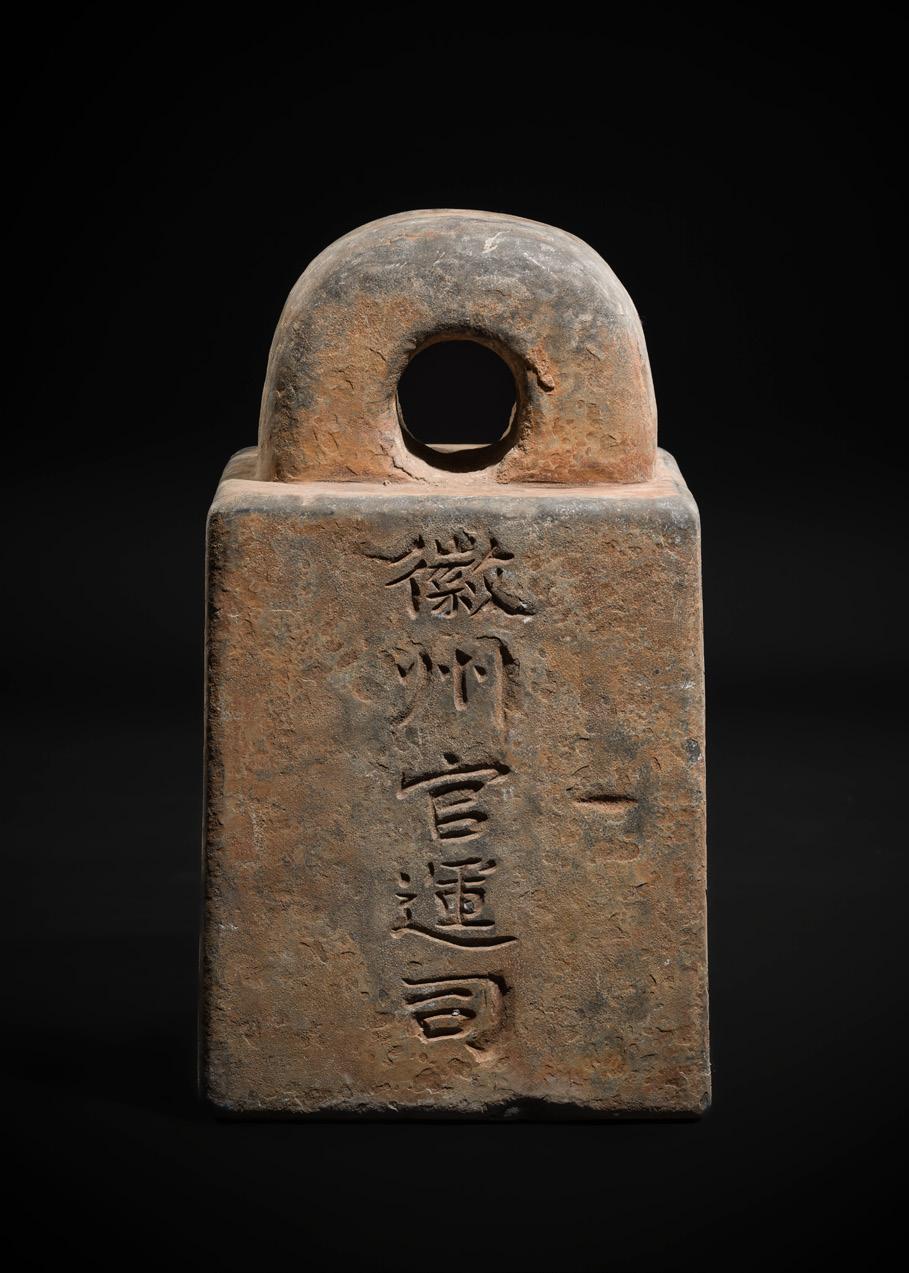
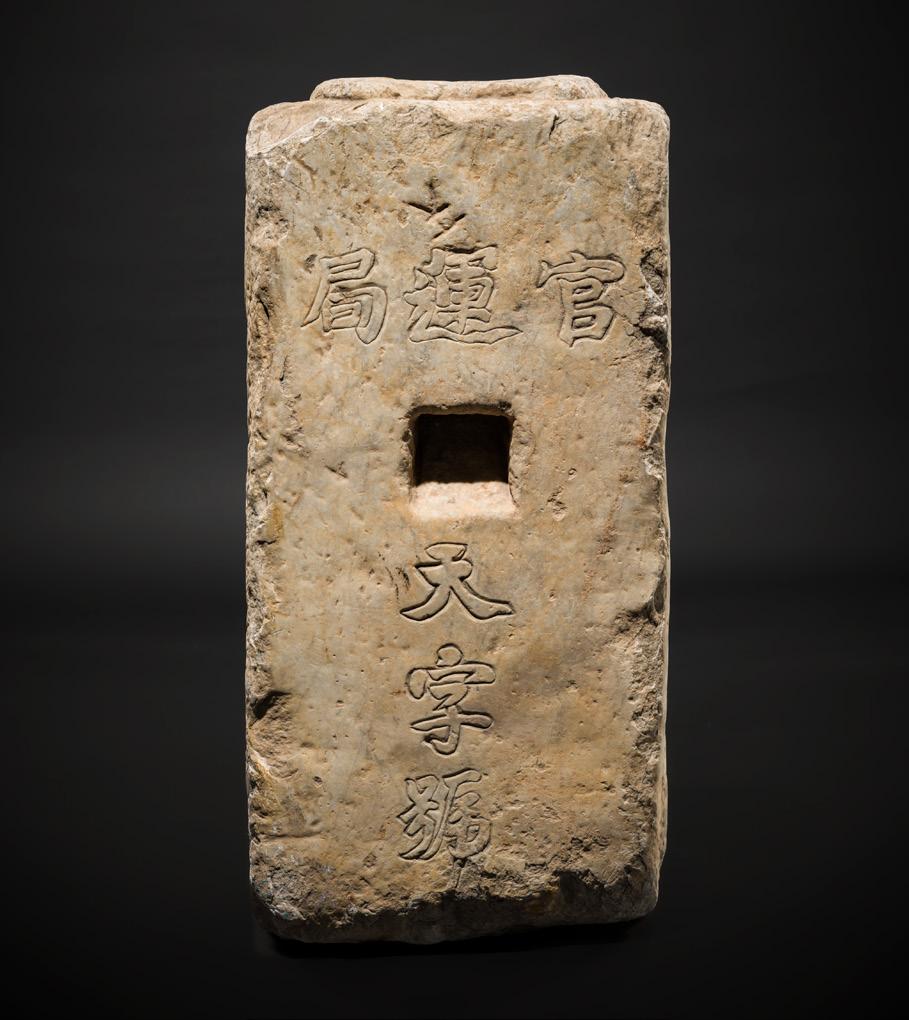
126
AN INSCRIBED OFFICIAL STONE WEIGHT OF THE IMPERIAL SALT DEPARTMENT OF HUIZHOU, GUANFA, 201 JIN (128 KG), DATED 1273
China, Huizhou. The weight of square cross-section, with an arched handle on top, finely carved to each side with a calligraphic inscription including the exact weight as well as a date and location.
Expert’s note: Stylistically, the calligraphy is fully consistent with a late Song date of 1273, especially for a functional government-issued salt trade weight. The legible, formal kaishu style is exactly what you’d expect for something like an Imperial Salt Department weight from Huizhou.
Inscriptions:
1. ‘9th year of the Xianchun era (corresponding to 1273)’
2. ‘201 jin [corresponding to approx. 128 kg in the Southern Song dynasty]’
3. ‘Salt import and salt export wharf’
4. ‘Imperial salt department of Huizhou’.
Provenance: The Kienzle Family Collection, Stuttgart, Germany. Acquired between 1950 and 1985 by siblings Else (1912-2006), Reinhold (19172008), and Dr. Horst Kienzle (1924-2019), during their extensive travels in Asia. Subsequently inherited by Dr. Horst Kienzle and bequeathed to the Museum für Asiatische Kunst, Radevormwald, Germany. Released through museum deaccession in 2024.
Condition: Good condition with expected wear, signs of weathering and erosion, encrustations, small losses, structural fissures, chips, nicks, and scratches.
Weight: approx. 140 kg
Dimensions: Height 61 cm
Estimate EUR 2,000
Starting price EUR 1,000
127
AN INSCRIBED OFFICIAL MARBLE WEIGHT FOR THE GOVERNMENT DEPARTMENT OF TRANSPORTATION, GUANFA, QING DYNASTY
China, 1644-1912. The stone of rectangular form with one square notch to the front, both sides with an inscription above and below, and the top with a curved elevation. The marble is of a creamy-beige color with russet and gray inclusions.
Inscriptions:
1. ‘Guanyun ju [Government department for transportation]’, and ‘Number one’.
2. ‘Huizhou Hall Guild’, and ‘Qingyu tang’
Provenance: The Kienzle Family Collection, Stuttgart, Germany. Acquired between 1950 and 1985 by siblings Else (1912-2006), Reinhold (19172008), and Dr. Horst Kienzle (1924-2019), during their extensive travels in Asia. Subsequently inherited by Dr. Horst Kienzle and bequeathed to the Museum für Asiatische Kunst, Radevormwald, Germany. Released through museum deaccession in 2024.
Condition: Good condition with expected wear, signs of weathering and erosion, small losses, chips, nicks, and scratches.
Weight: 160 kg
Dimensions: Height 73 cm
Estimate EUR 2,000
Starting price EUR 1,000
128 A LARGE AND MASSIVE GILT AND POLYCHROME LIMESTONE STELE OF BUDDHA SHAKYAMUNI AND PRABHUTARATNA, EASTERN WEI PERIOD
Northern China, Henan Province, circa 550-600 or slightly later. Of arched form, finely carved with Buddha Shakyamuni standing in samabhanga on a tall lotus base, his right hand lowered in abhaya mudra and the left raised holding the hem of his sanghati worn over a long dhoti, both with subtly carved folds, the face with a serene expression and downcast eyes, backed by a prominent mandorla with petals, and flanked by the bodhisattvas Avalokiteshvara and Mahasthamaprapta, each with hands held in varada and abhaya mudras, all below celestial musicians and a pair of heavenly apsaras that support an image of the seated Buddha Prabhutaratna (Abundant Treasure), the Buddha of the past who vowed to be present whenever the Lotus Sutra was invoked.
Provenance: The Kienzle Family Collection, Stuttgart, Germany. Acquired between 1950 and 1985 by siblings Else (1912-2006), Reinhold (1917-2008), and Dr. Horst Kienzle (1924-2019), during their extensive travels in Asia. Subsequently inherited by Dr. Horst Kienzle and bequeathed to the Museum für Asiatische Kunst, Radevormwald, Germany. Released through museum deaccession in 2024.
Condition: Good condition, commensurate with age. Extensive wear, signs of weathering and erosion, encrustations, obvious losses, old repairs and touchups, nicks, chips, structural cracks, and scratches. Some of the original gilding and polychrome pigments remain, though these have been renewed multiple times over the centuries, including in the 19th century. Such repainting was an integral part of devotional practice—these sculptures were venerated for generations and regularly repainted as a gesture of reverence and to keep the sacred presence “alive.” The apparent freshness of certain pigments should not be mistaken for modernity: this sculpture is an ancient work of art with over 1000 years of age.
Dimensions: Height 125 cm
Richly carved with a vibrant scene of veneration, encapsulating Buddhist compassion and celestial quality, the present carving encapsulates the emergence of stone steles as an important Buddhist sculptural medium in Chinese history. Holding his right hand in abhaya mudra, signifying reassurance, the Buddha conveys to the worshipers that they may receive the divine blessings.
According to the Lotus Sutra, the apsaras are the protectors of the Buddha and of doctrine. These creatures were frequently portrayed in Buddhist cave temples from at least 420 and grew in popularity during the late Northern Wei and Eastern Wei periods. The rare depiction of Prabhuratna, the Buddha from the previous historical era appears in the sky during a sermon by Shakyamuni Buddha, reminding his acolytes of the power of previous Buddhas, is a wholly Chinese invention not found in Indian art. The central Buddha’s dress here, on the other hand, is directly
derived from Indian Gupta prototypes, see an example dated about 475, from the Rockefeller Collection, now at Asia Society, New York, accession number 1979.5.
Steles played an important role in the development of religious art in China. During the Northern and Eastern Wei dynasties, state-sponsorship of Buddhism enabled the rapid spread of the religion throughout northern China. At this time, Buddhist voluntary groups affiliated to local temples and organized by laymen became the main patrons of Buddhist steles which commemorated the group’s religious, social, and territorial identity. The relative ubiquity of the medium employed to manufacture steles, and their small size, prompted a multitude of regional workshops, many of which developed their own style using the monumental cave temple carvings as a basis. Many stone Buddhist sculptures were brightly colored, as were the buildings in which they were displayed.
LITERATURE COMPARISON

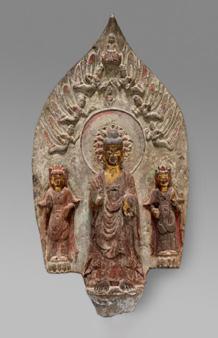
Compare a related larger stele with Buddha and two bodhisattvas, Eastern Wei, 310 cm high, illustrated by Edmund Capon and Liu Yang, The Lost Buddhas: Chinese Buddhist Sculpture from Qingzhou, Art Gallery of New South Wales, p. 62-63, no. 9. Compare a related smaller Eastern Wei limestone Buddhist stele with Shakyamuni flanked by two bodhisattvas, with similar polychrome decoration described as “ possible […] original sixth-century colors ”, 132.1 cm high, in the Asian Art Museum of San Francisco, object number B60S112+.
AUCTION RESULT COMPARISON
Type: Closely related
Auction: Bonhams London, 5 November 2020, lot 5
Price: GBP 68,812 or approx. EUR 111,000 converted and adjusted for inflation at the time of writing
Description: A large limestone Buddhist stele, Eastern Wei dynasty or later
Expert remark: Compare the closely related modeling, manner of carving, and subject. Note the size (96 cm).
Estimate EUR 8,000
Starting price EUR 4,000

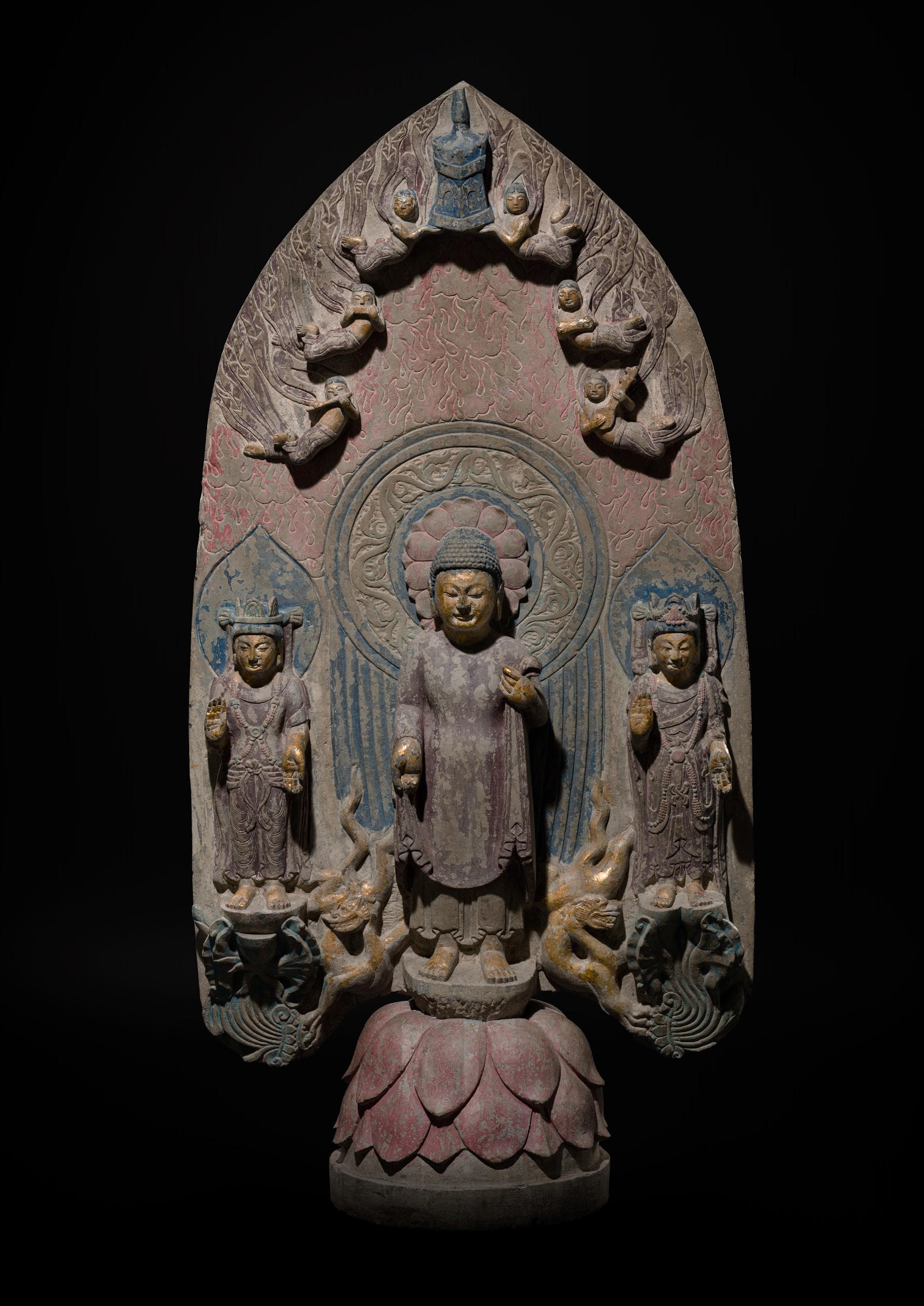

129
A PAIR OF LARGE GILT-BRONZE FIGURES OF MAITREYA AND AVALOKITESHVARA
China, 20th century or earlier. Well cast in mirror image, each standing gracefully atop an oval waisted double-lotus base, one hand held in abhaya mudra and the other slightly lower in dhyana mudra, one clutching a vase, both dressed in voluminous robes cascading in neatly detailed folds and richly adorned with beaded jewelry and billowing scarves. Their serene faces with heavy-lidded downcast eyes and slender bow-shaped lips pursed to form a subtle smile, the hair tied into a tall chignon centered by their identifying attributes: an image of Buddha Amitabha for Avalokiteshvara and a vase for Maitreya. (2)
Provenance: The Kienzle Family Collection, Stuttgart, Germany. Acquired between 1950 and 1985 by siblings Else (1912-2006), Reinhold (1917-2008), and Dr. Horst Kienzle (1924-2019), during their extensive travels in Asia. Subsequently inherited by Dr. Horst Kienzle and bequeathed to the Museum für Asiatische Kunst, Radevormwald, Germany. Released through museum deaccession in 2024.
Condition: Good condition with wear and casting irregularities. Flaking and extensive losses to gilt. One scarf with an old repair with associated touchups, each base with traces of soldering.
Dimensions: Height 78.5 cm and 79.5 cm
Estimate EUR 3,000 Starting price EUR 1,500
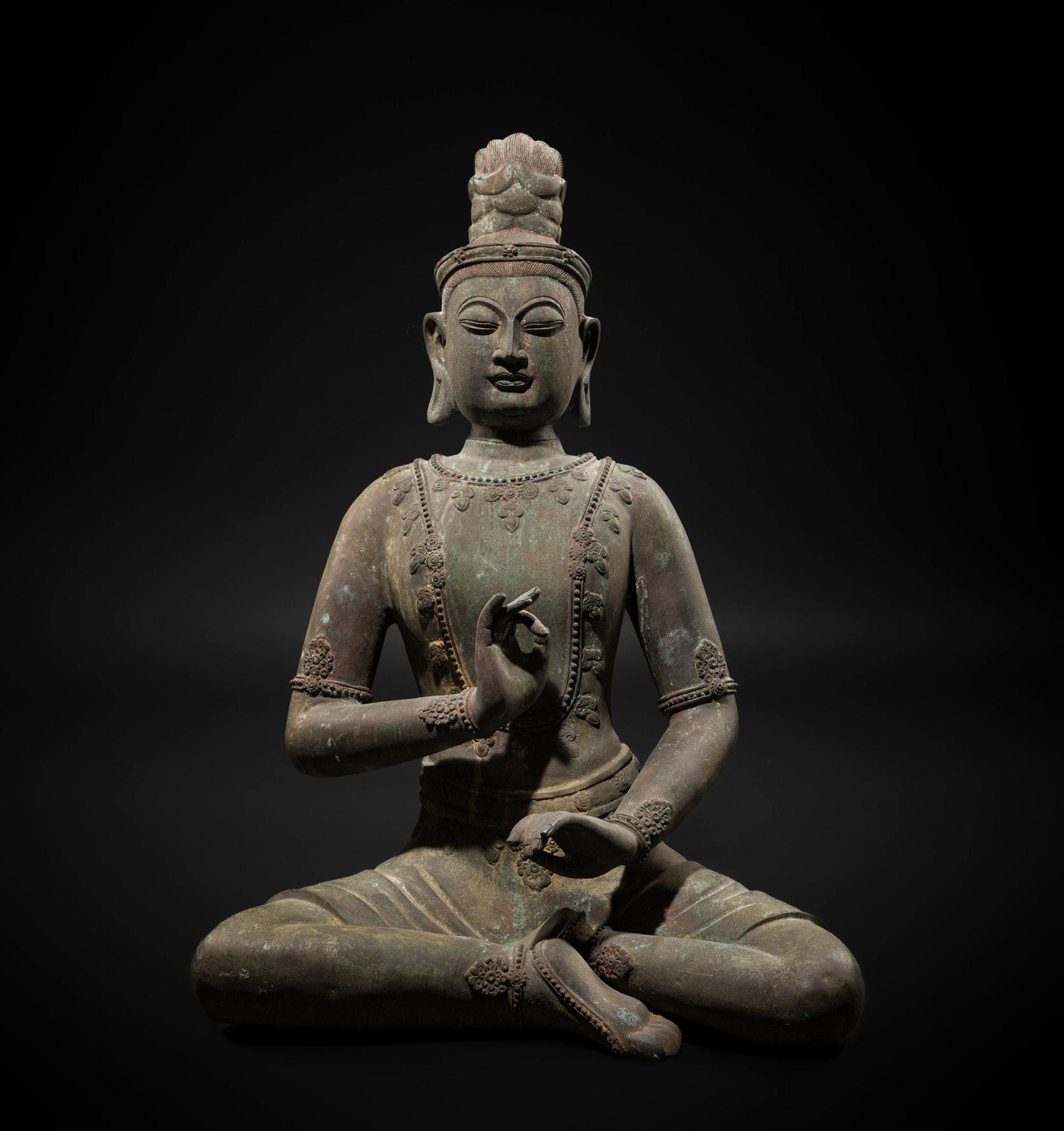
A LARGE NEPALESE-STYLE BRONZE FIGURE OF A BODHISATTVA
China, first half of 20th century or earlier. Seated in rajalilasana with the right hand raised in vitarka mudra, wearing a short dhoti with deeply carved folds, his body richly adorned with beaded and foliate jewelry, the face with a serene expression marked by heavy-lidded downcast eyes, elegantly arched brows, and full bow-shaped lips forming an enigmatic smile, flanked by long pendulous earlobes, the hair pulled up into a tall braided chignon behind the short tiara.
Provenance: The Kienzle Family Collection, Stuttgart, Germany. Acquired between 1950 and 1985 by siblings Else (1912-2006), Reinhold (1917-2008), and Dr. Horst Kienzle (1924-2019), during their extensive travels in Asia. Subsequently inherited by Dr. Horst Kienzle and bequeathed to the Museum für Asiatische Kunst, Radevormwald, Germany. Released through museum deaccession in 2024.
Condition: Good condition with expected wear, manufacturing irregularities, remnants of pigment, extensive verdigris.
Dimensions: Height 78.7 cm
EXPERT’S NOTE:
The current figure is inspired by lacquered sculptures of Chinese craftsmanship and Nepalese style produced in the 13th century, which were themselves strongly influenced by Indian Pala models. These works emerged after the Mongol ruler Khubilai Khan (1215–1294) invited eighty Nepalese artist-monks to China to construct and embellish a monastery. Among them was the renowned artist Aniko, who remained in China and established a workshop responsible for some of the most distinguished sculptures of this style and period. Compare a related earlier dry lacquer figure of a bodhisattva which possibly served as a direct influence for the present lot, dated to the 13th century, 58.5 cm high, in the National Museum of Asian Art, Smithsonian Institution, accession number F1945.4.
Estimate EUR 3,000
Starting price EUR 1,500

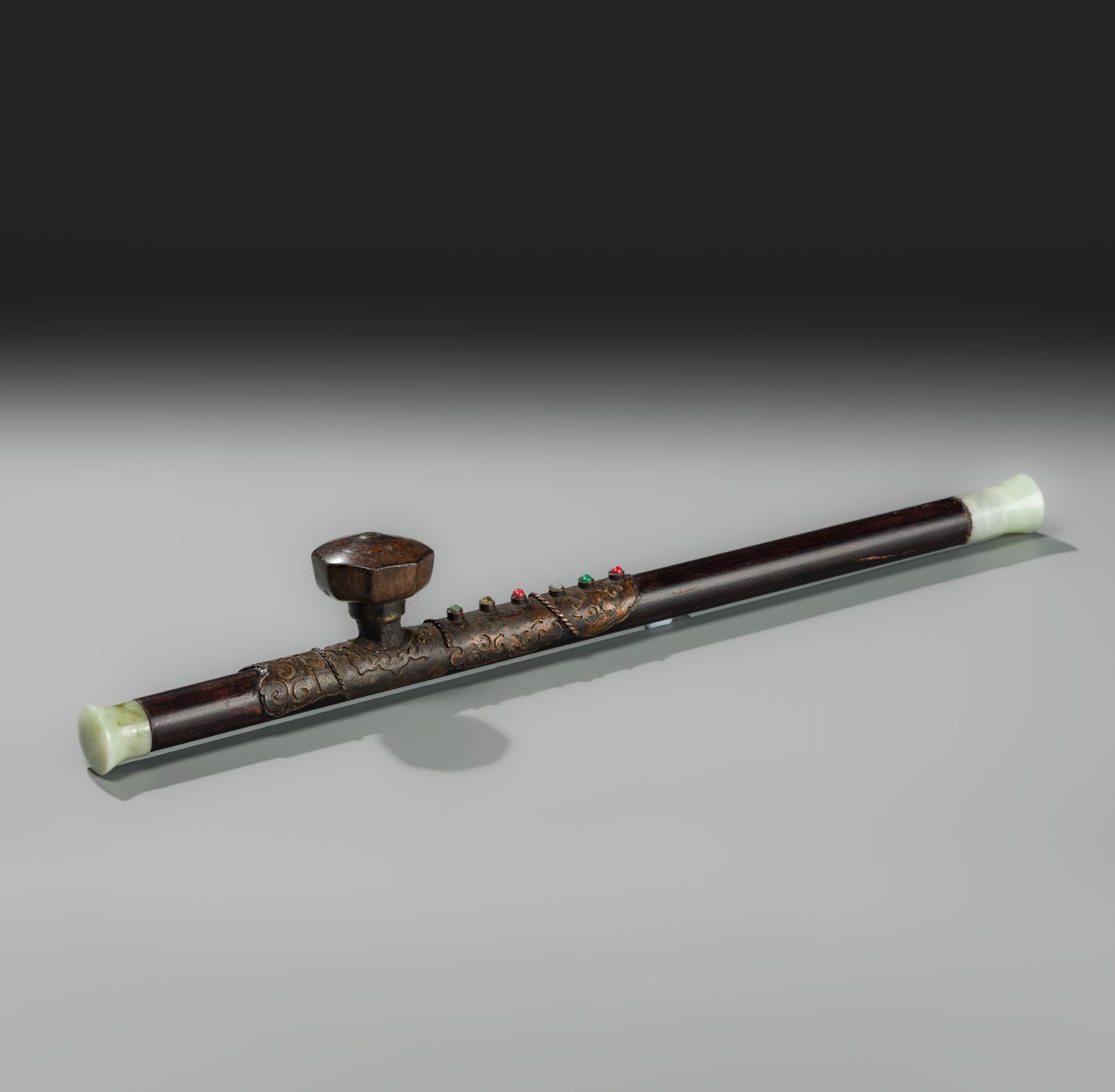
A HARDWOOD OPIUM PIPE WITH HARDSTONE AND METAL FITTINGS, LATE QING DYNASTY TO REPUBLIC PERIOD
China, late 19th to earlier 20th century. The wood with hardstone mouthpiece, the bronze and copper saddle pierced with spirals and inlaid with precious stones and glass beads, the pipe bowl of bronze patinated with a floral design.
Provenance: The Kienzle Family Collection, Stuttgart, Germany. Acquired between 1950 and 1985 by siblings Else (1912-2006), Reinhold (1917-2008), and Dr. Horst Kienzle (1924-2019), during their extensive travels in Asia. Subsequently inherited by Dr. Horst Kienzle and bequeathed to the Museum für Asiatische Kunst, Radevormwald, Germany. Released through museum deaccession in 2024.
Condition: Good condition with wear, traces of use, and manufacturing irregularities, light scratches, few minuscule nicks, small dents.
Weight: 521 g
Dimensions: Length 56.2 cm
AUCTION RESULT COMPARISON
Type: Related
Auction: Zacke, Vienna, 5 March 2021, lot 19
Price: EUR 2,022 or approx. EUR 2,500 adjusted for inflation at the time of writing
Description: A bamboo opium pipe with hardstone, silver and Yixing ceramic fittings, late Qing to Republic
Expert remark: Compare the related form, design, and size (55.5 cm).

Estimate
Mongolia. The wood pipe lacquered in red and black, fitted with a bronze and silver pipe bowl and a white jade mouthpiece. The pouch finely woven with metal thread, fitted with a silver chain, pipe pick, and lobed ornament with pierced ‘endless knot’ designs.
Provenance: Galerie Hardt (established in 1976), Radevormwald, Germany, before 2020. Acquired by the gallery’s founder Peter Hardt (b. 1946) during his extensive travels in Asia, the first of which occurred during a formative world tour in 1973.
Labels: Galerie Hardt, inscribed ‘Pfeifenbesteck aus Silver + Jade, reichhaltig bestickt, Mongolei 19. Jh‘, the back, ‘Reg.-Nr. 52007 H3
B1 T24‘, and priced at EUR 3,750. The second label printed, ‘52007’.
Condition: Good condition with expected wear, traces of use, manufacturing irregularities, minor tarnish, losses to lacquer, few small nicks, the brocade with few tears and minor losses.
Weight: 372 g (total)
Dimensions: Length 23.3 cm (the pipe), 19.7 cm (the pouch)
LITERATURE COMPARISON
Compare related pipes and pouches on display in the National Museum of Mongolia.
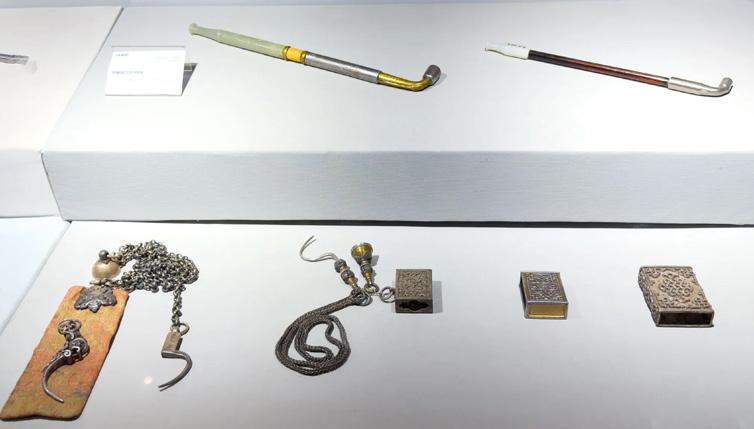
Estimate EUR 1,000
Starting price EUR 500
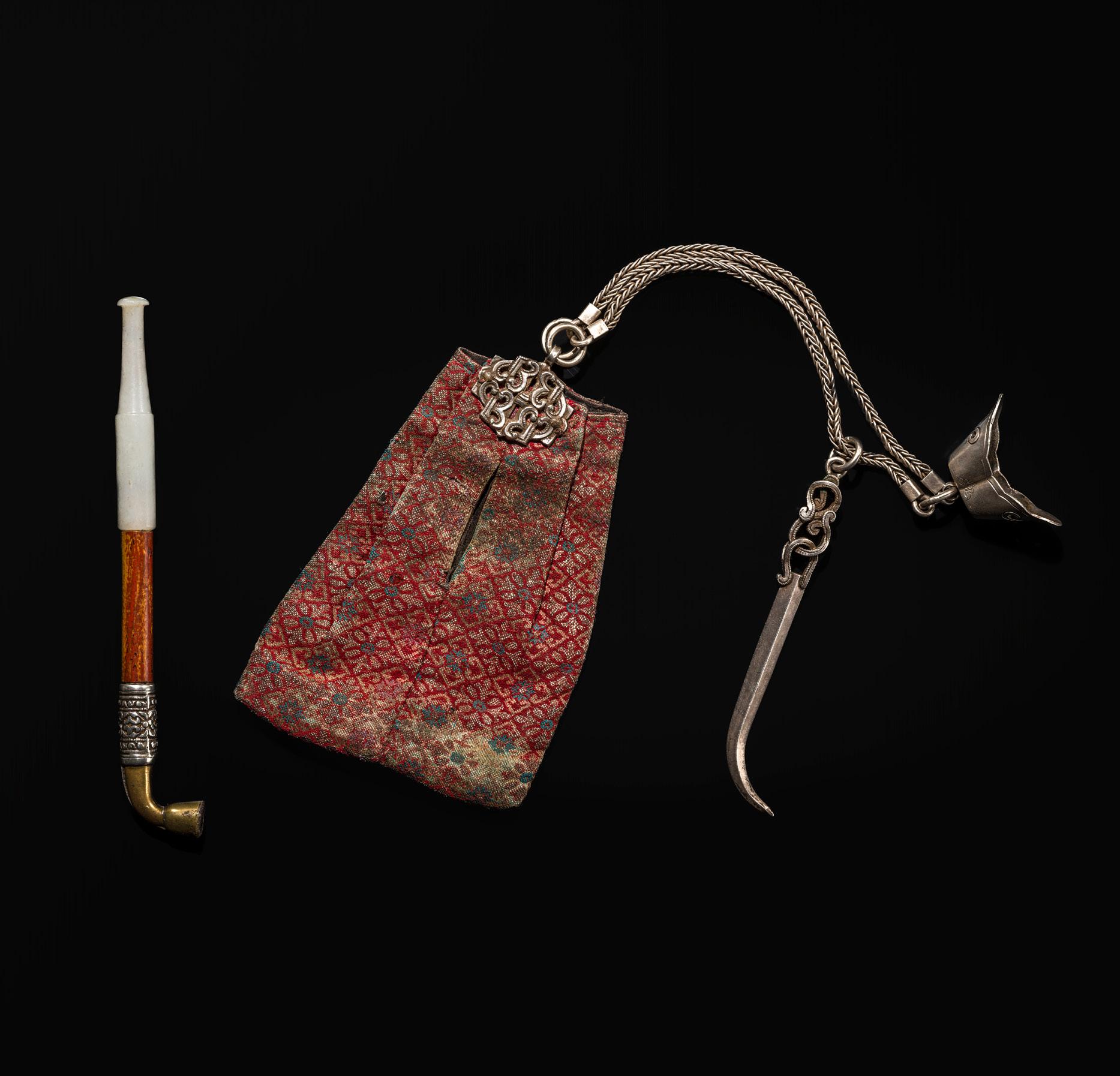
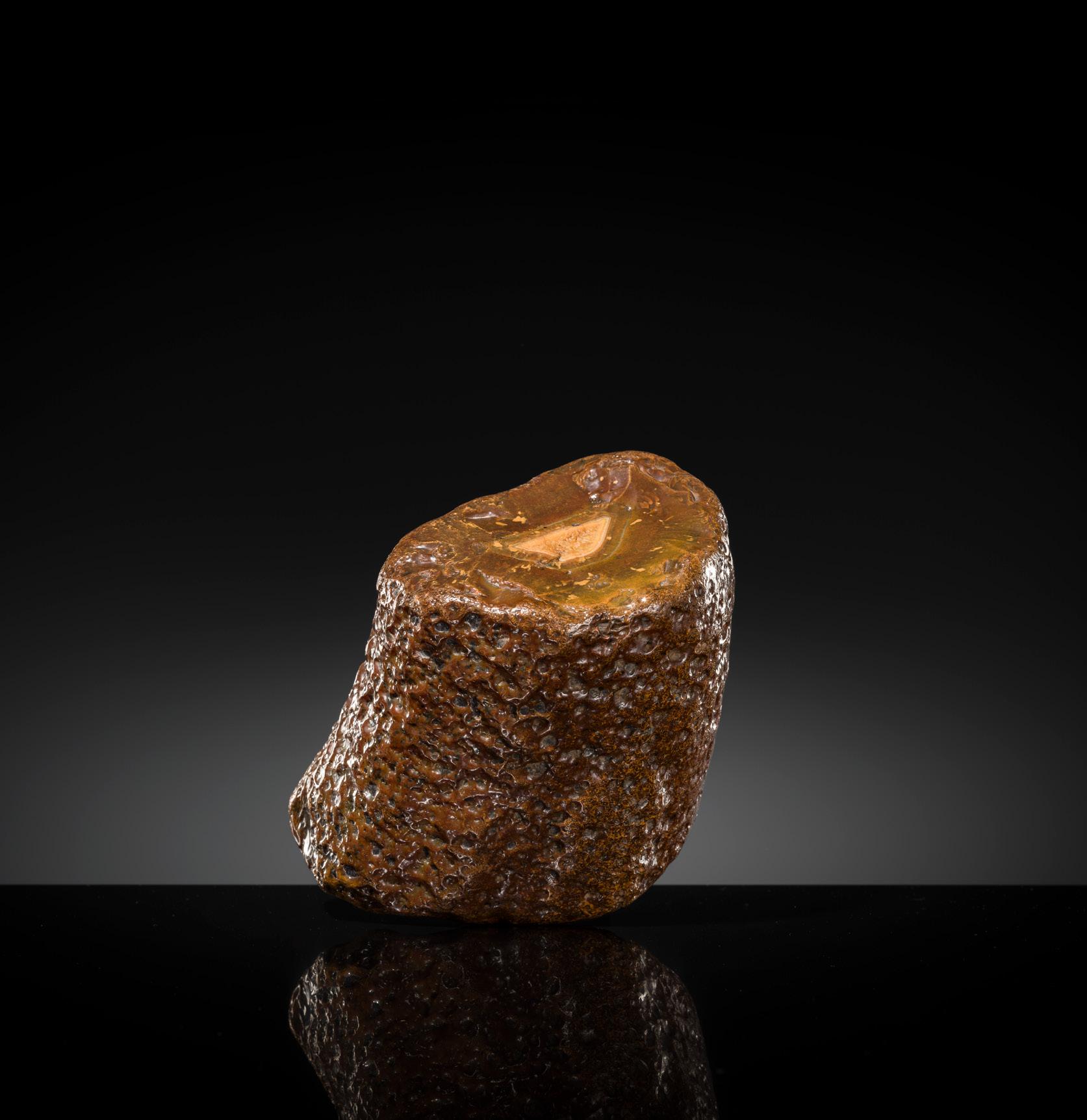
AN AGATE SCHOLAR’S ROCK, 19TH TO EARLY 20TH CENTURY
China, ca. 1830-1930. Finely carved from a piece of agate to resemble the porous surface of a river rock, neatly polished to an oily shine. The semi-translucent stone is of a deep amber-red tone with paler shadings and a russet-colored crystalline center.
Provenance: Galerie Hardt (established in 1976), Radevormwald, Germany, before 2020. Acquired by the gallery’s founder Peter Hardt (b. 1946) during his extensive travels in Asia, the first of which occurred during a formative world tour in 1973.
Labels: Galerie Hardt, inscribed ‘Stein, Tibet’, the back ‘Reg: 165014, H:8/B:19/T:16’, and priced EUR 1,420
Condition: Excellent condition with minor wear and natural imperfections.
Weight: 3.3 kg
Dimensions: Height 12.7 cm
AUCTION RESULT COMPARISON
Type: Related
Auction: Sotheby’s London, 6 November 2013, lot 380
Price: GBP 9,375 or approx. EUR 18,000 converted and adjusted for inflation at the time of writing
Description: An agate mountain, Qing dynasty
Expert remark: Compare the related material. Note the form and gray color.
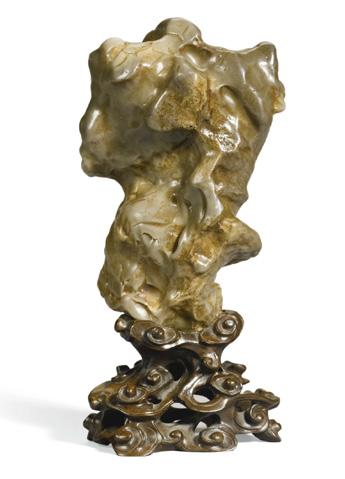
Estimate EUR 500
Starting price EUR 250
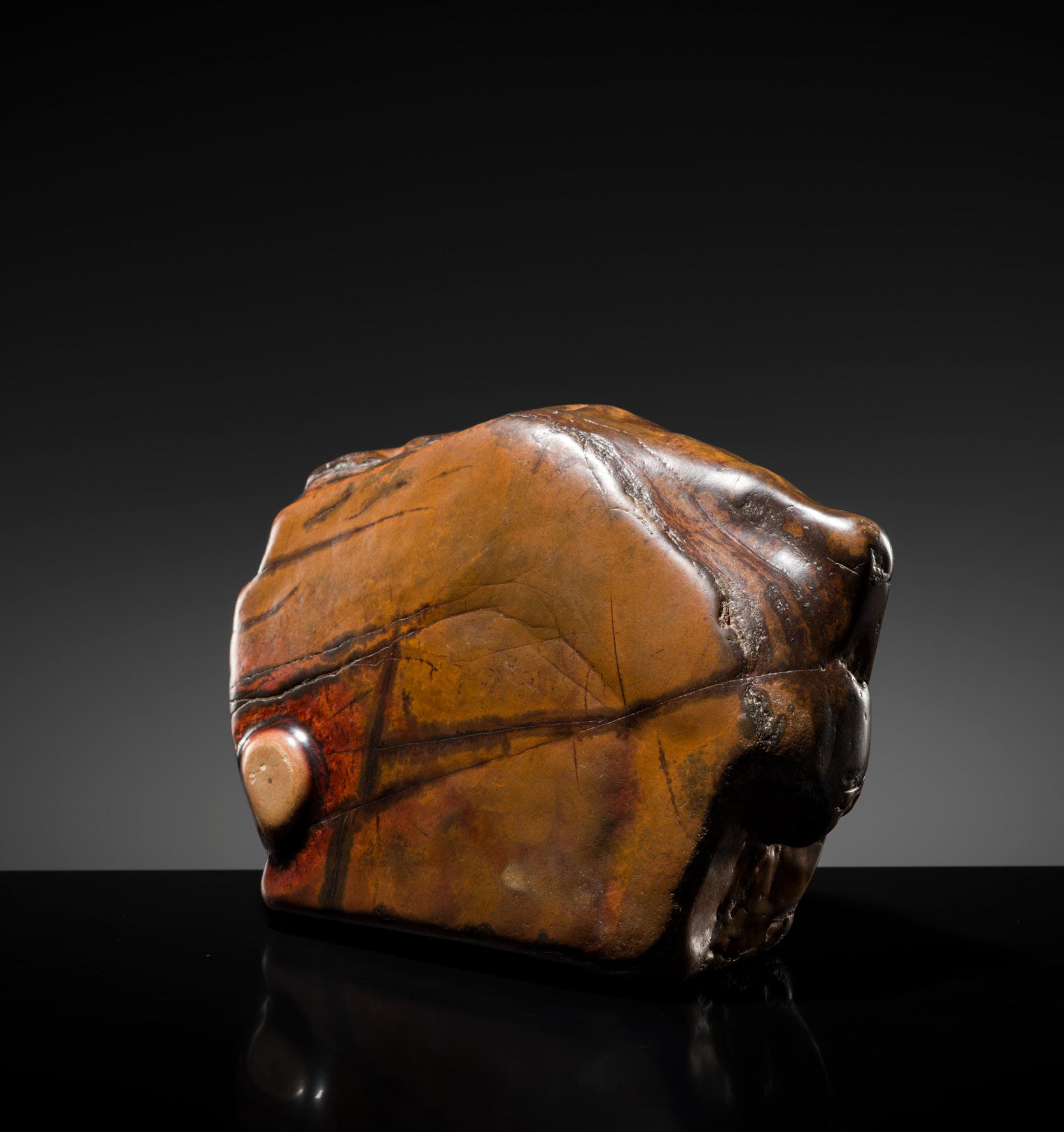
AN AGATE ‘BUDDHA’S EYE’ SCHOLAR’S ROCK, 19TH TO EARLY 20TH CENTURY
China, ca. 1830-1930. Carved from a piece of agate, the surface finely polished highlighting a beige protruding eye that is surrounded by red areas and brown bleeding veins. The opaque stone is of a leatherybrown color with dark brown, red, and beige inclusions.
Provenance: Galerie Hardt (established in 1976), Radevormwald, Germany, before 2020. Acquired by the gallery’s founder Peter Hardt (b. 1946) during his extensive travels in Asia, the first of which occurred during a formative world tour in 1973.
Condition: Excellent condition with minor wear and natural imperfections including fissures.
Weight: 3.8 kg
Dimensions: Length 19.7 cm
LITERATURE COMPARISON
Compare a related scholar’s rock of similar shape and color, inscribed by Zhang Daqian with a dedication, formerly in the collection of General Zheng Wei-Yuan and sold at Bonhams Hong Kong, 1 June 2024, lot 215.
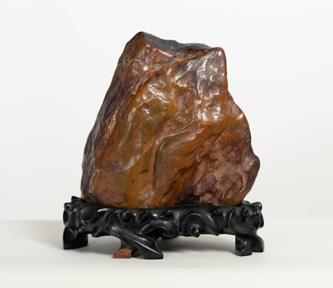
Estimate EUR 1,000
Starting price EUR 500

135
A RARE GILT-BRONZE
‘BEAST-MASK’ DOOR KNOCKER, QING DYNASTY OR EARLIER
Expert’s note: The present lot is modeled after beast-mask door knockers from the Tang dynasty. While it diverges slightly in style from known prototypes, several features strongly suggest an earlier date than the Qing dynasty. These include the remarkably solid cast, the naturally developed patina, the high copper content of the alloy, and the rich, uneven gilding—characteristics consistent with early casting techniques. Additionally, the overall sculptural quality, with its deeply recessed contours and vigorous modeling, reflects a period when such motifs were imbued with apotropaic significance and rendered with greater expressive force. The extensive wear patterns and surface texture further point to prolonged age and exposure, supporting a more archaic attribution.
China, 1644-1912 or earlier. The ferocious beast with mouth wide open revealing sharp fangs and suspending a large loose ring with globular knocker, further detailed with a wide snout and bulging eyes below scrolling eyebrows, framed by a fiery mane, the head surmounted by a single curving horn.
Provenance: Galerie Hardt (established in 1976), Radevormwald, Germany, before 2020. Acquired by the gallery’s founder Peter Hardt (b. 1946) during his extensive travels in Asia, the first of which occurred during a formative world tour in 1973.
Condition: In good condition with light wear, casting irregularities, traces of old soldering, rubbing to the gilt, and minor nicks. The ring is of European origin and dates to the first half of the 20th century.
Weight: 2 kg
Dimensions: Length 22.8 cm (the mask without the ring), Height 37.1 cm (incl. stand)
AUCTION RESULT COMPARISON
Type: Related
Auction: Sotheby’s Hong Kong, 18 December 2024, lot 768
Price: HKD 50,400 or approx. EUR 5,700 converted and adjusted for inflation at the time of writing
Description: A gilt-bronze ‘mask and makara’ door knocker, late Tang-Five dynasties
Expert remark: Compare the related form, decoration, and subject. Note the size (31 cm).
AUCTION RESULT COMPARISON
Type: Related
Auction: Sotheby’s Hong Kong, 20 May 2025, lot 3612
Price: HKD 50,000 or approx. EUR 5,500 converted at the time of writing
Description: A gilt-bronze ‘beast mask’ door knocker, late Tang dynasty
Expert remark: Compare the related form, decoration, and subject. Note the size (15.5).
Estimate EUR 1,000
Starting price EUR 500

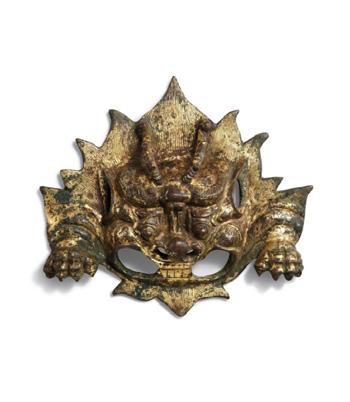
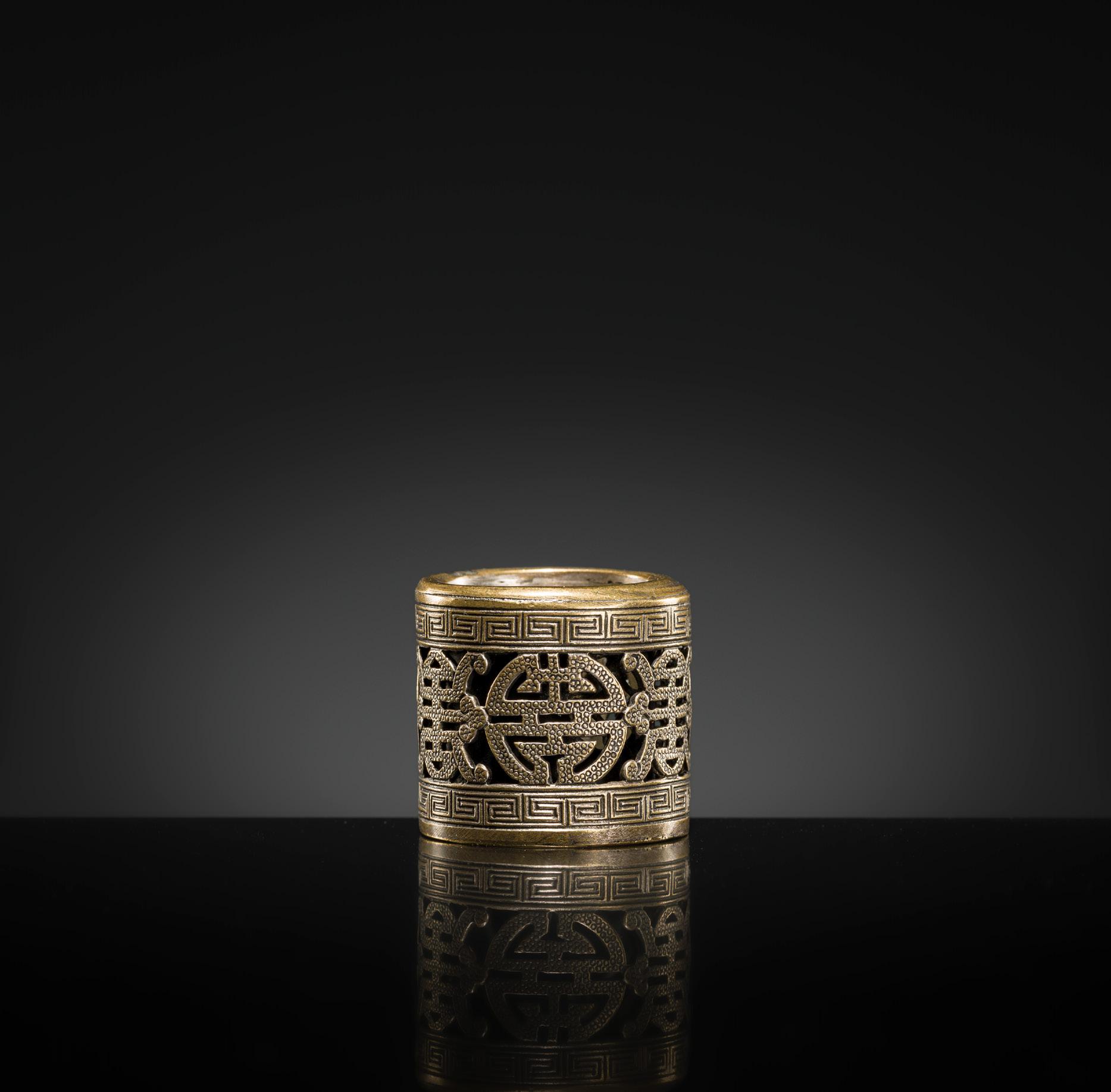
A BRONZE ARCHER’S THUMB RING, LATE QING DYNASTY
China, circa 1850-1900. Of cylindrical form, cast in openwork with a band of six ring-punched Shou characters of alternating stylized forms framed by key-fret borders. The interior pierced with three cash-coin emblems.
Provenance: Galerie Hardt (established in 1976), Radevormwald, Germany, before 2020. Acquired by the gallery’s founder Peter Hardt (b. 1946) during his extensive travels in Asia, the first of which occurred during a formative world tour in 1973.
Labels: Galerie Hardt, inscribed ‘Ring, Bronze & Silver, China, 18. Jh.‘, the back ‘Reg. Nr: 109809, H:3 B:3 T:3‘, and priced at EUR 4,250
Condition: Very good condition with minor wear, traces of use, and casting irregularities, remnants of silvering to exterior.
Weight: 37.9 g
Dimensions: Length 3 cm
AUCTION RESULT COMPARISON
Type: Related
Auction: Christie’s New York, 20 October 2004, lot 540
Price: USD 1,434 or approx. EUR 2,900 converted and adjusted for inflation at the time of writing
Description: An unusual Chinese reticulated brass thumb ring, Qing dynasty
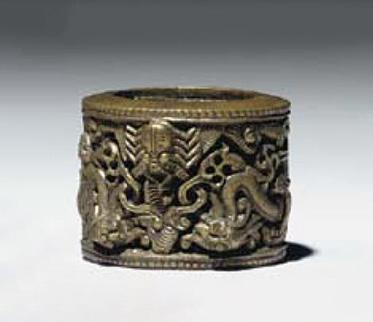
Expert remark: Compare the related form, material, and size (3.2 cm). Note the decoration.
Estimate EUR 1,000
Starting price EUR 500

A SILVER-INLAID IRON TOBACCO BOX AND COVER, JOSEON DYNASTY
Korea, 18th-19th century. Raised on four brass feet and fitted with a metal handle to one side, each side richly inlaid in silver with a Chinese character in a rectangular panel surrounded by key-fret and floral diaper designs. The interior lined with wood.
Provenance: Galerie Hardt (established in 1976), Radevormwald, Germany, before 2020. Acquired by the gallery’s founder Peter Hardt (b. 1946) during his extensive travels in Asia, the first of which occurred during a formative world tour in 1973.
Condition: Very good condition with minor wear, traces of use, and casting irregularities, one small loss to the brass fitting to the interior.
Weight: 712 g
Dimensions: Size 11 x 7.4 x 6.8 cm
During the Joseon period, boxes such as the present lot were used by wealthy gentlemen as storage containers for tobacco, which has been grown and smoked in Korea since the early seventeenth century, when it was introduced from Japan. Such boxes are typically decorated with auspicious motifs, like the Double Happiness character on the cover of the present lot.
Literature comparison:
Compare a closely related silver inlaid iron tobacco box, dated to the 19th century, in the Metropolitan Museum of Art, object number 22.78.
Compare a closely related silver inlaid iron tobacco box, dated 1850-1888, in the Victoria & Albert Museum, accession number 1842-1888.
AUCTION RESULT COMPARISON
Type: Related
Auction: Bonhams London, 2 November 2020, lot 225
Price: GBP 6,062 or approx. EUR 9,900 converted and adjusted for inflation at the time of writing
Description: A silver-inlaid iron box and cover, Korea, 18th/19th century
Expert remark: Compare the related form, decoration, and technique, as well as the size (10.5 cm).
Estimate EUR 1,000
Starting price EUR 500
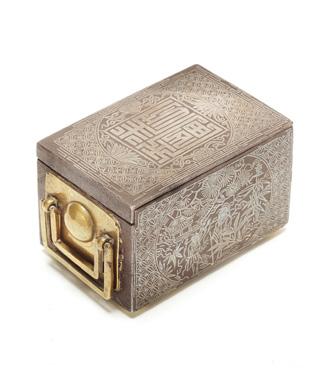

Of rectangular form, finely woven with roundels enclosing Shou characters, each containing a pair of swastikas (wan), encircled by five bats (wu fu), reserved against a wan key-fret ground.
Provenance: Galerie Hardt (established in 1976), Radevormwald, Germany, before 2020. Acquired by the gallery’s founder Peter Hardt (b. 1946) during his extensive travels in Asia, the first of which occurred during a formative world tour in 1973.
Condition: Very good condition with minor wear and light soiling. The frame with few nicks and small surface scratches.
Dimensions: Size 106 x 94 cm (incl. frame)
Mounted and framed behind glass. (2)
The combination of bats and Shou characters was reserved for use by the Emperor and his innermost family circles during the Ming dynasty, and retained its Imperial connection throughout the Qing dynasty.
Combined with bats, homophone for happiness fu, the Shou characters, symbolizing longevity, represent the rebus 'May you live happy for eternity', fushou. In addition, the combination of Shou and double wan from the rebus Wan Wan Shou signifies 'May you live for 10,000 years', which was the Imperial birthday greeting for the Emperor.
LITERATURE COMPARISON
Compare a related kesi dragon robe with similar ‘Wan Wan Shou’ character against a wan key-fret ground, dated ca. 1850-1875, in the Victoria & Albert Museum, accession number T.7571950.
Estimate EUR 2,000
Starting price EUR 1,000
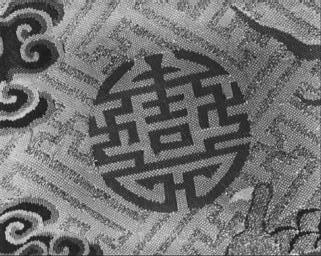
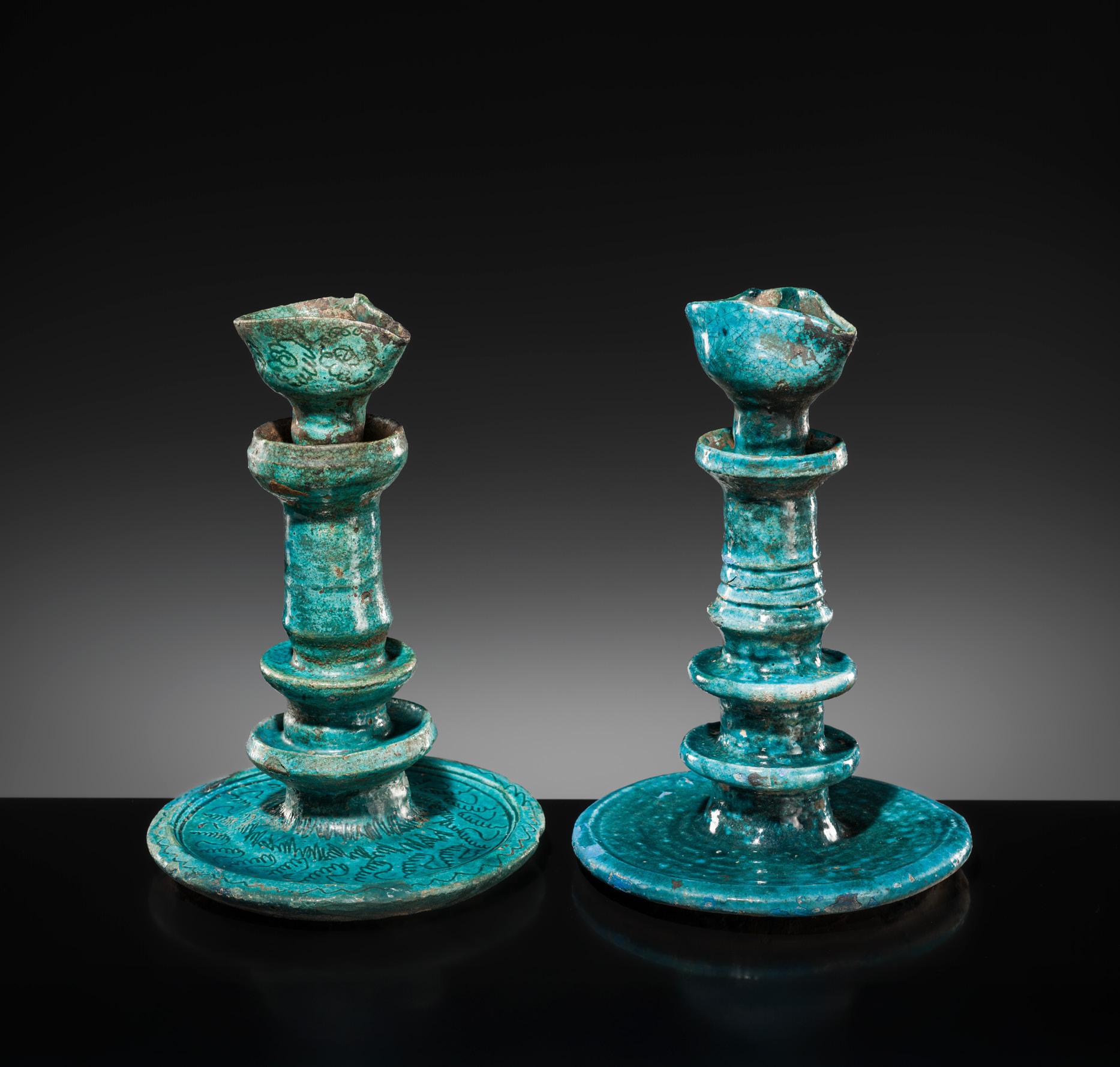
139 A GROUP OF TWO RARE PERSIAN TURQUOISEGLAZED POTTERY OIL LAMPS
Iran, 17th-18th century. Well potted, each with a tall cylindrical stem encircled by ribs and disk-shaped wells, supported on a splayed foot and surmounted by a pinched mouth. The body covered in a finely crackled turquoise glaze save for the base revealing the earthy tones of the clay. One of the lamps is densely incised with foliate motifs. The base marked with a seal.
Provenance: Galerie Hardt (established in 1976), Radevormwald, Germany, before 2020. Acquired by the gallery’s founder Peter Hardt (b. 1946) during his extensive travels in Asia, the first of which occurred during a formative world tour in 1973.
Condition: Good condition overall with expected wear, firing irregularities, traces of use, glaze lines, minor chips mostly to bases, flaking and minor losses to glaze, encrustations.
Weight 4.0 kg (total)
Dimensions: Height 29.4-29.7 cm
LITERATURE COMPARISON

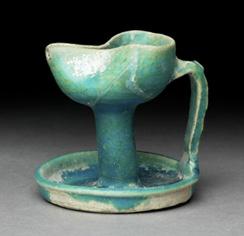
Compare a related earlier turquoise-glazed oil lamp, Iran, 11th-12th century, 7 cm high, in the British Museum, registration number As1966,01.828. Compare a related earlier turquoise-glazed oil lamp, Iran, 9th-10th century, 8.3 cm high, in the Ashmolean Museum, Oxford, accession number EA2005.38.
Estimate EUR 1,000
Starting price EUR 500
Carchi or Narino, Colombia or Ecuador. The urn with a projectile profile, surmounted by a cylindrical neck with everted rim, finely painted in black and red pigments with squares along the lower body and neck, detailed with double lines and circles.
Provenance: Galerie Hardt (established in 1976), Radevormwald, Germany, before 2020. Acquired by the gallery’s founder Peter Hardt (b. 1946) during his extensive travels in Asia, the first of which occurred during a formative world tour in 1973.
Condition: Condition commensurate with age. Wear, firing irregularities, signs of weathering, old repairs, touchups, light scratches, and minuscule losses. Expected rubbing and flaking to pigment.
Weight: 11.6 kg
Dimensions: Height 77 cm (excl. stand), 84 cm (incl. stand)
With an associated wood stand. (2)
Negative resist techniques were employed to form the vessel’s geometric patterns. A resin was first applied to the surface, which was then burnished and coated with a contrasting slip. Once the resin was removed, the underlying designs were revealed. The motifs – such as the bird-like footprints around the neck – draw inspiration from nature and woven textiles.
This large vessel functioned as a secondary burial urn. In addition to human remains, it may have held personal items and valuables, such as textiles or objects made of precious metal, intended to accompany the deceased into the afterlife. Secondary burial refers to the custom of reburying a person’s bones after the body has decomposed. Such urns were often placed in shaft tombs or buried beneath mounds or architectural structures.
LITERATURE COMPARISON
Compare a related negative-painted burial urn, dated 750-1250, Colombia or Ecuador, in the Michael C. Carlos Museum, object number 1992.015.068.
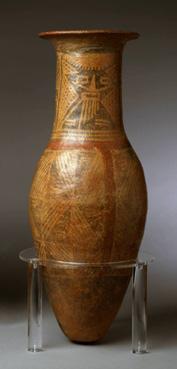
Compare a related ceramic urn, dated 11th-16th century, Ecuador, in the Metropolitan Museum of Art, object number 1980.34.36.
Estimate EUR 2,000
Starting price EUR 1,000
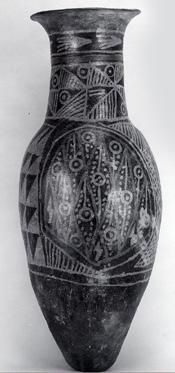
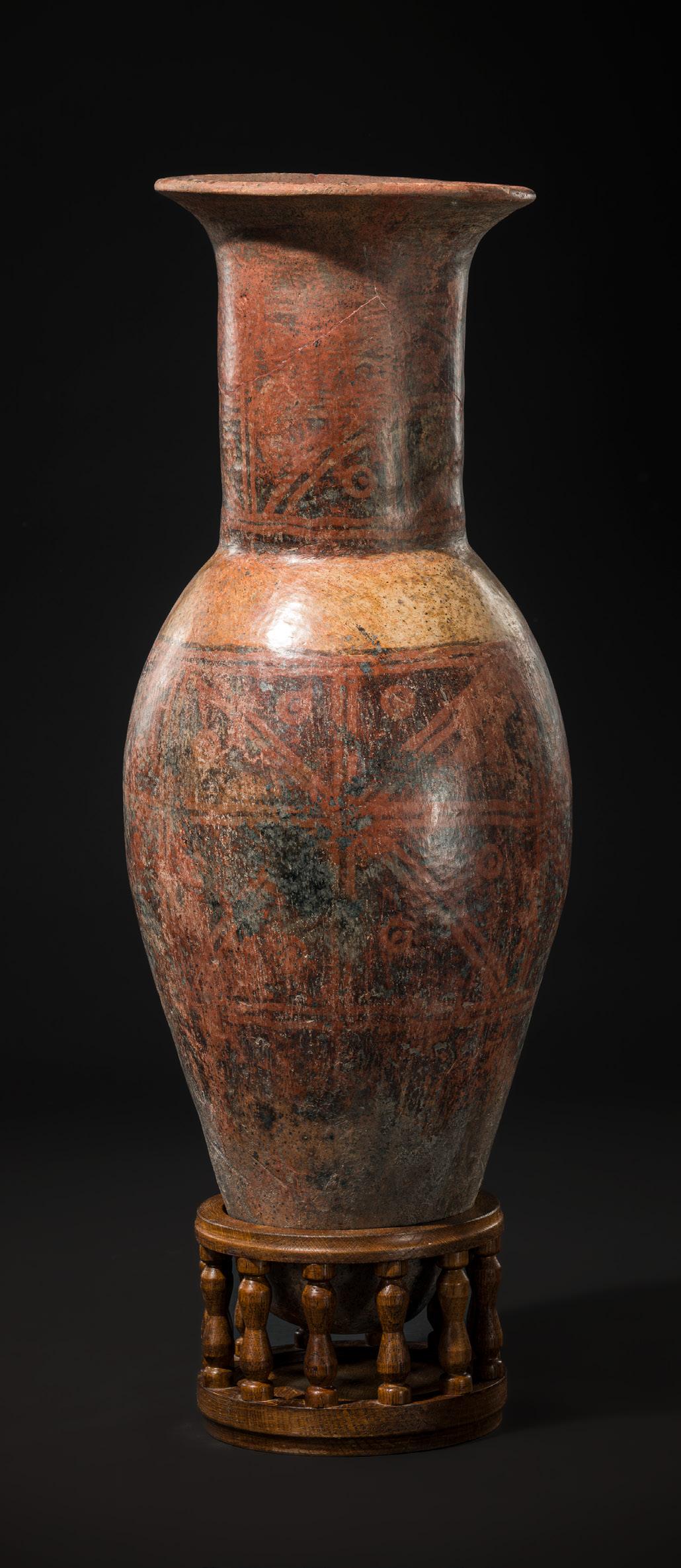
§ 1) The auction shall be carried out in accordance with the provisions of the rules of procedure of GALERIE ZACKE©, SZA VERSTEIGERUNGEN UND VERTRIEBS GMBH, Zelinkagasse 6, 1010 WIEN (hereinafter referred to as the company) as well as in accordance with sections 244-246 of the GEWERBEORDNUNG [Industrial Code] of 1994. The auction shall be carried out on commission. The auctioneer shall be entitled to withdraw lots exceptionally, to conduct the auction deviating from the order of the catalog numbers and to offer lots jointly. In the event of any dispute concerning a double bid or if the auctioneer has missed a bid, the auctioneer shall be entitled to revoke acceptance of a bid and to continue auctioning the item. The figures stated in the catalog shall be the highest bid in Euro (€) expected by the respective expert. As a rule, the bid shall be increased by 10% of the last bid. (See table of the bidding increments).
§ 2) The acceptance of a bid shall be granted to the highest bidder unless a hidden reserve has been agreed upon with the consignor of the item in question. Such a hidden reserve (also called limit or just reserve) shall be the minimum price under which the item will not be sold during the auction. This reserve will be disclosed upon request and after the auction only and may exceed the estimate. The auctioneer will in this case bid on behalf of the seller against all other bidders until the reserve has been reached. If a reserve is not reached during the auction, the auctioneer will knock down the item to the highest bidder at the final bid, but the sale will be conditional of the acceptance of this final bid by the seller. In this case the highest bidder shall be bound to his/her last bid for a term of 8 days starting with the day of the knockdown. If the winning bidder does not receive a written cancellation notice within this term of 8 days, the knockdown becomes unconditional and the sale is final. Typically, only a minority of all items in an auction have a hidden reserve.
§ 3) Most items shall be subject to differential taxation. A uniform surcharge of 25% plus the value added tax applicable to the surcharge to the amount of 20% shall be added to the achieved highest bid (final and highest bid). Thus, the surcharge shall be 30% of the final and highest bid in total. Items with added VAT are marked † in the online catalog.
§ 4) In the event of sales abroad, the value added tax will be repaid if the item is sold to a country which is not a member country of the European Union (third country), the legal requirements are met, and the proof of exportation is provided. The value added tax shall not be shown separately on the invoice.
§ 5) The auction buyer must pay the purchase price immediately upon acceptance of the bid (final and highest bid plus 25% surcharge, plus the value added tax applicable to the surcharge to the amount of 20%, or the added VAT on top of the final price, when a lot is highlighted accordingly in the auction catalog). The company may grant an auction buyer a term of payment for the purchase price in whole or in part when this has been formally applied for in writing before the auction.
§ 6) In the event of a term of payment, or any payment delay, in whole or in part, the company shall be entitled to charge default interest (12% p.a.) as well as storage charges (2.4% pf the final and highest bid per month commenced) after 14 days upon acceptance of the bid. The item purchased at auction shall be handed over exclusively upon full payment of the purchase price including all costs and charges accrued since the acceptance of the bid.
§ 7) The buyer should take acquired items into possession, as far as possible, immediately or after the end of the auction. Items which have been fully paid for shall be handed over in our show rooms in GALERIE ZACKE, Zelinkagasse 6, 1010 VIENNA. If a deferred purchase price is not paid within the set period, the company shall be entitled to auction the item again in order to recoup its claim from the defaulting auction buyer. In this case, the defaulting auction buyer shall be liable to the company for the total loss of commission incurred by the company due to the re-auctioning as well as for any default interest and storage charges.
§ 8) The company shall be entitled to a lien on all items of the buyer irrespective of whether the buyer bought them within the scope of an auction or in free sale or the company secured ownership of these items otherwise. This lien shall serve to secure all current and future, qualified, limited and unmatured claims to which the company is entitled and which result from all legal transactions concluded with the buyer.
§ 9) The items received for auction will be exhibited and may be viewed prior to the auction. In doing so, the company shall give everyone the opportunity to check the nature and the condition of the exhibited items to the extent deemed possible within the scope of the exhibition. Every bidder shall be deemed to act on its own behalf unless it provides a written confirmation saying that it acts as a representative or agent of a well-known principal. The company may refuse bids; this shall particularly apply if a bidder who is unknown to the company or with whom the company has no business connections yet does not provide a security deposit before the auction. However, in principle there shall be no claim to accept a bid. If a bid has been refused, the previous bid shall remain effective.
§ 10) The company’s experts evaluate and describe the items received for auction and determine the starting prices unless otherwise stated in the catalog or expert opinion. The information concerning production technique or material, state of preservation, origin, design and age of an item is based on published or otherwise generally accessible (scientific) findings concluded by the company’s expert with the necessary care and accuracy. The company shall warrant to the buyer according to §34-38 of the AGB (Terms and Conditions) that properties are correct provided that any complaints referring to this are made within 45 days after the auction day. Subsequent complaints shall be excluded in principle. The company shall not be liable for any further information in the catalog and expert opinion as well. This shall also apply to illustrations in the catalog. The purpose of these illustrations is to guide the potential buyer during the preview. They shall not be authoritative for the condition or the characteristics of the pictured item. The published condition reports shall only mention defects and damage affecting the artistic or commercial value significantly. Complaints concerning the price shall be excluded upon acceptance of the bid. The company reserves the right to amend the catalog online prior to the auction. These amendments shall also be made public orally by the auctioneer during the auction. In this case, the company shall be liable for the amendment only. All items offered may be checked prior to the auction. These items are used. Any claims for damages exceeding the liability named above and resulting from other material defects or other defects of the item shall be excluded. When making the bid, the bidder confirms that he/she has inspected the item prior to the auction and has made sure that the item corresponds to the description.
§ 11) If a customer is not able to participate in an auction personally, the company shall accept purchase orders. These orders may be placed in writing via mail, e-mail, fax, www.zacke.at or a third party bidding platform. In the case of a purchase order placed by phone or orally, the company shall reserve the right to make the performance dependent on a confirmation from the principal communicated in writing. Furthermore, the company shall not be liable for the performance of purchase orders. Equal purchase orders or live bids will be considered in the order of their receipt. Bids which below the estimate shall be exhausted completely. Bids which do not correspond to the increments determined by the company (see bidding increment table) will be rounded up to the next higher increment. The table of these increments can be sent upon request. The written bid (purchase order) must include the item, the catalog number and the offered top bid limit which is quoted as the amount of the acceptance of the bid without buyer’s commission and without taxes.
Ambiguities shall be carried by the bidder. A purchase order which has already been placed may only be cancelled if the written withdrawal is received by the company at least 72 hours prior to the beginning of the auction.
§ 12) The company may refuse a purchase order without explanation or make its execution dependent on payment of a security deposit. In the event of an unsuccessful order, such a deposit will be reimbursed by the company within 5 working days. Processing of purchase orders is free of charge.
§ 13) Every seller shall in principle be entitled to withdraw the items offered for auction until the start of the auction. Therefore, it is impossible to assume liability or to give warranty for the actual offering.
§ 14) Paid items must be collected within 30 days after payment. Items which have not been collected may be re-offered without further communication at the starting price from the recent auction reduced by 50%. Items which have not been collected within 30 days after the auction or for which the company does not receive any proper shipping instructions stating the type of shipping and the address of dispatch (independent of a possibly placed purchase order) shall be stored at the owner’s risk.
Furthermore, the company shall be entitled to store items which have been purchased at auction and paid but not collected at the buyer’s risk and expense, including the costs for an insurance, with a forwarding agency. It shall be understood that the provision concerning the re-auctioning of unpaid and paid but not collected items must also apply to items not exhibited or stored on the premises of the company. The ownership shall be transferred to the buyer at the time of handing over the issuing note.
§ 15) In the case of mixed lots with a starting price of less than EUR 350.00, the company shall not warrant for the completeness or correctness of the individual items within a mixed lot.
§ 16) A registration for a bid by telephone for one or several items shall automatically represent a bid at the starting price of these items. If the company cannot reach a bidder by telephone, it will bid the starting price on behalf of this bidder when the respective lot is up for auction.
§ 17) Payments made to the company by mistake (through the payer’s fault) (e. g. due to miscalculation of the exchange rate by the payer) or payments made to the company for the same invoice several times shall be compensated in form of a credit note for goods for an indefinite period of time. The repayment of such payments in cash shall be excluded.
§ 18) Certain auction lots may exist several times (multiples). In such a case, the auctioneer may accept a second, third or even more bids from the underbidder(s). In this case, the text in the catalog and not the illustration shall be exclusively binding with regard to the warranty.
§ 19) The company reserves the right to assign to the buyer all rights and obligations resulting from the contractual relationship between the company and the seller by way of a respective declaration, as well as to assign to the seller all rights and obligations resulting from the contractual relationship between the company and the buyer by way of a respective declaration, in each case in terms of a complete assignment of contract with the result that the contractual relationship -following the submission of the aforementioned declarations by the company – shall exclusively be between the seller and the buyer, all of which is in accordance with the basic model of the commission agreement. Buyers and sellers shall already now give their explicit consent to this contract assignment.
§ 20) The place of performance of the contract brought about between the company on the one hand and the seller as well as the buyer on the other hand shall be the place of business of the company. The legal relationships and contracts existing between the company, the sellers and the buyers shall be subject to Austrian law. The company, the sellers and the buyers shall agree to settle all disputes resulting from, concerning and in connection with this contract before the territorially competent court of Vienna.
§ 21) The export of certain art objects from Austria shall require a permit from the Bundesdenkmalamt [Federal Monuments Office]. The company will orally provide information about art objects for which such export permit will probably not be granted at the beginning of the auction.
§ 22) Whenever making a bid, whether personally or via an agent, in writing, online, telephone, or in any other way, the bidder fully and unconditionally accepts the Terms of Auction, the ‘Important Information’ section in the auction catalog, the Terms and Conditions (AGB) of Galerie Zacke, §1-50, the Fee Tariff, and the Bidding Increments table, all as published on www.zacke.at on the day of the auction.
